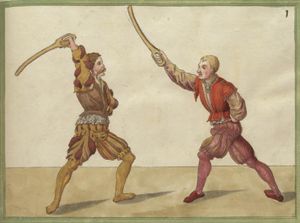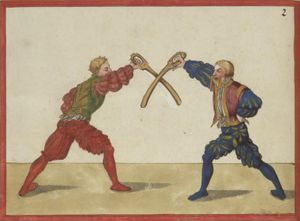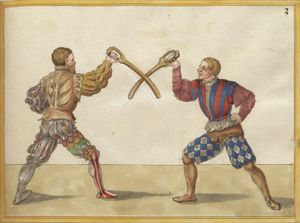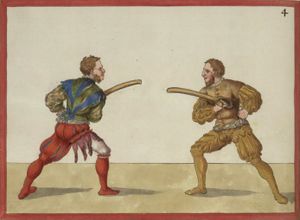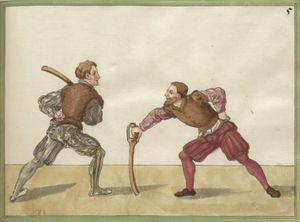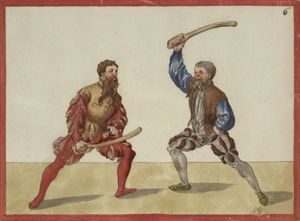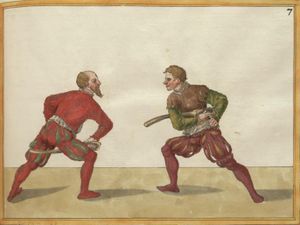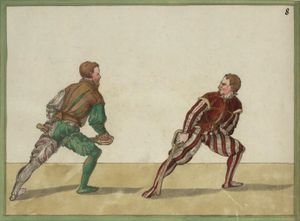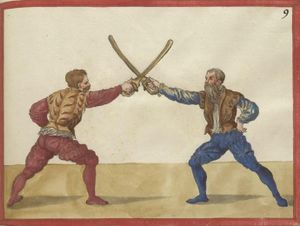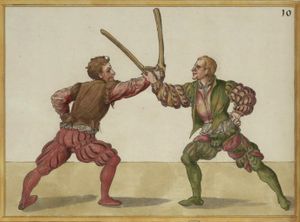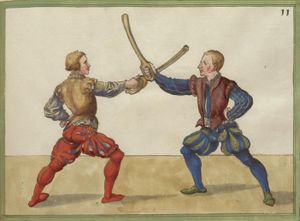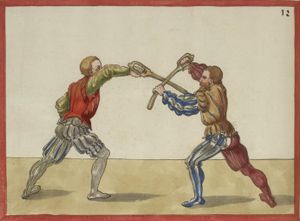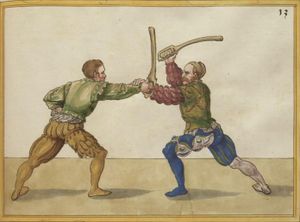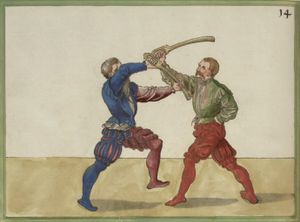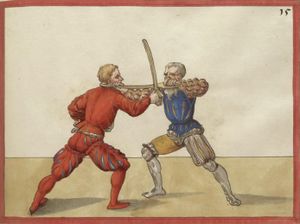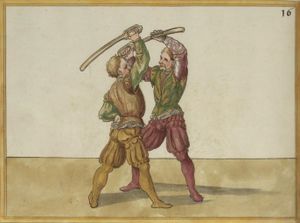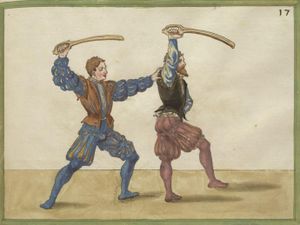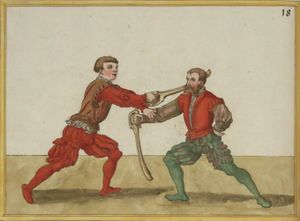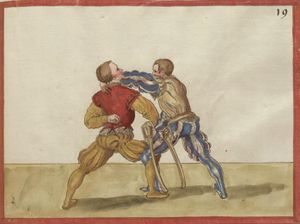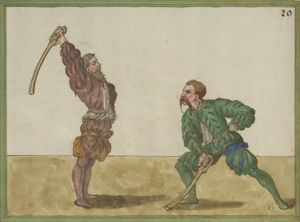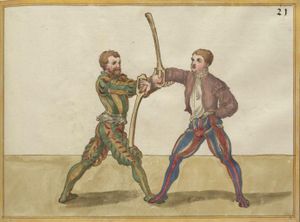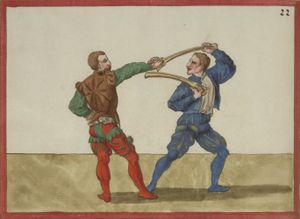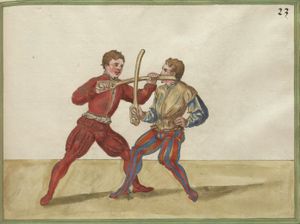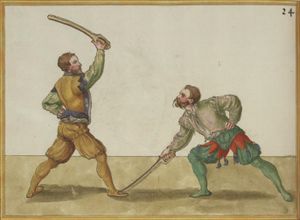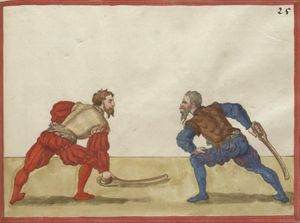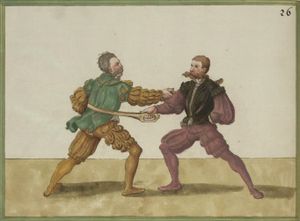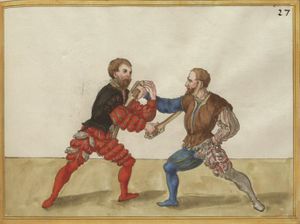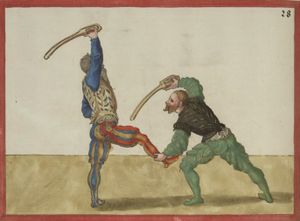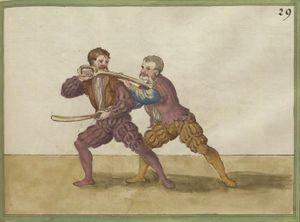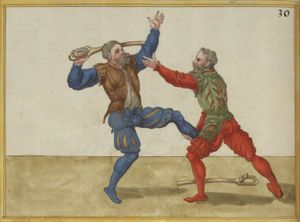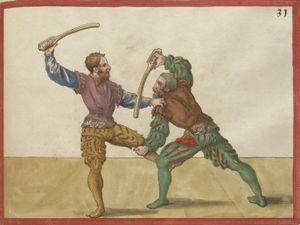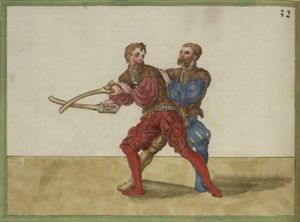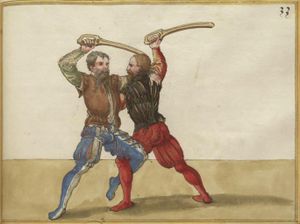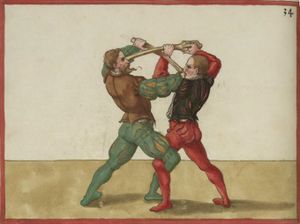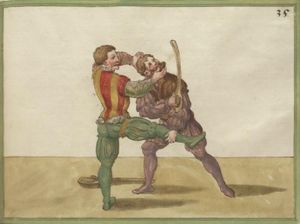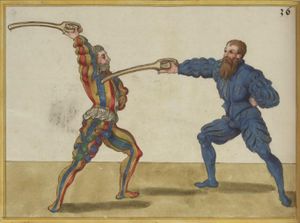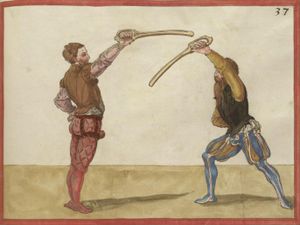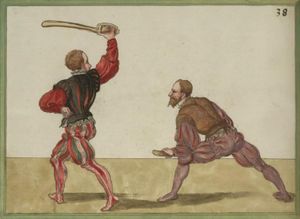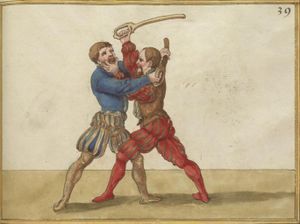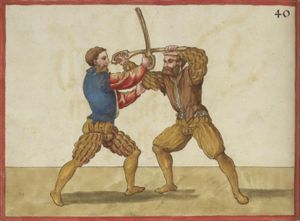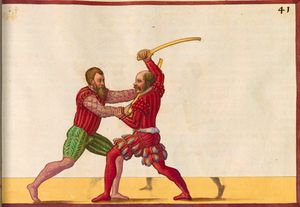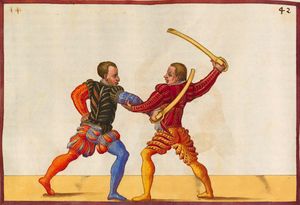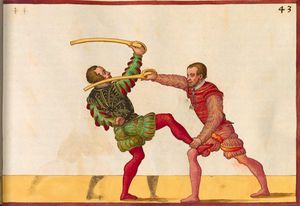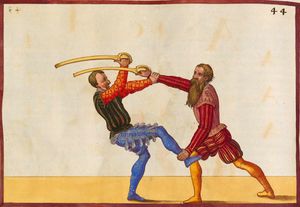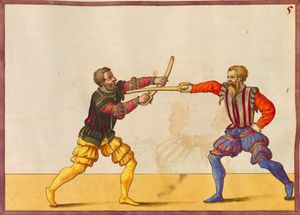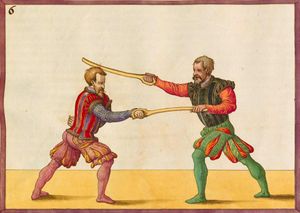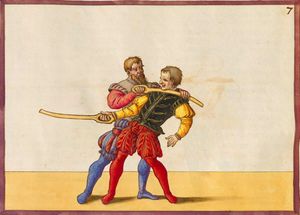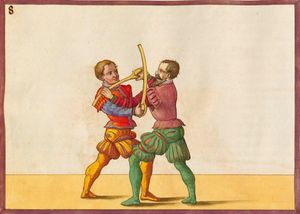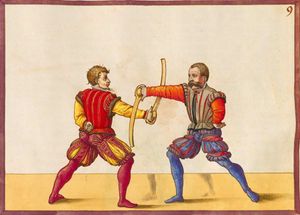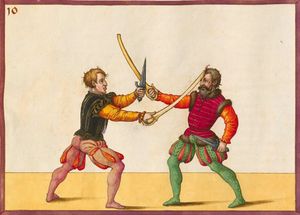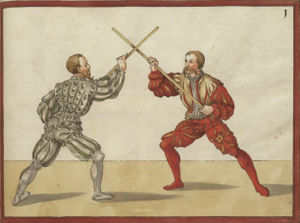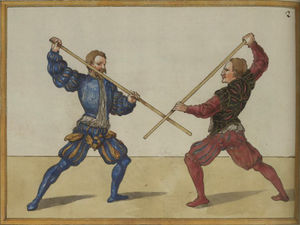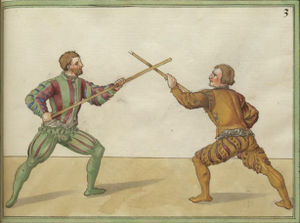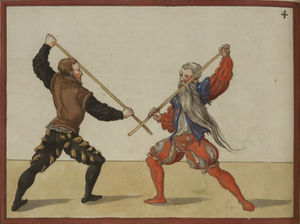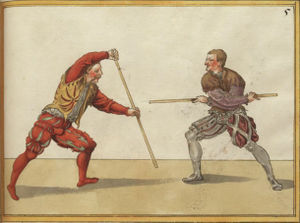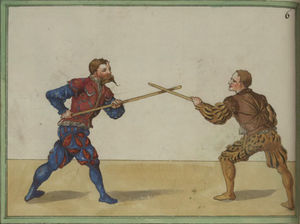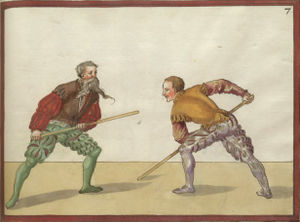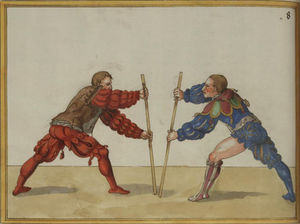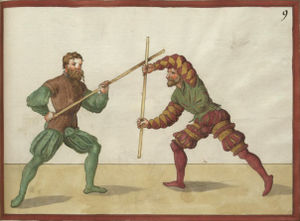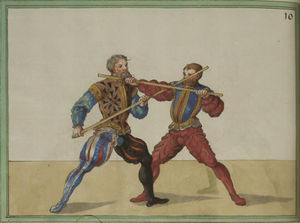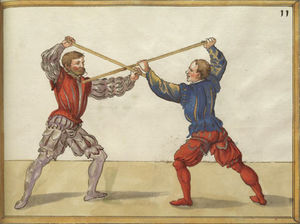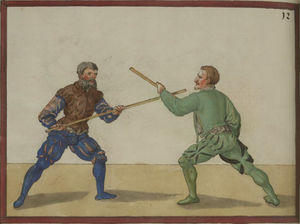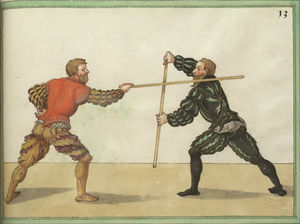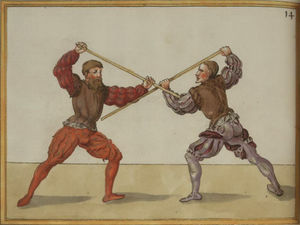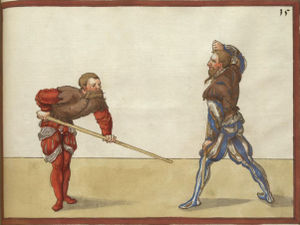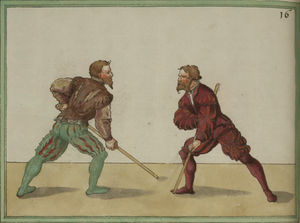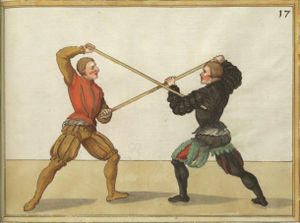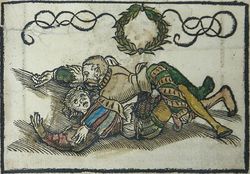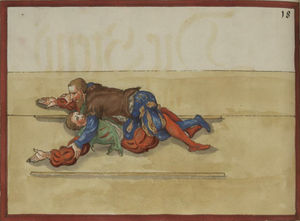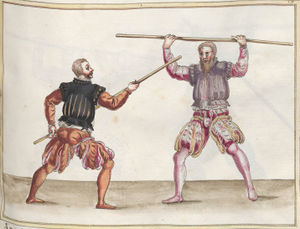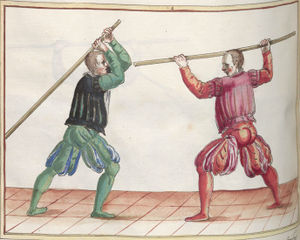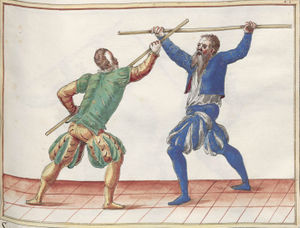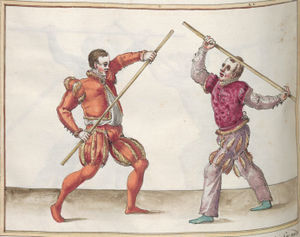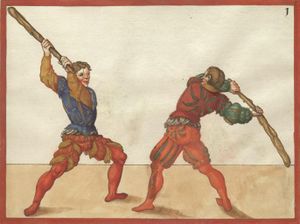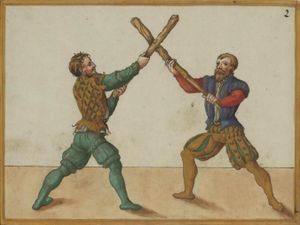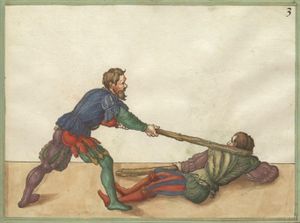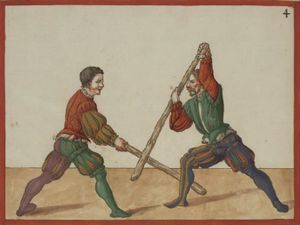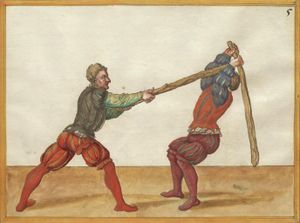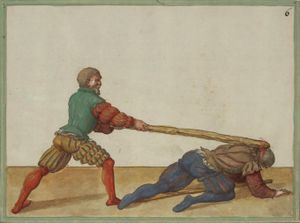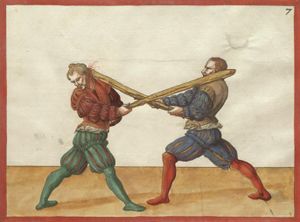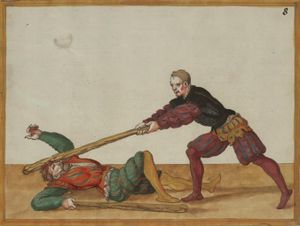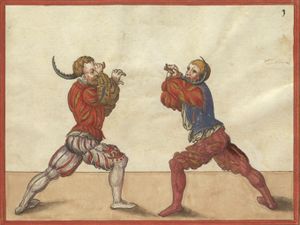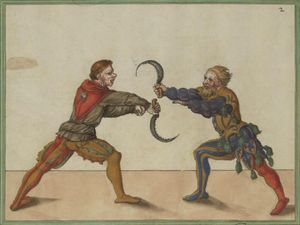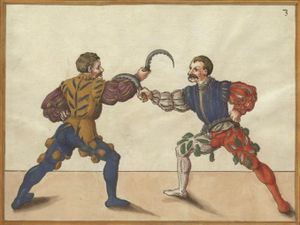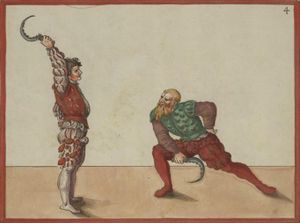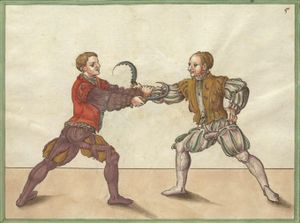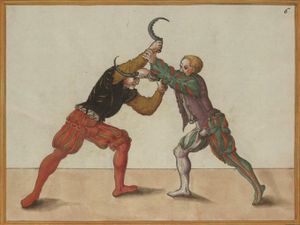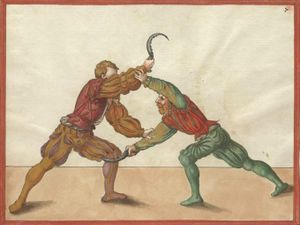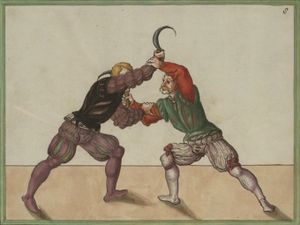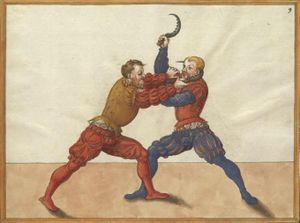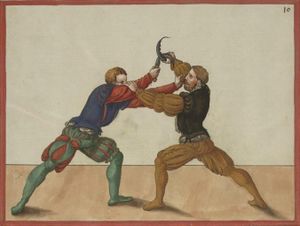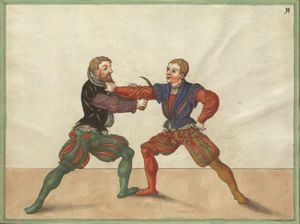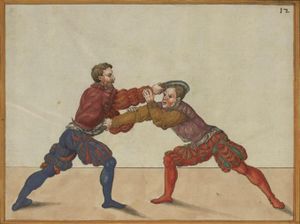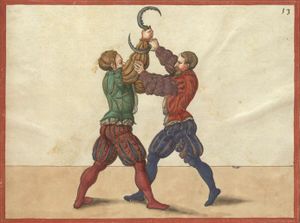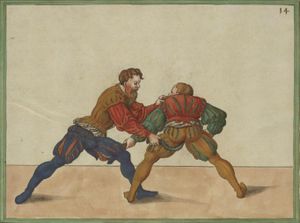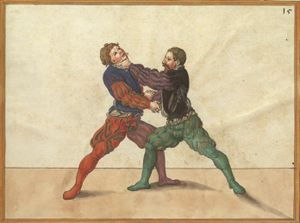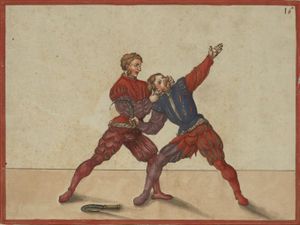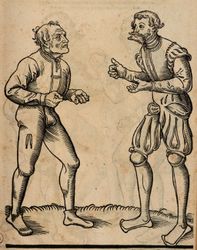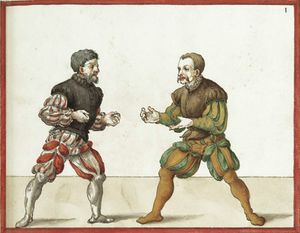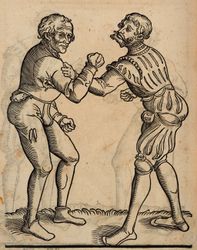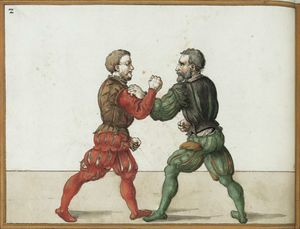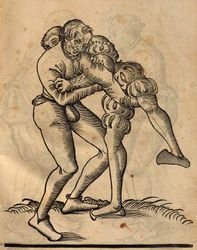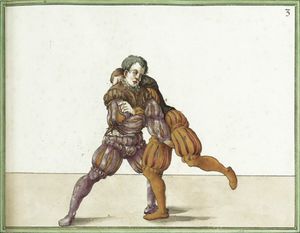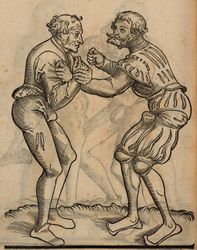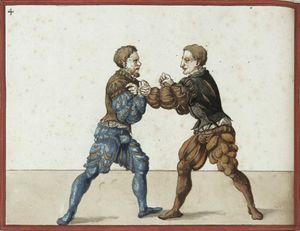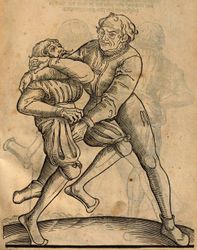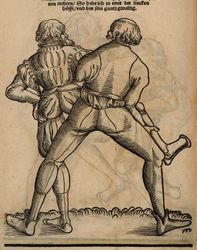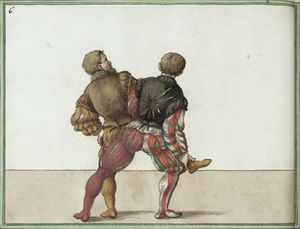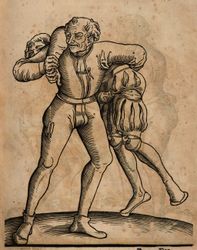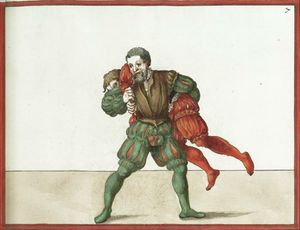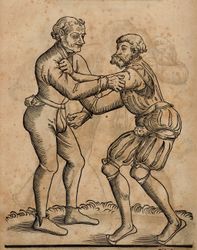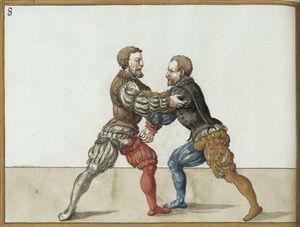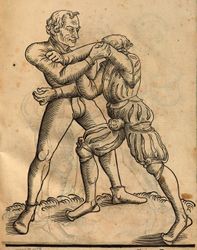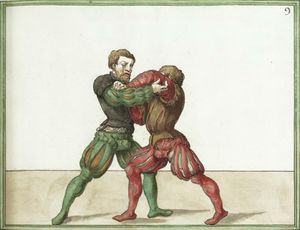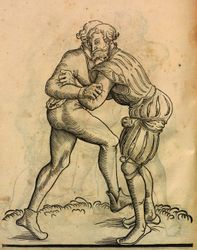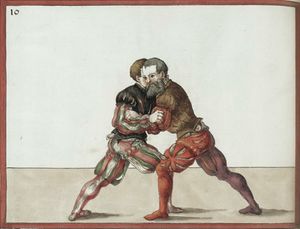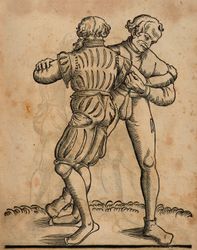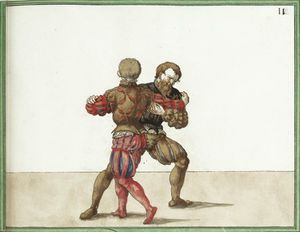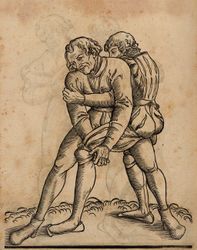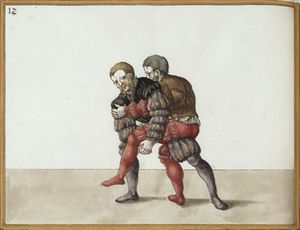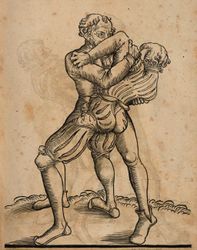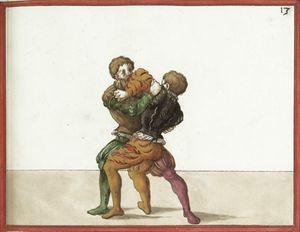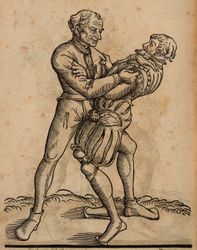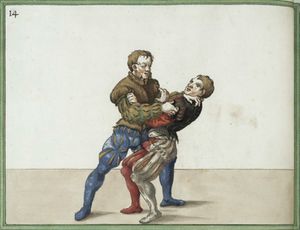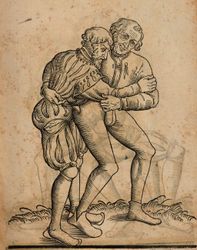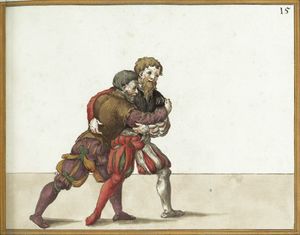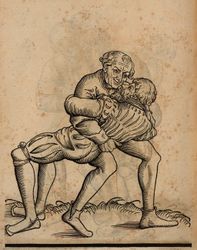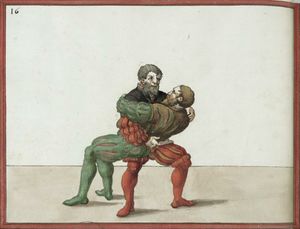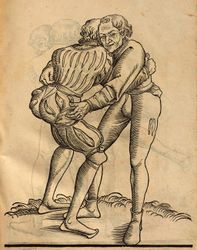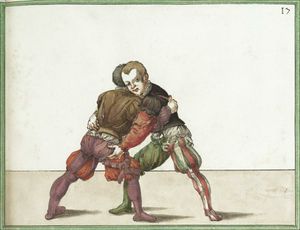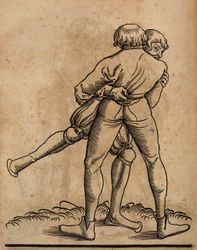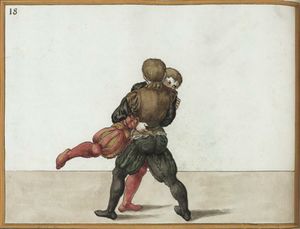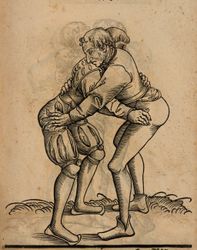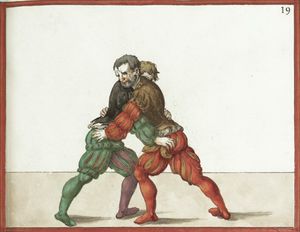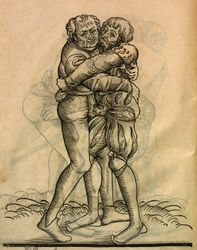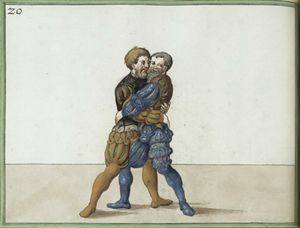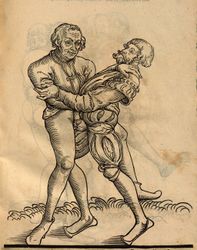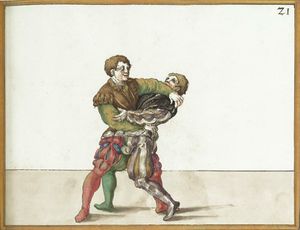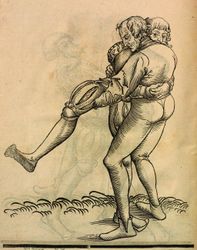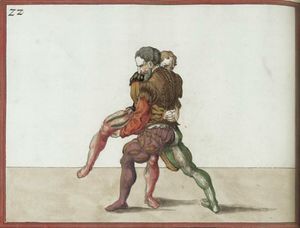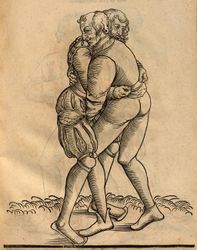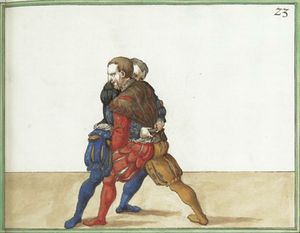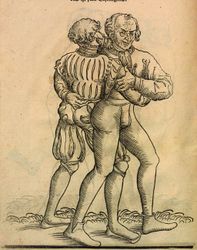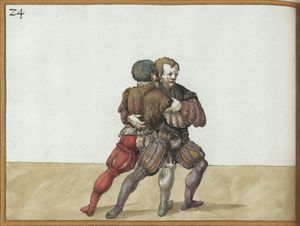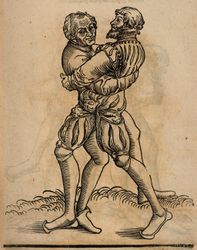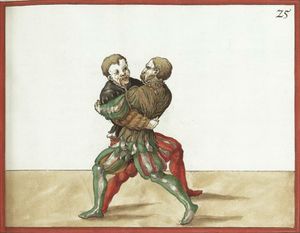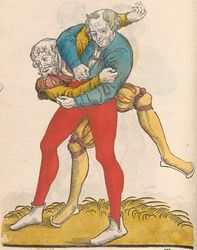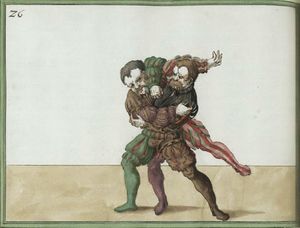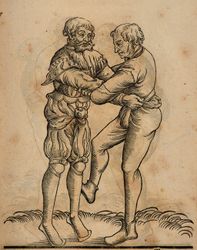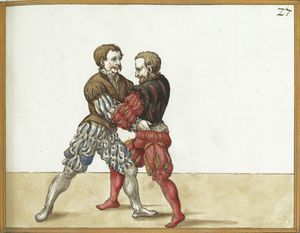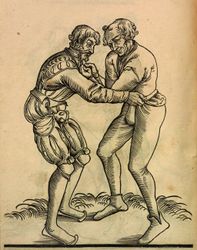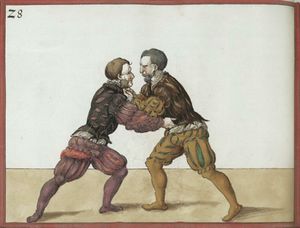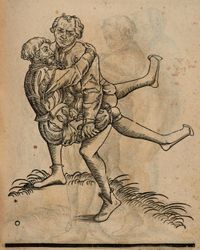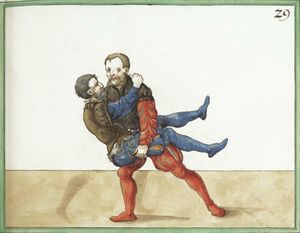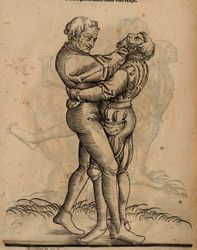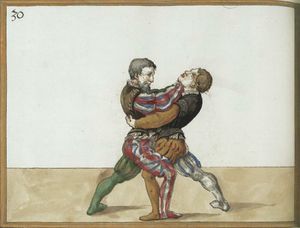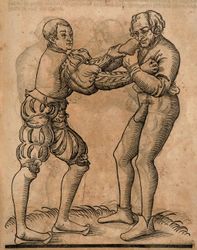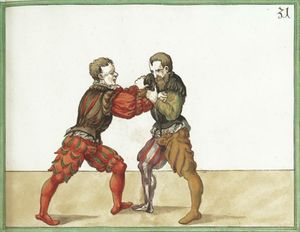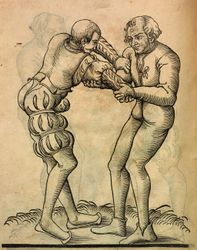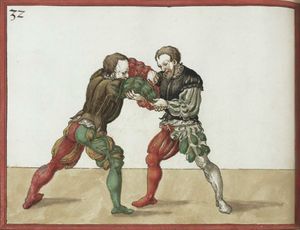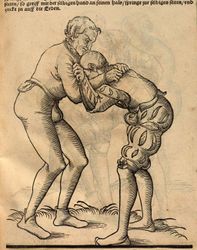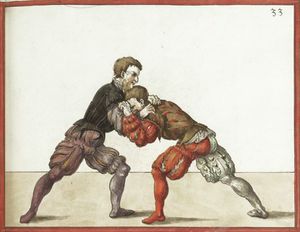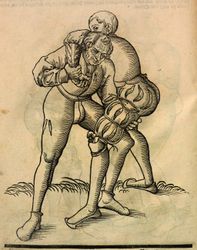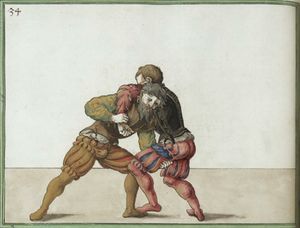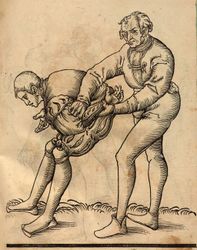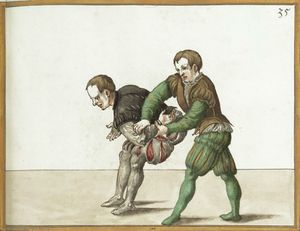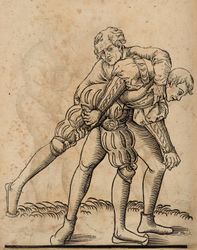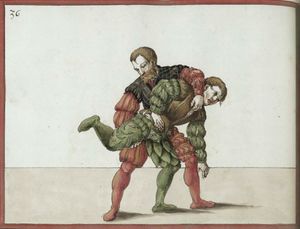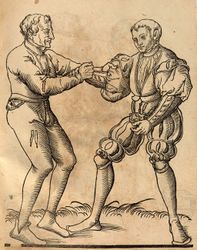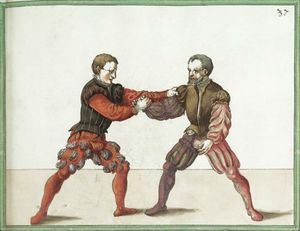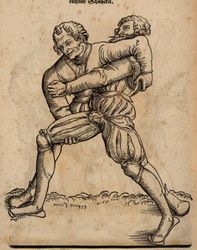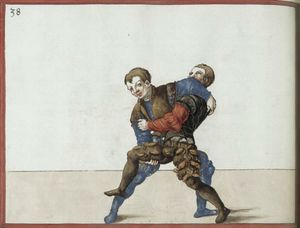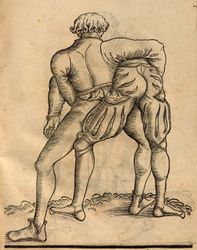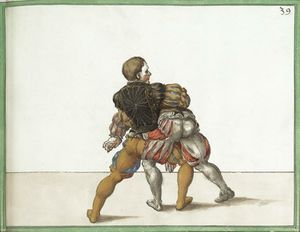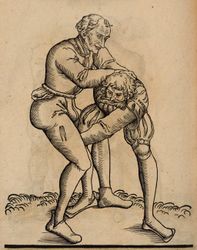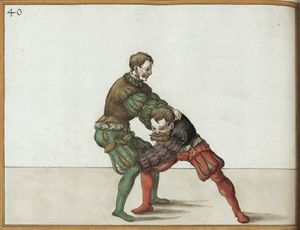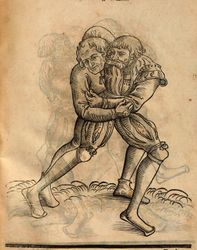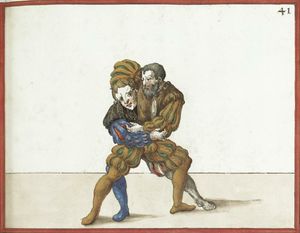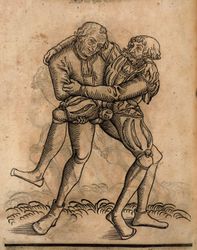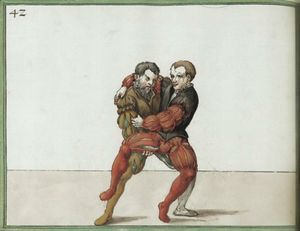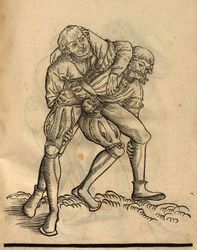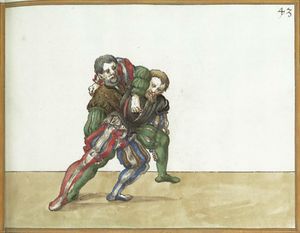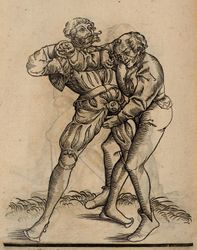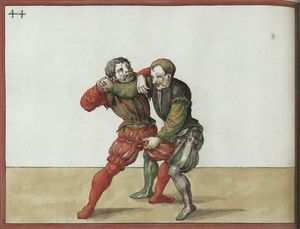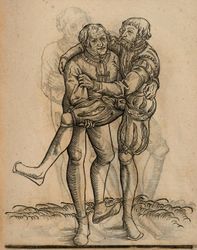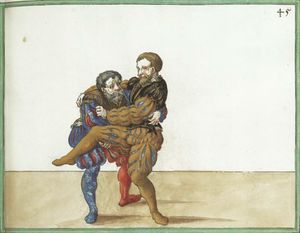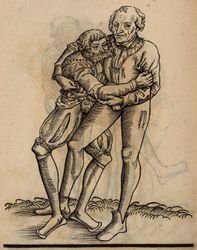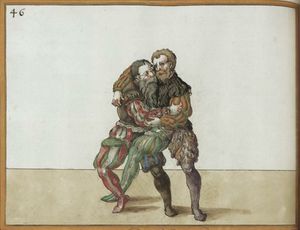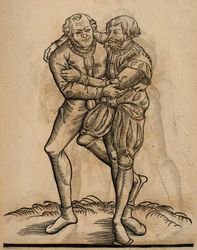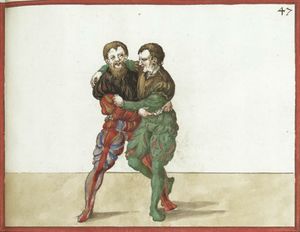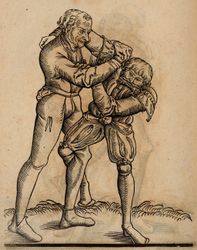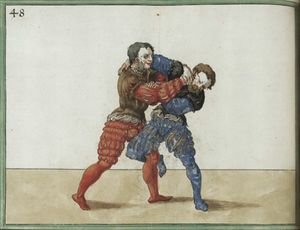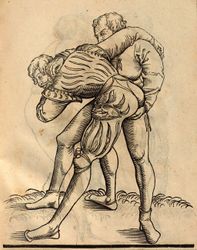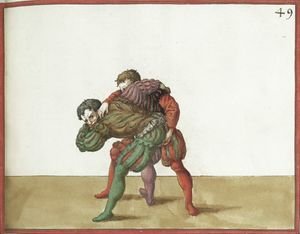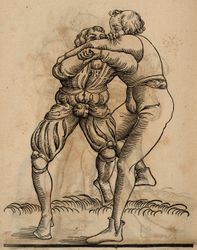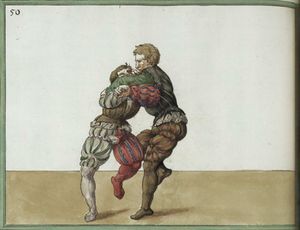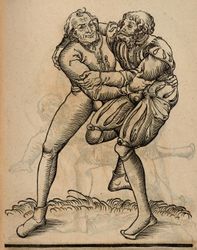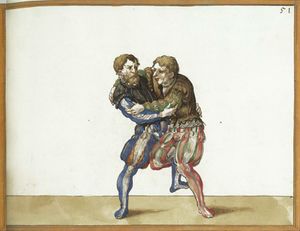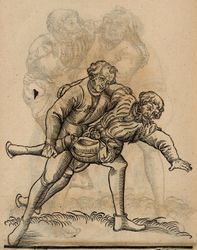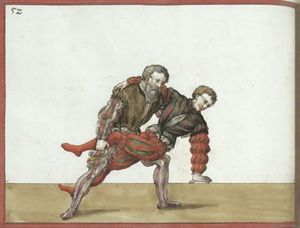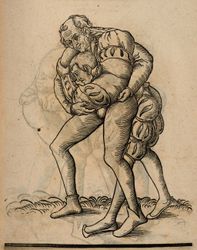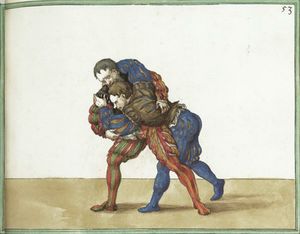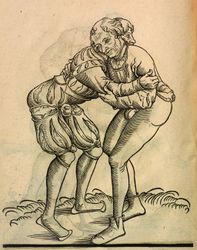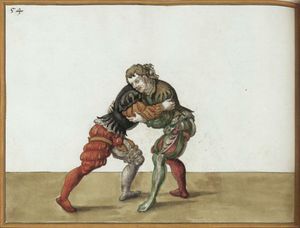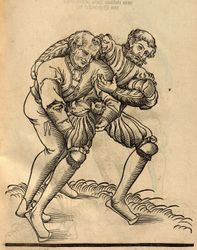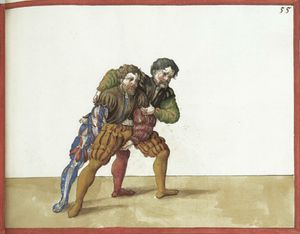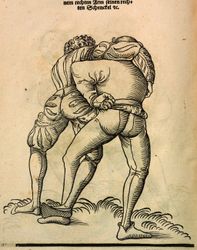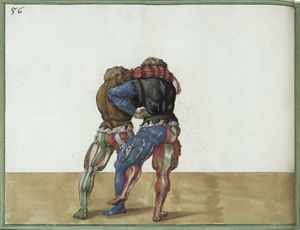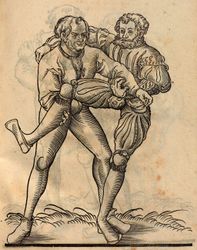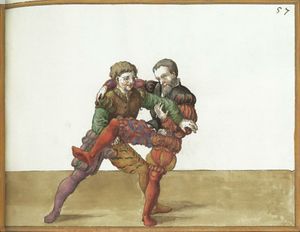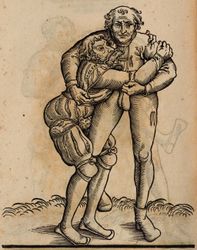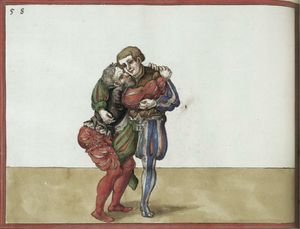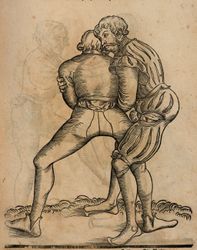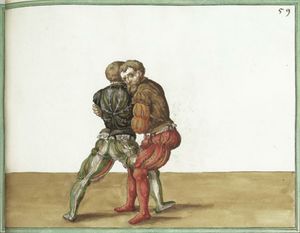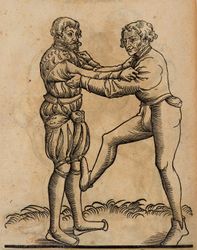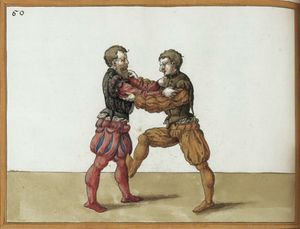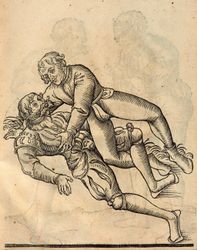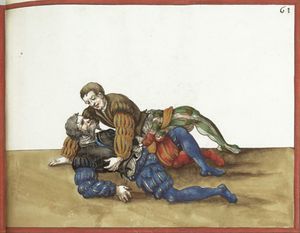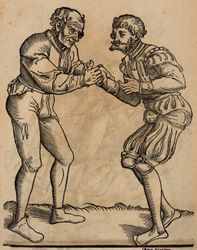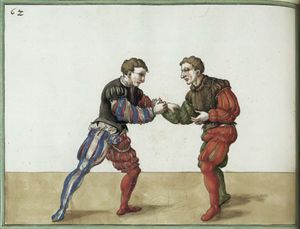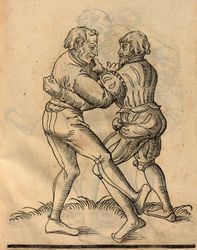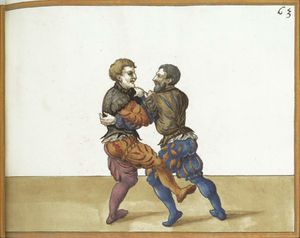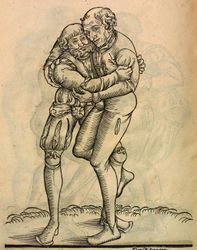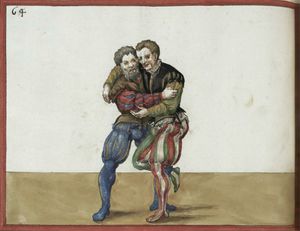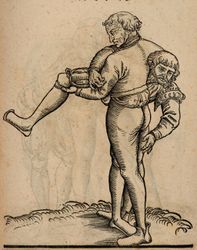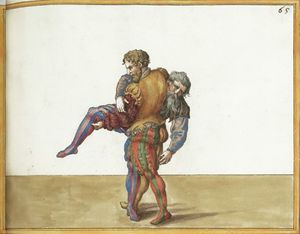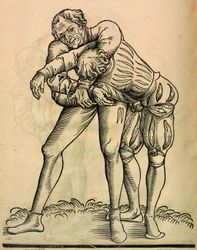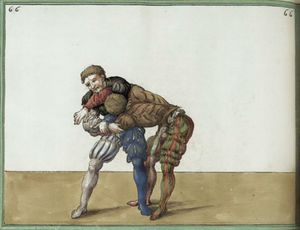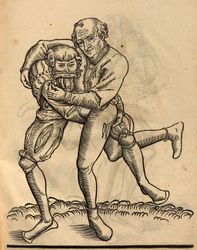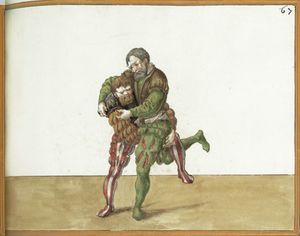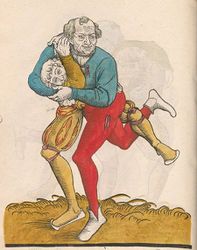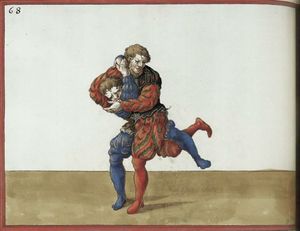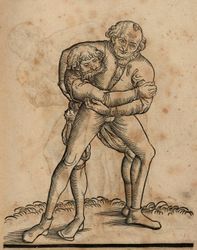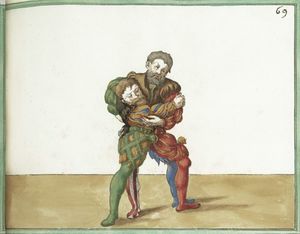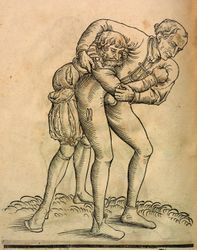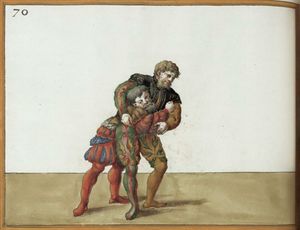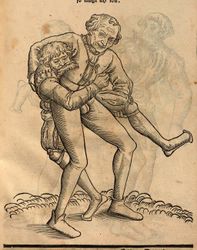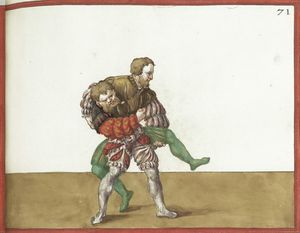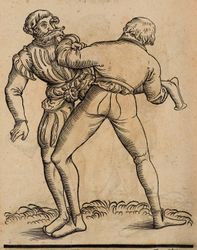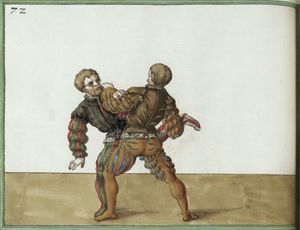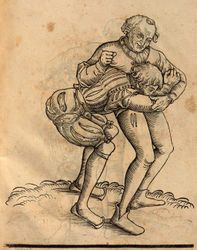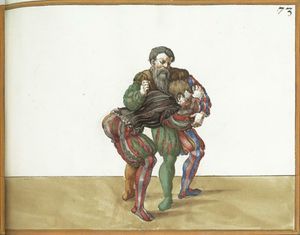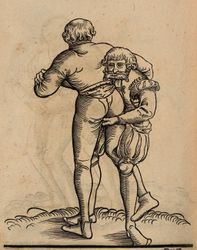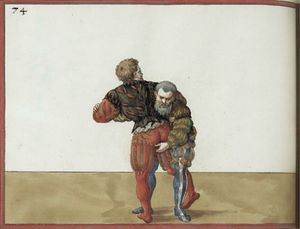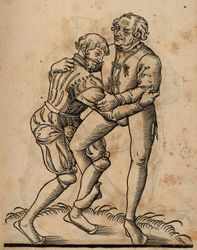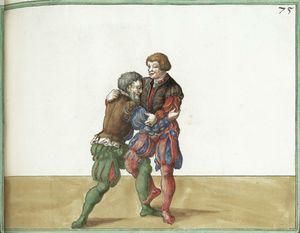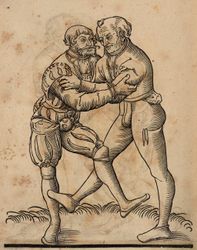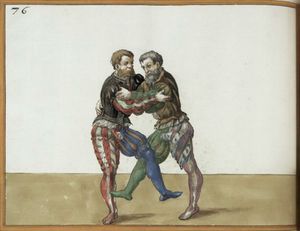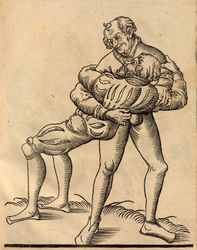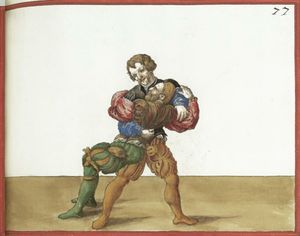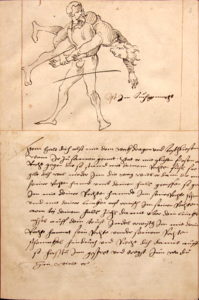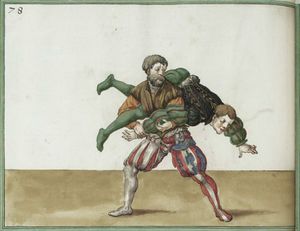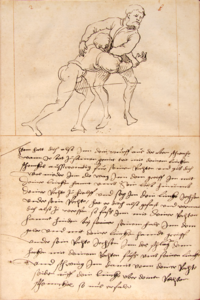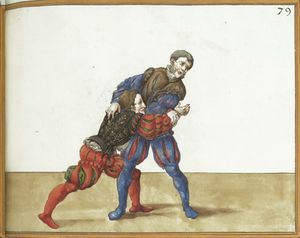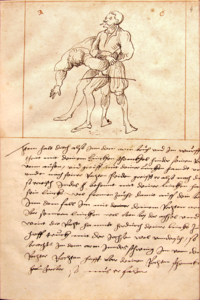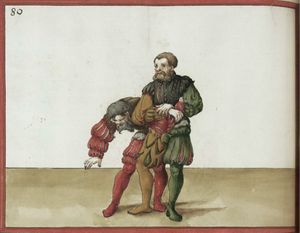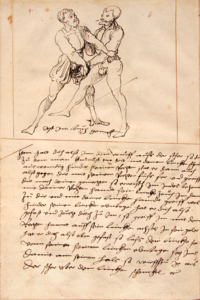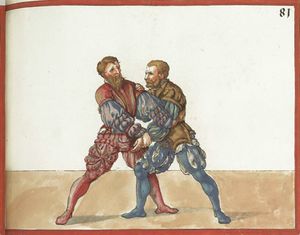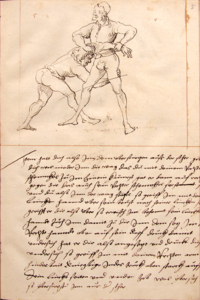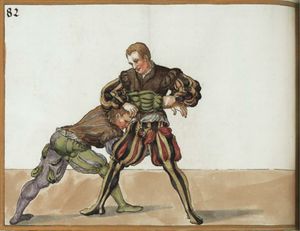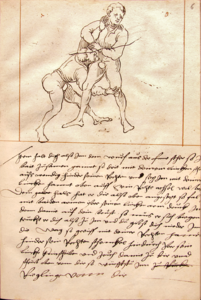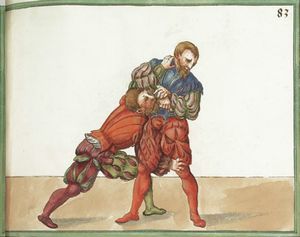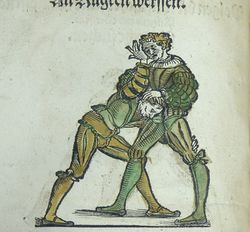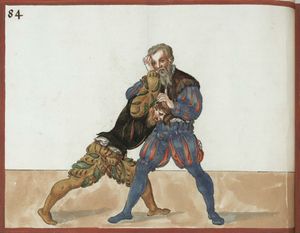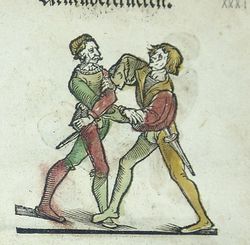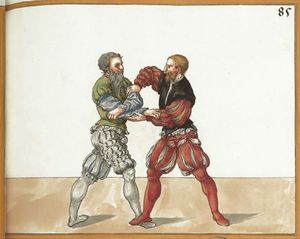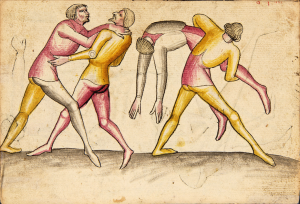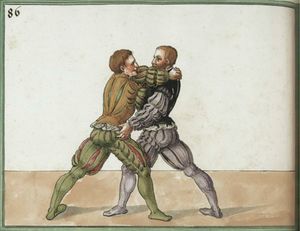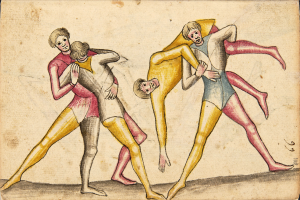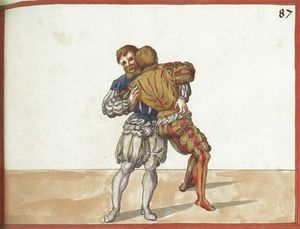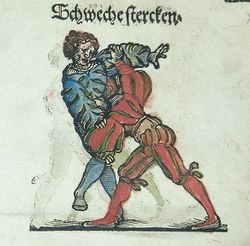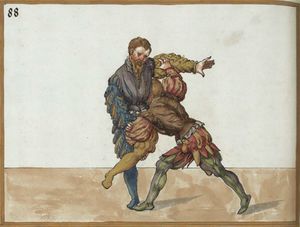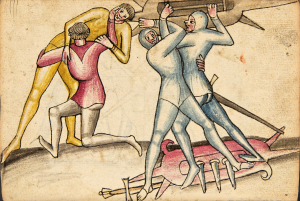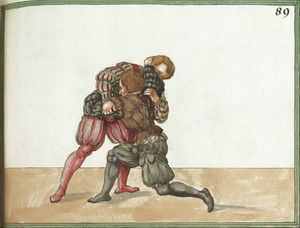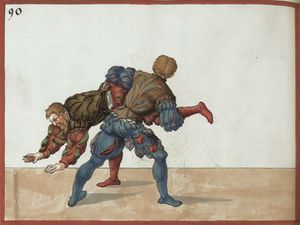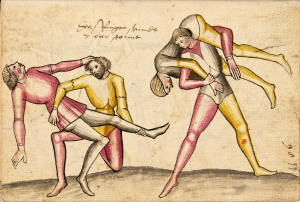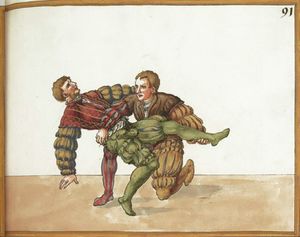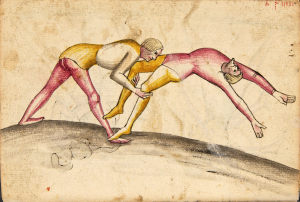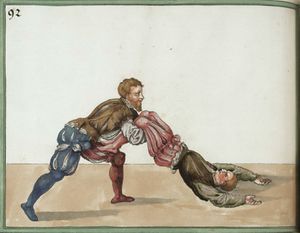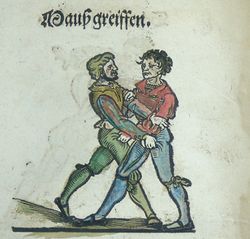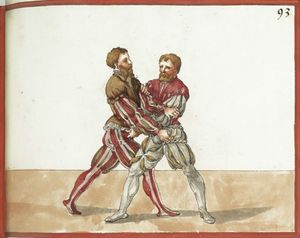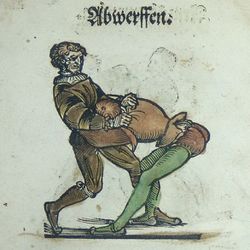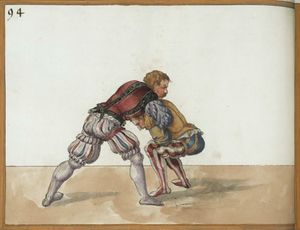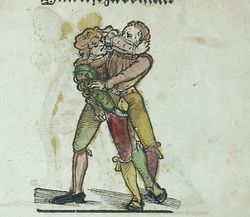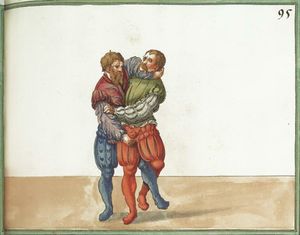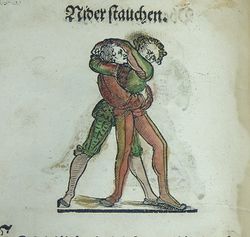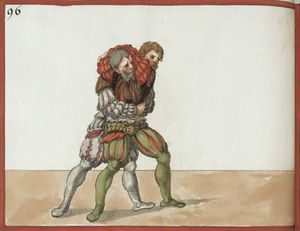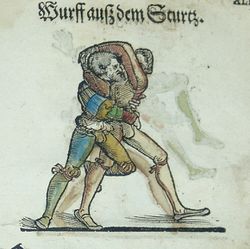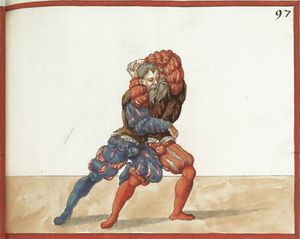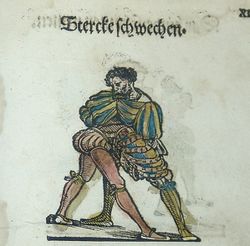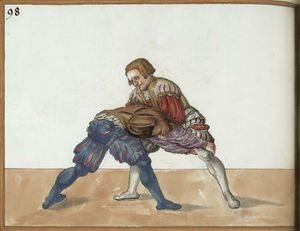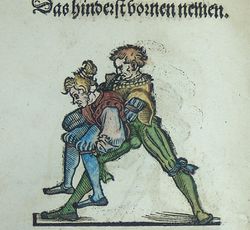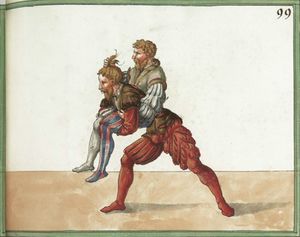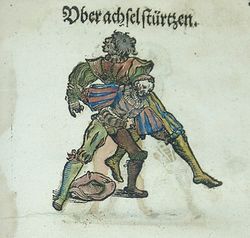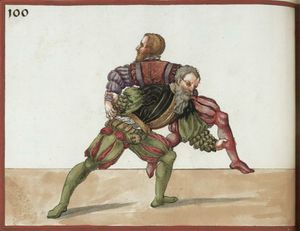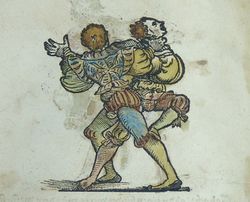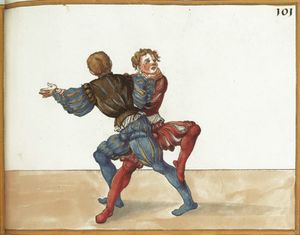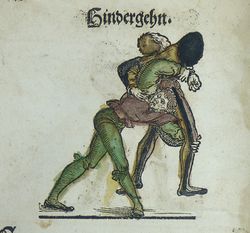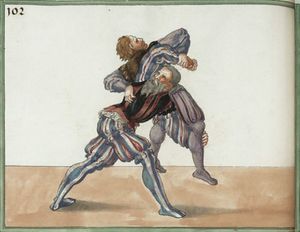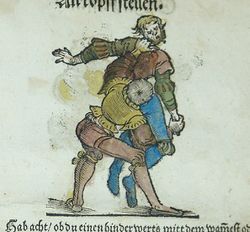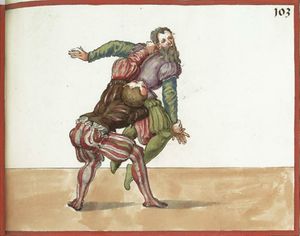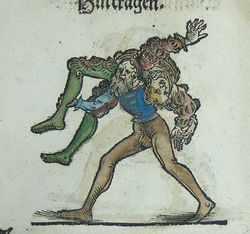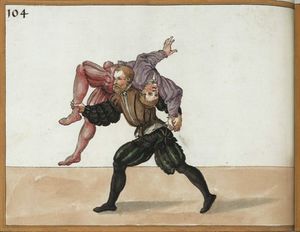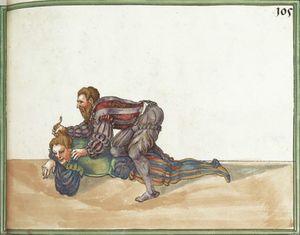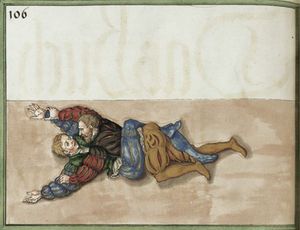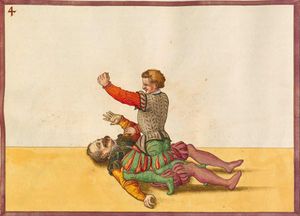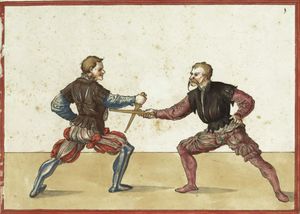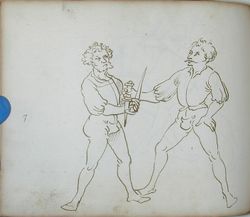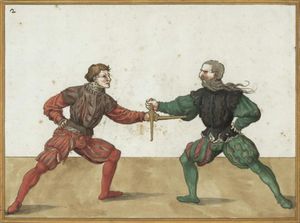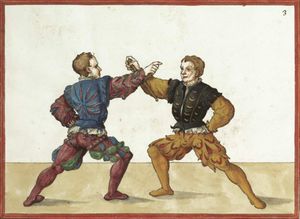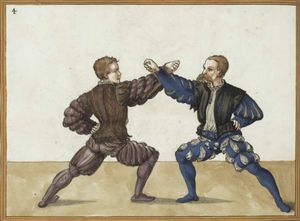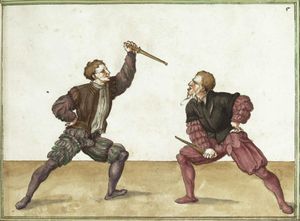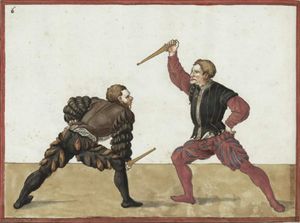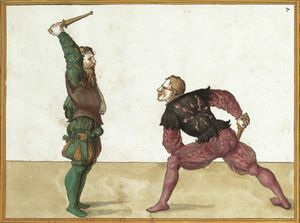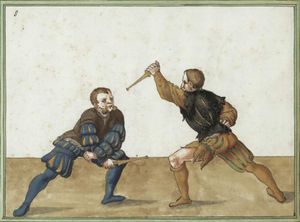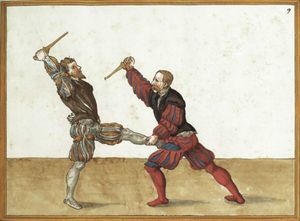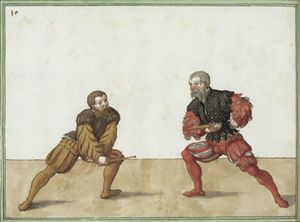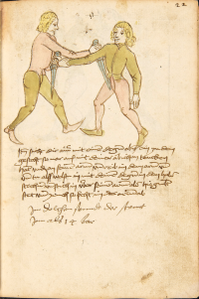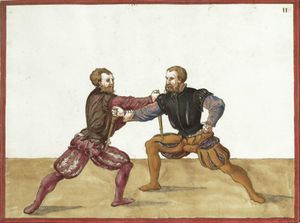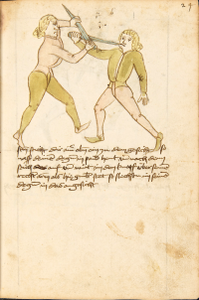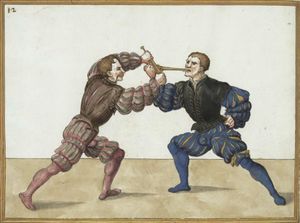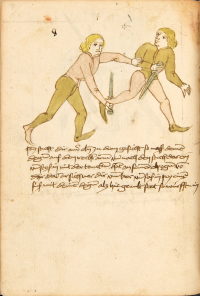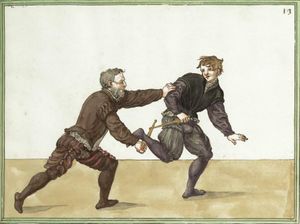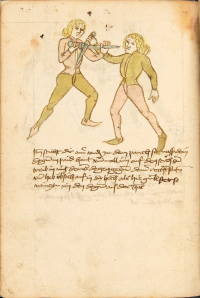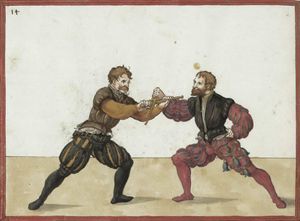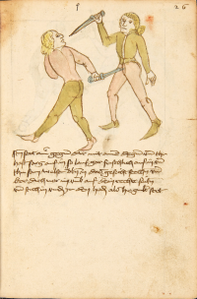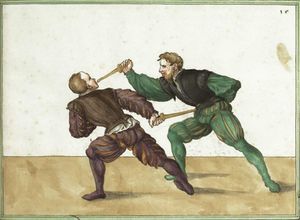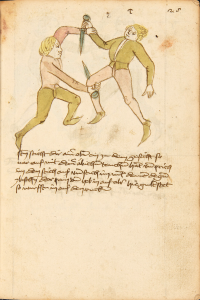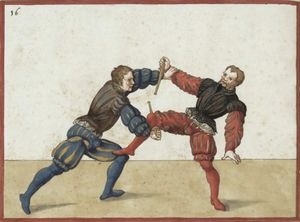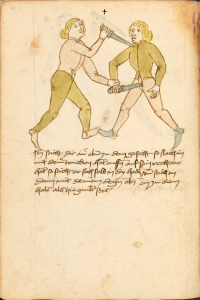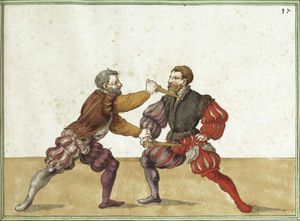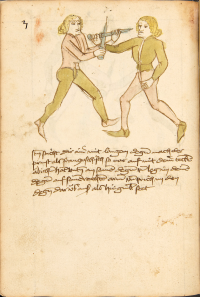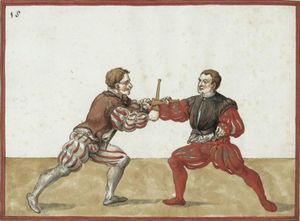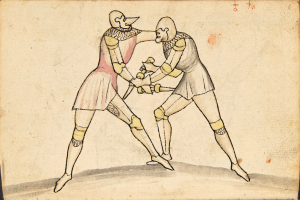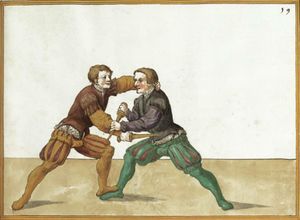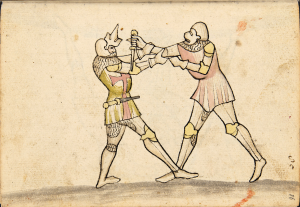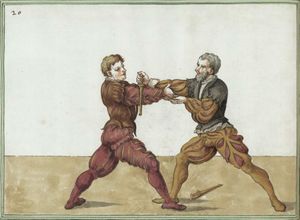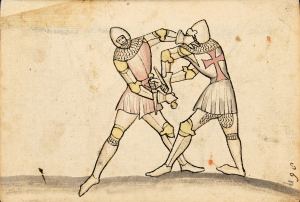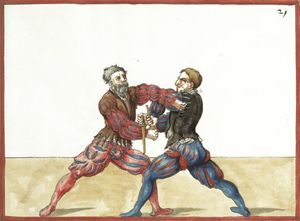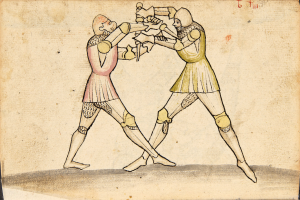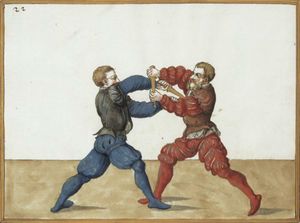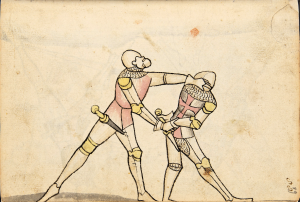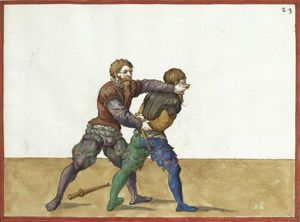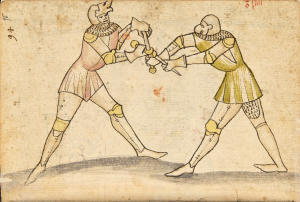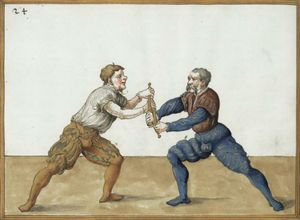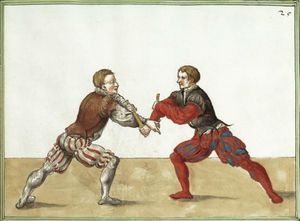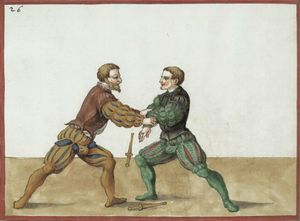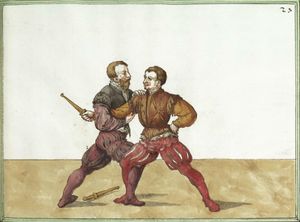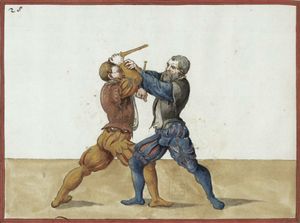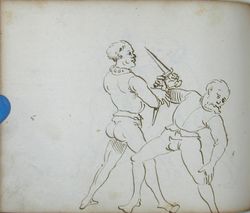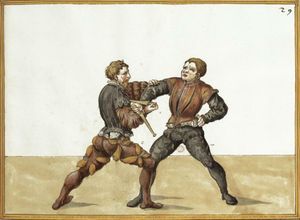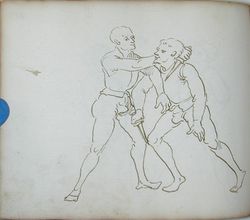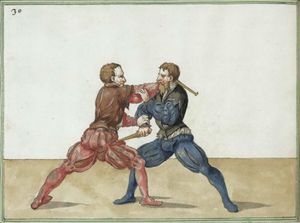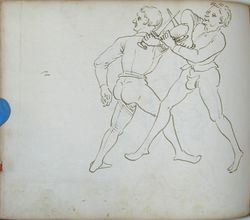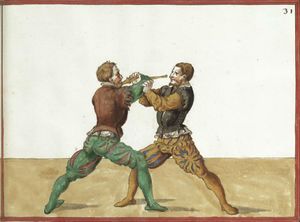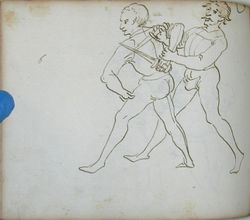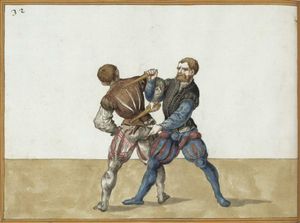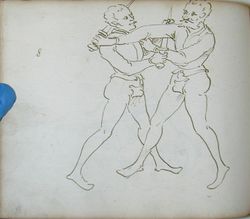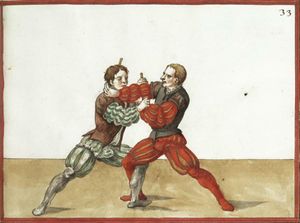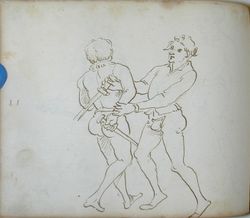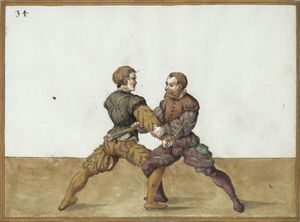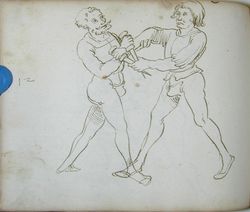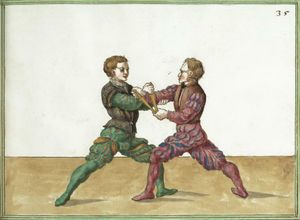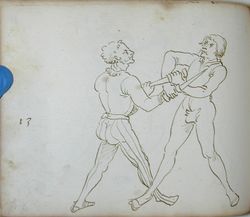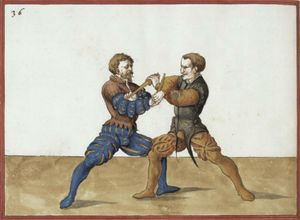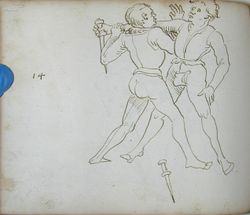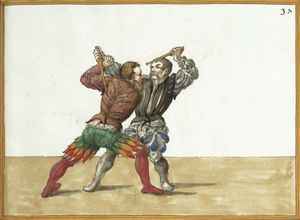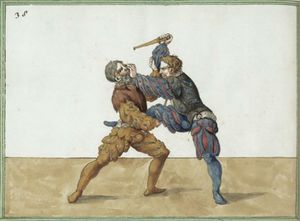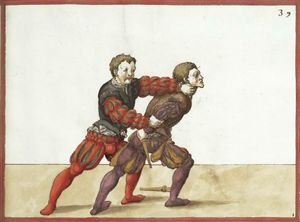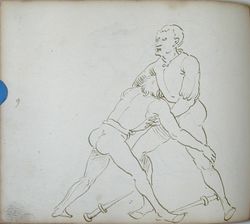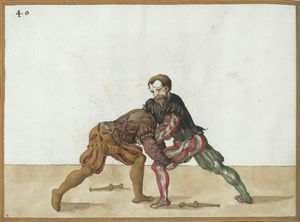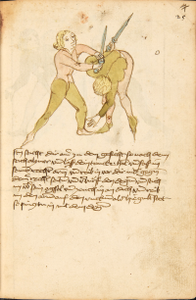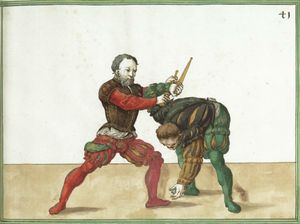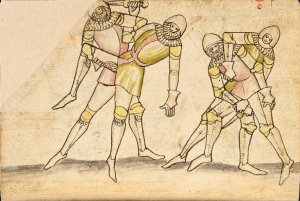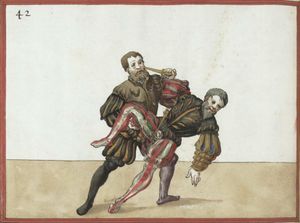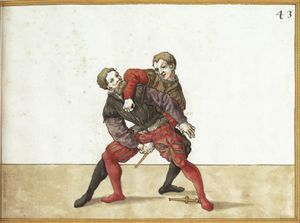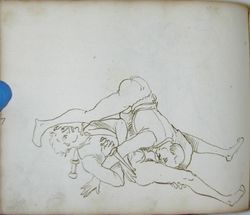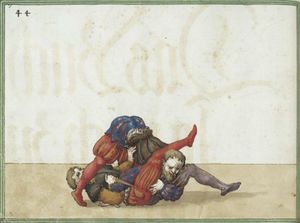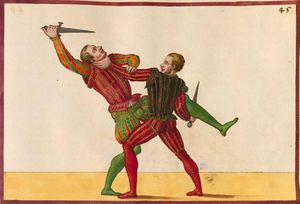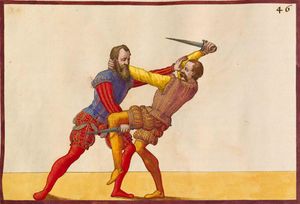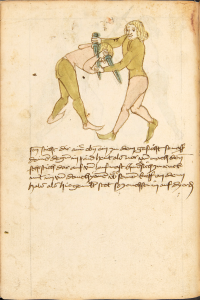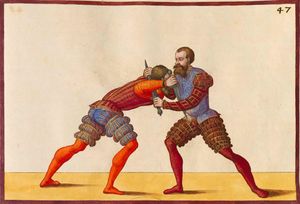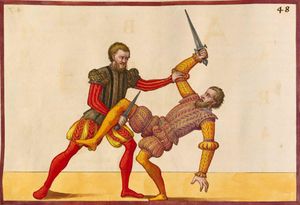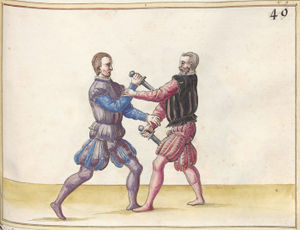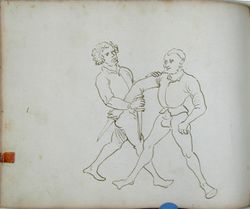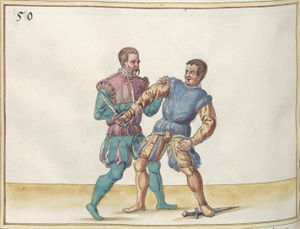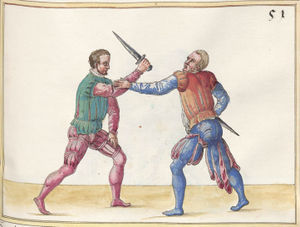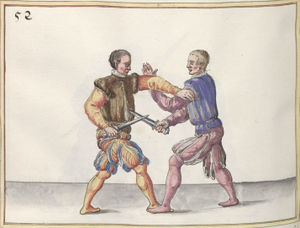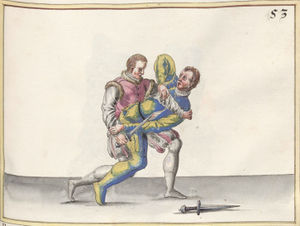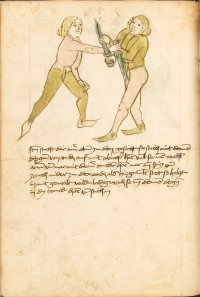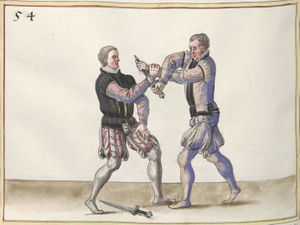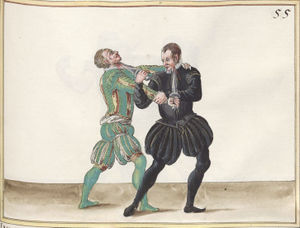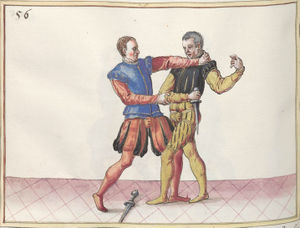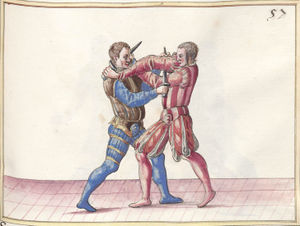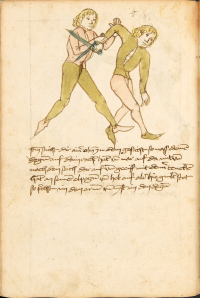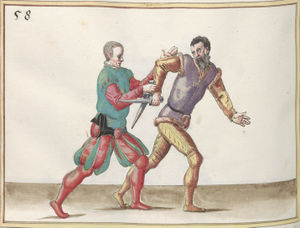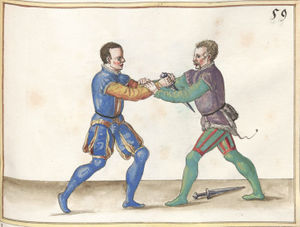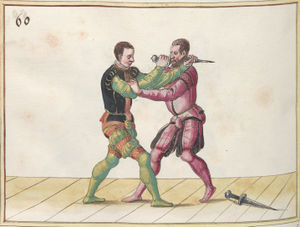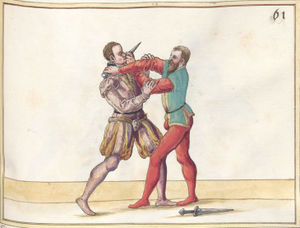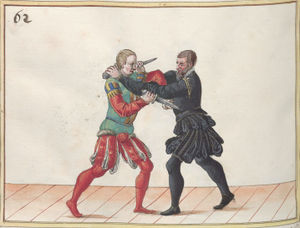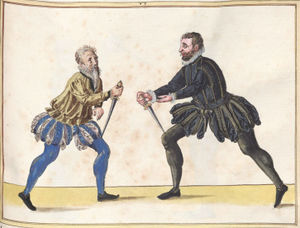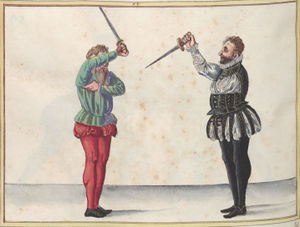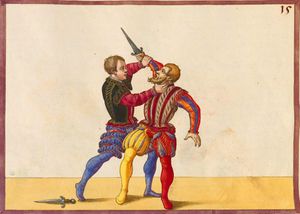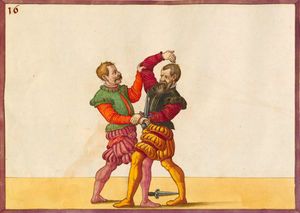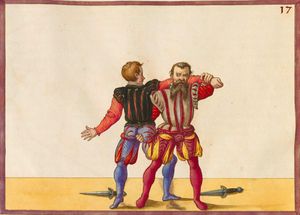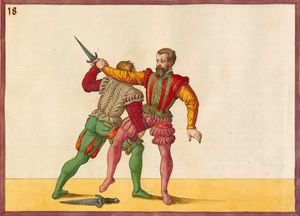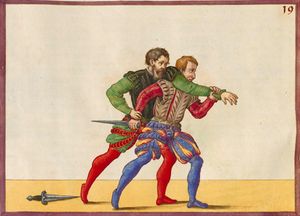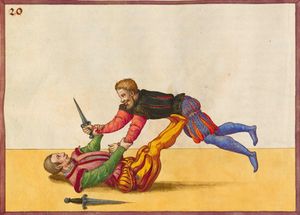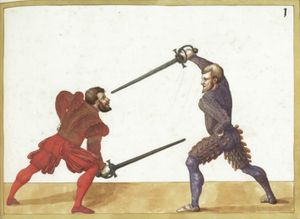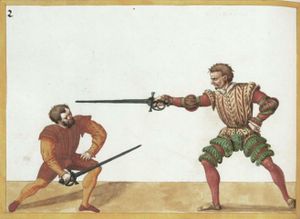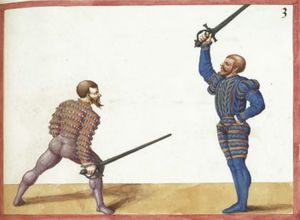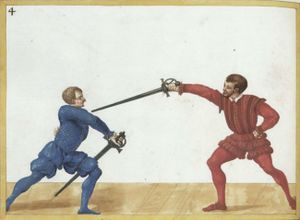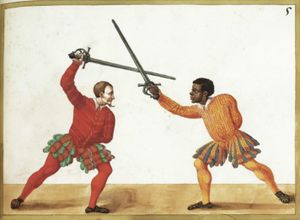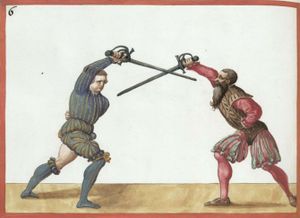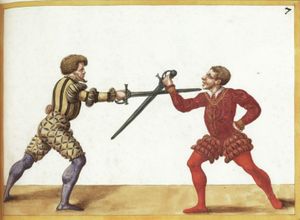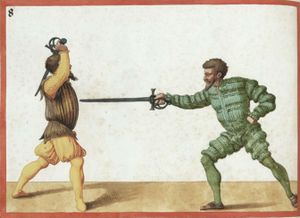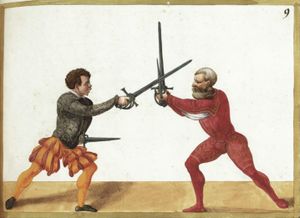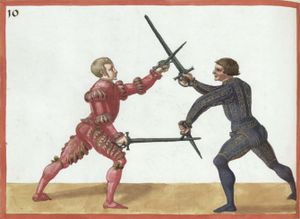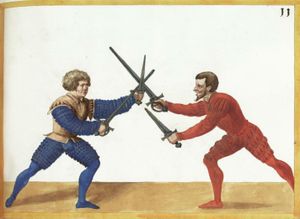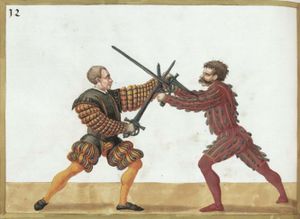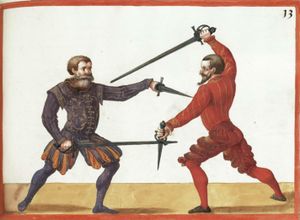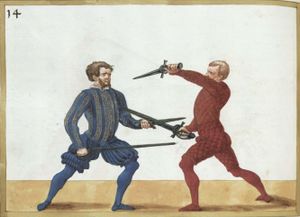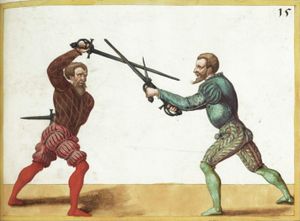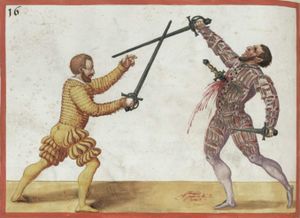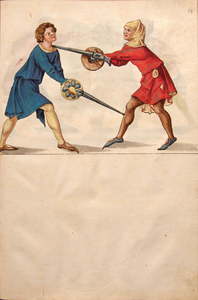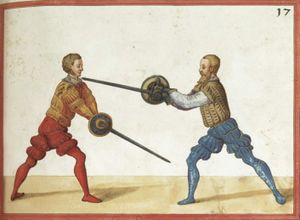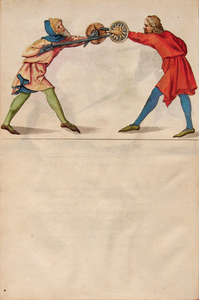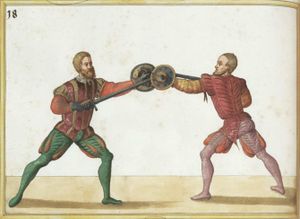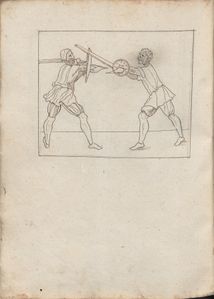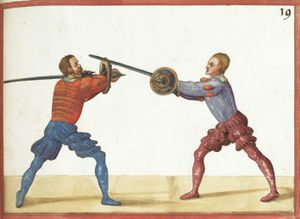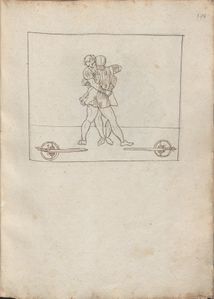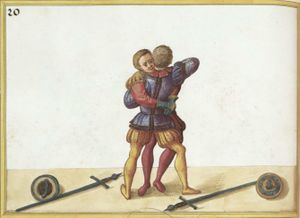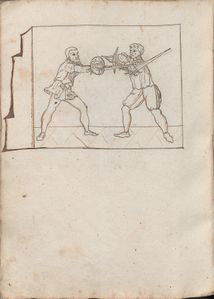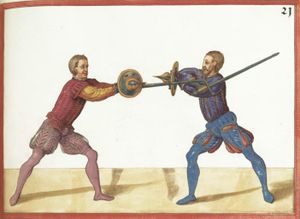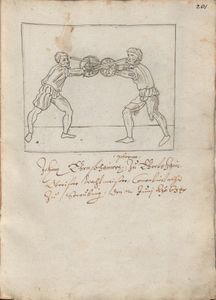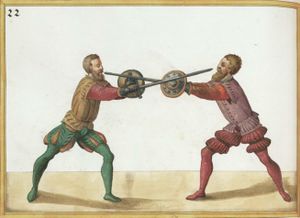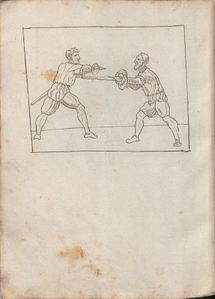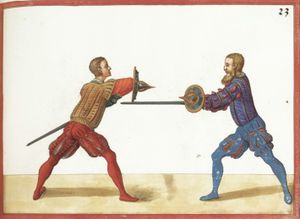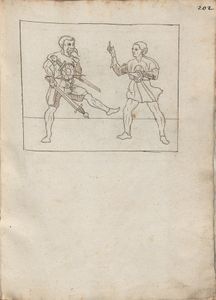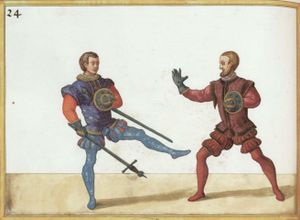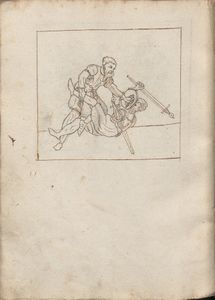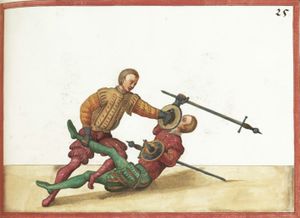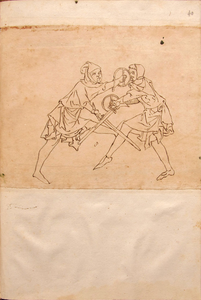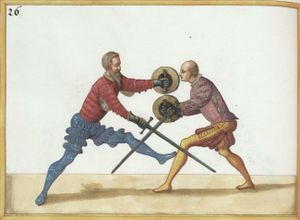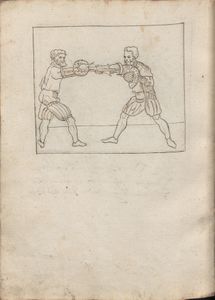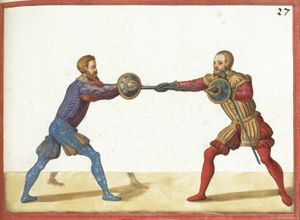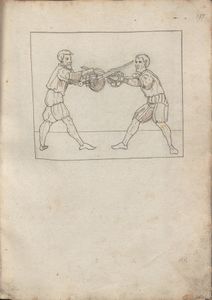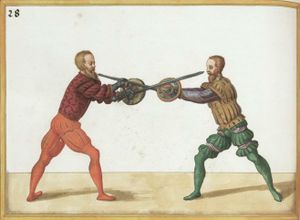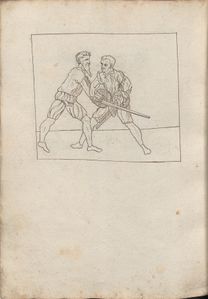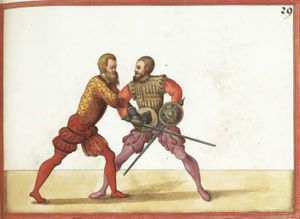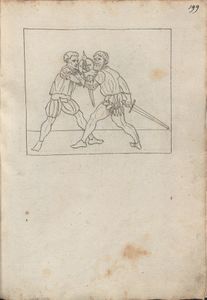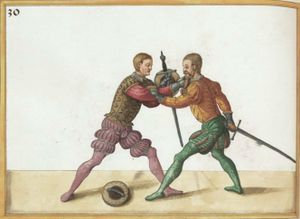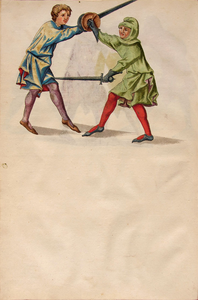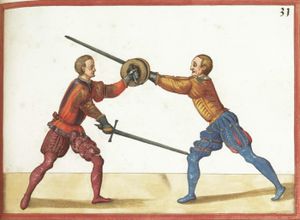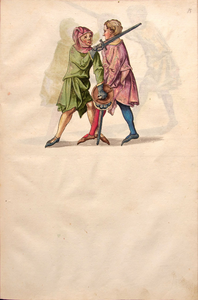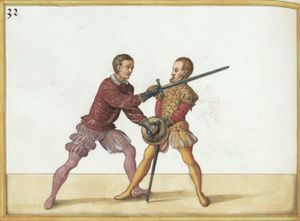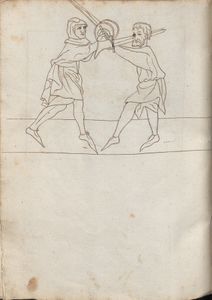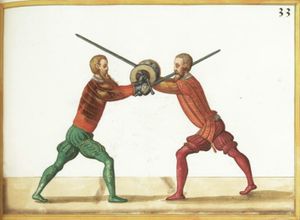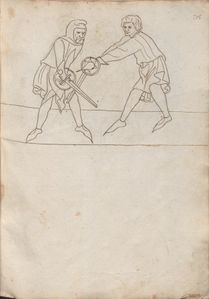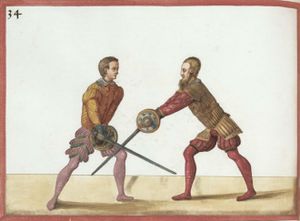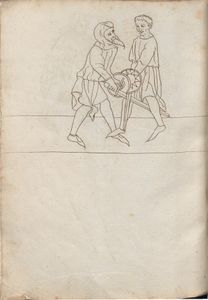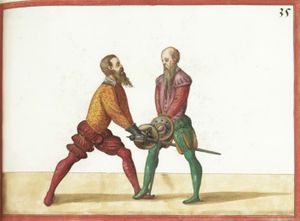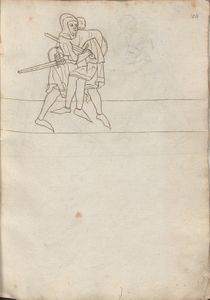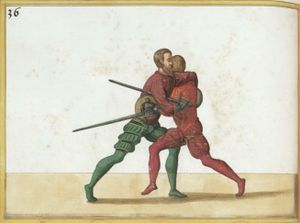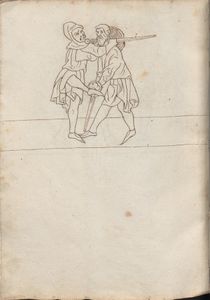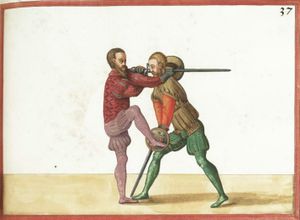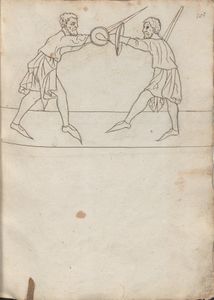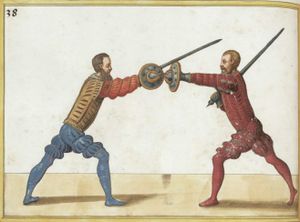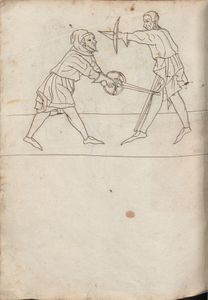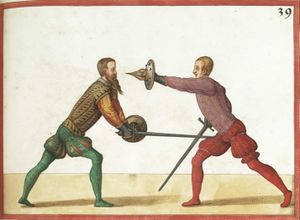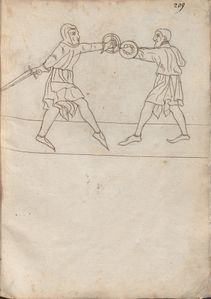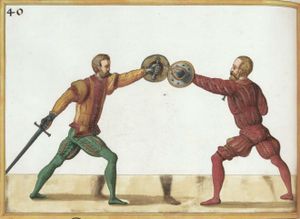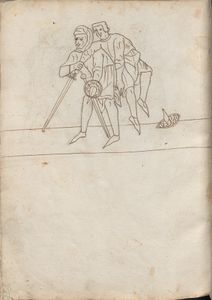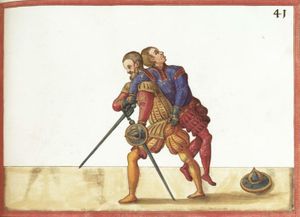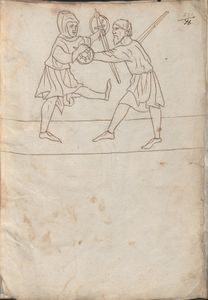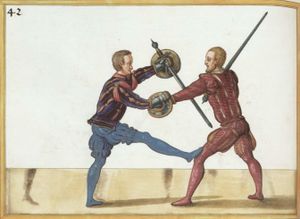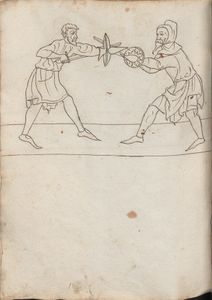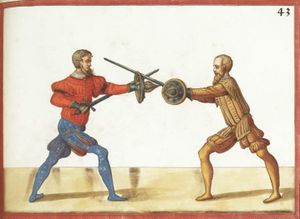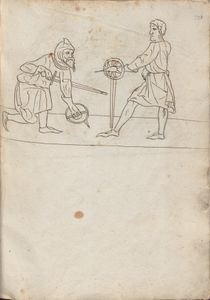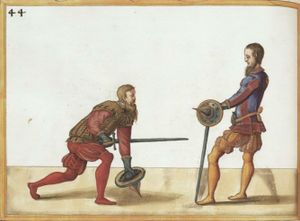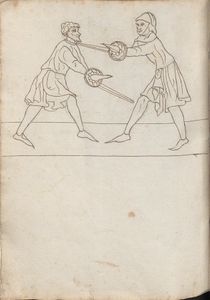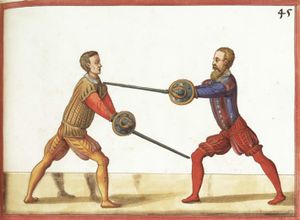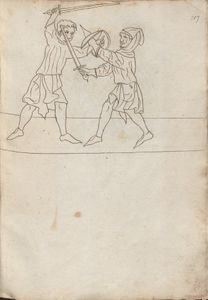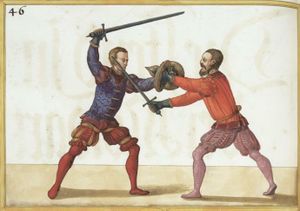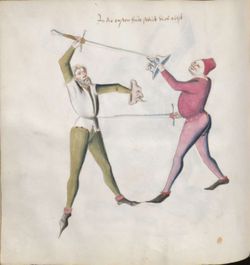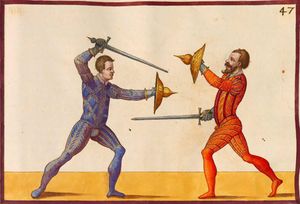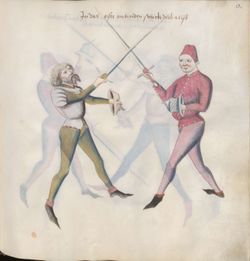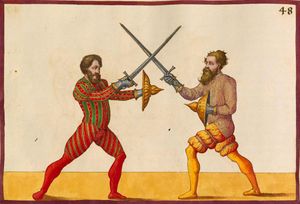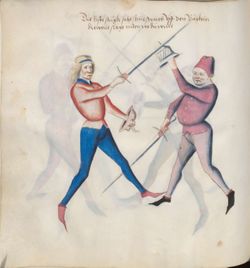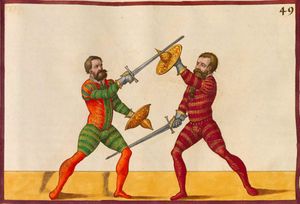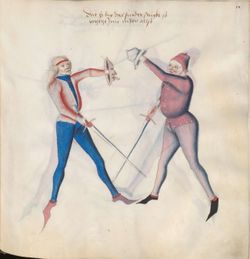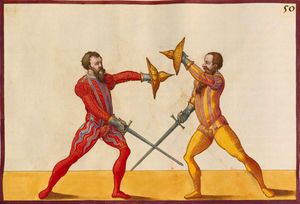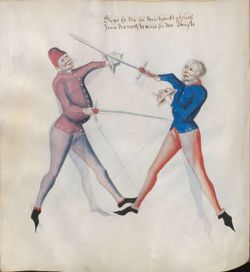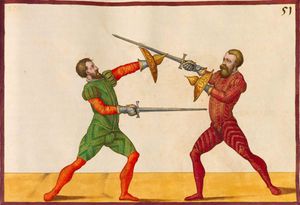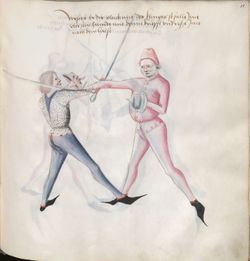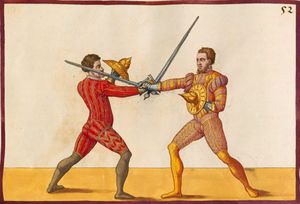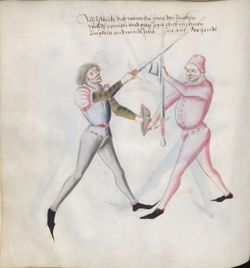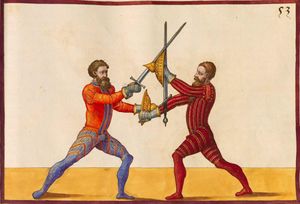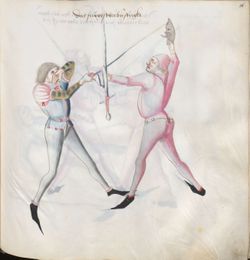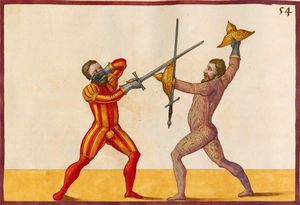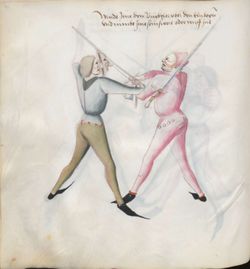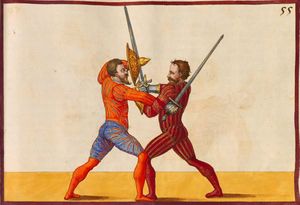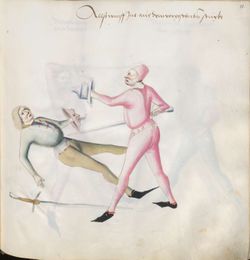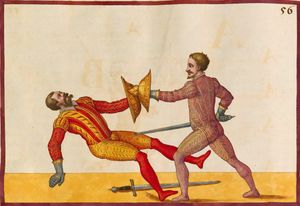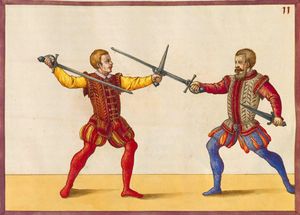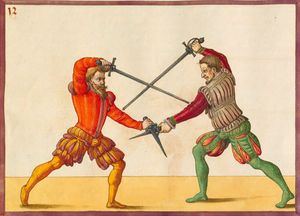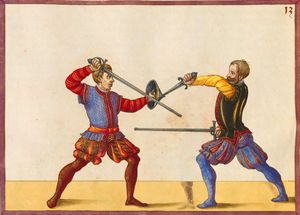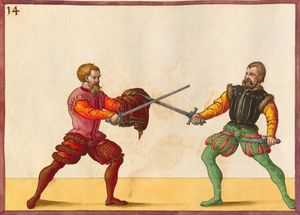|
|
You are not currently logged in. Are you accessing the unsecure (http) portal? Click here to switch to the secure portal. |
Paulus Hector Mair
| Paulus Hector Mair | |
|---|---|
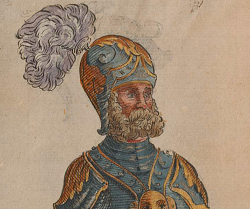 "Mair", Cod.icon. 312b f 64r | |
| Born | 1517 Augsburg, Germany |
| Died | 10 Dec 1579 (age 62) Augsburg, Germany |
| Occupation |
|
| Nationality | German |
| Movement | |
| Influences | |
| Genres | |
| Language | |
| Notable work(s) | Opus Amplissimum de Arte Athletica |
| Manuscript(s) |
Codex 10825/10826 (1550s)
|
| First printed english edition |
Knight and Hunt, 2008 |
| Concordance by | Michael Chidester |
| Translations | Traduction française |
| Signature | |
Paulus Hector Mair (1517 – 1579) was a 16th century German civil servant and fencing enthusiast. He was born in Augsburg in 1517 to a wealthy and influential family in the German middle class (Bürger). In his youth, he likely received training in fencing and grappling from the masters of Augsburg fencing guild, and early on developed a deep fascination with fencing manuals. He began his civil service as a secretary to the Augsburg City Council; by 1541, Mair was the Augsburg City Treasurer, and in 1545 he also took on the duty of Master of Rations.
Mair lead a lavish lifestyle and maintained his political influence with expensive parties and other entertainments for the burghers and city officials of Augsburg. Despite his personal wealth and ample income, Mair spent decades living far beyond his means and taking money from the Augsburg city coffers to cover his expenses. This embezzlement was not discovered until 1579, when a disgruntled assistant reported him to the Augsburg City Council and provoked an audit of his books. Mair was arrested and tried for his crimes, and hanged as a thief at the age of 62.
While Mair is not known to have ever certified as a fencing master, he was an avid collector of fencing manuals and other literature on military history, and some portion of his embezzlement was used to fund this hobby. Perhaps most significant of all of his acquisitions was the partially-completed manual of Antonius Rast, a Master of the Longsword and one-time captain of the Marxbrüder fencing guild. The venerable master died in 1549 without completing it, and Mair ultimately was able to produce the Reichsstadt "Schätze" Nr. 82 based on his notes. In sum, he purchased over a dozen fencing manuscripts over the course of his life, many of them from fellow collector David Lienhart Sollinger (a Freifechter who lived in Augsburg for many years). After Mair's death, this collection was sold at auction as part of an attempt to recoup some of the funds Mair had appropriated.
Already in Mair's lifetime some of his people's Medieval martial arts were being forgotten; this was tragic to Mair, who viewed the arts of fencing as a civilizing and character-building influence on men. In order to preserve as much of the art as possible, Mair commissioned a massive fencing compendium titled Opus Amplissimum de Arte Athletica ("The Greatest Work on the Athletic Arts"), and in it he compiled all of the fencing lore that he could access. He retained famed Augsburg painter Jörg Breu the Younger to create the art for the text, and according to Hils Mair also hired two fencing masters to pose for the illustrations.[citation needed] This project was extraordinarily expensive and took at least four years to complete. Ultimately, three copies of the massive fencing manual—six volumes in all—were produced, the first entirely in Early New High German, another entirely in New Latin, and a third including both languages.
Whether viewed as a noble scholar who made the ultimate sacrifice for his art or an ignoble thief who robbed the city that trusted him, Mair remains one of the most influential figures in the history of Kunst des Fechtens. By completing the fencing manual of Antonius Rast, Mair gave us valuable insight into the Nuremberg fencing tradition, and his extensive commentary on the uncaptioned treatises in his collection serves to make useful training aids out of what would otherwise be mere curiosities. Finally, while his collection of manuscripts was dispersed after his death, most been preserved to this day instead of disappearing as did so many others, significantly expanding the corpus of historical European martial arts literature.
Contents
Mair's Collection
The following are the fencing manuals that Mair is known to have owned during his life:
Manuscripts
- Codex I.6.2º.1 - A copy of one of Hans Talhoffer's fencing manuals, possibly the MS XIX.17-3.
- Codex I.6.2º.2 - A compilation of Jörg Wilhalm Hutter's longsword treatise and David Lienhart Sollinger's manuscript reproduction of Ergrundung Ritterlicher Kunst der Fechterey.
- Codex I.6.2º.3 - A copy of Codex I.6.4º.5 with descriptive text by Hutter.
- Codex I.6.2º.4 - Jörg Breu's sketchbook for his work on Mair's treatises.
- Codex I.6.2º.5 - A compilation of Hans Medel's revision of Sigmund Schining ein Ringeck's treatise, Medel's own writings, fencing prints by Maarten van Heemskerck, and records of the Marxbrüder fencing guild.
- Codex I.6.4º.2 - A compilation of two treatises from the Nuremberg Group and a much older, uncaptioned series of fencing drawings known as pseudo-Gladiatoria.
- Codex I.6.4º.3 - A compilation of several treatises from the tradition of Johannes Liechtenauer, possibly compiled by Jud Lew. (Not verified as being in his collection.)
- Codex I.6.4º.5 - Jörg Wilhalm Hutter's sketchbook.
- MS E.1939.65.354 - Gregor Erhart's fencing manual. (Formerly Codex I.6.4º.4.)
- Reichsstadt "Schätze" Nr. 82 - The expanded and finished version of Antonius Rast's fencing notes.
Books
- Der Altenn Fechter anfengliche kunst, compiled by Christian Egenolff
- Ringer Kunst by Fabian von Auerswald
Treatise
| Source Images | Images | Incomplete Translation |
Dresden Version I (1550s) | Vienna Version I (1550s) [German]
by Keith P. Myers |
Vienna Version I (1550s) [Latin] | Munich Version I (1550s) | Jörg Breu's Sketchbook (1545) |
|---|---|---|---|---|---|---|---|
|
[1] The Zornhaw against the Schaitler When you proceed to close with the opponent, stand with your left foot forward and it happens like this with the Zornhaw. Hold your Duseggen with extended arm above your head on the right side such that the point hangs to the rear (left side of illustration), strike with the Zornhaw to the left side of his head, immediately follow outward with your right foot, and thrust to the right side of his face. If he thrusts like this towards your face and you stand in the Schaitler with your left foot forward (right side of illustration), set his thrust aside with your long edge, follow outward with your right leg, and immediately strike to the left side of his head. If he displaces this, spring with your left foot before his right and strike with the long edge to his head. If he then strikes a long one from above towards you like this, step in with your left leg and displace his strike, then immediately strike towards him with an Underhaw from your right to his left side. |
[116r] Der zornhaw gögen dem schaitler Item wann du mit zufechteñ zu dem Mann geest. so stee mit deinem lincken fuosz vor vnnd schickh dich also mit dem zornhaw / hallt dein Duseggen mit gestracktern Arm ob deinnem haupt. deiner Rechten seitten. das der Ort zuruckh hanng. vnnd haw Im mit dem Zornhaw zu seinner Linckhen seitten. seines kopfs. Indes volg mit deinnem rechten fuosz hinnach vnd stich Im zu seiner rechten seitten. seines gesichts / sticht Er dir allso nach deinnem gesicht. vnd du mit deinnem lincken fuosz vor steest. Inn dem Schaitler. so Setz Im den stich ab mit deinner Lanngen schneiden. Vnd volg mit deinem Rechten schennckel hinnach. Indes haw Im zu seiner Lincken seitten seines kopffs / versetzt er dir das. so sprinng mit deinnem linckhen fuosz fur seinen Rechten. vnd haw Im mit Lannger schneid zu seinnem haupt. hawt Er dir dann also oben lanngein. so trit mit deinnem Lincken schennckel hinein vnd versetzt Im dem haw. Indes haw zu Im mit ainem Vnnderhaw Inn der haw von deinner Rechten zu seinner Linncken seitten |
[117r] Der zornhaw gogen dem schaitler Item: wann du mit zufechten in dem mann geest, so stee mit deinnem lincken fuoss vor unnd schickh dich also mit dem zornhaw, hallt dein duseggen mit gestracktem Arm ob deinnem haupt deinner rechten seitten das der Ort zuruck hang unnd haw Im mit dem zorenhaw zu seinner lincken seitten kopfe, Indes volg mit deinnem rechten fuoss hinnach und stich im zu seiner rechten seitten seines gesichts. Sticht er dir also nach deinnem gesicht und du mit deinnem lincken fuoss vor steest im dem schaitler, so setz Im den stich ab mit deinner lanngen schneiden und volg mit deinnem rechten schennkel hinnach, indes haw Im zu seiner lincken seiten seines kopf, versezt er dir das, so spring mit deinnem lincken fuoss fur seinen rechten und haw Im mit lannger schneid zu seinnem haupt, Hawt her dir dann also oben lanngen, so trit mit deinnem lincken schennckel hinein und versez Im dem haw, Indes haw zu Im mit ainem unnderhaw von deinner rechten zu seinner linncken seiten. |
[117r] |
[100r] Habitus ictus illius qui ex ira nomen sortitur, contra eum quo vertex adpetitur ictum. Si adversarium concesseris digladiando, pedem sinistrum praeponere memento, atque in hunc modum praedictum coaptabis: supra caput acinacem contineas brachiis porrectis, ex latere dextro, ita ut mucro retrorsum vergat. Veriasque ictum praenominatum versus laevam capitis adversarii partem, confestim vero dextro insequutus pede, mucronem contra hostis faciem dextri lateris dirigito. Sin autem adversarius habitu consimili adversum te fuerit usus, te sinistrum praefigente, consisterisque in ictu, quo vertex adpetitur, punctionem acie longa praemissa avertes, dextroque consequutus versus partem capitis eius sinistram ferias. Excipiente id adversario tum saliendo pedem sinistrum eius dextro praeponito, itaque caput adversarii acie longa porrecta appetes. Et si is eadem racione contra te utatur, sinistro introgressus eius ictum excipies. Interimque ictum inferiorem usurpando ex latere corporis tuo dextro versus adversarii latus sinistrum ferias. |
|||
|
[2] The Underhaw from Both Sides It happens that you stand in the Underhaw with your right foot forward and hold your Duseggen with the hilt in front of your head and the point extended towards the opponent (shown left side of illustration). Immediately follow outward with your left leg and strike with the Zwirch to the right side of his head. If he displaces the Zwirch, pull the blow back completely and strike again to his right arm. If he strikes you double like this at your right side and you stand with your left foot forward, set this aside with your long edge and immediately wind upwards over your head, step outward with your right foot and strike quickly to the upper opening on his right side. If he displaces this, wind the point to his face or chest. If he then sets you aside like this, follow outward with your right foot and strike from above to the top of his head. |
[116v] Der vnnderhaw vonn baiden seyten Item schickh dich Allso Inn den vnnderhaw. stee mit deinnem rechten fuosz vor vnnd hallt dein Duseggen mit dem gehultz vor deinnem haupt. den Ort gestrackt gegen dem Man. Indes volg mit deinnem Linckel schennckel hinnach vnnd haw Im die zwirch zu seinner rechten seitten seines kopffs / versetzt er dir dann die zwirch so zuckh das alle treffen vnnd haw Im wider ein zu seinem rechten arm. hawt er dir also zwifach ein auf dein rechten seitten. vnnd du mit deinnem Lincken fuosz vorsteest. so setz Im das ab mit deiner lanngen schneidin. Indes wind auf vber dein haupt. vnd trit mit deinnem rechten fuosz hinnach vnnd haw Im behennd ein zu der obern plösse seinner rechten seitten. versetzt er dir das. so wind Im den Ort zu seinem gesicht. oder der prust. setzt er dir den also ab. so volg mit deinnem rechten fuosz hinnach vnd haw Im oben zu der schaitel |
[117v] Der unnderhaw vom baiden seiten Item: schich dich Allso Im den unnderhaw stee mit deinnem rechten fuoss vor unnd hallt dem Duseggen mit dem gehultz vor deinnem haupt den Ort gestrach gegen dem ajan, Indes volg mit deinnem linckes schenncke hinnach unnd haw Im die zwirch zu seinner rechten seitten seines kopffs, versezt er dir dann die zwirch, so zuck das alte treffen unnd haw Im wider ein zu seinen rechten arm, hawt er dir also zwifach ein auf dein rechten seitten unnd du mit deinnem lincken fuoss vor steest, so sez Im das ab mit deiner lanngen schnerdin, Indes wind auf uber dein haupt und trit mit deinnem rechten fuoss hinnach unnd haw Im behennd ein zu der obern plosse seinner rechten seitten, versezt er dir das, so wind Im den Ort zu seinnen gesicht oder der prust, sezt er dir den also ab, so volg mit deinnem rechten fuoss hinnach und haw oben zu der schaitel. |
[117v] |
[100v] Ictus inferior de utroque latere. Hunc in modum in praedictum modo habitum te adaptabis: dextrum pedem praefige, et capulum acinacis pro capite contineas, mucro recta contra hostem sit porrectus. Verum insequutus sinistro transversario versus capitis eius latus dextrum uteris, et si ictum eum averterit adversarius, tum crebros ictus continuos usurpabis, atque rursum versus brachium eius dextrum feries. Sin vero is dupliciter simili ratione dextrum latum tuum appetat, sinistrum te praeponente pedem, eum longa acie praemissa avertito. Interim vero sursum supra caput acinace sublevato, consecutus dextro celeriter latus capitis adversarii dextrum, id est nuditatem supernam adpetito. Hoste id excipiente, tum mucrone versus visum vel pectus eius inflectendo diriges. Si is avertat, dextro pede consequitor, et contra verticem adversarii superne ferito. |
|||
|
[3] The Bogen from Both Sides So you come to the opponent at the closing and it happens that you stand in the Bogen (bow) with your right foot forward such that your long edge is turned upward and your point is extended towards the opponent (shown in illustration). Immediately follow outward with your left leg and strike to his right elbow from below. If he displaces this, step with your right foot in front of and inside his right foot and strike to his head from above. If he strikes to you like this from above and you also stand opposite him in the Bogen, set your right leg backwards and strike into the Zwirchhaw so that his strike is displaced. Then immediately step in with your right foot once again and strike him on his left side. If he displaces this, follow outward with your left foot and thrust to his face. If he then thrusts like this to your face, set it aside with your long edge. Then immediately step outward with your left foot and strike with the Zwirchhaw to his right arm. |
[117r] Der bogen vonn baiden seiten Item so du mit dem zufechten zu dem Mann kompst so schickh dich also Inn den pogen. stee mit deinnem rechten fuosz vor. das die Lang schneid oben gewendt sey der Orth gestrackt gegen dem mann. Inn dem volg mit deinem Lincken. schenckel hinnach vnnd haw Im von vnnden zu seinnem Rechten Elenpogen versetzt er dir das. so trit mit deinnem rechten fuosz fur seinnen rechten Innwendig vnnd haw Im oben nach seinnem haupt. hawt er dir dann also oben ein. vnd du auch gegen Im steest Inn dem pogen. so setz deinnen rechten schennckel zuruckh vnd haw dich Inn die zwirch so ist Im der haw versetzt. Indes tritt mit deinnem rechten fuosz wider hinnein. vnd haw Im ein auf sein Lincke seitten. versetzt er dir das. so volg mit deinnem lincken fuosz hinnach vnd stich zu dem gesicht. sticht Er dir dann also zu deinem gesicht so setz das ab mit deiner langen schneid Indes trit mit deinnem Lincken fuosz. hinnach vnd haw Im mit der zwirch zu seinem Rechten Arm. |
[118r] Der bogen vom baiden seiten Item: so du mit dem zufechten zu dem ajann kompff, so schickh dich also Im den Bogen, stee mit deinnem rechten fuoos vor das die lang schneid oben gewendt der Ort gestrach gegen dem mann, Imdem volg mit deinnem lincken schenckel hinnach unnd haw Im von unnden zu seinnem rechten Elenbogen, versezt er dir das so trit mit deinnem rechten fuoss fur seinnem rechten Innwendig unnd haw Im oben nach seinnem haupt, Hawt er dir daim also oben ein und du auch gegen Im stesst inn dem bogen, so sez deinnem recthen schennckel zuruckh und haw dich inn die zwirch forst Im der haw versezt, indes trit mit deinnem rechten fuoss vorder hinnein und haw Im ein auf sein lincke seitten, versezt er dir das so volg mit deinnem lincken fuoss hinnach und stich Im zu dem gesicht, Sticht er dir dann also zu deinner gesicht, so sez das ab mit deiner langen schneid, Indes trit mit deinnem lincken fuoss hinnach und haw Im mit der zwirch zu seinnem rechten arm. |
[118r] |
[101r] Arcus ex latere utroque. Quum in adversarii conspectum acinace gubernando rite perveneris, dextrum praeponere non dubitabis, ita tamen ut superne acies acinacis tui longa appareat, mucro recta in hostem porrectus. Deinde laevo pede insequeris, atque sursum de terra ad dextrum adversarii cubitum feries. Is vero si habitum hunc exceperit tum eius pedi dextro dextrum tuum pedem praepones interius, et superne caput adversarii pulsabis. Sin vero idem adversarius contra te usurparit, teque in habitu arcus consistente contra hostem dextrum pedem referes retrorsum et si feriendo usus fueris transversario ictu ictus adversarii hoc modo fuerit aversus. Subito autem crure dextro intro concedes et latus eius sinistrum feriundo acquires. Hoste id excipiente sinistro consequutus si fueris, mucronem in faciem eius infigito. Et cum ratione adversarius consimili contra te utatur, mucronem eius acie longa acinacis tui praemissa avertes, celeriter interim insequutus pede sinistro habitu transversarii dextrum hostis brachium adpetes. |
|||
|
[4] Two Absetzen from Both Sides When you go to close with the opponent, it happens that you stand in the Absetzen (Set Aside/Parry Position) with your right foot forward and hold the Duseggen at your right chest. Immediately follow outward with your left leg and strike to his right arm from below. If he strikes to your right arm like this and you also stand in the Absetzen with your right foot set forward, set it aside with your long edge. Then immediately follow outward with your left leg, grab with your left hand at his right, and strike him to his head. If he has grabbed you like this and struck one from above, set your left hand on his right elbow and shove to stop his blow. Then immediately pull your right arm back, step behind him and strike to his upper opening. He displaces this promptly, so catch him again with a Zwirchhaw to his head. If he does a Zwirchhaw like this to your head, catch him with a Krumphaw and cut to his face, then strike yourself from there to the rear. |
[117v] Zwan absetzen vonn baiden seiten Item wann du mit Dem zufechten zu dem Man geest. so schickh dich also Inn das absetzen. stannd mit deinnem Rechten fuosz vor vnd halt den duseggen an deinner rechten prust. Indes volg mit deinnem Lincken schenckel hinnach vnd haw Im von vnnden nach seinnem Rechten arm. hawt er dir also nach deinnem rechten arm. vnnd du auch Inn dem absetzen steest. deinnem rechten fuosz furgesetzt. so setz Im das ab mit deinner lanngen schneid. Indes volg mit deinem Lincken schenckel hinnach vnd begreiff mit deiner lincken hand sein rechte. vnd haw Im zu seinnem haupt. hat er dich also begriffen. vnd hawt dir oben ein. so setz Im mit deiner Lincken hand an seinnen rechten Elenpogen. so ist Im der haw verschoben. Indes zeuch deinnen Rechten arm zu dir. vnnd trit hinder sich vnnd haw Im damit zu der obern plosse / versetzt er dir das furbas. so Raisz Im wider nach mit der zwirch zu seinnem haupt. zwircht er dir also zu so fall Im krump ein vnd schneid Im zu seinem gesicht vnnd haw dich damit zuruckh. |
[118v] Zwan absetzen vom baiden seiten Item: wann du mit dem zufechten zu dem ajan geest, so schich dich also Inn das absezten stannd mit deinnem rechten fuoss vor und halt den duseggen an deinner rechten prust, Indes volg mit deinnem lincken schenckel hinnach und haw Im von unnden nach seinnem rechten arm, Hawt er dir also nach deinnem rechten arm unnd du auch Inn dem absetzen steest deinnem rechten fuoss furgesezt, so sez Im das ab mit deinner lanngen schneid, Indes volg mit deinem lincken schenckel hinnach und begreiff mit deiner lincken hand sein rechte und haw Im zu seinnem haupt, Hat er dich also begriffen und hawt dir oben ein, so sez Im mit deiner lincken hand an seinnem rechten Elenpogen, sotst Im der haw verschoben, Indes zuch deinnem rechten arm zu dir unnd trit hinder sich unnd haw Im damit zu der obern plosse, versezt er dir das furbass, so fatss Im wider nach mit der zwirch zu seinnem haupt, Zwirch er dir also zu so fatt Im krump ein und schneid Im zu seinnem gesicht unnd haw dich damit zuruck. |
[118v] |
[101v] Duae aversiones ex latere utroque. Quum ad hostem acinace more athletico regendo accesseris, dextrum praepones, atque iuxta pectus acinacem continebis dextrum, interimque insequutus pede dextro sinistro versus brachium adversarii dexrum ex loco infero sursum ferito. Si is eadem contra te facere molitur, et tu in habitu aversionis consisteris praefixo pede dextro, acie longa acinacis tuo praemissa excipies ictum. Subitoque insequere laevo, et apprehende manu tua sinistra eius dextram caput feriundo adpetito. Et si is hostis te modo eodem arripuerit, atque superne ad te feriat, tum ensis cubito dextro manum sinistram si adiunxeris vis ictus avertetur adversarii. Interea brachium tuum sinistrum versum te adducito et retrorsum si concesseris, nuditatem eius supernam pulsabis. Sed si rursum is exceperit, tum vicissim instando, nec non transversarium usurpando versus caput ferias. Cum vero eodem habitu te aggredi studuerit, curve illi incides feriundo, et perstringes incisione faciem eius, eaque ratione retrorsum ictibus gubernandis concedes. |
[34r] [No text] | ||
|
[5] The Zwingerhaw with the Schrankhut You come to the opponent at the closing and it happens that you stand in the Zwingerhaw (Swinging Strike) with your right foot forward and your Duseggen at your left shoulder (left side of illustration). Immediately follow outward with your left leg and strike his right arm. Thus you swing in so that he must displace (move out of the way). If he swings towards you like this to displace you and you stand with your right foot forward in the Schrankhut (Barrier Guard) with the point on the ground and the long edge directed at the opponent (right side of illustration), then pull your right foot back and go upwards with the Duseggen in front of your head. Then immediately step outward again with the right leg and strike to his left side. If he displaces this, hang on your right side so that the long edge is turned upwards, spring with your left foot behind his right, and strike with the Zwirch to his right ear. If he does the Zwirch like this to your right side, displace it with your long edge. Then immediately step in with your right leg and cut inward to his right arm from below while simultaneously gripping his right hand with your left so that you have gained the upper opening. |
[118r] Der zwingerhaw mit der schranckhut Item so du mit dem Zufechten zu dem Mann kompst. so schickh dich also Inn den zwingerhaw stee mit deinnem rechten fuosz vor. dein duseggen auf deinner Lincken Achsel. Indes volg mit deinnem Lincken schennckel hinnach vnnd haw Im nach seinnem rechten arm. so zwingstu In. das Er dir versetzen muosz. zwingt er dich also zuuersetzen. vnnd du mit deinnem rechten fuosz vorsteest. Inn der Schrannckhut. den Ort auf der erden. die lanng schneid gegen dem Mann. so zeuch deinnen. rechten fuosz zuruckh vnd gee mit dem duseggen auf fur dein haupt. Indes trit mit dem rechten schennckel wider hinnach vnd haw Im nach seinner lincken seitten. versetzt Er dir das so hanng auf dein rechten seitten. das die lanng schneid oben gewendt sey spring mit deinnem lincken fuosz hinder seinen Rechten vnd haw Im mit der zwirch zu seinnem rechten Ohr / zwirch er dir also. zu deiner rechten seitten. so versetz Im das mit deiner Lanngen schneid / Indes trit mit deinnem Rechten schenckel. hinein vnd schneid In mit ainem vndern schnit In seinen rechten arm. vnd In dem schnit greiff mit deiner lincken hand nach seiner rechten. so hastu Im die ober ploss abgewunnen. |
[119r] Der zwingerhaw mit der schranckhut Item: so du mit dem zufechten zu dem ajann kompst, so schich dich also Inn den zwingerhaw stee mit deinnen rechten fuoss vor dein duseggen auf deinner lincken achsel, Indes volg mit deinnem lincken schennckel hinnach unnd haw Im nach seinnem rechten arm, so zwingstu In das er dir versezenn muss, zwingt er dich also zu versezen unnd du mit deinnem rechten fuoss for steest Inn der Schrannckhut den Ort auf der erden die lanng schneid gegen dem ajann, so zeuch deinnem rechten fuoss zuruck und gee mit dem duseggen auf fur dem haupt, Indes trit mit dem rechten schennckel wider hinnach und haw Im nach seinner lincken seitten, versezt er dir das so henng auf dien rechten seiten das die lanng schneid ober gewendt sey, spring mit deinnem lincken fuoss hinder seinen rechten und haw Im mit der zwirch zu seinnem rechten ohr, zwirch er dir also zu deiner rechten seitten, so versez Im dass mit deinner lanngen schneid, Indes trit mit deinnem rechten schenckel hinein und schneid In mit ainem undern schnit In seinen rechten arm und In dem schnit greiff mit deiner lincken hand nach seiner rechten so hastu Im die ober ploss abgewunnen |
[119r] |
[102r] Habitus cogendi in custodia cancellata quo adversarius cogitur ictum tuum excipere. Si contigerit ut propius ad hostem fueris progressus in praedicti ictus habitu, dextrum oedem praeponito, acinacem supra humerum sinistrum continebis, atque sinistro pede consequitor. Si dextrum adversarii brachium appetieris, eum coges ut sui corporis defendendi rationem habere oporteat. Sed si ad sui defensionem coartatus fuerit adversarius, te dextro innitente in custodia cancellata, ut mucro terrae infixus sit, nec non acies longa versus adversarium consistat, dextrum pedem referto, et acinacem supra caput elevato. Interea dextro rursum insequutus latus eius sinistrum ferias. Id si hostis exceperit, tum in latus dextrum acinacem demitte acie eius longa superne apparente, insiliendo pedem sinistrum adversarii dextro postpones, ictuqu transversario hostis aurem dextram tundes. Verum si is idem moliatur adversus te, id acie acinacis tui longa praemissa avertere non dubitabis. Interea tandem introgredere pede dextro et incisione inferiori adversarii brachium dextrum saucies, atque in ipso incisionis actu manu sinistra eius dextram si captaris primas partes auferes, idque efficies, ne superiorem nuditatem laedere possit adversarius. |
|||
|
[6] The Entrusthaw against the Oberhaw It happens that you stand in the Entrusthaw (Anger Strike) with your left foot forward and hold your Duseggen with the hilt at your right knee such that the point is turned towards the opponent (left side of illustration). He then strikes to your upper opening, so follow outward with your right foot and go with your Duseggen up over your head so that the long edge is turned upward and his strike is displaced. Then immediately strike quickly with the Zwirch to his right ear. If he strikes like this with a Zwirch to your right ear and you stand with your right foot forward, displace him with your long edge and follow outward with the left foot. Then quickly flow off (Ablauffen) and strike his right arm. If he displaces this, follow after him double with a thrust to his face or chest. If he then follows after you like this, step to the rear with your right leg and strike him at the same time double to his head. If he strikes double like this towards you, step with your right foot in front of his left and wind with your short edge on his long edge at his left side. Then immediately cut to his face or neck. |
[118v] Der entristhaw Gogen dem Oberhaw Item schickh dich Allso mit dem Entristhaw. stee mit deinnem lincken fuosz vor vnnd hallt dein duseggen auf deinnem rechten knie mit dem hefft. das der Ort gegen dem Mann gewenndt sey hawt Er dann deinner obern ploss zu. so volg mit deinnem rechten fuosz hinnach vnnd gee mit dem duseggen. auf vber dem haupt. das die lanng schneid oben gewenndt sey. so ist Im der haw versetzt. Indes haw dich behendigelich Inn die zwirch nach seinnem rechten Ohr zwircht er dir dann also zu deinnem rechten Ohr. vnd du mit deinnem rechten fuosz vorsteest. so versetzt Im das mit deinner Lanngen schneid vnd volg mit dem lincken fuosz hinnach. lasz Inn dem behend ablauffen. vnd haw Im nach seinem rechten Arm. versetzt Er dir das furbas. so Raisz Im zwifach nach mit ainnem stich nach seinnem gesicht. oder der prust. begert Er dir dann also nach zuraisen. so trit mit deinnem rechten schennckel zuruckh vnd haw Im Indes zwifach nach seinnem haupt hawt er dir dann zwifach nach so tritt mit deinnem rechten fuosz fur seinnen. Lincken vnnd wind mit deiner kurtzen schneid auf sein lannge. auf sein lincke seitten. Indes schneid Im nach seinem gesicht oder dem hals |
[119v] Der entrusthaw gogen dem oberhaw Item schich dich also mit dem Entristhaw steennt deinnem lincken fuoss vor unnd halte dein duseggen auf deinnem recthen knie mit dein hefft das der Ort gegen dem ajann gewenndt sey, hawt Er dann deinner obern vloss zu, so volg mit deinnem rechten fuoss hinnach unnd gee mit dem duseggen auf ober dien haupt das die lanng schneid oben gewenndt sey, so ist Im der haw versezt, Indes haw dich behendiglich Inn die zwirch nach seinnem rechten Ohr, zwirch er dir dann also zu deinnem rechten Ohr und du mit deinnem rechten fuoss vor stesst, so versez Im das mit deinner lanngen schneid und volg mit dem lincken fuoss hinnach, lass Inn dem behend ablauffen und haw Im nach seinem rechten Arm, versezt Her dir das furbas, so raiss Im zwifach nach mit ainnem stich nach seinnem gesicht oder der prust begert, Er dir dann also nach zuraisen , so trit mit deinnem rechten schennckel zuruch und haw Im Indes zwifach nach seinnem haupt, Hawt er dir dann zwifach nach, so trit mit deinnem rechten fuoss fur seinnen lincken unnd wind mit deinner kurzen schneid auf sein lannge auf sein lincke seitten, Indes schneid Im nach seinnem gesicht oder dem hals. |
[119v] |
[102v] Ictus severus contra ictum supernum. Eum habitum ita exercebis: sinistrum pedem praeponito, et acinacem supra genu dextrum tuum contineto ex capulo ita ut mucro contra adversarium sit porrectus, et si versus nuditatem supernam adversarius feriat, dextro pede consequitor, et elevato acinace supra tuum caput, conversa acie longa superne, frustra hostis feriet, eadem ratione eius ictus eludetur. Celeriter autem transversarius ictum usurpando adversarii aurem dextram pulsabis. Sin vero habitu consimili is usus fuerit contra te, te dextrum praefigente pedem, ictum eius acie longa praemissa avertes. Sinistro insequitor, et celeriter ictu iterato, eius brachium dextrum adpetito. Sed si is rursus ictum averterit, dupliciter instando consequeris, mucronem in faciem eius vel pectus infigendo. Quum vero modo non dissimili tibi obviarit, pedem dextrum referto, et caput eius ictu gemino appetes. Sin autem is eadem ictus ratione contra te utatur, tum pedem dextrum adversarii sinsitro praepones, atque aciem acinacis tui brevem in eius longam inflectendo adpones versus adversarii latus sinsitrum, et inde incidendo in eius faciem vel collum prorumpes. |
|||
|
[7] A Low Mundiern with a Geferhaw When you come to the closing with the opponent, it happens that you stand in the low Mundiern (transition/changer) with your right foot forward, the long edge below the hilt near your right knee such that the point is going in between your legs. Immediately go up and follow outward with your left leg such that your long edge is turned upward and the point directed at the opponent. Follow outward with your right foot once again and strike with the long edge to his head. You stand against him in the Geferhaw (Danger Strike) with your right foot set forward and he strikes like this at you. Set your right leg to the rear again and go with your Duseggen well up over your head such that the long edge stands above. Thus his strike is displaced. Then immediately work quickly at the weak and strong seeking from one opening to another, from below and above. If he then seeks your openings like this from above, Duplier (double) the opponent towards his face so that you deceive him to think you have made a following stroke to his head. If he consequently sets this aside, strike a Creizhaw (Cross Strike) in front of his face to his right arm. |
[119r] Ein vnders Mvndiern mit ainem Geferhaw Item wann du mit dem Zufechten zu dem man kumpst. so schickh dich also mit dem vnndern Mvndiern. stee mit deinnem Rechten fuosz vor die lanng schneid vnnden. das hefft bey deinnem rechten knie. das der Ort zwischen deinnen painnen hinaus gee. Indes gee auf vnd volg mit deinnem lincken schenckel hin. nach das dein lannge schneid oben gewenndt sey / der Ort gegen dem Man. vnd volg mit deinnem rechten fuosz wider hinnach vnd haw Im mit lannger schneid nach seinnem haupt. stastu dann also gegen Im Inn dem Geferhaw. deinnen rechten fuosz furgesetzt. vnd er also auf dich hawt. so setz deinnen rechten schennckel wider zuruckh vnnd gee mit deinnem Duseggen wol auf vber dein haupt das die lanng schneid oben stee. so ist Im der haw versetzt. Indes arbait behendigclich nach der schweche vnd stercke. von ainner plosse zu der andern. vnnden vnd oben. sucht Er dir dann deinne plösse also. oben duplier vnden Mvndier. gegen seinem gesicht. so blendstu In. das du ain voligen straich auf In gehaben magst. zu seinem haupt. setz er dir den also ab so haw ainen Creitzhaw vor seinem gesicht nach seinem rechten arm |
[120r] Ein unders Mundiern mit ainem Geferhaw Item: wann du mit dem zufechten zu dem man kumpst, so schich dich also mit dem unndern Mundiern stee mit deinem rechten fuoss vor die lanng schneid unnden das hefft bey deinnem rechten knie das der Ort zwischen deinnen vammen hin auf gee, Indes gee auf und volg mit deinnem lincken schenckel hinnach das dein lannge schneid oben gewenndt sey der Ort gegen dem ajan und volg mit deinnem rechten fuoss wider hinnach und haw Im mit lannger schneid nach seinnem haupt, stastu dann also gegen Im Inn dem Geferhaw deinnen rechten fuoss fur acsezt und er also auf dich hawt, so sez deinnen rechten schennckel wider zuruch unnd gee mit deinnem Duseggen wol auf uber dein haupt das die lanng schneid oben stee sorzst Im der haw versezt, Indes arbait behendiglich nach der schwech und stercke von ainner plosse zu derandern unnden und oben sucht, Er dir dann deinne plosse also oben duplier unden ajundier gegen seinem gesicht so blendstu In das du ain voligen starch aufzn gehaben magst zu seinem haupt, sez er dir den also ab, so haw ainen creizhaw vor seinem gesicht nach seinem rechten arm. |
[120r] |
[103r] Mutatio acinacis inferna cum ictu fortuito. Si quando ad hostem accesseris, in eum habitum hoc modo te aptabis: dextrum pedem praeponito, acies tui acinacis inferior consistat, capulus iuxta dextrum genu appareat, ita ut mucro intra utrumque pedem retrorsum vergat. Interimque acinacem levabis sursum sinistro insimul consequitor, ut tamen acies longa superior existat, mucroque contra adversarium porrectus, atque rursus crure dextro insequutus, acie longa praemissa caput eius pulsato. Sin vero in ictu praedicto scilicet fortuito constiteris, dextrum pedem praeponens, isque te hac ratione aggreditur, dextrum referto, et acinace sursum supra caput sublato, ut acies longa appareat, ita ictus adversarii fuerit elisus. Interea tandem memineris, ut certes cum ipso ex loco acinacis infirmiori et firmiori aliam nuditatem ex alia requirendo tum superne tum inferne. Verum si adversarius nuditates tuas eadem ratione perquisiverit superne duplicabis, inferne mutabis contra faciem ipsius adversarii, et eo modo occaecabis eum, ut eo potentiorem perfectioremque ictum versus caput eius regere possis. Eum si adversarius averterit, tum ictum cruciatum in ipsius conspectu sev pro facie usurpando brachium eius dextrum appetes. |
|||
|
[8] Two Positions from which the Creizhaw Proceeds When you come together at the closing, it happens with these positions: your right foot is set forward, your Duseggen held with the hilt near your right knee with your left hand behind near the point (left side of illustration). He then strikes to your opening from above, so go up with your Duseggen above your head such that your left foot is set forward. Thus his strike is displaced. Then immediately strike with a doubled Creuzhaw (Cross Strike) to his head. If he strikes you double like this from above and you have your Duseggen at your right leg with the long edge directed at your opponent, the point directed at the ground, and your right foot set forward (right side of illustration), shove this away crosswise with your short edge. Then immediately set upon him with a cut from below on his right arm and grab his right elbow with your left hand so that you shove him from you. Follow outward with your left leg and strike him to the upper opening. If he shoves you from himself like this and intends to strike you from above, spring backwards with your left foot so that you can once again come to your work. |
[119v] Zway leger darausz die Creytzhew gand Item wann Ir mit dem zufechten zusamen Koment. so schickh dich also mit disem Leger deinnen Rechten fuosz furgesetzt. dein duseggen mit dem hefft bey deinnem rechten knie dein linncke hannd hinden beydem Ort. hawt er dir dann oben nach deiner plösse. so gee auf mit deinnem. Duseggen vber dein haupt. das dein linncker fuosz furgesetzt sey. so ist Im der haw versetzt. Indes haw Im mit ainnem dopelten Creutzhaw zu seinnem haupt. hawt Er dir dann also. zwifach oben ein vnnd du deinen Duseggen auf deinnem Rechten schennckel. hast. die lanng schneid gegen dem Man den ort gegen der erden deinnen rechten fuosz / furgesetzt. so verscheub Im das Creutzweysz. mit deinner kartzen schneid Indes setz Im mit ainem vnndern schnit an seinen rechten arm vnnd greiff mit deiner lincken hand an seinnen rechten Elenpogen. so scheubstu In von dir. volg mit deinnem lincken schenckel hinnach vnd haw Im zu der obern plösse. scheubt er dich also von Im vnnd begert dir oben ein zuhawen. so spring mit deinnen lincken fuosz hindersich. so kannstdu wider umb zu deiner arbait komen. |
[120v] Zwan leger darauss die Creiizhew gand Item: wann Ir mit dem zufechten zu zusamen koment, so schich dich also mit disem Leger deinnen rechten fuoss furgesezt dein duseggan mit dem hefft bei deinnem rechten knie dein linncke hand hinden bey dem Ort, hawt er dir dann oben nach deinner plosse, so gee auf mit deinnem Duseggen uber dein haupt das dein linncker fuoss fur gesezt, so ist Im der haw versezt, Indes haw Im mit ainnem dopelten Creuzhaw zu seinnem haubt. Hawt Er dir dann also zwifach oben ein unnd du dein Duseggen auf deinnem rechten schennckel hast, die lanng schneid gegen dein ajan den ort gegen der erden deinnen rechten fuoss fur gesezt, so verscheub Im das Creuzweyss mit deinner kurzen schneid, Indes sezt Im mit ainnem unndern schnit an seinen rechten arm unnd greiff mit deiner lincken hand an seinnen rechten Elenpogen, so scheubstu In von dir, volg mit deinnem lincken schenckel hinnach und haw Im zu der obern plosse, scheubt er dich also von Im unnd begert dir oben ein zu hawen, so spring mit deinnem lincken fuoss hindersich so kannstdu widerumb zu deiner arbait komen. |
[120v] |
[103v] Duo castra sev habitus unde ictus cruciati formantur. Quum acinace rite gubernando ad invicem fueritis congressi, dextrum praepones iuxtaque genu dextrum acinacis tui capulum continebis, manum sinistram prope mucronem, et si adversarius superne nuditatem tuam adpetat feriundo, tum supra caput tuum acinacem tolles sursum, sinistro tamen pede praefixo, et ea ratione facile ictum adversarii eludes. Subito autem caput eius ictu duplici cruciato affliges. Verum si idem contra te fuerit molitus adversarius, te supra pedem dextrum acinacem continente, acie longa contra hostem porrecta si sit, mucro versus terram deorsum, atque dextrum praeposueris, adversarium crucis modo acie brevi avertito. Interea autem brachio eius dextro incisionem infernam si impresseris, atque cubito ipsius dextro manum laevam adiunxeris, adversarium propelles. Insequutus confestim pede sinistro eius nuditatem supernam feriundo inquires. Sin vero is te eodem habitu repulerit, nec non superne cupiat pulsare tuum, pedem sinistrom resiliendo si retuleris ictus tuos rursum resumere licebit, adversario vel minime praepediente. |
|||
|
[9] Perceiving the Weak and Strong When you come together at the closing, set your right foot forward and strike him in opposition in the bind. Perceive whether he is soft or hard with his Duseggen. If he is hard and holds against you strongly, follow outward with your left leg and allow the weak to quickly pass and strike his head on his right side. If he then strikes you like this from above and you also stand against him in the bind with your right foot set forward, follow outward with the left and displace his strike with the strong of your Duseggen. Then immediately step in once more with your right leg and strike to his left side. If he displaces this, pull the right foot back again and thrust to his face. If he then thrusts like this to your face, take the thrust away with your short edge and cut with the long edge to his face. If he cuts like this to your face, drop a Krump on him so that you have the cut as good as he and may work with him all the previous techniques. |
[120r] Des empfinden schwech vnnd sterckh Item wann Ir mit dem zufechten zusamen kument. so setz deinnen rechten fuosz vor. vnnd haw Im entgegen. vnd Inn dem anpvnd so empfind ob er waich oder hert sey ann seinnem duduseggen. Ist er hert vnnd hellt dir starckh wider. so volg mit deinnem lincken schenckel hinnach vnnd lasz die schwech behend lauffen. vnnd haw Im nach seinem haupt. seinner Rechten seiten. hawt Er dir dann also oben zu. vnnd du dich auch gogen Im hawst. Inn das anpinden deinnen rechten fuosz furgesetzt. so volg mit dem lincken hinnach / vnd versetz Im seinen haw mit der sterckh. deines Duseggens. Indes trit mit deinnem Rechten schennckel wider hinnein vnd haw Im nach seiner lincken seiten. versetzt er dir das so zeuch den rechten fuos wider zuruckh vnd stich Im zu seinnem gesicht / sticht er dir dann also nach deinnem gesicht. so nimb den stich hinweckh mit deinner kurtzen schneid. vnnd schneid Im mit lannger schneid nach seinnem angesicht. schneidt Er dir also nach deinem angesicht. so fall. Im krump ein so hastu den schnit als gut als er. vnnd magst mit Im arbaiten alle vorige stuckh ·/· |
[121r] Des empfinden schwech unnd sterck Item: wann Ir mit dem zufechten zusamen kament, so sez deinnem rechten fuoss vor unnd haw Im entgegen und Inn dem anpund so empfind ob er waich oder hert senam seinnem duseggan, Ist er hert unnd hellt dir starch wider, so volg mit deinnem lincken schenckel hinnach unnd lass die schwech behend lauffen unnd haw Im nach seinnem haupt seinner rechten seitten, hawt Er dir dann also oben zu unnd du dich auch gogen Im hawst Imm das anpunden deinnen rechten fuoss furgesezt, so volg mit dem lincken hinnach und versez Im seinnen haw mit der sterck deines Duseggens, Indes trit mit deinnem recthen schennckel vor der wider hinnein und haw Im nach seiner lincken seiten, versezt dir das, so zeuch den rechten fuoss wider zuruck und stich Im zu seinnem gesicht, sticht er dir dann also nach deinnem gesicht, so nimb den stich hinweck mit deinner kurzen schneid unnd schneid Im mit lannger schneid nach seinnem angesicht, schneidt Er dir also nach deinem angesicht, so fatt Im Krump ein, so hastu den schnit als gut als er unnd magst mit Im arbaiten alle vorige stuck. |
[121r] |
[104r] Habitus sentiendi. Quando congrediendo prope coniungimini, dextrum praeponas necesse erit, et si adversario ombiam feriundo veneris, in primo contactu acinacium diligenter observabis, an firmis vel imbecillus acinace tenendo sit. Si firmus fuerit repertus, fortiterque restiterit, pede sinistro insequeris, celeriter si loco acinacis tui imbecilliori, qui est iuxta mucronem fueris usus partem capitis adversarii dextruam adpetes. Si autem is idem contra te moliatur, tuque vicissim primo acinacium contactu utaris versus adversarium, praeponens pedem dextrum, tum sinistro consequitor atque eius ictum eludes loco acinacis firmiori, qui est versus capulum. Interim memineris ut pedem dextrum rursus introponas, nec non versus latus adversarii sinistrum ferias. Hoste id excipiente, tu dextro relato pede, mucronem in faciem eius infigito. Ceterum, si hoc habitu contra te fuerit usus, eum acie acinacis tui brevi deflectes, atque acie longa eiusdem proscindendo eius faciem appetes. Cum vero is eadem conetur adversus te, curve ei obviam acinace gubernando si processeris, tum aeque ac adversarius incisione uti poteris, nec non omnes modo praedictos habitus exercere tibi licebit. |
|||
|
[10] A Cut with a Reyssen When you come before the opponent, it happens that you stand with your right foot forward, your Duseggen extended well away from you, and cut to his head. If he intends to cut to you like this and you also stand with the right foot opposite him, strike a straight strike to his head and in the process drop your hilt over his right arm near his Duseggen and snatch (Reyssen) downwards so that you have countered his cut. Then immediately follow outward with your left leg at this right side and strike with the Zwirchhaw to his head. If he does a Zwirchhaw like this towards your head, set your right leg back and displace his Zwirch with your long edge. Then immediately shoot in with your Duseggen to his face. Should he perceive the shooting in (Einschiessen) and displace it, step in with your right foot once more and let a double Feler (failer/feint) quickly pass. Then immediately strike his right arm. If he strikes like this to your right side, step in the triangle and turn the long edge above your head so that the strike goes along your long edge. Then immediately follow after him double and strike to his upper opening. |
[120v] Ein schnit mit ainnem Reyssen Item wann du Fur den Mann kumpst. so schickh dich also mit deinnem Duseggen. das der recht fuosz vorstee. streckh deinnen arm wol von dir vnd schneid Im nach. seinnem haupt. begert er dich also zu schneiden. vnnd du auch mit dem rechten fuosz gegen Im steest. so haw einnen geraden haw. Im zu dem haupt. vnnd Inn dem einhawen fall Im mit deinnem gehultz vber seinnen rechten arm. bey seinnem duseggen. vnnd reys damit vnndersich. so hastu Im den schnit prochen Indes volg mit deinnem lincken schennckel hinnach auf sein rechten seitten. vnnd haw Im mit der zwirch zu seinnem haupt. Zwircht er dir also zu deinnem haupt. so setz deinen rechten schennckel. zuruckh vnnd verscheub Im die zwirch mit deinner lanngen schneid Indes scheusz Im mit deinnem duseggen. zu seinnem gesicht. wirt Er des ein schiessens gewar. vnd versetzt dir das. so trit mit deinnem Rechten fuosz wider hinein vnnd lasz ain zwifachen feler behennd lauffen. Indes haw nach seinnem rechten arm. hawt er dir also deinner rechten seitten zu. so trit Inn. trianngel vnnd wend die lanng schneid vber dein haupt. so geet der haw hinweckh. auf deinner langen schneid Indes raiss Im zwifach nach vnd haw Im zu seinner obern plosz. |
[121v] Ein schnit mit ainnem renssen Item: wann du fur den ajann kumpst, so schick dich also mit deinnem Duseggan das der recht fuoss vor stee streck deinnen arm wol von dir und schneid Im nach seinnem haupt, begert er dich also zu schneiden unnd du auch mit dem rechten fuoss gegen Im steest, so haw einnen geraden haw Im zu dem haupt unnd Inn dem anbaiven fall Im mit deinnem gehulz over seinnen rechten arm bey seinnem duseggen unnd reys damit unndersich, schastu Im den schnit vrechen, Indes volg mit deinnem lincken schennckel hinnach auf sein rechten seitten unnd haw Im mit der zwirch zu seinnem haupt. Zwircht er dir also zu deinnem haupt, so sez deinnen rechten schennckel zuruck unnd verscheub Im die zwirch mit deinner lanngen schneid, Indes scheuss Im mit deinnem duseggen zu seinnem gesicht, wirt Er des einschiesens gewar und versezt dir das, so trit mit deinnem rechten fuoss wider hinein unnd lass ain zwifachen feler behennd lauffen, Indes haw nach seinnem rechten arm, hawt er dir also deinner rechten seiten zu, so trit Inn trianngel unnd wend die lanng schneid uber dein haupt so geet der haw hinweck auf deinner langen schneid, Indes raiss Im zwifach nach und haw Im zu seinner obern ploss. |
[121v] |
[104v] Incisio addito simul habitu vellendi. Si prope adversarii conspectum perveneris, omnium primum sit, ut pedem praeponas dextrum, brachium quantum poteris cum acinace extendendo caput eius perstringes incisione. Porro, si idem contra te moliatur adversarius, tuque vicissim dextro innitaris, tum recta superne caput eius adpetes, et in ipso actu ictus regendo acinacis tui capulo supra brachium adversarii dextrum iuxta eiusdem acinacem, habitu eo si deorsum convulseris, eius incisio iam elusa est. Deinde sinistro confestim insequutus pede versus latus adversarii dextrum transversarium usurpando caput eius pulsato. Sed si idem molitus fuerit hostis, caput tuum adpetendo transversario, retrorsum pede dextro concedes, eumque ictum acie longa praemissa avertes. Subito autem acinacem in faciem impellendo diriges. Cum vero id a te fieri observarit, nec non eum habitum desclinarit, rursus intro dextrum pedem dirigito, uterisque quam celerrime duplici icto erratico. Inde vero eius brachium dextrum feriendo adpetes. Ceterum, adversario latus tuum dextrum ea ratione appetente, in triangulum concedes, aciem longam si sura caput direxeris, ictus eius per eam elabetur. Statim vero instando si insequutus fueris, nuditatem supernam hostis acinace contundes. |
|||
|
[11] Two Cuts from Above It happens that you stand in the cut from above with your right foot forward and do an extended cut from above low on his right arm. Should he perceive this cut, then grip the back of your Duseggen with your left hand, jerk out and cut him with the strong away from you. If he intends to cut you with the strong like this and you stand with your right foot forward, step with the right to the rear so that you go out from his cut. Then immediately go in again with your right foot with your Duseggen above your head such that the long edge is turned upward and the point hangs to the rear. Then immediately follow outward with your left leg and do a double strike to his head. If he intends to displace this with the Zwirchhaw, then grip with your left hand over his right hand and take his position away so that you may again strike to the upper opening. If he strikes double like this to your upper opening, then grip with your left hand at his right elbow and turn him hence away from you. With that strike or cut to his head. |
[121r] Zwenn ober schnit Item schickh dich Also Inn den obern schnit. stand mit deinnem rechten fuosz vor vnd schneid In gestrackt von oben nider. auf seinnen rechten arm. wirt er des schnits gewar. so greif mit deinner linncken hand auf deinnes duseggens rucken. vnnd schneid In mit der sterckh von dir. Begert er dich also mit der sterckh zu schneiden. vnd du mit deinem rechten fuosz vorsteest. so trit mit dem rechten zuruckh / so geestu Im ausz dem schnit. Inn dem gee mit deinnem rechten fuosz wider hinnein mit deinem duseggen. vber dein haupt das die lanng schneid oben gewenndt sey. der Ort zuruckh hanng. Indes volg mit deinnem Lincken schennckel hinnach. vnd haw ain zwifa[c]hen haw nach seinnem haupt. begert er dir das zuuersetzen. mit der zwirch. so greiff mit deinner lincken hand vber sein rechten hand. vnnd Nim Im die versatzung hinweckh. So magstu Im wider der obern plosse zu hawen. hawt er dir also zwifach deiner obern plosse zu. so greiff mit deiner lincken hand nach seinem rechten Elnpogen vnd wend In also von dir. haw oder schneid In damit zu seinem haupt |
[122r] Zwenn ober schnit Item: schickh dich also Inn den obern schnit stand mit deinnem rechten fuoss vor und schneid In gestrack von oben nider auf seinnem rechten arm, wirt er des schnits gewar, so greif mit deinner linncken hand auf deinnes duseggen, rucken unnd schneid In mit der sterck von dir, Segert er dich also mit der sterck zu Schneiden und du mit deinem rechten fuoss vor steest, so trit mit dem rechten zuruck so geestu Im auf dem schnit, Inn dem gee mit deinnem rechten fuoss wider hinnein mit deinem duseggen uber dein haupt das die lanng schneid oben gewenndt sey, der Ort zu ruck hanng, Indes volg mit deinnem lincken schennckel hinnach und haw ain zwifachen haw nach seinem haupt, begert er dir das zu uersezen mit der zwirch, so greiff mit deinner lincken hand uber sein rechten hand unnd Nimb Im die versazung hinweck, so magstu Im wider der obern plosse zu hawen, Hawt er dir also zwifach deiner obern plosse zu, so greiff mit deinner lincken hand nach seinem rechten Elenpogen und wend In also von der haw oder schneid In damit zu seinem haupt. |
[122r] |
[105r] Duae incisiones supernae. In supernam incisionem hoc modo te praeparabis: dextrum praepones pedem, et recta deorsum ictu regendo eius brachium incides dextrum. Adversarius autem id si animadverterit, tum tui acinacis dorsum manu laeva contingas, et fortiter eo habitu incidendo propellas. Sin vero is idem conabitur te dextro innitente, pedem praedictum modo referto, et eo modo incisionem adversarii effugies. Statim vero dextro innitens rursum procedito, acinace supra caput constituto ita, ut acies longa sit conversa superne, atque mucro retrorsum vergat. Interim sinistro insecutus pede versus caput eius ictu gemino uteris. Cumque adversarius avertere eum conetur transversario, tum manu tua sinistra ultra adversarii manum dextram regenda, sui defensionem avertito. Simulque supernam nuditatem eius adpetere feriundo poteris. Ceterum hostis si eadem moliatur, eius cubitum manu laeva arripere non cessabis, eumque si abegeris propellendo, acinace stringere vel ferier adversarii caput licebit. Zwenn ober schnit. |
|||
|
[12] An Einschiessen against the Kron It happens like this with the Einschiessen (shooting in). Set your right foot forward and shoot the point to his face or chest with an extended arm. If he shoots the point to your face like this and you stand against him in the Kron (Crown) with your left foot set forward, take this away with the Kron. Then immediately turn yourself out of the Kron into a position with your Duseggen over your head. Follow outward with your right leg and strike from below to his right arm. If he displaces this, allow it to run off (Ablauffen) and strike from above to his right side. If he strikes you like this from below and above, drop a Krump on him over his right arm and step in with your left leg, set your left hand on his right elbow and shove him away from you so that you can strike him to the head from above. If he has then set upon you and shoved you away from himself like this, pull your right foot to the rear so that you go out of his grip and come to similar work with him. Immediately thrust to his face with your point. If he sets this aside, then step in again with your right leg and strike from below to his left side. Then immediately strike with an Oberhaw as you move away from him. |
[121v] Einn einschiessen gogen der Kron Item schickh dich Also mit dem Einschiessen. setzt deinnen Rechten fuosz fur. vnnd scheusz Im dem Ort nach seinnem gesicht oder der prust mit gestracktern arm scheust Er dir also den ort nach deinnem gesicht. vnnd du gögen Im steest Inn der Kron. deinen Linncken fuosz furgesetzt. so nim Im das hinweckh mit der Kron Indes wind dich ausz der kron. Inn die versatzung dein duseggen vber dein haupt volg mit deinnem rechten schennckel hinnach. vnd haw Im von vnnden nach seinnem rechten arm. versetzt er dir das. so lasz ablauffen. vnd haw Im oben nach seiner rechten seitten. hawt Er dir also vnnden vnd oben zu. so fall Im krumb ein vber seinen rechten arm. vnnd trit mit deinnem linncken schenckel hinnein setz dein lincke hand an seinen rechten Elnpogen. scheub In damit vonn dir. so zeuch deinnen rechten fuosz zuruckh. so gastu Im ausz dem ansetzen. vnnd kompst mit Im zu gleicher arbait Indes stich Im mit deinem ort zu seinem gesicht. setzt Er dir das ab. so trit mit deinnem rechten schennckel wider hinein. vnd haw Im von vnden zu seiner lincken seiten. Indes haw dich mit ainnem ober haw von Im. |
[122v] Einn einschiessen gogen der Kron Item: schich dich Also mit dem Einschiessen sezt deinnen rechten fuoss fur unnd scheuz Im denn Ort nach seinnem gesicht oder der prust mit gestracktem arm, scheust Er dir also den ort nach deinnem gesicht unnd du gogen Im steest Inn der Kron deinen linncken fuoss fur gesezt, so nimb Im das hinneck mit der Kron, Indes wind dich auss der Kron Inn die versazung dein duseggen uber dein haupt, volg mit deinnem rechten schennckel hinnach und haw Im von unnden nach seinnem rechten arm, versezt er dir das, so lass ablauffen und haw Im oben nach seinner rechten seitten, hawt Er dir also unnden und oben zu, so fall Im Krump ein uber seinen rechten arm und trit mit deinnem linncken schenckel hinnein, sez dein lincke hand an seinnen rechten Ehrpogen, scheub In damit vonn du, so magstu In oben zu dem kopff hawen, hat er dir dann angesezt und scheubt dich also von Im, so zeuch deinner rechten fuoss zuruck, so gastu Im auss dem ansezen unnd kompst mit Im zu gleicher arbait, Indes such Im mit deinnen ort zu seinem gesicht, sezt Er dir das ab, so trit mit deinnem rechten schennckel wider hinein und haw Im von unden zu seiner lincken seiten, Indes haw dich mit ainnem oberhaw von Im |
[122v] |
[105v] Contra habitum coronae impulsus sev acinacis iniectio. Eum in habitum hac ratione te adaptabis: dextrum pedem si praefixeris, mucronem acinacis vultui adversarii, vel pectori eius impellendo adplicabis brachiis porrectis. Verum si is mucronem in tuam faciem adegerit, te in habitu Coronae consistente, atque sinistrum praefixeris, coronae habitu eum avertes. Interim vero ex eo habitu deflectes in tui defensionem, elevato acinace supra caput tuum, dextro pede insecutus, ex loco infero sursum eius brachium dextrum tundendo appetes. Et si hostis id exceperit, tum deflectes ictum versusque eius latus dextrum superne feries. Porro si is superne et inferne te laedere cupiverit, curve ei concides supra brachium adversarii dextrum. Introque pede dextro procedes, manu sinistra eius cubito dextro applicata si propuleris abs te, facile caput eius contundere licebit. Sin vero ratione consimili adversarius utetur atque te removerit, dextrum referre memineris, et hoc modo praenominatum habitum vitabis, et aequales conatus cum adversario exercebis. Interim vero in eius faciem mucronem impellito. Sed si eum averterit, rursus intro dextro concedas pede, atque si ex loco infero sursum feriundo, eius latus sinistrum adpetes, ictum supernum usurpando ab adversario te separato. |
|||
|
[13] A Schaitelhaw with an Abnemen When you come to close with the opponent, the Schaitelhaw (Vertex Strike) happens like this: stand with your right foot forward and strike with an extended arm to his head. If you strikes straight at you from above like this and you stand with your left foot forward, strike a similar one and while striking grab his right hand with your left. Thus you catch him and can send the Schaitelhaw to his head (as in illustration). If he has caught you like this and thrown the Schaitelhaw, step with your left foot in front of his right and grab his right with your left forward near the Duseggen so that you can cut through to the face. If he intends to cut through to your face like this, step back with your left foot and turn yourself up with your Duseggen at your right side such that the long edge stands above. Then immediately strike quickly to his left side. If he displaces this, spring with your right foot to his right side and strike with a doubled Creizhaw to his head. |
[122r] Ein schaitelhaw mit ainem abnemen Item wann du mit dem Zufechten zu dem Mann kumpst. so schickh dich also / Inn den schaitelhaw. stee mit deinnem rechten fuosz vor vnnd haw. mit gestracktern arm nach seinnem haupt. hawt Er dir also gerad oben ein vnd du mit deinnem lincken fuosz vorsteest. so haw auch gleich mit Im ein. vnd Inn dem einhawen. so greif Im mit deinner linncken hannd nach seinner rechten. so magstu deinnem abnemen nachkomen. vnnd magst Im denn schaitelhaw zu seinnem haupt fiern. hat er dir also abgenommen. vnd schaitel dir. so trit mit deinnem lincken fuosz. fur seinnen rechten. vnd begreyff Im mit deinner linncken hand sein rechte vornen bey dem duseggen. so magstu In durch das angsicht Schneiden. begert Er dich also durch das angesicht zu schneiden so trit mit deinnem lincken fuosz hindersich vnnd wind dich auf mit deinnem duseggen. auff dein rechte seitten das die lanng schneid oben stee. haw Indes behend auf sein lincken seitten. versetzt er dir das so spring mit deinnem rechten fuosz auf sein rechten seitten. vnnd haw Im mit ainnem dopelten Creitzhaw nach seinnem haupt |
[123r] Ein schaitelhaw mit ainem abnemen Item: wann du mit dem zufechten zu dem ajann kumpst, so schich dich also Inn den schaitelhaw, stee mit deinnem rechten fuoss vor unnd haw mit gestreckem arm nach seinnem haupt, hawt Er dir also gerad oben ein und du mit deinnem lincken fuoss vor steest, so haw auch gleich mit Im ein und Inn dem einhawen, so grief Im mit deinner linncken hand nach seinner rechten, so magstu deinnem abnemen nach komen unnd magst Im denn schaitelhaw zu seinnem haupt fiern, hat er dir also abgenommen und schaitelt dir, so trit mit deinnem lincken fuoss fur seinner rechten und begreiff Im mit deiner linncken hand sein recht vornen bey dem duseggen, so magstu In durch das angsticht Schneiden, begert Er dich also durch das angesticht zu schneiden, so trit mit deinnem lincken fuoss hindersich unnd wind dich auf mit deinnem duseggen auff dein rechte seitten das die lanng schneid oben setze, haw Indes behend auf sein lincken seitten, versezt er dir das, so spring mit deinnem rechten fuoss auf sein rechten seitten und haw Im mit ainnem dopelten creizhaw nach seinnem haupt |
[123r] |
[106r] Ictus quo vertex adpetitur addita acinacis aversione. Quum ad hostem digladiando prope perveneris, eum habitum hoc pacto te accommodabis: dextrum praepones pedem, et brachiis porrectis versum caput adversarii feries. Verum si is superne contra caput tuum acinacem direxerit, praeponente pedem te dextrum, tum pariter cum adversario ferias. Inque ipso ictu inferrendo, eius manum dextram manu sinistra captabis, et eo modo assequeris aversionem, simulque dirigere versus caput adversarii ictum quo vertex appetitur poteris. Sin vero is idem contra te moliatur, tunc pedem sinistrum eius dextro proponito, et si hostis manus dextae partem anteriorem iuxta acinacem manu tua sinistra adpraehenderis, faciem eius incisione laedere licebit. Ceterum, si idem adversarius conetur perficere, pedem sinistrum referre non dubitabis, sursum inflectendo acinacem dirigito in latus tui corporis dextrum, ut acies eius longa superior adpareat, atque mora omni remota, ictum in latus adversarii sinistrum convertito. Porro, si exceperit ipsum, concestim resiliendo dextro pede in latus adversarii dextrum concedes atque cruciatum ictum usurpando geminum caput eius appetito. |
[35r] [No text] | ||
|
[14] A Cut from Below with a Zwirchhaw It happens at the closing that you stand in the cut from below with your left foot forward and make as if you will strike him from above. Then immediately grip with your left hand forward on the Duseggen and turn into the cut from below to his right arm. If you stand opposite him with your left foot forward in the Zwirchhaw and he cuts like this towards your right arm, turn yourself with your Duseggen above his and with that snatch towards yourself. Thus you have countered his cut and may cut him. If he intends to set this aside, step to the rear with your left leg and thrust to his face. If he then thrusts like this to your face, displace this with the Bogen, step outward with your right foot and strike to his left side. If he displaces this, step to the rear with your right foot and strike with a Zwirch to his right arm. If he strikes like this to your right side, follow after him with your left foot and strike from below to his right elbow. If he displaces this, allow it to immediately flow off (Ablauffen) and strike from above to his right arm. |
[122v] Ein vnnderer schnit mit ainnem zwerchhaw Item schickh dich allso Mit dem zufechten. Inn den vnndern schnit. stee mit deinnem lincken fuosz vor. vnnd thuo sam wollest du Im oben ein hawen. Indes greiff mit deinner lincken hannd vornen. Inn den duseggen. vnd wind dich In den vnndern schnit nach seinnem rechten arm. stastu dann gegen Im mit deinnem lincken fuosz vor. Inn dem zwirchhaw vnnd Er dir also nach deinnem rechten Arm. schneidt. so wind dich mit deinnem duseggen vber den seinnen. vnnd reyss damit an dich so hastu Im den schnit prochen. vnnd magst In schneiden. begert er dir das zuversetzen. so trit mit deinnem linncken schenckel zuruckh vnnd stich Im nach seinem gesicht sticht sticht er dir dann also nach deinnem gesicht so verscheub Im das mit dem pogen. trit mit deinnem rechten fuosz hinnach vnd haw Im nach seinner linncken seitten. versetzt er dir das. so trit mit deinnem rechten fuosz zuruckh vnd haw Im die zwirch nach seinnem rechten Arm. hawt Er dir also zu deinner rechten seitten. so rais Im mit deinnem lincken fuosz nach. vnd haw Im von vnnden. nach seinnem Rechten Elenpogen. versetzt Er dir das. so lasz Indes behennd ablauffen. vnd haw Im oben nach seinem rechten arm. |
[123v] Ein unnderer schnit mit ainnem Zwerchhaw Item: schich dich allso mit dem zufechten Inn den unndern schnit stee mit deinnem lincken fuoss vor unnd thusam woltest du Im oben einhawen, Indes greiff mit deinner lincken hannd vornen Inn den duseggen und wind dich In den unndern schnit nach seinnem rechten arm, stastu dann gegen Im mit deinnem lincken fuoss vor Inn dem zwirchhaw unnd Er dir also nach deinnem rechten Arm schneidt, so wind dich mit deinnem duseggen uber den seinnen unnd reuss damit an dich so hastu Im den schnit prochen unnd magst In schneiden, begert er dir das zu versezen, so trit mit deinnem linncken schenckel zuruck unnd stich Im nach seinem gesicht, Sticht er dir dann also nach deinnem gesicht, so verscheub Im das mit dem pogen, trit mit deinnem rechten fuoss hinnach unnd haw Im nach seinner lincken seitten, versezt er dir das, so trit mit deinnem rechten fuoss zuruck und haw Im die zwirch nach seinnem rechten Arm, hawt er dir also zu deinner rechten seitten, so rais Im mit deinnem lincken fuoss nach und haw Im von unnden nach seinnem rechten Elenpogen, versezt er dir das, so lass Indes behennd ablauffen und haw Im oben nach seinnem rechten arm. |
[123v] |
[106v] Incisio infera cum ictu transversario. Hoc modo te ad incisionem praedictam compones, sinistrum pede praefiges, et quasi superne adversarium ferire cupias assimilabis, interea partem acinacis anteriorem apprehende manu sinistra, atque inflectendo te in incisionem inferam accommodabis appetendo brachium adversarii dextrum. Ceterum si contra eum constiteris, sinistrum pede praeponens arrepto transversario, et incidere brachium tuum dextrum conetur, tum acinacem inflectendo supra acinacem hostis reges, eo habitu si attraxeris versum te vellendo, adversarii incisionem effugies. Simul etiam eum stringere poteris. Sin autem eam volet avertere, pedem sinistrum retrorsum reduces, atque mucronem versus faciem eius dirigito. Porro, si idem scilicet habitum praenominatum usurpet, arcus habitu qui paulo superius descriptus est, eum excipies, dextro si fueris confestim insequutus versus latus adversarii sinistrum ferias: et si ictum tuum eluserit, pedem dextrum referes, atque feriundo transversarium, brachium eius dextrum contundes. Verum si is eo modo te aggreditur, tum instando pede sinistro sursum regendo ictum ab inferne sursum directum versus adversarii cubitum dextrum feries. Excipiente vero adversario, ictu celeriter remisso, superne eius brachium dextrum sauciato. |
|||
|
[15] A Cut from Above with an Absezen When you come to the closing with the opponent it happens that you stand with your right foot forward in the cut from above and strike with an extended Oberhaw to his head. Then with that cut him to his face. If he intends to cut you like this, step in with your right foot and displace his cut with your long edge. Then immediately grip with your left hand forward on your Duseggen and drop your point onto his neck, snatch in towards you (as in illustration), and follow with your left leg outward. Thus you can throw him. If he intends to throw you like this, step with your right foot to the rear, come with your left hand to the hilt of your Duseggen and cut him like this with the strong away from you. Thus you will be free of the throw. Then immediately spring in once again and strike with a Schaitler to his head. If he displaces this, hang at your left side and strike double once again a long one from above. If he strikes you like this double from above, then wind through under his strike with your Duseggen well over your head into a good position and make as if you will strike him from above, and then thrust to his face. |
[123r] Ein oberer schnit mit ainnem Absetzen Item wann du mit dem Zufechten zu dem Mann kompst. so schickh dich also mit dem obern schnit stee mit deinnem rechten fuosz vor. vnd haw Im mit ainnem gestracktern oberhaw nach seinnem haupt. schneid Im damit nach seinnem angsicht begert Er dich also zu schneiden. so trit mit deinnem rechten fuosz hinnein vnd verscheub Im den schnit mit deinner lanngen schneid. Indes greif mit deinner lincken hand vornen. Inn deinnen Duseggen vnnd mit deinnem Ort fall. Im ann seinnen hals Reysz In damit zu dir. Indes volg mit deinnem lincken schennckel hinnach. so magstu In werffen. begert er dich also zuwerffen. so trit mit deinnem rechten fuosz zuruckh vnd kum mit deinner lincken hand. deinnem duseggen zu hilff vnd scheind In also mit der sterckh. von dir so wirfstu des wurffs ledig Indes sprinng widerumb hinnein. vnd haw Im mit aIm schaitler. zu seinnem haupt. versetz er dir das. so heng auf dein lincken seitten vnd haw Im zwifach widerumb lang oben ein. hawt er dir also zwifach oben ein. so wind dich vnder seinnem haw durch mit deinnem Duseggen. wol vber dein haupt In gute versatzung vnnd thu sam wollest du Im oben einhawen. vnd stich Im nach seinnem gesicht |
[124r] Ein oberer schnit mit ainnem Absezen Item: wann du mit dem Zufechten zu dem ajann kompst, so schich dich also mit dem obern schnit stee mit deinnem rechten fuoss vor und haw Im mit ainnem gestrecktem oberhaw nach seinnem haupt, schneid Im damit nach seinnem angsicht, begert Er dich also zu schneiden, so trit mit deinnem rechten fuoss hinnein und verscheub Im den schnit mit deinner lanngen schneid, Indes greif mit deinner lincken hand vornen Inn deinnen Duseggen unnd mit deinnem Ort fall Im ann seinnen hals, reiz In damit zu dir, Indes volg mit deinem lincken schennckel hinnach, so magstu In werffen, begert er dich also zu werffen, so trit mit deinnem rechten fuoss zuruck und kum mit deinner lincken hand deinnem duseggen zu hilff und schneid In also mit der sterck von dir, so wirstu des wurffs ledig, Indes sprinng widerumb hinnein und haw Im mit ainn schaitler zu seinnem haupt, versezt er dir das, so heng auf dein lincken seitten und haw Im zwifach widerumb lang oben ein, hawt er dir also zwifach oben ein, so wind dich under seinnem haw durch mit deinnem Duseggen wol uber dein haupt In gute versazung unnd thusam wollest du Im oben einhawen und stich Im nach seinnem gesicht. |
[124r] |
[107r] Incisio superna addita simul aversione. Si in conspectum adversarii accesseris, in superne incisionis habitum hac ratione te accommodabis: dextro praefixo caput adversarii ictu superno recta facit adpetes, et eo habitu stringendo eius faciem sauciabis. Verum si is idem efficere conetur, intro pede dextro concedes, atque incisionem ab hoste in te factam avertito acie longa acinacis tui praemissa. Interim vero partem acinacis tui anteriorem manu sinistra arripe, mucroneque eius collum premito, et ad te eum si convelles, consequutus pede sinistro adversarium prosternere tibi licebit. Si vero te consternere conetur eadem ratione, dextrum reduces pedem retrorsum, manuque sinistra acinaci tuo auxilium ferto, et eiusdem loco firmiori incidendo hostem propelles, et ea defensione ne humum prostratus tundas, te liberabis. Confestim vero insiliendo rursus intro procedas, et ictu quo vertex adpetitur caput adversarii pulsato. Sin exceperit ictum, tum in latus tuum sinistrum inclinando acinacem diriges, atque dupliciter superne contra eum ferias acie longa praemissa. Sed si eadem is conetur efficere, tum per eius ictum inflectendo transibis, elevato acinace supra caput in tui defensionem, tanquam superne eum ferire cupias si simularis, mucronem versus adversarii faciem diriges impellendo. |
|||
|
[16] A Zornhaw against a Cut from Above It happens that you step in with your right foot with the Zornhaw and strike him powerfully to the head from above. If he strikes you wrathfully like this from above, step inside with your right foot in front of his right, grip the Duseggen with your left hand and set him aside from below his right hand. Thus your hilt comes up onto his head. Then immediately cut hard from above away from you and yank your right foot from beneath you. Thus you cut him to the ground. If he has set you aside like this upward from below and intends to cut you to the ground, then step to the rear with your right foot and strike his left arm strongly from above. Thus will you be free of the defense from below and above. If he then follows after you closely, strike from below with a Zwirch to his right arm. If he does a Zwirch like this to your right side, step in with your left foot, displace him with your long edge and strike with a double Feler (failer/feint) to his head. If he intends to displace you like this from above, then immediately grab his right with your left hand and go with your Duseggen above your head in the Zwirch. Thus you have taken the Vor (initiative). |
[123v] Ein zornhaw gogen ainem obern schnit Item schickh dich Also mit dem zornhaw trit mit deinnem rechten fuosz hinein vnnd haw Im gwaltig oben ein zu seinnem haupt. hawt Er dir also zornig oben ein. so trit mit deinnem rechten fuosz Innwendig fur seinnen rechten. vnnd greiff mit deinner lincken hannd Inn der mit Inn den duseggen. vnnd setz Im vnden an sein rechte hand. so kompt Im dein gehultz auf sein haupt / Indes schneid oben fast von dir. vnnd zeuch mit deinnem Rechten fuosz vnden zu dir so schneidstu In zu der Erden. hat er dir also vnnden vnnd oben angesetzt. vnd begert dich zu der Erden zuschneiden. so trit mit deinnem rechten fuosz zuruckh vnd haw oben, starckh nach seinnem lincken arm so wirftu der ansetzen ledig vnnden vnd oben. Raist er dir dann furbas nach so haw dich von vnnden In die zwirch. nach seinnem rechten arm zwircht er dir dann allso nach deinner rechten seitten. so trit mit deinnem lincken fuosz hinnein vnd versetzt Im das mit deinner lanngen schneid. vnd haw Im mit ainnem zwifahen feler nach seinnem haupt begert Eer dich allso oben zuuerfiern. so greiff Indes mit deinner lincken hand nach seinner rechten. vnnd gee mit deinnem duseggen auf vber dein haupt Inn die zwirch. so hastu Im das vor Abgenomen. |
[124v] Ein zornhaw gogen ainem obern schnit Item: schich dich Also mit dem zornhaw trit mit deinnem rechten fuoss hinein unnd haw Im gewaltig oben ein zu seinnem haupt, hawt Er dir also zornig oben ein, so trit mit deinnem rechten fuoss Innwendig fur seinnen rechten unnd greiff mit deiner lincken hannd Inn der mit Inn den duseggen unnd sez Im unden an sein rechten hand, so kompt Im dein gehultz auf sein haupt, Indes schneid oben fast von dir unnd zeuch mit deinnem rechten fuoss unden zu dir so schneidstu in zu der Erden, hat er dir also unnden unnd oben angesezt und begert dich zu der Erden zu schneiden, so trit mit deinnem rechten fuoss zuruck und haw oben starckn nach seinnem lincken arm, so wirstu der ansezen ledig winnden und oben, wirst er dir dann furbas nach, so haw dich von unnden In die zwirch nach seinnem rechten arm, zwircht er dir dann also nach deinner rechten seitten, so trit mit deinnem lincken fuoss hinein und versez Im das mit deinner lanngen schneid und haw Im mit ainnem zwifachen feler nach seinnem haupt, begert Er dich allso oben zu versiern, so greiff Indes mit deinner lincken hand nach seinner rechten unnd gee mit deinnem duseggen auf uber dein haupt Inn die zwerch, so hastu Im das vor abgenomen. |
[124v] |
[107v] Habitus eius ictus qui nomen sortitus est ex ira contra incisionem supernam. In eum habitum ita te componas: praeponendo pedem dextrum, accerrime e supernis versus caput adversarii feries, et si is animo iracundo contra te feriat ratione non dissimili, pedem dextrum eius dextro propones interius, et apprehende acinacis tui medium manu sinistra, atque adiungito inferne eius manui dextrae. Eo itaque habitu acinacis tui capulus, eius capiti imminebit. Interim vero fortiter incidendo hostem abiges, atque dextro pede firmiter inferne versus te si attraxeris, incidendo adversarium prosternes. Sin vero ea ratione contra te fuerit usus, atque te stringendo cupiverit prosternere, ut humum saucius tundas, dextrum pedem referto, et si fortiter e supernis brachium eius sinistrum appetendo ferias, te liberabis, securumque reddes ab adversario. Verum is si institerit longius, tum feriundo sursum eius brachium dextrum transversario appetito. Et si eodem habitu versus latus dextrum utatur, pede laevo intro concedas, atque acie longa eum avertere non dubitabis, simulque adversarii caput ictu erratico duplici aggredere. Verum si volet eo modo te decipere, eius manum dextram manu sinistra captabis, atque supra caput tuum acinace elevato in transversarium, adversarii partes primas irritas reddideris. |
[35v] [No text] | ||
|
[17] A Verkerer (Turner/Inverter) with a Doubled Oberhaw When you come to the closing with the opponent it happens that you stand with your left foot forward and strike him double from above. Then as soon as you perceive his Duseggen, follow outward with your right leg, grip with your left hand to his right shoulder and shove him away from you so that you turn him (as in illustration). If he turns you away from him like this and you stand with your right foot forward in the turn, yank your left foot to the rear and thrust double to his face or chest. If he displaces this, then follow inward with your right foot once again and strike to his head. Should he perceive this strike and displace you at once, go up with your Duseggen in front of your head such that the point hangs at the left side, grip your point with your left hand and hit him with the hilt to his head. If he strikes at you like this with his hilt, stop him with the Kron. Then immediately allow it to flow off and strike with a Zwirch to his head. If he displaces this, strike from one opening to another, below and above, whichever opening you can find. |
[124r] Einn verkerer mit ainnem Dopelten oberhau Item wann du mit Dem zufechten zu dem Mann kompst so schickh dich also/ stannd mit deinnem lincken fuosz vor vnd haw Im zwifach oben ein Indem als bald du seines duseggens empfindest. so volg mit deinem rechten schenckel hinnach. vnd greiff mit deinner linckhen hannd nach seiner rechten Ochsen vnd scheub Inn damit von dir so verkerstu In. verkert Er dich also. vonn Im. vnnd du mit deinnem Rechten fuosz vor steest. Inn dem verkerer. so zeuch deinnen lincken fuosz zuruckh. vnd stich Im zwifach nach seinnem gesicht. oder der prust. versetzt Er dir das so volg mit deinnem rechten fuosz wider hinein. vnd haw Im nach seinem haupt. wirt er des haws gewar vnd versetzt dir den furbas. so ganng auf mit deinnem Duseggen fur dein haupt. das der Ort auf der lincken seitten hanng. vnd greiff mit deinner lincken hand nach deinnem Ort vnd schlag In mit dem gehultz nach seinnem haupt. hawt Er dir dann also mit seinnem hefft. auf dich. so verscheub Im das mit der kron. Indes lasz behennd ablauffen vnnd haw Im mit der zwirch zu seinnem haupt. versetzt er dir das. so haw von ainner plösse zu der andern. vnnden vnd oben wa du In ploss findest. |
[125r] Einn verkerer mit ainnem Dopelten oberhau Item: wann du mit dem zufechten zu dem ajann kompst, so schich dich also, stannd mit deinnem lincken fuoss vor und haw Im zwifach oben ein, Indem alsbald du seines duseggen empfindest, so volg mit deinem rechten schenckel hinnach und greiff mit deinner lincken hannd nach seiner rechten achsen und scheub Im damit von dir, so verkerstu In, verkert Er dich also vom Im unnd du mit deinnem rechten fuoss vor steest Inn dem verkerer, so zeuch deinnen lincken fuoss zuruck und stich Im zwifach nach seinnem gesicht oder der prust, versezt Er dir das, so volg mit deinnem rechten fuoss wider hinnein und haw Im nach seinem haupt, wirt er des haws gewar und versezt dir den furbas, so gang auf mit deinnem Duseggen fur dein haupt das der Ort auf der lincken seitten hanng und greiff mit deinner lincken hand nach deinnem Ort und schlag In mit dem gehulz nach seinnem haupt, hawt Er dir dann also mit seinnem hefft auf dich, so verscheub Im das mit der Kron, Indes lass behend ablauffen unnd haw Im mit der zwirch zu seinnem haupt, versezt er dir das, so haw von ainner plosse zu der andern unnden und oben wa du In ploss findest. |
[125r] |
[108r] Habitus per quem adversarius circumverti ex duplici ictu superno potest. Quum in hostis conspectum accesseris acinace rite gubernando pedem sinistrum praefiges, atque ictu iterato superne contra eum ferias, et quamprimum acinacem adversarii senseris, dextro confestim insequitor, insimul manu sinistra apprehende eius axillam dextram, et si propuleris, eum circumvertes. Sin autem idem contra te fuerit molitus, te pedem dextrum praeponente, constiterisque in conversionis habitu, referto pedem sinistrm atque mucronem duplliciter in faciem vel pectus adversarii impellito. Hostis cum eum averterit, rursum consequitor dextro, atque caput eius pulsando appetes. Ceterum, si ictum animadverterit, nec non a se removerit, elevato pro capite tuo acinace, mucroneque in latus sinistrum propendente, mucronem manu laeva si apprehenderis, capulum acinacis capiti eius impinges. Et si habitu adversarius eundem usurparit, coronae defensione teipsum tueberis. Interea ex ipsa defensione remittes, atque habitu transversarii capiti eius adpropinquabis, avertente ictum adversario, tum aliam ex alia nuditatem requirendo, ubicumque, sine sui defensione fuerit repertus, inferne sev superne eum adgreditor. |
|||
|
[18] A Zwirchhaw against the Krumphaw It happens like this with the Zwirchhaw. Step in with the left leg and strike him with an extended Zwirchhaw to the right side of his head. If he then does a Zwirch to you like this and you stand with your right foot forward, follow outward with your left and drop a Krump on him at his right side. Then immediately cut through to his face and strike to his right arm. If he displaces this strike, then strike from below to his right side. If he strikes from below towards you like this, grip with your left hand from above over his right and press downward. Thus his strike is countered and you hit him from above to the head (as in illustration). If he has set you up like this, step in with your right leg and grab his right arm with your left hand. Thus you take his strike away and can come to similar work with him. If he is in similar work with you, then strike him immediately straight to the top of his head. If he displaces this, spring with your left foot well to his left side, drive with the Duseggen up above the head and strike him quickly double from above. If he strikes double like this towards you, set him aside Krump with your short edge. Thus you may thereafter strike or cut him. |
[124v] Ein zwirchhaw gogen dem Krumphaw Item schickh dich also mit Mit disem zwirchhaw trit mit deinnem lincken schennckel hinnein vnd haw Im gestrackht mit. ainnem zwirch haw nach seinnem haupt. seinner seiten zwircht Er dir dann also zu vnnd du mit deinnem rechten fuosz vorsteest. so volg mit deinnem lincken hinnach vnnd fall Im krumb ein auf sein rechten seitten Inn dem schneid In durch sein angesicht vnnd haw Im nach seinnem rechten arm. versetzt Er dir das. so haw Im von vnden nach seinner Rechten seitten. hawt er dir also vnden zu so greiff mit deinner lincken hand oben vber sein rechte. vnnd truckh damit vnndersich. so ist Im der haw geprochen. vnnd haw Im oben zu dem haupt. hat er dich also gefast. so trit mit deinnnem rechten schenhckel hinnein greiff mit deinner lincken hand nach seinnem rechten arm. so nimbstu Im den haw damit hinweckh. vnd magst. mit Im zu gleicher arbait komen ist er also Inn gleicher arbait mit dir. so haw Im Inn dem krad zu der schaittel versetzt Er dir das. so spring mit deinnem lincken fuosz wol auf sein lincken seiten vnd far mit dem duseggen. auf vber das haupt;vnnd. haw Im behennd zwifach oben ein hawt Er dir also zwifach ein. so setz Im das krump ab mit deiner kurtzen schneid. so magstu Inn darnach hawen oder schneiden. |
[125v] Ein Zwirchhaw gogen dem Krumphaw Item: schich dich also mit disem zwirchhaw, trit mit deinnem lincken schennckel hinnein und haw Im gestracht mit ainnem zwirchhaw nach seinnem haupt seinner rechten seiten, zwircht Er dir dann also zu unnd du mit deinnem rechten fuoss vor steest, so volg mit deinnem lincken hinnach unnd fall Im krump an aus sein rechten seitten, Indem schneid In durch sein angesicht unnd haw Im nach seinnem rechten arm, versezt Er dir das, so haw Im von unden nach seinner rechten seiten, hawt er dir also unden zu, so greiff mit deinner lincken hand oben uber sein rechte unnd truck damit unndersich, so ist Im der haw geprochen unnd haw Im oben zu dem haupt, hat er dich also gefast, so trit mit deinnem rechten schennckel hinnein und greiff mit deinner lincken hand nach seinnem rechten arm, so nimbstu Im den haw damit hinweck und magstu mit Im zu gleicken arbait komen, ist er also Inn gleicher arbait mit dir, so haw Im Inndem krad zu der schaittel, versezt Er dir das, so spring mit deinnem lincken fuoss wol auf sein lincken seiten und far mit dem duseggen auf uber das haupt unnd haw Im behennd zwifach oben ein, hawt er dir also zwifach ein, so sez Im das Krump ab mit deiner kurzen schneid, so magstu Inn darnach hawen oder scheiden |
[125v] |
[108v] Transversarius contra ictum qui dicitur curvus. Ita te componas hunc in habitum: introgreditor pede sinistro et recta latus capitis adversarii dextrum transversario pulsabis, ex eo propugnaculo si te fuerit aggressus feriundo transversarium, te praeponente pedem dextrum, sinistro insequeris, curvo versus adversarii latus dextrum si utaris ictu atque facie eius incisione lateris, brachium dextrum confestim appetito. Id si hostis exceperit, ab infero loco sursum, latus eius dextrum sauciato. Ictu modo praenominatum si is usurparit, tum manum sinistram e supernis ultra adversarii dextram reges, deorsum ea ratione si suppresseris, conatum eius irritum reddideris, simul etiam versus caput hostis ferias superne. Si quando is te eodem modo apprehenderit, intro pede dextro concedes, et brachio ipsius dextro manu sinistra applicata ictum avertes adversarii, aequaliterque cum ipso decertare poteris. Verum in ipso certamine recta verticem eius appetes. Sin ab eo ictu se tuebitur, tum prosiliendo versus latus adversarii sinistrum pedem sinistrum praefiges, atque supra caput acinace sublato, quam celerrime poteris, superne ictu gemino uteris. Verum is si consimili ratione contra te usus fuerit, curvum usurpando acie acinacis tui brevi eum removebis, et pariter adversarium incidendo sev feriundo aggreditor. |
|||
|
[19] A Throw out of the Hacken It happens at the closing that you strike in towards him with a long extended Oberhaw. If he then also strikes towards you out of the long blow, step inside with your right foot behind his left. Thus you come into the Hacken (Leg Hook). If he comes to you like this in the Hacken, drop a Krump on him with your right arm over his and with your left hand around his neck in the front, then yank towards you with the Hacken (as in illustration). Thus you can throw him. If he intends to throw you like this, spring with your left foot behind his left and grab his left elbow with your left hand. Thus you go into him from below and above. Then immediately strike with an Oberhaw away from him. If he then follows after you, wind your Duseggen up over your head in a good position and at the same time follow after (him). Thus you set aside his strike with your long edge. Then immediately thrust to his face or chest. If he will further set this aside, then cut from above to his head. If he will then cut towards you like this from above, counter the two cuts from below from both sides. |
[125r] Ein wurff ausz dem hagcken Item schickh dich Also mit dem zufechten. haw dich frey. lanng mit ainnem oberhaw gestrackts zu Im hinnein. hawt er dann auch ausz. lanngen hewen. zu dir. so trit mit deinnem rechten fuosz Innwendig hinder seinen lincken. so kumpstu. In den hacken. kompt er dir also Innden hagcken. so fal Im krump ein mit deinem Rechten arm vber den seinnen vnnd mit deinner lincken hand vmb seinnen hals vornen vnd zeuch mit dem hacken an dich. so magstu In werffen. begert er dich also zu werffen. so spring mit deinnem lincken fuosz hinder seinen lincken vnd greiff mit deiner lincken hand nach seinem lincken Elenpogen. so entgeestu Im vnden vnd oben. Indes haw dich mit ainem oberhaw von Im. Reist er dir dann nach so wind dich auf mit deinem Duseggen. vber dein haupt. Inn gute versatzung vnd In dem nachraisen. so setz Im seinnen haw ab mit deinner lanngen schneid Indes stich Im nach seinem gesicht oder der prust. will er dir das furbas absetzen. so schneid Im oben nach seinnem haupt. will er dir den obern. schnit weern. so prauch die vnndern zwen schnidt. von baiden seitten. |
[109r] Habitus quo adversarius prosterni potest ex hamo. Ad eum habitum te hac ratione compones: ictu superno ex manu egregie porrecta utendo contra adversarium feries, et si iisdem ictibus is te aggrediatur, pedem dextrum eius sinistro postpones interius, et eo modo te accommodabis in habitum ex quo adversarii poplitem pede tuo regere poteris atque in discrimen casus adducere. Sin autem easdem angustias te compellere ex habitu iam praedicto conetur, curvo utitor ictu brachium dextrum supra eius brachium regendo, et manu sinistra partem colli anteriorem impellendo, pede eius popliti iniecto versus te si attraxeris, humum tundat, efficies prostratus. Verum adversarius si ex eodem propugnaculo sternere te conabitur, tunc in latus sinistrum eius proruendo pede sinistro concedes, atque manum sinistram adversarii cubito sinistro si adplicaris, inferne et superne discrimen ab adversario in te excogitatum devitabis, inde ab eo recedes facto ictu superno. Ceterum, instando si te urgere voluerit, inflectendo acinacem tuum supra caput levabis in tui tutissimam defensionem, atque in ipsa hostis instantia aciem aciniacis tui longa praemittendo eius ictum avertes. Subitoque mucronem in eius faciem vel pectus immittes. Sed si is porro adversarius excusserit, caput incisione superne affliges. Removente hoste etiam hunc conatum, duabus incisionibus inferis ex latere utroque. |
|||||
|
[20] The Alber vom Tag against the Wechselhaw from Below It happens that you stand in the Alber vom Tag (Fool’s from the Roof) with both feet together, your Duseggen above your head such that the point hangs to the rear. Then immediately step in with your right leg and take the thrust behind your head from your left side to his right side. If you stand then in the Wechsel (Changer) with your right foot set forward and he fires you the point like this, then wind up out of the Wechsel with your left foot set forward and set his thrust aside with your long edge. Then immediately step in the triangle and strike him long to his head from above. If he displaces this, then step with your right leg on his left side and strike once more to the upper opening. If he strikes to you double like this from above, then displace him with your long edge and step inside in front of his right leg with your left. Then immediately grip with your left arm over his right so that you can strike to his head. If he has grasped you like this, then grip with your left hand at his right arm and shove him away from you. Thus you will also free your right arm. Then immediately step in front of his right foot with your left and turn yourself away from his arm at your right side such that your long edge is turned upward. Step with your left leg to the rear and strike long away from him. |
[125v] Der alber vom tag Gogen dem vndernwechsel haw. Item schickh dich Allso Inn den alber vom tag. Stand mit dein gleichen fuossen aufrecht. dein duseggen ob deinnem haupt. das der Ort zuruckh hang. Indes trit mit deinem. rechten schennckel hinnein. vnd nimb den stich hinder deinem haupt. von deiner lincken zu seinner rechten seitten. steestu dann Inn dem wechsel. deinen Rechten fuosz furgestezt vnnd er den ort allso dich fiert. so wind dich auf ausz dem wechsel deinen lincken fuosz furgesetzt. vnd setz Im den stich ab mit deinner. lanngen schneid Indes trit Inn triangel. vnd haw Im oben lang ein zu seinem haupt versetzt. Er dir das. so trit mit deinem rechten schenckel auf sein lincken seitten. vnd haw Im wider der obern plosz zuhawt Er dir also zwifach oben ein so versetz Im das mit deiner langen schneid. vnd trit mit deinem lincken schenckel fur seinem haupt hawen. hat er dich also gefast. so greiff mit deiner lincken hand In seinen rechten arm. vnd scheub In von dir. so wirstu deines rechten arms auch ledig Indes trit mit deinem lincken fuosz fur seinen rechten vnd wind dich damit ausz seinem arm auf dein rechten seitten das dein lange schneid oben gewende sey vnnd trit mit deinem lincken schenckel zurück haw dich damit lang von Im hinweckh |
[109v] Propugnaculum contra ictum mutatorium. Hoc modo te accommodabis in hanc propugnaculi speciem: erectus tibiis paribus consistes, acinace supra caput sublato ita ut mucro retrorsum vergat, tum dextrum denique procedes pede, et figendi habitum arripe retro caput ex latere sinistro in adversarii dextrum vertendo. Sin autem in habitu ictus mutatorii, dextrum praeponens constiteris, et hostis mucronem praedicta ratione versus te direxerit, inflectendo ex mutatorio acinacem tolles sursum praefixo pede sinistro, punctionemque aciem longam praevertendo removebis. Interea si in triangulum concesseris, longa acie superne capit adversarii pulsato. Ictum si excipiet hostis, tum in latus eius sinistrum pedem dextrum diriges, rursus nuditatem supernam adversarii adpetes. At si is eodem ictu gemino superne fuerit contra te usus, acie tui acinacis longa removeto, nec non interea pedem sinistrum eius dextro praepones interius, simulque si brachium sinistrum ultra adversarii dextrum porrexeris, caput pulsare eius licebit. Sin autem hostis te eadem via apprehenderit, tum manu laeva brachium eius dextrum arripito, si eum repuleris, dextrum brachium ab adversario correptum et tu liberabis. Confestim vero pedem sinistrum eius dextro praefigere non cessabis, et ex eius brachio flectendo te eripies versus latus tuum dextrum, ut acies longa acinacis tui superne consistat, relato pede sinistro retrorsum, aciem longam praemittendo ab adversario recedes. |
|||||
|
[21] An Armpruch against an Einschiessen When you come to the opponent at the closing, step in with your right foot and strike a long one from above to his head. If he intends to displace this, then strike in the Windhaw (Turning Strike), step with your right leg to the rear, and strike his right arm. If he strikes like this towards your right arm and you stand with your right foot forward, displace this with your long edge. Then immediately strike from below to his right side. If he further displaces this, then quickly seek the next opening. If he seeks your opening like this, then go upward in the Zwirch well above your head such that your left foot stands forward and strike his right arm. If he displaces this, strike a long one to his right side. If he strikes you double like this, then displace him and step with your right leg at his right and shoot the point to his face. If he shoots the point to your face like this, displace him with your long edge. Then immediately step in with your left leg and drop your hilt over his right arm, grip his right elbow with your left hand and turn to your left side (as in illustration). Thus you lock his arm and you can also throw him. |
[126r] Ein armpruch gogen ainem Einschiessen Item wann du mit Dem zufechten zu dem Man kompst. so trit mit deinem rechten fuosz hinein vnd haw Im oben lanngein zu seinem haupt. begert er dir das. zuversetzen. so haw dich Inn den windhaw vnd trit mit deinnem Rechten schennckel zuruckh vnd haw. Im nach seinem rechten. arm. hawt er dir also. nach deinem rechten arm vnd du mit deinem rechten fuosz vorsteest. so versetz Im das mit deinner lanngen scheid / Indes haw Im von vnnden nach seiner rechten seitten. versetzt er dir das furbas so such Im behend die nechsten plösse. Sucht er dir deine plossen also. so gee auf In die zwirch wol vber dein haupt das dein lincker fuosz vorstee. vnd haw Im nach seinnem rechten arm. versetzt er dir das. so haw Im lanngein nach seiner rechten seitten. hawt er dir also zwifach ein so versetz Im das vnd trit mit deinem rechten schenckel auf seinen rechten vnd scheusz Im den Ort zu seinem gesicht. scheust er dir den ort also zu deinnem gesicht. so verscheub Im das. mit deiner langen schneid Indes trit mit deinem lincken schenckel hinein vnd fall mit deinnem gehultz vber seinen rechten arm greiff mit deiner lincken hand an seinen rechten Elenpogen. vnd wend dich auf dein lincken seitten. so prichstu Im den arm. vnd magst In auch werffen. |
[110r] Ratio qua adversarii brachium confringere possis contra impulsum acinacis. Adversarium si prope athleticam consuetudine usurpando accesseris, intro lede dextro procedes, e supernis porrecte caput eius appetes. Sed si is hostis ictum volet removere, in ictu qui a vento nomen sortitus est te componas. Is ita se habet: acinacem manu dextra tolles ita ut mucro deorsum ex tergo appareat, capulus vero sursum vergat, atque pede dextro reducto, dextrum adversarii brachium animo alacri ferire non dubites. Si vero contingat, ut is te ex eodem habitu aggrediatur, te pedem dextrum praefigente acie longa praemissa eius ictum eludes. Inde vero curabis enixe ut eius latus dextrum ex loco inferiori sursum regendo ictum ferias. Verum si rursus ictum averterit, celeriter nuditates adversarii investigabis proximas. Sed cum tuas inquisiverit hostis, elevato supra caput eximie in transversarium acinace converso, ita ut pes tuus dexter sit praepositus, brachium eius dextrum pulsato. Sin exceptus fuerit ab adversario ictus, tum porrecte acie longa versus latus eius dextrum feries. Et si eadem contra te hostis conetur efficere, excipito simulque pedem dextrum eius pedi dextro applicabis, atque mucronem in vultum adversarii animose impellito. Sin autem eo ipso habitu te aggressus fuerit, aciem longam acinacis tui praemittendo eius mucronem eludito, et incunctanter intro introgreditor pede sinistro, atque capulum acinacis tui gubernando supra dextrum eius brachium cubito adversarii dextro manum dexram si adplicabis, et sin in latus sinistrum tuum deflexeris, brachium adversario infringes, pariterque eo habitu prosternes. |
|||||
|
[22] A Doppelhaw against the Winding It happens like this in the Doppelhaw (Double Strike): stand with your right foot forward and strike with the short edge to his head. If he strikes like this towards your head and you stand opposite him in the Winden (winding), take heed of his strike and step opposite him with your right leg as you turn against him. In the winding grip with your left hand forward on his Duseggen near his point (shown in illustration), then follow outward with your right leg and turn yourself to his right side. If he turns towards you like this at your right side, then step in with your left foot, set upon him with your left hand from below on his right shoulder and shove him away from you. Thus you will free your Duseggen, and then strike with a Zwirchhaw to his right arm. Thus you hinder his arm. Then immediately yank your left foot back and strike from below at his face. If he strikes towards you like this from below, displace him with your long edge. Then immediately follow outward with your left foot and wind the point to his face. If he displaces this, then strike double to his right arm. If he has struck like this towards you, then step with your left leg at his right side and thrust his right elbow with your left hand. Then you can cut him from below or above. |
[126v] Ainn dowelhaw [ou doppel] gogen dem winden Item schickh dich Allso Inn den dowelhaw. stee mit deinem Rechten fuosz vor vnnd haw Im mit der kurtzen schneid nach. seinem haupt. hawt er dir also nach deinem haupt. vnd du gegen Im steest. Inn dem winden. so nimb seines hawes wahr vnd trit mit deinem rechten schenckel gegen Im Indes wind dich gegen Im vnd Inn dem winden greiff mit deiner lincken hand vornen. Inn seinem duseggen bey seinem Ort. Inn dem volg mit deinem rechten schennckel hinnach vnd wind dich damit auf sein rechten seitten. windt er also auf dein rechte seitten. so trit mit deinnem lincken fuosz hinein vnnd setz Im mit deinner lincken hand vnnden an sein rechten Ochsen. vnd scheub In also von dir. so wirstu seines duseggen ledig vnnd haw Im mit ainem zwirchhaw nach seinnnem Rechten arm. so lempstu Im den arm. Indes zuckh deinen lincken fuosz hindersich vnd haw Im von vnden auf nach seinem angsiche_. hawt er dir also vnnden zu. so verscheub Im das mit deinner lanngen schneid. Inndem volg mit deinem lincken fuosz hinnach vnd wind Im den Ort zu seinem gesicht. versetzt er dir das. so haw Im zwifach nach seinem rechten arm. hat er dir also zugehawen so trit mit deinem lincken schenckel auf sein rechte seitten. vnd stosz In mit deine lincken hand an seinen rechten Elnpogen. so magstu In schneiden vnden. Oder oben. |
[110v] Geminus contra intorsionem ictus. Hoc in habitu pedem dextrum praefixeris, aciem acinacis tui brevem praemittendo caput adversarii pulsato. Sed si is eo modo aggreditur, in inflexionis munimento consistentem adversus te hostem diligenter ictum eius observato, atque dextrum pedem contra ipsum ponito, inflectere confestim memineris, ex ea ipsa ratione inflexionis partem hostis acinacis anteriorem manu sinistra apprehende, sequutusque pede dextro in latus adversarii dextrum deflectes. Sin autem te in easdem angustias compulerit, sinistrum introponito pedem necnon si manum sinistram inferne eius axillae dextrae adplicaris, atque abegeris adversarium ex eo propugnaculo, ab ictu eius te optime tueberis. Interim vero curam eius rei ages ut transversario brachium hostis dextrum tanto impetu tundas acinace, ut brachium feriundo dissolvas. Ceterum, si confestim pedem sinistrum retuleris sursum ex loco inferiori, faciem adversarii adpetes. Sin autem is eadem ratione utatur, adversarii conatum aciem longam praemittendo avertere non cessabis. Porro, statim pede sinistro insequutus, mucronem vultui hostis inflectendo impelles. Ceterum si ab habitu mucronis iniecti se liberarit, ictu geminu brachium eius dextrum adpetito. Si autem quod plerumque fieri solet, eadem adversus te conatus fuerit, tum in latus hostis dextrum, pede sinistro concedes atque manu sinistra si eius cubitum dextrum impuleris, incisione superne vel inferne adversarium affligere poteris. |
|||||
|
[23] An Absetzen against a Cut When you come to the closing with the opponent, it happens that you step in with your left foot and strike from below to his right elbow. If he intends to displace this, step backwards with your left foot and strike his left side with a doubled Creizhaw. If he strikes towards you like this and you stand with your right foot forward, then displace him with your long edge and strike to his right side. If he displaces this, then follow outward with your left leg and thrust to his face. Should he perceive this thrust and intends to displace it, strike him long from above to the top of his head. If he then strikes like this from above towards you, step in with your left leg once again and strike as if you would hit his head. Then immediately grip with your left hand forward on your Duseggen and drive it forward with your point around his neck (as in illustration). Step inside with your right foot in front of his right and with that yank to your right. Thus you yank him to the ground. |
[127r] Ein absetzen gögen ainnem schnidt Item wann du mit Dem zufechten zu dem Man kompst so schickh dich also trit mit deinem lincken fuosz hinein vnnd haw Im von vnnden. nach seinem rechten El_npoggen. begert er dir das zuuersetzen. so trit mit deinnem lincken fuosz hinder sich vnd haw Im nach seiner lincken seitten mit ainem zwifachen Creitzhaw. hawt er dir also zu. vnd du mit deinnem rechten fuosz vorsteest. so versetzt Im das mit deinner langen schneid Indes haw Im nach seiner rechten seitten. versetzt er dir das. so volg mit deinem lincken schennckel hinnach vnd stich Im nach seinem gesicht. wirt er des stichs gewar vnnd begert dir den zuuersetzen. so haw Im oben lanngein zu seinner schaitel. hawt er dir dann also oben ein so trit mit deinnem lincken schenckel widerumb hinein vnd Inn dem trit. so haw als woltestu In zu seinem haupt hawen Indem greiff mit deinner lincken hand vornen Inn dein_en duseggen. vnd far Im vornen mit deinem ort vmb seinen hals. trit mit deinem rechten fuosz Innwendig fur seinen rechten. vnd reisz damit auf dein rechte [seiten]. so reisstu In zu der Erden. |
[111r] Aversionis forma contra incisionem. Si quando contigat ut ad hostem propius accesseris, pede sinistro introgreditor, atque e loco inferiori sursum feriundo, eius cubitum dextrum appetito. Eum ictum adversarius si volet avertere, pede sinistro recedes et genimum cruciatum usurpando versus latus adversarii sinistrum ferias. Verum, hoste eadem ictus ratione utente, dextrum te pedem praefigente, acie longa praemissa ictum eludes, celeriter autem dextrum eius latus animose pulsabis. Verum si is itidem removerit, ictum insequutus sinistro in faciem hostis acinacis tui mucronem infigito. Ceterum, si se appeti habitu modo praedicto senserit, coneturque se ab eo securum efficere avertendo, tum ad verticem porrecte adversarii acinacem regendo superne ferias. Quum vero eadem ictus forma contra te adversarius utatur, pedem sinistrum rursus introponere non cessabis, et in ipso progressu quasi eius caput tundere voles, te compones, sed confestim partem acinacis tui anteriorem manu sinistra arripe, atque anterius mucronem circa collum hostis diriges, pedemque dextrum interius eius dextro praepones. Eo habitu si in dextrum latus tuum convulseris, ut humum tundat deiectus vellendo adversarium coges. |
|||||
|
[24] The Two High Rhuor of the Duseggen When you come before the opponent at the closing, it happens like this with the first upper Rhuor: step in with your right foot towards him and strike to his head. If he displaces this, then follow outward with your left leg and strike to his right arm. Then if he strikes like this towards your right arm and you stand with your right foot forward, strike him with extended arm at the great toe of his right foot (as in illustration). Then immediately step in with your left leg and strike his right elbow from below from your right side. If he displaces this, then strike quickly with a Zwirchhaw to the right side of his head. If he does a Zwirch towards you like this, displace him with your long edge, step in towards him with your right foot and drop a Krump over his right arm. Then with that cut to his face. If he cuts to your face like this, grip his right hand with your left and shove him away from you. Then with that strike to his upper opening. |
[127v] Die zwu hochsten Khuor des duseggens Item wann du Inn Dem zufechten fur den Man kompst. so schickh dich also mit der ersten obern Khuor. trit mit deinem rechten fuosz zu Im hinein vnd haw Im nach seinnem haupt. versetzt er dir das. so volg mit deinnem lincken schenckel hinnach vnd haw Im nach seinem rechten arm. so er dir also nach deinem rechten arm hawt. vnd du mit deinem rechten fuosz vorsteest. so haw Im mit gestracktern arm nach seinner grossen zehen seines rechten fuosz. In dem trit mit deinnem lincken schenckel hinein vnd haw Im von vnden von deiner rechten seitten zu seinem rechten Elenpogen. versetzt er dir das so haw Im behend mit ainem zwirchhaw zu seinner rechten seitten. seinnes kopff. zwircht er dir also zu. so versetz Im das mit deiner langen scheid Inn dem trit mit deinem rechten fuosz zu Im hinein. vnd fal Im krumb ein. vber seinen rechten arm. schneid In damit zu dem angsicht. schneidt er dir also nach deinnem gesicht. so greiff Im mit deiner lincken hand nach seiner rechten. vnd scheub In also von dir. haw Im damit der obern plosse. zu. |
[111v] Duo summi contactus ex acinace. Si in ipso progressu ad hostem preveneris, in primum contactum supernum ita te accommodato. Pede dextro ad hostem intro alacriter concedes, et caput eius appetito. Sed si is ictum removerit, sinistro celeriter insecutus versus adversarii brachium dextrum ferias. Sin autem is idem molitus fuerit, te dextrum praefigente tum brachium extento versus digitum pedis adversarii dextri maiore ferito, atque ex eo habitu intro pedem sinistrum regendo si concesseris e loco inferiori sursum feriundo ex latere tuo dextro eius cubitum dextrum pulsato. Eo ictum modo praenominatum removente, confestim latus capitis adversarii dextrum transversario tundes. Porro si et is transversarium contra te usurparit, aciem acinacis tui longam praemittendo te defendes. Interea autem ad eum dextro pede intro concedes, atque supra brachium eius dextrum curve concidas, et eo habitu faciem hostis proscindes. Sin vero is te ex eodem propugnaculo volet proscindere, manu sinistra hostis dextram captabis. Inde si eum hac ratione abegeris propellendo, versus nuditatem supernam eius animose ferito. |
|||||
|
[25] A False Point (thrust) against a Verhawnen Wechsel It happens at the closing that you set your right foot forward and strike out with your Duseggen against the ground in front of your right foot (shown on left side of illustration). Then immediately step outward with your left foot and go up with your Duseggen and wind your point behind your head from your left side at the right side of his face. If he thrusts like this to your face and you stand with your left foot forward in the Verhawnen Wechsel (Struck Changer), set in to the rear and take the point back away with your Duseggen. Then immediately follow outward with your right leg again and strike double to his head with a doubled Feler (feint). If he displaces this, then wind the point towards his face and immediately strike with a Creizhaw to his right arm. If he strikes like this to your right arm, take the strike away with your short edge and then cut to his head. If you should perceive such a cut, take the cut away with the Kron. Then immediately strike and thrust to his head. |
[128r] Ain falscher Ort. gegen ainem verhawnen wechsel Item schickh dich also mit Dem zufechten setz. deinen rechten fuosz vor. vnnd haw dich mit deinem Duseggen fur deinnem rechten fuosz hinausz gögen der Erden Inn dem trit mit deinnem lincken schenckel vnd gee mit deinem duseggen auf vnd wind Im deinen Ort hinder deinnem haupt. von deinner lincken seiten. auf sein rechte. zu seinem gesicht. sticht er dir also nach deinnem gesicht vnd du mit deinnem lincken fuosz vorsteest. Inn dem verhawnen wechsel. so setz In zuruckh vnd nimb den Ort mit deinnes duseggen ruckhen hinweckh Inn dem volg mit deinem rechten schennckel wider hinach vnd haw Im zwifach nach seinnem haupt mit ainem dopelten feler. versetzt er dir das. so wind Im den ort zu seinnem angesicht Indes haw Im mit ainem Creytzhaw nach seinnen rechten arm. hawt er dir also nach deinnem rechten arm. so nimb Im den haw hinweckh mit deinner kurtzen schneid vnd schneid Im damit nach seinnem haupt. so du des schnits gewar wirst so nimb Im den schnit hinweckh mit der Kron Indes haw vnnd stich Im nach seinem haupt. |
[112r] Captiosus seu falsus mucro contra mutatorium quem retro pedem longius direxeris. In congressum ad hostem hoc modo te componas necesse erit: dextrum proponito, atque feriundo diriges acinacem longius pede porrecto versus humum. Interea autem sinistro insequitor, sublatoque sursum acinace, mucronem eiusdem retro caput tuum ex latere corporis tui sinistro in adversarii dextrum versus faciem eius inflectendo diriges. Sin autem hostis idem moliatur, te innitente sinistro in habitum mutatorii longius reiecto, eum redicere non dubites, atque acinacis tiu dorso mucronem adversarii abigito. At celeriter dextro rursum insequutus gemino ictu caput eius appetito duplicem erraticum usurpando, et si eum conatum exceperit, mucronem in faciem hostis inrletes, simulque versus hostis brachium dextrum usurpando octum cruciatum feries. Ceterum, si te eodem modo fuerit aggressus, tum acie brevi eius ictum removere memineris, atque eo habitu caput adversarii proscindito. Sin vero idem fieri contra te ab hoste intellexeris, forma coronae ictum eius avertes, et caput hostis ictibus atque punctionibus appetito. |
|||||
|
[26] The Zwirchhaw from Both Sides When you come to the closing with the opponent, it happens like this with the Zwirchhaw: step in towards him with your right foot and strike with the Zwirchhaw from your right shoulder to his right side. If he does a Zwirchhaw against you like this and you also stand opposite him in the Zwirchhaw with your right foot set forward, then displace him with your long edge and immediately do a Zwirch at his right side (as in illustration). If he displaces this, then follow outward with your left leg and strike long from above to his head. If he strikes you double like this from above, then set him aside with your short edge, step in towards him with your left leg, grip his right elbow with your left hand, and wind your Duseggen under his right arm using your left hand to help. Then you cut him, and during the cut shove him away from you and strike his head. If he then strikes from above towards you like this, set your left leg to the rear once again and displace him with the Kron. Thus you may cut him and then immediately work from one opening to another. |
[128v] Der zwerchhaw vonn baiden seiten Item wann du mit Dem zufechten zu dem Man kompst. so schickh dich also mit dem zwirchhaw. trit mit deinnem rechten fuosz zu Im hinein vnd haw Im de zwirchhaw von deinner rechten Achsel zu seinner rechten seitten. zwircht Er also gögen dir. vnnd du auch gögen Im steest Inn dem zwirchhaw. deinnen rechten fuosz furgesetzt. so versetzt Im das mit deinner lanngen schneid. Indes zwirch auch gögen Im auf sein rechten seitten. versetzt er dir das. so volg mit deinnem lincken schennckel hinnach vnd haw Im laanng oben ein. zu seinnem haupt. hawt Er dir dann allso zwifach oben ein. so setz Im das ab mit deinner kurtzen schneid vnd trit mit deinnem lincken schennckel zu Im hinnein greiff mit deinner lincken hand nach seinnem rechten Elnpogen. vnd wind dich mit deinnem duseggen vnder seinnen rechten arm. deiner lincken hand zu hilff. so schneidstu In. vnd Im dem schnidt. scheub In also von dir vnd haw Im nach seinem haupt. hawt er dir dann also oben ein. so setz deinen linncken schennckel widerumb zuruckh vnd versetzt Im das mit der Kron. so magstu In schneiden. Indes arbait mit Im von ainer seitten plosse zu der anndern. |
[112v] Forma ictus transversarii ex latere utroque. Ea ratione in transversarium te componito. Ad hostem dextro pede intro concedes, et ex humero dextro versus latus eius dextrum transversarium ferias. Et si is ex eodem munimento transversario utatur te itidem in habitu ictus praenominatum consistente, atque dextrum pedem praeposueris, aciem acinacis tui longa propellendo, ictum eius removeto, subitoque vicissim transversario versus latus hostis dextrum utitor. Avertente id adversario, pede sinistro consequi non dubites, atque superne acie longa caput eius pulsato. Sin vero is e supernis dupliciter contra te referiat, hostem avertito acie tui acinacis brevi praemissa, atque ad hostem intro omni timore remoto ingreditor, sinistrum praepones pedem, manuque sinistra eius cubitum dextrum captabis, et si subter adversarii brachium dextrum acinacem inflexeris sinistrae manu tuae auxilium ferens, eum proscindes, et ex ipso incisionis habitu adversarium propelles, simulque caput feriundo acriter adpetes. Verum si contigerit, ut is superne itidem te aggrediatur, dextrum pedem reducito, pariterque si removeris ipsius ictum habitum coronae incidendo eum laedere poteris. Postea vero cum hoste aliam nuditatem ex alia perquirendo concertabis. |
[34v] [No text] | ||||
|
[27] A Cut with a Duseggen Capture It happens like this at the closing in the cut: stand with your left foot forward and take heed of his strike. If he then strikes towards you from above, go at him with an upward cut to his right side and during the cut grab with your left hand inside over his right arm such that his Duseggen is between your arms (as in illustration). Thus you can capture his Duseggen. Then immediately step with your right foot in front of his right and turn to his right side. Thus you lock his arm. If he intends to lock your arm like this, then come with your left hand to help your right. Thus you will free yourself from the armlock. Then immediately follow outward with your left leg, grip his right leg with your left hand and set your right hand forward at his neck. Yank towards you from below with the left hand and shove away from you from above. Thus you throw him onto his back. |
[129r] Ein schnit mit ainem Duseggen nemen Item schickh dich Also mit dem zufechten Inn dem schnit. stannd mit deinnem lincken fuosz for. vnd nimb seines haws war. hawt er dir dann mit obern hawen zu so gee Im mit dem vndern schnit nach seiner rechten seiten. vnd Inn dem schnit greiff mit deiner lincken hannd Inwenndig vber seinnen rechten arm. das dir sein Dusegg zwischen deinen armen sey / so magstu Im seinnen duseggen Nemen Inn dem trit mit deinnem rechten fuosz fur seinen rechten. vnnd wind dich auf sein rechten seitten. so prichstu Im den arm. begert er dir den arm also zu prechen. so kum mit deinner lincken hand deinner Rechten zu hilff so wirstu des armpruchs ledig. Inndem volg mit deinnem linckhen schennckel hinnach vnd greiff mit deinner lincken hand nach seinnem rechten schennckel. vnd mit der rechten setz. Im vornen an seinen hals zeuch vnnden mit der lincken hand zu dir. vnnd scheub oben von dir. so wirfstu In an. den ruckhen. |
[113r] Incisio addito habitu ex quo acinacem adversario licebit extorquere. Ad incisionem istam te rite accommodaris: si pedem sinistrum praeposueris, atque adversarii ictum accurate observabis. Et si is ictibus supernis te aggreditur, tum incisionem infernam versus latus eius dextrum vibrabis, simulque in ipso incisionis habitu, manu sinistra interius adversarii brachio dextro applicata, ita ut eius acinaces inter brachia tua subsistat. Eo igitur modo hostem acinace spoliabis. Postea pedem dextrum eius dextro praefiges, et in latus adversarii dextrum si deflectes, confringere brachium eius poteris. Sin vero hostis ex eodem munimento te fuerit aggressus, tum manu sinistra tuae dextrae si auxiliaberis periculo quo minus brachium tibi possit infringi te liberabis. Confestim vero insequutus sinistro dextrum pedem manu sinistra apprehendito, et acinacem parti gutturis hostis anteriori si adiunxeris atque manu sinistra inferne si adtraxeris, superne autem protruseris, supinum hostem prosternes. |
|||||
|
[28] The Guard vom Tag and the Bogen from which a Throw Proceeds When you come to the opponent at the closing, step in towards him with your right foot and it happens that you are in the guard vom Tag (from the Roof) with your arm extended well up over your head, your long edge turned upward and the point hanging to the rear. Then immediately turn your point into his face or chest. If he displaces this, step in with your left leg and strike with the Zwirch to his right arm. If he further displaces you, then strike with a Schaitel to his head. If he then strikes like this double towards you, displace him with the Bogen, follow inward with your left leg and strike to his face. If he displaces this, then turn to your right side with your Duseggen well up over your head, follow outward with your right leg and thrust to his chest. If he thrusts like this to your chest, then set him aside with your long edge and immediately strike from below to his right arm. If he sets this aside, then strike from above to his right arm. If he then strikes like this to your right arm, displace him with the Bogen. Then immediately grab his right foot with your left hand, yank towards you and thrust your Duseggen to his groin (as in illustration). Thus you can throw him. |
[129v] Die hut vom tag vnd der bogen darausz Ain wurff geet Item wann du mit Dem zufechten zu dem Mann kompst. so trit mit deinnem rechten fus zu Im hinein. vnd schickh dich also Inn die hut vom tag. streckh deinen arm wol auf vber dein haupt. das dein lannge schneid oben gewenndt sey. der Ort zuruckh hanng Indes wind Im deiner ort zu seinnem gesicht. oder der prust. versetzt er dir das. so trit mit deinem linckeschennckel hinein vnd haw Im mit der zwirch nach seinnem rechten Arm. versetzt er dir das virbas. so schaitel Im zu seinem haupt. hawt er dir dann also zwifach zu. so versetzt Im das mit dem bogen. vnd volg mit deinnem linncken schenckel hinnein Inn dem haw Im nach seinnem angsicht. versetzt er dir das so wind dich auf dein rechten seitten mit deinnem Dusegen wol auf vber dein haupt. volg mit deinnem Rechten schennckel hinach vnnd stich Im zu seinner prust. sticht er dir also zu deinner prust. so setz Im das ab mit deinner lanngen schneid Indes haw Im vonn vnnden nach seinem rechten arm. setzt er dir das ab. so haw Im von oben. nach seinnem rechten arm. hawt Er dir dann also nach deinnem rechten arm so versetzt Im das mit dem bogen. Indes greiff mit deinner lincken hand nach seinem rechten fuosz. zeuch damit an dich vnnd stich Im mit deinnem duseggen. nach seinen gemechten. so magstu In werffen. |
[113v] Custodia diurna et arcus unde habitus formatur quo adversarius potes prosterni. Si prope in conspectum adversarii concesseris acinace rite gubernando, eum dextro pede praefixo accedes, eoque modo in habitum custodiae diurnae te compones, brachium egregie supra caput extolles, ita tamen ut acies longa tui acinacis superne sit conversa, mucro retrorsum propendeat. Inde post mucronem versus adversarii faciem vel pectus diriges. Sin hostis eum eluserit, pede sinistro introprocedas, atque brachium eius dextrum utendo transversarii habitu pulsabis. At si rursus ab eo ictu se tutabitur, verticem eius tundito. Verum si hostis te dupliciter eo modo fuerit aggressus, tum tueberis te arcus habitu quam acerrime, simulque pede insequutus sinistro versus adversarii faciem ferias. Porro, hoste id removente, in dextrum latus inflectes, acinace supra caput animose sublato, atque dextro insequutus pectus eius pungendo aggreditor. Verum si is pectus tuum vicissim figendo attentarit, aciem longam praemittendo mucronem avertes adversarii. Interimque ex loco inferiori versus brachium eius dextrum ferias. Sin removerit ictum tum superne dextrum rursus appetito. Ceterum, adversario te consimili ratione adgrediente, arcus propugnaculo avertere non dubitabis, confestimque eius dextro pede arrepto manu sinistra si adtraxeris, tum etiam acinace tuo eius pudenda pungendo fueris adgressus, adversarium rurere coges. |
|||||
|
[29] A Duseggen Capture with a Throw It happens with this technique that you stand with your left foot forward and hit him with strikes from above. When you then come to him, step in with your right foot and strike out with the Krumphaw to the left side of his head. If he strikes a Krump towards you like this and you stand with your right foot forward, then displace him with your short edge and immediately cut with the long edge to his neck. If he will displace this, then step in with your left leg and strike from below to his right arm. Then immediately yank your left leg to the rear again and strike from below to his left side. If he strikes towards your left side like this, take heed of his strike and step in with your left leg and hit him long from above to the head. Then immediately grip with your left hand over his Duseggen to his right arm and turn him to your right side. Thus you capture his Duseggen and then set the point of your Duseggen on his neck (as in illustration). If he sets upon you like this, let him take your Duseggen, then grip his left elbow with your left hand and between his feet with your right. Thus you throw him. |
[130r] Ain duseggen nemen mit ainem Wurff Item schickh dich Allso mit disem stuckh. stee mit deinnem lincken fuosz vor. vnd haw dich mit obern hewen zu Im. wann du dann zu Im kompst. so trit mit deinnem rechten fuosz hinnein. vnd haw Im ausz dem krumphaw nach seiner lincken seitten. seinnes haupts. hawt er dir dann also krumb ein. vnnd du mit deinnem rechten fus vorsteest. so versetz Im das mit deiner kurtzen schneid. Indes schneid In mit lannger schneid zu seinnem hals. will er dir das versetzen. so trit mit deinnem lincken schennckel hinnein vnd haw Im von vnnden nach seinem rechten arm. Indes zeuch deinen lincken schennckel wider zuruckh vnd haw Im von. vnden nach seiner lincken seitten. hawt er dir also zu deiner linncken seitten. so nimb seins haws war vnd trit mit deinem lincken schenckel hinein. vnd haw Im oben lanng zu dem haupt. Inn dem. greiff mit deinner lincken hand vber seinen duseggen. Inn seinnen rechten arm. vnnd wend In damit auf dein rechten seitten. so nimbstu Im den duseggen. Indes. setz Im den ort deines Duseggens an seinnen hals setz er dir also an. so lasz Im deinen duseggens. vnd greiff mit deiner lincken hand an seinen lincken El-npogen. vnd mit der rechten zwischen seinne fuosz so wirfstu In. |
[114r] Habitus ex quo acinacem adversario extorquere licet, simul etiam prosterni hostis queat. Quem in modum ad hoc propugnaculum componere te oporteat ex sequentibus mox cognosces. Pedem sinistrum praepones, atque adversarium ictibus supernis aggredieris, et si propius ad eum concesseris, dextrum intropones, atque ex ictu curvo adversarii capitis partem sinistram adtentabis feriundo. Ceterum, si is idem moliatur, te dextro insistente acie brevi praemissa ab eo periculo tutaberis te, et in ipso momento collum eius aciem longam praemittendo proscindes. Conante id adversario removere, sinistro introgredere, e loco inferiori sursum feriendo dextrum eius brachium pulsabis. Interea tamen sinistrum referre memento, et ab loco inferiori latus eius sinistrum ferias. Sin vero idem contra te usurparit, ictum eius acurate observato, sinistrum pedem intropones, atque porrecte versus caput adversarii superne ferias. Interim vero brachium eius dextrum manu sinistra ultra hostis acinacem directa apprehendito, versumque latus tuum dextrum si deflecteris, acinacem e manu eius torquebis et in ipso articulo mucronem tui acinacis eius collo applicabis. Si autem eadem tentarit, acinacem benevole hosti concedes si manu sinistra eius cubitum sinistrum si apprehenderis dextramque inter pedes adversarii applicaris, prosternes eum facilime. |
|||||
|
[30] The Luginslannd against a Throw When you come to the closing with the opponent, it then happens like this in the Luginslannd (Watchtower): step in with your left leg and hold your Duseggen above your head such that the long edge is turned upward and the point is directed at the opponent. Then immediately step in with your right leg and thrust your point to his face. If he displaces this, strike with the long edge to his head. If he thrusts and strikes towards you like this, displace him, step outward with your right leg, and strike to his right foot. If he intends to displace this, then step well in towards him, turn with your right foot and strike with a Creizhaw to his face. If he strikes like this towards your face, then step in with your left leg and displace him with your long edge and at the same time strike to his right arm. If he strikes towards you like this, then step to the rear with your right leg once again as you let your Duseggen fall, grab with your right hand to his left leg and with your left hand below his left elbow. Thus you capture his sleeve and can throw him to the rear (as in illustration). |
[130v] Der Luginslannd gogen ainnem Wurff Item wann du mit dem Zufechten zu dem Man kompst. so schickh dich also Inn den Luginslannd. trit mit deinnem lincken schenckel hinein vnd halt dein duseggen ob deinnem haupt. das die Lanngschneid oben gewendt sey. der Ort gegen dem Mann. Indes trit mit deinnem rechten schenckel hinnein vnd stich Im mit deinem ort zu seinnem gesicht versetzt er dir das so haw Im mit lanngerschneid nach seinem haupt. sticht vnnd hawt er dir also. so versetzt Im das vnd trit mit deinem lincken schenckel hinnach. vnd haw Im nach seinnem rechten fuosz. begert er dir das zuuersetzen. so trit zu Im wol In pvnd hinnein mit deinem rechten fuosz vnd haw Im mit ainnem Creitzhaw nach seinem angsicht. hawt er dir also nach deinem angsicht. so trit mit deinnem lincken schennckel hinein. vnd versetz Im das mit deiner lanngen schneid Indes haw Im nach seinnem rechten arm. hawt Er dir also zu. so trit mit deinem rechten schenckel widervmb zuruckh Indes lasz deinnen duseggen fallen vnd greiff Im mit deiner rechten hand nach seinnem lincken schenckel vnd mit der lincken hand nach seinnem lincken Elnpogen. so nimbstu Im das gwicht. vnd magstu In zuruckh werffen. |
[114v] Munimentum quod in terras longe distantes prospiciendum esse monet. Ad eum habitum hac ratione te compones: si ad hostem propius concesseris pedem sinistrum introponito, supra caput acinacem continebis, ita ut acies longa superne adpareat mucro contra adversarium porrectus. Postea dextro consequutus mucronem in faciem hostis infigito. Id si adversarius removerit, acie longa acinacis tui praemissa caput eius pulsato. Sin autem e contra adversarius te ictibus et punctionibus infestet, excipito atque pede sinistro insequutus feriundo dextrum pedem eius appetes. Et si removere eum ictum conatus fuerit, tum prope ad eum concedes dextrum pedem praeponens in primum acinacium contactu, nec non ictu cruciato faciem hostis attentabis. Verum adversario habitum modo praedictum usurpante, sinistro introgreditur, et aciem longam praemittendo removebis, subitoque versus brachium eius dextrum acinacem feriundo diriges. Cum autem hostis idem molitur dextrum pedem referre non dubites, atque ex eo habitu acinacem abiice manu dextra adversarii pedem sinistrum et manu sinistra eius cubitum sinistrum si apprehenderis brachium eius debilitas, pariterque supinum sternere poteris. |
|||||
|
[31] A Schaitler against the Bogen It happens that you close with this technique: you freely strike in towards him long and high in the Schaitelhaw (Vertex Strike). Thus you come to him and then step in with your left leg and shoot the short edge to his face. If he displaces this thrust, let a double Feler pass, follow inward with your right leg and strike from above to the right side of his head. If he strikes like this towards you, step in towards him with your right foot and displace him with the Bogen such that your hilt stands well before your head. Then immediately follow outward with your left leg and wind into the double cut, cutting to his face. If he displaces this, then follow outward with your right leg and strike with the long edge to his head. If he strikes you from above like this, then step in with your left leg, drop down at your right side and strike long from above to the right side of his head. Then immediately grip his left shoulder with your left hand and shove him away from you. If he shoves you away like this, step in with your left foot in front of his left, grab with your left hand behind his left knee and cut to his face out of the Bogen (as in illustration). |
[131r] Ein schaitler gogen dem bogen Item schickh dich Also mit dem zufechten In disem stuckh haw dich frey lanng vnnd hoch zu Im hinnein Inn dem schaitelhaw. so du dann zu Im kompst. so trit mit deinnem lincken schennckel hinein vnd scheusz Im mit kurtzer schneid zu seinem gesicht. versetzt er dir den stich. so lasz ain doppelten feler lauffen. volg mit deinnem rechten schenckel. hinein vnd haw Im oben zu seinner rechten seitten seinnes haupts. hawt er dir also zu. so trit mit deinnem rechten fuosz zu Im hinnein vnd versheub Im das mit dem Boggen. das dein gehultz wol vor deinem haupt stee. Indes volg mit deinnem lincken schennckel. hinnach vnd wind dich Inden zwifachen schnit. Indes schneid Im nach seinnem gesicht. versetzt er dir das. so volg mit deinnem rechten schennckel hinnach vnd haw Im mit lannger schneid nach seinnem haupt. hawt er dir also obenzu. so trit mit deinem lincken schenckel hinnein vnd verfall auf dein rechte seitten nach seiner lincken Achsel. vnd scheub In also von dir scheubt er dich also von Im. so trit mit deinnem lincken. fuosz fur seinen lincken. greiff Im mit deiner lincken hand In sein lincke kniepug. vnd schneid In ausz dem bogen zu seinnem gesicht. |
[115r] Habitus quo vertex pulsari potest contra arcum. Si commode volueris hoc habitus genere uti, porrecte atque ex alto feriundo acinacem contra adversarium dirigito, ictum quo vertex eius tundi potest usurpando. Et cum ad eum propius concesseris pedem sinistrum intropones, aciemque acinacies tui brevem versus eius faciem impellito. Si eam punctionem removerit, geminu ictu erratico utitor, simulque si dextro fueris insecutus partem capitis adversarii dextram affliges. Verum eo idem moliente dextrum pedem dirigendo ad eum propius concedes, atque habitu arcus eum amolitor, ita tamen ut capulus pro capite tuo consistat, confestim vero insequitor sinistro et inflectendo te in geminam incisionem accommodabis, statim ex ea habitus ratione faciem eius incisione proscindes. Sin ab eo periculo incumbente sibi fuerit te tutatus, dextro pede sine ulla cunctatione insequutus acie longa acinacis caput hostis aggreditor. Ceterum, si is eadem ratione contra te fuerit usus, pedem sinistrum intropones, atque in latus tuum dextrum acinacem deflecte deorsum mucrone vergente et porrecte caput eius e supernis ictum regens infliges ex latere dextro, interimque humero adversarii sinistro apprehenso manu sinistra abs te eum removeto. Et si te eodem habitu abegerit, tum sinistrum pedem eius sinistro praepones et arrepto adversarii poplite laevo, eius faciem ex ratione arcus proscindere sis paratus. |
[36r] [No text] | ||||
|
[32] A Duseggen Capture with an Armpruch It happens at the closing that you step in with your left leg and strike with a doubled strike to his head. If he displaces this, then follow outward with your right leg and Zwirch to his right side. If he further displaces this, then set your left leg at his right side as you wind your Duseggen into the left side of his face such that the long edge stands above. If he thrusts like this towards your face, then step in with your right leg and set him aside with your long edge. Then immediately set your left leg in front of his left and drop your hilt over his right arm. Thus you strike in through his head. Then immediately grab his right elbow with your left hand so that you lock his arm. If he intends to lock your arm like this and has dropped over you with his hilt, then grab his right elbow with your left hand with your Duseggen over his right arm and turn to your right side. Then immediately come to the aide of your right hand with your left. Thus you capture his Duseggen. If he has captured your Duseggen like this, then thrust with your left hand at his left elbow. Thus you get away from him and he cannot harm you. |
[131v] Ain duseeggen nemen mit ainem Armpruch Item schickh dich Allso mit dem zufechten. trit mit deinem lincken schenckel hinnein vnd haw Im mit ainem doppelhaw nach seinnem haupt. versetzt Er dir das. so volg mit deinem rechten schennckel hinnach. vnd zwirch Im zu seiner rechten seitten. versetzt er dir das furbasz. so setz deinen lincken schenckel auf sein rechte seitten. Inn dem wind deinen duseggen zu seinem gesicht. zu seiner lincken seiten. das die lanng schneid oben stee sticht er dir allso zu deinem gesicht. so trit mit deinem rechten schenckel hinnein vnd setz Im das ab mit deiner langen scheid. Indes setz deinen lincken schenckel fur seinen lincken vnd fall Im mit deinem gehultz vber seinen rechten arm. so hawstu In durch sein haupt. Indem greiff mit deiner lincken hand nach seinem rechten Elnpogen. so brichstu Im den arm. begert er dir den arm also zuprechen. vnd er dir vber gfallen ist mit seinem gehultz. so greiff mit deiner lincken hand nach seinem rechten Elnpogen. mit deinem duseggen vber seinen rechten arm. vnd wend dich damit auf dein rechten seitten. Indes kom mit deiner lincken hand. deiner Rechten zuhilff so nimbstu Im den duseggen. hat er dir den duseggen also genommen. so stosz Inn mit deinner lincken hand an seinen lincken Elnpogen so entgeestu Im das er dir nit schaden mag. |
[115v] Ratio Acinacis extorquendi addito habitu brachii infringendi. Ad hoc certaminis genus ita te accommodabis: intro versus hostem ingressus pede sinistro gemino ictu caput eius adpetes, et si avertere fuerit conatus, confestim dextro insequeris, atque transversarium usurpando dextrum hostis latus pulsato. Verum si rursus ictum eluserit adversarius, tum in latus eius dextrum pede sinistro concedes. Interea autem inflectes acinacem versus faciem ex adversarii latere sinistro ita ut acies eiusdem longa superior appareat. Sin vero is contra te modo laborarit, dextro intro concedas et eius conatum acie longa acinacis tui praemissa eludas. Celeriter autem eius pedi sinistro laevum praepones, atque capulo tui acinacis ultra hostis brachium dextrum regendo caput sauciare ex eo habitu licebit. Postea curabis ut eius cubitum dextrum manu sinistra apprehendas, brachiumque ea ratione confringas. Ceterum, adversario ex eo propugnaculo erumpente, et tuum brachium infringere conante eius cubitum dextrum manu vicissim laeva apprehende, acinace tamen tuo supra dextrum hostis brachium applicato, versus latus tui corporis dextum te convertes, et si manu tuo sinistra dextrae subveneris, acinacem ex manibus adversarii extorqueris. Post si tibi idem ab hoste contigerit, tum cubitum eius laevum manus impetu sinistrae si impuleris securum te reddes. |
|||||
|
[33] Two Tie-ups from which a Throw Proceeds It happens consequently at the closing that you step in with your left foot and strike from below to his left side. If he displaces this, Schill and Schaitel him at the right side of his head. Then immediately follow with your right leg outward and wind your point to his face or chest. If he winds the point like this to your face, then set your left foot in front and set him aside with your long edge. Then immediately step outward with your right leg, hang and wind likewise your point to his face, and then strike to his right side. If he displaces this, then strike quickly double to his right arm. If he strikes double like this at your right side, step in the triangle and displace him with your long edge. Then immediately do an extended Zwirch to his right ear. If he does a Zwirch towards you like this, then grip with your left hand around his neck. Thus you have countered his strike. If he has grabbed you like this, then step with your left leg behind his left knee in the Hacken (leg hook). Then immediately grab with your left hand around his body across the waist. With this you can then throw him (shown in illustration). |
[132r] Zwan einprechen darausz ain wurff geet Item shickh dich Also mit dem zufechten. trit mit deinnem linckn fuosz zu Im hinnein vnnd haw Im von vnnden nach seinner lincken seitten. versetzt er das. so schill vnnd schaitel Im auf sein rechten seitten. seinnes haupts Inn dem volg mit deinnem rechten schennckel hinnach vnnd wind Im deinnen Ort zu seinnem gesicht. oder der prust windt er dir den Ort also zu deinnem gesicht. so setz deinnen lincken fuosz fur. vnd setz Im das ab mit deiner lanngen schneid Indes trit mit deinnem Rechten schenckel. hinnach. vnd heng vnnd wind. Im auch deinnen ort. zu seinem. gesicht. Indes. haw. Im nach seiner rechten seitten. versetzt. Er dir das. so haw Im behennd. zwifach nach. seinnem rechten. Arm. hawt er dir also zwifach auf dein rechten seitten. so trit In triangel vnd versetzt. Im das mit deiner langen. schneid Indes zwirch Im gestrackt. zu seinnem Rechten Ohr. zwircht er dir also. zu. so greiff mit deiner lincken hand. vmb seinnen hals. so hastu Im seinen haw prochen. hat er dich also gefast. so trit mit deinem lincken schennckel hinder sein lincke kniepug In den hagcken. Indes greiff mit deiner lincken hand vmb seinen leib hinnumb In die waich. so magstu In damit werffen. |
[116r] Duplex irruptio unde habitus prosternendi hostis formatur. Acinace athletico more gubernando in praedictam rationem hoc corporis gestu te compones. Contra hostem pedem sinistrum introponito, et e loco inferiori sursum feriundo latus adversarii laevum pulsato verum si ab eo ictu se defenderit excipiendo, ictu quo vertex appetitur item eo uteris qui a strabonibus nomen sortitus est versus latus capitis adversarii dextrum, atque ex eo habitu si dextrum praeponendo longius concesseris, inflectes mucronem in faciem vel pectus hostis. Sin autem idem adversus te usurpet, pedem sinistrum praefigere memineris, et acie longa acinacis tui avertendo te tueberis, subitoque dextro consequitor, inclinato et inflectito mucronem contra faciem adversarii latus insuper eius dextrum pulsabis. Id hoste avertente versus brachium eius dextrum celeriter ictum geminum feriundo usurpabis. Sed si is ex eodem habitu te aggreditur in triangulum concedes atque aciem longam praevertendo ictum avertes. Interea etiam utendo transversario recta eius aurem dextram ferito. Ceterum, adversario idem moliente, circum collum eius manum sinistram dirigito, et eo modo ictum adversarii eluseris. Sin autem te ea ratione apprehenderit, tum pede sinistro retro eius poplitem sinistrum concedes in habitum quo pede tuo eius popliti iniecto adversarius ruere cogitur, confestim vero manu sinistra ilia eius circundabis, atque ea ratione hostem deiicies. |
|||||
|
[34] Two Tie-ups with their Points When you come to the closing with the opponent, step in with your right foot and hit towards him with strikes from above. Then immediately shoot the short edge to his face or chest. If he sets this aside, strike double from above to his head and from above double up (duplier) beneath him. Then immediately step in with your left leg and strike from below to his right arm. If he then strikes towards you like this from below and above, step into him with your left leg and displace this below and above with your long edge, and during the displacements allow your short edge to go downward. Then immediately follow inward with your right leg and do a Schaitel from above to his head. If he displaces this, then strike a Creizhaw to his right arm as you step with your right leg to the rear. If he then follows after you, grip your Duseggen with your left hand with the long edge upward and stab the point in his face. If he stabs the point in your face like this with both hands, then step behind his left foot with your right into the Hacken and drive outward in the Kron. Thus you displace his stab. Then immediately drive your hilt forward around his neck, yank towards you from below and away from you from above at your right side. Thus you throw him backwards. |
[132v] Zwan einprechen mit Iren Ortern Item wann du mit Dem zufechten zu dem Mann kumpst. so trit mit deinnem rechten fuosz hinnein vnd haw dich mit obern hewen zu Im. Indes scheucz Im die kurtz schneid nach seinnem gesicht. oder der prust setzt er dir das ab so haw Im oben zwifach ein zu seinnem haupt. vnd oben duplier vnden Mvndier Indes trit mit deinem lincken schennckel hinnein vnd haw Im von vnden nach seinem rechten Arm. hawt er dir dann also vnden vnd oben zu. so trit mit deinnem lincken schenckel zu Im hinein vnd verscheub Im das vnden vnd oben. mit deiner lanngen schneid. vnd In dem verschieben lasz dein kurtze schneid vnder sich gon. In. dem volg mit deinnem Rechten schennckel hinein vnd schaitel Im oben zu seinem haupt. versetzt er dir das. so haw ainnen Creitz haw nach seinnem rechten arm Inn dem trit mit deinem rechten schennckel zurruckh. raist er dir dann nach. so greiff mit deinner lincken hand In deinen duseggen. die langschneid oben. vnd stich Im den ort zu seinnem gesicht. sticht er dir den ort also zu deinem gesicht mit seinen baiden henden. so trit mit deinem rechten fuosz hinder seinen lincken In den hagcken vnd far auf Inn die Kron. so versetztstu Im den stich indes far Im mit deinnem gehultz vornen vmb seinnen hals. vnd zeuch vnden zu dir vnd oben von dir auf dein rechte seitten. so wirfstu In zuruckh. |
||||||
|
[35] The Sunnen Zaigen (showing the sun) with a Throw It happens at the closing that you step into him with your right foot and Schill and Schaitel him short and long to the head. If he displaces this, then set your right leg to the rear and thrust your point to his face. If he then thrusts like this towards your face, step into him with your right leg and displace him with your long edge. Then immediately follow inwards with the left leg towards him and strike to the left side of his head. If he displaces this, then cut to his face, step in with your right leg once again and strike with a Zwirchhaw to the right side of his head. If he does a Zwirch like this towards you, then step in again with your right leg and strike from above to the top of his head with a double Feler. If he displaces this, then immediately let your Duseggen drop and grab with your right hand to his jaw and with your left hand to his head from above. If he has then grabbed your right foot with his left hand and intends to throw you, twist his face against the sun so that he can do you no harm and then throw him with this (as in illustration). |
[133r] Das Sunnen zaigen mit ainem wurff Item schickh dich Also mit dem zufechten. trit mit deinem rechten fuosz zu Im hinnein. vnd schil vnd schaitel Im kurtz vnd lang zu seinem haupt / versetzt Er dir das. so setz deinen rechten schennckel zuruckh vnd stich Im deinen Ort zu seinnem gesicht. sticht er dir dann also zu deinnem gesicht. so trit mit deinem Rechten schennckel. zu Im hinnein vnd versetz Im das mit deiner lanngen schneid Indes volg mit deinem lincken schenckel zu Im hinein vnd haw Im nach seiner lincken seiten seines kopfs / versetzt Er dir das. so schneid Im nach seinem angesicht. Indem trit mit deinem rechten schenckel wider hinnein. vnd haw Im mit ainem zwirchhaw zu seinner rechten seiten; seines haupts. zwircht er dir also zu. so trit mit deinem rechten schenckel wider hinein. vnd haw Im oben zu seiner schaitel mit ainem zwifahen feler. versetzt er dir das. so lasz Indes deinen duseggen fallen. vnd greiff Im mit deiner rechten hand an sein kinpacken. vnd mit deiner lincken hand oben auf das haupt. hat er dir dann dein rechten fuosz mit seiner lincken hand begriffen. vnd begert dich zu werffen. so wend Im sein angesicht gegen der Sunnen. so kann er dir nit schaden. vnd wirfft In damit. |
[117r] Habitus quo sol adversario monstratur convertendo. In eam formam sic te compones: ad hostem dextro procede, utendo iam acie longa iam brevi caput eius pulsato ex eo ictu quo vertex adpetitur, vel qui nomen adeptus est a limis oculis. Sin vero id adversarius averterit, pede dextro reducto versus faciem eius mucronem impellito. Sed si is idem contra te moliatur, tum dextrum introponito, atque impulsum aciem longam praemittendo avertere non cessabis. Subito autem ad hostem sinistro insequutus latus capitis eius sinistrum pulsabis. Avertente id adversario faciem eius proscindes, rursumque pede dextro consequitor, atque ictu transversario partem capitis eius dextram adgreditor. Verum si is habitu eodem fuerit usus, rursus intro concedes pede dextro et superne vertice hostis gemino ictu erratico tundes. Ceterum, adversario ictus eludente, acinacem proiicias, mentum eius manu dextra arripias, sinistra autem summum capitis. Sin autem adversarius pedem dextrum apprehenderit manu sinistra, coneturque te prosternere, faciem eius versus solem convertito, eaque ratione te liberaveris, pariterque hostem prosternes. |
|||||
|
[36] A Zornhaw against a Lanngen Ort When you come to the closing with the opponent, step into him with your left leg and hold your Duseggen above your head with extended arm at your right side such that the point hangs to the rear and the long edge is turned upward (left side of illustration). Then immediately follow outward with your right leg and strike with the Zornhaw double to the right side of his head. If he displaces this, then thrust your point to his face or chest. If he then thrusts like this towards your face, displace him with your long edge and step in with your right leg, then immediately shove your point to his chest at his right side. If he displaces this, then follow outward with your left leg and strike with a Creizhaw to the right side of his head. If he further displaces this, then strike with an Underhaw to his right arm. If he then seeks your openings from above and below like this, step into him with your left leg and displace him with your long edge. Then immediately strike to the great toe of his foremost foot. If he intends to set this aside, then thrust and strike quickly to his head at the upper openings. |
[133v] Ein Zornhaw gögen ainnem lanngen Ort Item wann du mit Dem zufechten zu dem Man kumpst. so trit mit deinem lincken schennckel zu Im hinnein. vnd halt dein duseggen. mit gestracktern arm. ob deinnem haupt. deiner rechten seitten das der Ort zuruckh hanng. die lanng schneid oben gewendt sey Indes volg mit deinnem. rechten schennckel. hinnach. vnd haw Im. mit dem zorn haw zwifach nach seiner rechten seiten. seines kopffs versetzt er dir das. so stich Im einnen orth zu seinem gesicht oder der. prust. sticht er dir dann also nach deinnem gesicht. so versetzt Im das mit deiner langen schneid vnd trit mit deinem rechten schennckel hinnein Indes. scheusz Im deinen Ort. zu seiner prust. auf sein rechte seitten. versetzt er dir das so volg mit deinnem lincken schenckel hinnach vnd haw Im mit ainem Creitz haw zu seiner rechten seitten. seinnes kopfft / versetzt er dir das furbas. so haw Im mit ainem. vndern haw. nach seinnem rechten arm. Sucht er dir dann deine plosse. vnden vnd oben also. so trit mit deinem lincken schennckel zu Im hinein. vnd versetz Im das. mit deiner. lanngen schneid. Indes haw. Im nach seiner grossen zehen. seines furgesetzten fuosz. begert. er dir das abzusetzen. so stich vnd haw Im behend zu der obern plosse seines haupts. |
[117v] Ictus qui ex ira nomen est sortitus, contra longiorem mucronem. Quum in conspectum adversarii acinace athletico more gubernando concesseris, pede sinistro introgreditor, acinacem erecto brachio supra caput ex latere dextro pede consequutus, latus capitis adversarii dextrum ictu gemino ex ira facto affliges. Cum autem hostis eos ictus irritos reddiderit, tum in faciem eius vel pectus mucronem acinacis tui infigito. Verum si isidem fuerit conatus, acie longa punctionem eam eludes, atque pede dextro ad eum si accesseris, mucronem versus pectus ex latere adversarii dextro impelles. Porro, si conatum excisseris se defendendo, celeriter sinistro insequutus pede caput eius ex latere dextro ictu cruciato adgreditor. Sed si is id rursus averterit, ictu inferno brachium eius dextrum contundes. Ceterum, si supernas nec non etiam infernas nuditates ratione consimili investigare hostis conabitur, versus eum pede sinistro procedes, atque eius ictus aciem longam praevertendo excipies, subito autem digitum maiorem pedeis adversarii praefixi pulsato. Verum si avertere id conetur, tum punctionibus et ictibus caput hostis adgreditor. |
|||||
|
[37] The Ochs against the Bogen It happens like this in this technique with the Ochs: stand with both feet together and hold your Duseggen away from you with an extended arm such that the point is directed at the opponent and the long edge is turned upward (left side of illustration). Then immediately step in with your right leg and strike with the Zwirch at his left side with the short edge. If he displaces this, then spring with your left foot at his right side and strike long from above to his head. If he strikes towards you like this, then step in with your right leg and displace him with the Bogen, your Duseggen in your left hand. Then immediately follow with your left leg outward and turn upward over your head in the Hangend Ort (hanging point) and then strike double to the right side of his head. If he displaces this, then take your Duseggen in your right hand and Schaitel him double to his head. If he strikes you like this from above, then turn in the Hangend Ort and spring inward with your right foot. Then immediately thrust to his face. If he intends to displace this, then follow with your left foot outward and at the same time strike double to his right arm. |
[134r] Der Ochs gogen dem bogen Item schickh dich Also Inn dises stuckh mit dem Ochsen. stannd mit gleichen fuossen. aufrecht vnd halt dein duseggen mit gestracktern arm. von dir den ort gegen dem Mann. das die Lanng schneid oben gewendt sey In dem trit mit deinem rechten schennckel hinnein. vnd haw dich mit der zwirch auf sein lincken seiten. mit der kurtzen schneid versetzt er dir das. so spring mit deinnem lincken fuosz auf sein rechten seiten. vnd haw Im oben lanng ein. zu seinnem haupt. hawt Er dir also zu so trit mit deinnen Rechten schennckel hinnein. vnd verscheub Im das mit dem bogen. dein duseggen. In deiner lincken hand. Indes volg mit deinnem lincken schennckel hinnach vnd wind dich auf vber deinn haupt. In das hangend Ort. Inn dem haw Im zwifach nach seiner rechten seiten seines kopfs / versetzt er dir das. so nimb dein duseggen. In dein rechte hand. vnd schaitel Im zwifach zu seinnem haupt. hawt er dir also oben zu. so wind dich Inn das hangend Ort. vnd spring mit deinem rechten fuosz hinnein Indes stich Im zu seinem gesicht. begert. er dir das zuuersetzen; so volg mit deinnem lincken fuosz hinnach vnd haw. Im Indes zwifach nach seinnem rechten Arm. |
[118r] Habitus feriundi qui bos dicitur contra rationem arcus. In eum pugnandi habitum hoc modo te componas: erectus tibiis paribus stabis, brachio directo ante te contineas, acinace atque mucro versus adversarium sit conversus, acies acinacis tui longa superna appareat. Ex eo itaque habitu pede dextro ad hostem procede, et versum latus eius sinistrum transversarium ferias ex acie brevi. Verum id si exceperit, pedem sinistrum in latus adversarii dextrum prosiliendo diriges, et superne porrectim caput affligito. Sin autem id hostis contra te fuerit usus, pedem dextrum introponito, atque forma arcus te defendito eius ictum eludendo, acinaces autem in manu tua sinistra consistat et confestim pede sinistro insequutus in mucronem proendente te praeparabis elevando acinacem supra caput tuum, tum latus eius capitis dextrum ictu gemino adpetito. Sin hostis eo ab ictu tutum excipiendo se reddiderit, manu dextra acinace arrepto, ictu quo vertex hostis potest pulsari, gemino versus caput eius uteris. Ceterum, si is idem perficere conatus fuerit, in mucronem pendentem inflectes, atque intro pede dextro progressus versus faciem eius murconem impellito. Hoste eum avertente, statim sinistro insequitor, et ictu duplici brachium eius dextrum appetes. |
|||||
|
[38] An Ubergeen with a Verkertenhaw against the Half Kron It happens that you come before the opponent at the closing with this technique: stand with your body turned so that your face is directed at him and your Duseggen stands above your head with an extended arm and the long edge upward (shown on left side of illustration). Then immediately go over (Ubergang) and step in with your right foot and strike with a pivoting strike (Verkertenhaw) to his head. If he displaces this, then follow after him double with thrust and with strikes. If he follows after you like this and you stand with your left foot forward in the half Kron (shown on right side of illustration), then drive up with your Duseggen out of the half Kron into the complete (Kron) and displace this between your hands. Then immediately step in with your right foot, wind at your right side and thrust to his face or chest. If he displaces this, then strike quickly to his right arm from below, step back once again with your right leg, and strike with the Zwirch to the right side of his head. If he does a Zwirch towards you like this, then follow outward with your left leg and set him aside with your long edge. Then immediately drop a Krump on him, follow outward with your right foot, and cut from above to his face. If he displaces your cut from above, then turn under and cut him from below. |
[134v] Ain ybergeen mit ainnem verkerten haw gegen der halbe Kron Item schickh dich also Mit disem stuckh Inn dem zufechten. wann du fur den Mann kumpst so stee mit verkertem leib das dein angsicht gogen Im stee. dein duseggen mit gestracktem arm ob deinnem haupt. die lang schneid oben In dem vbergang vnd trit mit deinnem rechten fuosz zu Im hinnein. vnd haw Im mit ainem verkerten haw nach seinem haupt versetzt er dir das; so rais Im zwifach nach mit stichen vnd mit hawen. raist er dir dann also nach vnd du mit deinnem lincken fuosz vor steest In der halben Kron. so far auf mit deinem duseggen. ausz der halben Kron Inn die ganntz. vnd versetz Im das zwischen deine beid hend. Indes trit mit deinem rechten fuosz hinnen vnd wind dich auf dein rechten seiten vnd stich Im nach seinem gesicht. oder der prust versetzt er dir das. so haw Im behend nach seinem rechten arm. von vnden. trit mit deinem rechten schenckel. wider zuruckh. vnd haw Im mit der zwirch zu seiner rechten seiten seines kopff. zwircht er dir also zu. so volg mit deinem lincken schenckel hinnach vnd setz Im das ab mit deiner. lanngen schneid Indes fall Im krumb ein. volg mit deinem rechten fuosz hinnach vnd schneid Im von oben nach seinem gesicht versetzt er dir den obern schnit so wend dich In den vndern. vnd schneid In von vnnden. |
[118v] Transitionis forma cum ictu converso contra habitum dimidae coronae. Si ad hostem perveneris, in hunc modum te coaptabis: corpore converso consistes facies tua adversarium respiciat, acinaces supra caput, brachio directo constituatur, nec non acies longa superior appareat in transitione. Postea ad eum progreditor pede dextro et caput hostis ictu converso appetes. Verum si is exceperit, instabis dupliciter tum ictibus tum punctionibus. Sin autem te instando urgeat hostis, sinistro innitentem et habitu mediae coronae usum, in coronam integram acinacem extolles atque ictum eius intra manum utramque avertes. Interim vero dextro pede procedito, et versus latus tuum dextrum si inflexeris, contra faciem vel pectus adversarii mucronem impellito. Porro, si se ab ictu tuo vel punctione liberum reddet celeriter ex loco inferiori sursum feriundo brachium eius dextrum pulsato, dextrum reducito pedem transversarium usurpando dextrum capitis latus ferias. Sinautem hostis idem conabitur, sinistro insequeris et si ictum averteris acie longa praemissa, curve in eum coincides, dextro confestim subsequutus e supernis acinace regendo faciem eius proscindes. Verum si supernam incisionem exceperit, in infernam te commode praeparabis, atque hostem ex loco inferiori incisione proscindas. |
|||||
|
[39] Two Tie-ups from which a Throw Proceeds When you come to the closing with the opponent, position yourself with this technique: step in with your left foot into the guard vom Tag. Then immediately go out of the guard vom Tag with your point towards his face, follow outward with your right foot and wind at your right side with your hilt above your head into a good position. Then spring with your left foot well at his right side and Zwirch him short and long to the head. If he displaces your Zwirch, then strike quickly to his right arm. If he strikes to your right arm like this, then step into him with your left foot, set this aside with your long edge, and shoot the long point to his face or chest. If he sets this aside, Schill and Schaitel him to his head. If he seeks your openings like this, drop a Krump on him. Then immediately go with your hilt behind his head, grab with your left hand forward towards your point, and with this squeeze in towards you. If he has set upon you with his Duseggen like this and squeezes you to himself, then grip his chin with your left hand and thrust with your hilt to his face (shown in illustration). Thus he must release you. Then immediately cross him with the Hacken, yank towards you with it, and thrust away from you from above. Thus he falls backwards. |
[135r] Zwan einprechen darausz ain wurf geet Item wann du mit Dem zufechten zu dem Mann kumpst. so stell dich also mit disem stuckh trit mit deinnem lincken fuosz hinein. vnd leg dich Inn die hut vom tag. Indes gee ausz der hut vom tag. mit deinnem ort. zu seinnem gesicht volg mit deinem rechten fuosz hinnach vnnd wind dich auf dein rechte seiten. mit deinnem gehultz vber dein haupt. In gute. versatzung spring mit deinem lincken fuosz wol auf sein rechte seiten. vnd zwirch Im kurtz vnd lanng zu seinem haupt. versetzt er dir die zwirch. so haw Im behend nach seinnem rechten arm. hawt er dir also nach deinnem rechten arm. so trit mit deinem lincken fuosz zu Im hinein vnd setz Im das ab mit deiner lanngen schneid vnd scheusz Im den lanngen ort zu seinem gesicht oder der prust. setzt Er dir das ab. so schill vnd schaitel Im zu seinnem haupt. Sucht er dir deine plosse also. so fall Im krumb ein. Inn dem gee. Im mit deinem gehultz hinder seinhaupt vnd greiff mit deiner lincken hand vornen zu deinnem orth. truckh In damit zu dir. hat er dir sein duseggen also angesetzt. vnd truckh dich zu Im. so greiff mit deiner lincken hand nach seinem Kin vnd stosz Im mit deinem gehultz nach seinem angsicht. so muosz Er dich lassen Indes schrenckh Im den hagcken. zeuch damit zu dir vnd oben stosz von dir. so fellt Er zuruckh. |
[119r] Irruptiones duae quibus formatur ratio hostis prosternendi. Ad habitum praedictum hac ratione te accommodabis: intro pede sinistro concedes, atque diurnae custodiae propugnaculo utaris. Statim vero ex eo munimento egressus mucronem acinacis tui versus faciem adversarii propellito, et insequtus pede dextro in latus tuum dextrum inflectes, supra caput acinacis capulo in tutissimam tui defensionem sublato in latus hostis dextrum pede sinistro si concesseris transversario iam aciem longam iam brevem praemittendo usus ferias caput hostis. Ceterum adversario id avertente, absque omni mora brachium eius dextrum appetito. Sin autem is dextrum aggressus fuerit, animose pede sinistro ad hostem concedes, atque si exceperis eius ictum acielonga praeversa mucronem in acie longa vel contra faciem vel pectus adversarii praemittes. Et si impulsum fecerit irritum se denfendendo, ictibus uteris iis versus caput eius quibus vertex appetitur, quorumque alter nomen habet a strabis oculis. Sed cum hostis nuditates tuas eodem modo investigarit, curvo uteris ictu, interimque capulum acinacis collo eius retrorsum adiungito, et manu sinistra mucronem si arripueris, versus te eo habitu adversarium adtrahito. Et si is idem contra te usurpet, tum manu sinistra mentum eius apprehendes, et capulo tui acinacis si faciem eius impegeris, te dimitter cogetur adversarius. Interim, vero pede in eius poplitem iniecto si inferne attraxeris, superne autem abegeris impulsu, supinum ruere necesse est. |
|||||
|
[40] An Ansetzen (Set Upon) with a Cut against the Kron When you come to the closing with the opponent, step in with your left foot and strike wrathfully to his head. If he displaces this, then hang, wind and thrust to his face. Then immediately step in with your right leg and change through (Durchwechsel) at his left side, and in the change through strike him double to his right side. If he further displaces this, then change through from his left to his right side with a Creizhaw and strike to his right arm. If he strikes like this towards you, then step in with your right foot, set him aside with your long edge and strike with a double Feler to his right foot. Then quickly go up with your Duseggen in front of your head in a good position and strike with a double Creizhaw to his face. If he strikes like this towards you, meet him with an Oberhaw and then immediately grip his right elbow with your left hand and cut from above to the right side of his face. If he cuts at your face and has set upon you like this, then grip forward near your point with your left hand and drive up well over your head into the Kron. Thus his cut is in vain. Then thrust your hilt to his face so that you are free from him and may also fall over (Uberfallen), snatch (Reissen), and cut (Schneiden) him. |
[135v] Ein ansetzen mit ainem schnit gögen der Kron Item wann du mit dem zufechten zu dem Mann kumpst. so trit mit deinem lincken fuosz hinnein vnd haw Im zornigclich nach seinem haupt. versetzt er dir das so heng vnd wind vnd stich. Imzu seinem angesicht. Indes trit mit deinnem rechten schenckel. hinnein vnd wechsel Im durch auf sein lincke seiten. vnd Inn dem durchwechslen haw Im zwifach nach seiner rechten seiten. versetzt er dir das furbas. so wechsel Im durch von seiner lincken auf sein rechten seiten. mit ainem Creitzhaw vnd haw Im nach seinem rechten arm. hawt er dir also zu. so trit mit deinem Rechten fuosz hinnein vnd setz Im das ab mit deiner langen schneid Indes haw Im mit ainem zwifachen feler. nach seinem rechten fuosz. Inn dem gee behend auf mit deinem duseggen. fur dein haupt Inn gute versatzung. vnd haw Im mit ainem Dopelten. Creitzhaw nach seinem angsicht. hawt er dir also zu. so gee Im entgegen mit ainem oberhaw vnd Indem einhawen greiff mit deiner lincken hand. nach seinem rechten Elenpogen vnd schneid Im oben nach seinem gesicht seiner rechten seiten. schneidt er dir also nach deinem gesicht. vnd hat dir abgesetzt. so greiff mit deiner lincken hand vornen zu deinem Ort. vnd far . wol auf vber dein haupt. In dir Kron. so ist sein schnit vmb sunst. Indes stosz. Im mit deinem gehultz nach seinem angsicht so wirstu von Im ledig. magst Im auch vberfallen vnd In Indes reissen. vnnd schneiden. |
[119v] Impositio cum incisione contra formam coronae. Pede sinistro contra adversarium intro procedito, si propius ad eum acesseris et animose versus caput eius ferias. Verum si ictum eum averterit, tum inclinando inflectendo et pungendo faciem hostis appetito. Interim vero diligenter curabis ut dextrum pedem introponas, atque transmutes versus latus eius sinistrum, sed in ipsa transmutatione adversarii dextrum latus dupliciter ferias. Sed si rursus id exceperit hostis, de latere eius sinistro in latus dextrum transmutabis feriundo ictum cruciatum, dextrumque brachium eius adgreditor. Porro, si idem contra te fuerit molitus, dextro pede intro concedas, et ictum eius avertes longam aciem praevertendo, tum celeriter gemino ictu erratico pedem hostis dextrum appetito. Interim vero sine mora acinacem extolles in tui defensionem capitis tutissimam, nec non ictu cruciato faciem adversarii pulsato. Verum si is consimili ratione contra te utatur, tum ictu superno hosti obviam procede et ex ipso ictus habito sinistra manu eius cubitum dextrum captabis, atque ex dextra vultum adversarii parte proscindes. Sin autem praedictum habitum is molitur, mucronem acinacis tui manu sinistra adprehendes, et supra caput in formam coronae acinace sublato irritam adversarii incisione feceris. Interim capulum in faciem eius si impegeris, ab adversarii conacum securum te reddes, atque ex eo habitu vellendo ac proscindendo hostem affligere licebit. |
|||||
[120r] Ratio qua collo adversarii acinacem adponere poteris, nec non urgere. Ad praedictum habitum ea lege te compones: dextrum pedem anteponas acinacem dextra levatum super capite contineas. Sin vero is pari modo et ratione utitur tu vicissim eodem pacto utere, verum subito sinistro pede progressus versus hostem directe ictu supernum usurpando caput ipsius ferito. Et si is pari modo fuerit usus, superno ictu tum ipsius ictui obviato, curabisque ut eundem excipias aciem praevertendo longam. Inde ingressus ad hostem sinistro hoc modo ut idem pes iuxta hostis pedem itidem sinistrum inferne consistat. Post mutato acinace, ita ut mucro tui acinacis in latus adversarii dextrum vergat, verum celeriter sinistra manu medi acinace correpto collum adversarii ea ratione urgeas, acie autem longa id fiat antrorsum, inde totis viribus hostem retrorsum agas acinace urgendo, inferne vero si in poplitem ipsius pedem tuum inieceris, prosternere hostem poteris attrahendo. Sed si tu pari ratione ab hoste interclusus superne et inferne fueris, tum sinistram tuam manum dextrae hostis subiicie, et sursum agas firmiter eam. Inde si quam celerrime visum ipsius pungere fueris molitus, te dimittere cogetur, nec non avertere tuam punctionem atque ea ratione te securum tutumque reddes. |
|||||||
[120v] Ictus supernus contra hostis caput unde captivandi brachii habitus formatur. In hac pugna sinistrum pedem praeponas, acinacem dextra teneas brachio sursum extento in forma ictus superi ita ut acies longa praemittatur. Inde dextro pede ingressus contra adversarium, directe caput eius acie longa praemissa pulsato. Verum si is idem contra te usurparit, dextrum pedem praeponente, tum vel obviam ferias, vel mucronem in visum ipsius impellito ea ratione ut ictum hostilem acie brevi avertas. Sed ex eo ipso habitu curabis, ingressus ad hostem sinistro pede brachiumque tuum hostili brachio dextro interne superiniicias retro ipsius acinacem subiiciasque brachium, simulatque acinacem ipsius alae tuae sinistrae firmiter tenendo. Sin autem pari ratione te adprehenderit adversarius tum dextrum pedem interne ultra ipsius laevum colloces, nec non subito inversum brachium sinistrorsum collo eius circumiicias, inde correpto eius pectore superne ipsum per pedem in latus sinistrum tuum protrahas si rite confeceris, hostis concidet nec quicquam conari vel moliri poterit. |
|||||||
[121r] Adversarii prosternendi effigies per acinacem. Cum in hoc habitu dextrum pedem praeposuisti, in ipso ictu supero ingressus sinistro, ictum qui dicitur erraticus contra caput ferias, sed si subito eo dempto mucronem visui impellas. Sin vero adversarius idem pari ratione moliatur mucronemque visui impegerit te in libra constitente, sinistrumque praeponente nec non acinacem supra caput levatum contineas brachio porrecto, mucro contra hostem vergat, acies longa superior adpareat. Haec si rite constent in sinistrum hostilis visus latus mucronem impellito pariter cum ipso hoste atque ea ratione ipsius vim in dextrum latus tuum avertito. Inde in libra progressus sinistro pede eundem ultra ipsius sinistrum colloces in tui defensione acinacem continens ita ut longa acies superior sit. Post manu sinistra sinistrum pedem hostis praefixum corripias, celeriter eundem subleves atque ab inferne sursum regendo ictum brachium parte acinacis anteriori saucies aciem longam usurpando, nec non inde acinacem in tui defensione pro facie tua contineas brachium ipsius contingentem, et itaque ratione adversarium prosternere poteris. Verum si is pari modo inferne superneque corripuerit prosternendum, tum laeva manu brachium ipsius iuxta iuncturam anteriorem interne comprehendito, et eo modo si pro viribus versum te adtraxeris, una tecum ipsum ruere oportet, vel te missum facere cogetor. |
|||||||
|
[44] |
[121v] Alius habitus praecedentis modi. In hoc congressu cum utrique habitibus utris usi estis, et sinistros pedes utros praeposuistis, tuque porrecto brachio acinacem contines, ita ut longa acies superne consistat, tum mucrone de latere tuo sinistro in visum hostis coniicias. Verum inde acinace paululum demisso, manum tuam ea ratione convertas, ut acies brevis superior sit, post gemino ictu caput ferias hostis. Sed si adversarius mucronem acinacis tui in tuum visum concusserit, te in libra constistente, atque manum dextram qua acinacem contines pectori tuo admoveris, mucrone sursum converso, tum hostili punctioni aciem tui acinacis longam obiicito, nec non eandem vim hostilem ea ratione avertito in latus tuum dextrum. Et si is gemino ictu caput ferire conetur, celeriter in tui defensione acinace constituto eo modo ut longa acies superior sit, mucronem visui ipsius impingas. Inde celerrime demisso acinace, sinistra manu sinistrum adversarii itidem pedem praepositum corripito, atque sursum alleves. Sin vero interea caput ferire tuum conetur, tum ex tui defensione ab inferne hosti obviabis, nec non ictum hostilem in latus sinistrum tuum reiicias, et eodem conatum aciem acinacis tui longam brachio ipsius dextro inferne adplicato iuxta manum. Inde superne cum tui defensione abs te repellas inferne vero sursum alleves, et ea ratione concidet adversarius. Sin tu ab hoste pari modo fueris correptus, tum quantum celerrime poteris laeva manu interne manum ipsius dextram adprehende et supprimendo versum te eam si attraxeris una tecum corruet, atque eo pacto vetabis ne brachio tuo acinacem applicet suum, etiam in ipso prosternendi actu caput adversarii sauciare licebit. |
| Source Images | Images
from the Munich Version |
No Translation |
Dresden Version I (1550s) | Vienna Version II (1550s) [German] | Vienna Version II (1550s) [Latin] | Munich Version I (1550s) | Jörg Breu's Sketchbook (1545) |
|---|---|---|---|---|---|---|---|
|
[45] |
|||||||
|
[46] |
|||||||
|
[47] |
|||||||
|
[48] |
|||||||
|
[49] |
|||||||
|
[50] |
| Source Images | Images | Incomplete Translation |
Dresden Version I (1550s) | Vienna Version I (1550s) [German] | Vienna Version I (1550s) [Latin] | Munich Version I (1550s) | Jörg Breu's Sketchbook (1545) |
|---|---|---|---|---|---|---|---|
|
[1] The First Two Upper Bindings from the Right Side It happens that you are closing with the staff. Step towards him with your right foot on the inside and wind from above from your right shoulder with the right hand outside of his staff. In the winding feel for whether he is soft or hard in the bind. If he is hard against you and holds against your strong, follow with your left leg after and at the same time change through from his left upon his right side and stab him to his face. If he stabs like this to your face and you also stand against him in the bind with your right foot forward, your right hand forward midway on your staff, then set this aside with our foremost point on your right side. Step with your left leg inside and wind your rearmost point to his face. If he sets this aside, then follow after with your right leg and strike him wickedly with your upper point out of the bind to his head. If he strikes similarly from above to your head, set your left leg back and displace this with your foremost point. At the same time, thrust him to his chest. If he displaces this, pull back your thrust against him and stab him in his right arm. Then wind backwards away from him. |
[183r] Die ersten zwan obern anpinden von der Rechten seitten. Item schickh dich Allso mit disem zufechten. Inn der Stanngen. trit mit deinnem rechten fuosz zu Im hinein vnd pind Im oben von deiner rechten Achsel mit der rechten hannd auszwenndig an sein stanngen In dem anpvnd empfind ober waich oder hert In dem anpvnd sev Ist er hert gegen dir vnd helt dir starckh wider. so volg mit deinnem lincken schennckel hinnach Indes wechsel Im durch von seinner lincken auf sein rechten seiten. vnd stich Im zu seinnem gesicht. sticht er dir allso nach deinnem gesicht vnnd du auch gögen Im In dem anpvnd stest. deinnen rechten fus furgeseszt dein rechte hand fur gewenndt mitten In deinner stanngen so setz Im das ab mit deinnem vordern orth auf dein rechten seiten trit mit deinnem lincken schennckel hinnein vnd wind Im deinem hindern Orth zu seinem gesicht. setz er dir das ab. so volg mit deinnem rechten schennckel hinnach. vnd schlag Im mit deinem obern orth ausz dem anpvnd zu seinnem haupt. schlecht Er dir allso oben nach deinnem haupt so setz deinen lincken schenckel zuruckh. vnnd versesz Im das mit deinnem vordern orth Indes stosz Im zu seiner prust versetzt er dir das. so zuckh deinnem stosz wider vnnd stosz Im nach seinnem rechten Arm wennd dich damit zuruckh von Im In gute versatzung. |
[176r] Die ersten Zway oben anbinden von der rechten seittenn. Item schick dich also mit disem zufechten in der stangen; Trit mit dainem rechten fuß zu Im hinain, und bind Im oben von dainer rechten aegsel mit der rechten hand außwendig an Sein stangen, Inn dem anbund empfind ob er weich oder fest in dem anbund steh, Ist er fest gegen Dir, und helt dir starck wid, so volg mit Dainem linggen schenkel hinnach, Indes wechsel Im durch von sainer linggen auf sein rechte Saite, und stich Im nach sainem gesicht, Sticht er dir also nach dainem gesicht und du auch gegen Im in daz anbund steest, dainen rechten fuß fürgesetzt, Dain rechte hand fürgewandt mitten in dainer stangen, So setz Im daz ab mit dainem vorderen ort auf dain rechte seiten, Tritt mit dainem linggen schenkel hinain, und wind Im dainen hindern ort zu sainem gesicht, Setzt er dir daz ab, so volg mit dainem rechten schenkel hinnach, und schlag Im mit dainem obern ort aus dem anbund zu sainem Haubt, Schlecht er dir also oben nach dainem haubt, so setzt dainen linggen schenkel zurugk, und versetz Im daz mit dainem vorderen ort, Indes stoß Im zu sainer prust, versetzt er dir daz, so zuck dainen stoß wid, und stoß Im nach sainem rechten arme, wend dich dann zurugk von Im in gute versatzung. |
[176r] Primi duo superiores ex primo congressu contactus de latere dextro. Ad huc congressum hasta gubernanda athletice, hoc modo te compones, contra adversarium pede dextro procedes, atque superne in primo congressu de humero tuo dextro contingas, manu dextra exterius eius hastae, eoque contactu observabis diligenter, num firmiter vel contra, hastam manibus contineat. Si fortiter restiterit adversarius, sinistro insequitus pede, et hasta ab ipsius hasta circumvoluta ex latere eius sinistro dextrum versus, nec non versus visum adversaris pungito. Sin autem eadem ratione contra te is fuerit usus, teque, in contactu primis congressus consistente adversus adversarium, dextro pede praefixo, manumque dextra in media hasta continueris priorem, mucrone anterioris eius conatum eludes in dextrum latus. Interea pede sinistro introgreditor, et mucronem posteriorem contra visum eius impellito. Verum si conatum istum averterit, dextro consequitus, caput adversaris mucrone hastae tuae superioris ex hastarum tactu affliges. Ceterum si caput tuum superne is appetiverit, pedem sinistrum refertum, atque mucrone anteriori excipito, statim vero post pectus eius impulsu adgreditor Hoste id avertente, impulsum rursus arripe, et dextrum euis brachium adpetito. At interim ab eo retrorsum in tuis tamen defensione tute recedes. |
||||
|
[2] The First Two Lower Bindings from the Left Side It happens that you have closed and stand with your left foot forward holding your staff at your left shoulder with your left hand forward. You stand this way against him and he the same in the lower bind. Step inside with your right leg and stab him from the inside to the outside over his left arm to the chest. If he displaces this, then follow after again with your left leg and wind your rearmost point to his face. If he stabs to your face like this and you stand with your left foot forward, set aside his stab and step inside with your right foot and at the same time thrust your foremost point to his face. If he sets this aside, then change through immediately and thrust to his left side. If he sets this aside, then follow after with your left foot and at the same time wind nimbly double with your foremost point and rearmost point to his face. If he winds double like this to your face, set this aside with your own winding from both sides. Then immediately follow after with your right leg and stab him to his face. If he displaces this, yank your right leg back and strike him with your staff with an inverted hand to his head and then immediately grab with your left hand once again your staff and cover your face with a good stance. |
[183v] Die erste zwan vndere anpinden von der lincken seiten Item schickh dich allso mit Dem zufechten. stee mit deinnem lincken fuosz vor. vnd halt dein stanngen. auf deiner lincken achsel dein lincke hannd furgewendt. stastu dann also gögen Im vnd er auch gögen dir Inn dem vnndern. anpund. so trit mit deinem rechten schennckel hinnein vnd stich Im. von Inwendig auszwendig vber sein lincken arm. Inn dem stich Im den Orth zu seinner. prust versetzer dir das. so volg mit deinnem lincken. schenckel wider hinnach vnnd wind Im deinnen hindern Orth zu seinem gesicht. sticht er dir also nach deinem gesicht vnd du mit deinnem lincken fuosz vorsteest. so setz Im dem stich ab vnd trit mit deinnem rechten fuosz hinnein. Indes stoss. Im deinnen vordern orth zu seinnem gesicht. setzt er dir den ab. so wechsel Im Indes durch vnd stosz. Im zu seiner lincken seiten setzt Er dir das ab. so volg mit deinem lincken fuosz hinnach vnd wind Im Inndes behennd zwifach mit deinnem vordern vnd hindern ort zu seinem gesicht. windt er dir allso zwifachern so setz Im das ab mit deinnem anpund von deinen baiden seiten Indes volg mit deinnem rechten schennckel hinnach vnnd stosz In zu seinnem gesicht versetzt Er dir das. so zeuch deinnen rechten schenck_l zuruckh vnnd schlag Im mit deinner stanngen. mit verkerter hand nach seinnem haupt. Indes greiff mit deinner lincken hannd wider umb Inn dein stanngen. vnd hab deines gesichts acht. mit guter versatzung. |
[176v] Die ersten Zway undere anbinden von der linggen seittenn. Item schick dich also mit dem zufechten, Stee mit dainem linggen fuß vor, und halt dain stang auf dainer lingke aegsel, dain lingge hand fürgewandt, Steest du dann also geg Im, und er auch gegen dir in dem ??? anbund, So trit mit dainem rechten schenkel hinain, und stich Im von Innwendig außwendig über sain linggen arm, Indem stich zu, den ort zu sainer prust, Versetzt er dir daz, so volg mit dainem linggen schenkel ??? hinnach, und wind Im daine hinderen ort zu sainem gesicht, Sticht er dir also nach dainem gesicht, und du mit dainem linggen fuß vorsteest, so setz Im den stich ab, und trit mit dainem rechten fuß hinain, In ort stoß zu, dainen vorderen ort zu sainem gesicht, Setzt er dir daz ab, so wechsel Im indes durch, und stoß Im zu sainer linggen saiten, Setz er dir daz ab, so volg mit dainem linggen fuß hinnach, und wind Im indes behend zweifach mit dainem vorderen und hinderen ort zu sainem gesicht, Windt er dir also zweifach ein, so setz Im daz ab mit dainem anbund bey dainen beiden saitten, Indes volg mit dainem rechten schenkel hinnach, und stoß zu zu sainem gesicht, Versetzt er dir daz, so zuch dainen rechten schenkel zurugg, und schlag zu mit dainer stangen mit verkerter hand anch sainem haubt, Indes greiff mit dainer linggen hand nachrumb in dein stang, und hab daines gesichts acht mit guter versatzung. |
[176v] Primae duae inferiores ex congressu primo hastarum collisiones de latere sinistro. Si praedicto habitu commode uti volueris, sinistrum pedem praefiges, supra sinistrum humerum hastam tenebis, ita tum ut manus sinistra sit praeposita. Si itaque contra adversarium hoc modo constiteris, isque vicissim contra te in primo hastarum contactu inferioris, tum dextro pede intro concedes, atque de intrinsecus supra brachium sinistrum eius extrinsecus pungito, verum in ipsa punctione, mucronem in pectus adversariis impellito. Et si eum eluserit, rursus pede sinistro consequitor, et inflecte posteriorem mucronem hastae tuae contra hostis visum. Sin vero idem contra te usurpet adversarius, te sinistrum praeponente pedem, punctionem eius avertito, dextro insequitus, mucronem anteriorem in visum hostis impellito. Verum si exciperit, hastam circumflectendo, versus latus eius sinistrum eam protrudito. Sin rursus conatum tuum eluserit, sinistro pede insequitor, atque confestim anteriori et posteriori mucrone visum adversariis adgreditor. Verum si is habitu eodem usus fuerit contra te, tum avertes hastarum contactu ex tuo latere utroque. Interim vero insequutus pede dextro, in visum eius mucronem hastae propellito. Caeterum hostis id si exciperit, pede dextro reducto, hastam manu conversa capiti infliges hostis, subito autem rursus hastam manu sinistra adpraehende, atque faciem tuam accurate observato defensione eius tutissima. |
||||
|
[3] The Next Two Upper Bindings from the Left Side It happens that you close to the upper bind from your left side. He stands against you likewise in the bind from his left side. Step in with your left leg and at the same time feel whether he is hard or soft in the bind. If he is soft, step outward with your right leg and thrust to his face. If he does a take off, then immediately wind through from your right upon his right side. If he winds like this to your right side and you likewise stand against him in the bind with your left foot placed forward, displace this and at the same time step outward with your right leg and thrust to his face inside over his right arm. If he displaces this, wind through with your point at his right side and thrust with your point to his right side. If he sets this aside, follow outward with your left leg and wind through with your rearmost point between his arms to his face. If he winds like this to your face, set your right leg back and set this aside with your foremost point. Then immediately wind your rearmost point likewise to his face. Follow outward again with your right leg and strike him with the half-staff with both hands to his head. With that withdraw into a good guard. |
[184r] Die anderen zwan obern anpinden von der Lincken seiten. Item schickh dich Allso mit dem zufechten. In den obern anpund von deiner lincken seiten stat er dann auch allso gegen dir Inn dem obern anpund von seiner lincken. seiten. so trit mit deinnem lincken schennckel hinnein Indes empfind ob hert oder waich sey Inn dem anpund Ist er waich. so trit mit deinnem rechten schennckel hinnach vnd stosz Im nach seinem angesicht. Nimpt er dir das ab. so winnd dich Indes durch von deinner rechten auf sein rechten. seiten. windt er dir allso nach deinner rechten seitten. vnd du auch gegen Im steest In dem anpund / deinen lincken fuosz furgesetzt. so versetz Im das. Indem trit mit deinem Rechten schennckel hinnach vnd stosz. Im nach seinem gesicht. vber seinem rechten arm. hinein versetzt er dir das. so wind dich durch mit deinem ort. auf sein rechten seiten. vnd stosz Im mit deinnem Ort. nach seinner rechten seiten. setzt er dir das ab. so volg mit deinnem lincken schennckel hinnach. vnd wind Im deinnen hindern ort zwischen seinnen baiden. Armen hin durch zu seinnem gesicht. windt er dir allso zu deinnem gesicht. so setz deinnen rechten schenckel zuruckh. vnnd setz Im das ab mit deinem vordern orth. Indes wind Im deinnen hindern ort. auch zu seinnem gesicht. volg mit deinnem rechten schennckel wider hinnach. vnd schlag Im mit der halben. stanngen. mit baiden hennden. nach seinnem haupt. zeuch damit ab Inn gutter versatzung / |
[177r] Die andern Zway obere anbinden von der linggen seittenn. Item schick dich also mit dem zufechten in dem oberen anbund von dainer linggen saite, Steet er dann auch also gegen dir in dem oberen anbund von sainer lingge saite, so trit mit dainem linggen schenkel hinain, In des empfind ob er fest oder waich sey in dem anbund, Ist er waich, so trit mit dainem rechten schenkel hinach, und stoß Im nach sainem angsicht, nimbt er dir daz ab, so wind dich indes durch von dainer rechten auf sain rechte saiten, Windt er dir also nach dainer rechten saitten, und du auch gegen Im steest in dem anbund, dainen linggen fuß fürgesetzt, so verestz Im daz. In dem trit mit daine rechte schenkel hinnach, und stoß Im nach sainem gesicht uber sainen rechten arm hinaus, Versetzt er dir daz, so wind dich durch mit dainem ort auff sain rechte saiten, und stoß Im mit dainem ort nach sainer rechten saiten, Setzt er dir daz ab, so volg mit dainem lingken schenkel hinnach, und wind Im dainen hindern ort zwischen sainen baide armen hindurch, zu sainem gesicht, Windt er dir also zu dainem gesicht, so setzt dainen rechten schenkel zurugk, und setz Im daz ab mit dainem vorderen ort, Indes wind Im dainen hinderen ort auch zu sainem gesicht, volg mit dainem rechten schenkel ??? hinnach, und schlag Im mit der halben stangen mit beiden henden nach sainem haubt, Zuch damit ab in guter versatzung. |
[177r] Secundi hastarum contactus superni duo de latere sinistro. In contactum supernum de latere sinistro formatum, hasta rite gubernando ita te accommodabis. Si adversarius contra te in praedicto habitu, scilicet contactu hastarum de latere sinistro constiterit, dextro introgreditor pede, atque diligenter observato, num hastula firmiter vel minus contineat in primis congressus tactu. Si infirmus reperietur, dextro statim consequeris, et pungendo faciem eius adpetito. Sin vero conatum eum effecerit irritum, confestim circumflectenda hasta ex latere tuo dextro in latus adversariis dextrum eam adaptabis. Verum si is idem contra te usurparit, et tu utrissim in hastarum contactas habitu consistas sinistro praefixo, conatum eius excipies, verum dextro confestim insequitor, atque visum hostis supra dextrum brachium eiusdem hasta tua adpetito. Excipiente id adversario, mucrone in eius latus dextrum circumflectendo accommodato, eum latus dextrum impellito. Hostis si id adverterit, pede sinistro consequitor, et intra brachium adversariis utruque versus faciem hastae tuae mucronem posteriorem inflectendo propelles. Ceterum ea ratione impulsus adversarius si utatur, dextrum referes pedem retrorsum, atque impetum eius mucrone hastae tuae anterioris avertere memineris, interimque mucronem posteriorem vicissim in visum eius impelles, dextro rursum consequitus, hastam manu utraque capiti eius infligito, eoque habitu ab adversario discedes, in tuta tamen tuis defensione. |
||||
|
[4] The Next Two Lower Bindings from the Right Side It happens that you close to the lower bind with your right foot set forward and your right hand extended in front near the point. Immediately wind your right hand to the hip and stab him to his face. If he stabs you like this to your face and you also stand against him in the bind with your right foot placed forward, set it aside with your foremost point and make as if you will stab to his right leg. hen immediately step with your left foot outward and wind your rearmost point to his face or chest. If he winds like this to your face, step back with your right foot and set this aside with your rearmost point. Then immediately step in once more with your right foot and stab with your foremost point to his face. If he displaces this, change through with your point and follow outward with your left leg and with that stab at his right side. If he stabs towards you like this, set it aside and at the same time follow outward with your right leg and wind both points double to his face. If he sets this aside, yank your right foot back and strike to his head. Then wind back into a good stance. |
[184v] Die anderen zwan vnndere anpinden von der Rechten seiten. Item schickh dich allso Mit dem zufechten In den vnndern anpvnd. setz deinnen rechten fus fur / dein rechte hand gestrackt. vornen bey dem ort Indes wind dich auf dein rechte hand auf die hufft vnnd stoss Im zu seinem gesicht. stost er dir allso nach deinnem angesicht vnd du auch gögen Im In dem anpund stast. deinnen rechten fuos furgesetzt / so setz Im das ab mit deinnem vordern Orth. vnd thusam wollest du Im zu seinem rechten schennckel stössen Indes trit mit deinnem lincken fuosz hinnach vnd wind Im deinen hindern orth zu seinnem gesicht oder der prust. windt er dir also zu deinem gesicht. so trit mit deinem rechten fuosz zuruckh vnd setz Im das ab mit deinem hindern orth. Indes trit mit deinem rechten fuosz wider hinnein vnd stosz Im mit deinnem vordern orth. zu seinem gesicht. versetzt er dir das. so wechsel Im durch mit deinnem orth vnnd volg mit deinem lincken schenckel. hinnach stosz Im damit auf sein rechte seitten. stost er dir also zu so. setz Im das ab Indem volg mit deinem rechten schennckel hinnach. vnd wind Im mit deinnen baiden ortern. zwifach zu seinem gesicht. setzt er dir das ab. so zeuch deinen rechten fuosz zuruckh vnd schlag Im nach seinem haupt. wend dich damit zuruck In gute Versatzunng |
[177v] Die anderen zway undere anpinden von der rechten seiten. Item schick dich also mit dem zůfechten in dem vordern anbůnd. Setz dainen rechten fůß fur, dain rechte hand gestreckt vornen bay dem ort, Indes wind dich aůf dain rechte hand aůff die hüff, und stoß Im zů sainem gesicht, Stost er dir alsi nach dainem angesicht, und du auch gegen Im un dem anbůnd steest dainen rechten fůß fůrgesetzt, so setzt Im daz ab mit dainem vorderen ort, und ??? wollest du Im zů sainem rechten schenkel stossen, Indes trit mit dainem linggen fůß hinnach, und wind Im dainen hinderen ort zů sainem gesicht oder der prust, Windt er dir also zů dainem gesicht, so trit mit dainem rechten fůß zůrůgk und setz Im daz ab mit dainem hindern ort, Indes trit mit dainem rechten fůß nachhinain?, und stoß Im mit dainem vorderen ort zů sainem gesicht, Versetzt er dir das, so wechsel Im důrch mit dainem Ort und volg mit dainem linggen schenkel hinnach, stoß Im damit aůf sain rechte saitten, Stoßt er dir also zů, so setz Im daz ab, Indem volg mit dainem rechten schenkel hinnach, und wind Im mit dainem baiden orten zweifach zů sainem gesicht, Setzt er dir daz ab, so zůch dainen rechten fůß zůrůgk, und schlag Im nach sainem haůbt, Wind dich damit zůrůgk in gůte versatzůng. |
[177v] Duae collisiones hastarum inferiores de latere dextro. Quum infera hastarum collisione recte uti volueris, dextrum pedem praepones, manumque dextra recta, iuxta mucronem anteriorem, et inde sursum hastam convertes, ut manus dextra iuxta femur adpareat, atque faciem adversariis adpetes. Caeterum si is idem contra te conabitur, te quoque in habitu tactus hastarum consistente, dextrumque praeposueris, mucrone anterioris ipsius punctionem avertere non dubites, teque ita componas, quasi adpetere hastae impulsu eius crus dextrum velis. Verum sinistro consequutus pede, mucronem posteriorem versus visum vel pectus eius coniicies. Porro idem hoste usurpante, dextro recedes retrorsum, atque eum conatum adversariis, loco hastae posterioris eludes. Sed rursus pede dextro introcedere non oblivisceris, et mucronem anteriorem in visum eius propellito. Sin vero te abegerit hostis, hastam ab eius hastam circumflectes, atque consequutus sinistro, praedicto mucrone versus latus eius dextrum pungito. Et si te adversarius ea ratione fuerit adgressus, id avertito, confestim vero pedem dextro consequutus, rotando hastam, mucronem utrumque dupliciter vultus eius impingito. Verum si eos eliserit, dextrum reducere memineris pedem, atque capiti eius hastam infligito. Curam vero eam habebis in discedendo ab hoste, ne reperiaris nudus. |
||||
|
[5] An Absetzen against a Doubled Mittelhau It happens that when closing in the Absetzen you step in with your left leg, your staff pointed at the ground and your right hand stretched above your head. Immediately wind your right hand to your hip and thrust to his face. If he thrusts to your face like this and you stand against him in the doubled Mittelhau with your right foot forward, then set aside his thrust with your foremost point and at the same time step after with your left leg and thrust with your lower point to his face. If he displaces this, change through from below and strike his right arm. If he displaces this, step in with your right leg and thrust with your long point to his face. If he perceives the thrust and displaces it, yank your right leg back and thrust to his left leg. If he thrusts like this to your left leg do not displace him, rather thrust quickly to his face. Then immediately wind back from him into a good stance. |
[185r] Ein absetzen gögen ainnem Zwifachen Mittelhaw. Item schickh dich allso Mit dem zufechten In das absetzen. trit mit deinnem lincken schenckel hinnein. dein stanngen. auf der Erden dein rechte hand gestrackt ob deinnem haupt Indes wind dich auf. dein rechte hannd auf die hufft. vnd stosz Im zu seinem gesicht. stost er dir allso nach deinnem angesicht vnd du gögen Im stest Inn dem zwifachen mitelhaw deinnen rechten fuosz furgesetzt so. setz Im seinnen stosz ab mit deinnem vordern orth Indes trit mit deinnem lincken schennckel hinnach vnd stos Im deinnen. hindern. ort zu seinnem gesicht. versetzt er dir das so wechsel Im vnnden durch vnd schlag Im nach seinnem rechten Armversetzt Er dir das virbas. so trit mit deinnem rechten schennckel hinnein vnnd stosz Im mit deinnem lanngen orth. zu seinem gesicht. wirt er des stosz gewar. vnd versetzt dir den. so zeuch deinen rechten schenckel zuruck vnd stosz Im nach seinem lincken schennckel. stost er dir also nach deinnem lincken schennckel. so versetz Im das nit. sonder. stosz Im behennd nach seinnem angsicht. Indes wend dich damit von. Im zuruckh Inn gute versatzung. |
[178r] Ein absetzen gögen ainnem zwifachen mittelhaw. Item schick dich also mit dem zůfechten in das absetzen, Trit mit dainem linggen schenkel hinein, dain stange Aůff den erden, dain rechte hand gestreckt ob dainem haůbt, Indes wind dich aůff, dain rechte hand aůf die hüff, und stoß Im zů sainem gesicht, Stost er dir also nach dainem angsicht, und du gegen Im steest Inn dem zweifachen mittelhaue, dainen rechten fůß fůrgesetzt, So setzt Im sainen stoß ab mit dainem vorderen ortt, Indes trit mit dainem linggen schenkel jinnach, und stoß Im dainen linggen ort zů sainem gesicht, versetzt er dir daz, so wechsel Im unden důrch, und schlag Im nach sainem rechten arm, Versetzt er dir daz fürbaß, so trit mit dainem rechten schenkel hinain, und stoß Im mit dainem langen ort zů sainem gesicht, Wirt er des stoß gewar, und versetzt dir daz, so zůch dainen rechten schenkel zůrůgk, und stoß Im nach sainem lingke schenkel; Stost er dir also nach dainem lingken schenkel, so versetz Im daz nit, sondern stoß zů behend nach sainem angesicht; Indes wend dich damit von Im zůrůgk in gůte versatzůng. |
[178r] Habitus aversionis contra duplicem ictum medium. Ad habitum praenominatum hasta gubernanda more athletico, hoc modo te compones, pede sinistro intro procedes, hasta tua humum parte priori respiciat, manus vero dextra supra caput recta sit constituta, interimque si sursum hastam rotando converteris, et manum dextram femori iniunxeris, mucronem anteriorem vultiis hostis infigito. Verum si adversarius idem fuerit conatus, tuque in habitu duplicis ictus mediis contra ipsum constiteris praefixo pede dextro, tum eius conatum parte hastae anterioris avertito, confestim vero pede sinistro insequutus, mucronem hastae posteriorem in faciem eius impellito. Sin autem ab eo habitu se tutum reddiderit, tum inferne circumflectendo, eius brachium dextrum quassabis. At si rursus se liberaverit, dextro insequere intro, atque mucrone longo eius visum sauciato. Quum vero eum impulsum hostis animadverterit, eluseritque, dextrum pedem referto, et impulsu pedem adversaris sinistrum adgreditor. Sin autem is te eadem ratione laedere impulsu conetur, non avertes eius impetum, verum celeriter pungendo eius visum sauciato, inde vero ab adversario circumspectius recedes. |
||||
|
[6] A Right and a Left Position It happens that you stand in this position from the right side with your right foot forward and hold your staff at your right side in the strong. He then stands against you from his left side also in the strong with his left foot placed forward and you both have each other in the bind. Make as if you will stab to his face, then immediately change through from his right to his left side, follow outward with your left leg and stab him to the chest. If he displaces this, follow outward with your right leg and wind your rearmost point inside between his arms to his face. If he winds like this to your face, step in with your right foot and set this aside with your rearmost point. Then immediately change through with your point and stab to his face. If he sets this aside, go over and strike to his head. If he strikes like this to your head, set your staff at the ground on your left side and oppose him with your staff to block him between your hands. Then immediately thrust to his face and yank yourself back into a good stance. |
[185v] Ainn rechts vnnd ain Linncks Leger Item schickh dich Allso Inn das leger von der Rechten seitten. stannd mit deinnem rechten fuosz vor. vnd halt dein stanngen an deinner Rechten seitten. In der sterckh stat er dann allso gögen dir von seinner lincken seitten. auch Inn der sterckh sein lincken fuosz fur gesetzt. vnd hapt baid ain annder angepunden. so thuo sam wollestu Im zu seinem gesicht stossen. Indes wechsel. Im durch von seiner rechten. auf sein lincken seitten. volg mit deinnem lincken schennckel hinach vnd stosz Im zu Prust. versetzt er dir das so volg mit deinnem rechten schenckel hinnach vnd wind Im deinen hindern Orth zwischen seinnen baiden Armen zu seinnem angsicht hinnein. windt er dir also nach deinnem gesicht. so trit mit deinnem rechten fuosz hinnein. vnd setz Im das ab mit deinnem hindern orth. Indes wechsel Im mit deinnem [lanngen] Orth durch vnd stostz Im auch nach seinem angesicht setzt er dir das ab so uber gee vnnd schlag Im mit ainnem haw nach seinem haupt Schlecht er dir allso nach deinnem haupt. so setz dein stanngen auf die erden. auf dein lincken seitten. vnd gee Im mit deinner stanngen entgegen. vnd verstetz Im das zwische deine baid hend. Indes stich Im nach seinem gesicht. vnd zeuch dich damit zuruckh Inn gute versatzung. |
[178v] Ainn rechts unnd ain linncks leger. Item schick dich also in daz Leger von der rechten saitten, Stand mit dainem rechten fůß vor, und halt dain stangen an dainer rechten saitten in der sterck, Steet er dann also gegen dir von sainer linggen saitten auch in der serck sain linggen fůß fůrgesetzt, und habt baid ainander angebunden, So ??? wollest du Im zůo sainem gesicht stossen, Indes wechsel Im důrch, von sainer rechten hüff sain linggen saiten, volg mit dainem linggen schenkel hinnach, und stoß Im zů der prust, Versetzt er dir daz, so volg mit dainem rechten schenkel hinnach, und wind Im dainen hindern ort zwischen sainen baiden armen zů sainem angesicht hinain, Windt er dir also nach dainem gesicht, So trit mit dainem rechten fůß hinain, und stoß Im daz ab mit dainem hin dern ort, Indes wechsel Im mit dainem langen ort důrch, und stoß Im aůf nach sainem angesicht, Setzt er dir daz ab, so ubergee und schlag Im mit einem haue nach sainem haůbt, schlegt er dir also nach dainem haůbt, So setz dain stangen aůff ???? dain linggen saiten, und gee Im mit dainer stangen entgegen, und Versetz Im daz zwischen daine baid hend, Indes stich Im nach sainem gesicht, und zůch dich damit zůrůgk in gůte versatzůng. |
[178v] Dextrum et sinistrum propugnaculum seu castrum. In castrum ex latere dextro ita te adaptabis, praeponito dextrum pedem, de latere dextro hastam contineas in loco eius firmiore. Et si adversarius contra te de latere suo sinistro vicissim in loco fortiori consistat praefigens sinistrum, et utrique invicem hastas ex primo congressu contigeritis, te componito, tamenque visum hostis velis adgredi impulsu. Sed ex ea fraude, circumflectendo hastam rotabis ex latere eius dextro versus sinistrum, atque insequutus pede sinistro, pectus adversariis punctione adgreditor. Sed si hostis averterit impulsum, dextro subito insequere, et mucronem hastae posteriorem intra adversariis brachium utrumque in visum impellito. Sin vero idem is usurparit, dextro pede intro procedes, atque mucrone posterioris impulsum eius avertes, interim vero longa mucrone rotando hastam ab eius hasta transmuta, atque vicissim eam in eius faciem propelles. Verum si id averterit adversarius, tum si sinistrum praefixeris, mucronem anteriorem in faciem hostis porrexeris, corpus circumagas ita ut dexter prior sit, atque caput ictu hastae quassato. Si vero is vicissim eadem ratione utatur, hastam humo infige ex latere tuo dextro, atque obviam eis si processeris, intra manum tuam utramque ictum eius excipito, subito interea appete visum eius impulsu, et ab eo discedes in tuta tamen tuis defensione. |
||||
|
[7] A Face Thrust against a Lower Abnemen It happens that in the closing to the Face Thrust you hold your staff at your right side with your left hand at the half-staff, your right hand behind near your right leg and your foremost point opposite his face. He then stands against you in the Abnemen with his left foot placed forward, his staff at the ground and the right hand extended behind near the point. Follow outward with your right leg and thrust to his face. If he thrusts like this to your face, step in with your right leg and go with the staff in front of his face to set his thrust aside. Then immediately wind your rearmost point inside between his arms to his throat. If he winds like this to your throat, set your right leg back, set this aside with your foremost point and strike him at the bind to his head. Then with that yank yourself back into a good stance and take heed that you are not followed after to the face. |
[186r] Ein gesicht stoss gögen ainem vnderen abnemen. Item schickh dich Allso mit dem zufechten. Inn den gsicht stosz halt dein stanngen. auf deinner lincken seitten. mit deiner lincken hand Im der halben stanngen. dein rechten hand hinden bey deinnem rechten schennckel deinen vordern orth gögen seinem gesicht. Stat er dann Inn dem abnemen gögen dir seinnen lincken fuosz furgesetzt sein stangen auf der Erden. die recht hand gestrackt hinden bey dem orth. so volg mit deinnem Rechten schenckel hinnach vnd stosz Im nach seinnem gesicht. Stost er dir also nach deinnem gesicht. so trit mit deinnem rechten schenckel hinnein vnnd gee mit dem trit mit der stanngen krad fur sein angsicht vnd setz Im seinen stosz ab. Indes wind Im deinnen hindern orth zwischen seinen baiden armen hinnein zu seinem hals. windt er dir allso nach deinnem hals. So setz deinnen rechten schenckel widerumb zuruckh. vnd setz. Im das ab mit deinnem vordern orth. vnd schlag Im ausz dem annpvnd zu seinem kopff zeuch dich damit zuruckh In gutter versatzung. vnd hab deines gesichts. gut acht das er dir nit nachraise ·/· |
[179r] Ein gesicht stoß gögen ainem underen abnemen. Item schick dich also mit dem zůfechten in dem gesichtstoß, Halt dain Stangen aůf dainer linggen saiten mit dainer linggen hand in der halben stangen, dain rechte hand hindan bay dainem rechten schenkel, dainen for deren ort gegen sainem gesicht, Steet er dann in dem abnemen gegen dir sainen linggen fůß fůrgesetzt, sain stangen aůff der rechten, die recht hand gestreckt hindan bay dem ort, so volg mit dainemm rechten schenkel hin nach, und stoß Im nach sainem gesicht, Stost er dir also nach dainem gesicht, So trit mit dainem rechte schenkel hinain, und gee mit dem trit mit der stangen grad fůr sain angsicht, und setzt Im sainen stoß ab; indes wind Im dainen hinderen ort zwischen sainen baiden armen hiahain zů sainem hals, Windt er dir also nach dainem hals, so setz dainen rechten schenkel nochrumb zůrůgk, und setz Im daz ab mit dainem vorderen ort, und sclag Im aus dem anbůnd zů sainem kopff, zůch dich damit zůrůgk Inn gůte versatzůng, und hab dainer gesichts acht, daz er dir nit nachraist. |
[179r] Impulsus quo visus adpetitur contra inferam aversionem per hastae mucronem utrumque. Hanc in formam hoc pacto te accomodato, hastam in latere dextra contineas, manum sinistram hastae mediaetati adplicabis, manum vero dextram iuxta pedem dextrum, atque mucro hastae anterior sit contra adversariis faciem porrectus. Verum si is in habitu aversionis tibi contrarius perstiterit, sinistrum pedem praeponens, hastaque eius terrae de loco prioris infixa sit, manus vero eius dextra recta iuxta posteriorem mucronem constituta, dextra pede insequutus, visum eius impulsu adpetes. Sin vero hostis eadem ratione te adgressus fuerit, dextro pede intro procedes, atque in ipso incessu recta sub oculos eius hasta tua procedito, et impulsum adversariis avertito, interea autem inflectes tuae hastae mucronem posteriorem intra eius brachium utrumque versus collum propellito. Caeterum si habitu consimilis contra te is fuerit usus, dextro pede recedito, atque punctionem eius mucrone anterioris eludes, nec non ex hastarum contactus habitu caput hostis quassabis. Interea autem ex tuta defensione recede ab adversario, attamen vulorum curam diligentem habebis, ne instando te sequatur de improviso. |
||||
|
[8] Two Absetzen from Both Sides It happens at the closing that you stand in these Absetzen with your right foot forward, your staff directed at the ground with extended arms, your left hand at the middle of the staff and the right above in front of your face. He also stands like this against you from his left side. Then step inward with your left leg and wind your upper point between his arms to his face. If he displaces this, follow outward with your right foot and strike him out of the Absetzen with your rearmost point to his right arm. If he strikes like this to your right arm and you stand with your left foot forward, take this aside with your rearmost point in the right hand. Then immediately follow outward with your right leg and thrust your rearmost point to his chest. If he displaces this, step inward with your left leg and wind him double with your points to his face. If he winds you double like this, yank your right leg to the rear and set this aside with your foremost point. Then immediately thrust with your rearmost point to his face or chest and with that yank yourself back into a good stance. |
[186v] Zwan absetzen vonn baiden seitten Item schickh dich allso Inn dises absetzen. mit dem zufechten. stee mit deinnem rechten fuos vor. dein stanngen auf der erden. mit gestracktem arm. dein lincke hannd Inn mitte der stanngen. die recht oben vor deinnem gesicht. stet er auch allso gleich gögen dir von seinner lincken seitten. so trit mit deinem lincken schenckel hinnein vnd wind Im deinnen obern orth zwischen seinen Armen. zu seinem gesicht. versetzt er dir das. so volg mit deinem rechten. fuosz hinnach. vnd haw Im ausz dem absetzen. deinen hindern orth. zu seinem rechten. arm schlecht er dir allso nach deinnem rechten. arm. vnd du mit deinem linck_ fuosz. vorsteest. so nimb Im das ab mit deinnem vordern ort. In der rechten hand. Indes volg mit deinem rechten schenckel hinnach vnd stosz Im deinen hindern ort zu seiner prust. versetzt er dir das. so trit mit deinem lincken schennckel hinnein vnd wind Im zwifach mit deinenn ortern. zu seinem gesicht. windt er allso zwifach ein. so zeuch deinen rechten schenckel zuruckh. vnd setz Im das ab mit deinem vordern orth. Indes stosz Im mit deinem hindern orth zu seinem gesicht oder der Prust. vnd zeuch dich damit zuruckh In gute versatzung |
[179v] Zwaii absen vonn baiden seitten. Item schick dich also in disez absetzen mit dem zůfechten, Stee mit dainem rechten fůß vor, dain stangenn aůff der ??? mit gestrecktem arm, dain lingge hand in mitte der stangen, die recht oben vor dainem gesicht, Steet er dann aůch also glaich gegen dir, von sainer linggen saitten, So trit mit dainem linggen schenkel hinain, und wind Im dainen obern ort zwischen sainen armen zů sainem gesicht, Versetzt er dir daz, so volg mit dainem rechten fůß hinnach, und haůe Im aůs dem absetzen dainen hindern ort zu sainem rechten arm, Schlegt er dir also nach dainem rechten arme, und dů mit dainemlinggen fůß vorsteest, So wind Im daz ab mit dainem hinderen ort in der rechten hand, Indes volg mit dainem rechten Schenkel hinnach, und stoß Im dainen hinderen ort zů sainer průst, Versetzt er dir daz, So trit mitt dainem linggen schenkel hinain, und wind Im zweifach mit deinen ôrten zů sainem gesicht, Windt er also zweifach ain, so zůch dainen rechten schenkeln zůrůgk, und setz Im daz ab mit dainem vordern ort, Indes stoß Im mit dainem hinderen ort zů sainem gesicht oder der průst, und zůch dich damit zůrůgk In gůte versatzung. |
[179v] Duae aversiones ex latere utroque. Quum rite hoc habitu iam praedicto uti voles, tuum dextrum pedem praefigere non dubitabis, porrecto brachio hastam terrae inclinato ab parte eius priori, manus sinistra in hastae medio constituta sit, dextra vero superne iuxta faciem tuam. Et si adversarius modo aequali contra te constiterit de latere suo sinistro, pede laevo intro procedes, atque mucronem supernum intra eius brachium utrumque ad visum inflectito. Sin autem is eum conatum averterit, dextro pede confestim insequutus, mucrone hastae tuae posteriori ex habitu aversionis brachium dextrum conquassabis. Verum si hostis idem fuerit molitus, te sinistrum praeponente pedem, hostis impetum mucrone anteriori de manu tua dextra avertes, celeriter autem pede insequutus dextro, pectori eius mucronem posteriorem hastae infigito. Caeterum si is eum exceperit conatum, sinistro consequitor pede intro, atque dupliciter mucronem hastae utrumque contra eius faciem propellito. Si vero hostis eadem impetus ratione fuerit usus, tum dextrum referes pedem, et avertere mucrone anteriori sedulo curabis adversariis impetum, interim vero mucronem hastae posteriorem versus visum eius propellito vel pectus, et ab eo discedes in tuta tuis defensione. |
||||
|
[9] A Face Thrust against an Absetzen It happens that you stand at the closing with the Face Thrust with your left foot forward, your staff in your right hand at your right hip and the point directed towards his face. He then stands opposed to you in the Absetzen, his right foot set forward, his staff in the middle with both of his hands extended in front of his face. Then step inward with your right foot and wind your rearmost point into his face on his right side. If he sets this aside, wind your other point to his chest. Then immediately set your right leg to the rear and strike him with your staff to his right side. If he strikes you like this to your right side, step inward with your left leg and set this aside between your hands at your left side. Then immediately thrust your foremost point into his face. If he displaces this, follow outward with your right foot and thrust with your rearmost point to his groin. If he thrusts low towards you like this, step backwards with your left foot and set this aside with your rearmost point. Then immediately step in with your left foot and thrust with a double thrust to his face. With that step back into a good stance. |
[187r] Ainn gsicht stosz gögen ainnem absetzen Item schickh dich allso Mit dem gesicht. stosz Inn dem zufechten stee mit deinnem lincken fuosz vor. dein stanngen In deiner rechten hand. auf deiner rechten hufft. den orth gögen seinnem gesicht. stet er dann gögen dir Inn dem absetzen. Seinen rechten fuosz furgesetzt sein stanngen Inn der mitt. mit seinen baiden henden gestrackt vor seinem angsicht. so trit mit deinem rechten fuos hinnein. vnd wind Im deinen hindern ort zu seinem gesicht seiner rechten seitten. setzt er dir das ab. so wind Im mit deinem andern Ort zu seiner prust. Indes setz deinen rechten schenckel zuruckh vnd schlag Im mit deinner stangen. nach seiner rechten. seitten schlecht er dir allso nach deiner rechten seitten. so trit mit deinnem lincken schenckel hinnein. vnd setz Im das ab mit zwischen deinen baiden henden auf dein lincken seitten. Indes stosz Im mit deinem vordern orth. zu seinem gesicht. versetzt er dir das. so volg mit deinem rechten fuosz hinnach vnd stosz In mit deinnem hindern orth zu seinnen gemechten. stosz er dir also vnden zu. so trit mit deinem lincken fuosz hindersich vnd setz Im das ab mit deinem hindern orth Indes trit mit deinem lincken fuosz hinnein vnd stosz Im mit ainem zwifachen stoss. nach seinem gesicht trit damit zuruckh Inn guter versatzung. |
[180r] Ainn gsicht stoss gögen ainnem absetzen. Item schick dich also mit dem gesichtstoß in dem zůfechten, Stee mit dainem linggen fůß vor, dain stangen in dainer rechten hand aůff dainer rechten hüff, Den ort gegen sainem gesicht, Steet er dann gegen dir in dem absetzen, sainen rechten fůß fůrgesetzt, sain stangen in der mit, mit sainen beiden henden, gestreckt vor sainem angsicht, so trit mit dainem rechten fůß hinain, und wind Im dainen hindern ort zů sainem gesicht saner rechte Seiten, Setzt er dir daz ab, so wind Im mit dainem andern ort zů sainer brůst, Indes setz dainen rechten schenkel zůrůgk, und schlag Im mit dainer stangen nach sainer rechten saiten, Schlegt er dir also nach dainer rechten saiten, so trit mit dainem linggen schenkel hinain. Und setz Im daz ab zwischen dainen baiden henden aůf dain lingke seiten, In des stoß Im mit dainem vordern ort zů sainem gesicht, Versetzt er dir daz, so volg mit dainem rechte fůß hinnach, und stoß Im mit dainem hindern ort zů sainen gemechten, Stoßt er dir also unden zů, so trit mitt dainem linggen fůß hindersich, und setz Im daz ab mit dainem hindern ort, Indes trit mit dainem lingg fůß hinain und stoß Im mit ainem zweifachen stoß nach seinem gesicht, trit damit zůrůgk in gůte versatzůng. |
[180r] Habitus, quo visus adpetitur contra formam aversionis. Ad eum habitum hasta in congressu regenda in hunc modum te compones, sinistrum praefiges pedem, hastam in manu dextra de femore itidem dextro contineas, mucro autem versus adversariis faciem sit porrectus. Sin vero forte evenerit, ut is in habitu aversionis contra te constiterit dextrum pedem praefigens, hastamque in medio utraque manu recta pro facie contineat, tum pede dextro intro concedes, et mucronem hastae posteriorem in faciem eius propellito de visus latere dextro. Verum si is averterit confestim anteriorem iniscito in eius pectus interea autem dextro pede reducto, dextrum latus adversariis hastae uti pulsato. Sed si contra te eodem habitu uti conatus est, sinistro ad eum concedas, atque impetum eius intra tuas manibus ex latere tuo dextro avertere curabis, celeriter autem hastae partem anteriorem in visum hostis propellito. Quum vero idem simili ratione exceperit, pede dextro insequutus, adversariis pudenda mucrone posteriori adpetes. Sed si is eadem modo te inferne adgreditur, sinistro pede retrorsum concedes, nec non eius impulsum mucrone posteriori excipies, statim vero pedem sinistrum rursus intropones, et duplici impulsu visum eius adpetito, tuto interim ex ea habitu ab adversario recede. |
||||
|
[10] Two Einprechen from which a Throw Proceeds When you come to the opponent at the closing, step inward with your left leg and thrust with your staff to his face from your right side. If he displaces this, set your right leg to the rear and let your staff shoot through your hand and strike inward with the long point to his head. If he strikes like this to your head, displace this with the portion of your staff between your hands. Then immediately step inward with your right leg and thrust your foremost point into his face. If he sets this aside, change through at his staff, follow outward with your left foot and thrust your rearmost point to his right side. If he thrusts you like this to your right side, displace it and step inward with your right leg towards him and immediately thrust your rearmost point to his face. If he thrusts to your face like this, displace it, step inward with your right leg towards him and drop into the Absetzen with your foremost point at his neck and your right foot behind his left (as shown in the illustration), then press over away from you into his cheek and yank from below towards you so that he falls to the rear. |
[187v] Zwan einprechen darausz ain wurff geet Item wann du mit Dem zufechten zu dem Man kompst. so trit mit deinnem lincken schenckel hinein. vnd stosz Im mit deinner stanngen. nach seinem gesicht. von deinner rechten seitten versetzt er dir das. so setz deinnen rechten schennckel zuruckh vnd lasz dein stangen durch dein hand schiessen vnd schlag Inn mit dem langen ort zu seinnem haupt. Schlecht er dir allso nach deinnem haupt. so versetz Im das. zwischen deinnen henden. In dein stanngen Indes trit mit deinnem rechten schennckel hinnein. vnd stos Im mit deinnem vordern orth nach seinem gesicht. setzer dir das ab so wechsel durch an seinner stanngen volg mit deinem lincken fuosz hinnach vnd stosz Im mit deinem hindern orth nach seinner rechten seitten. stost er dir allso nach deiner rechten seitten. so versetz Im das. vnd trit mit deinnem rechten schennckel zu Im hinnein. Indes stosz Im mit deinem hindern Ort zu seinem gesicht. stost er dir also nach deinnem gesicht. so versetz Im das. trit mit deinem rechten schenckel zu Im hinnein. vnd In dem absetzen fall Im mit deinnem vordern orth an seinen hals. vnd mit deinem rechten fuosz hinder seinnen lincken Inn den backen. truckh oben von dir. vnd zeuch vnden zu dir. so fellt Er zuruckh. |
[180v] Zway ein brechen darauß ein wurff geet. Item wenn du mit dem zufechten zu dem mann kombst, So trit mit dainem linggen schenkel hinain, und stoß Im mit dainer stangen nach sainem gesicht von dainer rechten seiten, Versetzt er dir daz, so setz dainen rechten schenkel zurugk, und laß dain stangen durch dain hand schiessen, und schlag In mit dem lang ort zu sainem haubt schlacht er dir also nach dainem haubt, Soversetz Im daz zwischen dainen henden in dain stangen, In daz tritt mit dainem rechten schenkel hinain, und stoß zu mit dainem vorderen ort nach sainem gesicht, Setzt er dir daz ab, so wechsel durch an sainer stangen, volg mit dem linggen fuß hinnach, und stoß Im mit dainem hindern ort nach sainer rechten seiten, Stoßt er dir also nach dainer rechten saiten, so versetz Im daz, und trit mit dainem rechten schenkel zu Im hinain, Indes stoß Im mit dainem hinderen ort zu sainem gesicht, Stost er dir also nach dainem gesicht, So versetz Im daz, trit mit dainem rechten schenkel zu Im hinain, und in dem absetzen fall Im mit dainem vorderen ort an sainen hals, und mit dainem rechten fuß hinder sainen lingken in den hagg, truck oben von dir, und zuch unden zu dir, so felt er zurugk. |
[180v] Duae irruptiones unde habitus hostis prosternendi formatur. Quum in adversariis conspectum hasta athletice regenda concesseris, sinistro pede intro procedes, atque hastam vultus infligito hostis de latere tuo dextro. Verum si adversarius id exceperit, dextrum pedem reducito, atque hastam voluendo per manus si retraxeris mucrone longo caput eius quassato. Sin vero eodem habitu hostis utatur, tum intra manus tuas hasta excipies ictum eius. Interea autem intro procedito pede dextro, atque mucronem hastae anteriorem versus visum eius impellito. Avertente id adversario, rotando circumflectes tuam per eius hastam, insequutus sinistro pede, dextrum hostis latus mucrone posterioris pungito. Idem vero si is conabitur, impulsum excipies, et contra adversarium pede dextro si processeris, mucrone posteriori faciem eius adpetito. Si autem consimili ratione te adgressus fuerit, impetum hostis excipere non cessabis, dextroque introgreditor ad hostem, atque in habitu aversionis mucronem hastae tuae anteriorem collo eius adiungito, et dextrum pedem pedis sinistri adversariis popliti si inieceris, superne propuleris, inferne autem adtraxeris, adversarium prosternes. |
||||
|
[11] Two Thrusts to the Upper Openings When you come to the closing with the opponent step inward with your left leg and hold your arms extended with the staff, your right hand above your head and the point directed towards his chest. He then stands likewise against you in the high thrust position to your upper opening with his left foot set forward. Then follow outward with your right leg, wind with your right arm to your right side and in the winding thrust your long point into his face. Should he perceive the thrust and displace it, change through from his left to his right side and thrust to his chest. If he thrusts towards you like this, set it aside and follow outward with your right leg and at the same time wind your rearmost point to his face into the Einwinden (in-winding). Then step with your right foot to the rear and thrust to his chest with your long point. If he displaces this, step inward with your right foot once again and strike with the long point from above to his head. If he strikes towards you from above like this, set it aside with a winding at your staff and immediately thrust double to his face. With that step back into a good stance. |
[188r] Zwen stösz zu Iren oberen plössen Item wann Du mit dem zufechten zu dem Mann kumpst. so trit mit deinnem lincken schennckel hinnein vnd halt deine arm. gestrackt Inn der stanngen. dein rechte hannd ob deinnem haupt. den orth zu seinner prust. stät er dann auch allso gögen dir Inn dem obern stosz. zu deinner obern plose seinen lincken fuosz furgesetzt. so volg mit deinnem rechten schennckel hinnach vnd wind mit deiner rechten. auf dein rechten seiten. vnd Inn dem winden. stosz Im dein langen orth In sein gesicht. wirt er des stosz gewar. vnd versetzt dir den. so wechsel durch von seinner lincken auf sein rechten seiten. vnd stosz. Im zu seinner prust. stost er dir also zu. so setz Im das ab vnd volg mit deinnem rechten schenckel hinnach. Indes. wind Im deinnen hindern orth zu seinnem gesicht. vnd In dem einwinden. so trit mit deinem rechten fuosz zuruckh vnnd stosz Im deinnen lanngen Orth zu seiner prust. versetzt er dir dz so trit mit deinnen rechten fuosz wider hinnein vnd haw Im mit dem langen orth oben zu seinnem haupt. schlecht er dir allso oben zu. so setz Im das ab mit ainnem winden an deiner stanngen Indes stosz Im zwifach nach seinnem gesicht vnnd trit damit zuruckh In guter versatzung |
[181r] Zwen stoß zu fur oberen plossen. Item wenn du mit dem zufechten zu dem mann kombst, So trit mit dainem linggen schenkel hinain, und halt daine arm gestreckt in dainer stangen, dain rechte hand ob dainem haubt, den ort zu sainer prust, Steet er dann auch also gegen dir in dem obern stoß zu dainer obern plöß, sainen linggen fuß furgesetzt, So volg mit dainem rechten schenkel hinach, und wind mit dainer rechten auff dain rechte saiten, und in dem winden, stoß Im dain langen ort in sain gesicht, Wirt er daz stoß gewar, und versetzt dir daz, so wechsel durch on sainer lingk auff sain rechte saitten, und stoß Im zu sainer prust, Stost er dir also zu, so setz Im daz ab, und volg mitt dainem rechten schenkel hinnach, Indes wind Im dainen hinderen ort zu sainem gesicht, und in dem einwinden, so trit mit dainem rechten fuß zurugk, und stoß Im dainen langen ort zu sainer prust, Versetzt er dir daz, so trit mit dainem rechten fuß wider hinain, und haue Im mit dem langen ort oben zu sainem haubt, Schacht er dir also oben zu, so setz Im daz ab mit ainem winden an dainer stangen, Indes stoß Im zweifach nach sainem gesicht, und trit damit zurugk in guter versatzung. |
[181r] Duo impulsus versus supernas nuditates ipsorum. Si hasta more athletico regenda ad hostem processeris, pedem sinistrum praefiges, directe brachia tua in hasta contineas, manu dextra super capite tuo constituta, mucro autem contra adversariis pectus sit porrectus. Et si is vicissim in impulsu superno contra te constiterit, sinistrum praeponens, dextro pede confestim insequitor, hastam rotando manu dextra versus latus tuum dextrum mucronem longum ex ipsa rotatione hastae in faciem eius infigito. Cum vero impulsum animadverterit, atque eum eluserit se defendendo, mutando de eius latere sinistro in latus dextrum si transieris hasta, pectus adversariis punctione adgreditor. Et si is eadem ratione utetur, impetum eius avertes, et dextro pede consequitor, interea mucronem hastae tuae posteriorem in faciem hostis animose impellito, nec non in ipso inflexionis habitu pedem dextrum si reduxeris retrorsum, mucronem longum pectori ipsius infigito. Sin autem id exceperit, rursus dextro intro concedes, et anterioris mucrone caput feriundo quassabis adversariis. Verum eum is idem fuerit molitus, id avertes hastam circumflectendo, interim vero dupliciter faciem pungendo adgreditor, atque in tuta tuis defensione ab adversario recedas. |
||||
|
[12] A Long Point against a Bind When you go to close with the opponent, strike in freely from the Sturzhau (plunging strike) double towards him so that you come before the opponent standing with your left foot forward, your right hand at your hip and your staff’s point opposite his face. Then immediately follow outward with your right leg and thrust your long point to his throat. If the thrusts to your throat like this and you stand with your left foot forward in the bind against him, take it away with your foremost point and immediately follow outward with your right foot and strike to his head, and in doing so, wind your staff around in front of his neck. Then step with your left foot in front of his right, press over and away from you and strike him from above so you can take advantage of his weak position. If he intends to weaken you like this, follow outward with your left foot, take away his point with your staff and immediately wind your foremost point to his face. If he displaces this, change through and thrust him once again to the face from the previously described stance. If he thrusts you double to the face like this, set it aside with your foremost point and wind the rearmost point to his chest. With that yank yourself back into a good stance. |
[188v] Ein lannger Orth gogen ainem anpund Item wann du mit dem Zufechten. zu dem Mann geest. so haw dich ausz dem sturtz haw frey zwifach zu Im hinnein. so du dann fur den Man kumpst. so stee. mit deinnem lincken fuosz vor. dein rechte hannd auf deinner rechten huff. dein stanngen mit deinem orth gögen seinnem gesicht. Indes volg mit deinnem rechten schenckel hinnach vnd stosz Im deinen lanngen orth zu seinnem hals. stost er dir allso zu deinnem hals vnd du mit deinnem lincken fuosz vorsteest. In dem anpund gögen Im. so nimb Im das hinweck. mit deinnem vordern orth. Indes volg mit deinnem rechten fuosz hinnach. vnd schlag In nach seinnem haupt. vnd Indem schlagen. so wind Im dein stanngen. vornen vmb seinnen hals. trit mit deinnem lincken fuosz fur seinen rechten. vnd truckh oben von dir. vnd haw ob du Im möchtest. die schwech abgewinnen. Bergert er dich allso zu schwechen. so volg mit deinnem lincken fuosz hinnach. vnd nimb Im seinen orth mit deinner stangen. hinweck. Indes wind Im deinnen vordern ort. zu seinnem gesicht. versetzt er dir das. so wechsel Im durch vnd stosz Im widerumb auf die vor geschribnen stat. zu dem gesicht. stost er dir also zwifach nach dem gesicht. so setz Im das ab mit deinnen vordern orth. vnd wind Im denn hindern ort zu seiner prust. zeuch dich damit zuruckh Inn gute versatzung |
||||||
|
[13] An Inverted Strike against an Abnemen It happens that at the closing you strike towards him with a doubled Prusthau (chest strike) as you come to him. Then step in with your right foot towards him and at the same time release the staff to quickly pass over and strike his head with an inverted hand. Then once again grip the staff with your left and wind your foremost point into his face. If you then stand like this against him with your left foot forward and with your staff extended and the point directed at the ground, take aside his strike with the portion of the staff between your hands (as shown in the illustration), step in with your right leg and wind your short point in your right hand to his face. If he displaces this, step to the rear again with your right foot and thrust your long point to his face. If he thrusts to your face double like this, take it away with your foremost point and immediately step in with your left foot and thrust your rearmost point double to his face. Should he perceive this double thrust and displace it, strike him quickly with your long point to his right side. If he displaces this as well, wind double to his chest. With that step back into a good stance. |
[189r] Ainn verkerter schlag gögen ainem abnemen Item schickh dich allso Mit disem zufechten. haw dich freylang mit ainnem zwifachen. prusthaw zu Im hinein. wann du dann zu Im kompst. so trit mit deinnem rechten. fuosz zu Im hinein Indes lasz die stanngen behennd vberlauffen. vnd schlag Im nach seinem haupt mit verkerter hannd. greif mit deinner lincken hannd widerumb Inn die stanngen vnd wind Im deinnen vordern orth zu seinnem gesicht. stastu dann allso gögen Im. mit deinnen lincken fuosz vor. mit gestrackten. armen. Inn deiner stanngen. den ort gogen der Erden. so nimb Im seinnen haw. vnd stich abzwischen deinen baiden henden. In dein stanngen. trit mit deinem rechten schennckel hinnein vnd wind Im deinnen kurtzen orth. In deiner rechten hannd zu seinem gesicht. versetzt. er dir das. so trit mit deinnem rechten fuosz. widerumb zuruckh vnd stosz. Im deinnen lanngen orth zu seinnem gesicht. stost er dir also zwifach nach deinem gesicht. so nimb Im das hinweck mit deinnem vordern orth. Indes trit mit deinnem lincken fuosz hinein vnd stosz Im deinen hindern orth zwifach zu seinnem gesicht wirt er des zwifachen stosz gewar. vnd versetzt dir den. so schlag Im behend mit deinem lanngen orth nach seiner rechten seitten. versetzt er dir das furbas. so wind Im zwifach nach seiner prust. trit damit zuruckh Inn gute versatzung |
||||||
|
[14] A Gewicht Stab against a Groin Stab When you come to close with the opponent, step in with your left leg and hold your staff with your right hand above your head and your left hand well forward on your staff and stab to his left elbow so that you capture his gewicht (sleeve?). If he thrusts like this to the sleeve of your left arm and you likewise have your staff in your right hand above your head and your left foot set forward, set this aside upwards from upon your staff and immediately thrust to his groin. Thus you hit him with your thrust below his, which is in vain. Then immediately follow inward with your right leg and wind your rearmost point to his face. If he winds like this to your face, set it aside with your foremost point. Then hold your staff directly in front of your face and immediately step in with your right foot towards him and strike his staff out of his foremost hand with your rearmost point and thrust with your foremost point to his face. If he sets this aside, yank your right leg back and shoot your long point to his chest. With that step back in to a good stance. |
[189v] Ein gewicht stosz gogen ainem gemecht stosz. Item wann du mit dem Zufechten zu dem Mann kompst so trit mit deinnem lincken schennckel hinnein vnd halt dein stanngen mit deinner rechten hand. ob deinnem haupt. dein lincken hand wol davornen Inn deiner stanngen. vnd stich Im nach seinem lincken Elenpogen. so nimbstu Im das gewicht. stost er dir allso nach deinnem gewicht deinnes lincken arms. vnd du dein stanngen auch Inn deinner rechten hannd hast ob deinnem haupt. dein lincken fuosz furgesetzt. so setz Im das ab vbersich auf an deiner stanngen. Indes. stosz Im nach seinen gemechten. so trifstu . mit deinnem stosz vnnd der sein ist vmb sunst. Inndem volg mit deinnem rechten schenckel hinnein vnd wind Im deinnen hindern orth zu seinem gesicht. windt er dir also zu deinem gesicht. so setz Im das ab mit deinnem vordern orth. vnd halt dein stanngen. krad vor deinnem angsicht. In dem trit mit deinnem rechten fuosz zu Im hinnein vnd schlag Im sein stanngen mit deinnem hindern orth ausz seinner vordern hannd. vnd stosz Im mit deinnem vordern orth zu seinem gesicht. setzter dir das ab. so zeuch deinen rechten schennckel zuruckh vnd scheusz Im dein lanngen orth zu seinner prust / trit damit zuruckh Inn guter versatzung |
||||||
|
[15] A position in the Wag against a Gewalt Stoss It happens at the closing that you stand in this position with the feet equally together, your staff pointed at the ground, the left hand mid-way on the staff, the right hand at your right side and present yourself with your body in the Wag (balanced stance or position). Then immediately step in with your left leg and thrust your long point to his chest. If he thrusts like this to your chest and you stand with your left foot forward, your staff at your left leg pointed at the ground and your right hand over your head near your point, then step in with your right leg and set this aside with your foremost point from your right hand. Then immediately step again with your right foot to the rear and thrust with the Gewalt Stoss (power thrust) with your strong and with your long point to his face. If he thrusts with the strong like this to your face, step in with your left foot in the triangle so that you avoid his thrust. Then immediately step in with your right leg towards him and release your staff to pass over and strike his head. Then grip your staff once again with your left hand and wind double away from him back into a good stance. |
[190r] Ain Leger Inn der wag gögen ainem gewalt stosz Item schickh allso mit Dem zufechten. Inn disem leger. stee mit gleichen fuossen zusamen. dein stanngen auf der Erden. die linck hannd miten Inn der stanngen. dir recht Inn deinner rechten seitten. vnnd gib dich mit deinnem leib Inn die wag. Indes trit mit deinnem lincken schennckel hinnein vnd stosz Im deinen lanngen orth nach seiner prust. stost er dir also nach deinner Brust. vnnd du mit deinnem lincken fuosz vorsteest. dein stanngen auf deinnem lincken schenckel. auf der Erden. dein rechten hannd ob deinnem haupt. bey deinem orth. so trit mit deinem rechten schenckel hinnein. vnd setz Im das ab mit deinem vordern orth deinner rechten hannd Indem trit mit deinnem rechten fuosz wider zuruckh. vnnd stosz Im mit dem gwalt stosz mit deiner sterckh zu seinem gesicht. mit deinem langen ort. stost er dir allso mit der sterckh zu deinnem gesicht. so trit mit deinnem lincken fuosz In triangel. so geestu Im ausz seinnem stosz. Indes trit mit deinnem Rechten schennckel. zu Im hinein. vnd lasz dein stangen. vberlauffen vnnd schlag Im nach seinnem haupt. Inn dem greiff mit deinner lincken hand widerumb Inn dein stanngen. vnd wend dich damit zwifach von Im zuruckh Inn gute versatzung |
||||||
|
[16] A Long Point with an Abnemen against a Crossed Wechsel When you come to the closing with the opponent step in with your right foot and hold your staff forward pointed at the ground with your right hand mid-way and the left near your point back at your left hip. He then stands opposed to you in the Crossed Wechsel (changer) with his right foot set forward. Go forward with your long point and at the same time follow outward with your left leg and thrust to his face. If he sets this aside, follow outward with your right foot and wind your rearmost point to his face or chest. If he thrusts double like this to your face, go forward with your staff and set this aside with your foremost point. Then follow outward with your left leg and thrust your rearmost point to his face out of the Crossed Wechsel. If he displaces this, quickly wind him again double to his left side. If he travels after (nachraisen) you like this, set this aside with your half staff. Then follow outward with your left leg and stab with your rearmost point to his left side. Then immediately yank your left leg back and strike him with your foremost point to his head. With that step back into a good stance. |
[190v] Ein langer ort mit ainem abnemen gögen ainem geschrenckten Wechsel Item wann du mit Dem zufechten zu dem Man kompst so trit mit deinnem rechten fuosz hinein. vnd halt dein stanngen vornen auf der erden. dein rechte hand miten dar Im die linnckh hinden bey deinnem. orth. Inn deiner lincken huff. stat er dann allso gögen dir In dem geschrennckten wechsel. seinnen rechten fuosz furgesetzt. so gee auf mit deinnem lanngen orth Indes volg mit deinnem lincken schennckel hinnach vnd stosz Im nach seinnem gesicht. setzt er dir das. ab. so volg mit deinnem rechten fuosz hinnach. vnd wind Im deinnen hindern orth zu seinnem gesicht oder der prust. stost er dir allso zwifach zu deinnem gesicht. so gee auf mit deinner stanngen. vnd setz Im das ab. mit deinnem vordern orth. volg mit deinnem lincken schennckel hinnach vnd stosz Im deinen hindern orth zu seinnem gesicht ausz dem geschrennckten wechsel versetzt er dir das. so wind Im behennd wider. zwifach ein zu seinner lincken seiten. raist er dir allso nach. so setz Im das ab mit deinner halben stanngen. volg mit deinnem lincken schenckel hinnach vnd stich Im mit deinem hindern orth. zu seinner lincken seitten Indes zeuch deinnen lincken schennckel zuruckh. vnd schlag Im mit deinem vordern orth zu seinnem haupt. trit damit zuruckh Inn guter versatzung. |
||||||
|
[17] Two Upper Thrusts to the Chest from the Left Side It happens at the closing that you step in with your left foot towards him and thrust with your staff from your left side inward between his arms to his left chest. He then stands opposed to you also in the Upper Thrust from his left side with his left foot set forward and thrusts to your chest as well. Then release your left hand from your staff and grip with it to his staff near his point and at the same time wind your point beneath his left shoulder with your right hand. Then step in towards him with your right foot and with that wind both staves at your right side with crosswise arms. Thus you will have him such that he cannot work against you. If he has you locked up like this such that you cannot work with your staff, then quickly allow the staff to drop, set your left foot behind his right from the outside, grab with your right hand to the back of his right knee and with your left below his right shoulder well around and across your body. Thus you will with this prevent him from harming you. |
[191r] Zwen ober stösz zu der Prüst von Irer lincken seiten Item schickh dich allso Mit disem zufechten trit mit deinnem lincken fuosz zu Im hinnein vnd stosz Im mit deinner stanngen. von deinner lincken seitten zu seinner lincken prust zwischen seinnen armen hinnein stat er dann gögen dir auch In dem obern stosz von seinner lincken seitten. vnd hat seinnen linncken fuosz furgesetzt. vnd stost dir auch allso nach deinner prust. so lasz dein lincke hannd von deiner stanngen. vnd greif damit In sein stanngen bey seinnem orth. Indes wind Im mit deiner rechten hannd. deinnen Orth vnder. sein lincken Ochsen. vnnd trit mit deinem rechten fuosz zu Im hinein. wend dich damit auf dein rechten seitten. mit Creiszweisen armen. mit baiden stanngen. so sperstu In das er zu kainer arbait kumen kann. hater dich allso beschlossen. das du mit deinner stanngen zu kainer arbait kumen. kanst. so lasz die stanng behennd fallen setz deinnen lincken fuosz auszwendig hinder seinen rechten. vnnd greif mit deinner rechten. hand nach seiner rechten kniepug vnd mit deiner lincken vnder sein rechten Ochsen. wol vmb dein leib hinnumb. so wirfstu In. das er dir kainer schaden kann zufiegen. |
||||||
|
[18] A Thrown and Pinned position from which He Cannot Escape Hold yourself as follows at this closing. Strike inward with the Sturzhau (plunging strike) towards him, then set your left foot forward and thrust your foremost point to his face. If he thrusts like this to your face when you are opposite him at the closing, then set it aside with a forward wind at your staff, step in with your right foot towards him and thrust your long point to his chest. If he thrusts like this to your chest, then step well in towards him and set the thrust aside with the mid-point of your staff between your hands. Then immediately throw your staff outward over your head, put your body in the Wag and grab with both hands to his waist. Then squeeze him to you and lift him well upwards so that you have him in the weak position. Then immediately throw him down so that you have used him to break your own fall. Knee him to his groin with your right foot between his feet and your left beneath his right. Seize both his hands for by the throat and press hard everywhere to the ground so that you control him (as illustrated). If you have thus been violently thrown down and controlled, quickly take heed that your hand is not locked up, but rather stop him with either hand in his face, the thumb under the chin and the other fingers beneath the eye sockets. Grab hence strongly with either hand. Thrust him strongly to the groin. Extend a foot that is unencumbered and at the same time yank him against you so that you give him a good one to the groin. With these three grips you can bring him to the mark. |
[191v] Ainen geworffnen gefangen zuhallten das ernit auf kan. Item halt dich allso Mit disem zufechten. haw dich In dem sturtzhaw. zu Im hinein. setz deinen lincken fuosz vor. vnd stosz Im mit deinem vordern orth zu seinem gesicht. stosz er dir allso zu deinem gesicht. vnd du auch Inn dem zufechten bist gögen Im. so setz. Im das ab mit ainem winden vornen an deinner stanngen. trit mit deinnem rechten fuosz zu Im hinnein. vnd stosz Im mit deinnem lanngen orth zu seinner prust. stost er dir also nach deinner prust. so trit wol zu Im hinein vnd setz Im den stosz ab. mitten Inn dein stanngen. zwischen deinen baiden henden. Indes wirff dein stanngen vber deinnen kopff hinausz vnd gib dich mit deinnem leib Inn die wag. vnd greiff mit baiden henden. nach seinner waich truck In zu dir vnd heb In wol vbersich so hastu Inn. In der schwech Indes wirff In vnnder dich. hastu In dann geworffen. vnd zu fal pracht. so knie Im mit deinnem rechten fuosz zwischen baid fuesz. auf seine gemecht vnd mit dem lincken vnder seinnen rechten. vnd fasz Im baid hend oder dir gurgel. truckh fast allenthalben. zur erden. so behelstu In. bistu dann Je vergwaltiget. vnd vnder geworffen. so hab eilendts gut acht. das dir deine hend nit verschlossen. sonder far Im gleich mit ainer hand Ins angesicht den daumen vnders kin die andere finger vnder vnder den augapffel. greiff allso starckh. mit der anndern hand stosz starckh zu den gemechten. streckh ainen fuosz der dir am ledigistenist vnd zeuch In geschwind wider an dich so gibstu Im ein guts zu den gemechten. mit disen dreien griffen zu ainem mal magstu In von dir bringen |
||||||
| [19] | |||||||
| [20] | |||||||
| [21] | |||||||
| [22] |
| Source Images | Images
from the Munich Version |
Draft Translation |
Dresden Version I (1550s) | Vienna Version II (1550s) [German] | Vienna Version II (1550s) [Latin] | Munich Version I (1550s) | Jörg Breu's Sketchbook (1545) |
|---|---|---|---|---|---|---|---|
|
[1] Two upper strikes with the peasant staff Arrange yourself so in this piece when you go together. Stand with your left foot forward, and hold your staff up on your right side next to your head. Then step to with your right leg and strike him to his head on his left side. If he strikes at you so from above, and you also stand with your left foot against him, and hold your staff in both hands behind your head on your right side, then step back with your left leg and take his strike away from him with your staff on your left side. Then step in again with the above-mentioned foot and strike him to his head. If he strikes at you so from above, then step back with your left foot and take that from him with your staff on your left side. Then step in the Triangle and strike him to his right arm. With that step back from him. |
|||||||
|
[2] A bind with the peasant staff When you go together, then arrange yourself so in this piece. Stand with your right foot forward and hold your staff with your left hand at your back end, your right in the middle with a stretched arm. If he then also stands with his right foot against you and holds his staff in both hands like you and strikes towards you, then also drive towards his strike with your staff [and] bind him with that. When you have bound him so and you feel that he resists you strongly, then step with your left leg on his right side, and strike him to his right arm. If he strikes at you so, then hang your staff well down on your right side. Thus with that you take his strike from him. Then, follow to with your left leg and strike him to his head on his right side. With that step back from him. |
|||||||
|
[3] A murder strike with the peasant staff When you go together then hold yourself so in this piece. Stand with your left foot forward and hold your staff up on your right side with your left hand at your back end, the right in the middle. Then step in with your right leg and strike him to his head. If he strikes at you so from above, and you stand with your right foot against him and hold your staff on your left shoulder with both hands at your back end, then wind with your staff behind your head forward on your right side, the front end well down and displace his strike with that. Then step in with your left leg, and strike him with your staff to his head. If he strikes at you so from above, then displace that from him with your staff on your left side with crossed arms. Then strike him with your staff to his neck on his left side. Thus you strike him to the ground. |
|||||||
|
[4] A lower strike against a taking off Hold yourself so in this piece. When you go together, stand with your right foot forward and hold your staff in both hands against the man at your back end. Then strike him to his right forward-placed leg. If he strikes at you so below to your right foot, and you stand with the same forward, and hold your staff with your left hand at your back end behind your head, your right in the middle before your face, then take his strike from him with your staff on your right side. Then step with your left leg on his right side and strike him with your staff strongly to his head. If he strikes at you so from above, then step back with your right leg and go up again with your staff. Take his strike from him with that on your right side. Then step nimbly in again with the above-mentioned foot and strike him straight above to his head. With that step back from him. |
|||||||
|
[5] Another murder strike with the peasant staff Arrange yourself so in this piece when you go together, stand with your right foot forward and hold your staff up above your head with your left hand at your back end, your right in the middle. Then step in with your left foot, and strike him to his right forward-placed leg. If he strikes at you so to your right foot, and you stand with the same forward, and hold your staff up at your back end with crossed arms on your left side, then wind your staff forward on your right side [and] with that hang well towards the earth. So his strike is put away. Then strike with your staff to his right arm. If he strikes at you so, then take it away from him, with your staff up on his left side. If you have thus driven it over you then follow to with your right leg and strike him between both arms to his head. Thus you strike him to the ground. |
|||||||
|
[6] Yet another murder strike with the peasant staff When you go together, then arrange yourself thus in this piece. Stand with your left foot forward and hold your staff with your lower end on the ground on your right side, both hands at your back end. Then step in with your right leg and let your staff overrun. With that strike him to his right arm. If he strikes at you so, and you stand with your right foot against him and hold your staff with your front end on the ground before your body, your right in the middle of the staff your left at your back end, then step back with your right leg, and drive up with your staff. With that take his strike away from him on your right side, then strike him to his head. If he strikes at you so from above, then take it from him with your staff on your left side. Then strike him a murder strike strongly to the left side of his head. Thus you strike him so that he falls with his face on the ground. |
|||||||
|
[7] Two upper strikes with the peasant staff Hold yourself so in this piece, when you go together. Stand with your right foot forward and hold your staff with both hands at your back end against the man. Then strike him to the left side of his head. If he strikes at you so from above, and you stand with your left foot against him, and also hold your staff in both hands against the man, then step back with your left leg, and take his strike from him with your staff, on your right side. Then step in again with the above-mentioned foot and strike him to the left side of his neck. If he also strikes at you so from above, then step back with your right leg and take his upper strike away from him on your left side. Then step in again with the above-mentioned foot. Thus you come into your previous stance again and may strike him to the left side of his head. |
|||||||
|
[8] Another murder strike with the peasant staff When you go together, then hold yourself so in this piece. Stand with your right foot forward and hold your staff against the man in front of your face with both hands. Then step in with your left leg and strike him strongly to his head. If he strikes at you so from above and you also stand with your right foot against him, and hold your staff in both hands at your back end the front up against the man, then take it from him with your staff on your left side. Then step with your left leg in the Triangle on your right side and strike him to his left arm. If he takes that from you so with his staff on his right side, then step in with your right leg out of the Triangle and strike him a murder strike with your staff to the front of his head so that he falls backward. |
| Source Images | Images
from the Munich Version |
Complete Translation by Reinier van Noort and Saskia Roselaar |
Dresden Version I (1550s) | Vienna Version I (1550s) [German]
by Julia Gräf and Ingo Petri |
Vienna Version I (1550s) [Latin] | Munich Version I (1550s) | Jörg Breu's Sketchbook (1545) |
|---|---|---|---|---|---|---|---|
|
[1] A cut from above with the sickle from both sides If you both approach each other, and hold the sickle correctly, if you put your right foot in front and hold the sickle in the right hand next to the left side of your head, and stretch the opened left hand towards your opponent, and from there follow with the left [foot], you cut his head from his right side. But if the opponent turns at you in the same way, [while you are] standing with the left foot in front, holding the sickle in the right hand, holding [it] next to the head down at the left shoulder, with[1] the left on the right [hand], then deflect with your sickle your opponent to your right side. Then, if you have grabbed the right [hand] of the opponent with the left hand, you wound his head on the right side. But if the opponent comes at you in the same way from above, if you quickly grab his right [hand], you can in this way turn away his cuts. And from there, you can immediately, if you pull the right [hand], try to cut the left leg of the opponent standing in front. But if he tries the same, then push the right elbow of the opponent more inwards with your left hand, if you then pull back the right hand, you can hit his head with the point of the sickle and pull back again. |
[235r] Ein oberer schnit In der Sichel von baiden seitten IItem schickh dich also In Disem stuckh. wann Ir zusamen gond. stand mit deinem rechten fuosz vor. vnnd halt dein sichel Inn deiner rechten hand neben deinem haupt auf deiner lincken seiten. dein lincke hannd offen gögen dem Man. Inndem volg mit deinem lincken schenckel hinnach vnnd schneid Im nach seinem haupt seiner rechten seiten. Schneidt er dir also nach deinem haupt. vnd du mit deinem linckhen fuosz gögen Im steest. vnd helst dein Sichel Inn deiner rechten hand neben deinem haupt. auf deiner lincken Achsel. dein lincke ob deiner rechten so nimb Im das ab mit deiner Sichel auf dein rechte seiten. Inndem erwisch Im mit deiner lincke hand sein rechte. vnnd schneid Im nach seinem haupt seiner rechten seiten Schneidt er dir also oben zu. so greiff Im behend nach seiner rechten hand. Nimb Im damit seinen schnit hinweckh. Indes zuckh dein rechte hand behend an dich. vnnd schneid Im nach seinem lincken furgesetzen schenckel. schneidt er dir also vnnden zu. so fall Im mit deiner lincken hannd In seinen rechten Elnpogen Innwendig. zuckh damit dein rechte hand an dich vnd haw Im mit deinem Ort nach seinem haupt. trit damit von Im zuruckh |
[226r] Incisio superna Falcis frumentariae de latere utroque. Si mutuo congredimini falce rite regenda, dextrum pedem prepones, falcem manu dextra contineas iuxta latus capitis tui sinistrum, sinistram uero apertam contra hostem porrigas, et inde sinistro insequutus, caput proscindas ex latere eius dextro. Sed si adversarius idem adversus te molitur, pedem sinistrum preponentem, falcem manu dextra continentem, iuxtaque caput humero sinistro recumbentem, sinistram dextro adplicaris, tum adversarium versus latus dextrus tuus falce tua repellas. Deinde manu sinistra, dextra hostis correpta, caput eius lateris dextri sauciabis. Sin autem adversarius te superne similiter adgreditur, dextra eius celeriter apprehensa, incisionem ipsius ea ratione avertes. Inde aut si extemplo dextram adtraxeris, proscindere hostis pedem sinistrum prefixum tentabis. Verum si is idem conabitur, tum sinistra, adversarii cubitum dextrum interius obruas, dextra inde si retraxeris, mucronem falcis, capiti ipsius impingas, atque retrorsum concedas. |
|||||
|
[2] A low and a high cut In mutual battle, if like an athlete you prepare yourself for the fight, you will put your right foot in front, and opposite the opponent hold the sickle with the right hand, but hide the left arm under the right arm, and if from there you make a pass with the left foot,[2] you will by cutting from the low position stop the right arm of the opponent. But if in the same way you place your right foot opposite him, and hold the sickle with the right hand in the manner of the high cut, and the left under the right arm, then you will displace his attempt to your left side with your sickle, and meanwhile, after you have with the left hand grabbed the right hand of the opponent, from the left side of your opponent cut his neck with the sickle. But if he comes at you in the same way from above, you will again grab his right hand with your left hand, and if he makes an attempt, displace this to your left side, and hit his left arm with the sickle, and from there again pull backwards. But if the opponent pulls back, you will with two steps press on to threaten the opponent and cut his head. |
[235v] Ain vnnderer vnnd ain Oberer schnit IIItem wann Ir zusamen gond So schnickh dich also In dises stuckh stannd mit deinem rechten fuosz vor. vnnd halt dein Sichel Inn deiner rechten hand gögen dem Man dein lincke vnnder deinem rechten arm. Inndem trit mit deinem linckhen schenckel hinein vnnd schneid Im von vnnden nach seinem rechten Arm. stastu dann auch mit deinem rechten fuosz gögen Im vnnd helst dein Sichel In deiner rechten hannd Indem obern schnit. Dein lincke vnnder deinem rechten arm. so nimb Im das ab mit deiner Sichel auff dein linckhe seitten Inn dem greiff Im mit deinner linckhen hand Inn sein rechte vnnd schneid Im nach seinem hals seinner linckhen seitten. Schneidt er dir also oben zu. so fall Im mit deiner linckhen hand In sein rechte Nimb Im damit seinem schnit hinweckh auf dein lincke seiten. Inn dem schneid. Im mit deiner Sichel nach seinem Linckhen Arm vnnd trit damit zuruckh. Ist er also zuruckh treten. so raisz Im zwifach nach vnd schneid Im nach seinem haupt |
[226v] Inferior et superior incisio. In congressu mutuo, site athletice prepararis ad certamen, pedem dextrum praefixeris memento, contraque adversarium falcem frumentariam dextra contineas, sinistram uero sub dextrum condas brachium, inde intro pede sinistro concedas, et de loco inferiori proscindendo brachium hostis dextrum impetas. Sin autem dextrum itidem pedem contra illum praeposueris, atque falcem in habitu superne incisionis dextra manu continueris, sinistram uero sub brachio dextro, tuum eius conatum uersus latus sinistrus tuus falce tua repellas, interea sinistra, adversarii manu dextra correpta, de latere hostis sinistro, collum falce proscindas. Verum si is superne te similiter adgreditur, rursum sinistra manu eius dextram adprehendas, uersusque latus sinistrum tuum si conatum eius averteris, brachium eius sinistrum falce perstringas, atque inde retrorsum concedas. Sed si adversarius retrocesserit, gemino gradu instabis hostem urgendo, et caput eius proscindito. |
|||||
|
[3] A cut against a way of pulling by the opponent In this fight, when you come closer to the opponent, you will stretch your right arm, and with the right hand hold the sickle opposite him, but hold the left [hand] on the left hip, and then, after you have followed with the left foot, you will hit the head of the opponent with the sickle. But if he comes at you in the same manner, [while you are] standing with the right foot in front, and if you hold the sickle against the opponent with the right hand and in the same manner hold the left hip with the left hand, you will displace his attempt to your right side. If from there you connect the sickle with his right arm, you will quickly pull him towards you. But if he wants to pull you towards him in the same way, if then with the left hand you grab his right, and to your right side displace the attempt of the opponent, hit his head immediately on the left side and from there pull back. But if the opponent likewise pulls back again, you will threaten him sharply by following him, and hitting the right hand of the opponent with the sickle. |
[236r] Einn schnit gogen ainem Reyssen IIItem hallt dich also mit disem Stuckh wann Ir zusamen gond stannd mit deinem rechten fuosz vor vnnd hallt dein Sichel Inn deinner rechten hannd gögen dem Man. dein lincke auf deiner lincke huff. Inn dem trit mit deinem linckhen schennckel hinnach vnnd schneid Im mit deinner sichel nach seinem haupt. Schneidt er dir also oben zu vnnd du auch mit deinem rechten fuosz gögen Im steest. vnd helst dein Sichel Inn deiner rechten hannd gögen dem Man. dein lincke auf deiner lincke huff. so nimb Im das ab auf dein rechte seiten Inndem setz Im mit deiner Sichen auf seinen rechten arm. Reiss damit behend zu dir hat er dir also angesetzt. vnnd begert dich zureissen. so fall Im mit deiner lincken hand Inn sein rechte nimb Im das damit ab auf dein rechte seiten vnnd schneid Im Indes behend nach seinem haupt seiner lincken seiten. trit damit zuruckh. Ist er also zuruckh treten. so rais Im behend nach. vnnd schneid Im mit deiner Sichel nach seiner rechten hand |
[227r] Incisio contra habitum hostis vellendi. In hoc congressu, si ad hostem propius accesseris, dextrum preponas, dextraque falcem contra eum contineas, sinistram uero femori sinistro adplicabis, deinde si sinistro pede fueris consequutus, falce caput hostis perstringas. Sed si is idem molitur contra te dextrum praeponentem, uersusque hostem falcem manu dextra tenueris, sinistra femori itidem sinistro adplicata, ipsius impetum in latus dextrus tuus repellas. Inde autem brachio eius dextro si falcem adplicaris, celeriterque uersum te vellito. Verum si te ratione eadem vellere conetur, tu manu sinistra, eius dextram adprehende, atque si in latus dextrus tuus hostis impetum removeris, confestim caput eius lateris sinistri proscindito, atque inde retrorsum concedas. Verum si adversarius similiter retro concesserit, hostem acriter insequendo urgeas, & manum hostis dextram falce perstringas. |
|||||
|
[4] A cut from above and one from below In this manner, you can adapt to the opponent, when you stand up straight with both legs together, and with the right hand hold the sickle high, with a straight arm, next to the head, but place your left hand in the same way on the left hip, and if from there you step in with the right leg, you will hit the head of the opponent with the sickle. But if he takes the same position against you, [you] standing with the right leg in front, and with the sickle in the right hand next to the leg that stands in front, and the left hand in the same manner on the left hip, you will with a raised sickle displace his strike to your right side. If from there you follow with the left, you will hit the right leg of the opponent standing in front. But if it happens that he, from the low strike hits you in the same manner, you will with your left hand grab his right elbow from the outside, pull it towards you, and if you place the sickle on the right shoulder of he opponent, you will put him down by cutting. |
[236v] Ainn oberer vnnd ain vnnderer schnit IIItem wann Ir zusamen Gond so halt dich also mit disem stuckh. stannd mit gleichen fuossen aufrecht vnnd hallt dein Sichel Inn deiner rechten hand wol Inn der hoch mit gestracktem arm hinder deinem Haupt. dein lincke auf deiner lincken huff. Inndem trit mit deinem rechten schennckel hinnein vnnd schneid Im mit deiner Sichel nach seinem haupt. Schneidt er dir also oben zu. vnnd du mit deinem rechten fuosz gögen Im steest. vnnd helst dein Sichel Inn deiner rechten hand neben deinnem furgesetzen schennckel. dein lincke auf deiner lincken huff. so gee auf mit deiner sichel nimb Im damit seinen schnit hinweckh auf dein rechte seiten. Inndem volg mit deinem lincken schennckel hinach vnd schneid Im nach seinem rechten furgesetzen schennckel. Schneidt er dir also vnnden zu. so greiff Im mit deiner lincken hannd ausswendig Inn seinen rechten Elnpogen. zeuch In damit zu dir vnnd mit deiner Sichel setz Im an sein rechte Achsel. schneid In damit zu erden |
[227v] Superna et inferna incisio. Hac ratione te accommodato contra hostem, tibiis paribus erectus consistas, dextra falcem contineas sublatam, brachio directo sursum secundum caput, manum uero sinistram femori itidem laeuo adplicabis, ex hoc si dextro intro processeris, caput hostis falce proscindas. Verum si idem contra te is usurpacit dextrum preponentem, falcemque dextra tenentem iuxta pedem prepositum, laeuam uero femori itidem laeuo applicantem, falce sublata, eius incisionem uersus latus dextrum tuum removeas. Inde autem sinistro consequutus, dextrum pedem prefixum hostis stringas. Sed si contingat, ut is inferne eadem ratione te perstringat, tu manu sinistra eius dextrum cubitum exterius adprehendas, uersum te adtrahas, et si falcem humero hostis dextro adplicaris, proscindendo eum sternas. |
|||||
|
[5] Two cuts that hit the arms To the aforementioned manner, you can adapt in this way: if you remember to place the right foot in front and to hold the sickle against the opponent with the right hand, if you connect the left [hand] with the left hip, you can then cut his right arm with the sickle. But if he approaches you in the same way, while you hold your right foot in front and against the enemy hold the sickle with the right, then place your left arm onto his right arm from the the front, and displace the cut of the opponent towards the left side: if you grab the aforementioned hand strongly, from there you will wound his right arm with the sickle. But if he uses this, then with the left hand grab the right of the opponent, make a pass inwards with the left foot, and if you lift his right above the[3] head, and immediately pull back your right again, you will hit his groin with the sickle. But if the opponent also uses this, bring the left hand up over his own right arm,[4] and if you then in that manner pull him hard towards you, you can break the opponent’s arm, and from there cut his neck and pull back again from the opponent. |
[237r] Zwen arm schnit IIItem schickh dich also In dises stuckh Wann Ir zusamen gond stannd mit deinem rechten fuosz vor. vnnd halt dein Sichel Inn deiner rechten hand gögen dem Man. dein lincke auf deiner linckhe huff. Inn dem schneid Im nach seinem rechten arm Begert er dich also zu schneiden. vnnd du auch mit deinem rechten fuosz gögen Im steest. vnnd helst dein Sichel Inn deinner Rechten hand gögen dem Man. so greiff Im mit deinner linckhen hand vornen Inn seinen rechten arm nimb Im seinen schnidt damit hinweckh auf dein lincke seiten. vnnd fasz Im die obgemellt hannd starckh schneid Im damit nach seinem rechten arm. Hat er dich also gefast vnnd angesetzt. so erwisch Im mit deinner lincken hand sein rechte vnnd trit mit deinem lincken schenckel hinein. scheub Im die damit starckh vbersich vber sein haupt. Indes zuckh dein rechte hand behend an dich vnnd schneid Im mit deinner Sich_l nach der mitte seines leibs. Schneidt er dir also zu. so greiff Im mit deiner lincken hand von vnnden auszwendig vber seinen rechten arm truckh damit starckh zu dir. so magstu Im den arm prechen. In dem schneid Im nach seinem hals. vnnd trit damit von Im zuruckh |
[228r] Incisiones duae, quibus brachia stringuntur. Ad habitum modo predictum hoc te pacto adaptabis, dextrum pedem preponere memineris, contra hostem manu dextra falcem contineas, sinistram coxe sinistrae adiungas, deinde brachium dextrum falce stringas. Sed si eadem is molitur, te dextrum prefigente, contraque hostem dextra falcem tenente, tum sinistram, brachio eius anterius dextro applica, atque hostis incisionem sinistrorsum repellas: Predictam manum firmiter si captivaris, inde brachium eius dextrum falce sauciato. Verum si idem is usurparit, sinistra adversarii dextram adprehendas, laeuo pede intro concedas, dextram eius si supra caput sustuleris, atque dextra tua confestim retracta, lumbos eius falce proscindas. Caeterum hoste idem usurpante, manu laeua sursum ultra brachium ipsius dextrum regenda, eo habitu si firmiter uersus te adtraxeris, brachium hosti potes disrumpere, inde aut collum eius impetas stringendo, atque ab hoste recedas. |
|||||
|
[6] The double cut against the double parry In the mutual battle of this fight, when you yourself reach the opponent, then put your left foot in front, and hold the sickle high with the right hand opposite the opponent, and cut his neck from the right side. But if he in the same manner comes at you from above, [while you are] standing with the right [foot] in front, then hold the sickle against the opponent in the manner of the low cut, and block his right arm with the left hand, and after you have lifted this high, you will cut his right arm next to the armpit with the sickle. But if he attempts the same, after with the left hand you have grabbed the opponent’s right and have lifted this, you will displace his cut in this manner. But if you from there immediately retract the right, you will try to cut the right foot of the opponent [which is] placed in front. But if the opponent in the same manner uses this, then grab his right hand with your left, and in this manner displace his attempt, and if you then pull back the right hand immediately, you will wound the neck of the opponent with a cut, and pull back from him again. |
[237v] Zwen schnit gogen zwaien abnemen Item wann Ir zusamen gond So schickh dich also Inn dises stuckh. stannd mit deinem lincken fuosz vor. vnnd halt dein Sichel Inn deiner rechten hannd Inn der hoch gögen dem Man schneid Im damit nach seinem hals seiner rechten seiten Schneidt er dir also oben zu. vnnd du mit deinem rechten fuosz gögen Im steest. vnnd helst dein Sichel Inn ainem vnndern schnidt gögen. dem man. so fall Im mit deiner linckhen hand Inn seinen rechten arm scheub Im den damit wol vbersich vnnd schneid Im wol vnnden bey der Ochsen nach seinem rechten arm Schneidt er dir also von vnnden zu. so erwisch Im mit deiner lincken hand sein rechte vnnd scheub die wol vbersich. so nimbstu Im seinen schnit hinweckh Inndem zuckh dein rechte hannd behend wider an dich vnnd schneid Im nach seinem rechten furgesetzten schennckel. Schneidt er dir also vnnden zu. so fall Im mit deiner lincken hand auf sein rechte. nimb Im das damit ab vnnd zuckh dein rechte hand wider an dich. Indes schneid Im nach seinem hals vnd trit damit von Im zuruckh |
[228v] Gemina incisio contra geminam aversionem. In mutuo congressu huius certaminis, si propius ad hostem perveneris, pedem sinistrum prefiges, manu dextra falcem sublatam contineas contra adversarium, atque collum eius ex latere dextro perstringas. Quum uero is superne te eadem ratione adgreditur, dextrum preponentem, contraque hostem in habitu incisionis infere falcem contineas, tum sinistra, eius dextrum brachium impetas, eodemque sursum leuato, dextrum brachium iuxta eiusdem axillam falce sauciabis. Verum si is idem tentarit, sinistra manu hostis dextra correpta, sublataque, eius incisionem eo modo removeris. Sed exinde dextram subito retrahas, dextrumque pedem praefixum adversarii proscindere conaberis. Hoste autem idem e contra usurpante, dextram eius, manu sinistra apprehendas, eumque conatum hac ratione repellas, retracta uero dextra confestim, collum adversarii incisione saucies, atque ab eo recedas. |
|||||
|
[7] A high and a low cut and their parry If you both approach each other, then put your left leg in front, and hold the sickle high with the right hand against the opponent, and from there cut his head. But if he in turn attempts to injure you from above, then again put your left leg in front, and hold your sickle against the opponent in the cut from below, then you will hinder his right arm from the front with the left hand, and if you then lift this, you can displace the high attack of the opponent. And from there you can injure the knee of the opponent’s left leg, [which is] placed in front. But if the opponent in the same manner hinders you from below, you can hinder his right elbow from the inside with the opposed left hand, and if you then displace him strongly, you will displace his cut, and if you then quickly again pull the right hand towards yourself, and attack the right arm of the opponent by cutting, you will from there pull back from him again. |
[238r] Ein oberer vnnd ain vnderer schnit mit Iren abnemen. Item schickh dich also mit Disem stuckh. wann Ir zusamen gond stannd mit deinem lincken fuosz vor vnnd hallt dein Sichel In deiner rechten hand Inn der hoch gögen dem Man vnnd schneid Im damit nach seinem haupt. Schneidt er dir also oben zu vnnd du auch mit deinem linckhen fuosz gögen Im steest vnnd helst dein Sichel auch In deiner rechten hand gögen dem Man. In ainem vnndern schnit. so fall Im mit deiner lincken hand vornen In seinen rechten Arm. heb den damit wol vbersich. so nimbstu Im seinen Obern schnit hinweckh. In dem schneid Im mit deiner Sichel nach seinem lincken furgesetzen. schenckel seiner kniepug. Schneidt er dir also vnnden zu. so fall Im mit deiner lincken hand Inwendig auff seinen rechten Elnpogen. truckh damit starckh von dir. so nimbstu Im seinen schnit hinweckh. Inndem zuckh dein rechte hand behend an dich. vnd schneid In auch seinem rechten arm. trit damit von Im zuRuckh |
[206r] Ein oberer vnd ein vnderer Schnit mit Iren abnemen. Item halt dich also mit disem stuck, Wann Ir zusamen gond, stand mit deinem lingken fuß vor, vnd halt dein Sichel in deiner rechten hand in der ho°ch gegen dem Mann, vnd schneid Im damit nach seinem haubt, Schneidt er dir also oben zu, vnd du auch mit deinem linggen fuß gegen Im steest, vnd heltst dein Sichel auch in deiner rechte~ hand gegen dem Mann in ainem vndern schnit, So fall Im mit deiner lingg~ hand vornen in seinen rechten arm, heb den damit wol ubersich, so nimbst du Im seinen obern schnit hinwegk, In dem schneid Im mit deiner Sichel nach seinem linggen furgesetzten schenckel seiner kniebug, Schneidt er dir also vnden zu, so fall Im mit deiner linggen hand Inwendig auff seinen rechte~ elnbog~, truck damit starck von dir, so nimbst du Im seinen schnit hinwegk, In dem zuck dein rechte hannd behend an dich vnd schneid Im nach seinem rechten arm, trit damit von Im zurugk, |
[206r] |
[229r] Supera et infera incisio cum suis aversionibus. Si congredimini mutuo, sinistrum preponas pedem, falcem dextra contineas sursum, contra hostem, atque caput inde eius perstringas. Sed si is vicissim superne te sauciare conetur, sinistrum te itidem prefigente, falcemque dextra contra hostem in inferna incisione continente, tum manu sinistra eius brachium dextrum anteriori exparte impetas, et si idem sublevaris, incisionem adversarii superam removere licebit. Inde autem falce sinistrum pedem prefixum poplitis hostis sauciato. At si adversarius inferne similiter te impetat, dextrum eius cubitum interius sinistra econtra impetas cumque firmiter eum removeris, incisione ipsius repelles, retracta uero rursum dextra manu celeriter adte, atque proscindendo dextrum hostis brachium adpetito, uerum ex hoc ab eo recedas. |
[40v] [No text] | ||
|
[8] Two cuts against their parry In this manner you will behave in a mutual fight: remember to place your left leg in front and to hold the sickle high with the right hand opposite the opponent, and you will hit part of his neck or his left side. But if the opponent in the same manner attempts to cut, you, standing with the right foot in front against him, will then hinder the right hand of the opponent with your left hand, and if you then lift it high, you will in that manner displace the enemy cut. And from there you will not omit to hit the left side of the neck of the opponent with the sickle. But if he will come at you from above, you will with the left hand hinder his right elbow from the inside, and if you pull that back hard towards your left side, and so displace the opponent with force, if you then immediately follow up with right towards the inside, for him towards the left side, and immediately pull your right hand towards you, you will cut the left side of the enemy body with the sickle, and from there make sure that you pull back from the opponent safely. |
[238v] Zwen ober schnit gögen Irn abnemen Item wann Ir zusamen gond so Halt dich also mit disem stuckh. stannd mit deinem lincken fuosz vor vnnd hallt dein Sichel mit deiner rechten hand Inn der hoch gögen dem Man schneid Im damit nach seinem hals seinner linckhen seiten. Begert er dich also zu schneiden. vnnd du mit deinnem rechten fuosz gögen Im steest. so fall Im mit deiner linckhen hannd vornen In sein rechte. vnnd scheub die wol vbersich. so nimbstu Im seinen Obern schnit damit hinweckh Indem schneid Im mit deiner Sichel nach seinem hals seiner linckhen seiten. Schneidt er dir auch also zu von oben. so fall Im mit deiner lincken hannd Innwendig Inn seinen rechten Elnpogen. truckh damit wol von dir auf dein lincke seitten so nimbstu Im das hinweckh. Inndem trit mit deinem rechten schennckel hinnein vnnd zuckh dein rechte hannd behend an dich von seiner lincken schneid Im damit nach seiner lincken seiten seines leibs. vns trit von Im zuruckh Inn guter versatzung |
[206v] Zwen ober schnit gegen Iren abnemen. Item wann Ir zusamen gond, so halt dich also mit disem stuck, Stand mit deinem linggen fuß vor, vnnd halt dein Sichel mit deiner rechte~ hand in der ho°ch gegen dem Mann, schneid Im damit nach seinem hals seiner linggen seitten, Begert er dich also zuschneiden, vnd du mit deinem rechten fuß geg~ Im steest, so fall Im mit deiner linggen hand vornen in sein rechte, vnd scheub die wol ubersich, so nimbst du Im seinen obern schnit damit hinwegk, In dem schneid Im mit deiner Sichel nach seinem hals seiner lingke~ seiten, Schneidt er dir auch also zu von oben, So fall Im mit deiner lingke~ hand Inwendig in seinen rechten elnbogen, truck damit wol von dir auff dein lingke seiten, so nimbst du Im das hinwegk, Inn dem tritt mit deinem rechte~ schenkel hinein, vnd zuck dein rechte hand behend an dich von seiner lingke~, schneid Im damit nach seiner lingke~ seiten seines leibs, vnd trit von Im zurugk in guter Versatzung, |
[206v] |
[229v] Binae incisiones contra earundem aversiones. Hac ratione te in hoc congressu mutuo componas, sinistrum preponere memineris, falcem manu dextra sublatam contineas adversus hostem, atque colli partem seu latus sinistrum stringas. Cum uero adversarius consimiliter te scindere conetur, dextrum contra se preponentem, tum manu sinistra, dextram hostis impete, eam si sursum leuaris eodem habitu incisionem hostilem avertis. Inde uero falcem colli hostis parti sinistre impingere non cesses. Sed si itidem is superne te fuerit adgressus, manu sinistra interius cubitum eius dextrum impetas, eaque fortiter eum removeas in latus sinistrus tuus, atque hostis uim ita repelles, at subitu insequutus intro dextro, ex eius latere sinistro, dextram tuam si adtraxeris confestim, latus sinistrum corporis hostilis falce proscindito, atque tuto ab hoste recedere curato. |
|||
|
[9] A different manner for the above form To the aforementioned manner in a mutual fight you can adapt as follows: put the right foot in front, and hold the sickle with the right hand high from the right side, and connect the left [hand] with the left hip, and follow the placing of your body to the left, then cut with the sickle in the left side of the neck of the opponent. But if the opponent has come at you in the same manner, then place the right foot in front against him, and hold the sickle high with the right hand, and connect the left [hand] with the left hip, then direct the left hand from below upwards and you will block his right arm next to his shoulder, and if from there you pull him towards you as hard as you can, you will displace his cut and in the meantime cut the head of the opponent. But if he in turn tries to hit your head, then grab his right hand with force with the left hand, and if you displace that to the left side, you will deflect the cut of the opponent. And if you have finished this situation, then quickly reach with the sickle to his right leg, [which is] placed in front, and from there pull back. |
[239r] Mer zwen ober schnit mit Iren abnemen IIItem schickh dich also Inn Dises stuckh wann Ir zusamen gond stannd mit deinem rechten fuosz vor vnnd halt dein Sichel Inn deiner rechten hannd auf deiner rechten seiten. Inn der hoch dein lincke auf deinner lincken huf Inn dem volg mit deinnem lincken schenckel hinach vnnd far Im mit deiner Sichel vmb seinen hals hinumb auf seiner lincken seiten Schneidt Er dir also oben zu vnnd du auch mit deinnem rechten fuosz gögen Im steest. vnnd helst dein Sichel Inn deiner rechten hand In der hoch dein lincke auf deinner lincken huff. so far Im mit deinner lincken hand von vnnden dem Innwendig In seinem rechten Arm wol hinden bey der Achsel zeuch In damit starckh zu dir so windstu dich ausz seinem schnit / Inndem schneid Im mit deiner Sichel nach seinem haupt. Schneidt er dir auch also oben zu. so fall Im mit deiner lincken hannd auf seinen rechten arm. truckh den damit wol auf dein lincke seiten. so ist Im sein schnit geprochen. Indes schneid Im behend nach seinem rechten fur gesetzen schenckel. vnd trit von Im zuruckh |
[207r] Mer zwen ober schnit mit Iren abnemenn. Item schick dich also in dises stuck, Wann Ir zusamen gond, Stand mit deinem rechten fuß vor, vnnd halt dein Sichel in deiner rechten hand auff deiner rechten seiten in der ho°ch, dein lingge auf deiner linggen hüff, In dem volg mit deinem lingken schenckel hinach, vnd far Im mit deiner Sichel vmb seinen hals hinumb auff seine~ lingke seitten, Schneidt er dir also oben zu, vnd du auch mit deinem rechten fuß gegen Im steest, vnd heltst dein Sichel in deiner rechten hand in der ho°ch, dein lingge auf deiner linggen hüff, So far Im mit deiner linggen hand von vnden Innwendig in seinen rechte~ arm wol hinden bey der achsel, zeuch In damit starck zu dir, so windst du dich aus seinem schnit, In dem schneid Im mitt deiner Sichel nach seinem haubt, Schneidt er dir auch also oben zu, So fall Im mit deiner linggen hand auff seinen rechte~ arm, truck den damit wol auff dein lingge seitten, so ist Im sein schnitt gebroche~, In des schneid Im behend nach seinem rechten furgesetzte~ schenckel, vnd trit von Im zurugk, |
[207r] |
[230r] Alius habitus praecedentis formae. Ad modum iam prenominatum in mutuo congressu ita te adaptabis, dextrum prefiges pedem, manuque dextra falcem contineas ex latere dextro sublatam, sinistra uero coxe sinistrae adplicetur, ex ea igitur corporis tui compositione sinistro consequitor, et in latere sinistro adversarii collum falce sauciato. Sed si te eodem modo fuerit hostis adgressus, contraque eum pedem dextrum preposueris, sursumque falcem tuam dextra tendas, sinistra coxe sinistrae adplicata, tum manu sinistra inferne sursum dirigenda, eius brachium dextrum impetas iuxta humerum, et si inde fortiter quantum poteris eum attraxeris, te ex eius incisione deflectes, interea autem caput adversarii proscindas. Si autem is vicissim caput stringere molitur, tum sinistra, eius brachio dextro impetuose correpto, idque si in latus sinistrum removeris, incisio hostilis repelletur. Inde autem negocio confecto, celeriter pedem dextrum ab eo prefixum falce adpetito, atque inde recedito. |
|||
|
[10] A cut from above against a way to parry To this technique you will adapt in the following way: put the left foot in front and hold the sickle opposite the opponent with the right hand, and you will cut his neck from the right side. But if he attempts (to hit) you in the same manner, [while you are] standing with he left foot in front, you will again lift the sickle with the right hand, and with the centre of the sickle block his attempt, and immediately after that with the left hand attack his right elbow by pushing against it, and then lifting him strongly upward: and if you then suddenly pull the right [hand] towards you, after you have followed with the right foot, you will cut the neck of the opponent from the right side. But if the opponent attempts the same against you, you will with the left hand grab his right on the inside, and if you lift it, you will deflect the opponent’s idea against you. But if you are deflected in the same way by the opponent, you will immediately attempt to cut his left foot, [which is] placed in front, and when you pull him towards you by pulling, it is possible to injure him by cutting, or to throw him. |
[239v] Ainn Oberer schnit gogen ainem absetzen Item wann Ir zusamen gond So schickh dich also Inn dises stuckh stannd mit deinnem linckhen fuosz vor vnnd hallt dein Sichel Inn deinner rechten hand Inder hoch gögen dem Man. schneid Im damit nach seinem hals seiner rechten seiten schneidt Er dir also oben zu. vnnd du auch mit deinem lincken fuosz gögen Im stest. vnnd helst dein Sichel auch Inn deiner rechten hand Inn der höch. so setz Im seinen schnit ab mitten Inn dein Sichel vnnd fall Im mit deiner lincken hannd auszwenndig Inn seinen rechten Elnpogen. scheub damit starckh vbersich vnd zuckh dein rechte hand behand ann dich Indes trit mit deinnem rechten schenckel hinein. vnnd schneid Im nach seinem hals seiner rechten seiten. Schneidt er dir also nach deinem hals. so fall Im mit deiner lincken hand Innwendig In seinen rechten arm. scheubt damit wol vbersich. so nimbstu Im das hinweckh hat er dir also abgenomen. so schneid Im behend nach seinem lincken furgesetzen schennckel. Reisz In damit zu dir so magstu In schneiden oder werffen. |
[207v] Ein oberer schnit gegen ainem absetzen. Item wann Ir zusamen gond, so schick dich also in dises Stuck, Stand mit deinem linggen fuß vor, vnd halt dein Sichel in deiner rechten hand in der ho°ch gegen dem Mann, schneid Im damit nach seinem hals seiner rechten seitten, Schneidt er dir also obenn zu, vnd du auch mit deinem linggen fuß geg~ Im steest, vnd heltst dein Sichel auch in deiner rechten hand in der ho°ch, So setz Im seinen schnit ab mitten in dein sichel, vnd fall Im mit deiner linggen hand außwendig in seinen rechte~ elnboge~, scheub damit starck ubersich, vnd zuck dein rechte hand behend an dich, In des trit mit deinem rechte~ schenckel hinein, vnd schneid Im nach seinem hals seiner rechte~ seitten, Schneidt er dir also nach deinem hals, So fall Im mit deiner lingge~ hand Inwendig In seinen rechten arm, scheub damit wol ubersich, so nimbst du Im das hinwegk, Hatt er dir das also abgenomen, so schneid Im behend nach seinem linggen furgesetzte~ schenckel, Reiß In damit zu dir, so magst du In schneiden oder werffen, |
[207v] |
[230v] Superna incisio contra habitum aversionis. Ad eum habitum hac ratione te compones, sinistrum praeponas, sublatam dextra contra hostem contineas falcem, et collum eius de latere dextro proscindas. At si is eadem ratione te adpetierit, sinistrum pedem preponentem, falcemque sustuleris itidem dextra, media falce tua eius conatum repellas, subito interea sinistra manu eius cubitum dextrum impetas obruendo, firmiterque sursum leuabis: verum derepente dextrum adtrahas, ac si dextro pede fueris insequutus, de latere dextro collum adversarii proscindas. Sed si hostis idem contra te tentarit, manu laeua eius brachium dextrum corripias interius, et si subleuaris, adversarii uim contra te conceptam auferes. Sin uero tu eadem ratione fueris repulsam passus ab hoste, confestim scindere eius sinistrum pedem prefixum conaberis, et si adte eum vellendo contraxeris, proscindendo eum sauciare licebit, uel prosternere. |
|||
|
[11] Two cuts on the outside In the fight you will act in this manner: put your right leg in front, and hold the sickle with the right hand opposite the opponent, but put your left against your left hip, and from this position you cut the enemy’s neck from outside on the right side with the sickle. But if he uses this against you, [while you are] standing with the left foot in front, and are also holding the sickle in the right hand opposite the opponent, then grab the right elbow of the opponent with the left hand from the outside, and if you sharply displace that towards your right side, you will deflect the cut of the opponent, and from there you will make sure that you cut his right elbow from the outside with the sickle. But if the opponent attempts the same against you, you will not neglect to grab the right arm of the opponent with left hand and in that way displace his cut. And from there you will with force attempt to cut the left leg of the opponent, [which is] placed in front, after pulling back the right [hand] towards you. But if he has come at you in the same way, you will displace him with force with the left hand against his right arm. But if the opponent displaces you in the same way, you will suddenly pull back your right, and if from there you injure his head by cutting, pull back from him again. |
[240r] Zwen auszwenndig schnit Item hallt dich also Inn Disem stuckh. wann Ir zusamen gond. stannd mit deinem rechten fuosz vor. vnnd halt dein Sichel Inn deinner rechten hannd gögen dem man. deinlincke auf deinner lincke huff Indes schneid Im ausswendig nach seimem hals seinner rechten seiten. Schneit er dir also oben zu vnnd du mit deinem linckhen fuosz gögen Im steest vnnd halst dein sichel auch Inn deinner rechten hannd gögen dem Man. so fall Im mit deiner linckhen hannd auszwenndig Inn seinen[5] Elnpogen truckh damit starckh von dir auf dein rechte seiten. so nimpstu Im seinen schnit hinweckh Indes schneid Im auszwendig nach seinem rechten Elnpogen Schneidt er dir also auszwenndig zu. so fall Im mit deiner lincken hand Inn seinen rechten Arm nimb Im damit seinen schnit ab. Inndem zuckh dein rechte hand behend an dich vnnd schneid Im nach seinem lincken furgesetzen schennckel schneidt Er dir also vnnden zu. so nimb Im das ab mit deinner lincken hannd Inn seinem rechten Arm hat er dir das also abgenomen. so zuckh dein rechte hannd behend an dich vnnd schneid Im nach seinem haupt. trit damit von Im zuRuckh. |
[208r] Zwen außwendig schnit. Item halt dich also in disem stuck, Wann Ir zusamen gond, Stand mit deinem rechten fuß vor, vnd halt dein Sichel in deiner rechten hand gegen dem Mann, dein lingge auff deiner linggen hüff, Inn des schneid Im außwendig nach seinem hals seiner rechten seitten, Schneit er dir also oben zu, vnd du mit deinem lingken fuß gegen Im steest, vnd heltst dein Sichel auch in deiner rechte~ hand geg~ dem Man, So fall Im mit deiner linggen hand außwendig in seinen rechte~ elnbogen, truck damit. starck von dir auff dein rechte seitten, so nimbst du Im seinen schnit hinwegk, In des schneid Im außwendig nach seinem rechten elnbogen, Schneit er dir also außwendig zu, so fall Im mit deiner linggen hand in seinen rechte~ arm, nimb Im damit seinen schnit ab, In dem zuck dein rechte hand behend an dich, vnd schneid Im nach seinem linggen furgesetzten schenckel, Schneidt er dir also vnden zu, so nimb Im das ab mit deiner linggen hand in seinen rechten arm, Hat er dir das also abgenomen, so zuck dein rechte hand behend an dich, vnd schneid Im nach seinem haubt, trit damit von Im zurugk, |
[208r] |
[231r] Duae incisiones exteriores. In congressu hoc modo compones te, dextrum prefigas, contraque hostem manu dextra falcem arripias, sed sinistra coxe sinistre adplicetur, ex hoc itaque habitu, colli hostilis latus dextrum exterius conscindas falce. Verum si is idem adversus te usurparit, sinistrum te preponente, falcemque manu itidem dextra uersus hostem continente, tum dextrum cubitum adversarii, manu sinistra exterius corripias, atque si in latus dextrus tuus acriter removeris, incisio hostilis avertetur, inde uero curabis, ut cubitum eius dextrum exterius falce saucies. At si idem moliatur adversarius contra te, sinistra manu, adversarii brachium dextrum corripere non cesses, atque eius incisionem ea ratione repellas. Interea autem dextra uersum te retracta sinistrum pedem adversarii prepositum strenue proscindas. Sed si is consimiliter te fuerit adgressus, tum uim eius repellas manu sinistra in brachio eius dextro. Sin autem hostis te eadem ratione removerit, repente dextram adducas, et inde eius caput si proscindendo sauciaris, ab eo recedes. |
|||
|
[12] A cut from above against one that attacks the side In this fight, when you arrive at the opponent, you will remember to place your right foot in front, and if you hold the sickle high with the right hand against the opponent, you will hit his head. But if the opponent acts against you in the same manner [while you are] standing with the right foot in front, and you in turn are holding the sickle in the right hand in the manner of the middle cut, then with the left hand grab the right arm of the opponent at the front, next to the hand, and if you lift him upwards in that way, you will displace the cut from above. And quickly you will wound the right side of the opponent with the sickle. But if you understand that he attacks you in the same manner, then with the left hand hinder the right elbow of the opponent from the outside, and if you push the opponent strongly away towards your right side, you will deceive his middle cut, and meanwhile follow with the left foot and hit his right leg, [which is] placed in front, and from there again pull back from the opponent. |
[240v] Ainn oberer schnit gögen ainem seiten schnit Item wann Ir zusamen gond So halt dich also Inn disem stuckh stannd mit deinnem Rechten fuosz vor vnnd halt dein sichel Inn deiner rechten hand gögen dem Man Inn der hoch Indes schneid Im nach seinem haupt. schneit Er dir also oben zu vnnd du auch mit deinem rechten fuosz gögen Im steest. vnnd heelst dein sichel auch Inn deiner rechten hand gögen dem man. Inn ainem mitlen schnit. so greiff Im mit deiner lincken hand vornen Inn seinen rechten Arm bey der hand scheub damit wol vbersich so nimbstu Im seinen Obern schnit hinweckh Indes schneid Im nach seiner rechten seiten seines leibs. schneidt Er dir also zu so fall Im mit deiner linckhen hand ausswendig Inn seinen rechten Elnpogen truckh damit starckh von dir auf dein rechte seiten so nimpstu Im seinen mitlen schnit hinweckh Indes volg mit deinem linckhen schennckel hinnach vnd schneid Im nach seinem rechten furgesetzen schennckel trit damit von Im Zuruckh |
[208v] Ein oberer Schnit gegen ainem Seitenschnit. Item wann Ir zusamen gond, so halt dich also in disem stuck, Stand mit deinem rechten fuß vor, vnnd halt dein Sichel in deiner rechten hand gegen dem Mann in der ho°ch, In des schneid Im nach seinem haubt, Schneit er dir also oben zu, vnd du auch mit deinem rechten fuß gegen Im steest, vnd heltst dein sichel auch in deiner rechten hand gegen dem Mann, in ainem mitlen schnit, So greiff Im mit deiner lingkn hand vornen in seinen rechten arm bey der hand, scheub damit wol ubersich, so nimbst du Im seinen obern schnit hinwegk, In des schneid Im nach seiner rechten seiten seines Leibs, Schneidt er dir also zu, so fall Im mit deiner linggen hand außwendig in seinen rechten elnbogen, truck damit starck von dir auff dein rechte seitten, so nimbst du Im seinen mitlen schnit hinwegk, In des volg mit deinem lingken schenckel hinnach, vnd schneid Im nach seinem rechten furgesetzten schenckel, trit damit von Im zurugk, |
[208v] |
[231v] Incisio supera contra eam, qua latus impetitur. Ex hoc congressu, si accesseris hostem, dextrum preponere memineris, et si manu dextra falcem sursum contra hostem contineas, caputque eius proscindes. Sed si idem contra te usurparit adversarius dextrum preponentem, vicissimque contra falcem dextra continentem in habitu medie incisionis, tum sinistra manu, hostis brachium dextrum anterius iuxta manu corripias, et eo habitu si sursum leuaris, superam eius incisionem removebis. Verum celeriter dextrum hostis latus falce sauciato. Sin autem intelligas eo modo consimiliter te adpeti, manu sinistra adversarii cubitum dextrum exterius impetas, et si firmiter uersus latus dextrum tuum repellas uim hostis, incisionem eius decipies mediam, interim uero insequitor pede sinistro, atque dextrum pedem prefixum proscindas, inde autem retrorsum ab hoste recedes. |
|||
|
[13] Two cuts with their applied parry You will adapt to the opponent from this fight in this way, that you put your right foot in front and hold the sickle with a stretched arm against the opponent, and you will make sure that you cut his head with force. And if he in his turn attempts to wound you, then you [standing] opposite him with the right leg in front, and the sickle held in the right hand in the manner of the cut from above, cover the right elbow of the opponent with the left hand from the outside, and if you then lift this, you will lift away his cut from above. Meanwhile you will cut the right arm of the opponent from above next to the hand. But if he attempts to injure you in the same manner, you will place your left hand on the chest of the opponent between both his arms, from the right side, and in this manner you will push him away, and from his cut you will safely release yourself. But meanwhile, after you have pulled towards you with your right hand, you will cut the right arm of the opponent, and from there pull back from him again. |
[241r] Zwen ober schnit mit Iren Abnemmen Item schickh dich also Inn Dises stuckh. wann Ir zusamen gond. stannd mit deinnem rechten fuosz vor vnnd halt dein sichel mit gestracktem arm Inn der hoch gögen dem Man Indes schneid Im behend nach seinem haupt. schneidt er dir also oben zu vnnd du auch mit deinem rechten fuosz gögen Im steest. vnnd hellst dein sichel auch Inn deiner rechten hand gögen dem man Inn ainem obern schnit. so far Im mit deiner linckhen hand auszwendig Inn seinen rechten Elnpogen scheub den damit wol vbersich so nimbstu Im seinen Obern schnit hinweckh Indes schneid Im nach seinem rechten Arm wol oben bey der hand. schneit er dir also zu so setz Im mit deiner linckhen hand zwischen seinen baiden Armen an sein prust seiner rechten seiten scheub In damit von dir. so bistu seines schnits ledig Inn dem zückh dein rechte hand behend von seiner lincken vnnd schneid Im nach seinem rechten arm trit damit von Im zuruckh |
[209r] Zwen ober Schnit mit Iren abnemen. Item schick dich also in dises stuck, Wann Ir zusamen gond, Stand mit deinem rechten fuß vor, vnd halt dein Sichel mit gestracktem arm in der ho°ch gegen dem Mann, In des schneid Im behend nach seinem haubt, Schneidt er dir also oben zu, vnd du auch mit deinem rechten fuß gegen Im steest, vnd heltst dein Sichel auch in deiner rechten hand gegen dem Mann, in ainem obern schnit, so far Im mit deiner linggen hand außwendig in seinen rechten elnbogen, scheub den damit wol ubersich, so nimbst du Im seinen obern schnit hinwegk, In des schneid Im nach seinem rechten arm, wol oben bey der hand, Schneidt er dir also zu, So setz Im mit deiner linggen hand zwische~ seinen baiden armen an sein brust seiner rechten seiten, scheub In damit von dir, so bist du seines schnits ledig, In dem zuck dein rechte hand behend von seiner lingke~, vnd schneid Im nach seinem rechten arm, trit damit von Im zurugk. |
[209r] |
[232r] Incisiones duae adhibitis suis aversionibus. Ad hostem ex eo habitu, hoc pacto accommodato te, dextrum prepones pedem, recto brachio falcem uersus hostem porriges, atque caput eius animose proscindere curabis. At si te sauciare fuerit vicissim conatus, adversus se dextrum prefigentem, contraque falcem dextra in habitu superne incisionis tenentem, adversarii tum cubitum dextrum, manu sinistra exterius obrue, atque si ex hoc sublevaris, eius incisionem supernam sustuleris. Interim uero adversarii brachium dextrum superne iuxta manu proscindas. Verum si is consimiliter te conetur sauciare, tum pectori hostis, manum sinistram adiungas intra brachium ipsius utrumque, lateris dextri, hoc modo eum propellas, et ab eius incisionem te securum reddideris. Sed interea dextra uersum te adtracta, dextrum brachium proscindes hosti, atque inde ab eo recedes. |
|||
|
[14] Two cuts from below In this fight, if you stand straight with both legs in the same place, and with the right hand hold the sickle at the right side, but at the same time grab it with you’re the left [hand] and place the right against the right hip, and then place the left foot in front next to the left foot of the opponent, on the outside, and if you cut to his left foot, [which is] placed in front, you will in this manner pull the opponent towards you. But if he uses this against you, you will block the left shoulder of the opponent with the left hand, and if you pull the opponent down towards your left side, you will deflect his cut. But if meanwhile you throw the sickle between his legs in his genitals, and from there you pull him towards you, it will be possible in that manner to throw the opponent over the left leg, [which is] placed in front. |
[241v] Zwen vnnder schnit Item wann Ir zusamen gond So schickh dich also Inn dises stuckh stannd mit gleichen fuossen auf recht vnnd halt dein sichel Inn deiner rechten hannd auf deinner rechten seiten Indes verwechselsy Inn dein lincke fasz damit vnnd dein rechte hannd setz auf dein rechte hüff Inn dem trit mit deinem lincken fuosz auszwendig fur seinen lincken. vnnd schneid Im nach seinem linckhen furgesetzen schennckel. zeuch In damit zu dir Schneidt er dir also vnnden zu. so fall Im mit deinner linckhen hannd auf sein linckhe Achsel reisz In damit zu dir auf dein linckhe seiten so nimbstu Im seinen Schnit hinweckh Indes schneid Im mit deiner sichel hinden zwischen baiden fuossen zu seinen gemechten Reisz In damit zu dir. so magstu In vber deinen lincken furgesetzen schennckel werffen. |
[209v] Zwen vnder schnit. Item wann Ir zusamen gond, so schick dich also in dises stuck, Stand mit gleichen fuessen aufrecht, vnd halt dein Sichel in deiner rechten hand auff deiner rechten seiten, In des verwechsel sie in dein lingge, faß damit, vnnd dein rechte hand setz auff dein rechte hüff, In dem trit mit deinem lingken fuß außwendig fur seinen lingken, vnd schneid Im nach seinem linggen furgesetzten schenckel, zeuch In damit zu dir, Schneidt er dir also vnden zu, So fall Im mit deiner lingken hand auff sein lingge achsel, Reiß In damit zu dir auff dein linggen seitten, so nimbst du Im seinen schnitt hinwegk, In des schneid Im mit deiner Sichel hinden zwischen baiden fuessen zu seinen gemechte Reiß In damit zu dir, so magst du In uber deinen lingken furgesetzten schenckel werffen, |
[209v] |
[232v] Binae inferiores incisiones. Ex hoc congressu tibiis paribus erectus consistas, dextra falcem frumentariam in latere itidem dextro contineas, verum interea sinistra eam arripias, dextramque coxe dextre adponas, post haec sinistrum, sinistro itidem hostis pedi exterius preponas, et si sinistrum prepositum eius pedem proscideris, hostem eo habitu uersus te adtrahito. Sin autem idem contra te is usurparit, humerum adversarii sinistrum, manu itidem sinistra impetas, et si uersus latus tuum sinistrum conuellas hostem, incisionem ipsius repellas. Interim uero falcem pudendis eius retro, intra pedem ipsius utrumque iniicias, atque inde uersus te illum conuellas, eo igitur modo adversarium per sinistrum pedem praefixum coniicias licebit. |
|||
|
[15] Two middle cuts by which a way is formed to throw the enemy If it will be necessary to adapt to this action in this manner, you will put your right foot in front, and hold the sickle with the right hand, in front of your face opposite the opponent, but also place the left [hand] against the left hip. Meanwhile you will place the left foot outside behind the right of the opponent, and in the manner of a cut from his right side connect the sickle around the loin to hit. But if he attacks you in approximately the same manner, you in your turn will use the learned method [a cut around the loin from the right], and pull the opponent towards you from there. But if he in his turn connects his sickle with your loin, you will with the left hand hinder his elbow on the inside, and displace the attack of the opponent to your left side. Further, if you in turn are displaced by him in the same manner, if you have grabbed his chin with the left hand, you will lift this up. But if the opponent attempts to turn this against you, you will immediately attack with the sickle, and pretend to want to attack the opponent from above to cut, but to deflect you will cut his left arm and in this manner you will free yourself, so that he cannot grab your chin. But if you understand that the opponent wants to do the same against you, then throw the sickle away, and throw your left hand from above against his neck, and put the right on his genital, and if in this manner you will lift up the opponent, you will throw him down on your left side. |
[242r] Zwen mittel schnit darausz ain wurff geet Item hallt dich also mit disem stuckh Wann Ir zusamen gond stannd mit deinem rechten fuosz vor. vnnd halt dein Sichel Inn deiner rechten hand vor deinem gesicht gögen dem man. dein lincke auf deinner lincken huff Inn dem trit mit deinem lincken schennckel auszwendig hinder seinen rechten vnnd Haw Im mit deinner Sichel mit ainem schnit vmb seinen leib hinumbauf seiner rechten seiten hat er dich also vmbfanngen so far Im auch mit deiner Sichel mit ainem schnit vmb seinen leib hinumb auf seiner rechten seiten zeuch In damit zu dir hat er dir also angesetzt. so fall Im mit deiner lincken hannd Innwendig Inn seinen rechten Elnpogen vnnd scheub In damit von dir Inn die hoch. hat er dir also angesetz vnnd scheubt dich vbersich. so zuckh dein sichel behend vnnd schneid Im nach seinem lincke_ Arm so bistu seines ansetzens andem kni ledig Bistu des schnits am arm gewar worden. so lass dein Sichel fallen vnnd greiff Im mit deiner lincken hannd Oben nach seinem hals vnnd mit deiner rechtne zwischen beide gemecht. heb damit wol ybersich so wirfstu In auf dein lincke seiten |
[210r] Zwen mittel Schnit daraus ein wurff geet. Item halt dich also mit disem stuck, Wann Ir zusamen gond, Stand mit deinem rechtenn fuß vor, vnd halt dein Sichel in deiner rechten hand vor deinem gesicht gegen dem Mann, dein lingge auff deiner linggen hüff, In dem trit mit deinem linggen schenkel außwendig hinder seinen rechte~, vnd haw Im mit deiner Sichel mit ainem schnit vmb seinen leib hinumb auff seiner rechten seiten, Hat er dich also vmbfangen, so far Im auch mit deiner Sichel mit ainem schnit vmb seinen leib hinumb auff seiner rechten seitten, zeuch In damit zu dir, Hat er dir also angesetzt, So fall Im mit deiner lingken hand Innwendig In seinen rechten elnbogen, vnd scheub In von dir auff dein lingge seite~, Hat er dir das also abgenommen, so far Im mit deiner linggen hand vnder sein kin, scheub In damit von dir in die ho°ch, Hat er dir also angesetzt, vnd scheubt dich ubersich, So zuck dein Sichel behend, vnd schneid Im nach seinem lingken arm, so bist du seines ansetzens an dem kin ledig, Bist du des schnits am arm gewar worden, So lass dein Sichel fallen, vnd greiff Im mit deiner lingken hand oben nach seinem hals, vnd mit deiner rechten zwischen baide gemecht, heb damit wol ubersich, so wurfst du In auff dein lingke seitten, |
[210r] |
[233r] Duae incisiones mediae, unde habitus sternendi hostis formatur. Ad eum habitum hac ratione te adaptes necesse erit, dextrum pedem prepones, proque facie tua falcem dextra contra hostem tenebis, sinistra uero coxe itidem laeue adplicabis. Interim uero sinistrum pedem adversarii dextro exterius postponas, atque habitu incisionis, falcem circum lumbos lateris dextri eius feriundo adiunges. Verum si is te haud dissimili ratione corripuerit, tum et tu vicissim habitu commemorato utaris, atque inde uersus te hostem attrahas. Sin autem suam is falcem lumbis vicissim tuis adplicarit, sinistra dextrum eius cubitum interius impetas, uersusque latus sinistrum tuum, impetum hostis repellas. Caeterum si eodem habitu fueris ab eo vicissim repulsam passus, mento eius sinistra correpto, sursum id surrigas. Adversario autem id moliente sursum te uertente, falcem subito corripias, quasique superne laedere proscindendo hostem uelis, sed deflectendo, brachium eius sinistrum sauciato, et ea ratione te liberabis, ne mentum tibi possit adprehendere. Sin autem idem ab hoste fieri intelliges contra te, falce abiecta, sinistram collo eius superne iniicias, dextram uero pudendis applices, sique eo modo sublevaris hostem, in latus sinistrum tuum eum prosternes. |
|||
|
[16] A way to throw the enemy on the ground by lifting him If you want to use this action in an athletic manner, you have to place your right foot opposite the opponent, and hold the sickle opposite the opponent with the right hand in the manner of the cut from below, but place the left against the left hip, and if from there you move forward to the inside with left, you will place the sickle against his right arm to cut. But if he in the same manner uses the middle cut against you, you will again place the right foot in front, and with the middle of the sickle deflect his attack to your right side. But if you are in the same manner deflected by the opponent, you will place your left hand against his right elbow from the outside, and from there put him away towards your right side. But if he in his turn puts you away, you will direct your sickle around his loin from his right side in the manner of a cut. Further, if the opponent attempts it in the same manner against you, you will throw away your sickle, and take hold of the side of the opponent’s head with the right hand, with the left hand on the left side, and in this manner you will turn the face of the opponent upwards towards the sun and at the same time you can throw him towards your left side. |
[242v] Das sunnen zaigen Item wann Ir zusamen gond, so hallt Dich also In disem stuckh. stannd mit deinnem rechten fuosz vor. vnnd halt dein Sichel. Inn deiner rechten hannd Inn ainem vnndern schnit gögen dem Man. dein lincke auf deinner lincke huff. Inn dem trit mit deinem lincke schennckel hinein vnnd schneid Im nach seinem rechten Arm. schneidt er dir also zu mit ainem mitlen schnit vnnd du auch mit deinem rechten fuosz gögen Im steest. so nimb Im das ab mitten inn dein Sichel. auf dein rechte seiten. hat Er dir das also abgenomen. so setz Im mit deinner lincken hand auszwendig an seinen rechten Elnpogen. scheub damit von dir auf dein rechte seiten Scheubt er dich also von Im. so haw Im mit deinner Sichel vmb seinen leib hinumb auf. seiner rechten seiten mit ainem schnit Begert er dich also zuschneiden so. lasz dein sichel fallen. vnnd greiff Im mit deiner rechten hand nach seiner rechte seiten seines haupts. vnnd mit deiner lincken nach seiner lincken seiten Wend Im damit sein angesicht gögen. der Sunnen. so magstu In auch werffen. auf dein lincke seiten. |
[210v] Das Sonnen zaigen. Item wann Ir zusamen gond, so halt dich also in disem stuck, Stand mit deinem rechten fuß vor, vnnd halt dein Sichel in deiner rechten hand in ainem vndern schnit gegen dem Mann, dein lingke auff deiner lingken hüff, In dem trit mit deinem linggen schenckel hinein, vnd schneid Im nach seinem rechte~ arm, Schneid er dir also zu mit ainem mitlen schnit, vnd du auch mit deinem rechten fuß gegen Im steest, So nimb Im das ab mitten in dein Sichel auff dein rechte seitten, Hat er dir das also abgenomen, so setz Im mit deiner linggen hand außwendig an seinen rechten elnbogen, scheub damit von dir auff dein rechte seiten, Scheubt er dich also von Im, So haw Im mit deiner Sichel vmb seinen Leib hinumb auff seiner rechten seitten mit ainem schnit, Begert er dich also zuschneiden, so laß dein Sichel fallen, vnd greiff Im mit deiner rechten hand nach seiner rechten seiten~ seines haubts, vnd mit deiner lingken nach seiner lingken seitten, Wend Im damit sein angesicht gegen der Sonnen, so magst du In auch werff |
[210v] |
[233v] Modus per quem adversario sol commostratur ex habitu eius surrigendi. Quum ea forma rite athleticeque uti volueris, dextrum uersus adversarium pedem pones, falcem dextra contra hostem in habitu inferne incisionis teneas, sinistra uero sinistrae coxe adplicetur, ex hoc igitur intro procedas sinistro, falcemque dextro eius brachio applices proscindendo. Verum si idem media incisione contra te utatur, dextrum itidem prefigentem, tum falcis medio, impetum ipsius repelles in latus dextrus tuus. Sed si tu ab hoste fueris eadem ratione repulsus, sinistram eius cubito dextro exterius applicabis, atque inde eum in dextrus latus tuus removeas. At si te is vicissim removerit, tum falcem tuam de latere eius dextro circum lumbos dirigas in forma incisionis. Caeterum adversario idem contra te moliente, falce abiecta, dextrum capitis hostilis latus corripias manu dextra, laeua uero latus sinistrum, eo itaque modo faciem contra solem sursum adversario convertas, simulque eum in latus sinistrum tuum potes consternere. |
| Source Images | Images | Draft Translation |
Dresden Version II (1550s) | Vienna Version II (1550s) [German] | Vienna Version II (1550s) [Latin] | Munich Version I (1550s) | Jörg Breu's Sketchbook (1545)
|
|---|---|---|---|---|---|---|---|
|
[1] First engaging into grappling Do as follows when going towards him in this wrestling device: first of all, pay attention to whether he comes at you with his arms high or low. If he holds his arms high, then you do not need to worry about him, and use whatever techniques you want. If his arms are low, however, then keep the thumbs in your hands closed, your left hand on your left side, your right hand att your right side, and your left foot forward. Then enter the scales position, and you have your advantage over him. |
[059r] Der erst züganng Im Rinngen Item hallt dich Allso Inn disem zuganng. Erstlich so sich auf ob der man hoch oder nider zu dir gat geet Er hoch so darsstu dich nichts besorgen vor Im vnnd magst deine stuckh. so du Im synn hast wol volbringen. Geet er dann nider gögen dir so hallt deine daumen Inn deinen henden zu gethon vnnd die linckh hand auff deinner. lincken seiten. die recht hannd auf deiner. rechten. das dein linckher fuosz vorstee. vnnd gib dich damit Inn die wag. so stastu also Inn deinem vortail. |
[236r] Primus accessus ad luctam :~ In hoc congressu prima cura tibi sit num adversarius contra te brachiis sublatis, vel demissis procedat. Si sublatis, eius impetum metuere non erit necesse, immo animo conatus conceptos audacter perficias. Sin demissis: pollices digitis inclusos contineas atque manum sinistram lateri itidem sinistro applicabis, dextram vero dextro, ita tamen ut pedem sinistrum praeponas. Inde in habitum librae si te composueris, quacumque ratione hostis fuerit adgressus, partes priores feres. |
|||||
|
[2] The first wind-off before the hand* Do as follows in this technique: stand with your left and right arm as described before, so that you may see what your opponent is up to, your left foot forward, and your left hand closed beside your left leg. If your opponent advances on you like this and grabs you by the right shoulder with his left hand, then wind your right closed hand on the outside over his left arm and press down, that way his attempt is countered.
|
[059v] Das erst abwinnden vor der hand Item schickh dich also In das abwinden linckhs vnd rechts so magstu sehen wie sich der mann gegen dir hallten will stannd mit deinem lincken fuosz vor vnnd halt dein lincke hand vnnden bey deinem linckhen schenckel wol zugethan. gat er dann allso zu dir oder gögen dir vnnd greifft dir mit seiner lincken hannd nach deiner rechten Achsel. seinen linckhen fuosz furgsetzt. so vber wind Im mit deiner rechten zugethanen hannd. aussen über seinen lincken Arm truckh damit vnndersich. so ist sein arbait auch allso geprochen |
[236v] Habitus primus quo adversarius cubito potest repelli, et eius brachii conatus infirmari. Brachio sinistro vel dextro ita in praedictum habitum componas te simul atque perspicere quibis, qua ratione adversarius te adgredi velit. Pedem sinistrum praepones, manum sinistram iuxta pedem laevum arcte conclusam tenebis. Sed si adversus te eodem modo hostis procedat, atque manu laeva humerum dextrum arripere conetur, sinistro pede praefixo tum exterius eius brachium manum dextram conclusam circumflectendo repellas, et si eodem habitu suppresseris hostis conatum impedies. |
|||||
|
[3] Closed wrestling* If your opponent advances upon you as mentioned above, then use this technique: reach over his left arm with your left arm and grab hold of the inside of his left leg just above the knee, and step behind him on his right side with your left foot. Now, do keep in mind that your stepping and grabbing him are done at the same time, and fast. Do that, and you will throw him over. Note also that this technique can be done from both sides.
|
[060r] Das schloss Rinngen Item so er dir zugeet So treib das Schlosz Ringen also. fall Im mit deinnem linckhen Arm über seinen lincken hinuber. vnnd heb damit von Innwendig sein linckhen schenckel oder halb des knies wol auf. vnnd trit mit deinem linckhen fuosz hinder seinen rechten Indes hab acht das der trit vnnd das vberfallen mit ainannder gang vnnd ain ding sey. dann es schnell muoszzugan. so magstu In werffen. Vnd dises stuckh magstu von baiden seiten gegen dem Mann treiben. |
[237r] Habitus pessulatus:[6] Si adversarius contra te animose progreditur habitum commemoratum iam hac ratione usurpare licebit: brachium sinistrum adversarii brachio itidem sinistro superiniicias nec non eius pedem sinistrum supra genu arripias interius. Eo igitur sublato laevum ledem eius dextro postponas. Sed omnino curabis ut id simul cum manus gubernatione fiat, nam id in ipso articulo factum fuerit hostem prosternes, eumque habitum ex latere utroque exercere poteris. |
|||||
|
[4] The weakening of the wrist Do as follows in this device: when he advances on you with his arms close to his chest, and grabs you with his left hand by the right shoulder, then grab with your right hand from outside over his left arm by the wrist and with your left hand grab towards your right. Then, press his left hand with both hands onto your chest, so that he must bend down. Then, turn around from your left side you your right and throw him over your right leg. |
[060v] Die schweche des Arms vornen Item gib dich also In Dises stuckh. wann er gegen dir gat mit zugethonen Armen vnnd fast dich mit seiner lincken hand bey deiner rechten Achsel. so vberfall Im mit deiner rechten hand von aussen vber seinen lincken Arm wol vornen bey der hannd vnnd mit deiner linckhen hand greiff zu deiner rechten. Indes truckh mit baiden hennden sein lincke hand an dein prust. so muosz Er sich biegen Inndem wend dich von deiner lincken auf dein Rechten seiten vnd wirff In vber deinen rechten schenckel |
[237v] Ratio qua manus iunctura infirmatur. Quum adversarius contra te procedit brachiis conclusis thoracique admotis, atque manu sua laeva humerum dextrum adprehenderit tum brachio hostis dextra pulso manu exterius arripe iuncturam manus eius sinistrae, sinistram vero tuae manui dextrae admove, et si ea ratione versus pectus manibus utrisque hostis sinistram depresseris sese inclinare urgebitur. Verum ex eo habitu te de latere sinistro in dextrum si convertas per pedem dextrum hostem deiicias. |
|||||
|
[5] A throw out of the open tong hold When you both go together, then observe carefully that you grab your opponent with the tong hold, that is with crossed arms, around the neck with your right hand, behind his shoulder by the leather collar that martial arts masters use to wear. If he then tries to free himself with his left arm, and reaches through under your right arm in order to get free of it above, then quickly step with right leg behind both his feet, and grab with your left hand between his legs in his crotch. Lift up with your left, and push hard to your right with your right hand by his neck, and throw him over your forward leg. |
[061r] Ein wurff ausz der Offnen scheer Item so Ir all baid Ainander zugond. so hab gute acht das du mit deiner rechten hand auss der scheer Im vmb seinen hals greiffest vnnd In hinder seiner Achsel bey dem gollerfassest. will er sich dann mit seiner lincken hand ledig machen. vnnd greifft er damit vnnder deinem rechten arm hindurch vnnd will dir die hannd oben auflösen. so trit Indes behend mit deinem Rechten schenckel hinder seine baid fuosz. In dem greiff Im mit deiner lincken hand zwischen seine gemecht. heb damit wol ybersich vnd oben mit der rechten hannd bey seinem hals truckh starckh auf dein rechten seiten. so wirfstu In vber deinen furgesetzten schennckel |
[238r] Habitus sternendi adversarii ex forpice[7] aperta. In congressu observabis diligenter ut ex forpice, id est cum brachiis cancellatis consistas, dextram manum circum hostis collum dirigas, atque diphteram coreaceam eius retro humerum collocatum quo solent athleticae artis magistri vestiri[8] apprehendere cures. Verum si is sinistra se liberare conetur eamque exerendo per brachium dextrum direxerit manum tuam ut resolvat quam celerrime poteris dextrum retro hostis pedem utrumque colloces, et inde pectinem[9] sev pubem sinistra arripias, et si sublevaris dextram collo hostili adplices, atque in latus dextrum cum acriter urgeas per pedem praepositum hostem prosternes. |
|||||
|
[6] The pull When you both come together, then grab with your left hand on his right arm. If he then winds with his right arm over your left arm from the outside, then pull your left hand back quickly, reach through and grab him underneath his right arm over his chest, and hold him tight. Then, pull away your right hand and grab him by his right leg, and lift up. Step with your left leg well outside his left and push away hard with your left hand to your left side, and throw him backwards. |
[061v] Das zuckhen Item wann Ir Baid zusamen kument. so greiff mit deiner linckhen hand nach seinem rechten Arm. windt er dir dann auszwendig oben yber deinen lincken arm mit seinem rechten so zuckh Indes behend dein lincke hand vnnd greiff darmit vnnder seinem rechten arm hindurch vber sein vber sein prust vnd fasz In starckh Indes zuckh dein rechte hand vnnd greiff darmit wol vnden nach seinem rechten schenckel vnnd heb wol ybersich Indem trit mit deinem lincken schenckel wol auszwendig fur seinen lincken vnnd mit der lincken hand so du bey seiner prust hast. truckh starckh von dir auf dein lincken saiten so wirffstu In zuruckh |
[238v] Manum retractio. Si ad invicem processistis dextrum hostis brachium adprehendes manu sinistra. Sed si is brachium sinistrum superne suo brachio dextro deflecte extrinsecus, sinistram tuam derepente retrahas, eamque si per hostis brachium dextrum transmiseris pectori adplicatam fortiter eum retineas. Inde vero dextra retracta, pedem adversarji imum arripias eadem manu, eundemque subleva, interea sinistrum eius itidem sinistro pedi extrinsecus postponas, manu vero sinistra qua iuxta pectus adplicatam habueris, si firmiter removeris hostem versus latus tuum sinistrum supinum eum prosternes. |
|||||
|
[7] A run-through under the arm* When you both come together, then grab hold of your opponent's left hand with your right, and pull it up well. Then slip under his left arm with your head and waist, so that you have his left arm on your right shoulder and step with your left foot toward his right, so that your right leg then is in front. Then grab with your left hand well around his waist from behind. By holding him this way you can carry him away.
|
[062r] Das durchlauffen vnder dem Arm Item wann Ir Baid zusamen kument. so erwisch mit deiner rechten hannd seine lincke. vnnd zuckh die wol ybersich. Inndem lauf Im mit deinem kopff vnd leib vnnder seinem lincken Arm hindurch das du Im seinen lincken Arm auf deiner rechten Achsel habest. vnnd trit mit deinem lincken fuosz nach seinem rechten. so kumpt der recht schenckel herfur. Indes greiff mit deiner lincken hand hinden wol vmb seinen leib hinumb so hastu In also gefast. das du In hintragen magst. |
[239r] Habitus sub brachio hostis poteris eluctari sive elabi. In congressu mutuo dextra adversarii manum sinistram adprehende, atque si eam sustuleris celeriter corpore toto transeas sub eius brachio sinistro, ita tamen ut ipsius hostis brachium humero tuo dextro adplicetur, et si pede sinistro adpetieris, hostis dextrum dexter tuus ex hoc habitu prior adparebit. Inde autem manu sinistra ilia eius circundato hoste igitur ea ratione adpraehenso, asportare eum licebit. |
|||||
|
[8] A wind-off from both sides When you both come together, then put your left foot in front of his right and grab his left arm from the outside. If he grabs your left arm this way from the outside, then grab hold of his chest with your left hand inside his right arm, and with your right hand in front of his chest. If your opponent holds you thus, then wind your right elbow inside his right elbow and reach through with your left hand under both if his arms. Now, if you push upwards, all his work is in vain, and you are free of him. |
[062v] Ein abwinden vonn baiden seiten Item wann In baid Zusamen kument so setz deinen lincken fuosz fur seinen rechten vnnd greiff Im aussen nach seinem lincken arm Greifft er dir also von aussen nach deinem lincken Arm. so erwisch du Im mit deiner lincken hannd Innwendig seinen rechten arm bey der prust vnnd mit der rechten hand greiff Im wol vornen Inn sein prust hat er dich also gefast. so wind mit deinem rechten Elnpogen Innwendig In seinen rechten Elnpogen vnnd mit der lincken hand vnnder seinen baiden Armen hindurch wind damit vbersich so ist all sein arbeit vergebens. vnnd bist darzu ledig. |
[239v] Aversio ex latere utroq[ue] Si ad invicem fueritis progressi uterque, laevum pedem hostis dextro praeponas et exterius eius brachium sinistrum corripias. Si autem idem is usurparit, tum manu sinistra eius brachium dextrum interius iuxta pectus adprehendas, manu vero dextra pectus ipsius anterius. Sin autem is te eadem ratione fuerit complexus, dextro cubito adversarii itidem dextrum interius levaris, et manum sinistram sub brachio eius utroque exeras. Si itaque sursum levaris hostis omnis conatus decipitur, et te pariter ab omni discrimine securum reddideris. |
|||||
|
[9] A winding above and below When you and your opponent both come together, and he grabs you with his left hand inside your right arm, then step with your left leg behind his right. Grab him with your right hand from well behind, in his left arm and twist it upwards. If he does the same to you, then reach through and grab with your right arm underneath his right arm, and turn it to your left side. If he twists you up this way, then pull your left hand back quickly and put it on his right elbow, push it down and push away from you above, then you will throw him over your left leg. |
[063r] Ein obers vnnd ein vnnders winden Item wann Ir baid Zusamen gond. vnnd Er dir also mit seiner lincken hand Innwendig nach deinem rechten arm greifft. so trit mit deinem lincken schenckel hinder seinen rechten. Inn dem greiff Im mit deiner rechten hand wol hinden Inn seinen linckhen Arm. wind damit wol ybersich windt Er dir deinen arm also ybersich. so greiff mit deiner rechten hand vnnder seinem rechten Arm hindurch vnnd wind damit auf dein lincken seiten. windt Er dir dann auch also yber. so zuckh dein linckhe hand behend vnnd setz Ims In seinen rechten Elnpogen. truckh Im den damit vnndersich. vnnd oben truckh auch starckh von dir. so wirfstu In yber deinen lincken schenckhel. |
[240r] Intorsio brachii superior et inferior. In mutuo congressu si uterque fueritis congressi, et hostis manu sinistra brachium dextrum interius tuum corripuerit, tum pedem sinistrum eius dextro postponas. Inde autem dextra manu brachii partem superiorem sinistri adprehendas atque sursum flectas. Sin autem is contra te idem usurparit dextram si eius brachio dextro exerueris, versus tuum latus sinistrum flectes. Verum si idem hostis vicissim conetur sinistra repente attracta dextro cubito eam adversarii adplicato et si suppresseris superne vero repuleris, per pedem sinistrum hostem deiicies. |
|||||
|
[10] The wheel If you both hold each other by the arms in the elbows, then put your feet together and swing him well out of the wheel to your right side. If he swings you around this way, then lean your head on his right shoulder, and let go of your arms, and grab hold of them above from the inside. If he winds his arms above both of your arms, then step inside his left foot with your right, and swing him out of the wheel in front of you on your left side. |
[063v] Das Rad Item hapt Ir baid Ainannder gefast bey euren Armen wol Inn den Elnpogen. so thu baid fuosz zusamen. vnnd schwing In auss dem Rad. wol herumb auf dein rechten seiten. schwingt Er dich also herumb so gib dich mit deinem kopff auf sein rechte Achsel. Inndem lasz deine baid arm geen. vnnd wind Im Innwendig yber seine baid Arm. windt er dir also vber deine baid Arm. so trit mit deinem rechten fuosz Inwendig fur seinen lincken. Inndem schwing In ausz dem Rad fur dich auf dein lincke seiten |
[240v] Habitus rotae per quem hostem rotare vel praecipitare licebit. Quum uterque vos mutuo comprehendistis iuxta brachiorum flexuram pedem tu utrunque coniungas atque in latus dextrum hostem rotando ex habitu praedicto coniicias. Verum si is ratione eadem fuerit contra te usus, in humerum adversarii dextrum caput tuum reclina, inde brachium utrunque dimittas, et supra brachium eius itidem utrunque iniicias interius. Sin autem idem is usurpet, tum pedem dextrum hostis sinistro intrinsecus praeponas, et hinc ex habitu rotae eum pronum praecipites in latus sinistrum tuum. |
|||||
|
[11] The Wheel in front of your opponent Do as follows in this technique: step forward with your left foot so that you have both his legs between both of yours. Now, grab with your right hand on top of his elbow, and with your left hand in his right hand under his armpit, and throw him through the wheel over your left leg. If you want to counter this, then let go of his left shoulder with your right hand and grab hold of his neck with it, and it will be hindered. |
[064r] Das Rad vor dem man Item schickh dich Allso mit disem stuckh. spring mit deinem linckhen schenckel hinnein. das dir seine baid schenckel zwischen deinen baiden fuossen stehen. Indes greiff Im mit deiner rechten hand nach seinem lincken arm oberhalb des Elnpogens vnnd mit deiner lincken hand vnnder sein rechten Vchsen. Indem wirff In auss dem Rad vber deinen lincken schenckel. Wiltu das prechen. so lass dein rechtenhand von seiner lincken Achsel vnnd setz Im damit vornen an seinen hals. so ist das prochen. |
[241r] Rotae habitus in hostis conspectu. Ad eum modum hac ratione te componere memineris: ad hostem intro prosilias pede sinistro, eo tamen pacto ut pedes ipsius ambo intrapedem tuum utrunque consistant. Inde musculos eius brachii sinistri manu dextra atque sinistram sub alam hostis dextram inseras. Posthaec eum ex rotae forma, id est praecipitando per pedem sinistram deiicias. Sed si id ne tibi contingat, avertere voles, dextram de humero ipsius sinistro removebis, et si eandem collo eius applicaris, hostis vim atque conatum infringes. |
|||||
|
[12] Closed wrestling* Do as follows in this bolted hold technique: step forward with your left leg between both his legs and in behind his right heel. If he has stepped in this way to you, then grab him with your left hand in front of his right shoulder, and with your right around behind his waist in support of your left hand, press him against you. If he holds you this way, and presses you against him, then grab with your left arm over his left, and with your right underneath behind his knee, and with support of the left hand, lift up, and push away from you with your left shoulder, and you will throw him.
|
[064v] Das schlosz Rinngen Item hallt dich also Mit disem Schloszringen trit mit deinem lincken schenckel zwischen seine baid fuosz hinder sein rechten fersen Ist er dir dann also eingetreten so greiff mit deiner lincken hannd vornen auf sein rechte Achsel. vnnd mit der rechten hinden vmb seinen leib hinnumb deiner lincken hand zu hilff truckh In damit starckh zu dir. hat Er dich also gefast. vnnd truckt dich zu Im so greiff mit deinem lincken arm yber seinen lincken vnnd mit der rechten vnnden bey seiner kniepug der lincken hand zu hilff. heb damit ybersich vnnd oben mit der lincken Achsel truckh von dir so wirfstu In. |
[241v] Habitus pessulatus. In praedictum habitum sic te praeparabis: pede sinistro inter pedem hostis utrunque retro calcem dextram eius concedas. sed si eadem ratione is contra te processerit, manu sinistra corripe eius humerum dextrum anterius, dextram, vero retrorsum circum lumbos in auxilium manus tuae sinistrae dirigas, et fortiter versum te adprimas hostem. Verum si is te eodem modo complexus fuerit eademque fuerit usus ratrione comprimendi, tum brachium sinistrum eius itidem sinistro superiniicias, dextra autem manu pedem iuxta poplitem opem sinistrae laturus corripias, et si eo habitu sustuleris, humeroque laevo abs te removeris, eum prosternere poteris. |
|||||
|
[13] A stepping in/stepping together with a throw Execute this technique thus: step in front of both his legs with your left leg, and grab with your right hand on the outside of his left shoulder, and with reach around his waist behind with your left on his right side. If he wants to get free from you, and grips with his left hand in your right shoulder, then push him forcefully in his left armpit with your right elbow, and swing him over your left leg onto his back. |
[065r] Ain eintreten mit ainem Wurff Item schickh dich also In dises stuckh. trit mit deinem lincken schenckel fur seine baid schenckel vnnd greiff mit deiner rechten hand auszwendig auf sein linckhe Achsel vnnd mit deiner lincken vmb seinen leib hinumb Inn sein rechte seiten Begert er sich dann ledig zu machen. vnnd greifft dir mit seiner lincken hand Inn dein rechte Achsel. so truckh Inn mit sterckh mit deinem rechten Elnpogen In sein linckhe Vchsen vnnd schwing In damit yber deinen lincken schenckel an den ruckhen. |
[242r] Pedum collocatio, sev ingressus addita forma adversarii sternendi. Ex hoc habitu pedem sinistrum hostis pedi utrique praeponas manum dextram eius humero sinistro extrinsecus imponas, dextram vero circum lumbos regendam lateri dextro adplicabis. Verum si hostis se liberare conetur sinstraque manu humerum tuum corripere, pro viribus tuis cubitum dextrum axillae ipsius sinistrae impellas, atque per pedem sinistrum hostem supinum praecipitando consternas. |
|||||
|
[14] A throw from the upper weak point Do as follows in this technique: step with your left leg behind his right and grab the opponent with your left hand under his chin, and with your right hand well above his shoulder. If he then wants to resist your throw, and grabs you with both his arms inside your arms, then just press him down with forcefully with your left hand by his neck, and he will not be able to withstand, then throw him backwards over your left leg.
|
[065v] Ein wurff ausz der obern schwech Item halt dich also Inn disem stuckh trit mit deinem lincken schenckel hinder seinen rechten vnnd greiff Im mit deiner lincken hand vnder sein kin vnnd mit der rechten Inn seinen lincken Arm wol oben bey der Achsel. Begert er sich dann des wurffs zu enthallten vnnd greifft dir mit seinen baiden armen von Innwendig In deine baid arm. so truckh In mit deiner lincken hand bey seinem hals. ausz der schwech starckh zuruckh. so kann Er sich nit enthalten. Indes wirff In yber deinen lincken schenckel zuruckh |
[242v] Ratio sternendi hostis ex menti impulsu. In hoc congressu laevum pedem postponere non dubites hostis dextro, laevam manum eius mento supponas, dextra vero brachium sinistrum prope humerum corripias. Et si hostis nititur ne concidere cogatur, comprehenderitque brachio suo utroque tua brachia interius, tum manu sinistra mento supposita retrorsum reprimas, ex eo igitur habitu reluctari nequibit, ne concidat, pro viribus itaque pre pedem tuum sinistrum hostem consternas supinum. |
|||||
|
[15] A throw out of the armtwist Do the following technique thus: step in front of his left leg with your right and reach around behind his waist with your right arm to his right side, and with your left hand, grab hold of his right elbow, and pull him towards you on your right side. If he wishes to step into a throw, then grab him with your right hand over his chest on his left shoulder and with your left around his waist onto his left side. Then, step with back with your left leg and swing him over right hip on your right side, and you will throw him away from you. |
[066r] Ain wurff ausz dem Einwinden Item schickh dich Allso Inn dises einwinden. spring mit deinem rechten fuoszfur seinen lincken schenckel. vnnd greiff Im mit deinem rechten Arm hinden vmb seinen leib hinumb zu seiner rechten seiten vnnd mit der lincken hand fasz In bey seinem rechten Elnpogen. zeuch In damit zu dir auf dein rechten seiten. Begert er dich dann zu ainem wurff zupringen. so greiff Im mit deiner rechten hand yber sein prust. auf sein lincke Achsel vnnd mit der lincken bey seiner waich hinumb zu seiner lincken seiten. Inndem trit mit deinem rechten schenckel zuruckh vnnd schwing In von seiner rechten huff. auf dein rechten seiten. so wirfstu In fur dich hinausz |
[243r] Ex intorsione brachiorum habitus deiiciendi adversarii. Ea forma si rite uti volueris, dextro pede prosiliendo hostis sinsitrum praecedas, brachium dextrum retrorsum circa lumbos eius, versus hostis dextrum latus dirigas, manu autem sinistra cubitum ipsius dextrum corripias, atque versum te adversarium in latus dextrum tuum attrahas. Sin autem is prosternere te conatus fuerit, tum dextram supra pectus eius regendo, sinistro humero adplicabis, sinistra vero manu latus itidem eius sinistrum arripies. Inde dextro pede reducto, de dextra eius coxa versus dextrum latus tuum praecipites, atque eo modo hostem deiicies. |
|||||
|
[16] A throw out of the scales. Do as follows in this scale throw: when you both go together, then step out with your right leg in front of both is legs, and grab him by the right shoulder with your left hand, and reach through with your right hand underneath his left arm around his waist. If he holds you in the same way in order to throw you over, then reach around his waist grab hold of his right arm with your left arm, and use the right arm to support. If he holds you the same way, and is determined to stay standing, then throw him nevertheless over both legs the way you are holding him. |
[066v] Ein wurff ausz der wag Item halt dich also mit Disem wurff ausz der wag. wann Ir baid zusamen gond so trit mit deinem rechten schenckel fur seine baid schennckel hinausz vnnd greiff Im mit deiner lincken hand nach seiner rechten achsel. vnnd mit deiner rechten vnnder seinem lincken Arm hindurch vmb sein waiche. hat Er dich also gefast. zu ainem wurff. so greiff Im mit deinem lincken Arm yber seinen rechten. vmb seinen leib hinumb. vnnd mit deiner rechten kum deiner lincken zu hilff. hat Er dich also gefast. vnnd vermaint sich zuenthallten. so wirff In vber baid schenckel wie du In dann gefast hast. |
[243v] Habitus quo adversarium ex forma librae, cuius ante hac mentio facta est prosternas. Si mutuo fueritis congressi, dextrum pedem hostis utrique praeponas, manu sinistra eius humerum dextrum adprehendere conaberis, dextram vero sub eius brachio sinistro dirigas, eamque lumbis adplices. Sed si te eadem ratione adprehenderit, tum brachio sinistro supra hostis dextrum regendo ilia circundato adversarii dextra manu sinistrae opem ferre non dubitabis. At si te eodem modo adprehenderit, conatusque fuerit reluctari, nihilominus tamen per pedem utrunque ex eo habitu quo adprehendisti hostem consternes. |
|||||
|
[17] A throw from the swing Do as follows in this technique: step with your right foot inside his right and grab him with your right hand over his chest on his left side, and with your left hand well above in his right leg. If he has taken hold of you this way, then grab him under his left arm with your right in his armpit, and with your left inside of his right arm, and press him down. If he wants to resist your swing this way, then step with your left leg behind his right and swing him to the ground over your left leg. |
[067r] Ein wurff ausz dem schwung Item hallt dich also Mit disem stuckh. trit mit deinem rechten fuosz Innwendig fur seinen rechten vnnd greiff Im mit deiner rechten hand. vber sein prust Inn sein lincken seiten vnnd mit deiner lincken hand wol oben Inn seinen rechten schennckel. hat Er dich also gefast zu dem schwung so greiff Im mit deiner rechten hand vnnder seinem lincken arm Inn sein lincken Vchsen vnnd mit deiner lincken Innwendig In seinen rechten Arm truckh damit vnndersich. Will er dir den schwung allso weren so trit mit deinem lincken schennckel hinder seinen rechten vnnd schwing In yber deinen lincken schenckel. auf die erden |
[244r] Sternendi ratio ex praecipitatione. Hac ratione in praedictum modo habitum componas te: pedem dextrum hostis itidem dextro interius praeponas, dextram super pectus eius dirigendo, lateri sinistro adplices, sinistra vero manu pedem hostis dextrum superne corripito. Sin autem eodem modo te corripuerit adversarius, tum manum dextram sub eius brachio sinistro axilla itidem sinistrae supponas, sinistra autem eius brachium dextrum interius adprehendas, atque ea ratione supprimere non cesses. Verum si is praecipitationem, quam instruxeras removere volet, dextro hostis sinistrum pedem tuum si postposueris per sinistrum pedem adversarium humi proiicias licebit. |
|||||
|
[18] A common throw When you both go together, then step with your left leg between his both feet, and grab him with your left hand behind his right leg, and with your right hand below by his crotch, and swing him around on your right side. If he swings you round this way, then strike with your left foot around his left in a leg hook, and he must fall. |
[067v] Ain gemainner wurff Item so Ir baid zusamen Bond so trit mit deinem linckhen schenckel zwischen seine baid fuosz vnnd greiff mit deiner linckhen hand hinden nach seinem rechten schennckel vnnd mit deiner rechten hand vnden nach seinen gemechten. vnnd schwing In auf dein rechten seiten herumb. Schwingt er dich also herumb so schlag Im deinen lincken fuosz vmb seinen lincken ausz dem hagcken. so muosz Erfallen. |
[244v] Communis sternendi ratio. Si ad invicem mutuo accessistis sinistrum pedem hostis pedibus utrisque interponito, dextrumque eius pedem retrorsum arripito manu sinistra, dextra vero pubem hostis atque eum in latus tuum dextrum rotato. Sin autem is idem fuerit molitus, pedem laevum hostis itidem laevo si inieceris procidere adversarius cogetur. |
|||||
|
[19] A throw out of the scales Execute this technique thus: when you go together, step in with your left leg and grab him forcefully with your right hand around his waist on his left side, and with left hand above in his right leg. If he on the other side has taken hold of you in this manner, then you too grab hold of him with your left hand around his waist on his right side, and with your right hand reach through under his left arm and grab hold above on his left leg. Now that you both hold each other in the scales, then step with your right leg in front of his left and swing him over it out of the scales. |
[068r] Einn wurff ausz der wag Item schickh dich Allso Inn dises stuckh. Wann Ir zusamen gond trit mit deinem lincken schenckel hinein. vnnd greiff Im mit deiner rechten hannd vmb seinen leib hinumb wol Inn der waich seiner linckhen seiten. vnd mit deinner linckhen hand wol oben Inn seinen rechten schenckel. hat Er dich allso gefast. so greiff du auch mit deiner lincken hand vmb seinen leyb hinumb wol In die waich seiner rechten seiten. vnnd mit der rechten wol oben Inn seinen lincken schennckel vnder seinem linckhen Arm hindurch hapt Ir dann baid ainannder also gleich gefast Inn der wag so trit mit deinem rechten schenckel fur seinen lincken vnnd schwing In daruber ausz der wag./ |
[245r] Sternendi ratio ex libra. Hoc modo te adaptabis in habitum praenominatum: intro procedas animose pede sinistro, ilia hostis dextra manu circundabis lateris sinistri atque sinistra dextrum eius pedem superne adprehendas. At si eadem ratione fuerit complexus adversarius, tu vicissim latus eius dextrum manu circum ilia ducta corripias sinistra, dextra vero pedem ipsius sinsitrum sub brachio adversarii itidem sinistro traducta adprehendas. Si itaque alter alterum pari ratione ex habitu librae fuerit complexus, pedem dextrum si eius laevo praeposueris, ex eo habitu per pedem praedictum hostem sternas. |
|||||
|
[20] A throw out of strength Do as follows: when you go together, step with your left leg outside behind his right and take hold of his waist with your right hand on his right side and with your left hand grab him around the belly. If he taken hold of you thus, then take hold around his waist with your right hand as well and with your left hand for support in equal strength. Now, that you have equal hold of each other, then step with your left leg in front of his right and pull him towards you forcefully. Then, put your chin on above on his chest and press down, and you will throw him over your left leg. |
[068v] Ainn wurff ausz der sterckh Item schickh dich also Wann Ir zusamen gond trit mit deinem lincken schenckel auszwendig hinder seinen rechten vnnd fasz In mit deiner rechten hand wol Inn der waich seiner rechten seiten vnnd mit der lincken hand greiff Im vmb seinen leib hinumb. hat er dich also gefasset so greiff mit deiner lincken hannd vber seinen rechten arm nach seiner rechten seiten vnnd mit deiner rechten hand auch vmb seinen leib hinumb deiner lincken. hand zu hilff In gleicher sterckh. hapt Ir dann baid also ainannder gleich gefast. so trit mit deinem lincken schenckel fur seinen rechten vnnd truckh Im die waich starckh zu dir Indes setz Im dein kin wol oben an sein prust truckh damit vnndersich. so wirfstu In vber deinen lincken schenckel |
[245v] Deiiciendi modus ex fortitudine. In hoc mutuo congressu pedem laevum hostis dextro exterius postponas latus dextrum eius, manu dextra corripito, sinistra autem circundabis ilia ipsius. Sed si pari ratione modo te adprehenderit, tum sinistra manu super eius brachio dextro directa latus dextrum adversarii corripias, dextra vero ilia eius circundato, opemque sinstrae ferto manui pari fortitudine. At si pariter utrique fueritis, vos mutuo complexi, pedem sinistrum hostis dextro praeponas, ilia si versum te pro viribus attraxeris, adversarii pectorique eius mentum applicaris, ex eo modo supprimito, atque per pedem sinistrum, hostis prosternetur. |
|||||
|
[21] A throw out of the upper weak point* Do as follows in this technique: step with your left leg onto his right side behind both his legs, and put your left hand on his throat and with your right hand grab around his waist on his right side. If he resists, and grasps your right elbow with his left hand, and with his right hand around your waist onto your right side, and wants to remove you, then push him above at the weak point, ie the neck, over your left leg, and you will throw him over it onto his back.
|
[069r] Ein wurff ausz der obern schwech Item schickh dich Allso mit disem stuckh trit mit deinem lincken schenckel auf sein rechten seiten hinden fur seine baid schennckel hinaus Inndem setz Im mit deiner lincken hannd an seinen hals vnnd mit der rechten greiff Im vmb seinen leib hinumb seiner rechten seiten. will er sich dann enthallten vnnd greiff dir mit seiner lincken hand nach deinem rechten Elnpogen. vnnd mit seiner rechten hand vmb deinen leib hinumb deiner rechten seiten. vnnd begert dir das abzunemen. so truckh In oben bey der schwech vber deinen lincken schennckel so wirfstu In daruber. |
[246r] Sternendi ratio ex impulsu menti vel gutturis. Ad eam pugnam hac ratione accommodes necesse erit: pede sinistro in latus hostis dextrum concedes, eumque retro pedem eius utrunque exeres. Inde manum sinistram collo eius applices, dextra autem iliis circundatis latus hostis dextrum corripias. At si is reluctatir dextrumque cubitum manu sua sinistra adprehenderit, circundederitque ilia vicissim tua, latus dextrum corripiendo atque eo modo te removere conetur tum superne collum eius urgendo retrorsum per pedem sinistrum hostem deiicias. |
|||||
|
[22] A throw from the middle weak point Do as follows in this device: when you go together, step out well behind his left with your right foot, and lift his right leg high from the inside with your left hand, and with your right hand grab around his waist behind his back and onto his right side. If your opponent is holding you this way and tries to throw you over, then grab hold around his waist, ie the middle weak point, with both arms and press him hard onto you. If he presses you towards himself this way, then just move back a little and lift his right leg high, that way you will throw him on your right side. |
[069v] Ain wurff ausz der mitlen schwech Item hallt dich also Mit disem stuckh. wann Ir zusamen gond. trit mit deinem rechten fuosz hinder seinen lincken wol hinausz. vnnd heb mit deiner linckhen hand von Inwendig seinen rechten schenckel wol auf In die hoch vnnd mit deiner rechten hannd greiff hinden vmb seinen leib hinumb wol Inn sein rechten seiten. hat Er dich also gefast zu ainem wurff. so greiff Im mit baiden armen Inn der waich hinumb seiner mitlen schwech vnnd truckh damit starckh zu dir truckht er dich also zu Im. so gib dich ainwenig hindersich zuruckh vnnd heb seinen rechten schenckel wol vbersich so wirfstu In auf dein rechten Seiten |
[246v] Habitus sternendi ex medii corporis infirmitate. In eius pugnae habitum, postquam congressi fueritis, hoc modo te compones: longius pedem dextrum hostis sinistro postponas, manu sinistra sursum pedem eius dextrum adtollas interius, dextra vero circa lumbos diducta, latus dextrum corripias. Verum si adversarius eadem ratione te adprehenderit, coneturque te prosternere, tum medium hostem brachiis utrisque adprehendas, atque firmiter versum te adtrahas. Sin idem is contra te usurparit, retrorsum nonnihil cedas, dextro eius pede sublato, in latus dextrum tuum hostem prosternas. |
|||||
|
[23] A common throw When you step together, put your left leg between both his legs, and press with your chin below his neck. If he then bends down and enters the scales, then grab with your left hand between his legs and with your right around his waist hold his right side, and pull him towards you. If he holds you this way and is about to throw you, then take hold around his waist with both your arms, and pull him to you. If he presses himself against you thus, then press him hard away from you with your chin, and lift him up underneath, and he falls backwards. |
[070r] Ainn gemains Rinngen Item wann Ir zusamen Gond so trit mit deinem lincken schenckel zwischen seine baid fuosz vnnd truckh In mit deinem kin neben hals starckh hinein gibt er sich dann In die wag vnnd beugt sich so greiff mit deiner lincken hand zwischen seine baid fuosz vnd mit deiner rechten vmb seinen leib hinumb zu seiner rechten seiten vnd zeuch In zu dir. hat Er dich also gefast zu ainem wurff. so greiff Im mit baiden armen In der waich hinden vmb seinen leib hinumb vnnd truckh In zu dir truckht er dich also zu Im so tring In oben mit dem kin starckh von dir. vnnd vnden heb ybersich so muosz Er zuruckh fallen. |
[247r] Communis luctae forma et effigies. In hoc accessu mutuo, pede sinistrum hostis utrique interponito pedi atque eum iuxta collum mento supprimito. At si in librae habitum sese adaptarit, deorsumque se deflectet manum sinistram pedi hostis utrique inseras, iliis vero manu dextra circundatis, latus dextrum adprehendito, atque versum te adtrahas. Sin autem is te pari ratione fuerit complexus, retrorsum ilia ipsius brachio utroque circundato, et ad te comprimas hostem. Eo autem eandem contra te rationem usurpante, menti impulsu eum repellas, inferne vero sursum si levaris, supinus ruere cogetur. |
|||||
|
[24] A hip throw Do the following technique this way: when you go together then step in front of his right and grab him with your right hand in his left armpit and with your left hand reach around his waist to support your right. If he holds you this way, then reach around his waist and take hold in front of his chest with your left hand and hold him firmly in his right arm above his elbow. Then step with your right foot in front of your right and swing him over your hip, then he must fall. |
[070v] Einn wurff yber die huff Item halt dich Allso mit disem stuckh wann Ir zusamen gond. trit mit deinem rechten schenckel. fur seinen rechten hinausz vnnd greiff Im mit deiner rechten hand Inn sein lincken Vchsen. vnnd mit deiner lincken hinden vmb seinen leyb hinumb deiner rechten hand zu hilff hat Er dich also gefast. so greiff du mit deiner rechten hand vornen vber sein prust vmb seinen leib hinumb vnnd mit deiner lincken hand fasz In starckh bey seinem rechten arm oberhalb des Elnpogens Indes trit mit deinem rechten fuosz fur deinen lincken. vnnd schwing In vber dein rechte hiff. so muosz er fallen. |
[247v] Sternendi ratio per coxam. Ea quae mox sequetur ratione ad habitum istum accommodabis te: dextrum pedem adversarii itidem dextro praepones, laevam eius axillam manu dextra adprehende, sinistra vero corpore hostis circundato, auxilium dextrae ferto. Sed si is pari modo te adprehenderit, corpus ipsius manu dextra super pectus regenda circundabis, sinistra autem brachii partem superiorem firmiter adprehendes. Inde dextrum pedi sinistro tuo praeponas, atque si per coxam dextram rotaris hostem, corruet. |
|||||
|
[25] A throw from the scales When you both go together, do thus: take a long step with your left leg in front of both of your opponent's legs, and reach around with your right hand around his waist and grab him in front of the chest with your left hand, around his waist as well to support your right hand. If he holds you this way, then you reach around his waist and grab hold over his right arm, and use your right hand as support. Now, lower yourself into the scales, and swing him over your left leg, and he will fall. |
[071r] Einn wurff ausz der wag Item wann Ir baid Zusamen gond so schickh dich also. trit mit deinem lincken schenckel fur seine baid fuosz hinaus vnnd greiff Im mit deiner rechten hannd wol In sein waiche vmb seinen leib hinumb vnnd mit deiner lincken hand vornen vber sein prust auch vmb seinen leib hinumb deiner rechten zu hilff. hat Er dich also gefast so greiff du mit deiner linckhen hand yber seinen rechten Arm hinden vmb seinen leib vnnd mit deiner rechten kum deiner lincken zuhilff gib dich damit wol In die wag Indes schwing In vber deinen lincken schennckel herumb so muosz er fallen. |
[248r] Ex libra sternendi ratio. Si in conspectum adversarii perveneris, pedem sinistrum eius pedibus ambobus praeponas longiuscule, ilia manu dextra hostis circundato, atque super pectus regenda sinistra, corpus itidem complectitor ita ut dextra subvenias manui. Sed si adversarius pari ratione te adprehenderit, tum manum sinistram brachio eius dextro superiniicias, corpus hostis circundando in auxilium laevae manui. Inde in habitum librae te praepares, et si eum super pede sinistro rotaris, sustentare se nequibit, quin concitat. |
|||||
|
[26] A throw with an armbreak This technique is performed thus: if your opponent holds you with his right hand on the inside of your left arm and has put his left hand on your neck in order to pull you towards him, then reach over his shoulder with your right arm and with your left grab hold of his right elbow. Now, take a good step forward with your right leg, and in your upper grip press down hard, and you will break his arm, or if you rather, throw him over your hip/front leg. |
[071v] Ain wurff mit ainem Armpruch Item halt dich also Inn dises stuckh fast Er dich vornen mit seiner rechten hand bey deinem lincken Arm Inwendig vnnd mit seiner lincken hand will er dir vmb deinen hals faren das Er dich zu Im zieche. so vberfall Im mit deinem rechten Arm wol oben yber sein Achsel vnnd mit deiner lincken fasz In bey seinem rechten Elnpogen Inn dem setz deinen rechten schenckel wol fur sich hinaus vnnd truckh oben starckh vnndersich so prichstu Im den Arm oder schwing In Indes behend vber deinen furgesetzten schenckel yber die huff so muosz er fallen |
[248v] Sternendi habitus addito modo brachii infringendi. Hoc modo te componas in modo praenominatum: si hostis partem anteriorem brachii sinistri interius corripuerit manu dextra sinistram vero collo apposuerit tuo ita ut conetur te attrahere versum te, tum brachium dextrum super hostis humerum iniice superne, sinistra vero manu corripias eius cubitum dextrum. Inde si pedem dextrum longius praeposueris, atque superne firmiter suppresseris, brachium hostis disrumpes, vel si mavis, per pedem praefixum eum prosternere poteris. |
|||||
|
[27] An armlock with a throw Do as follows: when you both go together, then put your left leg on his right from the inside and take hold in front of his waist with both hands. If he holds you this, then reach with both arms over his both and take hold underneath by his elbows, and clasp hard together. Then, lift up and sweep him over your left leg, and he will not be able to stand up and must fall. |
[072r] Ein armfassen darausz ain wurf geet Item halt dich also Wann Ir zusamen gond setz Im deinen lincken schenckel von Innwendig an seinen rechten vnnd fasz In mit baiden henden vornen bey seiner waich hat Er dich also gefast so greiff mit deinen baiden armen Im vber seine baid arm vnnd fasz Im vnnden bey seinen Elnpogen die Arm starckh zusamen. Indem heb In damit vbersich vnnd schwing In vber deinen rechten schenckel so muosz er fallen |
[249r] Habitus unde adversarii brachia adprehendere et captivare licet, addita forma eiusdem prosternendi. Ex hoc congressu, iuxta hostis pedem sinistrum tuum pedem dextrum ponas interius, et manu utraque anterius eius ilia adprehendas. Sed si is pari ratione contra te fuerit usus, brachiis tuis utrisque adversarii brachiis itidem utrisque superiniectis, cubitos eius firmiter inferne comprimito. Inde, si sursum levaris, atque super pedem dextrum praecipitaris, hostis se contintere non poterit, qui ne concidat. |
|||||
|
[28] How to get free of a lock Step with your left foot toward your opponent, and grab him in front of his waist with both hands. If he holds you thus, then reach down with both elbows between his arms, shoot down into the scales, and thrust out. Then, put both hands under his elbows, and push them up high, and hook his left leg with your left, and you will throw him on his back. |
[072v] Ain fassen das ledig zumachen ist Item schickh dich also In dises fassen. trit mit deinem lincken schenckel hinein vnnd fasz In mit baiden henden vornen Inn der waich hat Er dich also vornen gefast so far Im mit deinen baiden Elnpogen zwischen seine Arm hinein Inn dem gib dich wol nider Inn die wag vnnd reiss damit ausz Indes far Im mit deinen baiden henden vnnder seine baid Elnpogen scheub Ims damit wol ybersich In die hoch vnnd schlach Im den hagcken mit deinem lincken fuosz vmb seinen linckhen so wirfstu In zuruckh |
[249v] Si fueris ab hoste correptus, ratio liberandi. Ad hostem pede sinistro introgreditor, atque manu utraque eius ilia anterius adprehendito. Sin autem is simili ratione adversus te utatur, utrumque cubitum tuum intra brachia eius inseras, inde vero te in libram coaptabis corpore prono, atque eos rursum exeras. Postea manum utramque adversarii cubitis supponas, sique sursum eos sustuleris, et pedem sinistrum, eius itidem sinistro inieceris, supinum hostem prosternes. |
|||||
|
[29] A break-in with a throw When you both go together, do as follows: hold your hands down low, and when he comes at you, then catch both his legs your arms, and pull him towards you. If he pulls you towards you thus, then take hold of him with your arms above around his shoulders. If the opponent on the other hand has you in this grip and is about to throw you with him, then spread your legs well and pull him over your legs, you can throw him however you want. |
[073r] Ein einbrechen mit ainem wurff Item wann Ir Zusamen gond. so schickh dich also hallt deine baid hend wol nider gat er dann gögen dir. so erwisch mit deinen baiden armen oben vmb seine baid Achsel. hat Er dich also gefast. vnnd begert dich mit Im zuwerffen. so gee mit deinen fuossen wol von ainannder vnnd zeuch In damit vber deine schenckel. so wirfstu In wie du willt |
[250r] Irruptio, addito pariter modo hostis sternendi. Hac ratione te compones in congressu contra hostem: manum utranque tuam humiliter teneas. Sed si adversarius contra te procedat, brachiis ambobus pedem eius utrunque adprehendito, nec non eum versus te attrahito. Verum si hostis utatur modo eodem, tum eius humerum utrunque brachio utroque superne adprehendas. Sed so pari te ratione fuerit complexus, pariterque secum te prosternere conetur, pedes tuos latius disiungas, atque si per utrunque hostem traxeris, pro arbitrio tuo eum coniicias licebit. |
|||||
|
[30] A throw from the leg hook Execute this technique thus: when you both go together, then step with your left leg inside his right, reach around his waist with your hands, grab hold of him and pull him towards you as hard as you can. If your opponent holds you in this grip, then put your right hand on his chin, and push him backwards. Furthermore when you do this, do a leg hook with your right foot behind his left knee, and you will throw him easily. This can be done on both sides. |
[073v] Ainn wurff ausz dem hackhen Item schickh dich Also mit disem stuckh wann Ir zusamen gond trit mit deinem lincken schenckel Inwendig fur seinen rechten vnnd far Im mit baiden henden vmb seinen leib hinumb.fasz In damit starckh vnnd truckh In mit gwalt zu dir. hat er dich also gefast. vnnd truckht dich zu Im so greiff Im mit deiner rechten hand vnnder sein kin vnnd tring In von dir vnnd Im tringen scharch Im den hagcken mit deinem rechten fuosz hinder sein linckhe kniebug.so magstu In werffen vnnd das stuckh geet von baiden seiten. |
[250v] Ratio sternendi ex pedis iniectione, vel impulsu. In huius certaminis effigie et habitu ita te adaptes erit necesse: sinistrum pedem hostis dextro interius praeponas, hostem medium manu utraque corripias fortiter, atque pro viribus eum attrahas. At si is te pari ratione complectatur, tum manum dextram mento hostis supponito, atque retrorsum eum agito urgendo. Verum ex ipso actu, adversarii popliti laevo pedem dextrum si inieceris facile eum prosternes, atque hic habitus ex utroque latere procedit, vel poterit formari. |
|||||
|
[31] How to get free from a double armlock When you go together, then step forward with your left leg and grab hold in front with your right hand on his left breast, and with your left on his right shoulder. If he holds you this way, and you stand with your right foot forward, then reach over with your left arm outside over his right hand and press it to your chest, so that he then must bend down against you, and with your right hand grab him by the left shoulder and pull him towards you. Then grab with your left hand between hes legs and with your right arm around his neck, and you will throw him out of the tongs. |
[074r] Einn abnemen des Armfassens Item wann Ir zusamen Gond so trit mit deinem lincken schenckel hinein vnnd greiff mit deiner rechten hand In sein lincke prust vnnd mit deiner linckhen Inn sein rechte Achsel hat Er dich also gefast. vnnd du mit deinem rechten fuosz gögen Im stast. so greiff mit deinem linckhen Arm auszwendig yber sein rechte hannd truckh damit an dein prust. so muosz er sich zu dir biegen. vnnd mit deiner rechten hand greiff Im nach seiner linckhen Achsel zeuch In damit zu dir Indes greiff mit deiner lincken hannd zwischen seine fuosz vnd mit deinem rechten Arm vmb seinen hals so wirfstu In ausz der scheer. |
[251r] Ratio qua te liberare poteris, ne bracha tua intercludantur. Laevum pedem in hoc habitu praeponas, pectus hostis de latere sinistro corripias manu dextra at sinistra humerum eius dextrum. Sin autem is te eadem ratione adprehenderit, dextrum praeponentem, tum eius dextram exterius brachio tuo sinistro versum pectus tuum si compresseris, hostis se inclinare urgebitur, dextra vero manu eius humerum laevum corripias, atque eum attrahas ea ratione: inde autem manum sinistram eius pudendis ses pectini supponas, dextram vero collo ipsius si circumposueris, ex habitu forpicis hostem prosternes. |
|||||
|
[32] An armtwist with a throw When you see your opponent coming toward you, then step forward with your right foot, and put your left arm under his right elbow, and pull toward you, so that he bends down, and when he does so, grab his right hand with your left, twist it down, and you will break it. If he holds you this way, and is about to break your arm, then grab his right arm with your left hand and press down, and you will break free of him. Then, quickly put your left hand on his neck and step with your left foot behind his right and throw him over it. |
[074v] Ain armrenckhen mit ainem wurff Item schickh dich Also Inn dises stuckh wann er gögen dir gat. trit mit deinem rechten schennckel zu Im vnnd greiff Im mit deinem lincken arm vnnder seinen rechten Elnpogen zeuch In damit zu dir so beugt er sich vnnd Inn dem biegen. so greiff mit deiner lincken hand In sein rechte. Indes wind Im seinen arm damit vndersich. so magstu Im den prechen. hat Er dich also gefast. vnnd begert dir den Arm zuprechen. so fall Im mit deiner linckhen hand Inn seinen rechten arm truckh damit starckh vnndersich. so wirfstu des armpruchs ledig. Indes far Im behend mit deiner lincken hand vornen vmb seinen hals vnnd trit mit deinem lincken fuosz hinder seinen rechten vnd wirff In daruber |
[251v] Intorsio brachii, addita pariter sternendi ratione. Si hostem contra te procedere cernas, dextro pede vicissim adversus eum introgreditor, sinistrumque brachium hostis cubito dextro supponas, atque ad te eadem ratione attrahas, et incurvabitur. At in eo ipso actu dextram eius manum tua sinistra corripias, deorsumque eius brachium deflectas, atque ea ratione eius brachio dextro correpto, si firmiter eo habitu suppresseris, te liberum atque ab omni brachii periculo securum reddes. Inde autem manum sinistram celeriter anteriori colli parti adplices, et si pedem sinistrum adversarii dextro postposueris, per eundem eum prosternas. |
|||||
|
[33] A pull with a throw If your opponent thrusts his head into your chest, then quickly grab him with both hands around his neck onto his collar, and make sure you have entered low into the scales. If he holds you by the heck like this, then reach out with both arms and grab around both his arms. If he does this to you, then step back with the left foot and pull him quickly onto you, that way you will throw him on his face. |
[075r] Ein zuckhen darausz ain wurff geet Item halt dich Also Inn disem stuckh wann er mit dem kopff an dein prust kumpt. so far Im mit baiden henden vmb seinnen hals. vnnd erwisch In bey seinem goller vnnd hab acht das du wol Inn der waag stanndest. hat Er dich also gefast bey deinem hals. so greiff mit baiden armen von auszwendig vber sein baid Arm. Greifft er dir also yber so setz deinen lincken schennckel zuruckh vnnd zuckh In Indes behend zu dir. so wirffstu In fur sich auf dz.Angsicht |
[252r] Attractio hostis, unde ratio sternendi formatur Si adversarius pectus tuum capite suo feriat, confestim utranque manum collo eius iniicias, atque diphteram eius quo vestitus est, corripias. Interim diligenter observes, ut in habitu librae consistas. Verum si hostis eadem ratione te complexus est, tum eius brachiis utrisque itidem superiniicias brachia. At si is idem vicissim usurparit, sinistro pede relato, eum si celeriter quantum poteris attraxeris, adversarium prosternes pronum. |
|||||
|
[34] A run-through under the arm Do as follows in this technique: when you go together, then take hold of him in his left hand with your right, and lift it up. Then stoop down with your head under his left arm and step with your left leg behind his left, and grab hold with your left hand of his left leg. Straighten yourself up, and lift him up high, and you can throw him or carry him wherever you want. |
[075v] Ain durchlauffen vnnder den arm Item schickh dich Also Inn dises stuckh wann Ir zusamen gond. ergreiff Im mit deiner rechten hand sein lincke. hebs damit wol vbersich. Indes wisch mit deinem kopff vnnder seinem linckhen arm hindurch vnnd trit mit deinem linckhen schennckel hinder seinen linckhen Indem greiff mit deiner linckhen hannd nach seinem linckhen schenckel richt dich damit auf vnd heb Im Inn alle hoch vbersich. so magstu In werffen oder hintragen wo du willt. |
[252v] Transitio vel transversus per brachium sev sub brachio. Ad eam congressus pugnam hac ratione te componas: manu dextra adversarii sinsitram corripias, nec non eam sursum tollas, inde caput tuum sub ipsius brachio laevo exeras, et sinistrum pedem eius itidem sinistro postponas. Inde manu sinistra pedem ipsius itidem sinistrum adprehendas. Ex hoc itaque habitu erigas te, sursum hostem si sustuleris, eum prosternere vel quocunque volueris asportare licebit. |
|||||
|
[35] A roundturner Do as follows: when you come up in front of your opponent, and he stands with his right foot forward, and you do as well, then take hold of his left hand with your left and with your right hand grab his left elbow. This way you will turn him around and he is forced to turn his back to you. Now, step forward with your left foot and push away from you in your upper grip, and he will fall face first. |
[076r] Ein verkerer Item halt dich also Inn disem stuckh. wann du zu dem mann kumpst. stat er dann mit seinem rechten fuosz gogen dir vnnd du auch mit deinem rechten schennckel vorstast. so ergreiff Im mit deiner lincken hand sein lincke. vnnd mit deiner rechten hannd greiff Im vnnder seinen linckhen Elnpogen so verkerst du In das er dir den ruckhen muosz bieten Indes trit mit deinem lincken schennckel hinnach vnnd stosz oben wol von dir so fellt er auf das angesicht. |
[253r] Conversor, quo converti hostis potest. Si in hostis conspectum accesseris, ea ratione componas necesse erit: quum is contra te pedem dextrum praefixerit, dextrum itidem praeponentem manu sinistra adversarii sinistrum corripias, dextram vero eius cubito sinistro supponere memineris. Eo itaque habitu eum convertes, ita ut tibi tergum praebere oporteat. Inde autem pede sinistro consequitor, atque si superne eum propuleris, pronus corruet adversarius. |
|||||
|
[36] A throw from the scales When you both go together do thus: stand with your left foot forward, and bend down into the scales. If he does this, then step with your right foot in a triangle step behind your opponent. Then reach with your right hand behind his both legs and grab his right leg, lift that up, and with your left arm reach around his neck, so that you hold him by the chest with your left hand. Then pull down hard, and lift up high with your right hand, and you will throw him over his chest face first. |
[076v] Ainn wurff ausz der wag Item wann Ir baid Zusamen gond. so halt dich also. stannd mit deinem linckhen fuosz vor. vnnd heb dich Inn die wag. stat er dann also gögen dir so trit mit deinem rechten fuosz wol Inn trianngel hinder In Indes greiff mit deiner rechten hand hinden zwischen seine fuosz vnnd ergreiff Im seinen rechten schenckel. heb den damit vbersich vnnd mit deinem linckhen Arm greiff oben vmb seinen hals das du In mit deiner linckhen hand bey seiner prust fassest. Inn dem truckh starckh vnndersich vnnd mit der rechten hand heb wol vbersich. so wirffstu In auf das angesicht vber sie prust. |
[253v] Iactus ex habitu librae. In hac forma certaminis, si propius ad hostem accesseris, sinistrum pedem praeponas, atque deorsum te in libram proclines. Verum si is pari modo contra te consistat, tum secundum hostem in triangulum procedas. Inde manu dextram retrorsum pedibus eius interponas dextrum pedem corripiendo, et eundem sursum tollas, brachium vero sinistrum collo ipsius circumponas, ita ut manu sinistra pectus eius adprehendas. Ex eo igitur habitu acriter deprimas, dextra autem sursum si levaris, adversarium per pectus pronum praecipites licebit. |
|||||
|
[37] An entry with an armlock Do as follows in this technique: stand with your left foot forward. If he then stands with his right foot forward facing you, and grasps after you, then catch his right thumb with your right hand and grab hold from the outside of his left shoulder. If he has taken hold of you this way, and tries to pull you towards him, then step with your left leg between his feet, take hold of his right elbow with your left hand and push down. This way he must let go of your thumb. Then reach out with your left hand and put it on his neck in front of him, and throw him over your forward leg. |
[077r] Einn einganng mit ainem Armfassen Item schickh dich Also Inn dises stuckh. stand mit deinnem linckhen fuosz vor. stat er dann auch also gögen dir mit seinem rechten fuosz vor. vnnd greifft vnnd greifft nach dir. so erwisch Im mit deiner rechten hand seinen rechten daumen vnnd mit deiner linckhen hand greiff Im wol Inn sein achsel von aussen. hat Er dich also gefast. vnnd will dich zu Im ziechen so trit mit deinem lincken schenckel zwischen seine baid fuosz. Inn dem greiff Im mit deiner linckhen hand Inn seinen rechten Elnpogen truckh damit vnndersich. so muosz Er dir den daumen lassen Indes far Im mit deiner lincken hand vornen vmb seinen hals vnnd wirff In vber deinen furgesetzten schennckel. |
[254r] Introitus addita forma captivandi brachii. In hoc congressu sinistrum pedem praepones. Sin vero hostis contra te dextrum praefixerit, atque te corripere conetur, tu curabis ilico ut manu dextra pollicem itidem dextrum adversarii adprehendas, sinistra vero humerum eius exterius. Sin autem te pari modo corripuerit hostis versumque se trahere moliatur, tum sinistrum pedem eius pedi utrique interponas. Inde dextrum hostis cubitum manu sinistra adprehendas et si ex eo habitu suppresseris, tuum pollicem dimittere cogetur adversarius. Posthaec manum sinistram collo ipsius iniicias anterius, atque per pedem praepositum eum prosternas. |
|||||
|
[38] A throw from the tongs Do as follows: when standing in front of your opponent, and he then steps towards you with right leg, then step behind his right foot with your left, and reach out with your left hand under his right hand and over his chest and put it on his throat. Then, take hold of on the upper part of his right foot with your right hand, and lift it up, as well as you in your upper grip(ie the left hand on his throat), pull down, and you will throw him out of the tong grip. |
[077v] Ainn wurff ausz der scher Item halt dich also Wann du zu dem Man kumpst trit er mit seinem rechten schennckel gögen dir. so spring mit deinem lincken schennckel hinder seinen rechten vnnd far Im mit deiner linckhen hand vnnder seiner rechten hindurch yber sein prust setz Im damit an seinen hals Indes greiff mit deiner rechten hannd wol oben nach seinem rechten schenckel. heb damit vbersich vnnd oben truckh starckh vnndersich so wirfstu In ausz der scher |
[254v] Iactus ex habitu forpicis. Quum in hostis conspectum concesseris, si is contra te dextro pede processerit, tum resiliendo pedem sinistrum eius dextro postponas, manum sinistram sub adversarii itidem dextra exeras supra pectus eius collo eandem adplicando. Inde dextra pedem hostis dextrum superne corripias, si ex eo habitu sustuleris, superne autem pro viribus suppresseris ex habitu forpicis eum prosternes. |
|||||
|
[39] A hip throw[10] When you go together, do thus: step forward with your right leg, and if he then stands with his left leg forward, then pay close attention to grab hold of his left hand with your own left, and pull him towards you. Then, reach around his waist behind his back with your right hand and throw him over your right hip. |
[078r] Einn wurff vber die huff Item wann Ir Baid zusamen gond so schickh dich also Inn dises stuckh. trit mit deinem rechten schenckel hinein stat er dann auch gögen dir mit seinem linckhen fuosz vor. so hab Indes acht das du Im mit deiner linckhen hand sein linckhe erwischest. zeuch In damit zu dir. Inn dem far Im mit deiner rechten hand hinden wol vmb seinen leib hinumb vnnd wirff In damit yber dein rechte hiff. |
[255r] Ratio hostis sternendi per coxam. Pedem in hoc accessu contra hostem dextrum praeponas. Sed si hostis sinistro consistat innitens, diligenter curabis ut ipsius sinstram manum tua itidem sinistra corripias, atque versum te adversarium attrahas. Inde autem retrorsum iliis eius manum dextram circumponas, et per coxam dextram hostes sternas. |
|||||
|
[40] A press-down* Do thus: when you go together, step with your left leg behind his right. If he then stands with his right leg towards you and grabs your upper right leg with his left hand and with his right hand inside between both your arms, then take hold of his throat with your right hand, with your left grab hold in his armpit and push him to the ground.
|
[078v] Ain Nidertruckhen Item schickh dich also Wann Ir baid zusamen gond trit mit deinem linckhen schenckel hinein hinder seinen rechten. stat er dann also mit seinem rechten schenckel gögen dir vnnd greifft dir mit seiner lincken hand nach deinem rechten schennckel wol oben. vnnd mit seiner rechten hannd Inwendig zwischen deine baid Arm so fall Im mit deiner rechten hand oben auf seinen hals vnd mit deiner linckhen. greiff Im vnnder sein rechte Vchsen truckh In damit wol nider zu der Erden. |
[255v] Ratio sternendi. Si ad invicem fuistis congressi pedem sinistrum adversarii dextro postponas. Verum si is contra te dextrum praeposuerit, nec non manu sinistra pedem dextrum superne corripuerit, et dextram intra brachium tuum utrumque iniecerit, tum manu tua sinistra confestim collum adversarii superne adprehendas, manum vero sinistram si eius axillae dextrae supposueris, deorsum hostem pro virili supprimas. |
|||||
|
[41] A short hip/loin throw When you step together do as follows: if your opponent steps with his right leg towards you, so that it comes outside your right foot, then reach behind his back around his waist with your left hand, and grab with your right hand onto his left elbow, and pull him to you. If he has taken hold of you thus, then grab with your right hand around his neck and pull him towards you. If he has pulled you towards him thus, kick your right knee into his right knee, and you will throw him over your left hip. |
[079r] Einn wurff ausz der kurtzen hüff Item wann Ir zusamen Gond. so schickh dich also Inn dises stuckh trit er mit seinem rechten schenckel zu dir hinein das Im sein rechter fuosz auszwendig an deinen rechten kumpt. so greiff Im mit deiner linckhen hannd hinden vmb seinen leib hinumb. vnnd mit deiner rechten. Inn seinen linckhen Elnpogen vnnd zeuch In zu dir. hat er dich also gefast. so greiff Im mit deiner rechten hand hinden vmb seinen hals. truckh In damit zu dir. truckt er dich allso zu Im so stosz In mit deinem rechten knie. Inn sein rechte kniepug. so wirfstu In vber dein lincke huff. |
[256r] Sternendi habitus ex femore. In hoc adversus hostem congressu ita te componas: si hostis contra te dextro pede constiterit ita ut eius pes dexter exterius dextro itidem tuo assistat, tum manu sinistra iliis hostis circundato, dextram vero cubito eius sinistro applicato, atque ad te eum attrahas. Sed si is te pari ratione adprehenderit, dextram collo hostis retrorsum circuminiicias, et versum et ea ratione eum attrahito. Verum si adversarius tuus idem usurpet, genu dextri pedis eius itidem dextrum poplitem quassato, atque ea ratione ex femore sinistro hostem deiicies. |
|||||
|
[42] Another hip throw Do thus: when you come together step forth with your left(lat)/right(ger) foot, and if he stands with right foot forward, then take good care to reach over his back with your left hand and grab onto his left shoulder, and with your right hand on his upper right leg, and lift it up. If he has taken hold of you thus and is about to throw you, then grab around his neck with your right hand onto his right shoulder, and with your left hand on his right arm. If he tries to sustain himself this way, then lift up well with your lower grip, and push down in your upper grip and you will throw him over your left hip. |
[079v] Wer ainn wurff ausz der huff Item halt dich also Wann du zu dem [Mann]. kumpst trit mit deinem linckhen schennckel hinein stet er dann auch auch [sic] gögen dir mit seinem rechten fuosz vor. so hab Indes gute acht das du Im mit deiner linckhen hand. vber seinen ruckhen greiffest auf sein linckhe Achsel. vnnd mit deiner rechten hand greiff Im wol oben nach seinem rechten schenckel heb den damit vbersich. hat er dich allso zu ainem wurff gefast. so greiff Im mit deiner rechten hand vmb seinen hals nach seiner rechten Achsel vnnd mit deiner linckhen hand In seinen rechten Arm. begert er sich also zuenthallten. so heb vnnden wol ybersich vnnd truckh oben vndersich so wirfstu In vber dein lincke huff |
[256v] Pr[a]ecedentis habitus alia effigies. Cum in conspectum adversarii accesseris, introgreditor pede sinistro. Sed si is vicissim contra te dextro consistat, sedulo curabis ut manum laevam supra hostis dorsum dirigas adprehendendo humerum ipsius sinistrum, dextra vero pedem eius dextrum superne corripias, atque sursum egregie subleves. Sin autem te pari modo comprehenderit adversarius, tum manu dextra collo eius circumregenda humerum hostis dextrum adprehendito, sinistra autem eius brachium dextrum. At si sustentare se conetur, ne corruat, inferne subleves, superne autem si supresseris, ex femore sinistro hostem prosternes. |
|||||
|
[43] A left side throw Do as follows in this technique: step with your left foot forward and reach over his right shoulder and onto his neck with your left arm, and shove him away from you with your left hand. Then grab with your right hand outside onto his right leg, and lift up. If he holds you this way, then reach out and grab him under his left arm around his neck with your right hand and with your left hand below onto his left leg. If he wants hinder you this way and sustain himself, then swing him around on your left side and throw him over your left hip. |
[080r] Ainn wurff von der Linncken seiten Item schickh dich Also Inn dises stuckh trit mit deinem linckhen schennckel hinein. vnnd greiff Im mit deinem linckhen arm vber sein rechte Achsel an seinne hals. vnnd tring In mit deiner linckhen hand von dir Indes greiff Im mit deiner rechten hand auszwendig In seinen rechten schenckel. vnnd heb In damit vbersich. hat Er dich also gefast. so greiff Im mit deiner rechten hand vnnder seinem linckhen Arm hindurch vmb seinen hals. vnnd mit deiner lincken hand vnnder nach seinem linckhen schenckel Will er dir dein arbait also prechen vnnd begert sich zuenthallten. so schwing In herumb auf dein linckhen seiten. vnnd wirff In vber deine linckhe huff |
[257r] Sternendi hostis imago de latere sinistro. Hac ratione te ad hanc pugnam adaptabis: sinistrum pedem praefigas, brachium sinistrum regendo ultra hostis humerum dextrum, collo ipsius adplices, atque sinistra manu eum propellito. Inde autem dextra adversarii pede itidem dextro exterius correpto eum hac ratione subleves. Verum si is pari modo te adprehenderit, tum manum dextram sub eius brachio laevo exerendo collo applices. Sinistra autem pedem hostis sinistrum inferne corripias. Sin autem is tuos conatus in nihilum redigere conabitur, sese defendendo in latus sinistrum tuum hostem praecipites, atque per laevam coxam eum prosternes. |
|||||
|
[44] A pull with a throw Do thus: when you come before your opponent, then step with your left leg forward and take care to grab his right hand with your right and pull it to your chest, and with your left over his right shoulder and push it upwards. If he holds you thus, then step behind his left with your right, and with your left hand take hold of his genitals, and push him away from you with your right elbow, and you will throw him over your right leg. |
[080v] Ein zuckhen mit ainem Wurff Item halt dich also Wann du zu dem man kumpst trit mit deinem lincken schennckel hinein. vnnd hab acht das du Im mit deiner rechten hand sein rechte erwischest vnnd zuckh In Indes zu dir auf dein prust. vnnd mit deiner linckhen hand fall Im vber sein rechte Achsel truckh damit wol ybersich zuckt er dich also zu Im. so trit mit deinem rechten schennckel hinder seinen lincken. Indes greiff Im mit deiner linckhen hand vnden nach seinen gemechten vnnd oben mit dem rechten Elnpogen truckh In starckh an sein prust. von dir. so wirffstu In vber deinen rechten schennckel |
[257v] Attractio, qua adversarium versus te adtrahere licet, addito habitum eius sternendi. Si hostem prope accesseris, intro procedas pede sinistro atque cures ut manu dextra hostis itidem dextram corripias et pectori tuo tuo eum adplices, sinistram vero humero eius dextro et ea ratione sursum subleves. At si is contra te idem usurparit, tum dextrum pedem adversarii sinistro postpones, indeque manu sinistra eius pubem corripito, superne autem pectus eius dextro cubito urgeas, et hoc habitu eum per pedem dextrum sternes. |
|||||
|
[45] A lift up with a head first throw When you come together with your opponent, and he has you in a leg hook, then take good care to kick out his right leg with your left. Then grab hold of it with your right hand and lift up. If he holds you thus, then reach around his neck with your right arm and grab hold of his right shoulder, and with your left onto his right arm. If he tries to get away(lat)/counter this, then enter the scales and grab around behind his waist with your left hand. Then straighten yourself and throw him over head first. |
[081r] Ain ybersich heben mit dem ausschupffen Item wann du zu Dem man kumpst vnnd er Inn dem hagcken stat. so hab Indes gute acht das du Im mit deinem lincken schennckel seinen rechten auszschlachest. Inndem erwisch Im den selbigen schenckel. mit deiner rechten hannd heb In damit wol auf. hat er dich also gefast. so greiff Im mit deinem rechten Arm vmb seinen hals hinumb zu seinen rechten Achsel vnd mit deiner linckhen hannd Inn seinen rechten arm Will er dir dein arbait also prechen. so gib dich Inn die wag vnnd far Im mit deiner linckhen hand hinden vmb seinen. leib hinumb Indes richt dich auf vnnd schupff In damit ybersich |
[258r] Ratio et forma, qua hostem subleves, atque inde pronum proiicias. Quum hostis habitu pedis iniiciendi consistat in conspectu tuo diligenter curato ut pede sinistro eius dextrum excutias. Inde eundem manu tua dextra corripito, atque eum sursum tollito. Verum si is eadem ratione te adprehenderit, tum brachium dextrum collo eius circumponas, humerumque dextrum corripias, sinistra vero brachium ipsius dextrum. Verum si hostis elabi nitatur, in habitum librae deorsum te praepares, et retrorsum manum laevam iliis eius adiicias, inde erigas te, atque sursum hostem praecipites. |
|||||
|
[46] A counter to the previous device Step forward with your left leg and grab with your right hand in his left arm and with your left hand around his waist. Then enter the scales, and throw him over. If he wants to throw you head first this way, and you stand with your right foot between his both, then put your right hand around his neck into his armpit, and with your left onto his elbow, this way you will put an end to his throwing you. Then make sure to swing him over your right leg. |
[081v] Ein bruch gögen dem ausschupffen Item wann Ir Baid zusemen gond so schickh also In dises stuckh trit mit deinem linckhen. schennckel hinein vnnd greiff Im mit deiner rechten hannd In seinen linckhen arm vnnd mit deiner linckhen hand hinden vmb seinen leib hinumb. Indes gib dich wol nider Inn die wag vnnd schupff In ybersich. begert er dich also ybersich zuheben. vnnd du mit deinem rechten fuosz zwischen seinen baiden fuessen steest so greiff Im mit deiner rechten hand vmb seinen hals hinumb Inn sein rechte Vchsen vnnd mit deiner linckhen hand Inn seinen rechten Elnpogen so ist Im das schupffen geprochen In dem schwing In yber deinen rechten schennckel |
[258v] Prohibitio praecedentis habitus. Pedem in hoc certamine sinistrum intropones, dextra manu sinistrum adversarii brachium corripies, ilia autem manu sinistra circundabis, atque inde si deorsum in libram demiseris, hostem sursum sublevabis. Si autem is eundem contra te habitum usurparit, tametsi tu dextrum pedem, eius utrisque interposueris, tum dextram circa collum directam eius axillae dextrae adplicabis, sinistram vero cubito hostis dextro, atque eo modo eius allevationem impedies. Inde autem curabis ut adversarium per pedem dextrum prosternas praecipitando. |
|||||
|
[47] A throw from the leg hook Do as follows in this technique: stand with your right foot forward and step with your left foot behind his left heel. Then reach around his waist with your left hand, and grab hold of his armpit, and with your right hand on the outside of his left elbow, and pull him to you. If he has taken hold of you thus way and pulls you towards him, then reach around his neck with your right hand and take hold in his right shoulder, and with your left onto his arm. Then if you strike a leg hook with your right foot around his left, you will swing him round from your right onto your left side. |
[082r] Ainn wurff ausz dem hackhen Item halt dich also Inn disem stuckh stannd mit deinem rechten fuosz vor. vnnd mit deinem lincken trit In hinder sein linckhen fersen. In dem greiff Im mit deiner linckhen hannd vmb seinen leib hinumb In sein lincke Vchsen vnnd mit deiner rechten ausswendig Inn seinen linckhen Elnpogen zeuch In damit zu dir. hat er dich also gefast. vnnd zeucht dich zu Im so greiff Im mit deiner. rechten hand vmb seinen hals hinumb auf sein rechte Achsel. vnnd mit deiner linckhen In seinen arm. Inndem schlach Im den hackhen mit deinem rechten fuosz vmb seinen linckhen. schwing In damit von deiner rechten. auf dein lincke seiten. |
[259r] Iactus ex impulsu pedis. Ita in hac pugna contra hostem fac componas: dextrum pedem praefigas, sinistro autem retro calcem ipsius itidem sinistum concedas. Inde manu sinistra circundatis iliis, sinistram axillam corripito dextram vero hostis cubito sinistro exterius si adplicaris, hostem versus te adtrahas. Pari autem ratione si hostis usus fuerit, circumposita manu dextra collo adversarii humerum dextrum fac adprehendas, sinistra autem brachium ipsius. Inde si pede dextro pedem hostis sinistrum impellas, de latere tuo dextro in sinistrum rotabis adversarium. |
|||||
|
[48] A counter to the previous leg hook Do as follows: when you come before your opponent, hook your right leg around his left leg grab hold of his right arm round his neck with your right hand, and with your left inside on his right elbow. If he holds you thus, and is about to throw you over with a leg hook, then put both hands on his neck, that way he must fall backwards, and his leg hook is countered. |
[082v] Einn Bruch auf den hackhen Item schickh dich also Wann du fur den man kumpst schlach Im den hacken mit deinem rechten schennckel vmb seinen. linckhen vnnd greiff Im mit deinem rechten arm vmb seinen hals hinumb vnnd mit deiner linckhen hannd Innwendig Inn seinen rechten Elnpogen. hat er dich also gefast. vnnd begert dich ausz dem hacken zuwerffen. so setz Im mit baiden henden oben an seinen hals. so muosz er zuruckh fallen. vnnd ist Im der hackhen geprochen. |
[259v] Prohibitio formae praedictae. Quum in adversarii accesseris conspectum, dextrum pedem hostis sinistro iniicias pedi, atque dextrum brachium collo eius circuminiicias, manu autem sinistra, dextrum cubitum adversarii corripias interius. At si is pari te ratione fuerit complexus, idemque contra usurpare conetur, manum utramque adversarii collo adaplices superne. Eo itaque habitus supinus corruet, pariterque habitus pedis impulsus in nihilum est redactus. |
|||||
|
[49] A throw from the wheel In this technique you do thus: put your right leg between his both feet, grab with your right arm over his left shoulder. If your opponent has taken hold of you thus, then put your right hand on his neck and pull it down in front. If he tries to avert this with his left hand, then grab hold between his legs with your left hand and turn to your right, that way you will throw him out of the wheel. |
[083r] Ein wurff ausz dem Rad Item wann Ir Baid zusamen gond. so hallt dich also Inn disem stuckh. trit mit deinem rechten schennckel zwischen seine baid fuosz vnd greiff Im mit deinnem rechten arm vber sein linckhe achsel. greifft er dir also yber so fall Im mit deiner rechten hannd an seinen hals. truckh In damit vornen nider. will er dir das mit seiner linckhen hannd wehrn. so greiff Im mit deiner linckhen hannd hinden zwischen seine baid fuosz Indes treh In herumb auf dein rechten seiten. so wurfstu In ausz dem Rad. |
[260r] Habitus sternendi hostis ex rota. Ex hoc congressu contra hostem ea ratione te compones: dextrum pedem adversarii, utrisque interponas, atque humero eius sinistro, brachium dextrum superiniicias. Verum si adversarius idem molitur tum dextram collo hostili adplices, nec non anterius deorsum supprimas. At si hostis id impedire conetur sinistra, manum sinistram, eius utrisque pedibus iniicias, et si eum in latus dextrum tuum rotaris, ex habitu rotae hostem prosternes. |
|||||
|
[50] A throw from the leg hook Execute this technique thus: stand with your left leg forward and take hold of his left shoulder with your left hand. If he does so, then put your left arm on his neck, and do as if you were to strike a leg hook with your right leg. Then, thrust your right elbow into his chest, and push him to your right side, as well as hooking his leg, and you will throw him on his back on his right side. |
[083v] Ain wurff ausz dem hackhen Item schickh dich Allso Inn dises stuckh. stand mit deinem linckhen fuosz vor unnd greiff Im mit deiner linckhen hannd oben In sein lincke Achsel. greifft er dir also vber. so fall Im mit deinnem linckhen arm an seinem hals. vnd mit deinem rechten schennckel. thu sam wollestu Im den hackhen schlachen. Inn dem setz Im d mit deinem rechten Elnpogen an sein prust. truckh damit starckh auf dein rechte seiten vnnd schlach Im den hagken. so wirfstu In zuruckh auf dein rechte seiten |
[260v] Iactus ex impulsu pedis in adversarii poplitem. Sinistrum in hoc certaminis genere pedem praeponito, atque manu sinistra superne adversarii humerum sinistrum adprehendas. Sed si idem contra te usurparit, tum brachium sinistrum eius collo adplices atque te accommodes, quasi dextrum pedem hostis pedi velis iniicere. Inde autem dextro cubito pectus eius impellas, et si fortiter in dextrum latus tuum hostem reprimas, nec non pedem tuum eius pedi iniicias, supinum hostem versus latus dextrum tuum prosternes. |
|||||
|
[51] A throw from the bolt When you both go together, then do as follows: take a long step with your left leg behind both his legs and grab him with your right hand outside in his left elbow and with your left around his waist. If he holds you thus and pulls you against him, then hook his left leg with your right, and grab around his neck with your right arm and with your left on the inside of his right arm. Then turn around from his right side to your right side, and you will throw him over. |
[084r] Einn wurff ausz dem Rigel Item wann Ir Baid zusamen gond. so hallt dich also Inn disem stuckh trit mit deinem linckhen schenckel wol hinder In hinausz hinder seine baid schennckel vnnd greiff Im mit deiner rechten hannd auszwendig Inn seinen linckhen Elnpogen. vnnd mit deiner linckhen vmb seinen leib hinumb wol Inn der waich. hat er dich also gefast. vnd zeucht dich zu Im. so schlach Im den hagcken mit deinem rechten fuosz vmb seinen. linckhen. vnnd greiff Im mit deinem rechten arm oben vmb seinen hals vnd mit deiner linckhen hannd Innwendig Inn seinen rechten Arm. Inn dem treh In von seiner rechten seiten herumb auf dein rechte. so wirffstu In. |
[261r] Habitus sternendi ex pessulo. Si contressi fueritis utrique, tum tu qui athleta videri cupias, hostis pedi utrique sinistrum pedem postponas, atque dextra sinistrum ipsius cubitum exterius corripias, sed sinistra ilia hostis circundato. Sed si is te pari ratione corripuerit, nec non te attraxerit, tum dextro pede tuo adversarii sinistrum pulsato acriter. Inde brachium dextrum superne eius collo iniicias, sinistra vero manu corripias ipsius brachium dextrum interius, et si inde hostem de latere eius dextro in dextrum itidem tuum rotaris, eum coges ut corruat. |
|||||
|
[52] A throw from the scales In this device you do thus: stand with your right foot forward(if you wish to take the first parts). If your opponent stands with his left foot forward and with his right foot in between both your feet, and puts his right arm around your neck in order to wrestle you, then as quickly as possible lower yourself into the scales, and take hold of his left leg with your right hand and with your left reach behind his back around his waist and take hold of his left armpit. Then straighten yourself up our of the scales and throw him backwards over your left leg. |
[084v] Ain wurff ausz der wag Item halt dich also In Disem stuckh. stannd mit deinem rechten fuosz vor. stater dann auch also gögen dir mit seinem linckhen fuosz vor. vnnd mit dem rechten zwischen deinen baiden fuössen. vnnd fellt dir mit seinem rechten Arm vmb deinen hals hinnumb. Inn mainung mit dir zu arbaiten. so gib dich Indes behend. nider Inn die wag. vnnd. ergreiff Im mit deiner rechten hannd seinen linckhen schenckel. vnnd mit deiner linckhen greiff Im hinden vmb seinen leib hinumb In sein linckhe Vchsen. Inn dem gib dich behend auf. ausz der Wag. vnnd wirff In vber deinen linckhen schenckel zu Ruckh |
[261v] Iactus ex effigie librae. Dextrum pedem in hoc certamine propones, si primas partes ferre cupias. Sed si hostis contra te pedem sinistrum praefixerit, nec non dextrum tuis pedibus utrisque interposuerit et collum circundederit tuum brachio dextro, eo consilio quasi tecum sit pugnaturus, tum quam celerrime poteris in habitum librae corpore inclinato te accommodes. Inde pedem hostis sinistrum dextra corripias sinistra vero circundatis iliis, axillam sinistram. Ex hoc igitur habitu confestim erigas te sursum ex libra, atque supinum hoste per laevum pedem deiicias. |
|||||
|
[53] A hip/thigh throw When you both go together, do thus: stand with your right foot forward and put your left foot outside his left foot Then, grab hold of his left arm from the outside with your right hand, and with your left around his waist. If your opponent holds you thus, and is about to swing you around, then step back into the scales, and grab with your right hand around his neck and with your left on his right shoulder. If he has taken hold of you thus, and has stepped back into the scales, then let go of your right hand from his left elbow, and put it on his neck and press him down to the ground. |
[085r] Einn hüff wurff Item wann Ir baid zusamen Gond. so hallt dich also stannd mit deinem rechten fuosz vor. vnnd mit dem linckhen trit herumb auszwendig fur seinen linckhen In dem greiff Im mit deiner rechten hand In seinen linckhen arm von aussen. vnnd mit deiner linckhen hinden vmb seinen leib hinnumb. hat er dich also gefast. vnnd will dich herumb schwingen so gib dich wol hindersich In die wag Indes greiff Im mit deiner rechten hannd hinden vmb seine hals vnnd mit deinner linkhen Inn sein rechte Achsel. hat er dich also gefast. vnnd gibt sich also fast. hindersich In Inn die wag so lasz dein rechte hand von seinem linckhen Elnpogen setz Ims damit an seinen hals vnd truckh In nider zu der erden. |
[262r] Femoralis iactus. Si ad invicem accessistis, dextra pedem praefigas, sinistrum vero adversarii itidem sinistro exterius praeponas. Inde dextra eius brachium sinistrum corripito exterius, sinistra autem hostem medium circundabis. Verum si is te pari modo fuerit complexus, et praecipitare cupierit, retrorsum te in libram dabis. Inde dextram collo ipsius circuminiicias retrorsum, sinistra vero humerum dextrum adprehendas. At si adversarius te eadem ratione corripuerit, libraeque habitu usus similiter fuerit, tum dextram hostis cubito sinistro removeas, eamque eius collo applices, et eum supprimas humum versus. |
|||||
|
[54] A wind in* Stand with your left left leg forward and grab with your left hand onto his right side. If he grabs you thus, then quickly wind his left hand away with your right hand, so that get around his waist. If he winds your left hand away in this manner, then take hold of his left arm with your right hand. If should do this, then put your left hand from below onto his right arm, pull it close to your chest and swing him from the wheel from your left side to your right, and he will fall.
|
[085v] Ainn einwinden Item schickh dich also Mit disem stuckh. stand mit deinem linckhen fuosz vor vnnd greiff Im mit deinem linckhen hannd nach seiner rechten seiten. Greifft er also nach dir. so wind Im Indes behend sein linckhe hand mit deiner rechten hinweckh das du Im darmit vmd seinen leib hinnumb kumest. windt er dir dein linckhe hannd also hinweckh. so greiff Im mit deiner rechten hannd In seinen linckhen. Arm. Greifft er dir also vber. so setz Im mit deiner linckhen hannd wol In seinen rechten arm von vnnden. Inn dem zeuch In wol zu dir auf dein prust. vnnd schwing In ausz dem Rad von deiner linckhen auf dein rechte seiten. so muosz er fallen. |
[262v] Ratio, unde manum tuam intorqueas, hostis brachiis. In hoc certamine sinistrum pedem praeponas, atque latus adversarii dextrum manu sinistra adprehendas. At si is te corripere conetur pari ratione tum celeriter ipsius manum sinistram dextra avertas ita ut eam hostis iliis adplices. Verum si is eadem contra te ratione usus fuerit, sinistrum eius brachium dextram adprehendas manu. Idem si is vicissim usurparit, tum inferne dextrum brachium manu sinistra arripias. Inde autem pectori attrahendo adiungas tuo, atque ex habitu rotae de latere tuo sinistro versus dextrum si praecipitaris, hostis corruet. |
|||||
|
[55] A throw from the scales Execute this technique in this manner: step forward with your left leg, and grab hold around his neck onto his right shoulder with your right hand, and with your left on the inside of his left arm. If he holds you thus, and is about to throw you over his right leg, then take hold with both hands around his right leg, and enter the scales well below his right arm, so that you push him firmly with your left armpit under his right armpit. Then, put your left leg behind hus right and lift up high, and you will throw him backwards. |
[086r] Einn wurff ausz der wag Item halt dich Also Inn disem stuckh. trit mit deinem linckhen schennckel. wol fur sich hinausz vnnd greiff Im mit deiner rechten hand hinden vmb seinen hals hinumb nach seiner rechten Achsel. vnnd mit deiner linckhen Inwendig In seinen linckhen arm. hat er dich also gefast. vnnd vermaint dich vber seinen.rechten schennckel herumb zuschwingen. so greiff mit baiden hennden vmb seinen rechten schennckel. vnnd gib dich vnnder seinem rechten arm wol nider Inn die wag das du Im mit deiner linckhen Vchsen starckh vnnder seiner rechten Vchsen hindurch tringest. Indes setz deinen linckhen schennckel hinder seinen rechten vnnd heb wol vbersich Inn die hoch. so wirfstu In zuruckh. |
[263r] Habitus sternendi ex libra. In hunc habitum hoc modo te componas: latius anteversum pedem sinistrum porrigas, atque manu dextra retrorsum collo hostis applicata humerum dextrum corripias, sinistra autem brachium ipsius itidem sinistrum interius. Sin autem te pari modo adprehenderit adversarius, moliturque per pedem dextrum te praecipitare, pedem ipsius dextrum manu itraque corripito, nec non sub brachio hostis dextru in librae habitu corpore prono componas te ita ut sinistram axillam ipsius axillae dextrae fortiter supponas. Inde pedem sinistrum adversarii dextro postponas et si sursum levaris eum supinum prosternes. |
|||||
|
[56] A throw from a neck thrust and a leg hook When you both go together, pay attention to step with your right foot inside his left foot and hook it, so that it faces outwards. Then, put your right arm above on his neck and press down. If he holds you thus and is about press you down, then close your left hand and put it on your left side. Reach through with your left arm under his right, and thrust your elbow hard into his right side. Then grab hold of his genitals below with your right hand, and you will throw him out of the leg hook face forward. |
[086v] Ain wurff ausz der schwerch mit dem hackhen. Item wann Ir baid zusamen Gond so hab acht vnnd trit Im von Innwendig mit deinem rechten schenckel vmb seinen lincken In den hackhen. das der selb fuosz hinausz wertz stannd. Inn dem greiff Im mit deinem rechten arm oben vmb seinen hals. vnnd truckh damit vnndersich. hat er dich also gefast. vnnd will dich mit sterckh vnnder sich truckhen. so thu dein linckhe hand zu vnnd setz sy Inn dein lincke seiten. Inndem wind dich mit deinem linckhen Arm. vnnder seinem rechten hindurch vnnd truckh In mit dem Elnpogen starckh In sein rechte seiten. Indes fasz. In mit deiner rechten hannd wol vnnden bey seinen gemechten. so wirfstu In ausz dem hackhen fursich auf das angesicht |
[263v] Iactus ex colli impulsu, addito habitu pedis iniiciendi. In mutuo congressu curam habebis ut dextro pede interius in habitum pedis adversarii impellendi sinistri, inde brachium dextrum eius collo si adplicaris, eo modo supprimito. Sin autem is pari modo te adgressus fuerit, tum manum sinistram claudas, atque sinistro lateri tuo adplices. Inde brachium sinistrum sub ipsius dextro transmittas, et firmiter eiusdem cubito latus hostis dextrum urgeas, posthaec dextra pubem corripias inferne, atque eo modo ex habitu iniiciendi pedis pronum hostem prosternes. |
|||||
|
[57] A backwards throw Do this throw as described: put your right leg forward and grab hold with your right hand around his neck and onto his right shoulder, and with your left on the inside of his left arm. If he holds you thus, and is about to pull you against him, then quickly bow down into the scales, take hold of his right leg with your right hand, lift it high, and with your left elbow press his chest hard, and you will throw him backwards over your left forward leg. |
[087r] Ein Ruckhlinger wurff Item halt dich also Mit disem wurff. stannd mit deinem rechten fuosz gögen Im vnnd greiff Im mit deiner rechten hannd vmb seinen hals hinumb auf sein rechte Achsel vnnd mit deiner Linckhen Inwendig In seinen linckhen arm. hat er dich also gefast. vnnd will dich zu Im ziehen. so gib dich behend wol nider Inn die wag. vnnd erwisch Im mit deiner rechten hannd seinen rechten schennckel. heb den wol ybersich vnnd mit deinem linckhen Elnpogen truckh In starckh an sein prust. so wirfstu In zuruckh vber deinen linckhen furgsetzten schenckel ·/· |
[264r] Iactus supinus. Contra hostem pedem praeponas dextrum in eo certamine, et iniecta manu dextra circa collum ipsius axillam dextram corripias, sinistra autem brachium sinistrum interius. Verum si adversarius te pari ratione adprehenderit, versumque se is te adtrahere conatus, tum quantum poteris celeriter deorsum te in libram adaptes, et pedem dextrum eius dextra corripias, sublevesque eundem, cubitum vero sinistrum pectori hostis impellito fortiter, atque eo modo supinus per sinistrum pedem praefixum corruet. |
|||||
|
[58] A run-in into a leg hook When you both go together, then do this: stand with your left foot forward and grab hold of him with your left hand over his back and onto his left shoulder, and with your right over his chest to aid your left. Then get down into the scales, and grab and pull him to you. If he pulls you to you thus, then step with your right leg behind his left into a knee hook, grab hold of him with your right hand over his shoulder in his right armpit, and with your left on the outside of his right elbow. Then, swing him face first over your right leg. |
[087v] Ainn einlauff Inn dem hackhen Item wann Ir baid Zusamen gond. so schickh dich allso stannd mit deinem linckhen fuosz vor vnnd greiff Im mit deiner linckhen hand hinden yber seinen ruckhen nach seiner linckhen Achsel. vnnd mit deiner rechten vber sein prust deiner linckhen zu hilff. gib dich damit wol nider Inn die wag. vnnd zeuch In zu dir. zeucht er dich also zu Im so trit mit deinem rechten schenckel. hinder seinen linckhen Inn den hacken vnnd greiff Im mit deiner rechten hannd yber sein achsel In sein rechte Vchsen vnnd mit deiner linckhen auszwendig Inn seinen rechten Elnpogen Indes schwing In vber deinen rechten schennckel fursich auf das angesicht. |
[264v] Incursus in habitu quo pes hostis impellitur intorsione tui pedis. Ad pugnam praedictam hac ratione te componito: sinistrum praeponito pedem et retrorsum manu sinistra supra dorsum sursum directa humerum hostis sinistrum corripias, dextrum vero anteversum per pectus diriges in auxilium sinistrae, et eo modo si te in libram accommodaris corpore prono, hostem versus te attrahas. Sin autem pari ratione is te adprehenderit, tum pedem dextrum adversarii sinistro postponas, atque dextram per eius humerum dextrum in axillam itidem dextram coniicias, sinistra autem dextrum cubitum exterius corripias, atque inde per dextrum pedem pronum praecipites hostem. |
|||||
|
[59] A close hold wrestling technique Do as described in the following technique: when you both go together, and he stands with his right leg between your feet, then grab with your right hand over his chest and onto his left shoulder, and with your left hand take hold of his left, and pull him to you. Then, put your chin on his right shoulder, press down, and swing him backwards over your left leg. |
[088r] Einn schlosz Ringen Item schickh dich also Inn dises stuckh. wann Ir zusamen gond. stat er dann mit seinem rechten schenckel zwischen deinnen baiden fuossen. so greiff Im mit deiner rechten hand vber sein prust nach seiner linckhen Achsel. vnnd mit deinner linckhen erwisch Im sein lincke zeuchs damit wol zu dir. Inndem setz Im mit deinem kin wol auf sein rechte Achsel. truckh damit starckh vnndersich vnnd schwing In vber deinen lincken schennckel zu Ruckh |
[265r] Ratio intercludendi hostis. In hoc congressu si adversarius pedem dextrum tuis utrisque interposuerit, manu dextra per pectus hostis regenda sursum humerum sinistrum corripias, sinistra vero eius manum itidem sinistram et eandem attrahas, inde mento tuo hostis humerum dextrum deorsum supprimendo urgeas, atque supinum per pedem sinistrum hostem deiicias. |
|||||
|
[60] A leg break In this technique you stand with both feet straight, and grab with both arms from inside onto his chest. If he holds you thus, then wind your arms from outside under his both arms. Then, kick with your right foot as hard as you can on his knee cap, and you will break his leg, or if you rather, then pull him to you and you will throw him over. |
[088v] Ainn bainpruch Item halt dich also Mit disem stuckh. stannd mit gestrackhen fuossen aufrecht. vnnd greiff Im mit baiden armen von Inwendig In sein prust. hat er dir also an dein prust gesetzt so wind Im mit deinen baiden armen von ausswendig vnnder seine baid Arm Inndem stosz Im mit deinem rechten schenckel gewaltig auf sein linckhe kniescheiben. so prichstu Im den schenckel an oder zeuch In zu dir. so wirfstu In damit |
[265v] Ratio qua pedem hosti infringas. In hac pugna erectus contra hostem consistas, atque brachia utraque pectori eius interius adplices. Sed si is idem usurparit, tum brachium utrumque adversarii itidem utrique intorquebis exterius. Inde pro viribus dextro pede si hostis molam pedis sinistri impuleris medem ipsius disrumpes vel si mavis versum te si attraxeris adversarium prosternes. |
|||||
|
[61] A hand winding with a throw when you both go together and you both have taken hold of each others' arms, then strike a leg hook with your right leg around his left and wind your right hand around his neck and take hold of his right shoulder, and with your left hand take hold in his chest. If he has taken hold of you thus and is about to throw you, then hold him behind his waist, that way he mus fall with you. If he falls with you as mentioned, then put your left and on the front his neck and you will unwind yourself from him. |
[089r] Ein einwinden darausz ain wurffgeet Item wann Ir Baid zusamen koment vnnd ainannder. also bey den armen gefast hapt. so schlach Im den hackhen mit deinem rechten schennckel vmb seinen linckhen vnnd wind Im mit deiner rechten hannd vmb seinen hals auf sein rechten Achsel vnnd mit deinner linckhen greiff Im In sein prust hat er dich also gefast zu ainem wurff. so erwisch In hinden bey seiner waich so muosz er mit dir fallen. hat er dich also mit sampt Im geworffen. so setz Im mit deiner linckhen hand vornen. an seinen hals so windstu dich wider von Im auf. |
[266r] Intorsio manuum, unde ratio hostis sternendi formatur. Quum congressi utrique mutuo brachia corripueritis, tum dextrum pedem adversarii sinistro popliti iniicias, dextram collo eius circuminiicias versus humerum dextrum, sinistra autem pectus ipsius corripias. At si te eadem ratione adversarius fuerit complexus, atque retrorsum eius ilia arripueris, una tecum ruere hostis cogetur. Verum si is pariter secum te prostraverit, manum sinistram collo hostili anterius applicabis, et eo modo ab hoste libere resurgere tibi licebit. |
|||||
|
[62] A hand break Do as described in this device: when you both go together, remember to stand with your left foot forward, and if he then is standing in front of you with open hands, then take hold with right hand onto his right thumb, and with your left hand behind his right hand, that way you will break it. Then take a good step with your right leg on his left side and with your left hand well around his waist, and you will throw him over your left hip. |
[089v] ein hanndprechen Item schickh dich also Mit disem stuckh. wann Ir zusamen gond. stee. mit deinem linckhen. fuosz vor. stat er dann. auch also gögen dir mit aufgethanen hennden so erwisch Im mit deiner Rechten hannd seinen rechten daumen. vnnd mit deiner linckhen hannd greiff Im hinder dir recht hand so magstu Ims prechen Indes spring mit deinnem rechten schenckel wol auf sein linckhe seiten vnd greiff mit deiner linckhen hannd wol Inn sein waich. so wirfstu In vber dein linckhe huff. |
[266v] Habitus unde manus hosti potest confringi. Si animose ad hostem fueris progressus, sinistrum pedem praefigere memineris. Sed si hostis passis manibus contra te constiterit, tum dextra ipsius pollicem dextrum corripias, sinistra vero brachium paulo secundum iuncturam, atque ea ratione manum ipsius disrumpas licebit. Inde autem prosilias pede dextro in latus adversarii sinistrum, manumque sinistra ilia eius si circundederis, per coxam laevam hostem sternes. |
|||||
|
[63] A hand winding with an armbreak When you go together then do thus: take hold of his left shoulder with your with your right hand and with your left on his right armpit. If he holds you thus, then wind out your right arm over his left from the inside behind his left elbow and with your left arm from the outside over his right, and lift up firmly and pull towards you, this way you may break both his arms. If it doesn't succeed, then strike him on the left leg with your right leg and he will fall. |
[090r] Ain einwinden mit ainem armpruch Item wann Ir zusamen Gond so schickh dich also Inn dises stuckh. greiff Im mit deiner rechten hand Inn sein linckhen achsel. vnnd mit deiner linckhen Inn sein rechte Vchsen. hat er dich also gefast so wind Im mit deinem rechten arm vber seinen linckhen von Inwendig herausz hinder seinem lincken Elnpogen. vnnd mit deinem linckhen Arm auch von aussen vber seinen rechten heb damit starckh vbersich vnnd truckh an dich so magstu Im seine arm prechen / will der armpruch aber nit geen. so schlach Im mit deinem rechten schennckel an seinen linckhen so muosz erfallen. |
[267r] Manuum intorsio, addita ratione infringendi brachii. Ad hoc certamen ita te compares: dextra humerum hostis sinistrum corripito, sinistram vero axillae eius dextrae subiicias. At si adversarius te eodem modo adprehenderit, tum brachium dextrum inseras eius sinistro ab intrinsecus exterius retro ipsius hostis cubitum sinistrum, atque sinistrum eius dextro superiniicias exterius sursum levabis firmiter, versumque te si comprimas, adversarii brachia disrumpes. Si autem is conatus minus processerit, tum dextro pee eius sinistrum concutias, et eo impulsu concidere cogetur hostis. |
|||||
|
[64] A backwards throw with a leg hook When you step up in front of your opponent then do as follows: step forward with your left leg and reach with your left hand behind over his back and grab onto his left armpit, and with your right over his chest onto his left arm. If he holds you thus and in order to pull you toward him, then strike a leg hook with your with right leg around his left, and reach with your right arm around his neck and take hold of his right side, and your left hand on the outside of his right elbow. Then swing him over your right hip, and you will throw him forward. |
[090v] Der hinder wurff des hackens Item wann du zu Dem Mann kompst. so hallt dich also mit disem stuckh. trit mit deinem linckhen schenckel hinein vnnd greiff Im mit deiner linckhen hannd hinden vber seinen ruckhen Inn sein lincke Vchsen. vnnd mit deiner rechten. vber sein prust. Inn seinen linckhen arm. hat er dich also gefast vnndzeucht dich zu Im. so schlach Im den hackhen mit deinem rechten schennckel vmb seinen lincken. vnnd greiff Im mit deinem rechten arm oben vmb seinen hals hinumb Inn sein rechte seiten. vnnd mit deiner lincken. hannd auszwendig Inn seinen rechten Elnpogen. Indes schwing In vber dein rechte hiff herumb. so wirfstu In fursich |
[267v] Posterus ex habitu pedis iniiciendi iactus. Si in hostis conspectum accesseris, intro procedas pede sinistro manu sinistra per dorsum regenda sursum axillam sinistram adversarii corripias, dextra vero super pectore directa brachium sinistrum. Sed si adversarius te pari modo adprehenderit, versumque se te attraxerit, tum pedem dextrum eius pedi sinistro iniicias, atque brachio dextro collo hostili circundato latus dextro corripias, verum sinistram manum eius cubito dextro subiicias exterius. Inde si per coxam dextram hostem praecipitem dederis, pronum prosternere poteris. |
|||||
|
[65] A throw from a waist hold (diagonal) Do as follows in this device: step forward with your left foot and stoop down under his right armpit with your head. Then take hold with your left hand in his left armpit and with your right on his left arm. If he holds you thus, then take hold of his right leg with your left hand and lift up high. Then step with your right leg behind his left and reach around his neck with your right arm, and you will throw him out of the said waist hold on your right side. |
[091r] Ein wurff ausz dem schragen Item schickh dich Also Inn dises stuckh. trit mit deinem linckhen schennckel hinein vnnd kum Im mit deinem kopff vnnder seiner rechten Vchsen hindurch. Indes greiff Im mit deiner lincken hannd sein lincken Vchsen vnnd mit deiner rechten greiff Im Inn seinen linckhen Arm. hat er dich also gefast. so ergreiff Im mit deiner linckhen hannd seinen rechten schennckel. heb den damit wolybersich. Indes trit mit deinem rechten schenckel hinder seinen lincken. vnnd mit dem rechten Arm fall Im oben vber seinen hals hinumb. so wirfstu In ausz dem Schragen auf dein rechte seiten. |
[268r] Iactus ex correptione corporis medii Ita in hanc pugnam te adaptabis: intro procedas pede laevo caputque sub adversarii axilla dextra exeras. Inde autem sinistra manu laevam axillam corripito, dextra vero laevum hostis brachium Verum si pari te ratione apprehenderit adversarius, tum pede eius sinistro manu sinistra correpto eundem subleves. Inde dextrum pedi hostis sinistro postponas, brachioque dextro collum eius si circundederis superne, eum ex habitu supra commemorato prosternes in latus dextrum tuum. |
|||||
|
[66] A way of turning the opponent along with a throw over the left hip When you stand in front of your opponent do as follows: if he steps with his right leg on your left and tries to take hold of your left armpit with his right hand, and with his left on your right hip, then reach over his both arms and grab hold of his left arm with your left hand, with your right grab him by his left armpit, and pull him onto you. Then, press down hard on your chest and put your left hip on his left, that way you will turn him round and throw him over from your left and to your right side. |
[091v] Ain verkerter wurff vber die linckh huff Item hallt dich Allso Inn disem stuckh. wann du fur den man kumpst. trit er mit seinem rechten schennckel an deinen linckhen. vnd will dir mit seiner rechten hand nach deiner linckhen Vchsen greiffen vnnd mit seiner linckhen nach deiner rechten seiten. Inn die waich. so fall Im mit deiner linckhen hand oben vber seine baid arm nach seinem linckhen Arm vnnd mit deiner rechten greiff Im Inn seinlinckhe Vchsen. zeuch In damit zu dir Indes truckh In starckh vnndersich auf dein prust. vnnd setz. Im dein linckhe huff Inn sein linckhe. so magstu In verkern vnnd wirff In auch damit von deiner linckhen auf dein rechte seiten. |
[268v] Habitus hostis convertendi simulque per coxam sinistram sternendi. Quum prope ad hostem perveneris ea ratione te accommodabis in hoc certamine: si adversarius dextrum pedem sinistro tuo admoverit, coneturque dextra sinistram tui corporis axillam corripere, laeva autem ilia lateris dextri, tum manu sinistra superne eius brachio utrique superiniecta brachium laevum adprehendas, dextram vero sinistrae axillae subiicias atque eum attrahas. Inde deorsum in pectus tuum hostem supprimas, et coxam sinistram adversarii coxae itidem sinistrae adplices, atque ea ratione eum convertes, simul etiam de latere sinistro tuo in latus dextrum praecipitas hostem. |
|||||
|
[67] A throw from the scales When you face your opponent do as follows in this device: step with your left leg between his both feet, and bend down into the scales, and grab with your right hand reach between his legs and onto his crotch, and with your left around behind his waist to aid your right, and lift him up. If your opponent lifts you thus and lifts you up, then reach around over his neck with your right arm and take hold of his right shoulder, and with your left on the inside of his right arm. Then lift your right leg up high and kick him with your knee inside of his left knee, and he must fall. |
[092r] Ein wurff ausz der wag Item wann du zu Dem Man kompst so hallt dich also trit mit deinem linckhen schennckel zwischen seine baid fuosz. Indes gib dich wol nider. In die wag vnnd greiff Im mit deinner rechten hannd zwischen seinen gemechten hindurch vnnd mit deiner linckhen hinden vmb seinen leib hinumb. deiner rechten zuhilff heb In damit vbersich hat er dich also gefast vnnd hept dich vbersich. so fall Im mit deinem rechten arm oben vber seinen hals In sein rechte Achsel vnnd mit deiner linckhen hannd Innwendig In seinen Rechten arm Indes heb deinen rechten schennckel wol auf vnd stosz In mit deinem knie Innwendig Inn sein lincke kniepug. so muosz er fallen. |
[269r] Prosternendi ratio ex libra. Ex mutuo congressu si prope accesseris ad hostem utrique adversarii pedi sinistrum interponas, inde in libram deorsum te accommodato, manum dextram pubi eius applices, nec non eandem exeras, sinistra autem medium circundato, opemque feras dextrae, et inde hostem subleves. Verum si adversarius idem contra te usurparit, tum circundato hostis collo superne brachio dextro humerum corripito dextrum, sinistra autem brachium ipsius dextrum interius, sursum inde dextro pede sublato, genu pedis eiusdem poplitem eius sinistrum concutias strenue, et ex eo impulsu concidet. |
|||||
|
[68] A throw from the upper weak point When you both go together then do this way in this device: take a long step forward with your left leg behind his both feet, and bend down into the scales. Then, grab him with both arms in his right shoulder and pull down. If your opponent on the other hand holds you thus and is pulling you down, then reach with both arms above around his waist, and hold his arm head together under his right armpit. Then strike a leg hook with your right leg around his left and you will throw him down from the upper weak point. |
[092v] Ain wurff ausz der obern schwech Item wann Ir baid Zusamen gond so schickh dich also Inn dises stuckh trit mit deinem linckhen schennckel wol hinfur hinder seine baid vnnd gib dich wol nider Inn die wag Indes greiff Im mit baiden armen oben nach seiner. rechten Achsel. vnd truckh mit sterckh vnndersich. hat Er dich also gefast. vnnd truckht dich vnndersich. so greiff Im mit baiden armen. oben vmb seinen leib hinumb. vnnd fasz Im kopff vnnd Arm vnder seiner rechten Vchsen zusamen Indes schlach Im mit deinem rechten schennckel den hacken vmb seinen linckhen. so wirfstu In aus den obern schwech vnnderdich |
[269v] Sternendi hostis ratio ex superna infirmitate. Ad hoc certamen ita accingeris: pedem sinistrum hostis utrisque postponito, atque deorsum corpore flexo in libram te praeparato. Inde brachiis utrisque superne ipsius humerum dextrum adprehendas, et pro viribus supprimas. Ceterum, adversario eandem deprimendi rationem usurpante, tum superne corpus eius circundabis utroque brachio, atque caput pariterque brachia sub ipsius axilla dextra complectitor. Inde si pede dextro hostis sinistrum concusseris, eum ex praedicto habitu sternes. |
|||||
|
[69] A throw from the short hip* Do as follows in this device/lat. If you want to be a strenuous fighter, then do as follows in this device: step forward with your left leg in front of his left leg and enter the scales, stooping with your head under his right armpit. Then, reach with your hand over his waist and take hold inside on his left armpit, and pull him to you. If he holds you this way, and pulls you towards him, then reach around over his neck with your right arm on his right side, and with your left on the outside of his right elbow. Then, swing him from the short hip over your right leg.
|
[093r] Ein wurff ausz der kurtzen huff Item schickh dich Allso Inn dises stuckh/ wann du zu dem man kumpst. trit mit deinem linckhen schenckel wol hinfur zu seinem linckhen vnnd gib dich wol nider Inn die wag. mit dem kopff vnder sein rechte Vchsen. Indes greiff Im mit deiner rechten hannd vber sein waiche Innwendig Inn seinen lincken Arm vnnd mit deiner linckhen hannden vmb seinen leib hinumb In sein lincken Vchsen zeuch In damit zu dir. hat er dich also gefast vnnd zeucht dich zu Im so fall Im mit deinem rechten arm oben vber seinen hals. In sein rechte seiten vnnd mit deiner linckhen auszwenndig Inn seinen rechten Elnpogen. Indes schwing ausz der kurzen huff vber deinen rechten schennckel |
[270r] Ratio adversarii prosternendi ex femore. Si strenuus voles esse pugil, in hac pugna hac ratione te adaptabis: pedem sinistrum eius sinistro prope coniungas, atque in libram te prono corpore inclinabis, ut caput sub adversarii axilla dextra consistat. Inde autem manu dextra per ilia hostis directa brachium sinistrum interius corripias, sinistra vero retrorsum per lumbos sinistram axillam, et eo modo hostem attrahas. Sin autem is pari modo contra te ratione fuerit usus, circundato eius collo superne dextro brachio latus dextrum adprehendas, sinistra vero manu cubitum dextrum exterius. Inde adversarium per femur dextri pedis prosternas. |
|||||
|
[70] A throw from the high/upper hip Do as follows in this device: when you enter in front of your opponent, and you wish to strike a leg hook on him, but he stands with his feet too wide apart, then step with both feet further in front of him. If he steps up towards you thus, then reach behind his back and grab him around his waist with your left arm and with your right hand onto his left shoulder. If he holds you thus, and is about to turn you over, then reach with your right arm over his shoulder and into his right armpit and hold him tightly with your left hand on the outside of his right elbow. Then bend down well, and swing him around from the high hip over your right leg before you. |
[093v] Ainn wurff ausz der hochen huff Item halt dich Allso Inn disem stuckh. wann du fur den man kumpst. wann du dich wolltest Inn den hackhen begeben vnnd er dir zu weit stet. so spring mit baiden fuessen wol fur In hinausz. Ist er also fur dich hinausz treten. so greiff Im hinden mit deinem linckhen Arm. vmb seinen leib hinumb vnd mit deiner rechten hand Inn sein linckhe Achsel. hat er dich also gefast. vnnd vermaint dich herumb zuschwingen. so fall Im mit deinem Rechten Arm oben yber sein Achsel. In sein rechte Vchsen vnnd fasz In starckh. vnnd mit deiner linckhen hand auszwendig Inn seinen rechten Elnpogen Indes gib dich vornen wol nider vnnd schwing In ausz der hohen huff yber deinen rechten schennckel herumb fur dich ·/· |
[270v] Sternendi ratio per coxam supernam. Ad id certaminis genus ita te compares necesse erit: si in habitum iniiciendi pedis in poplitem hostis sistere te volueris, sed is a te longius opinione distet, tum utroque pede ultra hostem prosilias. Verum si idem usurparit, lumbos eius brachio sinistro circundabis, dextra autem sinistrum humerum corripias. At si adversarius idem contra te fuerit molitus, tum dextro brachio supra humerum directo dextram in axillam adprehendas hostis fortiter, atque sinistra dextrum cubitum ipsius exterius. Inde pronum te praebeas corpore inclinato, atque eum ex superiori eoxa per dextrum pedem circumrotabis. |
|||||
|
[71] A throw from the struck out hip Do as follows in this device: when you enter in front of your opponent, then take a long step forward with your left foot, and with your right hand grab his left armpit, and with your left reach our behind his back and around his waist to support your right, and pull him to you. If he has you in this grip, and pulls you to him, then grab hold with your left hand in his left leg and lift it up high, and with your right hand reach around his neck and take hold of his right shoulder and pull him onto your right hip. Then, straighten yourself up again, and you may either carry him away or throw him over.
|
[094r] Einn wurff ausz der auszchlahenden huff Item hallt dich also Inn disem stuckh. wann du zu dem Man kumpst trit mit deinem linckhen schennckel wol hinnausz fur seinen lincken. vnnd greiff Im mit deiner Rechten hannd Inn sein. lincke Vchsen vnnd mit deiner lincken hinden vmb seinen leib hinumb deiner rechten zuhilff. truckh In damit zu dir. hat er dich also gefast. vnnd truckh dich zu Im. so ergreiff Im mit deinner lincken hand seinen linckhen schenckel heb den damit wol vbersich. vnnd mit deiner rechten vmb seinen hals hinuber Inn sein rechte Achsel. zeuch In damit auf dein rechte Huff Indes gib dich widerumb Inn die hoch auf. so magstu In tragen oder werffen. |
[271r] Iactus ex coxa si hostem in eam conieceris et rotaris. Pedem sinistrum, si ad hostem accesseris eius itidem sinistro praeponas longius, manum dextram adversarii axillae sinistrae supponas, sinistra vero medium hostem circundato, retrorsum adplicanda in auxilium dextrae, atque eum versus te adtrahere memineris. At si hostis te pari ratione corripuerit, idemque molitur, sinistro eius pede manu sinistra correpto, sursum attollas. Dextra autem collo circundato humerum ipsius dextrum adprehendas, hostem quie coniicias in dextram coxam. Inde rursus te erigas, et eo modo adversarium asportare vel sternere poteris. |
|||||
|
[72] A throw from the upper and lower weak point Do as follows: when you both come together, should he step forward with his left leg, so that you stand with both feet between his, and he is about to grab your left shoulder with his left hand, then put your left hand on top of his left arm, that way his grip will be to no use. Then, put it (ie. your left hand) on his neck and with your right grab hold of his left foot, this way he is weakened both above and below. Then push him down hard with your upper grip, and lift up with your lower grip and you will throw him on your left side. |
[094v] Ainn wurff ausz der obern vnd vndern schwech Item hallt dich also In Disem stuckh wann Ir zusamen gond trit er mit seinem lincken schenckel hinein gögen dir. das du mit baiden. fuessen zwischen Inn stest. vnnd will dir mit seiner linckhen hannd nach deiner lincken Achsel greiffen. so fall Im mit deiner linckhen hannd oben auf seinen linckhen Arm. so ist sein vbergreiffen vergrbens Inndem setz Im damit an seinen hals. vnd mit deiner Rechten hannd erwisch Im seinen linckhen fuosz von vnden so ist er oben vnnd vnden geschwecht. Indes truckh oben starckh vnndersich vnnd vnnden heb wol ybersich so wirfstu In auf dein lincken seiten. |
[271v] Ratio adversarii sternendi ex infirmiori corporis loco superno et infero. Si congredimini mutuo, et prope ad hostem accesseris, hac ratione te accommodabis: cum adversarius contra te procedat sinistrum praeponens, ita ut tu pede utroque in medio consistas, atque is manu sinistra humerum sinistrum corripere conetur, tum sinistram adversarii brachio itidem sinistro superne adplices, et hoc modo eius conatum impedies. Inde eam collo hostis adponas, dextra autem pedem ipsius sinistrum inferne si corripueris, atque ei habitu hostis inferne et superne infirmatus est, inde superne firmiter supprimas, verum inferne si sublevaris, in latus tuum sinistrum eum prosternes. |
|||||
|
[73] An elbow strike to the back along with a throw When you both go together do as follows in this device: if your opponent tries to grab your right side with his right hand and with his left around your waist, then grab his right elbow your with your left hand and pull it to your chest, that way he will bend down. Then push your right elbow on the upper part of his back, and you will press him down to the ground. |
[095r] Ein ruckhen stösz mit ainem Wurff Item wann Ir zusamen Gond so schickh dich also Inn dises stuckh. will er dir mit deiner Rechten hannd nach deiner rechten seiten greiffen vnnd mit seiner linckhen hinden vmb sdeinen leib hinumb In der waich. so erwisch In mit deiner linckhen hannd bey seinem Rechten Elnpogen zeuch In damit zu dir auf dein prust. so gibt er sich nider. Indes setz Im deinen rechten Elnpogen wol oben Inn seinen Ruckhen. so truckhstu In nider zu der erden. |
[272r] Ratio qua dorsum cubito dextro impellis, addita sternendi forma. In hoc congressu, si adversarius manu dextra conetur latus dextrum corripere, sinistra autem corpore medio circundato, tum eius cubitum dextrum sinistra corripias, et si eum pectori tuo adiunxeris, incurvabitur. Inde cubito dextro dorsum superne adversarii impellas, atque eo pacto deorsum supprimes. |
|||||
|
[74] A backwards throw Execute this device as follows: If he runs his head in under your right arm and holds you with his right hand inside in your left arm and with his left between your legs, then grab with your right hand from behind in his left armpit, and with your left in his right arm. Then lift his left leg with your right leg, and pull him over your right hip and you will throw him over. |
[095v] Ainn hinnder wurff Item schickh dich Also Inn dises stuckh laufft Er dir mit seinem kopff vnnder deinem rechten arm hindurch vnnd fast dich mit seiner rechten. hannd Inwendig Inn deinem linckhen Arm vnnd mit seiner linckhen zwischen deinen baiden schenncklen so greiff Im mit deiner rechten hannd hinderwertz In sein lincke Vchsen vnnd mit deiner lincken In seinen rechten Arm Indes heb seinen lincken schennckel mit deinem rechten vbersich vnnd zeuch In damit vber dein rechte huff herfur so magstu In Werffen /. |
[272v] Iactus supinus. Hac ratione ad hoc certaminis genus te accommodes: si hostis sub brachio dextro caput exerat, atque manu sua dextra brachium sinistrum interius corripuerit, sinistram vero utrisque pedibus interposuerit, tum dextram retrorsum adversarii axillae sinistrae subiicias, sinistra vero brachium eius dextrum corripias, pede dextro hostis sinistrum subleves, per coxam dextram eum si protraxeris, adversarium prosternas licebit. |
|||||
|
[75] A throw from the blocked leg hook Step forward with your left foot and grab him on the outside of his left elbow with your right hand, and with your left on his upper right arm. If he holds you this way(ger. and is about to pull you to him), then reach with your right hand under his left armpit and grab hold onto his leather collar, and with your left onto his right arm. Then strike a leg hook with your right leg from the inside of his left leg and pull him to you with your right hand, and with your left hand push him away from you, and he will fall on his back. |
[096r] Ein wurff ausz dem geschrenckten hacken Item wann Ir Zusamen gond so halt dich also Inn disem stuckh trit mit deinem lincken schennckel hinein vnnd greiff Im mit deiner rechten hannd ausswendig nach seinem linckhen Elnpogen vnnd mit deiner linckhen wol oben Inn seinen rechten arm. hat er dich also gefast vnnd will dich zu Im ziechen so greiff Im mit deinner rechten hannd vnnder seiner lincken Vchsen hindurch oben Inn sein goller vnnd mit deiner linckhen fasz In bey seinem rechten Arm Inndem schlah Im dem hackhen Innwendig mit deinem rechten schennckel vmb seinen linckhen vnnd zeuch mit deiner rechten hand zu dir. vnnd mit der lincken truckh von dir. so musz er zu Ruck fallen. |
[273r] Ratio prosternendi ex more cancellato, pedis iniiciendi in poplitem hostis. Pedem in hac pugna sinistrum introponito, manu dextra adversarii cubitum sinistrum exterius apprehendito, sinistra vero brachium eius dextrum superne. At si is te pari ratione corripuerit, tum dextra sub hostis axilla sinistra exerta diphteram coreaceam superne adprehendas, sinistra autem brachium dextrum. Inde dextrum pedem adversarii sinistro interius iniicias, dextra versum te attrahas, at sinistra abs te removeas, atque hoc modo concidere cogetur. |
|||||
|
[76] A leg break with a throw When you both go together then step with your left leg inside his right and grab hold on the outside of his upper left arm, and with reach with your left around his waist.If he holds you thus and is about to pull you in, then grab with your left hand inside his right arm and reach with your right behind his back around his waist and onto his right side. Then kick his right shin with your right foot as hard as you can and you will break it. Then, pull him to you, and you will throw him over. |
[096v] Ainn painpruch mit ainem Wurff Item wann Ir Baid zusamen gond so schickh dich also Inn dises stuckh trit mit deinem linckhen schennckel Innwendig fur seinen rechten vnnd greiff Im mit deiner rechten hannd auszwendig Inn seinen lincken Arm. wol oben vnnd mit deiner lincken hinden vmb seinen leib In der waich. hat Er dich also gefast vnnd will dich zu Im ziehen. so greiff Im mit deiner lincken hannd wol oben Innwendig In seinen rechten Arm. vnnd mit deiner Rechten hinden vmb seinen leib hinumb Inn sein rechte seiten Indes stosz In mit deinem rechten schennckel gewaltigclich auf sein rechts schinbain. so magstu Im den prechen vnnd zeuch In oben zu dir so magstu In auch werffen /. |
[273v] Infringendi pedis ratio atque habitu hostis sternendi. Quum mutuo congressu ad invicem accessistis, sic te compares in hanc pugnam: pedem sinistrum adversarii dextro interius praeponito, eiusque brachium sinistrum superne exterius manu dextra corripias, sinistra vero lumbos eius circundato. Sed si te adversarius pari ratione adprehenderit, tum dextro eius brachio superne interius sinistra correpti latereque dextro iliis circundatis dextra, dextro pede hostis crus dextrum pro viribus conquassato, atque ea ratione eius pedem dissolvere poteris. Inde etiam si superne eum attraxeris, prosterni cogetur. |
|||||
|
[77] A throw from the waist Do as follows: If your opponent stands with both legs together, and has taken hold of your left arm with his right hand, and with his left over your right arm in your right armpit, then take hold with your left hand in his right shoulder and pull him to you. Then reach with your left arm under his left armpit and grab hold of his waist and turn from your left to your right side, and you will throw him over the short hip or the waist. |
[097r] Einn wurff ausz der waych Item halt dich Also Inn disem stuckh. wann Ir zusamen gond. stat Er mit gleichen fuossen gögen dir. vnnd greiff dir mit seiner rechten hannd Inn deinen lincken Arm vnnd mit seiner lincken vber deinen rechten Inn dein Rechte Vchsen. so fall Im mit deiner lincken hannd Inn sein rechte Achsel vnnd zeuch In zu dir Indem greiff Im mit deinem rechten arm vnnder seiner linckhen Vchsen hindurch hinden Inn sein waich vnd wend dich von deiner lincken auf dein rechte seiten. so wirfstu In vber die kurtz huff. oder ausz der waich |
[274r] Habitus prosternendi ex/iliis. Si adversarius tibiis paribus contra te constiterit, atque brachium sinistrum manu dextra adprehenderit, sinistra vero brachio dextro superiniecta axillam dextram corripuerit, tum manum sinistram humero adversarii dextro iniicias, eumque ad te contrahas. Inde dextrum brachium sub illius axilla laeva exeras, atque eo habitu lumbos circundato. Inde si te converteris de latere tuo sinistro in dextram, hostem prosternere ex femore licebit. |
|||||
|
[78] A carry off with a lock hold In this device you do thus: if your opponent stands with his feet together then step forward with your right foot, and bend down into the scales. If he then tries to grab you around your neck with his right had then grab with your right hand onto right leg and with your left take hold of his right arm by your neck, and pull it over your left shoulder and onto your chest. Then reach out with your right hand under his right leg and take hold of his right hand, and stand up, and you have him locked in and can carry him wherever your want. |
[097v] Ain wecktragen mit ainem beschliessen Item halt dich also In Disem stuckh wann Ir zusamen gond. stat er mit gleichen fuossen [aufrecht] gögen dir. so stannd mit deinem rechten fuosz vor vnnd gib dich wol nider Inn die wag. will er dir dann mit seiner rechten hannd vmb deinen hals greiffen. so greiff Im mit deiner rechten hannd Inn seinen Rechten schennckel. vnnd mit deiner lincken erwisch Im seinen rechten Arm bey deinem hals zeuche damit yber dein linckhe Achsel auf dein prust Indes erwisch Im mit deiner rechten hand sein rechte vnnder seinem rechten schennckel hindurch vnnd Richt dich damit auf. so hastu In gespert vnnd tregst In wo du hin wilt ·/· |
[274v] Asportatio addita forma hostis intercludendi. In hoc certamine si adversarius erectus tibiis paribus contra te constiterit, dextrum tu praeponere memineris pedem, nec non deorsum corpore prono in libram deflectas. Sed si hostis dextram manum collo tuo iniicere molitur, tum dextra eius pedem itidem dextrum corripias, at sinistra dextrum brachium iuxta collum tuum, eoque habitu per humerum laevum attrahendo, pectori tuo adiungas. Inde dextra eius itidem manum dextram sub pede adversarii dextro corripias, et si post haec te erexeris, interclusus adversarius est, atque asportare eum poteris. |
[3r] Ist Im buch gemacht Item halt dich also mit dem weckhdragen vnd beschliesen wann Ir zu samen gennt, Stat er mit glichen fuesen a[…] Recht gegen dir so stand mit deinem Rechten fuß for […] gibt dich wol nider Inn die wag wiel er dann dir mi[…] seiner Rechten hannd vmb deinen hals greiffen so gr[…] Im mit deiner Rechten hanndt Inn seinen Rechte schen[…] vnnd mit deiner lincken erst erwisch Im seinen Rechten arm bei deinem hals zuchs damit vber dein linckh[…] achsel auff dein brust Indes erwisch Im mit dein[…] Rechte hannt sein Rechte vnder seinem Rechten schennckhel hindurch vnd Riecht dich damit auff so hasstu Inn gespert vnd tregst Inn wa du hin wielt etc. | ||||
|
[79] A throw from the upper weak point Do this technique as follows: when you both go together, then step with your left leg outside his right and step down into the scales. Then, take hold with your left around his waist with support of your right hand, and put your left armpit under his right. If your opponent holds you thus and is about to throw you, then take hold of his leather collar with your right hand, and with your left in his right armpit. Then strike a knee hook with your right leg around his left and swing him over from your right side to your left over your right leg. |
[098r] Einn wurff ausz der obern schwech Item wann Ir Baid zusamen gond. so schickh dich also In dises stuckh trit mit deinem linckhen schenckel ausswendig fur seinen rechten vnnd gib dich wol nider. Inn die wag Inn dem greiff Im mit deiner linckhen hand vmb seinen leib hinumb deiner rechten zu hilff vnnd setz Im dein lincke Vchsen vnnder sein rechte. hat er dich also gefast. vnnd vermaint dich zuwerffen. so fasz In mit deiner rechten hand hinden bey seinen hals Inn dem Goller vnnd mit deiner lincken greiff Im vnnder. sein rechte Vchsen Indes schlah Im den hackhen mit deinem rechten fuosz vmb seinen lincken vndschwing In damit von deiner rechten seiten auf dein lincke vber deinen rechten schennckel. |
[275r] Ratio sternendi ex infirmitate superna. Ad hunc habitum ea ratione te accommodabis: pedem sinistrum adversarii dextro exterius praeponito, atque in libram te adaptato. Inde manu sinistra opem laturus dextrae lumbis circundatis, axillam sinistram hostis dextrae supponito. Verum si te pari ratione hostis comprehenderit, tum iuxta collum eius amiculum coreaceum corripias manu dextra, sinistram autem eius axillae dextrae subiicias. Postea dextro pede ipsius sinistrum impellas, atque de latere dextro tuo in sinistrum hostem praecipites. |
[3v] Item halt dich also Inn dem wurff aus der obern schweche wann Ir bet zusamen gennt trit mit deinem lincken schenckhel ausswendig fur seinen Rechten vnd gib dich Wol nieder Inn die wag Inn dem greiff Im mit deiner lincken hannt vmb Sein leib hinumb deiner Rechte zu hilff vnnd setz Im dein lincke Iechsen vnder sein Rechte, hat er diech also gefast vnd vermain[…] dich also zu werffen, so faß Inn mit deiner Rechten hannt hinden bej seiner seinem hals Inn dem goler vnd mit deiner linckhen hanndt greiff vnder sein Rechte Iechsen Inn des schlag Im denn hackhen mit deinem Rechten fuß vmb seinen linckhen Vnnd schwing Inn damit vonn deiner Rechte seiden auff dein linckhe vber deinen Rechten schennckhel so mus er falen | ||||
|
[80] An armbreak with a throw When you go together do as described: step with your left leg on the outside behind his right, and take hold with your left hand from below on his right side. If he should grab you thus, then take quickly take hold with your left hand in his left hand, and pull it onto your chest. After that, you reach over his left arm with your right arm and take hold of his shoulder, and reach under it with your right to support your left. Then press down hard with your armpit and you will break his arm, and furthermore if you then swing him from your right hip over your right leg, he will fall over. |
[098v] Einn armpruch mit ainem wurff Item wann Ir zusamen Gond so halt dich also mit disem stuckh. trit mit deinem linckhen schennckel hinder seinen rechten von aussen/ vnnd greiff mit deinner lincken hannd von vnnden nach seiner rechten seiten. greifft er also nach dir. so erwisch Indes behennd mit deiner lincken hannd sein lincke wol vornen. zeuchs damit auf dein prust In dem fall Im mit deinem Rechten arm yber seinen lincken wol oben bey der Achsel vnnd wind die recht hannd herdurch deiner lincken zu hilff. truckh Im mit der Vchsen wol vnndersich so prichstu Im den Arm. Indes schwing In von deiner rechten huff yber deinen rechten schennckel heruber. so muosz er fallen |
[275v] Infringendi brachii habitus adhibita forma sternendi ratione. In congressum praedictum hoc modo te componito: pedem sinistrum adversarii dextro exterius postponas, manuque laeva latus dextrum corripias. Idem si hostis contra te usurparit, quantum poteris matures, ut sinistra ipsius manum itidem sinistram adprehendas anterius, pectorique tuo eam adiungito, inde brachium dextrum hostis sinistro iniicias superne iuxta humerum, dextramque sub eo exeras in auxilium sinistrae, axilla deorsum si suppresseris, hostis brachium disrumpes. Inde si de coxa dextra eum per pedem dextrum praecipitaris, procidere adversarius cogetur. |
[4r] Item halt diech also Inn dem arm bruch vnd Im wurff thriet mit deinem linckhen schenckhel hinder seinen Rec[…] vonn ausen, vnd greiff mit deiner Linckhen hanndt vo[…] vnden nach seiner Rechten seiden greifft er also nach d[…] so erwisch Indes s behennt mit deiner linckhen ha[…] sein linckhe wol fornnen zeuchs damit auff dein be[…] Inn dem fall Im mit deiner deinem Rechten ar[…] Iber seinenn linckhen wol oben bej der achsel vnd wint die Rechte hanndt herdurch deiner linckhe zu hieff [!] truckh mit der Iechsen wol vnndersich, so briechstu Im denn arm, Inndes schwing Inn vonn de[…] Rechter Rechten [!] hufft uber deinen Rechten schennckh[…] her heriber so mus er falen | ||||
|
[81] A throw from the tongs When you face your opponent in this device, do thus: step with your left leg outside his right. If he then stands with his right foot forward and grabs you by the crotch, then swiftly take hold of his left hand with your right and pull him towards you, and with your left hand grab him by his left elbow. If he holds you this way, and pulls you close, then grab hold with your right hand on his left shoulder and onto his collar. If he holds you thus then let go with your left hand from his left elbow, and put it on his neck, that way you will throw him from the tongs over your left leg. |
[099r] Einn wurff ausz der scherz Item schickh dich also In dises stuckh. wann du zu dem Man kumpst trit mit deinem linckhen schennckel auszwendig hinder seinen rechten. stat er dann auch also gogen dir mit seinem rechten fuosz vor. vnnd greifft dich nach deinen gemechten so erwisch Im Indes behennd mit deinner Rechten hannd sein lincke zeuch In damit zu dir vnnd mit deiner linckhen hannd greiff wol hinder seinen linckhen Elnpogen hat er dich also gefast vnnd zeucht dich zu Im. so greiff Im mit deinner rechten hannd auf sein linckhe Achsel Inn sein goller. hat er dich also oben gefast. so lasz dein lincke hannd von seinem lincken Elnpogen setz Ims damit an seinen hals. so wirfstu In ausz der scheer vber deinen lincken schennckel. |
[276r] Prosternendi ratio ex forma forpicis. Si in conspectum adversarii perveneris pedem sinistrum adversarii pedi dextro exterius postponas. Sin autem is contra te dextrum praeposuerit, pudendaque corripuerit, tum confestim dextra hostis sinistram manum adprehendas, eoque habitu eum attrahas, at sinistra partem brachii eius dextri secundum cubitum. Verum si adversarius eadem ratione contra te fuerit usus, manu dextra amiculum humero sinistro applicatum corripias. Hoste autem te pari modo adprehendente, sinistram manum ab eius cubito removeas sinistro, eamque si collo ipsius adplicaris, ex habitu forpicis per pedem sinistrum adversarium prosternes. |
[4v] Ist Im buch gemacht Item halt dich also Inn dem Wurff auß der scher so du zu dem man khumbst tro trit mit deinem Linckhen schenc[…] auswendig hinder seinen Rechten stat er dann auch also gegen dir mit seinem Rechten fuß for vnd greifft dir nach deinen gemechten, so erwisch Im Indes behenn[…] mit deiner Rechten hanndt sein linckhe zeuch Inn dann zu dir vnd mit deiner linckhen handt greiff wol hinder seinen linckhen elenbogen hat er dich also gefast vnd zeucht diech zu Im, so greiff Im mit dein[…] Rechten hannt auff sein Linckhen achsel In sein goler hat er dich also oben gefast, so laß dein linckhe han[…] vonn seinen seinem linckhen elenbogen stoz Ims damit ann seinen hals, so wirffstu In aus der scher vber dein linckhen schenckhel etc | ||||
|
[82] A toppling from the tongs In this device you do as follows: stoop down into the scales, so that your right leg comes forward, and if he then stands upright, with his right leg forward when you stand in the scales, then reach out and with your left hand over his chest and and grab hold of his left side. If he does this to you, then quickly grab on to his left hand and pull him to you, put your right hand on his head and push down. Further, if he does this to you, then take hold of with your right arm behind both his knees, and push with your upper grip hard, on your left side and with your lower grip lift up high and you will topple him over from the tong hold. |
[099v] Ainn vber sturtzen ausz der scheer Item halt dich Also Inn disem stuckh. gib dich wol nider Inn die wag das du mit deinnem rechten schennckel zu Im hinein kumest. Gat er dann aufrecht gögen dir das auch sein rechter schennckel vorstat vnnd du also Inn der wag steest. so greiff Im mit deiner lincken hannd vber sein prust nach seiner lincken seiten. Greifft er dich also yber so erwisch Im behend sein lincke hannd zeuch In damit zu dir Inn dem setz Im dein rechte hannd oben auf seinen kopff/ truckh damit vnndersich/ hat er dir also angesetzt vnnd truckht dich vnndersich. so greiff Im mit deinem rechten arm hinder baid kniepuge Indes truckh oben starckh auf dein lincke seiten vnd vnnden heb wol ybersich so yberstirtzstu In ausz der Scher |
[276v] Praecipitatio ex forpice. Ab initio huius certaminis in libram pronum te componas, ita tamen ut pes dexter contra hostem situs sit. Et si is erectus contra te procedat praefigens dextrum in libra consistentem, tum manum sinistram supra pectus eius dirigas, atque latus sinistrum corripias. Verum si is eadem ratione usus fuerit, celerrime ipsius manum sinistram corripito, eumque versum te attrahas. Inde, capiti adversarii superne dextram adplicato, atque ea ratione eum deprimito. Ceterum, si is idem usurparit, tum brachium dextrum hostis popliti utrique adplices, et inde firmiter si in latuss sinistrum tuum suppresseris, inferne autem sublevaris, hostem ex forpice praecipitabis. |
[5r] Item halt dich also Inn dem vberstirtzen auß der scher, gib dich wol nieder Inn die wag das du mit deinem Rechte[…] schennckhel zu Im hinein khumest gat er dann auf recht[…] gegen dir das auch sein Rechter schennckhel far stannt […] vnd du also Inn der wag stästs, so greiff Im mit de[…] linckhen hannd vber sein brust nach seiner linckhen […] greifft er dir also vber so erwisch Im behennt sein linckh[…] handt zuch Inn damit zu dir Inn dem setz Im […] Rechte hanndt oben auf sein Kopf druckh damit vndersich hat er dir also angesetzt vnd druckt dich vndersich so greiff Im mit deinem Rechten arm hinder bait Kniegbige Indes truckh oben starckh auff Dein linckhe seiten vnd vnden heb wol ybersich so yberstirtzstu Inn aus der scher | ||||
|
[83] A throw from the open tong hold When you go together, then do as follows: step with your left leg outside behind his right and put your left hand on his right shoulder near by his neck. If he holds you thus, then reach over his left hand with both your arms and pull it to your chest, so that he must bend down. If he is pressing you down so that you enters the scales, then reach through behind his right leg and grab hold of his left kneecap and pull it to you, and at the same time push away from you with the upper grip, then you will throw him backwards away from you. |
[100r] Ein wurff ausz der offnen scher Item wann Ir baid Zusamen gond so halt dich also. trit mit deinem lincken schennckel auswenndig hinder seinen rechten vnnd setz Im mit deiner linckhen hand oben auf sein rechte Achsel wol bey dem hals hat er dir also oben angesetzt so fall Im mit baiden armen yber seinnen lincken truckh Im den damit auf dein prust so muosz er sich biegen. truckht er dich also zu Im vnnd du gibst dich nider Inn die wag so greiff mit deiner rechten hannd hinder seinem rechten schennckel hindurch yber sein lincke kniescheiben vnnd zeuch damit zu dir vnd scheub oben von dir so wirfstu In rucklinngen von dir. |
[277r] Ratio sternendi ex forpice aperta. Sic te in hanc pugnam praeparabis: pedem sinistrum hostis dextro exterius postponito, atque sinistram humero eius dextro superne prope collum adplicato. Verum si is pari modo uti moliatur, brachium utrunque hostis sinistro superiniicias, pectorique tuo idem apprimas, atque eo habitu adversarius incurvabitur. Sed si idem is contra te usurparit, consistentem in libra, tum dextram retro eius pedem itidem dextrum exeras supra molam pedis sinistri dirigendo, si eo habitu adversarium attraxeris, superneque removeris, supinum hostem prosternes. |
[6r] Item halt dich also Inn dem wurf aus der ofnne scher so I[…] bait zusamen gannt so drit mit deinem linckhen sche[…] auß wendig hinder seinen Rechten vnd setz Im mit deine[…] linckhen hannt oben auff Sein Rechte achsel wol bej Dem goler hals hat er dir also oben angesetzt so fal mit baiden armen yber seinen linckhen arm druckh In denn damit auf dein brust, so mus er sich biegen truckt er dich also zu Im vnd du gibst dich nieder Inn die Wag so greiff mit deiner Rechten hanndt hinder sein Rechten schenckhel hindurch Yber sein Linckhe khniescheiben vnd zeuch damit zu dir vnd scheub oben vonn dir so würffstu Inn zu Ruckh Rieglinge vonn dir | ||||
|
[84] A tong hold throw from the scales When you face your opponent in this device, then do as described here below: enter the scales so that you stand with your left leg behind his right. Then quickly, grab hold of his left leg with your right hand, and put your head on his chest. If he uses this on you, then put both your hands on his head and push down. If he pushes you down this way with both hands on your head, then put your right hand on his face and push it away from you and with your lower hand pull towards you, and you will throw him on his back with the tong hold. |
[100v] Ainn wurff ausz der scher In der wag Item schickh dich also Inn dises stuckh. wann du zu dem Man kumpst gib dich vor Im wol nider Inn die wag. das du mit deinnem lincken schennckel hinder seinnem rechten stanndest. Inndem erwisch behend seinen lincken schenckel hinden hinumb mit deinner lincken hannd vnnd mit dem kopff setz Im an sein prust hat er dich also angesetzt so setz Im mit baiden hennden oben auf seinen kopff truckh damit vnndersich truckht er dich also vnndersich so setz Im mit deiner rechten hannd Inn sein angsicht Indes scheub oben von dir vnnd vnnden zeuch zu dir so wirfstu Inn ausz der scher an den Rucken. |
[277v] Iactus ex forpice in libra. Quum ad hostem propius accesseris in conspectu eius in habitum librae pronum, te adaptes ita ut pes sinister retro eius dextrum consistat. Inde celeriter manu sinistra pedem ipsius sinistrum corripias, atque pectori eius caput tuum adplices. Porro, si is idem usurpet, tum manum utranque capiti eius imponito superne, et ea ratione supprimito. Verum si pari modo adversarius usus fuerit, faciei eius manum dextram adplices. Inde superne removeto, inferne vero attrahas, et eo modo supinum ex forpice hostem prosternes. |
[7r] Ann Rucken werffenIm ersten angriff geh auffrecht zu Im vnd erwisch In eyl mit einer hand seinen schenckel, stoß In mit dem kopff an die brust, mit der andern hand zum gesicht, so fellt er an Ruckenn. BruchSo dich ainer also oben geblendet vnnd vnden erwischt, so truck Im bede hend starck auff seinen kopf dieweyl er Inn der schweche Ist, so sitzt er auff den ars | ||||
|
[85] An armlock Do thus in this device: step forward with your right foot and grab hold of his genitals with your right hand and with your left onto his chest. If he holds you this way with both hands then take hold with your left hand underneath on his right arm and with your right on the outside of his left and bend them over each other. Then step with your right leg on his right side and swing him over your right side to the ground. |
[101r] Einn arm schrennckhen Item halt dich also Inn disem stuckh wann du zu dem Man kumpst trit mit deinem rechten schennckel hinein. vnnd greiff Inn mit deiner rechten hand vnnden nach seinen gemechten vnnd mit deinner lincken nach seiner prust Greifft er dann also mit baiden hennden nach dir. so erwisch Im mit deinner lincken hand sein rechte vnden vnnd mit deiner rechten auszwendig seinen lincken Elnpogen schrennckh Ims damit vber ain annder Inn dem drit mit deinem rechten schennckel auf seinen rechten vnnd schwing In herumb auf dein rechte seiten zu der Erden. |
[278r] Habitus unde brachia licebit cancellare. In hoc certaminis genus ita te componas: intra pede dextro procedas, dextra pubem adversarii adprehendas, at sinistra pectus ipsius. Eo autem pari ratione te corripiente manu utraque, tum sinistra adversarii dextram inferne corripias, dextra autem ipsius cubitum laevum exterius, eoque habitu ea cancelles. Inde pedem dextrum eius itidem dextro imponito, atque hostem in latus dextrum tuum humum versus praecipites. |
[7v] Arm ybertrucknenMagstu ainem Im ersten angriff Bede arm erwischen, vnnd wol yberaiander trucken, damit schwechstu in mechtig, deins gefallens nachvolgend zu werffen vnnd schwingen BruchVnnderstet er dir also bede arm zuuerschlagen, so hab acht ee er dich In die schweche bringt, vnnd lauff in starckh mit aim nachtruckh mit deiner brust wider die seinen aus seim vorthail magstu also widerumb das Vor yberkomen, vnnd dich bas anschicken | ||||
|
[86] A throw from the upper tong hold When you go both go together, then do as follows: step forward with your right leg behind his left. If he then stands with left foot forward and takes hold of your right side with his left hand and with his right behind around your waist, then grab him with your right hand in his right armpit and with your left onto his shoulder by his neck. Then pull him to your right side and throw him by the tong hold over your forward leg. |
[101v] Ainn wurff ausz der obern scher Item wann Ir zusamen Gond. so halt dich also trit mit deinem rechten schennckel hinein hinder seinen lincken stat er dann auch also gögen dir mit seinem lincken fuosz vor vnnd greifft dir mit seiner linckhen hannd In dein rechte waiche vnnd mit der rechten hinden nach deinem leib so greiff Im mit deinner rechten hannd Inn sein rechte Vchsen vnnd mit deiner lincken wol oben auf sein achsel bey seinem hals Inn dem zeuch In heruber auf dein rechte seiten vnnd wirff In ausz der Scher vber deinen furgesetzten schennckel |
[278v] Iactus ex superna forpice. Quum ad invicem fuistus congressi, retro adversarii pedem sinistrum dextrum colloces. At si is contra te sinistrum praefixerit, atque manu sinistram lateri dextro iniecerit tuo, dextra autem retrorsum te corripuerit, tum dextram hostis axillae itidem dextrae subiicias, sinistram vero ipsius humerum superne iuxta collum corripias, indeque in dextrum latus tuum hostem protrahas, nec non per pedem praefixum, eum ex forpice prosternas. |
|||||
|
[87] A throw over the high hip Facing your opponent, step forward with your left foot and reach around his waist with your left hand and grab hold of his right armpit. If he holds you thus, then put your right hand on his left shoulder and reach with your left over his chest and and grab onto his right armpit. If he then reaches over your right arm and grabs onto your left shoulder in order to resist your throw, then put your left hip firmly onto his left hip and then swing him onto your right side and you will throw him by the high hip. |
[102r] Ein wurff vber die hoche huff Item wann du zu Dem Man kumpst. so schickh dich also Inn dises stuckh trit mit deinem linckhen schennckel hinein vnnd greiff Im mit deiner lincken hannd vnder seiner rechten Vchsen hindurch hinden vmb seinen leib hinumb hat er dich also gefast so greiff Im mit deiner rechten hannd oben auf sein lincke Achsel vnnd mit deiner linckhen vber sein prust In sein Rechte Vchsen. greifft er dir dann mit deinem rechten Arm oben vber dein lincke Achsel vnnd will dir das weren so setz Im dein lincke huff starckh an sein lincke Inn dem schwing Inn herumb auf dein rechte seiten. so wirfstu In ausz der hochen huff |
[279r] Ratio sternendi ex superna coxa. Si ad hostem prope accesseris, intro pedem sinistrum colloces, atque manum sinistram sub ipsius axilla dextra ilia circundando exeras. Sin autem eadem ratione te corripuerit adversarius, manum dextram superne eius humero sinistro imponas, sinistram vero dirigas supra pectus, et hostis axillae dextrae subiicias. Verum si is brachium dextrum humero sinistro tuo adplicarit, teque repellere cupiat, tum coxam tuam sinistram eius itidem coxae laevae adiungas firmiter. Inde si eum in latus dextrum tuum reieceris, ex forma praescripta hostem prosternes. |
|||||
|
[88] Strengthening the weakness In this device you do as follows: put your left leg forward, and put your left hand on his right shoulder, your left hand on his left side. If he holds you thus, then quickly step down into the scales, and take hold of his left arm with your right hand, and push it upwards, and with your left hand inside on the back of his left knee. If he does this to you, then quickly pull back your left leg and put your right hand on his left arm, and push down. If he pushes you down thus, then put your head into his left armpit, and push him away from you, that way he will fall on his back. |
[102v] Die schwech sterckhen Item schickh dich Allso Inn dises stuckh stannd mit deinnem lincken fuosz vor vnnd greiff Im mit deiner lincken hand oben nach seiner rechten Achsel vnnd mit deiner rechten nach seiner lincken seiten hat er dich also gefast so gib dich Indes behend wol nider Inn die wag vnnd greiff Im mit deiner rechten hand wol In seinen lincken arm schub den damit vbersich vnnd mit deiner lincken Inwendig nach seinem lincken schennckel Inn die kniepug hat er dir also angesetzt so zeuch deinen lincken schennckel behend zu dir vnnd setz Im dein rechte hannd auf seinen lincken arm truckh damit vnndersich truckt er dann also vnndersich so setz Im mit deinem kopf In sein lincke Vchsen vnnd truckh von dir so fellt er zuruckh |
[279v] Habitus infirmitatem corroborandi. In hoc certamine sinistrum praefigere memineris, sinistram manum adversarii humero dextro adplices, latus sinistrum dextra corripias. Sin is te pari modo adprehenderit, pronum in libram te accommodes, dextra brachium hostis sinistrum corripito, eoque habitu sursum tollas brachium praedictum, sinistram vero popliti eius interius iniicias pedis sinistri. Ceterum, si is idem fuerit molitur, celeriter pedem laevum retrahas, manumque dextram brachio eius sinistro iniicias, eaque ratione deprimas. Sin autem is pariter suppresserit, tum caput tuum axillae eius sinistrae supponas, si abs te ex hoc habitu removeris, supinus hostis concidet. |
[8r] Schweche sterckenBegreifstu seine Beide arm so er dann gegen dir trucket, so truck in gegen dir In die schweche, In des erwische seinen kopff vnnder dein lincke achsel, schlahe damit dein linck bain fur, schwing In gleich daryber BruchIn des so du dich verfallest, erwisch sein furgesetzten lincken schenckel, mit deiner lincken hand, truck oben mit deiner rechten hand sein lincken arm, vnnd mit dem kopf an seine brust so fellestu In | ||||
|
[89] A throw from the upper weak point Facing your opponent do as follows: step with your left leg outside behind his right and take hold of from the outside onto his right shoulder with your left hand and with your right hand onto his left arm. If he holds you thus, then reach behind is back with your left arm and around his waist, and put your right on the right side of his neck. Then, quickly stoop down on your left knee, and he is totally weakened and you will thereby throw him down to the ground. |
[103r] Ein wurff ausz der obern schwech Item halt dich also Inn disem stuckh Wann du zu dem Man kumpst trit mit deinnem lincken schennckel auszwendig hinder seinen rechten vnnd greiff Im mit deiner lincken hannd auszwendig hinden In sein rechte Achsel vnnd mit deiner rechten wol oben In seinen lincken arm hat er dich also gefast so greiff Im mit deinem lincken arm In seiner waich hinumb hinden vmb seinen leib vnnd mit deiner rechten wol oben In seinen hals seiner rechten seiten In dem fall Imit[11] deinem lincken knie gehlingen nider auf die erden vnnd zeuch In oben zu dir nider so ist er gantz geschwecht vnnd wirfst [in] damit neben dich auf die erden |
[280r] Prosternendi ratio ex infirmitate superna. Si conspectum adversarii processeris, pedem sinistrum eius dextro exterius postpones, retrorsum manu sinistra exterius humerum eius dextrum corripies, dextra autem brachium eius superne laevum. Verum si is te pari modo fuerit complexus, tum iliis circundatis brachio sinistro at manum dextram collo lateris dextri adplicaris. Inde celeriter genu sinistrum si demiseris, nec non superne hostem deorsum traxeris infirmus plane reddetur, pariterque eum prosternes. |
|||||
|
[90] A throw from the middle weak point When you go together you and your opponent, should he stand with his right foot forward, and takes hold of your left arm with his left hand, then wind it free again, and reach around his waist with your left hand and grab hold of his right hip, and with your right hand take hold of his left leg. Lift it up high, and you will throw him face first over the hip. |
[103v] Ainn wurff ausz der mitlen schwech Item wann Ir zusamen Gand vnnd er stat mit seinem rechten fuosz gögen dir vnnd greifft dir mit seiner lincken hand wol oben Inn deinen lincken arm so wind Im das ausz Indes hindergee In mit deinner lincken hand vmb seinen leib hinnumb auf sein rechte huff vnnd mit deinner rechten erwisch Im vnnden seinnen lincken schennckel. heb damit wol vbersich. so wirfstu In fursich auf das angsicht yber die huff |
[280v] Iactus ex infirmitate media. In congressu si adversarius contra te pedem dextrum praeposuerit, manuque sinistra brachium itidem sinistrum corripuerit superne, tum hostem repellas extorquendo. Inde manum laevam, si prius lumbos ipsius circundederis dextrae coxae applices, verum dextra pedem adversarii sinistrum inferne adprehendas. Si igitur ex eo habitu sustuleris, per coxam hostem pronum prosternere licebit. |
|||||
|
[91] A throw from the middle and lower weak points Step with left leg between his both feet, and grab with your left hand around his neck and pull him onto you. If he holds you this way and pulls you onto him, then grab hold with your right hand in front around his waist, and with your left hand well below in his left leg. Then, quickly fall down on your left knee, push away with your upper grip, and lift up with your lower grip and he totally weakened and you will throw him backwards over your right leg. |
[104r] Einn wurff ausz der mitlen vnd vndern Schwech Item schickh dich Also Inn dises stuckh trit mit deinem lincken schennckel zwischen seine baid fuosz vnnd greiff Im mit deiner linckhen hannd hinden vmb seinen hals zeuch In damit zu dir hat er dich also gefast vnnd zeucht dich zu Im so greiff Im mit deiner rechten hand vornen vmb seinen leib In sein rechte seiten vnnd mit deiner lincken wol vnnden Inn seinen lincken schennckel Inn dem fall mit deinem lincken knie gehling nider vnnd truckh oben von dir vnd vnnden heb ybersich so ist er allenthalben geschwecht vnnd wirfst In oben vber deinen rechten schennckel zu Ruckh |
[281r] Ratio sternendi hostis ex media et infera imbecillitate. Laevum pedem in hac pugna ab initio utrisque adversarii pedibus interponas, manum sinistram collo ipsius retrorsum adplices, atque versum te eum attrahas. At si is eadem ratione contra te fuerit usus, anterius medium hostem dextra circundato, correpto eius latere dextro verum sinistra pedem sinistrum inferne adprehendas. Inde repente genu sinistro procidas, superne si eum eum repuleris inferne autem sublevaris, tum omni ex parte adversarius infirmatur, atque per pedem dextrum superne supinum poteris eum prosternere. |
|||||
|
[92] A throw from a run-in When you go together with your opponent do thus: stoop down into the scales before him, and if he then runs in on you so that he stands upright with his feet together, then quickly shoot in and put your head in his crotch. Then, grab hold around his legs with both hands together, lift up and he will fall straight backwards. |
[104v] Ainn wurff Inn dem einlauffen Item wann Ir zusamen Gand. so schickh dich also gib dich wol nider Inn die wag vor dem Man laufft er dann gögen dir das er mit gleichen fuossen aufrecht vor dir stat. so lauff Im behend ein vnnd setz Im deinen kopff zu seinen gemechten Indes fasz baid schennckel wol vnnden mit deinen baiden henden zusamen heb damit vbersich so fellt er nach aller lenng |
[281v] Ex incursu sternendi ratio. Ex huius certaminis congressu in adversarii conspectu in libram pronum te componas. Sin autem hostem ita contra te incurrat ut tibiis paribus coram te erectus consistat, tum celeriter vicissim incurras, et caput pudendis adversarii applices. Inde utraque manu pedem ipsius utrunque inferne corripias. Eo habitu si sustuleris, porrectis concidet hostis. |
|||||
|
[93] A throw with an arm-twist Do as follows: step with your right foot outside behind your opponent's right, and grab hold with your right hand onto his left leg near his genitals, and with your left in his left arm. If your opponent holds you thus, ie with his right hand on your left leg near your genitals and his left on your left arm, then wind loose your left hand and put it on his neck., then strike a leg hook with your right foot around his right and push away from you with your upper hand, pull back with your leg hook, and lift up with your lower hand on his genitals, and you will throw him over. |
[105r] Ein wurff mit dem Armwinden Item halt dich also Inn disem stuckh trit mit deinem rechten schennckel ausswendig hinder seinen rechten vnnd greiff Im mit deiner rechten hand neben seinen gemechten Inn seinen lincken schennckel vnnd mit deiner lincken Inn seinen lincken Arm. greifft er dann auch gleich mit dir ein mit seiner lincken hannd neben deine gemecht vnnd mit seiner Rechten Inn deinen linckhen arm wol oben so wind Im mit deinner lincken hannd auss vnd setz Im die anseinen hals. Indes schlach Im den hacken mit deinem rechten fuosz vmb seinen rechten. vnd scheub oben von dir vnnd mit dem hacken zeuch zu dir heb In damit vbersich bey den gemechten so wirfstu In |
[282r] Habitus sternendi addita forma brachii torquendi. Hac ratione te praeparabis ad certamen modo commemoratum: dextrum pedem retro hostis itidem dextrum colloces exterius, dextra manu pedem ipsius sinistrum iuxta pubem corripito, sinistra vero brachium sinistrum. Sin autem pariter tecum adversarius adgreditur te, manum sinistram iuxta pudenda applicet, dextra autem corripuerit brachium sinistrum superne, tum sinistra eum avertas deflectendo, eamque collo hostis adponito. Inde pedem dextrum eius itidem dextro iniicias, superne repellas, inferne vero versum te adversarium adtrahas, atque si ex eo habitu hostem iuxta pubem sustuleris, ruere oportebit. |
[8v] Mausß greyffenSo einer sich Inn stand gestellt, so ist ain griff vornen oben an schenckeln beneben der gemacht, darmit ainer gar liederlich vnd eylends zu werffen vnnd zugreiffen ist, wie hieob engetzaiget. BruchSollichs wirt eben mit gleichem gebrochen, geratet allain dem, der das Vor behaltet, vnd wie ehgemelt. In des, schweche vnnd nachtrucks eben achtet. | ||||
|
[94] A press down Step with your right foot towards your opponent. If he then stands in the scales, and is about to put his on your chest, then take good care to press together with both arms over his both arms near his chest. Then put your chest on his head and push down, pull your right leg back and pull him forward and he will fall on his face. |
[105v] Ainn nidertruckhen Item halt dich also In disem stuckh trit mit deinem rechten schenckel zu Im hinein. stater dann fast nider gögen dir Inn der wag vnnd will dir mit seinem kopff an dein prust setzen so hab Indes guteacht das du Im mit baiden armen oben vber seine baid arm ob seiner prust zusamen truckest Inn dem gibdich mit deiner prust wol auf sein haupt truckh In wol damit vnndersich Indes setz deinen rechten schennckel zu Ruckh vnnd zeuch In fursich so fellt er auf sein Angsicht |
[282v] Ratio supprimendi hostis. Contra adversarium pedem dextro introgreditor. Sed si is contra te pronus valde in habitu librae consistat, caputque pectori tuo applicare conetur, diligenter curabis ut brachium tuum utrunque supra adversarii utrunque pectori ipsius vicinum comprimas. Inde autem pectus tuum eius capiti adplices, nec non ea ratione supprimas, post haec reducto pede dextro, si eum protraxeris, pronus supra faciem procidet adversarius. |
|||||
|
[95] A throw from the tong hold with the upper weak point When you go together in this device do thus: step with your right leg inside his left and grab with your right hand around his waist, and with your left onto his right arm. If he holds you thus and is about to throw you, then put your left foot backwards between his both as hard as you can, and grab with your right hand below onto his genitals, and put your left on his neck right under his chin. Then, lift up with your lower grip, and with your upper hand push down onto your left side, and you will throw him backwards over your left leg. |
[106r] Ein wurff ausz der sher mit der obern schwech Item wann Ir zusamen Gand. so halt dich also trit mit deinnem rechten schennckel Innwendig fur seinen lincken vnnd greiff Im mit deiner rechten hannd hinden vmb seinen leib. vnnd mit deiner lincken Inn seinen rechten arm hat er dich also gefast. vnnd begert dich zuwerffen. so setz deinen lincken fuosz hinderwertz zwischen seine baid Inn die sterckh vnnd greiff Im mit deinner rechten hannd vnnden nach seinen gemechten vnnd mit deiner linckhen setz Im oben an seinen hals vnnder das Kin Indes heb vnden wol vbersich vnnd oben truckh starckh vnndersich auf dein lincke seiten so wirfstu In vber deinen lincken schennckel zuruckh. . |
[283r] Iactus ex forpice addita ratione superioris imbecillitatis. In hoc congressu praenominato iam, pedem dextrum adversarii sinistro interius praeponito dextra eius lumbos retrorsum circundato, at sinistra brachium corripias dextrum. Verum si is te pari ratione fuerit complexus, tum pedem sinistrum retrorsum adversarii utrisque interponito pro viribus consistens, adpetasque dextra eius pubem inferne, sinistram vero collo sub mento adplices. Inde inferne subleves, superne autem in latus sinistrum tuum deprimas, et eo habitu hostem supinum per pedem sinistrum prosternes. |
[13r] Hinderst zu vornenSo es dir werden mag, so furschreitte In recht, schlahe ein hand hinder In, vnnd greif Im zwischen die bain, so wirffestu In yber dein fürgestelt bain fursich BruchErgreifft er dich gemellten massen, so setz eilends deinen fuoß, den er dir nit fürschritten fur dich In die stercke fasß In vornen, wie er dich hinderwerts, zwischen den bainen, mit der ainen hand, den andern Arm schlah Im vnnder sein kin, trucks hindersich, schwing In zugleich also gschwind yber deinen hindersten fusß, denn er d dir firschritten hat | ||||
|
[96] A drive-down* Do as follows in this device: step with your left foot between his both feet, and reach around with both hands around his waist from behind, lift him up and drive him down hard. If he holds you thus and is about to drive you down, then grab around his neck with both arms and pull it over your shoulder. If he tries to do the same, then kick your right knee in the back of his right knee, this way hie will not be able to hold his balance, and you will throw him to the ground.
|
[106v] Ainn Nider stauchen Item wann Ir zusamen Gand. so halt dich also Inn disem stuckh. trit mit deinem lincken schennckel zwischen seinen baid. vnd greiff Im hinderwertz mit baiden Armen Inn sein waiche. heb In damit vbersich vnnd stell In hart nider. hat er dich also gefast vnnd will dich niderstauchen. so ergreiff seinen hals mit deinen baiden armen. zeuch seinen kopff damit vber dein Achsel. will er dich also herumbziehen. so stosz In Indes mit deinem rechten knie Inn sein Rechte Kniepug zur schwech. so fellstu In zur erden. |
[283v] Ratio unde hostem sublatum tuis manibus, humum versus subtrahas non absque corporis periculo. Sic te in praedictam pugnam accomodes: intra hostis pedem utrunque tu laevum colloces, atque retrorsum ilia eius brachio utroque circundato, et si eum sublevaris, deorsum praecipites adversarium. Sin autem is te e contra simili modo adprehenderit, tum brachiis ambobus collum eius corripito, nec non caput ipsius humero tuo adiungito. Idem si adversarius molitur, genu dextro ipsius poplitem itidem dextrum impellas, et hac ratione sustinere se hostis non poterit, quin concidat. |
[10v] NiderstauchenEs ist ain schlechter vorthail, so es vnuersehens von nöten, greiff einen hinderwerts in den weyche, heb In ybersich, stell In hart nider, stoß Im, in des, mit einem knie In sein kniebug, zur schweche, so fellstu in zur erden. BruchErhebt dich ainer also zum sturtz, ergreif sein hals zwischen bed arm, ziehe seinen kopf also yber deine achsel, so zwingstu In mer dann er dich AliudWan du In Eil von ainem also In der mit vmb fangen wurdest, dan ainer also leichtlich geworfen wirt, so thu Im also, Arripe caput suum in duos Manos hindersich, ste So stostu Im den hals ab, oder aber das es gselblichen zu gee, so nim (?) Vnum digitum tuum, stos in, in solum sunnen Das ist nach vngeselklichen wan du nit weitter waist Aripe digitum suum et larera illum, so last er dich gar wie er dich gefast hat [Marginalie: sine illum sidones solem] | ||||
|
[97] A throw from the lifting of the opponent When you both go together execute this device as follows: step forward with your left leg and take hold with both arms around his waist, and pull him to you. If he holds you the same way, then take hold with both hands around his neck and pull his head over your chest. If he on the other hand has you in the same grip, then let go of your right hand from his waist and put it on his left elbow, and strike a leg hook around his right with your left. Then, push away from you with your upper grip and you will throw him on your left side. |
[107r] Einn wurff ausz dem Sturtz Item wann Ir zusamen Kument so schickh dich also mit disem stuckh trit mit deinnem lincken schennckel hinein vnnd fasz In mit baiden Armen vmb seinnen leib Inn der waich zeuch In damit zu dir. hat er dich also gefast vnnd zeucht dich zu Im so greiff mit deinen baiden hennden vmb seinen hals. zeuch Im den kopff damit vber dein prust. hat er dich also gefast. so lasz dein rechte hand geen von seiner waich vnnd setz Im damit In seinen lincken Elnpogen vnnd schlach Im den hacken mit deinem lincken fuosz vmb seinen rechten Indes scheub oben von dir. so wirfstu In auf dein lincke seiten. |
[284r] Iactus ex elevatione hostis. Quum mutuo fueritis congressi, hac ratione in id certaminis genus te adaptes necesse erit: intro procedas contra hostem pede sinistro, eumque medium brachio utroque circundabis, atque versum te attrahes. Verum si te adversarius pari ratione adprehenderit, manum utranque hostis collo adiicias, caputque eius pectori tuo adiungito. Ceterum hoste idem moliente, ab illius iliis dextram removeto, eamque sinistro adversarii cubito applices. Inde si laevum pedem eius dextro inieceris, superneque repuleris, in latus sinistrum tuum hostem prosternes. |
[11r] Wurff auß dem SturtzOb einner dich Inn der waichin gefasst, lug ob du mit dem leib zu seinner seiten komen möchtest, schlage ain beyn hinder In, ziehe oben mit dem kopff, als obstet, so er dann Inn der sterck si zeucht, vnnd von dir will, Inn des lass den hindersten arm an seinem kopf geen, trucke In mit dem fodersten an die brust, so fellest In an rucken BruchFleiß dich In aus sollichem zubringen, zuck oder stosß In mit deim bain aus seiner stercke, oder ergreif Im die lefftzen mit einer hand am backen, reiss vnnd trehe vmb, so entbrist Im AliudAin gute leer Wan du mit einem Ringest der lennger ist dan du oder sej halt kurzt, wie mir von einem langen geschechen ist, wan er dich also oben Iber griff, vnd dich har zu Im drucket das du dich unter verhalten vindest Aerippe caput tuus Nido das du es an sein brust bringest, vnd fal selbs also hinder sich […] | ||||
|
[98] A throw from the strong* Do as follows in this technique: step with your right foot in front of his right foot and ger. stoop down into the strong/lat. stoop down into the above mentioned technique, where you step forcefully towards your opponent. Put your head on his genitals, and take hold around his left leg with both hands. If he then grabs you with his left hand in your right arm and his right on your genitals in order to defend himself, then thrust with and your head and the rest of your body forcefully into his groin and pull his left leg with both hands against you, and he will fall backwards.
|
[107v] Ainn wurff ausz der sterckh Item schickh dich Also Inn dises stuckh trit mit deinem rechten schennckel fur seinen rechten vnnd gib dich Indes behend nider In die sterckh. Inndem setz Im mit deinem kopff zu seinen gemechten vnnd mit baiden henden greiff Im vmb seinen lincken schennckel Greifft er dir dann mit seiner lincken hand Inn deinen rechten Arm vnd mit seiner rechten zu deinen gemechten vnnd will dir das weren so truckh mit dem leib vnnd dem kopff gewaltigclich von dir zu seinen gemechten vnnd zeuch seinen schenckel mit baiden henden zu dir so fellt er zuruckh |
[284v] Iactus ex viribus ut infra patebit. Dextrum pedem on hoc certamine adversarii itidem dextro praeponas, inde te deorsum demittas in habitum supra commemoratum, quo pro viribus hostem adgregaris, caput tuum eius pubi adiungas, manibus vero utrisque pedem hostis sinistrum circundes. At si is sinistra manu dextrum brachium adprehenderit, atque dextra tua pudenda, nec non te molitur repellere, tum ipsius pubem capite tuo et corpore reliquo vehementer urgeas, eaque ratione pedem adversarii manu utraque si adtraxeris, hostis supinus concidet. |
[9r] Stercke schwechenHat dich ainer dermassen gefasst[12] das du nit wol zu entkomen getrawest, so er dich also nidertruckt, so zuck In zu dir mit deiner hand, den kniebug des schenckels, darmit er am stercksten steet, stosß oben von dir, so lest er die hand auff BruchHallt In nit lang an deiner vnndern plösse, sonnder so du ye deines gefallens, nit mit Im reyd werden kanst, lasß oben abe, fass In In des an seiner waiche, so hebst In mit den bainen ybersich oder auff deine achsel | ||||
|
[99] A carry-off with a throw Do as follows in the device described here below: stand with both feet erect facing him and put your left side out against him. Then grab with your left hand around his waist and onto his left armpit. If he holds you thus, then step down into the scales with your body against his waist, and reach around his both legs with your hands. Then, if you straighten up you might throw him or carry him away. If he holds you this way and is about to throw you, then grab hold of is hair with your right hand, that way you will not fall. |
[108r] Einn hintragen mit ainem wurff Item wann Ir zusamen Gond so halt dich also Inn disem stuckh. stee mit gleichen fuossen aufrecht gögen Im vnnd peut Im dein lincken seiten. Inn dem greiff Im mit deinner linckhen hand vmb seinen leib hinumb In sein lincken Vchsen hat er dich also gefast so gib dich behend nider Inn die wag. mit deinem leib In sein waiche vnd fall Im mit baiden hennden vmb seine baid schennckel Indes richt dich auf. so magstu In werffen oder hintragen. hat er dich also zu ainem wurff gefast. so fall Im mit deiner rechten hand Ins har so enthestu dich das du nit feelst. |
[285r] Asportatio cum ratione hostis prosternendi. Hoc modo te componito in habitum, qui mox infra describetur: contra hostem erectus tibiis paribus consistas, illique latus sinistrum praebeas. Inde lumbis manu sinistra hostis circundatis, laevam axillam corripias. Verum si eadem ratione te adversarius adprehenderit, confestim in habitum librae te accommodes pronum, corpore tuo iliis eius adiuncto, eum prosternere, vel si mavis asportare licebit. Sin autem is pari ratione te corripuerit, capillis eius si dextra involaris ne concidas sustentare te poteris. |
[9v] Das hinderst vornen nemenSo er neben deiner rechten seyten steet, schlach deinen rechten arm vmb sein waiche, trehe in also vmb mit ainem zuckh, stell deinen rechten fuss für, weich sunst mit dem leib hindersich, das gibt deinem zug ain gewallt so fellt er yber dein beyn. Ist Im buch gemacht BruchEmpfindestu das, erwisch eylend seine beide schenckel vmb die knie, mustu dann ye fallen, so fellestu auff In. | ||||
|
[100] A throw over the shoulder When you step together, and your opponent grabs you with his left hand in your left side, then swiftly grab hold of his left hand with your right hand, and pull it over your right shoulder. Then, turn around go with your head under his left arm and take hold with your left hand in his right leg. Then lift up, and you may throw him over your right shoulder or carry him away. |
[108v] Ain vber achsel sturtzen Item halt dich also In Disem stuckh wann Ir zusamen gond. greifft er dir mit seiner lincken hannd nach deiner lincken seiten. so erwisch Im behend mit deiner rechten hannd sein lincke. zeuchs damit vber dein rechte Achsel Inndem wind dich mit dem kopff vnder seinem lincken arm hindurch vnnd mit deiner lincken hand greiff Im wol Inn seinen rechten schennckel. heb den damit vbersich so magstu In vber dein rechten achsel sturtzen oder hintragen. |
[285v] Ratio hostis per humerum praecipitandi. In hoc congressu, si adversarius sinistra manu captare latus tuum sinistrum moliatur, derepente ipsius sinistram dextra manu corripias, atque eandem per humerum dextrum protrahas. Inde autem capite tuo sub eius brachio laevo exerto, manu vero sinistra pede dextro correpto, eum si sustuleris hostem per humerum dextrum praecipitare, vel asportare licebit. |
[10r] Vber achsel stürtzenErwisch Im die lincke hand mit deiner rechten ruck die ybersich zu dir, In dem schwang, geh mit dem kopf vnnder deim arm durch, buck fur dich, so wirfstu yn Iber deinen Rucken vnd achsel, auff seinen kopff. Ist Im buch gemacht BruchVert er dir also durch, laß In zu kainer weiteren arbait komen, sonder gee, In des, auch durch gleich wie er, so magstu Im seinen arm yber dein achsel brechen, oder In stirtzen wie yetz gemeldet vnnd dergleichen | ||||
|
[101] A throat throw When you step in front of your opponent, take a good step with your right foot in front of his right foot, put your right hand onto his throat, and your left on his right side, that way you may throw him over your forward leg. If your opponent is about to throw you this way, then take hold of his left wrist with your right hand and with put your left on his chest. Then, step with your left foot onto the back of his left knee, and you will weaken him thereby, and throw him over your right leg. |
[109r] Ein gurgel werffen Item halt dich also In dises stuckh wann du zu dem Man kumpst. trit mit deinem rechten schennckel fur seinen rechten hinaus vnnd setz Im mit der rechten hannd an sein gurgel vnnd mit der lincken greiff Im nach seiner rechten seiten so magstu In werffen vber deinen furgesetzten schennckel. hat er dich also gefast vnnd will dich werffen. so fasz In mit deinner rechten hannd wol vornen Inn seinem linckhen arm. vnd mit deiner lincken Inn seiner prust Indes. trit Im mit deinem lincken schennckel In sein lincke kniepuge so ist er geschwecht vnnd wirfft In damit vber deinen rechten schennckel |
[286r] Habitus sternendi ex iugulu impulsu. Si propius ad hostem accesseris, dextrum pedem longiuscule eius itidem dextro praeponas, iuguloque eius manum dextram adplices. Verum sinistra latus dextrum corripito, atque eo modo per pedem praefixum sternere adversarium poteris. At si is pari ratione te fuerit adgressus, brachium sinistrum anterius iuxta iuncturam dextra adprehendes adversarii, sinistra autem ipsius pectus. Inde poplitem hostis laevum pede itidem sinistro quassabis, et ea ratione is infirmatur. atque per dextrum sternas. |
[12v] Gurgel werffenGreif mit deiner rechten vorn an seine gurgel schreit mit deim rechten hinder seinen lincken schenckel, schwing in also yber dein knie vnnd bain. BruchSo er dich also hinderschritten, vnnd beim hals ergriffen, trit mit deim lincken fuoß hinder seinen lincken kniebug, so bringstu In zur schweche, vnd fellest In. Diß vnnd der gleichen alles soll man zur rechten vnnd lincken gewonen wie sich die gelegenhait des angriffs begibt | ||||
|
[102] A go-behind* When you face your opponent, stand with your right foot forward and take hold of his right hand with your own right hand. Then deceitfully step with your left foot behind him so that your back is against his back, take hold in his right armpit with your left hand. If he on the other hand steps so slyly behind you and has taken hold of you thus, then quickly stoop down and put your head in his waist. Then, grab with your left hand onto his right leg and lift up, and push your body hard onto his back, straighten yourself up, and you may throw him or carry him away.
|
[109v] Ainn hinndergeen Item hallt dich also In disem stuckh wann du zu dem Man kumpst. stannd mit deinnem rechten fuosz vor vnnd erwisch Im mit deinner rechten hannd sein rechte Indes hindergee In mit deinnem lincken schennckel das du Im deinen Rucken gögen dem seinen kerrest. vnnd greiff Im mit deinner lincken hannd vnnder sein rechte Vchsen ist er dich hindergangen vnnd hat dich also gafast so gib dich behennd nider vnnd setz Inn deinen kopff In sein waiche Indem greiff mit deinner lincken hannd Im In seinen rechten schennckel. heb damit ybersich vnd mit dem leib truckh gewaltig In seinen Rucken Indes richt dich auf. so magstu In werffen oder tragen. |
[286v] Habitus hostis fallendi, cum quasi per insidias pede sinistro decipis eum gradu falso. Si ad hostem accesseris pedem dextrum praeponas, dextraque adversarii itidem dextram corripias. Inde dolose eum circumvenias pede sinistro, ita ut dorsum tuum ipsius dorso praebeas, manumque sinistram subiice hostis axillae dextrae. Verum si adversarius eiusdem fraudis habitu contra te usus fuerit, deorsum celeriter te pronum inclinato, iliisque eius caput tuum adiungito. Posthaec manu sinistra dextro adversarii pede correpto, eum attollas corpore vero pro viribus eius dorso impulso te erigas atque eo habitu vel prosternere vel asportare hostem licebit. |
[13v] HindergeenErwischest einem sein rechte mit deiner lincken hand, so kere deinen rucken gegen dem seinen schlahe Im die linckh hand vmb sein waiche buck dich In eyl, so wirffest In yber deinen kopff BruchOb dich ainer also vnndergeen will, so bleib Inn deiner sterckh vnnd ee er sy zum wurf buckht, ergreiff seinen rechten schenckel mit deiner lincken hand, schwing In ybersich auff dein achsel, lauff mit Im daruon, will er nit fallen, so wirt er sy selb wol an deinen vorgefassten rechten arm hallten Du möchtest In auch also ybel werffen | ||||
|
[103] A head first topple* When you come before the opponent then make sure to grab hold with your left hand in the back of his neck in his collar or in the jacket he is wearing. Then stoop down stretch the arm away from you so that he cannot take hold around you, and when he then tries to get away from you, then push him with above mentioned arm as if you were to throw him on his face. When he then extends his arms towards the ground in order to take the fall, do not let go of his collar but hold him firmly. Then reach through between his both legs with your right hand and take hold of his right hand and swing him over one foot, and you will topple him over head first.
|
[110r] Einn kopf stellen Item wann du zu Dem Man kumpst so hab gute acht vnnd erwisch Im hinder wertz mit deiner lincken hand sein goller oder wames hindenam hals Inndem gib dich wol nider vnnd streckh den arm von dir so mag er dich nit wider vmbgreiffen. vnnd so er sich also von dir arbaiten wollt. So gib Im Indes ain nachtruckh mit gemelltem arm. als wollest du In aufs angesicht werffen. schlecht er dann die hennd fur gögen der erden vnd besorgt sich desfalls so lass In nit geen beim goller sonder fasz In starckh Indes far Im mit deiner rechten hand hinderwertz zwischen seinen baiden fuessen hindurch ergreiff Im damit sein rechte hand vnnd schwing In vber ainen fuosz vbersich so stellstu In auf den kopff |
[287r] Ratio in caput hostem sistendi pedibus sursum vergentibus. Diligenter curabis si in conspectum adversarii perveneris, ut retrorsum eius amiculum vel thoracem, quo indutus est iuxta collum manu sinistra corripias. Interim te proclinare non dubites, brachiumque extendere, id si feceris, complecti hostis te nequibit. At si is a te pari ratione redimere se conetur, tum brachio praedicto vi propulso, quasi pronum hostem sternere velis. Sin autem adversarius manus praetenderit humum versus, casumque timuerit, nihilominus fortiter thoracem eius teneas, inde manum dextram interponendo retrorsum pedibus ipsius utrisque exerceas, dextramque hostis manu corripias, nec non pede pedem utrumvis si sursum levaris, in caput ipsum praecipites licebit. |
[12r] An kopf stellenHab acht ob du ainen hinderwerts mit dem wammes oder goller erwischen möchtest, hinden am hals, so reck den arm vonn dir, so mag er dich nit wider vmbgreiffen vnd so er also sich von dir arbaiten wollte, vnd zöhe, In des gib Im ain nachtruck mit gemeltem arm, als wellest In auffs angesicht werfen so er dann sy also des fals besorget, die hend furschlegt gegen der erden, so behallt In doch beim goller vnnd far mit deiner andern hand hinderwerts zwischen seinen bainen durch, ergreiff Im ain hant vnd yber ain bain schwing In ybersich, so felst In auf den kopff BruchErwischt dich ainer also mit dem goller, so buck vnnd wind dich vmb deinen kopff vnnd sein arm damit er dich gefast, an leib hinan, ergreiff Im ainen schenckel, heb In auf yber ort so fellt er auf seinen kopf | ||||
|
[104] A carry-off Do as follows in this technique: if your opponent stands with his right foot forward and grabs you with his right hand in your right side, then, if you want to win this fight, quickly grab hold with your left hand onto his right and lift it up high. Then bend down into the scales, so that his back gets on your left shoulder, and with your right hand grab hold of his lower left leg. Straighten yourself up, and you may either carry him away or throw him away from you. |
[110v] Das hinntragen Item halt dich Also Inn disem stuckh wann du zu dem Man kumpst. stat er gögen dir mit seinem rechten fosz vnnd greifft dir mit seiner rechten hannd nach deiner rechten seiten. so erwisch Im behend mit deiner lincke hand sein rechte. heb die damit wol vbersich Inn die hoch. Inndem gib dich behend nider In die wag das du seinen ruckhen auf dein linckhen Achsel bringest vnnd mit deiner rechten hand erwisch Im seinen lincken schennckel wol vnnden Indes richt dich auf. so magstu In hintragen wa du willt. oder von dir werffen. |
[287v] Asportationis forma. Hac ratione te in id certaminis genus componito: si adversarius contra te dextrum praefixerit pedem atque dextra conetur latus tuum itidem dextrum prendere, tum tu, qui palmam ferre cupias, celeriter manu sinistra ipsius dextram corripito. Ea sublata, confestim pronum te deorsum proclinabis in habitum librae, ita ut hostis dorsum sinistro humero tuo adplices, verum dextra pedem ipsius sinistrum inferne adprehendas. Inde si erexeris, eum quocunque volueris asportare vel sternere poteris. |
[11v] HintragenIm ersten zugang ist ein mercklichs, einem den griff brechen, die arm verschrencken, vnnd ainen nachmals Inn die schweche bringen, vnnd dem selben nach, In des, behendigclich arbeyten BruchIst dir einer Ie zu geschickt, vnd In alle weg zu behend, so hab acht so bald du ain offnung erwischest, geh durch, das du in auff dein achsel bringest, lauf mit Im daruon. | ||||
|
[105] How to hold a thrown opponent down If your opponent is brought to a fall and you fall with him, then take care to put your left hand on his left shoulder and press down, and with your right hand grab him by the hair. Then put your right knee behind on his back and your left foot over his both legs and press them together firmly. Then pull him up hard by the hair, and he will not be able to get up. |
[111r] Wie man ainen geworffnen hallten soll Item halt dich also In Disem stuckh wann du In zu fall pracht hast vnnd du mit Im felst so hab acht das du Im mit deiner lincken hand auf sein lincke Achsel setzest. truckh damit starckh vnndersich vnnd mit der rechten fass In beim har Inndem setz Im dein rechts knie hinden Inn seinen rucken vnnd deinen lincken fuosz vber seine baid schennckel trucks damit starckh zusamen Indes zeuch In oben bey dem har starckh vbersich so kann er nit auf kumen von dir |
[288r] Ratio qua hostis prostratus retinendus sit captivus. Si hostis fuerit prostratus, tuque pariter cum eo concideris, diligenter curabis ut manum sinistram humero ipsius sinistro adplices, et eo habitu supprimas firmiter. At dextra in capillos involes adversarii. Inde dorsum eius geniculo dextro impellas, pedemque sinistrum utrisque hostis pedibus superimponito. Posthaec comprimito, inde autem sursum eius capillis porrectis fortiter, prohibebis, ne consurgere possit adversarius. |
|||||
|
[106] How to pin down a fallen opponent, so that he cannot get up again when you both have fallen down, do thus: grab with your left hand in on the inside of his right elbow, and push it up, and with your right hand forward on his left arm, and stretch them out from each other. If he has taken hold of you this way, and lies chest to chest with you and with both legs between both of yours, then strike out with right foot over his back and with your left over his right, that way he is just as pinned down as you are. However, if you want to get free from him, then knee him in the groin, and he will have to let you go and has no more strength. |
[111v] Wie man ainen geworffnen spertzt das er nit auf kumen mag Item wann Ir baid Mit ainannder gefallen seit so halt dich also. greiff Im mit deiner lincken hand Inwendig In seinen rechten Elnpogen. scheubs Ims damit wol vbersich vnnd mit deiner rechten wol vornen In seinen lincken arem [sic ?]. spann die arm damit von ainannder. hat er dich also gefasst vnnd ligt mit seiner prust auf deinner prust mit seinen baiden schencklen zwischen deinen baiden so schlach Im mit deinem fuosz oben vber seinen rucken. vnnd mit deinem lincken vber seinen rechten. so ist er als wol gespert als du. wiltu dich aber ledig machen so stosz Im mit deinem lincken knie Inn seine gemecht so muosz er dich lassen vnd mag kain starckh mer haben. |
[288v] Habitus quo adversarius deiectus intercludi possit ne resurgat. Quum utrique cecidistis, hac ratione te accommodes licebit: cubitum hostis dextrum interius manu sinistra corripito, eumque sursum tollas dextram vero anterius brachio eius sinistro iniicias, brachiaque ab invicem extendas. Sin autem adversarius ratione pari contra te fuerit usus, atque pectus suum tuo adplicarit, pedem utrunque tuis interposuerit, tum dextrum pedem hostis dorso superiniicias, sinistram vero supra ipsius dextrum, et eo modo aeque ac tu is interclusus est. Sed si te liberare cupias, eius pubem genu sinistro impellas, eoque habitu missum te facere cogetur, nec vires exercere suas poterit. |
|||||
|
[107] How to pin someone who's been thrown When wrestling with your opponent standing up, you advance upon him with crossed arms in the fire-tong hold, then place your left foot in front of his own left foot, and out of the fire-tong hold reach around with your left hand above around his waist, and your right reversed grab hold on the inside of his left leg. Then, if you lift up with your lower grip, and push back to the left with your upper grip, then you will throw him over the left hip. When you have thrown him accordingly, then place your right leg between his both legs by the groin, and fall with your left leg over the biceps of your opponent's right arm, and with your right hand on the biceps of his left arm. This way you will hold him down so that he cannot get up again, and is not able to do anything. Then you may stab him in the face or through the vizor with the dagger you hold in your left hand, or you may throw gravel or sand in his face, or whatever you seem fit with him. |
[168v] Prostratus qua ratione sit retinendus Cum erectus luctando versus hostem procedis brachiis cancellatis in forpicis habitu, tum sinistrum pedem contra ipsum colloces, nec non ex forpice manu sinistra corpus hostis superne circundes, et dextra inversa pedem ipsius sinistrum interne corripias. Inde, si sursum levaris, superne autem sinistrorsum represseris, eum per coxam sinistram prosternes. Cum igitur ipsum prostraveris, tum dextrum pedem utrisque adversarii pedibus inseras iuxta pubem. Post sinistro geniculo musculum brachii hostis dextri urgeas et dextra tua corripias musculum brachii sinistri, ea itaque ratione captivum hostem retinebis, ne resurgere possit. Item fiet ne te ullo modo adgredi queat, inde autem pugione quem sinistra contines, buculam ipsius vel visum punges, vel luto aut harena faciem eius conspergere poteris, atque cum ipso pro tuo arbitrio agere. |
| Source Images | Images | Draft Translation |
Dresden Version II (1550s) | Vienna Version II (1550s) [German] | Vienna Version II (1550s) [Latin] | Munich Version I (1550s) | Jörg Breu's Sketchbook (1545)
|
|---|---|---|---|---|---|---|---|
|
Here follows the traverse wrestling techniques |
[126v] Hernachuolgt wie Man ausz der. zwirch Rinngen soll. |
[301r] Nunc sequuntur habitus quibus docetur transversim colluctari. |
|||||
|
The first When you wrestle with someone with outstreched arms, break free with one arm and reach out towards his leg as if you wanted to pull it towards you, and as he then sees it and pulls back his foot, then reach after his leg with the arm extended, and step with your foot behind him in the traverse, that way you will throw him on his back. This can be done on both sides. |
Die erst zwirch Item Rinngstu Mit ainem. Im lanngen arm. so prich Im ausz mit ainner hannd. vnnd far Im nach dem fuosz als du Inn auf wollest zucken. so zeucht er den fuosz hinndersich vnnd fleucht damit so gee dem fuosz nach. mit dem arm. vnnd trit mit deinnem fuosz hinnder In Inn die zwirch so wirfstu In auf den Rucken. das geet zu baiden seitten. |
Si cum aliquo colluctaris brachio porrecto, alteram manum removeas, eaque correpto ipsius hostis pede quasi tollere eundem velis simulato, verum si id observarit, pedem retrahet, tu igitur brachio porrecto pedem sequitor, atque pede tuo retro ipsum transgreditor transversim et ea ratione supinum hostem prosternes. Is habitus utrinque formari potest. |
|||||
|
The second traverse Execute the second traverse thus: if you wrestle your opponent with outstreched arms, then quickly break loose with your right, and reach with it under his left arm. Then, step behind his right foot with your right foot, and throw him on his back. This can be done on both sides. |
Die annder zwirch Item die annder Zwirch treyb allso. wann du mit ainnem Rinngst Inn lanngen armen. so prich Im ausz [127r] mit dem rechten arm. vnnd far Im Durch sein linncke Vchsen. vnnd far mit deinnem rechten fuosz hinnder seinn fuosz. so wirfstu In auf den rucken. das geet zu baiden seitten. |
Secundus antecedentis habitus Eum habitum hoc modo exerceto: si cum adversario ex porrectis brachiis colluctaris, dextram confestim evellas, eamque per axillam sinistram transmittas. Inde dextrum pedem pedi ipsius dextro postponas, atque ea ratione supinum hostem sternes. Etiam is habitus utrinque formari potest. |
|||||
|
The third traverse Is done thus: when you wrestle with your opponent with outstreched arms (or long arms as we call it), then break free with your right arm and lean forward upon him holding his arms with both your hands, and turn away from him so that you get your opponent on your back, and throw him on his back. This can be done from both sides. |
Die dritt zwirch Item die drit Zwirch treib also wann du mit lanngen armen rinngst mit ainnem. so prich Im ausz mit dem rechten arm. vnnd hallt dich fast fursich vnnd halt seinnen arm mit baiden hennden. vnnd reid dich vonn Im. so wirffstu In auf den rucken. das geet zu baiden seitten. |
[301v] Tercius habitus ex transverso Id hoc modo usurpato: cum colluctaris cum adversario porrectis vel longus(ut nos vocamus) brachiis, dextrum brachium exeras, pronumque te exhibeas, eius brachium alterum utraque manu contineas. Inde si te ab hoste converteris, in dorsum tuum hostem assumis. Is itidem habitus ex utroque latere procedit. |
|||||
|
The fourth traverse The fourth is executed thus: when you wrestle with your opponent with extended arms, then break free with your right arm and pull him around and towards you a little, then step with your right foot behind his right, then put your right elbow under his right arm, you may throw him on his back. This can be done from both sides. |
Die viert zwirch Item die viert Zwirch treib also wann du mit ainnem Rinngst zu lanngen armen. so prich Im auf mit dem [127v] Rechten Arm vnnd gee. ain Weil mit Im vmb. vnnd gehlinng so sprinng mit deinnem rechten fuosz hinnder seinnen rechten. vnnd mit dem rechten Elenpogen vnnder sein Rechten Vchsen. so wirfstu In. auf den rucken. das geet zu baiden seitten. |
Quartus habitus Eam formam hac ratione exerceto: si cum hoste extentis brachiis luctaris, dextrum rursus liberato brachium, eumque paululum pro tuo arbitratu tractes, sed subito pedem dextrum resiliendo pedi ipsius dextro postponito. Tum si dextrum cubitum dextrae hostis axillae supposueris supinum prosternes. Hoc itidem utrinque formatur. |
|||||
|
The fifth traverse Is executed thus: break loose with your right arm and turn around with him a little, and then quickly pull him towards you, and lift your right arm as high as you can, and reach over his right arm around his back adn step behind him with your right foot and sweep him with the knee, then you will throw him on his back. |
Das funnfft Zwirch Item die Funnfft Zwirch treib allso prich Im ausz mit deinnem Rechten arm. vnnd ger ain weil mit Im vmb vnnd gehlinng. so zuckh In an dich vnnd gee hoch auf mit deinnem Rechten arm oben vber seinn rechten arm. vmb seinnen rucken. vnnd trit mit dem Rechten fuosz hinnder In. vnnd tauch In mit dem knie. so wirfstu In auf den rucken. |
Quintus Brachium dextrum rursus evellas, paulisperque adversarium tractes, verum de repente eum adtrahito atque quantum poteris altissime dextrum brachium eleves. Idem superiniicias hostis dextro circum dorsum ipsius. Si inde ei postposueris dextrum pedem atque genu ipsum perpuleris resupinum hostem deiicies. |
|||||
|
The sixth traverse Is done thus: free your right arm and go around him a little, and push him away hard. Then quickly pull him towards you, and put your right hand on the outside of his right knee, put your right shoulder on his right arm, lower him down, that way you will throw him on his back. This can be done on both sides. |
Die sechste zwirch Item die sechste zwirch treib allso. prich Im ausz mit dem rechten arm. vnnd gee ain weill mit Im vmb. vnnd scheub Inn [128r] starckh vonn dir. vnnd zuckh Gehlingen an dich vnnd setz Im dein rechten hannd aussen auf sein rechts knie vnnd fall Im mit der Rechten achsel Inn seinen rechten arm vnnd tauch In nider zu der Erden. so wirfstu In auf den rucken das geet zu baiden seitten. |
[302r] Sextus Dextrum rursus etiam hoc habitu liberabis, pariterque ratione paulisper ut superius hostem tractes, et post totis viribus eum propellas, verum subito praeter ipsius opinionem ipsum attrahito. Inde manum dextram superimponas ipsius genu externe. Humerum vero dextrum adiungas brachio ipsius hostis dextro, deorsum si demiseris resupinum prosternes adversarium. Etiam is habitus utrinque exerceri poterit. |
|||||
|
The seventh traverse As before, break free with your right arm, and push your opponent away from you forcefully, then quickly pull him towards you, put your right hand on the outside of his right knee and put your right shoulder under his right arm and push him down to the ground, that way you will throw him to the ground. |
Die sibent Zwirch. Item die sibent Zwirch treib also. prich Im ausz mit deinnem rechten arm. vnnd scheub In starckh von dir. vnnd zuckh In gehlinng an dich vnnd setz Im dein rechten hannd aussen auf sein rechts knie. vnnd fall Im mit der rechten achsel Inn seinnen Rechten arm vnnd tauch In nider zu der Erden. so wirfstu In auf den rucken. |
Septimus Etiam in hoc congressu mutuo dextrum brachium liberes, post si hostem pro viribus pepulisti, de repente inopinantem rursum ad te attrahas, atque manum dextram genu ipsius adversarii dextro externe superimponas, nec non humerum dextrum brachio dextro supposueris, tum etiam deorsum demiseris, resupinus hostis concidet. |
|||||
|
The scales If someone goes down into the scales and hinders you to do any traverse technique mentioned above, then break free your right arm, and make a lock-hold on his right arm. Then, if you pull him backwards, you will break his arm. Even this can be done on both sides. |
Die wag Item setzt sich ainner Inn die wag. vnnd will dich Inn kain zwirch kumen lassen. so prich. [128v] Im ausz mit deinnem rechten. arm. Vnnd henng Im den hagcken an seinnen rechten arm. vnnd zeuch In zuruckh. so prichst du Im den arm. ab. vnnd geet zu baiden seitten. |
Librae Habitus Si quis se in libram composuerit, neque concedit, ut superiorum habituum aliquo utaris, tum dextrum brachium evellas, atque brachium dextrum intercludas hosti. Inde si retrorsum traxeris, brachium infringes. Id etiam utrinque exercebis. |
|||||
|
Another wrestling When you wrestle with someone and you both hold each other with straight arms, then grab with your left hand on his left wrist, and twist it around, and grab his right elbow with your right hand and step forward with the right foot, you break his arm. This can also be done from the other side. |
Ainn annders Rinngen. Item Rinngstu mit Ainnem gleych fassens Inn lanngen armen. so greiff Im mit deiner linncken hannd Inn seinn linncke Inn das glennckh vnd. reib Ims vmb vnnd greiff Im mit deinner Rechten hand an seinnen Rechten Elennpogen. vnnd trit In fur mit deinnem rechten fuosz. so prichstu Im den Arm ab. vnnd geet von baiden seitten. |
[302v] Aliud luctae genus Si pari certamine extentis brachiis cum aliquo concertes, tum manu sinistra iuncturam manus itidem sinistrae adversarii corripito, eamque circumflectas, tum vero dextram dextro ipsius cubito adiicias, et inde eum dextro pede praecesseris, brachium hostis praedictum infringes. Utrinque et hoc exerceas. |
|||||
|
When wrestling with extended arms When you wrestle with someone with extended arms, then lower yourself into the scale, and do not let him get under you. If he then tries to grapple after a traverse, then grab his elbow push him from you, and step in front of him with one foot, then you will throw him on face first. This can be executed on both sides as well. |
Inn lanngen Armen zu Rinngen. [129r] Item rinngstu Mit ainnem. Inn lanngen armen. so sennckh dich fast nider. Inn die wag. vnnd lasz In mit vnnder dich. greifft er dir dann oben nach ainner zwirch so greyff Inn bald nach seinnem Elennpogen. vnnd tauch In vonn dir vnnd trit mit ainnem fuosz fur In. so wirfstu In auf das maul. vnnd geet vonn baiden seitten. |
Colluctatio extentis brachiis Cum collucteris cum aliquo brachiis porrectis, in libram te deorsum demittas, et curabis ne subprimaris vel succumbas. Si igitur adversarius superne te transversim corripere conetur, tum subito ipsius cubitum tu adprehendito, atque abs te illum removeto. Ipsum deinde altero pede antecedas, atque ex ea compositione pronum deiicies. Id utrinque exerceas. |
|||||
|
When wrestling with someone who is stronger than you. When you are wrestling with someone who is strong and is not able to do any good techniques, then make sure as soon as you get free of him, strike with your inward turned arm on his inward turned arm from the outside, and underneath you grip his left leg, that way you break his arm. This can be executed on both sides. |
Mitt starcken zu Rinngen. Item Rinngstu Mitt ainnem starcken vnnd magst Inn kain stuckh oder zwirch kumen. so prich Im ausz vnnd schlag Im mit deinnem ewichen arm aussen auf seinnen ewichen arm. vnnden nach seinnem linncken fuosz. so prichstu Im den arm ab. vnnd geet zu baiden seitten. |
Habitus et admonitio, si cum forti lucteris Si cum forti luctaris, et tu nullo excellenti habitu uti poteris, tum curato ut te quamprimum liberes, brachio tuo inverso ipsius item brachium concutias externe, inferne autem appetas sinistrum pedem, atque ea ratione brachium ipsius infringes. Etiam id utrinque procedit. |
|||||
|
Note If you wrestle someone with outstretched arms and he will not let you do any traverse technique, then break free from him and walk around him a bit, and then push him forcefully and then quickly pull him towards you, and put your head in under his right arm, and reach with your right arm around his right foot and lift him up. |
[129v] Ainn notta Item Rinngstu Mit ainnem Inn lanngen armen. vnnder will dich Inn kain zwirch lassen. so prich Im ausz vnd gee ain weil mit Im vmb vnd tauch In fast zu ruckh vnnd gehlinng zuckh an dich vnnd far Im mit deinnem kopff durch seinnen rechten Arm. vnnd mit deinnem rechten arm durch sein rechten fuosz. vnnd heb In auf. |
[303r] Notabile Quum luctaris cum aliquo ex longis brachiis, vetetque quo minus transverso utaris, tum quamprimum poteris liberabis te, hostem aliquantisper tentabis. Inde si vehementi actu retrorsum egeris, inopinantem attrahas, sub brachio ipsius dextro transmittas caput tuum, brachium vero dextrum pedi hostis itidem dextro circuminiicias, atque eum tollas. |
|||||
|
If anyone has grabbed hold of you as described above, then pull your foot far away from you and lay on top of him and make yourself heavy, while you make sure he cannot reach any of your feet. Then, if you turn around with him you throw him to the ground. |
Item so dich ainner Also gefast hat. als vor. so reckh die fuosz hinnden weitt hindan vonn dir. vnnd leg dich oben auf In. vnnd schwer dich nider zu der Erden. vnnd hiet das Er dir kainnen fuosz ergreyff. vnnd lauf fast vmb mit Im. so wirfstu In nider |
Sin autem quispiam pari ratione te corripuerit ut ante, tum pedes tuos longissime retrorsum porrigas, atque superne te in eum reiicias, curabis etiam ea compositione ut illi sis onerosus deorsum te demittens. In primis autem cavebis, ne adversarius alterum pedem corripiat. Inde si te circumvertas, deorsum hostem praecipitas. |
|||||
|
Another If your opponent lays himself on top of you in above mentioned way, then grab around both his arms firmly, turn around behind his back, and extend your legs far, and you will throw him on his back. This technique can be executed on both sides. |
[130r] Notta Item so sich ainner Allso auf dich legt. so fasz Im seinne baid arm. zusamen. vnnd halts Im fast vnnd winnd dich hinder Im vmb an den rucken vnnd reckh dich mit den fuessen lanng hindan. so wirfstu In auf den rucken vnnd geet zu baiden seitten. |
Aliud Si adversarius pari modo se in superne reiecerit, cum brachium ipsius utrunque simul complectitor, firmiterque contineto. Inde te convertas retro ipsum atque pedes longe porrigas. Ea igitur ratione hostem prosternes resupinum. Idque utrinque exerceri potest. |
|||||
|
Another When your opponent lays himself on top of you so heavily that you cannot free yourself from him, then grab hold around both his arms as hard as you can. Then quickly stoop down and thrust your head into his stomach with all your might, and throw him face first over your back thus. |
Ein annders Item legt sich ainner Allso schwer auf dich. das du dich ausz Im nit winnden magst. so fasz Im seine baid arm. vnnd heb Ims starckh vnnd setz gehlinng nider auf den sackh. setz. vnnd setz Im das haupt starckh Inn den bauch. so wirfstu In vber den rucken ausz. auf das angesicht |
[303v] Alia forma Quum hostis rursum se in te reiiciat tanto pondere, ut nequeas ab ipso liberari, tum brachios ipsius utrumque complectitor, et quam fortissime poteris ea contineto. Inde si subito demittas, atque caput ventri adplicaris totis viribus, hostem per dorsum praecipitabis ut pronus concidat. |
|||||
|
When wrestling with equal holds When you wrestle with someone out of equal holds, then lower your self into the scales, but do not close your arms, as you will use them. When your opponent then wants to lift you up with force, then wait until he lower himself down and bends the knee, then sweep it with your own knee from outside, and you will throw him on his back. This can be done on both sides. |
[130v] Mitt gleych fassen Item Rinngstu mit Ainem gleych fassens. Inn den armen. so sennckh dich fast nider. Inn die wag. vnnd schleusz deinne arm nit zu. das du sy prauchen migst. wann dich ainner dann mit gewalt hebe will. so wart wenn Er sich nider sennckt. nach der krafft vnnd die knie beugt so stosz Im mit deinnem knie aussen an sein knie. so wirfstu In auf den rucken vnnd geet zu baiden seitten. |
Habitus mutuae correptionis Si cum quopiam colluctaris ex mutua correptione, te deorsum in libram demittas. Nolito autem brachia tua concludere, ut queas iis uti si opus fuerit. Cum igitur continere vi adversarius continetur accurate animadvertas, si is se demiserit, genua flectens ut altero genu tuo ipsius item genu externe concutias, atque ea ratione eum supinum prosternes. Is etiam habitus utrinque formatur. |
|||||
|
Knee sweep If someone has swept your knee as described above, so that you must fall, then make sure to hold firmly with your right arm, and stretch out your leg far underneath, and throw your self forcefully and put the left hand on the ground. That way you will throw your opponent over you. This technique is called withfall, and the third foot, and it can be done on both sides. |
Knie stossen Item so ainner Also das knie stost. das du fallen must. so halt dich starckh mit deinnem rechten arm. vnd reckh die fuosz vnnden lanng hinnausz. vnnd schwing dich Im fall starckh zu der erden. vnnd fall mit der linncken hand hinder In auf die erden. so wirfstu In vber dich auf. vnnd haist das mitfallen vnnd der drit fusz vnnd geet z_ von baiden seitten. |
Ratio impellendi genua Quum quispiam eo modo genu impulerit, ita ut concidere te oporteat, curabis ut brachio dextro firmiter insistas, atque inferne pedes longe porrigas. Tum in ipso casu te deorsum vi deiicias, manus sinistra retro hostem humum contingat, et ea ratione hostem sublevabis. Is igitur habitus utrinque exercetur. |
|||||
|
If you wrestle a strong opponent If you wrestle with someone strong in equal holds, and he lifts you up hard, then grab behind his chin with your left hand and push him from you. As soon as lets go of you, grab his wrist with your right hand and step forward with your right foot, that way you will throw him as well as break/dislocate his arm. This can be done on both sides. |
[131r] Mitt ainnem starcken Item rinngstu mit Ainnem starcken. gleych fassens. vnnd er hebt dich mit gwallt vber die Erden. so greife Im mit der linncken hannd hinder seinnen kinpacken vnnd tauch In fast von dir. vnnd alszbald er dir auf last geen. so greiff mit deiner rechten hannd Inn das gelaich. vnnd tritt mit deinnem Rechten fusz fur In. so wirfstu In vnnd prichst Im den arm ab vnd geet von baide seitte. |
[304r] Si cum forti aliquo colluctaris, qua ratione utendum Si cum aliquo forti luctaris, mutuoque vos corripuistis, atque vi continuerit te, tum manu sinistra maxillam illius adprehendito, eumque repellas abs te. Sed quamprimum is aperuerit, iuncturam ipsius dextra manu subito corripias. Post adversarium dextro pede antecedas, et ea ratione ipsum prosternis, pariterque brachium ipsius disrumpis. Eum habitum utrinque exercere poteris. |
|||||
|
Another When your opponent is holding you in the same manner, and has both arms closed together, and is about to step forward, then grab your right hand with your left, and pull it forward, then you break/dislocate his arm. This can be done on both sides. |
Notta Item wann dich ainner allso gefasst hatt Vnd baid arm Inn ainannder geschlossen hat. vnnd mit dem fusz fur will tretten. so greyff bald mit deinner rechten hannd In dein lincke vnnd zeuch fast herfur wartz. so prichstu Im den arm ab. vnnd geet vonn baiden seitten. |
Aliud Quum adversarius pari ratione te comprehenderit, et utrumque brachium intercluserit, nec non altero pede antecedere te conabitur, tum subito dextra manu tuam sinistram corripito. Inde si pro viribus anteversum protraxeris, brachium disrumpas licebit. Is itidem habitus utrinque exercetur. |
|||||
|
Another wrestling technique When you are wrestling someone on equal holds, then note that as soon as he wants to pull you towards him or press you, you grab hold of his right arm with both of yours, and put your shoulder under his right arm. If he then wants to pull you over with force, then make sure that you grab hold of one of his legs. This can be done on both sides. |
[131v] Ainn annders Ringen Item Rinngstu mit Ainnem starcken gleych fassens. so wart wann er dich will zu Im tauchen. oder trucken. das du Im seinnen rechten arm mit deinnen baiden armen fassest. vnnd setz Im dein achsel starckh hinder sein rechten. Vchsen. Inn die Fast. will er dich dann mit gwallt vberdrinngen. so wart das du Im ainnen fuosz ergreiffest. das geet von baiden seitten. |
Alia luctae species Si cum quopiam forti colluctaris pari correptione accurate observabis, si adversarius te adtrahere conetur vel comprimere ut ipsius dextrum brachium utroque brachio comprehendas, atque humerum tuum [304v] retro axillam adversarii dextram adiungas. Si igitur vi te coartando vincere conabitur, diligenter curato ut ipsius alterum pedem corripias. Id utrinque procedit. |
|||||
|
What to do if someone is too strong If your opponent is stronger than you, and is about to lift one of your legs up forcefully, then put your leg around his leg. If someone on the other hand has closed his leg around yours, then lift up his foot and pull it towards you. If you then sweep his free leg with your closed legs, he will fall backwards. This can be done on the other side as well. |
So dir ainner zu Starckh ist. Item ist dir ainner zu starckh vnnd will dir ainnen fusz mit gwallt aufheben so schleusz Im ainnen hacken. so dir ainner den hagcken einscheust. so heb In oben zu dir. vnnd heb In auf. vnd schlag In mit den geschlossnen fuessen. an sein ledigen fusz. so fellt er an Rucken. das geet zu baiden seitten. |
Instructio si quispiam te fortior tecum colluctetur, qua ratione sit utendum. Si adversarius te fortior vi conetur alterum pedem tuum attollere, cum ipsum intercludas. Idem si ab hoste tibi contingat, superne ipsum versus te attrahas, atque subleves. Inde si conclusis pedibus, pedem ipsius liberum concusseris, resupinum concidet. Utrinque etiam is habitus procedit. |
|||||
|
Worth noting If you wrestle with someone who is stronger than you, make sure above all that you hook his leg well, and thrust him backwards, and then pull him towards you again, then sweep the leg you hooked, and you will then throw him on his back. This can be done on both sides. |
[132r] Notta Item Rinngstu mit ainem Vor dir zu starckh ist. so besich. das du Im In den hacken komest. vnnd zeuch In. fast hinndersich vnnd du In herzu brinngst. so ruckh Im den gehagckten fuosz herfur. so wirfstu In an den rucken. das geet zu baiden seitten. |
Notabile Si cum adversario colluctaris qui te viribus praestet. In primis curato ut ipsum intercludas, eumque retrorsum agas. Si autem eum attraxeris, pedem interclusum ipsius protrahas, supinum ex ea ratione eum deiicies. Utrinque item et hoc formatur. |
|||||
|
About the leg hook When you wrestle with a strong opponent, and he hooks your leg with force, then pull him towards you as hard as you can with right hand and step with your hooked leg on top of his free foot, and push him away from you above, you will throw him on his face. |
Notta vonn hacken Item Rinngstu mit Ainem starcken vnnd kumpt dir mit gewallt Inn den hagcken. so ruckh. In mit der Rechten hannd starckh zu dir vnnd trit Im mit dem geschlossnen fuosz. auf seinn ledigen fuosz. vnnd truckh In oben von dir. so wirfstu In auf das maul. |
[305r] De interclusione Quum colluctaris cum aliquo forti, atque te vi intercludat, tum manu dextra totis viribus eum ad te attrahas, nec non interclusum ipsius libero pedi superimponas. Inde si superne imsum removeris, pronus concidet adversarius. |
|||||
|
Note If someone has hooked your leg, and grabbed you by your free arm, and wants to throw you, then grab him with your lower arm from behind over his arm and push him forward, then you break his arm and throws him face first. This can be done on both sides. |
[132v] Notta Item hat dir ainner Gehackt vnnd ergreifft dir deinnen ledigen arm vnnd will dich werffen. so greiff In bald mit deinnem. vnndern arm hindenher vber seinnen arm. vnnd Ruckh In herfur. so prichstu Im den arm ab. vnd wirfst In auf das maul. das geet zu baiden seitten. |
Notabile Si quis intercluserit te, et liberum brachium tuum corripuerit, coneturque te sternere, tum brachium inferius ipsius brachio retrorsum superiniicias atque ipsum protrahas. Eo igitur habitu brachium ipsi disrumpes, atque insuper pronum prosternes. Utrinque hoc exercetur. |
|||||
|
Note If you see that your opponent wants to bring you out of the leg hook, then quickly stretch out hard on him, step with the same foot before him and twist your hip into his groin and grab him with your left hand behind his leg. That way you will throw him over your back. This can be done from both sides. |
Notta Item so du empfindst das dich ainner. ausz dem hagcken will prinngen. so spann dich hart Inn In. gehlingen so tritt mit dem selbigen fuosz fur In vnnd ker Im die huff Inn die schosz. vnd greiff Im mit deinner lincken hand. hinden nach dem pain. so wirfstu In vber den rucken. vnd geet zu baiden seitten. |
Aliud Si animadvertis, qui adversarius ex interclusione pellere te moliatur, tunc subito te in ipsum extendas. Eodemque pede ipsum praecedas, coxam inde in gremium adplices. Post sinistra manu pedem ipsius retrorsum captato, per dorsum hostem deiicies. Item et hoc utrinque formetur. |
|||||
|
Another wrestling technique If your opponent is faster than you and gets both his arm underneath yours and wants to throw you over or press you down, then grab his head with both hands and thrust it up and away from you, that way you will break his neck. |
Notta Item so du empfindst das dich ainner. ausz dem hagcken will prinngen. so spann dich hart Inn In. gehlingen so tritt mit dem selbigen fuosz fur In vnnd ker Im die huff Inn die schosz. vnd greiff Im mit deinner lincken hand. hinden nach dem pain. so wirfstu In vber den rucken. vnd geet zu baiden seitten. |
[305v] Alia luctae effigies Cum adversarius te praevenit, atque brachium utrunque subiecerit, et corpori tuo adplicarit, inde autem sternere vel comprimere te moliatur tu manum utranque capiti adversarii imponito, atque si superne abs te urgeas retrorsum vero depresseris, ipsius collum infringes. |
|||||
|
A grip If your opponent grabs you with his left hand on your collar and with his right hand underneath by the jacket, then grab with your left hand in the wrist on his left hand, turn around and put your right elbow on top if his arm and press him down. That can be done on both sides. |
[133r] Einn fassen Item fast dich ainner Mit seiner linncken hannd. bey dem goller vnnd mit der. rechten vnnden. bey der Jurpen. so greyfft Im mit deinner linncken hannd Inn sein glenckh vnd reib Im vmb. vnnd setz Im deinnen rechten Elenpogen oben auf sein arm. vnnd truckh Inn nider zu der erden. das geet zu baiden seitten. |
Correptionis effigies Si adversarius diphteram tuam manu sinistra corripuerit, atque dextra inferne adprehenderit, tum iuncturam itidem sinistra amplectitor adversarii. Inde si retrorseris cubitum dextrum brachio ipsius superne adplices, atque deorsum supprimas. Utrinque id exerceas. |
|||||
|
Arm breaking technique If someone lowers his left arm and hinders you from turning around, then grab around his right arm with both your arms from below near by the wrist heave him up, that way you will break his arm. This can be done on both sides. |
Arm bruch Item ob ainner den Lincken arm nider senckest. vnnd last In nit vmbreiben. so schleusz Im deine baid arm vnden vmb seinen rechten arm. nachent bey dem gelaich vnd heb In vbersich auf so prichstu Im den arm ab vnnd geet von baiden seitten. |
Ratio infringendi brachii Sin autem brachium hostis demiserit sinistrum vetetque ne circumflectere possis brachium tum inferne adversarii brachium dextrum concludas utroque brachio tuo prope iuncturam. Ea ratione si sustuleris sursum, brachium ipsius infringes. Et hoc utrinque formatur. |
|||||
|
If someone grabs you from behind If someone embraces you behind the back while you wrestle, then quickly grab him by the hair with both your hands over your head, and throw him over your head. If you want to counter this, then grab hold of both his elbows and pull him backwards or bend your head down as far as you can, so that he cannot reach your hair. |
Facht dich ainer vmb. Item vmbfacht dich ainner hinden vmb In ainer schitt oder Ringen. so greyff bald auf mit baiden henden vber dein haupt. vnnd fasz In bey dem har. so wirfstu In vber das haupt. wiltu das prechen. so ergreyff Im seine baid Elenpogen vnnd zeuch In zuruckh. oder zeuch das haupt fast hinder sich. das ers nit erlanngen mag. |
[306r] Habitus cum quis te complexus fuerit Si hostis te fuerit complexus luctando, manibus celerrime sublatis utrisque in capillos involes hostis, et ea ratione per caput eum transmittere quibus. At si id destruere volueris, utrunque cubitum corripito. Retrorsum inde si urseris, vel caput tuum retrorsum vertas quantum poteris, crines tuos adprehendere nequibit. |
|||||
|
Note If someone holds you so firmly that you cannot reach his hair, then hit him in the face, lower yourself down quickly and step with one foot behind him, that way you will throw your opponent on his back. That can be done on both sides. |
[133v] Notta Item hebt dich ainner Starckh vnd. will dich zu dem har nit kumen mugest. lassen so stosz. Im oben nach dem Maul. vnnd sennckh dich gehlinngen nider. vnd trit mit ainem fuosz hinder Inn. so wirfstu In auf den rucken. vnd geet von baiden seitte. |
Notabile Si quis pro viribus te contineat, vetetque ne capillos adprehendere suos possis, os ipsius impellas. Inde autem de repente te demittas atque alterum pedem retro ipsum colloces, et eo modo supinum hostem prosternes. Utrinque id exercetur. |
|||||
|
About stepping under If someone holds you firmly and stands in the scales, and will not allow you to step underneath him, then grab him by one of his fingers, and break it loose. This however must be kept secret and never be used except in dire emergency. |
Vom vndertreten Item hept dich ainner Starckh vnnd setz sich Inn die wag. vnnd will sich nit vnndertretten lassen. so fasz In bey ainem finnger. so prichstu Im den finger ausz. das soll man verporgen hallten vnndonn noth kainnem thon. |
Prohibitio ne hostem inferne calcare queas Si quis te firmiter contineat, et in librae habitu se composuerit, vetueritque ne inferne ipsum calcare possis, tum digitum ipsius aliquem corripito, atque eo modo digitum eundem corrumpas. Is autem habitus occulte fiat, neque eum exerceas, nisi necessitate summa fueris coactus. |
|||||
|
If someone grabs around your chest If someone grabs around your chest in front of you, and has both of his arms under yours, then grab him with one hand in his collar and put one finger in his throat, then he must let go of you, and you can go under him, or throw him on his back. |
Vornen vmb zu fachen Item so dich ainner vornen. Vmbfacht vnnd hat baid arm vnden. so greiff Im mit ainner hand Inn das goller. vnd stich In mit ainnem finger. Inn den hals. so muosz er dich lassen. vnd magst In dann vndertreten. vnnd auf den rucken werffen. |
||||||
|
Note If someone has grabbed you by the collar from behind and tries to hold you or stab you, then put your left hand on top of his hand in the wrist(?) and twist it around, put your right elbow on top of his arm and thrust down, then you break his arm. This can be done from both sides. |
[134r] Notta Item fast dich ainner Hinnden bey dem goller. vnnd will dich fachen oder stechen. so greyff Im mit deiner linncken hannd oben auf seinn hannd Inn das gleaich vnnd reyb Ims vmb. vnd setz Im deinnen. Rechten Elenpogen oben auf sein arm vnnd stosz nider. zu der erden. so prichstu Im dem arm ab. vnnd geet von baiden seitten. |
Notabile Si adversarius diphteram tuam adprehenderit, atque te capere vel pungere molitur, tum manum sinistram ipsius manui superimponas in iunctura. Inde eam circumflectas, dextrum brachium superne brachio eius imponito. Post si deorsum suppresseris, et ea ratione brachium hostis infringes. Utrinque et hunc habitum formabis. |
|||||
|
Note When someone grabs you by the collar then turn to your left, and thrust with your right hand into his elbow and step with your left foot before him, that way you will throw him on his face. This can be done on both sides. |
Notta Item hept dich ainner bey dem Goller so ker dich auf dein linncken seitten. vnnd stosz In mit der rechten hannd Inn sein Elenpogen. vnnd tritt mitdeinnem linncken fuosz fur In. so stosstu In auf das Maul. das geet von baiden seitten. |
Aliud Cum aliquis diphteram corripuerit tuam, te in latus sinistrum convertas, atque manu dextra cubitum adversarii impellas. Inde si sinistro pede ipsum antecesseris, pronum impulsu facto hostem deiicies. Etiam id utrinque exerceas. |
|||||
|
Another wrestling technique When you wrestle with someone and you notice that he is about to punch you, then move both your hands to your belly, and step towards him. When he then tries to hit you in the face, catch the punch with the open palm of your right hand, and advance on him as follows below. |
Ainn Rinngen Item Rinngstu Mit ainnem vnd sichst das er dich schlagen will. so leg. deine baidhend auf den pauch. vnd gee vast auf In. schlecht er dir dann nach dem angesicht. so far auf mit deinner Rechten hannd vnnd fach den schlag In offne hand vnnd tritt Im dann ein als hernach steet. |
[307r] Aliud luctae species. Si cum aliquo luctaris, et tu videris ipsum ad verberandum esse preparatum, utranque manum ventri admoveto, eaque ratione adgreditor, cum igitur faciem verberare conetur dextra manu sublata plagam hostilem manu aperta excipito, atque tum utitor iis habitibus, qui iam subsequuntur. |
|||||
|
Note When you have parried the blow with your right hand, step in deep with your right foot behind his right foot in the traverse, then you will throw him on his back. |
[134v] Notta Item so du Im den schlag hast Aufgefanngen. mit deinner rechten hannd. so tritt mit deinnem rechten fuosz tüeff hinnder seinnen rechten fuosz.Inn die zwirch. so wirffstu In auf den Rucken./. |
Si plagam hostilem dextra manu exceperis, tum longe pedem dextrum tuum dextro item hostis pedi transversim postponito, atque si id rite feceris, supinum hostem prosternes. |
|||||
|
Another When someone tries to punch you in the face, then (parry and catch as before) and strike with your fist outstreched under his collar, and then grab around his leg with your right arm, and you will throw him on his back. |
Notta Item schlecht dir ainer Nach dem angesicht. so stosz In mit deinner linncken geraden faust vnden an sein goller vnnd fall Im mit dem rechten arm vmb sein pain. so wirfstu In auf den rucken. |
Aliud Cum quispiam faciem tuam pulsare conetur, tunc pugno sinistro porrecto vel palma extenta diphteram inferne impetus totis animi viribus dextrum brachium inde si alteri hostis pedi circumieceris, resupinum prosternas adversarium. |
|||||
|
Another wrestling technique When your opponent tries to hit you, then catch the blow with the outside of the hand, and push him backwards with all your might. Then catch with your left hand from underneath around his right arm, and step behind his right foot with your left foot, that way you will throw him on his back and break his arm. |
Notta Item schlecht dir ainner zu. so fach den Schlag auf dein ewichen hannd vnd truckh In fast zurukh. vnnd greyff mit deinner linncken hannd vnnden vmb seinen Rechten Arm vnd tritt mit deinem rechten fuosz vnder sein rechten. so wirfstu In auf den rucken. vnnd wirfft Im den arm ab. |
Aliud Si adversarius verberare conetur, manu inversa vim hostilem [307v] excipito, retorsumque totis viribus urgeas. Inde manu sinistra inferne brachium ipsius dextrum amplectitor, atque si dextrum pedem ipsius itidem dextro subposueris, supinum prosternas, simul simul etiam brachium ipsius disrumpitur. |
|||||
|
Grabbing the hair When someone has grabbed hold of your hair, then grab with your left hand over both of his hands onto the wrist of his right hand and with your right hand underneath on his elbow. Then, if you twist his arm upward, you will get free of him and break his arm. |
[135r] Beim har zufassen. Item fast dich ainner Bey dem har. so greiff Im mit deinner linncken hand vber seinne baid hend. In sein rechten hannd Inn das glaich vnd mit dem rechten vnnden Inn den Elennpogen. vnnd winnd Im den arm Inn die hoch auf. so wirfstu ledig vnnd prichst Im den arm ab. |
Ratio capillos corripiendi, et eius dem habitus destructio Cum hostis capillos tuos adprehenderit, tum manum sinistram utrique manu superiniicias in iuncturam dextrae manus, dextrum vero inferne cubito ipsius iniicias. Inde si sursum hostile brachium torseris teipsum liberabis, atque insimul brachium illi disrumpes. |
|||||
|
Another When both of you have grabbed each other by the hair, then grab hold of him as before, and twist his left hand on your right arm, and press down hard, and then hit him in the neck with your left hand. |
Notta Item wann du mit ainem Faffest. so fasz In als vor. vnnd wind Im sein linncke hannd auf dein rechten arm. vnnd truckh In fast zu der Erden. vnnd schlag In mit der linncken hannd auf den hals. |
Aliud Cum mutuo capillos corripuistis, tum pari ratione ut supra praedictum est hostem corripito, et manum ipsius sinistram in brachium dextrum tuum retrorqueas. Inde pro viribus deorsum supprimas, atque manu sinistra collum ipsius verberes. |
|||||
|
A throw When someone has taken hold of you in the middle and wants to throw you on your back by headbutting you, then as quickly as you can, take hold of both his shoulders, so that you again can grab him by the collar. Then sweep his leg with your foot, and he will fall over. |
Einn abwerffen Hatt dich ainner Inn der mitte gefast vnnd vermaint dich mit dem kopff an rucken zu stossen. so er [135v] wisch In Indes mit seinnen baiden Achslen wder Wie du In daselbst mit dem goller fassen kanst. schlag ain pain fur. so schwingstu In daruber. das Erfallen muosz. |
[308r] Destructio si quis te sternere conetur capitis impulsu Si quis medium te complexus fuerit, atque supinum capitis impulsu prosternere moliatur, tum celerrime utrunque humerum corripias, vel quoquo modo ipsum iuxta diphteram adprehendere poteris. Inde si ipsi pedem anteposueris, per eundem adversarium praecipites. |
|||||
|
A counter to above mentioned technique If someone has grabbed you the same way, then let go of his waist, and grab him behind the knees, and lift him up, that way you can either as you wish, throw him on his back, over your head, or run away with him. |
Bruch Fast er dich allso zum Schwimg. so lasz vonn seinner waiche. vnnd greyff Im Inn die Kniepug. heb Ibersich. so fellst In an den rucken. oder wirfst In vber dein kopff. oder laufft mit Im daruon. |
Antecedentis destructio Sin autem hostis praecipitandum te pari modo te comprehenderit, iliis relictis, poplitem ipsius corripito. Si ea ratione levaris, supinus hostis concidere, vel per caput tuum praecipites, aut si mavis asportes ipsum. |
|||||
|
A wrestling throw Grab him by the left hand with your right, and lift it well, go through with your head, and grab with your left hand in his right knee. Then lift him by the leg on your shoulders, and you will throw him over your back face first. |
Ein werffen ausz Dem Rinngen Item begreyff sein Linncke hand mit deinner rechten. heb Im seinnen arm wol vbersich. gee mit dem haupt durch greiff mit der Linncken hannd. Inn seinn rechten kniepug. heb In mit den schultern beim bain auf. wirff In vber dein Rucken auf den kopff. |
Ratio ex lucta sternendi Dextra manu tua ipsius adversarii sinistram adprehendas, brachiumque ipsius subleves. Inde sub ipsius brachio levato caput tuum transmittas. Post si poplitem eius dextrum manu sinistra corripueris humeris pedem sustollas, in caput hostem per dorsum tuum praecipites. |
|||||
|
Another Grab hold with your left hand onto his right and twist it away from you on your left side, step with your right foot behind his right and grab with your right hand up front on his neck, and throw him over your right hip. |
[136r] Einn annders Item greyff Im mit Deinner Lincke hannd Inn sein rechte. vnnd reyb sy von dir Inn die Linncken seitten. vnnd schreit mit deinnem rechten fuosz hinder seinnen Rechten. greiff mit deinner Rechten vornen vmb seinnen hals. vnd wirff In fur dich vber die hüff des rechten pains |
[308v] Alia effigies Manu sinistra hostis dextram adprehendito, atque abs te in latus sinistrum retorqueto. Post dextrum pedem ipsius item dextro postponas, dextram manum eius collo anterius adiicias, atque adversarium per femur pedis dextri praecipites. |
|||||
|
Note If your opponent has is arms held high when advancing onto you, then run through him with the head under his right arm on his right side. Step in front of his right foot and grab around his waist from behind with your right arm. Lower yourself a little, lift him up on your right hip and throw him behind you. |
Notta Item gat er hoch gegen dir Inn dem Rinngen mit aufgereckten armen. so lauf Im durch mit dem haupt. vnnder seinnen rechten arm. seinner rechten seitten. schreit vornen fur seinnen rechten fuosz. vnnd far Im mit deinnem Rechten arm vnnder seinnem rechten durch vnnd hinden vmb seinner leyb. senckh dich ain wenig nider vnnd heb In auf dein Rechte hüff. vnnd wirff In hinder dich |
Notabile Si sublatis brachiis adversarius contra te procedit, tum sub brachio ipsius dextro lateris dextri transmittas caput tuum, ipsius pedem dextrum praecedas, atque dextrum brachium sub brachio ipsius itidem dextro transmittas ilia circundando. Post si te nonnihil demiseris in dextrum femur eum assumas, atque reiicias. |
|||||
|
What to do with your opponent once you have thrown him When you have thrown your opponent to the ground, then knee him in the groin and hold both of his arms or his throat and press down, that way you may keep him down. |
[136v] So ainner Gefallen Ist Enntlich so du ainnen geworffen. vnnd zu fal pracht. so knie Im zwische baide pain auf seinne gemecht. fasz Im baid hennd oder die gurgel. truckh fast allenthalben zu der Erden. so behelst du In. |
Quid agendum cum deiecto Si quempiam prostraveris, tunc utroque genu pubem ipsius deiecti intra pedem utrunque urgebis, ambas manus corripito, gutturem etiam si volueris adversarii adprehendito. Inde si ex omni parte depresseris hostem captivum retinere licebit. |
|||||
|
Counter If you have been thrown to the ground by your opponent, then make sure above all things that your hands are not caught. Quickly, with one hand grab onto his face with the thumb under his chin and the rest of the fingers in his eyes, and press them away as hard as you can, and with the other hand hit him in the bladder. Extend the one leg that is the freest, and pull him towards you again, and he will receive a good hit to the groin as well. With these three moves mentioned here you will break free of him and weaken him as well. |
Bruch Item pistuje ver gwalltigt Vnd vnnder geworffen. hab eylenndsgut acht. das dir deinne hend nit verschlossen seien. sonnder far Im gleych mit ainner hand Ins angsicht den daumen vnnders kin. die anndern finger vnnder den augapffel. greyff also starckh mit der anndern hannd stosz Im starck neben zur plassen. streck ainnen schennckel der dir amledigsten ist. zeuch In geschwinnd wider an dich. so gibstu Im ein guts zu den hoden. Mit disen drey griffen zu ainnem mal magstu In vonn dir prinngen. ˙/· |
[309r] Destructio Sin autem tu deiectus atque superatus ab hoste fueris, in primis atque ante omnia diligenter curabis, ne manus tuae intercludantur. Subito autem altera manu faciem ipsius adprehendito, pollex mento supponitor reliquos digitos manus eiusdem pupillae, eosque pro viribus tuis adplices, verum altera manu totis item viribus vesicam hostis impellas, alterum pedem inde qui liberior est atque magis solutus extendas, atque celeriter rursum attrahas, et testiculos ipsius impetas. His igitur tribus tactibus ut iam commemorati sunt adversarium abiges, atque infirmabis. |
| Source Images | Images | Draft Translation by Kendra Brown, Rebecca Garber, Mark Millman, |
Dresden Version II (1550s) | Vienna Version I (1550s) [German] | Vienna Version I (1550s) [Latin] | Munich Version II (1550s) | Jörg Breu's Sketchbook (1545) |
|---|---|---|---|---|---|---|---|
|
[1] The first binding-on at the dagger Item, conduct yourself thus in the onset with the daggers. Wind yourself with stabs and with thrusts to him [so] that your right foot stands forward. If he thus thrusts to you at your right side and you stand also with your right foot forward against him, so take him out away from there with an outside binding [so] that your thumb stands above on your pommel. Immediately pull your dagger nimbly to yourself and thrust to him therewith at his right side. If he should thus then thrust at you, so take that [his] away from below so that your thumb stands on your pommel and the blade lies outward on the arm.[14] Immediately step with your left leg behind his right and grab with your left hand on his right elbow. Shove him therewith from you and, simultaneous with the shove, stab at his face. If he has thus seized you and stabs at your face, so take him away nimbly inwardly with your left hand. Immediately set your right leg back on your right side so you wind yourself from him. |
[003r] Der erst anpund Im dolchen Item shickh Dich Inn dem zufechten mit dem tolchen wind dich mit stichen vnnd mit stossen zu Im. das dein rechter fuosz vorstand sticht er dir also nach deiner rechten seitten vnnd du auch mit deinem rechten fuosz vorsteest gögen Im. so nim Im das ab ausz dem aussern anpund. das dein daumen oben auf dem knopff stand. In dem zuckh deinen tolchen / behend and dich vnnd stosz Im darmit nach seiner rechten seitten. Stost er dann also auf dich so nimb Im das ab von vnnden. das dein daum auff deinem knopff stand vnnd die kling auszwendig. auf dem Arm lig Indes trit mit deinem lincken schennckel hinder seinen Rechten. vnnd greiff. mit deiner lincken hannd In sein rechten Elenpogen. scheub In damit von dir. vnnd In dem schieben stich Im nach seinem gesicht. hat er dich also gefast vnnd sticht dir nach deinem gesicht. so Nimb Im das behend ab Innwendig mit deiner lincken hand. Indem setz deinen rechten schenckel zuruckh auf dein rechten seitten so windstu dich von Im. |
[211r] Der est anbund im Tolchenn Item schick dich also in dem zufechten mit dem Tolchen, wind dich mit stichen und mit stossen zu im, das dein rechter fuß vor stand. Sticht er dir also nach deiner rechten seiten, und du auch mitt deinem rechten fuss vorsteest gegen Im, so nimb Im das ab aus dem ausseren anbund, das dein daumen oben auff dein knopff stand. In dem zuck deinen Tolch behend an dich, und stoß Im darmit nach seiner rechte seiten. Stost er dann also auff dich, so nimb Im das ab von unden, das dein daum auf deinen knopf stand, und die kling außwendig auff dein arm lig. In des trit mit deinem lingken schenckel hinder seinen rechten, und griff mit deiner lingken hand in sein rechten elnbogen, scheub in damit von dir, und in dem schieben stich Im nach seinen gesicht. Hat er dich also gefaßt, und sticht dir nach deinem gesicht, so nimb Im das behend ab Inwendig mit deiner lingken hand, In dem setz deinen rechte schenkl zurugk auff dein rechte seiten, so windst du dich von Im. |
[211r] Primus contactus seu coniunctio pugionum Contra hostem procedes, punctionibus nec non impulsibus utendo, postea dextrum pedem prepones. Sed si is dextrum latus pungendo adgreditur, te itidem dextrum preponente, tu eum conatum exteriori pugionum contactu excipias, pollice tuo nodo pugionis adjuncto, verum quam celerrime poteris, pugionem versum te si adtraxeris, habitu eo dextrum latus acriter impellas tundendo adversarij. Sin vero is idem contra te usurparit, inferne pugionem regendo sursum hostis impetum removeto, pollice itidem nodo pugionis tui adplicato, pugio vero externus brachio impositus; ex ea itaque corporis forma pedem sinistrum, adversarij dextro postpones, manu sinistra cubitum eius dextrum adprehende, abs te hostem inde si remoueris, in ipso remotionis actu visum figendo adversarij adpetas. Ceterum eo idem contra te usurpante, manu sinistra confestim eum repellas interius, interimque dextrum si reduxetis pedem in latus dextrum tuum, ab hoste deflectendo recedes. |
[003r] Primus contactus seu conjunctio pugionum. Contra hostem procedes, punctionibus necnon impulsibus utendo, postea dextrum pedem prępones. Sed si is dextrum latus pungendo adgreditur, te itidem dextrum pręponente, tum eum conatum exteriori pugionum contactu excipias, pollice tuo nodo pugionis adiuncto, verum quam celerrime poteris, pugionem versum te si attraxeris, habitu eo dextrum latus acriter impellas tundendo adversarij. Sin vero is idem contra te usurparit, infernè pugionem regendo sursum hostis impetum removeto, pollice itidem nodo pugionis tui applicato, pugio vero exterius brachio impositus ex ea itaque corporis forma pedem sinistrum adversarij dextro postpones, manu sinistra cubitum eius dextrum appręhende, abs te hostem inde si removeris, in ipso remotionis actu visum figendo adversarij adpetas. Cæterum eo idem contra te usurpante, manu sinistra confestim eum repellas interius, interimque dextrum si reduxeris pedem in latus dextrum tuum, ab hoste deflectendo recedes .†. |
| ||
|
[2] A stab against the taking away Item: conduct yourself thus in this device with the onset. Wind yourself with stabs and with thrusts doubly in at him [so] that your left leg comes in forward and [you] stab him at his right side [so] that the thumb stands by your rondel. If he thus stabs at your right side and you stand with your right foot forward, so take that away from the binding behind his rondel [so] that your thumb is [shall be] above on your pommel. Immediately step with your left foot behind his right* and set your left hand behind his right elbow; shove him therewith from you and stab him at his neck. BREAK If he has thus set on, so set your left foot back and grab with your left hand outward over his right[15] and stab him at his face. If he takes that away with his dagger, so grab with your left hand on his right; push him therewith under himself and thrust him in his face. If he thus thrusts doubly at you, so grab with your left hand on his right arm, step with your right foot behind his right and shove him with strength from yourself.[16] |
[003v] Ein stich gögen dem abnemen Item schickh dich Also Inn dises stuckh mit dem zufechten. wind dich mit stichen vnnd mit stossen zwifach zu Im hinein. das dein lincker schenckel hinfur kum vnd stich Im nach seiner rechten seitten. das der daum bey deiner scheiben stand sticht er dir also nach deiner rechten seiten. vnnd du mit deinem rechten fuosz vorstest. so nim Im das ab ausz dem anpund hinder seiner scheiben. das den daum oben auf dem knopff sey. Indes trit mit deinem lincken fuosz hinder seinem Rechten. vnnd setz Im dein lincken hannd hinder seinen rechten Elenpogen scheub In damit von dir und stich Im nach seinem hals hat er dir also angesetzt. so setz deinen lincken fuosz zuruckh und greiff mit deiner lincken hand auszwendig vbersein rechte. vnnd stich Im nach seinem gesicht Nimbt er das ab mit seinme Dolchen. so greiff mit deiner lincken hannd nach seiner Rechten truckh In damit vnndersich vnnd stosz Im seinem geschicht. Stosz er dir also zwifach zu. so greiff mit deiner lincken hand nach seinem rechten arm trit mit deinem rechten fuosz hinder seinen rechten. vnnd scheub In mit sterckh von dir ·/· |
[211v] Ein stich gegen dem abnemen Item, schick dich also in dises stuck mit dem zufechten, wind dich mit stichen und mit stossen zwifach zu im hinein, das dein lingker schenkel Im für komm, und stich im nach seiner rechten seiten, das der daum bey deiner schieben stand. Sticht er dir also nach deiner rechte seiten, und du mitt deinem rechten fuß vorsteest, so nimb Im das aus dem anbund hinder seiner scheiben, das dein daum oben auff dem knopff sey. In des trit mit deinem lingken fuß hinder seinen rechten, und setz Im dein lingke hand hinder seinen rechten elnbogen, scheub In damit von dir, und stich Im nach seinem hals. Hat er dir also angesetzt, so setz deinen linggen fuß zurucgk, und greiff mit deiner lingken hand außwendig über sein rechte, und stich Im nach seinem gesicht. Nimbt er dir das ab mit seinem tolche, so greiff mit deiner lingken hand nach seiner rechten, truck In damit undersich, und stoß Im zu seinem gesicht. Stost er dir also zwifach zu, so greiff mit deiner lingken hand nach seinem rechten arm, trit mit deinem rechten fuß hinder seinen rechte, und scheub In mit sterck von dir. |
[211v] Punctio contra aversionis habitum. In congressu contra hostem hac ratione te accomodato, punctiones et impulsus usurpando ingreditor dupliciter contra eum ita tamen ut pes sinister prior sit, atque latus eius dextrum figito, pollice iuxta laminam consistentem. Sed si is idem usurparit, dextrum te prefigente, eius conatum removaberis ex pugionum coniunctione retro hostilis pugionis laminam, pollice tuo supra nodum consistente, interea pede sinistro retro adversarij dextrum concedas, secundumque cubitum dextrum eius brachium manu sinsitra arripe, si eum eo habitu repuleris, collum ipsius figito. Sin autem te eadem ratione adgredi conetur sinistrum referes pedem, manu sinistra supra eius dextram dirigenda exterius, uisum adversarij pungito. At si is pugionis sui habitu te repulerit, sinistra manu, eius dextra arrepta, si depresseris deorsum, rursus uisum eius pungendo sauciabis. Verum si adversarius te gemino impulsu appetierit, dextro ipsius brachio manu sinistra adprehenso, atque dextrum pedem si hostis dextro postposueris, fortiter abs te eum repellas, id est pugione brachio adplicato. |
[003v] Punctio contra aversionis habitum. In congressu contra hostem hac ratione te accommodato, punctiones et impulsus usurpando ingreditor dupliciter contra eum ita tamen ut pes sinister prior sit, atque latus eius dextrum figito, pollice iuxta laminam consistentem. Sed si is idem usurparit, dextrum te prefigente, eius conatum remoraberis ex pugionum coniunctione retro hostilis pugionis laminam, pollice tuo supra nodum consistente, interea pede sinistro retro adversarij dextrum concedas, secundumque cubitum dextrum eius brachium manu sinistra arripe, si eum eo habitu repuleris, collum ipsius figito. Sin autem te eadem ratione adgredi conetur sinistrum referes pedem, manu sinistra supra eius dextram dirigenda exterius, visum adversarij pungito, At si is pugionis sui habitu te repulerit, sinistra manu eius dextra arrepta, si depresseris deorsum, rursus visum eius pungendo sauciabis. Verum si adversarius te gemino impulsu appetierit, dextro ipsius brachio manu sinistra apprehenso, atque dextrum pedem si hostis dextro postposueris, fortiter abs te eum repellas idest pugione brachio applicato. |
[36v] [No text] | ||
|
[3] Two inward takings away from the right side Item: conduct yourself thus in this taking away. Set your right foot forward and go to him with your dagger at his right arm. If he stands also thus against you with his right foot forward and is simultaneously working with you, so grab with your left hand in front on his right, shove him therewith under himself and stab at his right side. If he thus stabs at you, so seize him with your left hand by his right elbow and step in with your left foot; shove him therewith from you. If he thus shoves you from him, so step with your right leg back on your right side so you wind yourself away from him. In this, step with equal feet together and stab him in his face. If he thus takes away this stab and sets this of yours off with his dagger on his right arm and grabs you with his left hand on your right arm, so grab with your left hand well under his right arm pit and twist him on your right side.[17] Immediately step in behind and stab him in his neck. |
[004r] Zway Inwendige abnemen von der Rechtenseitten. Item schickh dich Allso Inn das abnemen setz deinen rechten fuosz vor. vnnd ganng Im mit deinem tolchen nach seinem rechten arm. stat er dann auch allso gögen dir mit seinem rechten fuosz vor vnnd ist Inn gleicher arbait mit dir. so greiff mit deiner lincken hand vornen nach seiner rechten. scheub In damit vndersich. vnnd stich Im nach seiner rechten seitten stich Er dir also zu. so fasz In mit deiner lincken hand bey seinem rechten Elnpogen. vnd trit mit deinem lincken fuosz hinein scheub In damit von dir/ scheubt er dich also von Im. so trit mit deinem rechten schenckel zuruckh auf dein rechte seitten. so windstu dich von Im. Inn dem trit mit gleichen fuossen zusamen vnnd stich Im nach seinem gesicht Nimbt er dir den stich ab. vnnd versetzt dir das mit seinem tolchen. auf seinem rechten Arm. vnnd greifft dir mit seiner lincken hannd nach deinem rechten Arm. so greiff mit deiner lincken hand wol vnder sein rechten Ochsen. vnnd verwend In auf dein rechten seitten Indes trit behend hinach vnnd stich Im nach seinem hals. |
[212r] Zwai Inwendige abnemen von der rechten seiten Item schick dich also in das abnemen, setz deinen rechten fuß vor, und gang Im mit deinem tolchen nach seinem rechten arm. Steet er dann auch also gegen dir mit seinem rechten fuß vor, und ist in gleicher arbait mit dir, so greiff mit deiner lingken hand vornen nach seiner rechten, scheub In damit undersich, und stich Im nach seiner rechten seiten. Sticht er dir also zu, so faß In mit deiner lingken hand bej seinem rechten elnbogen, und trit mit deinem lingken fuß hinein, scheub In damit von dir. Scheubt er dich also von Im, so trit mit deinem rechten schenkel zurugk auff dein rechte seiten, so windst du dich von Im. In dem trit mit gleichen fuessen zusamen, und stich Im nach seinem gesicht. Nimbt er dir den stich ab, und versetzt dir das mit seinem Tolchen auff seinem rechten arm, und greift dir mit seiner lingken hand nach deinem rechten arm, so greiff mit deiner lingken hand wol under sein rechte uchße, und verwend In auff dein rechte seiten. In des trit behend hinnach, und stich Im nach seinem hals. |
[212r] Duae interiores aversiones de latere dextro. Ad habitum eius aversionis si rite te componere volueris, dextrum pedem prepones, hostisque brachium dextrum adpetito. Sed si is itidem contra te dextro innixus fuerit, æqualiterque tecum pugnarit, tum manu sinistra, anterius eius dextram si adprehenderis, nec non deorsum suppresseris, dextrum latus figito hostis. At si te consimili ratione adgredi moliatur, dextrum eius cubitum manu sinistra arrepta, si pede sinistro fueris insequutus, eum abs te removeas. Sin autem is te itidem repulerit, dextrum referto in latus dextrum, et eo modo ab hoste te deflectes, interim vero pedem utrumque si coniunxeris, uisum eius pungito. Sed si eum impetum exceperit pugione brachio dextro imposito, atque manu sinistra tuum brachium dextrum arripere conetur, tum axillam dextram adversarij manu sinistra adprehendas, eumque in latus dextrum convertas. Verum subito insequutus collum eius figito. |
[004r] Duæ interiores aversiones de latere dextro. Ad habitum eius aversionis si rite te componere volveris, dextrum pedem prępones, hostisque brachium dextrum adpetito. Sed si is itidem contra te dextro innixus fuerit, æqualiterque tecum pugnarit, tum manu sinistra, anterius eius dextram si adpręhenderis, necnon deorsum suppresseris, dextrum latus figito hostis. At si te consimili ratione adgredi moliatur, dextrum eius cubitum manu sinistra arrepta, si pede sinistro fueris insequutus, eum abs te removeas. Sin autem is te itidem repulerit, dextrum referto in latus dextrum, et eo modo ab hoste te deflectes, interim vero pedem utrumque si coniunxeris, visum eius pungito. Sed si eum impetum exceperit pugione brachio dextro imposito, atque manu sinistra tuum brachium dextrum arripere conetur, tum axillam dextram adversarij manu sinistra apprehendas, eumque in latus dextrum convertas. Verum subito insequutus collum eius figito .†. |
|||
|
[4] Two other inward takings away which lead to an arm break Item: conduct yourself thus with this device. Stand with your right foot forward. If he then also stands against you with his right foot set forward with you in equal effort[18] and [you] have thus bound one another inwardly with your daggers, thus pull [it] immediately nimbly and change it through from below and stab him outwardly at his right arm. If he should stab thus at you, so take it away with your dagger on your arm, immediately stab nimbly from above at his face. If he should set off this stab, thus pull above and stab him from below at his right side. If he should thus stab doubly at you thus set it off with your dagger and grab with your left hand forward at his point. If he has thus seized you and desires to take your dagger, so release it to him. Immediately grab with your right hand in front on his right and with the left well behind his right elbow, step with your left foot behind his right, immediately wind him above from you and below to you, thus you break his arm. |
[004v] Zway andere Inwendige abnemen darausz die Armprich gänd. Item schickh dich Also mit disem stuckh stand mit deinem rechten fuosz vor. stat er dann auch gögen dir. seinen rechten fuosz furgesetzt. mit dir In gleicher arbait/ vnnd hapt also ein annder mit euren tolchen Inwendig angepunden. so zuckh Indes behend vnnd wechsel Im von vnden durch. vnnd stich Im auszwendig nach seinem rechten Arm. Stich er dir also zu. so Nimb Im das ab mit deinem dolchen auf deinem arm. Indes stich Im behend von oben nach seinem geischt versetzt er dir den stich. so zuckh oben vnnd stich Im vnnden nach seiner rechten seiten. sticht er dir allso zwifach ein. so sitz Im auf mit deinem tolchen. vnnd greiff mit deiner lincken hand nach seinen vordern Ort. hat er dich also gefast. vnnd begert dir den tolchen zunemen. so lasz Im dem Indes greiff mit deiner rechten hand vornen auf sein rechte vnnd mit der lincken wol hinder seinen rechten Elnpogen. trit mit deinem lincken fuosz hinder seinen Rechten. Indes wind In oben von dir / vnnd vnnden zu dir. so prichstu Im den Arm. |
[212v] Zway andere Inwendige abnemen, daraus die armbruch gond Item schick dich also mit disem stuck, stand mit deinem rechten fuß vor, steet er dan auch gegen dir seinem rechten fuß furgesetzt mit dir in gleicher arbait, und habt also einander mit *euren Tolche Inwendig angebunden, so zuck in des behend, und wechsel Im von unden durch, und stich In außwendig nach seinem rechten arm. Sticht er dir also zu, so nimb Im das ab mit deinem Tolchen auff deinem arm, In des stich Im behend von oben nach seinem gesicht. Versetzt er dir den stich, so zuch oben, un stich Im unden nach seiner rechten seiten. Sticht er dir also zwifach ein, so setz Im auff mit deinem Tolchen, und greif mit deiner lingken hand nach seinem vordern ort. Hat er dich also gefaßt, und begert dir den Tolche zu nemen, so laß Im den. In des greiff mit deiner rechte hand vornen auf sein rechte, und mit der lincken wol hinder seinem rechten elnbogen; trit mit deinem lingken fuß hinder seinen rechten. In des wind In oben von dir, und unden zu dir, so brichst du Im den arm. |
[212v] Duae aliae interiores auersiones, unde infringendorum brachiorum habitus formantur Dextrum pedem, si ad hostem propius accesseris preponas. Et si is uicissim dextro innitens contra te constiterit, parique labore seu pugnu tecum concertet, necnon pugiones inuicem contigeritis interius, pugione tuo quantum poteris celerrime retracto, inferneque circumvoluto, dextrum eius brachium exterius pungito. Sed si hostis eadem ratione te adgredi conetur, pugione imposito brachio, eius impetum auertere non dubites, uersum confestim superne eius uisum pungere conaberis. Sin eum conatum repellere tentarit, pugione superne arrepto, inque punctionem supernam aptato, inferne latus hostis dextrum figito. Ceterum aduersarius cum gemina punctione contra te utatur, pugionem eius manu pugionem tenenti adiungito manuque sinistra mucronem anteriorem adprehendito. Sed si te consimili modo corripuerit, uolueritque pugionem manibus tuis extorquere, eum hosti permittas, uerum dextra manu, adversarij dextra anterius correpta, sinistra uero eius brachij partem secundum cubitum dextrum, et si pedem sinistrum, eius dextro postposueris, atque abs te brachium eius auerteris superne, inferne attraxeris, brachium aduersarij confringes. |
[004v] Duæ aliæ interiores aversiones unde infringendorum brachiorum habitus formantur. Dextrum pedem, Si ad hostem propius accesseris, pręponas. Et si is vicissim dextro innitens contra te constiterit, parique labore seu pugna tecum concertet, nec non pugiones invicem contigeritus interius, pugione tuo quantum poteris celerrime retracto, infernèque circumvoluto, dextrum eius brachium exterius pungito. Sed si hostis eadem ratione te adgredi conetur, pugione imposito brachio, eius impetum avertere non dubites, verum confestim supernè eius visum pungere conaberis. Sin eum conatum repellere tentarit, pugione supernè arrepto, inque punctionem* supernam aptato, infernè latus hostis dextrum figito. Cæterum adversarius cum gemina punctione contra te utatur, pugionem eius manui pugionem tenenti adiungito, manuque sinistra mucronem anteriorem adpręhendito. Sed si te consimili modo corripuerit, volveritque pugionem manibus tuis extorquere, eum hosti permittas, verum dextra manu, adversarij dextra anterius correpta, sinistra vero eius brachij partem secundum* cubitum dextrum, et si pedem sinistrum, eius dextro postposueris, atque abs te brachium eius averteris supernè, infern è attraxeris, brachium adversarij confringes. |
|||
|
[5] A face thrust against a lower taking away Item: Conduct yourself thus. Stand with your left foot forward and hold your dagger in your left hand upright against his face. If he should then stand also against you with his right foot forward and holds his dagger up, the thumb on the pommel, the point against the man, so follow with your right leg in after and thrust him at his face. If he thus thrusts above at you, so wind your blade on your arm, immediately go well up in front of your face and take away his stab on your right side. Immediately step in with your left leg and thrust him doubly at his face or the breast. If he takes away your [thrust], so spring with your right foot in [the] triangle and thrust him therewith at his right side. If he thus thrusts at you, so set his [thrust] aside, immediately tear after him and seek his next [nearest?] opening If he has set himself forward, so change through nimbly and thrust at his genitals. If you become aware of this thrust, so fall to him with your left hand on his right and remove his thrust therewith. Immediately stab nimbly at this face and step back into a good stance. |
[005r] Ain gesichtstosz gögen ainem vndern Abnemen Item schickh dich also Stand mit deinem Lincken fuosz vor. vnd halt dein tolchen In deiner linckhen hand. aufrecht gögen seinem gesicht. stat er dann auch gögen dir mit seinem rechten fuosz vor. vnd hellt seinen tolchen darob_ den daumen auf dem dem knopff/ den orth gögen dem Man. so volg mit deinem rechten schenckel hinnach. vnd stosz Im nach seinem gesicht. stost er dir also oben zu. so wend dein klingen auf deinen arm Indem gee wol auf dein gesicht. vnd nimb Im den stich ab auf dein rechten seitten Indes trit mit deinem lincken schenckel hinein vnnd stosz Im zwifach nach seinem gesicht. oder der prust. nimbt er dir das ab. so spring mit deinem rechten fuosz In triangel vnd stosz Im damit nach seiner rechten seiten. stost er dir also zu so setz Im das an Indes Raisz Im nach vnd such Im sein nechste ploss versetzt er sich dann so wechsel behend durch vnd stosz Im nach seinen gemechten. wirstu des stosz gewar so fall Im mit deiner lincken hannd auf sein rechte vnnd weis. Im den stosz dannt ab Imdem stich Im behend zu seinem gesicht vnd trit damit zuruckh Inn guter versatzung. |
[213r] |
[213r] Impulsus quo uisus adpetitur, addito inferne auersionis habitu. In habitum modo commemoratum ea ratione te componere necesserit, sinistro pedem preposito, in manu sinistra pugionem directe contra hostis uisum teneas. Et si uicissim is pedem dextrum preponens contra te constiterit, tenensque super dextrum pugionem, pollex nodo eius impositus, mucro contra hostem porrectus sit, si fueris pedem dextro consequutus, uisum eius pulsato. Verum si hostis idem contra te usurparit, pugionem supra brachium tuum deflecte, atque sursum si leuaris, uersum latus dextrum punctionem hostilem repelles: postea autem sinistro pede insequutus, gemina punctione eius uisum uel pectus configito. Excipiente id aduersario, in triangulum dextro prosilias, et latus hostis dextrum tundas. Eius uero impetum, si idem contra te usurparit, repellas. Sed ex eo habitu urgendo hostem insequutus, nuditates eius proximas explorabis. Sin autem id remouerit, celeriter pugione circumflexo pudenda eius *quassabis. Cum uero ab eo idem contra te parari senseris, tum sinistram manum hostis dextræ adiungas, et impulsum eius si remoueris, uisumque celeriter pupugoris, in tuta tui defensione ab eo recedere memineris. |
[005r] Impulsus quo visus adeptitur, addito infernę aversionis habitu. In habitum modò commemoratum ea ratione te componere necesse erit, sinistro pede pręposito, in manu sinistra pugionem directè* contra hostis visum teneas. Et si vicissim is pedem dextrum preponens contra te constiterit, tenensque* super dextrum pugionem, pollex nodo eius impositus, mucro contra hostem porrectus sit, si fueris pede dextro consequutus, visum eius pulsato. Verum si hostis idem contra te usurparit, pugionem supra brachium tuum deflecte, atque sursum si levaris, versum latus dextrum punctionem hostilem repelles: Postea autem sinistro pede insequutus, gemina punctione eius visum vel pectus configito. Excipiente id adversario, in triangulum dextro prositias, et latus hostis dextrum tundas. Eius vero impetum, si idem contra te usurparit, repellas. Sed ex eo habitu urgendo hostem insequutus, nuditates eius proximas explorabis. Sin autem id removerit, celeriter pugione circumflexo pudenda eius quassabis. Cum vero ab eo idem contra te parari senseris, tum sinistram manum hostis dextræ adiungas, et impulsum eius si removeris, visumque celeriter pupugeris, in tuta tui defensione ab eo recedere memineris .†. |
|||
|
[6] A low taking away against a high face thrust Item: Conduct yourself thus in the taking away. Stand with your right foot forward and hold your dagger in front of your right knee. If he then stands also with his right foot against you, his dagger in the High against your face, the thumb on his pommel, so follow with your left leg in after and go from below up with the Shears and thrust at his face. If he thus thrusts at your face, so take notice even as [he thrusts] and grab with your left hand inwardly on his right arm and set away his thrust therewith, immediately stab doubly at his face. If he thus stabs doubly at you, so take that away with your dagger; immediately set your left hand under his right elbow and shove him from you on your right side. If he desires to shove you thus from himself, so step in with your left[19] leg and grab with your left hand on his left. Press therewith under yourself, thus you will free yourself from him. Immediately thrust him nimbly in his face and simultaneously in the thrust grab with your left hand under his right armpit and shove him with strength from you. |
[005v] Ein vnder abnemen gögen ainem obern gesicht stösz Item schickh dich Allso In das abnemen stee mit deinem Rechten fuosz vor. vnnd hallt dein tolchen. vor deinem rechten knie. stat er dann auch mit seinem rechten fuosz gögen dir seinen tolchen Inn der hoch gögen deinem gesicht. den daumen ob_ seinem knopff. so volg mit deinem lincken schenckel hinnach vnd gang von vnden auf mit der Scheer vnd stosz Im nach seinem gesicht. stost er dir also nach deinem gesicht. so nimb seines stoss eben war vnd greiff mit deiner lincken hand Innwendig In seinen rechten Arm vnd setz Im seinen stösz damit ab. Indes stich Im zwifach nach seinem gesicht sticht Er dir also zwifach zu. so nimb Im das ab mit deinem tolchen. Im den setz Im dein lincken hand vnder seinen rechten Elnpogen vnnd scheub In von dir auf dein rechten seitten. begert er dich also von Im zuschieben. so trit mit deinem lincken schenckel hinein vnnd greiff mit deiner lincken hand auf sein lincke. truckh damit vnder sich. so wirfstu von Im ledig. Indes stoss Im behend nach seinem gesicht. vnnd Indem einstossen. greiff mit deiner lincken hand vnnder sein rechte Ochsen. vnnd scheub Im mit sterckh von dir. |
[213v] |
[213v] |
[005v] Habitus aversionis infernę, contra supernum impulsum, quo visus adeptitur. In aversionis formam sic te adaptabis, dextrum pedem prepones, pugionem pro genu dextro continebis. Sed si adversarius itidem dextro contra te constiterit sublato pugione contra faciem tuam, pollex eius nodo appositus pugionis, sinistro pede consequutus, atque de loco inferiori sursum pugionem gubernando, manibus cancellatis, seu ut pugiles vocant*, in formam forpicis formatis, sinistrę tamen manus pollex intra digitos conclusus sit, visum adversarij adpetito. Sin autem is idem contra te moliatur, tum eius conatum diligenter observato, manu lœva eius brachium dextrum interius arripias, et hostis impulsum eo habitu avertas, Verum subito visum ipsius pungito gemino impulsu. Porrò si te duplici punctionem* fuerit adversarius adgressus, pugione eum repelles, interim vero sinistram manum eius cubito dextro si supposueris, in latus ipsius dextrum hostem propelles. Cum vero idem te protrudere conabitur, introgreditor dextro pede, manuque sinistra, adversarij itidem sinistrę imposita, eoque habitu suppressa, ab hoste te liberabis, sed confestim eius visum conquassabis, et in ipso actu, manum sinistram sub eius axillam dextram regito, pro viribus hostem propellas .†. |
|||
|
[7] A free thrust against a low rising Item: conduct yourself thus with this device. Stand with [your] feet equally together, your right arm with the dagger well above your head. Immediately step in with your right leg and stab at his face. If he thrusts thus at you and you stand with your left foot forward in the Scales, the left hand by your left knee, the dagger well behind by your right leg, so step in toward [him] with your right foot. Immediately go up and take his thrust away with your left hand out of the half-Shears. Immediately thrust him in his face or the breast. If he thus takes away the thrust, so wind nimbly through again from his left on his right side into his face. If he thus thrusts doubly at you, so set your right leg back and set it off from inside out so that the dagger lies on your right arm. Immediately step in with your right leg again and with the left spring out on his right side so you have a complete thrust at him. Immediately change yourself doubly back from him. |
[006r] Ain freystosz gögen ainem vnndern aufgeen Item schickh dich allso Mit disem stuckh. stand mit gleichen fuessen zusamen. dein rechten arm mit dem tolchen wol ob deinem haupt. In dem trit mit deinem rechten schenckel hinein vnnd stich Im zu. zu seinem gesicht. stosz Er dir also zu. vnd du mit deinem lincken fuosz vorsteest Inn der wag die. linckh hand bey deinem lincken knie. den dolchen wol hinden bey deinem rechten. schenckel. so trit mit deinem Rechten fuosz hinach Indes gang auf vnd nimb seinen stoss mit deiner lincken hand hinweckh auss der halben scheer. In dem stosz Im nach seinem gesicht. oder der prust. Nimpt er dir den stosz ab so wind behend durch widerumb von seinem lincken auff sein rechte seitten. Im zu seinem gesicht. stost er dir also zwifach zu. so setz deinen rechten schenckel zuRuckh. vnd versetz Im das von Innen vnnd von aussen.das der tolch auf deinem rechten arm.lig. In dem trit mit deinem rechten schenckel widerumb hinein vnnd mit dem lincken spring auf sein rechten seiten. so hastu ainen volligen stosz auf In. Indes wechsel dich zwifach von Im zuruckh. |
[214r] |
[214r] Habitus liberi impulsus contra eum impulsum qui sursum regitur. Quum rite habitu praenomiato uti uoles, paribus tibijs consistas brachium dextrum pugionem tenens egregie tollas ultra caput tuum, te* ea igitur forma intro procedas pedem dextro, et pugionem uisuj hostis impellas. Sed si is idem contra te usurparit sinistrum preponentem, inque libra consistentem, id ist corpore uersus terram proclinato, manum sinistra iuxta genum sinistrum tenentem pugionem *retro pedem dextrum, tum dextro consequitor, et sursum pugione sublato manu sinistra eius impulsum ex habitu medie* forpicis, id autem* fiet, anteque manus instar* crucis formentur, atque uisum aduersarij impulsu sauciato uel pectus. Sin uero is exceperit impulsum, pugionem ex latere hostis sinistro uersus dextrum convertes mutando contra eius visum. Cum autem gemino impulsu te adversarius adgreditur ratione eadem, dextrum pedem reducito, atque tum exterius tum interius eum repellas pugione brachio dextro imposito. Verum inde rursus dextro intro procedas, sinistro autem prosiliendo in latus aduersarij dextrum directo, firmum impulsum habebis, interim uero gradu gemino ab hoste recedas pugione athletice gubernando. |
||||
|
[8] A setting aside out of the Shears against a left face thrust Item, conduct yourself thus in the Shears. Stand with your left foot forward, your dagger in front by your left knee, the thumb by the rondel, the left arm crosswise on your right. If he then stands thus against you with his left foot forward, the dagger in his left hand, in the High and desires to thrust at your face, so step in with your right leg and go up out of the Shears. Immediately set aside the thrust with your left arm and with the right arm thrust him over his left arm at his face. If he then takes away your thrust with his dagger on his left arm, so change through immediately nimbly from his left onto his right side. If he thus thrusts doubly at you, so take your dagger out of the left hand in your right and take that away in front on your dagger. Immediately step with your right foot behind his right and stab him doubly at his right side. If he thus stabs in doubly, so take that away from your right side and spring with your left foot behind him on his right side; immediately snatch his right arm and stab and shove him therewith from you. |
[006v] Ein absetzen ausz der scher gogen ainem Lincken gesichts stosz. Item schickh dich allso Inn die Scher stannd mit deinem lincken fusz vor. dein tolchen vornen. bey deinem lincken knie. den daumen bey der scheiben. den lincken arm Creitzweisz auf deinem rechten. stat Er dann also gögen dir mit seinem lincken fuosz vor/den tolchen seiner lincken hand In der hoch vnnd begert dir zu deinem gesicht zu stössen. so tritt mit deinem rechten schenckel hinein vnnd gee auf ausz der scheer. Indes setz Im den stosz ab mit deinem lincken Arm. vnnd mit dem Rechten arm stosz Im vber seinen lincken arm zu seinem gesicht. Nimbt er dir dann deinen stosz ab mit seinem dolchen auf seinem lincken arm. so wechsel Indes behend durch von seiner lincken auf sein rechte. vnnd Nimb das ab vornen an deinem tolchen. Indes trit mit deinem rechten fuosz hinder seinenn rechten vnd stich Im zwifach zu seiner rechten seitten. sticht er dir allso zwifach ein. so Nimb Im das ab von deiner rechten seitten vnd spring mt [sic] deinem lincken fuosz hinder In auf sein rechte seiten. Indes erwisch Im seinen rechten arm vnd stich vnd scheub In damit von dir. |
[214v] |
[214v] Auersionis effigies ex habitu forpicis contra impulsum sinistrum, quo uisus adpetitur. In habitum modo praedictum hac ratione te compones, sinistrum pedem preponere memineris, pugio iuxta genu sinistrum loictur,[20] pollex iuxta laminam rotundam, que sita est infra capulum, brachium sinistrum dextro instar crucis imponatur. Et si aduersarius contra te sinistro innitens pede constiterit, pugione in manu sinistra sublato, uisum tuum adpetere moliatur, dextro pede intro concedas, et ex habitu praedicto, scilicet forpicis forma sursum si pugionem direxeris, hostis impetum ea ratione repellas brachio sinistro, Verum dextro supra* eius brachium sinistrum directo eius uisum pulsabis. Sed si is impulsum tuum consimili modo pugione brachio suo laeuo imposito repulerit, confestim de latere aduersarij sinistro in dextrum, pugionem conuerte. Hoste aut te gemino impulsu adgrediente, tum dextra manu arrepto pugione, parte eius anteriori hostem auertito, Verum subito dextram pedem retro eius dextram locabis, et latus aduersarij dextrum gemino ictu punges. Sin uero is idem conetur, de dextro eum repellas latere tuo, atque si pedem sinistrum resiliende* collocaris, in latus hostis dextrum, arripuerisque eius brachium dextrum, pungendo eum repellere memineris. |
[37r] [No text] | |||
|
[9] A Face Thrust with a Throw Item: When you go to him from the onset, so stand with your left foot forward and hold your dagger well in the High over your head against his face. If you then stand thus against him with your left foot well forward in the Scales and he desires to thrust to your face, so go with your dagger up against his breast and do as if you want to complete the thrust. Immediately snatch with your left hand his left leg and tug with it over itself so you may throw him. Simultaneously lay your dagger outwardly on your right arm, therewith you can take his thrust away. If he has thus seized you and desires to throw you, so follow with your body powerfully in towards [him] as if you want to fall on him. Immediately grab with your left hand on his left elbow inwardly and shove him therewith from you, so he must release you. Immediately let your dagger fall and grab with your left hand behind around his body and with the right between both his legs and throw him in front of yourself, out and away. |
[007r] Ain gesichtstosz mit ainem wurff Item wann du ausz dem Zufechten zu Im geest. so stand mit deinem lincken fuosz vor vnnd halt deinen tolchen wol In der hoch ob deinem haupt gögen seinem gesicht stastu dann also gögen Im mit deinem lincken fuosz vor. wol Inn der wag vnd er dir begert zu deinem gesicht zustossen. so gee mit deinem dolchen auf gögen seiner prust vnnd thuo sam wollestu den stosz. volbringen Indes erwisch mit deiner lincken hand seinen lincken schenckel. vnd zeuch vbersich. so magstu In werfen. Inndem leg deiner tolchen auszwendig auf deinen rechten arm. darmit du Im. seine stösz mogest abnemen. hat er dich allso gefast vnnd begert dich zuwerffen. so volg mit deinem leib gewalltig hinach. sam wollestu auf In fallen. Indes greiff mit deiner lincken hand In seinen lincken Elnpogen Inwendig vnd scheub In damit von dir. so muosz er dich lassen. In dem lasz deinen tolchen falen. vnd greiff mit deiner. lincken hand hinden vmb seinen leib. vnnd mit der rechten zwischen seine baid schenckel vnd wirff In fur sich hinausz |
[215r] |
[215r] Impulsus quo visus sauciatur, addito modo per quem hostis prosterni potest. Quum ad hostem in congressu accesseris, pedem sinistrum prefiges, pugionem supra caput tuum contra visum hostis porrectum attolles: Sin autem contra hostem constiteris in habitu libre, id est corpore uersus terram proclinato, sinistro itidem pede innitens, hostisque uisum adpetierit impulsu, tum sursum tendas contra pectus aduersarij, et quasi impulsum perficere uolueris simulato, sed interea eius pedem sinistrum manu leua arripe, sursum si leuaris, aduersarium sternere poteris: postea pugionem brachio dextro adplicabis exterius, quo impulsus ipsius repellere possis. Sin autem hostis te eo ratione fuerit complexus, et prosternere molitus, corpore tuo egregie porrecto consequitor, tanque in eum concidere uolueris. Interim uero manu sinistra, hostis cubitum sinistrum adprehende interius, et si eum ex hoc habitu propuleris, efficies ut is te missum facere cogatur, postea pugione reiecto, manuque leua secundum ilia corpore eius adprehenso, dextra uero intra pedem utrumque iniecta, hostem prosternas. |
||||
|
[10] The Shears against the setting aside with a winding Item: hold yourself thus with the Shears. Stand with your left foot forward and hold your dagger against the man. Immediately step in with your right leg and go well up with the Shears in the High to his face with a thrust. If he thus thrusts at you and you stand with your right foot forward, the dagger inside on your right arm, so go up with the same arm and take away his thrust with your dagger. Immediately grab with your left hand on his right elbow. Seize him thereby and thrust him over his right arm at his face If he becomes aware of the thrust and takes yours away with his left hand, so tug above and thrust to him below at his genitals. If he thus thrusts below at you, so set your right leg back and take away his thrust with the left hand; and with the right stab at his breast. Immediately nimbly step doubly back in [toward him] so that you have your thumb out on the rondel. Immediately snatch[21] his right arm and thrust at his throat, pull back [withdraw] therewith in a good stance. |
[007v] Die scheer gögen dem Absetzen mit ainem winden Item hallt dich also mit der Scher. stand mit deinem lincken fuosz vor vnnd. halt deinen tolchen gegen dem Man. Indem trit mit deinem rechten schenckel hinein. vnnd gee wol auf mit der scheer. In die höch Im zu seinem gesicht mit ainem stosz. Stosz er dir also zu. vnnd du mit deinem rechten fuosz vorstest. den tolchen Innendig auf deinem rechten Arm. so gee auf mit dem selben arm. vnnd nimb Im seinen stosz ab mit deinem tolchen. In dem greif mit deiner lincken hand nach seinem rechten Elnpogen fasz In dar bey vnd stosz Im vber seinen rechten arm zu seinem gesicht. wirt Er des stosz gewar. vnnd nimbt dir den ab mit seiner lincken hand. so zuckh oben. vnd stosz Im vnnden zu seinen gemechten. stost er dir allso vnnden zu. so setz deinen rechten schenckel zuruckh vnnd nimb Im den stosz mit der lincken hand ab. vnnd mit der rechten stich Im zu seiner prust Indes trit behend zwifach wider hinein. das das du deinen daumen auf der scheiben habest Inn dem erwisch Im seinen rechten arm vnnd stosz Im zu seinem hals. zeuch damit zuruckh In gutter versatzung. |
[215v] |
[215v] Forpicis habitus et effigies contra auersionem addita intorsionis forma Pedem sinistrum, si rite hac forma uti uoles, preponas pugionem contra hostem porrigas, et si subsequutus fueris dextro, sursum ex effigie forpicis pugionem gubernes, atque uisum hostis pungas. Sed si idem contra te moliatur, dextram prefigentem pugionem* interius brachio dextro impositum si tenueris, sursum tendas, eodemque brachio aduersarij impetum repellas postea manu sinistra cubitum ipsius dextrum adprehendas, atque eo correpto, contra uisum super eius brachio dextro pugione directo, pungas. Sin autem aduersarius id aniaduerterit, manuque sinistra te repellat, tum quasi superne eum pungendo adgredi uolueris, inferne tum eius pudenda pugiones mucronem adgreditor. Verum si is te eadem ratione adpetierit, dextrum pedem referes, manuque sinistra ipsius conatum repellas, dextra uero pectus eius fodito. Sed interim gemino gradu sursus ad hostem procedas, eoque modo pugionem teneas, ut pollex sit supra rotundam laminam situs, et correpto hostis brachio dextro, collum eius fodito, hoc igitur negocio confecto ab aduersario recedas. |
[37v] [No text] | |||
|
[11] An outward arm break from which a throw goes Item: when with the onset you come to the man, so stand with your left foot forward and stab at his right leg. If you then stand against him thus with your right foot forward and he stabs the same against you, so stab also simultaneously with him in at his left leg. If he then stabs also simultaneously with you in at your left leg, so grab with your left hand at his right, with your dagger behind his right elbow. Immediately so wind yourself with your left shoulder under his right elbow so you break his arm therewith. If he desires thus to break your arm, so step with your left leg behind his right and set your left hand behind his right elbow, so you throw him on his left side and become free of the arm break without any harm. |
[008r] Ein auszwenndiger Armprüch daraus ain wurff geet. Item wann du mit Dem zufechten zu dem Man kompst. so stee mit deinem lincken fuosz vor vnnd stich Im nach seinem rechten schenckel Stastu dann gögen Im allso mit deinem rechten fuosz vor. vnnd er dir nachdem selbigen sticht. so stich auch gleich mit Im ein auff seinen lincken schenckel. sticht er dann auch gleich mit dir ein nach deinem lincken schenckel. so greiff mit deiner lincken hannd nach seiner rechten. mit deinem tolchen hinder seinem rechten Elnpogen. Inndem so wend dich mit deiner lincken Achsel vnder seinen rechten Elnpogen so brichstu Im den arm. darmit. begert. er dir den Arm also zu prechen. so trit mit deinem lincken schenckel. hinder seinen rechten. vnnd setz Im mit deiner lincken hand hinder seinen rechten Elnpogen. so wirfstu In auf sein lincke seiten. vnnd wirst des Armpruchs ledig on allen schaden. |
[216r] |
[216r] Forma qua brachium aduersarij exterius infringi luet, unde habitus aduersarij sternendi procedit. Si gladiando athletice ad hostem prope accesseris, pedem sinistrum si preposueris, dextrum pedem eius punges. sin autem dextra innitens constiteris, atque is eundem fodere conetur... |
||||
|
[12] A setting-off out of the Strong against a face thrust Item: conduct yourself thus in this setting off out of the Strong. Stand with your left foot forward and hold the dagger in both hands. If he then stands also against you with his right foot forward and goes against you with a face thrust, so go well over yourself against him with your dagger and catch the stab between both hands on your blade. Immediately grab with your left hand behind his pommel and press the point of his dagger into his face. If he thus shoves your point to the face, so grab with your left hand on his left arm and shove it from yourself so you will be free of the stab. Immediately stab him at his breast. If he sets that off, so change through immediately nimbly and stab him at his face. If he thus stabs you a double one, so step with your right leg well into him and take that away with your half dagger. Immediately wind through to him in front of his face and thrust in doubly therewith. |
[008v] Ain versatzung ausz der sterck gögen ainem gesicht stosz Item schickh dich also In Diese versatzung ausz der sterckh stannd mit deinem lincken fuosz vor. vnnd hallt den tolchen In baiden henden. Stat er dann auch gögen dir mit seinem rechten fuosz vor vnnd geet dir mit ainem gesicht stosz entgegen. so gang wol vbersich gögen Im mit deinem Dolchen vnnd fach den stich aüf zwischen baiden henden Inn dein klingen. Inndem greiff mit deiner lincken hand nach seinem knopff hinden. vnd truckh Im seinen Ort seines tolchens In sein angsicht. scheubt er dir deinen orth also dem gesicht zu. so greiff mit deiner lincken hannd In seinen lincken Arm. vnd scheub den von dir. so bistu des stichs Ledig. In dem stich Im nach seiner prust. versetzt Er dir das. so wechsel Indes behend durch vnnd stich Im nach seinem gesicht. Sticht er dir allso zwifach ein. so trit mit deinem rechten schenckel. wol zu Im hinein. vnd Nimb Im das ab mit deinem halben tolchen Inn dem wind Im durch vor seinem gesicht. vnd stosz Im zwifach damit ein. |
[216v] |
[216v] Defensio ex fortitudine contra impulsum quo uisus foditur. Ad eum igitur habitum hac ratione te componas, pedem sinistrum prefigere memento, pugionemque manu utraque contineas. Sin autem aduersarius contra te pede dextro constiterit, nec non uisum adpetat, tum pugionis mucrone, sursum pugione sublato, intra manum utramque punctionem eius excipies. post haec manu leua corripies nodum pugionis hostiles, mucronemque in faciem hostis conuertes. Sin autem aduersarius eadem moliatur, manu sinistra brachium eius itidem sinistrum si adprehenderis, et propuleris hostem, a periculo hostilis punctionis liberaberis, interea autem celeriter pectus eius fodito. Excipiente id aduersario, celeriter mutato ictu uisum hostis punges. Quum uero is gemina punctione aduersus te usus fuerit, dextro pede contra hostem intro procedas, medietateque pugionis excipies eius conatum, inde *vero in conspectu eius, pugione rotato uisum punctione gemina sauciabis. |
||||
|
[13] A throw with a turner Item: conduct yourself thus with this onset. Stand with your right foot forward and hold your dagger against him, the thumb by your rondel.[22] If he then stands also thus against you with a stab, his right foot set in front, so follow with your left leg behind and travel to him with your dagger, the right hand under around his leg. Heave therewith over him and with the left hand shove him above by his right arm from you, so you turn him and can also throw. If he is thus set on to you above and below and desires to throw you, so turn yourself immediately nimbly on your right side and grab him with your left hand above on his right; press therewith strongly under him so you will be free of him. Immediately set your left foot in front, seize him by his left arm and stab him to his throat. If he sets off the stab, so wind nimbly doubly through and stab him in his face. Immediately shove him from you therewith. |
[009r] Ein wurff mit ainem Verkerer Item schickh dich Allso mit disem zufechten. stand mit deinem rechten fuosz vor. vnnd hallt deinen tolchen gögen Im. den daumen bey deiner scheiben. stat er dann auch also gögen dir mit ainem stich seinen rechten fuosz furgesetzt. so volg mit deinem lincken schenckel hinnach vnnd far Im mit deinem tolchen mit der rechten hand vnden vmb seinen schenckel. heb damit vbersich. vnnd mit der lincken hand scheub In oben bey seinem rechten arm von dir. so verkerstu In vnd magst In auch werffen. hat er dir allso oben vnnd vnden angesetz. vnnd begert dich zuwerffen. so wend dich Indes behend auf dein rechten seitten. vnd greiff Im mit deiner lincken hand oben auf sein Rechte. truckh damit starckh vnndersich so wirstu sein ledig. Inn dem setz deinen lincken fuosz herfur fasz In bey seinem lincken arm vnnd stich Im zu seinem hals. versetzt er dir den stich. so wind behend zwifach durch vnnd stich Im nach seinem gesicht. Indes scheub In damit von dir. |
[217r] |
[217r] Modus hostis sternendi addito habitu, quo hostis conuertitur Sic te ad hunc habitum adaplabis, dextrum pedem preponere memineris, contra hostem pugione contineas, pollex lamine rotunde adponatur. Si autem contra te is uicissim in habitu punctionis constiterit, preposito dextro, pede in sinistro consequitor, et pugione in dextra manu sito interne circum hostis pedem directo, si leuaris sursum, atque sinistra superne iuxta brachium eius dextrum propuleris, hostis conuertetur, simulque eum sternere poteris. Cum uero eadem contra te moliatur, in latus tuum dextrum te conuertas, manumque sinistram si eius dextre adiunxeris superne, fortiter supprimito deorsum, et te liberabis. Confestim uero sinistro procedas pede, et brachium sinistrum si adprehenderis, collum aduersarij fodito. Sin autem id remouerit, dupliciter pugione mutato uisum eius adgreditor pungendo, eoque habitu abs te hostem remoueto. |
||||
|
[14] An inwinding from which an arm break goes Item: conduct yourself thus in this device/play/bit/encounter. Wind yourself with stabbing and thrusting toward him so that your left foot stands forward, your thumb under by your rondel. If he then stands also thus against you with his right foot forward his thumb above on the pommel and stabs above to your face, thus go toward his stab and set it aside between both your hands on your dagger so that the point stands in front against him. Immediately wind in with your point above over his right arm, thus you are able to break his arm. If has thus set you aside and wishes to break your arm thus, step toward him with your left leg and grip with your left hand on his right elbow, shove him therewith over himself so you will be free of him. Immediately stab him in his face or the breast. If he thus stabs in at you above thus take it away from him with your dagger on your right arm from inside and outside. Immediately tug as if you would like to thrust to his face and change your dagger out of your right hand into your left. Immediately step with your right foot toward him and thrust to his genitals. Step therewith twice back away from him. |
[009v] Ain einwinden daraus ain Armprüch .geet. Item schickh dich Allso In dises stuckh wind dich mit stichen vnd stossen zu Im hinein das dein lincker fuosz vorstee. den daumen vnnden bey deiner sch_eiben. stat er dann auch allso gögen dir mit seinem rechten fuosz vor. seinen daumen oben auf dem knopff vnd sticht dir von oben nach deinem gesicht so gee seinem stich entgögen vnnd versetz den zwischen deinen baiden henden. In dein tolchen das der ort vornen stee gögen dem Mann. In dem wind Im mit deinem ort oben vber seinen rechten arm. so magstu Im den arm prechen hat er dir also angesetzt. vnd begert dir den arm zuprechen. so trit mit deinem lincken schenckel hinein vnnd greiff mit deiner lincken hannd In seinen rechten Elenpogen. scheub In damit vber sich so wirstu sein ledig Indes stich Im nach seinem gesicht oder der prust. sticht er dir allso oben ein. so nimb Im das hinweckh mit deinem tolchen auf deinem rechten arm. von Innen vnnd von aussen. Inn dem zuckh alls wollestu Im zu seinem gesicht stoszen vnnd wechsel deinen tolchen ausz deiner rechten hand In dein lincke Indes trit mit deinem Rechten fuosz hinein. vnnd stosz Im zu seinen gemechten trit damit zwifach von Im zuruckh |
[217v] |
[217v] Intorsionis forma, unde brachiij confringendi modus formatur. Pugione rotando contra hostem procedito. Si rite hoc habitu uti uoles, ita tamen te accomodabis, ut pedem laevum preponas, pollex iuxta laminam rotundam consistat, et si aduersarius uicissim contra te dextrum preposuerit, pollicem nodo pugionis adplicarit, atque superne uisum pungere conetur hostis tuum, eius punction obviabis, atque intra manum utramque eius conatum pugione tuo excipies ita *tamen, ut mucro pugionis contra hostem sit porrectus, inde uero si superne super hostis brachiam dextram, pugionis intorseris mucronem, brachium eius confringere licebit.[23] sin autem aduersarius cupiverit tibi infringere brachium, intro procedas pede sinistro, arreptoque manu sinistra, hostis dextro cubito, si sursum leuaris, liber redderis, interea autem uisum eius uel pectus fodito. Verum si is idem perficere conetur, eius conatum pugione brachio dextro adplicato cum interius tum exterius repellas. Post haec, quasi superne uisu eius adpetere pungendo uelis te simulato, manu sinistra pugione rapito, atque insequutus dextro pede, aduersarij pudenda pungendo sauciabis, geminoque gradu ab eo recedas. |
||||
|
[15] A genital thrust against a face thrust Item: Hold yourself thus with this bit: Set your right foot in front and hold your thumb above on your pommel. If he then stands also thus against you with his right foot forward thus stab him in his genitals. If he should thus stab at you, thus take it away with your dagger on your arm. Immediately stab him in the face. If he becomes aware of this stab and sets you aside thus tug your dagger nimbly above and thrust in his right side. If he should thus thrust at you, thus take that away with your dagger blade on your right side. Immediately step with your left leg outward in front of his right and stab at his throat [neck]. If he should set you aside thus grip with your left hand inward around his right arm so you take away his setting aside and have again a complete thrust to his face. If he should thus thrusts twice at you thus nimbly snatch with your left hand his right. Immediately change twice through at his breast and step therewith back in a good setting aside.[24] |
[010r] Ein gemechtstosz gögen ainem gesichtösz Item hallt dich Allso mit disem stuckh. setz deinen Rechten fuosz vor. vnnd halt deinen daumen oben auf deinem knopff. stat Er dann auch allso gögen dir mit seinem rechten fuosz vor. so stich Im nach seinen gemechten. Sticht er dir allso zu so nimb Im das ab mit deinem tolchen. auff deinem arm. Indes stich Im nach seinem gesicht. wirt er des stichs gewar. vnnd versetz dir den. so zuckh deinen tolchen behend oben vnnd stosz Im nach seiner rechten seitten. stost er dir also ein. so nimb Im das ab mit deiner tolchen klingen auf dein rechten seitten. Indes trit mit deinem lincken schenckel ausswendig fur seinen rechten vnnd stich Im nach seinem hals. versezt er dir das. so greiff mit deiner lincken hannd Inwendig vmb seinen rechten arm. so nimbstu Im damit sein versatzung ab/ vnnd hast wider ain volligen stosz zu seinem gesicht. stost er dir allso zwifach zu. so erwisch mit deiner lincken hand sein rechte behend. Indes wechsel zwifach durch zu seiner prust vnnd trit damit zuruckh Inn guter versatzung. |
[218r] |
[218r] Impetus quo pudenda petuntur, contra visus impulsum Dextrum pedem, si ad hostem accesseris, prepones, et pollicem nodo adplicabis. Et si is uicissim contra te dextrum preponens constiterit, pudenda eius fodito. Sed si hostis simili ratione te fuerit adgressus, tum brachio dextro pugione imposito eam repellas. Verum subito inde uisum ipsius pungas. Animadvertente id hoste, atque excipiente, pugionem quasi superne in hostem figere uelis, repente latus dextrum eius haurias. Ceterum si contigerit, ut is eadem contra te moliatur, pugionis media eum conatum remoueas, uersus latus tuum dextrum, interea autem pedem sinistrum, aduersarij dextro exterius prepones atque collum eius punges. Sin is repulerit eum impetum, manu sinistra partem brachij interiorem arripias hostis dextri, et ea ratione eius defensionem irritabis, simulque habere poteris impetum firmum contra aduersarij uisum. Verum si gemino impulsu te vicissim adgreditur hostis eius manum dextram si laeua confestim corripueris, mutatoque dupliciter pugione uersus pectus eius, in tuta tuj defensione recedere memineris. |
| |||
|
[16] An entry with a throw Item: conduct yourself thus in this approach: stand with your left foot forward and hold your dagger, the thumb by your rondel.[25] If he then stands also thus against you with this right foot forward and thrusts at your face, thus grip [grab] with your left hand well in front on his right [hand?], thus his stab is set aside. Immediately travel with your right hand with the dagger round his right leg well into the hollow of his knee and tug [pull] therewith around well toward yourself. Pull with [the dagger] below well toward yourself and shove above from yourself thus you throw him back. |
[010v] Ein einganng mit ainem Würff Item schickh dich Allso Inn dises zufechten. stannd mit deinem lincken fuosz vor. vnnd halt deinen dolchen den daumen bey deiner scheiben. stat er dann auch allso gögen dir mit seinem rechten fuosz vor. vnnd stost dir nach deinem gesicht. so greiff mit deiner lincken hannd wol vornen In sein rechte. so ist Im sein stich versetzt. Indem far Im mit deiner rechten hannd. mit dem dolchen vmb seinen rechten schenckel wol In sein kniepug. vnnd zeuch damit vnnden wol an dich vnnd oben scheub von dir. so wirfstu In zuruckh. |
[218v] |
[218v] Ingressus, addito habitu prosternendi hostis Hac forma si rite utj uoles, sinistrum pedem preponere non dubites, pollicemque juxta rotundam laminam pugionis colloces. Et si aduersarius uicissim contra te constiterit dextrum preponens, atque uisum tuum pungere molitur, tum derepente eius manum dextram anterius manu sinistra si corripueris, ab eius impetu te securum et tutum reddes. Verum inde manu dextra addito pugione, eius poplitem pedis dextri adprehende, inferne eo modo, si firmiter adtraxeris, superne autem propuleris, supinum hostem prosternes. |
||||
|
[17] A breast thrust with a genital thrust Item: conduct yourself thus with this approach: Stand with your left foot forward your thumb on your pommel and thrust at his breast. If he should thus thrust at you, so take it away from him with the blade of your dagger and thrust at his genitals. If you become aware of the thrust at the genitals, so fall to him with your left hand on his right; turn his dagger [marginalia] therewith from you, thus you stab him in his genitals. If he should thus shove your dagger at you, thus set your right leg nimbly back so you will avoid his stabs. Immediately step with your right foot nimbly again towards him and go to him with your dagger to his face. If he thus thrusts at you to your face, thus set that aside between both hands on your dagger blade. Immediately catch his dagger on your dagger and step with your right leg in front of his right. Immediately wind to him your pommel over his right hand, so he must leave you the dagger. If he has thus taken your dagger, so travel to him with your right hand forward around his throat so you throw him over your right leg. |
[011r] Ein prust stosz mit ainem Gemecht stosz Item schickh dich allso Mit disem zufechten. stand mit deinem lincken fuosz vor. den daumen auf deinem knopf vnd stosz Im nach seinen prust. stost er dir also zu. so nimb Im das ab mit deiner dolchen klingen vnd stosz Im nach seinen gemechten. wirstu des gemecht stosz gewar. so fall Im mit deiner lincken hand nach seiner rechten wend damit seinen tolchen von dir. so stichstu Im den zu seinen gemechten Scheubt er dir deinen tolchen also ein. so setz deinen rechten schenckel behend zuruckh. so entgastu Im ausz den stichen. In Indes trit mit deinem Rechten fuosz behend wider hinein vnd gee Im mit deinem tolchen zu seinem gesicht. stost er dir also zu deinem gesicht. so versetz Im das zwischen baiden henden. In dein tolchen klingen. In dem fasz seinen tolchen zu dem deinen vnd drit mit deinem rechten schenckel fur seinen rechten. Indes wind Im deinen knopff vber sein rechte hand. so muosz er dir tolchen lassen. hat Er dir deinen tolchen also genomen. so far Im mit deiner rechten hannd vornen vmb seinen hals so wirfstu In vber deinen rechten schenckel |
||||||
|
[18] An entry from which an arm break goes Item: conduct yourself thus: set your left [marginalia] foot forward and go from below up to his face. If he then also stands against you with his right foot forward, so seize your dagger, the thumb by your rondel, and thrust to him from above at his face. If he thus thrusts above at you so bind equally with him. Immediately grip with your left hand above over his right arm and seize the dagger and the arm together. Immediately wind with your dagger on your right so you break his arm. If he has thus seized you and desires to break your arm, so step with your left leg toward him. Immediately grip with your left hand in front on his right, press therewith under yourself so you will be free of him. Immediately stab him at his face or the breast. If he thus thrusts at you, so set your left leg back and set him aside with your dagger blade from one side to the other. Immediately take two steps towards him and stab him below and above at his openings. |
[011v] Ain einganng darausz ain armprüch geet. Item schickh dich also Setz deinen lincken fuosz fur vnd gang von vnnden auf Im zu seinem gesicht. stat er dann auch gögen dir mit seinem rechten fuosz vor. so fasz dem dolchen oben zu. so pind gleich mit Im an Indem greiff mit deiner lincken hand oben vber seinen rechten Arm vnnd fasz den tolchen vnnd den Arm zusamen. Indes wind mit deinem tolchen auf dein. rechte seiten. so prichstu Im den Arm. hat Er dich also gefast vnnd begert dir den arm zuprechen. so trit mit deinem lincken schenckel hinein. Indem greiff mit deiner lincken hand vornen auf sein rechte. truckh damit vndersich. so bistu sein ledig. Indes stich Im nach seinem gesicht. oder der prust / Stost er dir also zu. so setz deinen lincken schenckel zuruckh vnnd setz Im das ab mit deiner tolchen. klingen von ainer seiten zu der anndern Inn dem Raisz Im behend zwifach nach vnnd stich Im vnnden vnd oben seine plossen. |
||||||
|
[19] A genital thrust with a throw Item: when you both in the onset come together so, stand with your right foot forward and stab at his genitals. If he thus stabs at you below and you stand with your right foot forward, so seize your dagger in both hands and press away therewith his low thrust. If he has thus taken your thrust away so step with your left leg in front on his right foot. Immediately grip with your left hand behind around his neck and tug therewith strongly toward yourself so you will throw him in front underneath yourself. If you want to counter that, so release your right hand from your dagger and grip therewith well under his left elbow.[26] Immediately shove strongly away from yourself so you can throw him and so you will be free from his hurts. |
[012r] Ein gemecht stosz mit ainem wurff. Item wann Ir Baind mit dem zufechten zusamen kument. so stand mit deinem rechten fuosz vor. vnnd stich Im nach seinen gemechten. sticht Er dir also vnden zu. vnd du mit deinem rechten fuosz vorsteest. so fasz deinen tolchen In baidhend vnnd truckh Im damit seinen stosz vnden hinweckh. hat Er dir deinen stich also abgenomen. so trit mit deinem lincken schenckel vornen auf seinen rechten fuosz In dem greiff mit deiner lincken hand hinden vmb seinen hals. vnnd zeuch damit starckh an dich So wirffstu In vor dir nider Wiltu Im das prechen so. lasz dein rechten hannd von deinem tolchen vnnd greiff darmit wol vnder sein linckh Elnpogen Indes schub starckh von dir. so magstu In werffen vnnd bist sein on schaden ledig |
||||||
|
[20] An arm break with a face thrust Item: conduct yourself thus: stand with your right foot forward and stab equally[27] in with him. Immediately let your dagger fall and grip with your right hand well behind his right elbow and with the left well forward by his right hand. Immediately twist[28] therewith from yourself so you will break his arm. If you want to prevent him breaking the arm, so let your dagger also fall and grip with your left hand forward on his right. Press therewith below him thus you will be free of the arm break. Immediately step with your left leg in front of his right and seize him with your left hand by his neck so you will throw him over the same leg. |
[012v] Ein armprüch mit ainem gesicht stösz Item schickh dich Allso. stee mit deinem rechten fuosz vor. vnnd stich gleich mit Im ein. In dem lasz deinen tolchen fallen. vnnd greiff mit deiner rechten hand wol. hinder seinen rechten Elenpogen vnnd mit der. lincken wol vornen bey seiner rechten hannd Indes reib damit von dir. so prichstu Im den arm. wiltu Im den Armpruch wehrn. so lasz deinen tolchen auch fallen vnd greiff mit deiner lincken hand vornen nach seiner rechten. truckh damit vndersich. so bistu des Armpruchs ledig Indem trit mit deinem lincken schenckel fur seinen rechten. vnnd fasz In mit deiner lincken hand bey seinem hals so wirfstu In vber den selbigen Schenckel |
||||||
|
[21] An attack [onfall, onslaught] with a throw Item: if you both come together in the onset so, stand with your left foot forward and hold the thumb by your rondel. Immediately step with your right leg into him and stab him from below at his face. If you then stand with your left foot against him and he thus stabs at you, so go to him with a thrust from above in against [him] in front over his right hand. Immediately grip with your right[29] hand on his dagger and turn therewith the point over itself. If he has thus seized your dagger, so step with your left leg inwindingly[30] behind his left and seize with your left hand by his left shoulder. Immediately tug above strongly and strike your foot to him below so you may throw him. If he wishes thus to throw you, so release your right hand from your dagger and set to him well under his left arm pit. Shove him therewith over himself from you. Immediately stab him with your left hand at his face so you will be free of his. |
[013r] Ain vberfallen mit ainem Würff Item wann Ir baid mit dem zufechten zusamen kument. so stand mit deinem lincken fuosz vor. vnnd hallt den daumen bey deiner scheiben. In dem drit mit deinem rechten schenckel hinein vnnd stich Im von vnnden auf zu seinem gesicht. stastu dann mit deinem lincken fuosz gögen Im vnnd Er allso auf dich sticht. so gee Im mit ainem obern stich entgögen vornen vber sein rechte hand. Indem greiff mit deiner rechten hand In seinen tolchen vnnd wend damit den Ort vbersich. hat er dir deinen tolchen also gefast. so trit mit deinem lincken schenck_l Inwendig hinder seinen lincken. vnnd fasz In mit deiner lincken hand bey seiner lincken Achsel. Indem zeuch oben starckh vnnd schlach Im deinen fuosz vnnder so magstu Im werffen. begert er dich allso zu werffen. so lasz dein rechte hand von seinem tolchen. vnnd setz Im wol vnnder sein lincken ochsen. scheub In damit vbersich von dir Inn dem stich Im mit deiner lincken hand nach seinem gesicht. so bistu sein ledig. |
||||||
|
[22] A breast thrust against a setting aside Item: conduct yourself thus with this device in the onset. Wind yourself with stabs and with thrusts into him so that your right leg comes forward. Immediately wind your thrust behind your head to his breast. If he should stab thus at you, so step in with your right leg and set it aside between both your hands on your dagger. So if he has thus set your stab aside, so grip with your left hand toward the inside on his left arm, push strongly therewith under him on your right side. Immediately set your right leg back and tug your dagger nimbly toward yourself. Immediately stab him in his face. If he stabs thus at you so lay your dagger blade on your arm and take that away therewith. Immediately nimbly take two steps forward and seek the closest opening. If he sets off this of yours so tug above and thrust below at him at his genitals. Immediately set your left leg behind his right and rotate[31] yourself therewith back away from him. |
[013v] Ein prust stösz gögen ainem absetzen Item schickh dich Allso mit disem stuckh In dem zufechten wind dich mit stichen vnnd mit stossen zu Im hinein das dein rechter schenckel hinfur kum Indem wind Im deinen stich hinder deinem haupt zu seiner prust. sticht Er dir also zu so trit mit deinem rechten schenckel hinein vnnd setz Im das ab zwischen deinen baiden henden In deinen tolchen. hat er dir deinen stich also abgesetzt/ so greiff mit deiner lincken hand Inwendig In seinen lincken Arm truckh damit starckh vndersich auf dein rechten seitten Indem setz deinen rechten schenckel zuruckh vnnd zuckh deinen tolchen behend zu dir. Indes stich Im zu seinem gesicht. sticht Er also auff dich. so leg dein tolchen klingen auf deinen Arm vnd Nim Im das damit ab Inn dem Raisz Im behend zwiffach nach vnnd such Im die nechsten plössen versetzt er dir dz. so zuckh oben vnnd stosz Im vnnden nach seinen gemechten Indes setz deinen lincken schenckel hinder deinen rechten vnnd wechsel dich damit von Im zuruckh. |
||||||
|
[23] A turner [change over] Item: conduct yourself thus in this onset. Stand with your left foot forward and stab him at his left side. If he stabs thus at you and you stand with your right foot forward, so set him aside with your dagger blade on your arm. Immediately grab with your left hand his right arm, push therewith below under him and stab him above at his face. If he stabs thus at you, so grip with your left hand on his right and let your dagger fall. Immediately grip with your right hand in the left hand’s place and with the left on his right shoulder and turn him therewith on his right side. If he thus turns you, so take your dagger in the left hand, immediately step with your right foot well forward in front of yourself and turn yourself immediately nimbly and stab him in his left side. If he thus thrusts at you so grip with your right hand well in front on his left arm and with the left on his dagger so wind it out of his hands. If he has taken your dagger, so step with your right foot behind his left, immediately set with your right hand forward on this throat and with the left between his genitals and throw him back therewith. |
[014r] Ainn verkerer Item schickh dich Allso In das zufechten stand mit deinem Lincken fuosz vor. vnnd stich Im nach seiner lincken seiten. sticht Er dir also zu. vnnd du mit deinem rechten fuosz vorsteest. so setz Im das ab mit deiner dolchen klingen auf deinem arm Indem greiff mit deiner lincken hannd. Inn seinen rechten arm truckh damit vndersich vnnd stich Im oben nach seinem gesicht. Sticht er dir also zu. so greiff mit deiner lincken hand In sein rechte vnnd lasz deinen tolchen fallen Indes greiff mit deiner rechten hand an. der lincken stat. vnnd mit der lincken auf sein rechte Achsel vnnd verkerer In damit auf sein rechte seiten. verkert Er dich allso. so nimb deinen tolchen In die linckhe hand In dem drit mit deinem rechten fuosz wol furdich hinausz. vnnd wend dich Indes behend vnd stich Im nach seiner lincken seiten. Sticht er dir also zu so greiff mit deiner rechten hannd wol vornen In seinen lincken Arm vnnd mit der lincken In seinen tolchen. so windstu Im den ausz seinen henden. hat Er dir deinen tolchen genomen. so trit mit deinem rechten fuosz hinder seinen lincken. Inndem setz Im mit deiner rechten hand vornen an seinen hals vnnd mit der lincken zwischen seine gemecht vnnd wirff In damit zuRuckh. |
||||||
|
[24] A dagger taking Item: conduct yourself thus in the dagger taking. Stand with your left foot forward and stab at his face. If he then thus stabs to your face, so go toward him with a stab from below; so his stab is set aside. Immediately grip with your left hand in front on his dagger. If he has attacked you thus on your dagger so grip also with your left hand well forward on his dagger and push therewith strongly below yourself on your left side. If he pushes you then with strength underneath himself[32] so let go of your dagger and nimbly snatch his away; thus he must let you have it. Immediately spring on his right side and stab him in his right arm. If he thus stabs at you, so step back with your right leg and set that aside in front on your dagger. Immediately allow your dagger to nimbly attack from above with winding and stab his right side. And step therewith back into a good stance. |
[014v] Ainn Tolchen Nehmen Item schickh dich also In Das tolchen nehmen stand mit deinem lincken fuosz vor vnnd stich Im zu seinem gesicht. sticht er dir dann also zu deinem gesicht. so ganng Im mit ainem vndern stich entgögen. so ist Im der stich versetzt In dem greiff mit deiner lincken hand vornen Inn seinen tolchen. Ist er dir also eingefallen In deinen tolchen. so greiff du auch mit deiner lincken hannd wol vornen In seinen tolchen vnnd truckh damit starckh vndersich auff dein lincken seitten. truckh er dann mit sterckh vndersich so lasz Im deinen tolchen. geen. vnd erwisch behend den seinen. so muosz er dir den lassen Inndem spring auf sein rechten seiten vnnd stich Im nach seinem rechten arm. sticht er dir allso zu. so trit mit deinem rechten schenckel zu Ruckh vnd setz Im das ab vornen Inn deinen tolchen Indes lasz deinen tolchen behend vberfallen mit ainem winden vnd stich Im nach seiner rechten seitten. vnnd trit damit zuruckh Inn guter versatzung |
||||||
|
[25] A crossed dagger-taking Item: When you both come together with the onset your right leg set before you and equally[33] stab in with each other, so grip with your left hand nimbly over your right arm at his point. If he has thus seized your dagger so grip also with your left hand on his dagger. So you are with each other in equal struggle [work]. Immediately wind his dagger over your right arm on your left side and push your dagger with strength also over his right arm so he must release both daggers to you. If he has then all two [both] of the daggers so grip nimbly both his arms and heave [lift] them strongly and press therewith under him. If he then presses thus under himself so wind with both your arms [in] over his arm. If he has thus wound over you, so grip with your left hand in front on his left and with the right on his dagger by his grip, so he must then release the dagger to you. Immediately tear him [it] away and stab him doubly at his face. Tug [zucken] [Latin – to withdraw] therewith back with a good stance. |
[015r] Ain geschrenckhts Dolchen nemen Item wann Ir baid Mit dem zufechten zusamen koment Eure rechte schenckel furgesetzt vnnd gleich mit ainder ein stechent so greiff mit deiner lincken hand behend vber deinen rechten arm. nach seinem Ort. hat er dir deinen tolchen also gefast. so greiff du auch mit deiner lincken hand Inn seinen tolchen. so send Ir mit ainander In gleicher arbait In dem wind seinen tolchen. vber deinen rechten Arm auf dein lincke seiten vnnd deinen tolchen truckh auch mit sterckh vber seinen rechten arm so muosz er dir baid tolchen lassen. hat er dann die tolchen all baid so greiff behend Inn. seine baid arm. heb Inn die starckh vnnd truckh damit vndersich. truckt Er dann also vndersich. so wind mit deinen baiden armen Im vber seine Arm. hat er dir also vberwünden. so greiff mit deiner lincken hand vornen auf sein lincke vnnd mit der Rechten In seinen tolchen. bey seinem hefft. so muosz er dir den tolchen lassen. Indem Raisz Im nach. vnd stich Im zwifach nach seinem gesicht zeuch dich damit zuruckh mit gutter versatzung |
[38r] [No text] | |||||
|
[26] A hand pushing from which a throw goes Item: conduct yourself thus in this device. With the onset wind yourself with stabs and with thrusts [so take two steps towards][34] doubly to him so that your left leg comes forward. Immediately step with the same feet together and stab him above at this face. If he stabs thus at your face and you stand with your right foot forward against him, the thumb on your pommel, so step with your left leg inward [towards him] and set this of his aside with your dagger on your arm. Immediately wind through from his left to his right side and stab him at his face. If he thus stabs in [at you]so take that of his away with your dagger and grip with your left hand at his right and stab him therewith at his breast. If he stabs thus at [you] so grip with your left hand inwardly on his right arm; so is his thrust taken away. If you have thus both grabbed each other let your dagger fall and press both his hands together. Immediately turn yourself with your left shoulder under both his arms so you may throw him or break the arm. |
[015v] Ain hendtruckhen darausz ain wurff geet Item schickh dich Allso Inn dises stuckh mit dem zufechten wind dich mit stichen vnnd mit stössen zwifach zu Im hinein das dein lincker schenckel hinfur kum. Inn dem trit mit gleichen fuossen zusamen. vnnd stich Im oben nach seinem gesicht. Sticht Er dir allso nach deinem gesicht vnnd du mit deinem rechten fuosz vorsteest. gögen Im den daumen auf deinem knopff. so trit mit deinem lincken schenckel hinein vnd versetz Im das mit deinem tolchen auf deinem arm Indem wind Im durch von seiner lincken auf sein rechte seiten vnnd stich Im nach seinem gesicht. Sticht er dir also ein. so nimb Im das ab mit deinem tolchen vnd greiff mit deiner lincken hand nach seiner rechten. vnnd stich Im damit zu seiner prust. sticht er dir also zu. so greiff mit deiner lincken hand Inwendig In seinen rechten arm. so ist Im der stich abgenomen. hond dir baid also ainander gefast. so lass deinen tolchen fallen vnnd truckh Im baid hend zusamen. Indem wend dich mit deiner lincken achsel vnder seine baid Arm so magstu In werffen oder die Arm prechen |
||||||
|
[27] An arm break with a throw from the heels Item: conduct yourself thus: with the onset when you come before the man stand with your right foot in front and stab him from above at his face or the breast. If you stand then also thus against him with the same feet together [equally] so step with your right foot outwardly in front of his right and go against [towards] his thrust. Immediately stab him in his right side. If he stabs you thus at your right, so attack from above his right arm with your dagger and press his arm under your right armpit. Immediately let your dagger fall and grab with your left hand on his right shoulder and with the right under his right elbow. Immediately strike him in the heels [haacken] on the right leg. So you can break his arm or throw him. If you want to break that, so attack with your left hand his chin in front shove therewith strongly behind him so he must let you go or you throw him. |
[016r] Ein armpruch mit ainem wurff ausz dem hackhen. Item schickh dich Allso mit dem zufechten wann du fur den man kompst stand mit deinem rechten fuosz vor vnnd stich Im von oben nach seinem gesicht oder der prust stastu dann auch allso gögen Im mit gleichen fuossen. zusamen. so trit mit deinem rechten fuosz auszwendig fur seinen rechten vnnd gee seinem stich entgögen In dem stich Im nach seiner rechten seitten. Sticht er dir also nach deiner rechten seiten so vberfal Im seinen rechten rechten Arm mit deinem tolchen vnnd truckh Im den arm vnnder dein rechten vchsen. Indem lass deinen tolchen fallen vnnd greiff mit deiner lincken hand auf sein rechten Achsel vnnd mit der rechten vnnder sein rechten Elenpogen. Indes schlach Im den hagcken an seinen rechten schenckel. so magstu Im den Arm prechen oder In werffen wiltu das prechen. so ergreiff mit deiner lincken hand sein kin vornen scheub damit starckh hindersich. so muosz er dich lassen oder du wurfst In. |
||||||
|
[28] A face stab against the shears Item: conduct yourself thus in this device. Stand with your left foot forward and hold your dagger, the thumb by your rondel, the point against the man. Immediately go out and step with your right leg towards him and stab at him from above with strength at his face. If he then thus stabs at you and you, with your left leg forward, stand against him so step with your right outwardly behind his right. Immediately go from below well up with the shears and take his stab away. If he has thus taken away your stab, grip with your left hand in front on his right and wind his hand so that the point is turned [twisted] over him. So if you both have thus set on one another, so let your dagger fall and grip with your right hand at his right leg and with your left under his left armpit with crossed arms so you may throw him from the shears. |
[016v] Ain gesicht stösz gögen der scher Item schickh dich allso In dises stuckh stand mit deinem Lincken fuosz vor. vnnd halt dein tolchen. den daumen bey deiner scheiben. den ort gögen dem Man In dem gee auf vnnd trit mit deinem rechten schenckel hinein. vnnd stich Im von oben mit sterckh nach seinem gesicht. stich Er dann also auf dich. vnnd du mit deinem lincken schenckel. vorstest gögen Im so trit mit deinnem rechten ausswendig hinder seinen rechten In dem gang von vnden wol auf mit der Scheer. vnnd nimb Im seinen stich hinweckh hat Er dir deinen stich also abgenomen. so greiff mit deiner linckhen hannd vornen auf sein rechte vnnd wind Im sein hand das der Ort vbersich gewendt sey. habt Ir baid also ainander angesetzt. so lasz deinen tolchen fallen vnnd greiff mit deiner rechten hand nach seinem rechten schenckel vnnd mit der. lincken vnnder sein lincke Ochsen. mit geschrenckten Armen. so wirfstu In ausz Der Scheer. |
||||||
|
[29] An entry with an arm break from the outside Item: conduct yourself thus in this onset. Stand with your right foot forward. If he then also stands against you with his right foot forward so stab him from above at his face. If he thus stabs at your face so stab in also equally with him. Simultaneously set aside his stab with your right arm. If he thus sets aside your stab so attack him from above with your right hand with the dagger forward over his right arm and with the left hand set in behind his right elbow. Wind over him so that his right arm is under him, so you will break it. If he thus desires to break your arm, so set your right leg inwardly in front of his right. Immediately grip with your left hand well behind his right elbow, shove him therewith over himself so you will be free of [his] grip. Immediately step doubly at him and stab at his face. |
[017r] Ain eingang mit ainem aussern armprüch. Item schickh dich also In Dises zufechten stand mit deinem rechten fuosz vor. stat er dann auch gögen dir mit seinem rechten fuosz vor. so stich Im von oben nach seinem gesicht. sticht Er dir also nach deinem gesicht. so stich auch gleich mit Im ein In dem setz Im seinen stich ab mit deinem rechten arm setz er dir den stich also ab. so vberfall Im mit deiner rechten hand mit dem tolchen vber seinen rechten arm vornen vnnd mit der lincken hand setz Im hinder seinen rechten Elenpogen vberwind Im damit seinen rechten Arm vnndersich. so brichstu Im dem Begert er dir den arm also zuprechen. so setz deinen rechten schenckel Inwendig fur seinen rechten Indem greiff mit deiner lincken hand wol hinder seinen rechten Elenpogen. scheub In damit vbersich. so bistu sein ledig. In dem trit zwifach nach vnnd stich Im zu seinem gesicht |
||||||
|
[30] A Taking away against a Genital thrust Item: comport yourself thus with this onset. When you come before the man, stand with your right foot forward. If he stands then thus against you with his right foot forward, so stab him at his face. If he stabs thus above at you so take that of his away with your left hand behind his right elbow, immediately stab him at his genitals. If he stabs at you thus below, so quickly snatch with your left hand his right and take that away therewith. Immediately set your right leg inwardly before his right and tug your dagger immediately quickly and stab him doubly at his face. If he stabs thus above at you, so take that of his away from the shears with your left arm. Immediately set your dagger to him at his neck. Strike him below at his heels and throw him backwards therewith. |
[017v] Ein abnemen gögen ainem gemechtstosz Item halt dich also Mit disem zufechten wann du fur den Man kumpst. stannd mit deinem rechten fuosz vor. stat er dann auch also gögen dir mit seinem rechten fuosz vor. so stich Im nach seinem gesicht. sticht Er dir also oben zu. so nimb Im das ab mit deiner lincken hand hinder seinem rechten Elenpogen Indes stich Im nach seinen gemechten. sticht Er dir also zu vnden. so erwisch behend mit deiner lincken hand sein rechte vnd nimb Im das darmit ab Indem setz deinen rechten schenckel Innwendig fur seinen rechten vnd zuckh deinen tolchen Indes behend vnnd stich Im zwifach zu seinem gesicht. Sticht Er dir also oben zu. so nimb Im das aus der Scheer. mit deinem lincken arm hinweckh. Indes setz Im deinen tolchen an seinen hals. schlach Im vnnden den hagcken vnnd wirff In damit zuruckh. |
[39r] [No text] | |||||
|
[31] Double face thrust Item: when you-all come together with the onset and both step in with right legs so stab him in his face. If you want to defend against this stab, so go also against him with a stab to his face. Immediately grip with your left hand behind his right elbow turn his stab therewith. If he has thus seized you and set your stab aside so seize your dagger in your left hand and stab at his breast and step back therewith. Immediately seize your dagger again in your right hand. If he has thus stepped back so tear doubly at him and seek his openings below and above. Immediately stab him therewith at his right side. If he then tears at you and stabs thus at you, so take away his stab. Immediately spring with your right foot well on his right side and stab him therewith at his neck. And pull yourself back from him into the change. |
[018r] Zwen gesichtstosz Item wann Ir mit Dem zufechten zusamen kument vnnd baid mit rechten schencklen hinein tretent so stich Im nach seinem gesicht. wirstu des stichs gewar. so gang Im auch entgögen mit ainem stich zu seinem gesicht. Indem greiff mit deiner lincken hand hinder seinem/ rechten Elenpogen wend Im damit seinen stich ab. hat er dich also gefast vnnd setzt dir deinen stich ab. so fasz deinen tolchen In deine lincke hannd. vnnd stich Im nach seiner prust. vnd trit damit zuruckh. Indem fasz deinen tolchen widerumb In dein rechten hand. Ist er also zuruckh getreten. so raisz Im zwifach nach vnd such Im seine plosse. vnden oben. Indes stich Im damit nach seiner rechten seitten Raist er dir dann nach vnd sticht dir also zu so nimb Im seinen stich ab. Indes spring mit deinem rechten fuosz wol auf sein rechten seitten vnnd stich Im damit nach seinem hals. vnnd zeuch dich In dem wechsels von Im zuruckh ·/· |
||||||
|
[32] A turner with a throw Item: conduct yourself thus in this device. Wind yourself with stabs and with thrusts at him [so] that your right leg in this onset comes forward. Immediately stab at his face. If you then also stand thus against him, with your right foot forward, and he thrusts at your face so stab against him outwardly over his right arm, thus his stab is taken away. Immediately wind therewith over his right arm [so] that your dagger stands over his at his back. Immediately grip in with your left hand between his legs so you can turn him and you can also throw him therewith. |
[018v] Ein verkerer mit ainem Wurff. Item schickh dich also In dises stuckh wind dich mit stich.en vnnd mit stossen zu Im hinein. das dein rechter schenckel. In dem zufechten. hinfur kum Indes stich Im nach seinem gesicht stastu dann auch also gögen Im mit deinem rechten fuosz vor vnnd Er dir nach dem gesicht stost. so stich Im entgögen auszwendig vber seinen rechten arm. so ist Im sein stich abgenomen. Indes wind damit vber seinen rechten Arm das dein tolch an seinem ruckhen vbersich stand. Inn dem greiff mit deiner lincken hand zwischen seinen schencklen hinein. so verkerstu In vnnd wirfstu In auch damit |
||||||
|
[33] A throw from the Hook with a high setting aside Item: when you come with the onset in front of the man so stand with your left foot forward. If he stands then also against you with his right foot forward, so stab him at his breast such that the thumb stands by your rondel. If he stabs at you thus so set that aside with your left hand. Immediately, travel with your dagger around his neck and strike him below at the heels, so you may throw him. If you want to break that, so grip with your left hand in front on his left, free your dagger therewith [so] that you[35] come in over both his hands and set to him behind his right elbow. Shove him therewith on his right side so you break all his work. Immediately spring with your left foot well on his right side and stab him therewith behind at his neck. Immediately pull yourself back into the Change away from him. |
[019r] Ain wurff ausz dem hagckhen mit ainem obern absetzen. Item wann du mit Dem zufechten fur den Man kumpst so stand mit deinem lincken fuosz vor. Stat er dann auch gogen dir. mit seinem rechten fuosz vor. so stich Im nach seiner prust. das der daumen bey deiner scheiben stand sticht er dir also zu. so setz Im das ab mit deiner lincken hannd Indem far Im mit deinem tolchen vmb seinen hals. vnnd schlach Im den hagcken vnnden. so magstu In werffen. Wilstu das brechen so greiff mit deiner lincken hand vornen In sein lincke mach deinen tolchen damit ledig das du Inn In baidhennd. vberkumest. vnd setz Im hinder seinen rechten Elenpogen. scheub In damit auf sein rechten seiten. so prichstu Im all sein arbait Indes spring mit deinem linckhne fuosz wol auf sein rechten seitten vnnd stich Im damit hinden nach seinem hals Im dem zeuch dich Indem wechsel von Im zuruckh. |
||||||
|
[34] A throw from the Hook out of which an arm break goes Item: conduct yourself thus with this device. In the onset set your left foot in front and hold your dagger with the thumb at your pommel. Immediately stab him at his right side. If he thus stabs at you, so fall with your left hand on his right so you take away his stab. Immediately stab him at his right side. Press his arm therewith under itself and strike the Hook around his right leg with your right foot. Simultaneously go with your right hand under his right arm pit well over itself and press his arm well under itself so you may throw him or break the arm. If he has you thus locked, so grip with your left hand behind his right elbow and tug down also strongly to yourself so you may throw him or break his arm. |
[019v] Ein wurff ausz dem hackhen darausz ain. Armpruch geet. Item schickh dich Also mit disem stuckh Indem zufechten. setz deinen lincken fuosz vor. vnnd halt deinen tolchen den daumen ob deinem knopff Indem stich Im nach seiner rechten seiten. sticht er dir also zu so fall mit deiner lincken hand In sein rechten. so nimpstu Im seinen stich ab Indem stich du Im nach seiner rechten seitten truckh seinen arm damit vnndersich vnd schlach. Im mit deinem Rechten fuosz den hacken vmb seinen rechten schenckel. Indes gang mit deiner rechten hand vnnder seiner rechten vchsen wol vbersich vnnd seinen Arm truckh wol vndersich so magstu In werffen oder den arm. prechen. hat er dich allso gespert so greiff mit deiner lincken hand hinder seinen. rechten Elenpogen vnnd zeuch vnnden auch starckh an dich. so magstu In werffen. oder seinen arm prechen |
||||||
|
[35] A dagger taking with an arm break Item: hold yourself thus with [scribal typo] this device. Stand with your left foot forward and hold your dagger, the thumb at your pommel. Immediately stab him at his face or the breast. If you then also thus stand against him with your left foot forward and he thus stabs at you from above, so stab also outwardly at him over his right arm at his face. And in the binding-on seize the two daggers together. If he has thus seized the two daggers together, so grip with your left hand behind his right elbow. Shove therewith strongly over itself so he must release to you your dagger again or you will break his arm. Immediately thrust nimbly at his face. If he thus thrusts at your face, so take that away from him on your right side with your dagger on your right arm. Immediately spring with your right foot on his right side and stab him behind at his neck or his right side. Change yourself thus twice back from him. |
[020r] Ein Dolchen nehmen mit ainem Armpruch Item hallt dich Allso mit disem stuckh. stannd mit deinem lincken fuosz vor vnnd hallt deinen tolchen den daumen ob deinem knopff Indes stich Im nach. seinem gesicht. oder der prust. stastu dann auch allso gögen Im mit deinem lincken fuosz vor. vnd. er dir also oben zu sticht. so stich Im auch entgögen ausswendig vber seinen rechten arm zu seinem gesicht vnnd Indem anpund fasz die baid tolchen zusamen. hatt Er die baid tolchen allso zusamen. gefast. so greiff mit deiner lincken hand hinder seinen rechten Elenpogen. scheub damit starckh vbersich so muosz Er dir deinen tolchen widerumb lassen. oder du prichst Im den arm Indem stosz Im behend nach seinem gesicht Stost er dir also zu deinem gesicht. so nimb Im das ab auf dein rechten seitten. mit deinem tolchen auf deinem rechten Arm Indes spring mit deinem rechten fuosz auff sein rechte seitten vnnd stich Im hinden nach seinem hals oder seiner rechten seitten vnd wechsel. dich damit zwifach von Im zu Ruckh. |
[20r] Der Zwirch hau von baiden seitten Der zwirchhau, bricht die hutt vom tag. |
|||||
|
[36] The Shears with two seizures Item: conduct yourself thus with the onset. Stand with your left foot forward and hold your dagger, the thumb by your rondel. Immediately stab him at his left side. If he thus stabs in at you and you stand with your right foot forward, the dagger in your left hand, the thumb at your pommel, with crossed arms, so fall to him with your right hand on his right [hand]. Immediately stab him under his right arm at his breast. If he thus stabs at you at your breast, so grip with your left hand in front on his dagger and wind it over his right arm so he must release his dagger to you. If he has thus wound your dagger out from you, so grip you also with your right hand in front on his dagger. Wind therewith over itself so you wind his dagger also out of the hand. Immediately step back with your right leg. If he then tears after you, so step again with your right leg and set aside his stab with your dagger on your right arm. Immediately stab him at his face and turn yourself therewith back from him. |
[020v] Die Scher mit Zwayen eingriffen Item schickh dich Allso mit dem zufechten. stannd mit deinem Lincken fuosz vor vnnd hallt deinen tolchen den daumen bey deiner scheiben. Indes stich Im nach seiner lincken seitten. sticht er dir also ein vnnd du mit deinem rechten fuosz vorsteest den tolchen In deiner lincken hand den daumen ob deinem knopff mit geschrenckhen armen. so fall Im mit deiner rechten hand auf sein rechte. Imdem stich Im vnnder deinem rechten Arm zu seiner prust. sticht Er dir also nach deiner prust. so greiff mit deiner lincken hannd vornen Inn seinen Tolchen. vnnd wind Im vber seinen rechten arm. so muoss Er dir seinen tolchen lassen. hat er dir deinen tolchen also auss gewunden. so greiff du auch mit deiner rechten hand vornen In seinen Tolchen. wind damit vbersich. so windstu Im seinen tolchen auch ausz der hand. Im dem trit mit deinem rechten schenckel zuruckh. raist Er dir dann nach. so trit mit deinem rechten schenckel wider hinein. vnd setz Im seine stich ab. mit deinem tolchen auf deinem rechten Arm. Indem stich Im nach seinem gesicht vnd wend dich damit von Im zuruckh. |
||||||
|
[37] A face thrust with an arm break Item: hold yourself thus with this device in the onset. When you come before the man set your right foot forward and stab him at his left side [so] that you have your thumb by your rondel. If he should thus stab at you, and you stand with your right foot against him, so fall nimbly with your left hand on his dagger and wind it out of his hand, simultaneously stab him with your dagger in your right hand at his face. If he has thus taken your dagger and stabs at your face, so set your right foot between both his legs and grip with your left hand in front on his right and with the right hand under his right arm pit through there to his right arm. Immediately turn your shoulder well under his arm so you will break off the arm on [over] your shoulder. If he has thus seized you and desires to break your arm, so stab him with the dagger in your left hand - which you have taken from him - strongly to his face so he must release you. Immediately let your dagger[36] fall and set your left foot behind his right and grip him with your left hand around his neck so you will throw him over that same leg. And [so] all his work is countered. |
[021r] Ein gesichtstosz mit ainem Armpruch Item hallt dich Allso mit disem stuckh In dem zufechten Wann du fur den man kompst. setz deinen rechten fuosz vor vnnd stich Im nach seiner lincken seitten. das du den daumen bey deiner scheiben habest. sticht Er dir also zu vnnd du mit deinem rechten fuosz gögen Im steest. so fall Im behend mit deiner lincken hand In seinen tolchen vnd wind Im den ausz seiner hand Indes stich Im mit deinem tolchen In deiner rechten hand zu seinem gesicht. hat er deinen tolchen also genomen. vnnd sticht dir nach deinem gesicht. so setz deinen rechten fuosz zwischen seine baid schenckel vnnd greiff mit deiner lincken hand vornen In sein rechte. vnnd mit der rechten hand vnder seiner rechten vchsen hindurch auf seinen rechten arm Indem wend dein Vchsen. wol vnnder seinen arm so brichstu Im den arm ob deiner Achsel ab hat Er dich also gefast. vnd begert dir den arm zuprechen. so stich Im mit dem tolchen In deiner lincken hand. so du Im genomen hast. mit sterckh. zu seinem gesicht. so muosz er dich lassen. In dem lass deinen tolchen fallen vnd setz deinen lincken fuosz hinder seinen rechten. vnd greiff Im mit deiner lincken hand vmb seinen hals so wirfstu In vber den selbigen schenckel vnd ist Im all sein arbait gebrochen. |
[38v] [No text] | |||||
|
[38] A throw against a face thrust Item: wind yourself in with stabs and thrusts in the onset against the man. And when you come before the man so set your right foot forwards and hold your dagger, the thumb by your rondel, and set yourself well down in the Scales. Reach therewith out of the Shears up before him. If he stands then with his right foot against you, his dagger well upright in the high [guard], the thumb on his pommel and desires to thrust in your face, so go to him with your right hand with your dagger around his right leg and with the left grip him at his right arm so his stab is taken away. If he has thus taken away your stab, so set to him with your left hand on his chin. If he has thus set upon you and wishes to make himself free, so follow after him with your left leg and shove him below and above well over himself so you throw him back. |
[021v] Ein wurff gögen ainem Gesichtstosz Item wind dich Mit stichen vnnd mit stossen Indem zufechten gögen dem man hinein vnnd wann du fur den Man kumpst. so setz deinen rechten fuosz vor. vnnd halt deinen tolchen den daumen. bey deiner scheiben vnnd gib dich wol nider Inn die wag. streich damit ausz der scher. auf vor Im. Stat er dann mit seinem rechten fuosz gögen dir seinen tolchen wol aufrecht Inn der hoch den daumen auf seinem knopff vnnd begert dir nach deinem gesicht zustössen so far Im mit deiner rechten hand mit deinem tolchen vmb seinen rechten schenckel vnnd mit der lincken greiff Im nach seinem rechten arm so ist Im sein stich abgenomen. hat Er dir deinen stich also abgenomen. so setz Im mit deiner lincken hand an sein kin hat. er dir also angestezt. vnnd will sich ledig machen. so volg mit deinem lincken schenckel hinnach vnnd scheub In vnnden vnd oben wol vbersich. so wirfstu In zuruckh |
[39v] [No text] | |||||
|
[39] A turner with a throw Item: conduct yourself thus in this device. Stand with your right foot forward and hold your dagger, the thumb by the rondel, and stab him at his right side. If he then thus stands against you with his left foot forward, the dagger on [above] his left knee, the point against the man, so go out with your dagger and take that away from him on your right side. If he takes that away from you, so step with your left leg between both his legs. Immediately let your dagger fall and grab with your left hand his right arm and with the right at his left turn him therewith away from you. Immediately grab with your right hand nimbly below at his right arm, the left around his neck, thus you break his arm or you throw him over your left leg. |
[022r] Ain verkhere mit ainem wurff Item schickh dich Allso Inn dises stuckh stannd mit deinem rechten fuosz vor. vnnd halt. deinen tolchen den daumen bey deiner scheiben. vnd stich Im nach seiner rechten seiten. Stat er dann also gögen dir mit seinem lincken fuosz vor den tolchen auf seinem lincken knie. den Ort gögen dem man. so gang mit deinem tolchen auf vnd nim Im das ab auf dein rechten seiten Nimpt er dir das ab. so trit mit deinem lincken schenckel. zwischen seine baid schenckel. Inn dem lasz deinen tolchen fallen. vnd greiff mit deiner lincken hand nach seinem rechten Arm. vnd mit der rechten nach seinem lincken wend In damit von dir. Indes greiff mit deiner rechten hand behend vnden nach seinem rechten arm vnd mit der lincken vmb seinen hals so prichtsu Im den Arm. oder wirfst In vber deinen lincken schenckel. |
||||||
|
[40] A throw Item: conduct yourself thus in this device to [about] the throw. Stand with your left foot forward and set yourself low in the Scales. Immediately let your dagger fall and grab him with both hands around his left leg in the hollow of the knee. Immediately follow in with your right foot and heave him well over himself. If he has thus seized you and desires to throw you, so let your dagger nimbly fall and grab him with both arms on his chest in under the armpits. Immediately press his head under himself with your chest and set yourself well low in the Scales so you will throw him over his head out and away. |
[022v] Einn wurff Item schickh dich Allso Inn dises stuckh zu dem wurff stannd mit deinem lincken fuosz vor. vnnd gib dich wol nider In die wag. In dem lasz deinenn tolchen fallen vnnd greiff Im mit baiden henden vmb seinen lincken schenckel In der kniepug Indes volg mit deinem rechten fuosz hinach vnnd heb In wol ybersich hat er dich also gefast vnd bergert dich zuwerffen. so lasz deinen tolchen behend fallen vnnd greiff Im mit baiden armen. auf seiner prust vnnder die Vchsen hinein. In dem truckh mit deiner prust sein haupt vndersich vnnd gib dich wol nider Inn die wag so wirfstu In vber deinen kopff hinausz |
||||||
|
[41] An entry with an arm break Item: conduct yourself thus in the onset. Stand with your left foot forward. If he then stands against you with his right foot forward, the dagger in the High against your face, the thumb on his pommel, and thrusts at you at your breast; so stab him simultaneously from outside against his right arm. Immediately wind your dagger over his arm and grab with your left hand in front on your point. Wind therewith the point over itself so you break his arm. If he wants thus to break your arm, so bend yourself well under yourself and grab with your left hand on his left leg. Heave therewith well over itself so he must release you, and throw him. |
[023r] Ain einganng mit ainem Armpruch Item schickh dich Allso Inn das zufechten stand mit deinnem lincken fuosz vor. stat er dann gögen dir mit seinem rechten fuosz vor. den tolchen In der hoch gögen deinem gesicht. den daumen auf seinem knopff vnd stost dir nach deiner prust. so stich Im gleich entgögen von auszwendig nach seinem rechten Arm. Indem wind Im deinen tolchen vber seinen arm. vnnd greiff mit deiner lincken hand vornen In deinen orth wind damit den ort vbersich so prichstu Im den arm. Will er dir den arm also prechen so buckh dich wol vndersich vnnd greiff mit deiner lincken hand nach seinem lincken schenckel heb damit wol vbersich. so muosz er dich lassen. vnnd wirfst In. |
||||||
|
[42] A throw against a face thrust Item: hold yourself thus with this device. In the onset set your left foot forward and hold your dagger in your left hand. If he then stands thus against you with his right foot forward, so stab him from inside at his breast. Immediately travel to him with your left hand with the dagger well behind over his right arm so that the dagger stands in front by his right arm pit. Immediately grab him with your right hand from outside around his right leg; heave herewith well over itself and push above under itself so you will throw him and he can come to no more work. |
[023v] Ein wurff gögen ainem gesichtstosz Item halt dich Also mit disem stuckh Indem zufechten. setz deinen lincken fuosz vor vnnd halt deinen tolchen In deiner lincken hand. stat er dann also. gögen dir mit seinem rechten fuosz vor. so stich Im von Inwendig nach seiner prust. Indem far Im mit deiner lincken hand mit dem tolchen wol hinden vber seinen rechten Arm dar der tolchen bey seiner rechten vchsen herfur stee Indes greiff Im mit deiner rechten hand von aussen vmb seinen rechten schenckel heb damit wol vbersich vnnd oben truckh vndersich so wirfstu In vnnd Er kann zu kainer arbait mer kumen |
||||||
|
[43] A throw out of the Shears Item: [first person starting in shears][37] Conduct yourself thus in the onset. Stand with your right foot forward and step well in to him in the bind. If he then also thus stands against you, with his right foot forward, and [he] binds simultaneously with you on the dagger, so step with your left leg in behind him and grab with your left hand at his right elbow. Turn him therewith away from you and with the right hand over his shoulder on his breast. If he has thus seized you for a throw, so stab between both your legs though at his genitals. If he thus stabs you at your genitals, so nimbly snatch his right hand with your left and throw him therewith in front of himself on his face. |
[024r] Ein wurff aus der Scherz Item schickh dich also In das zufechten. stannd mit deinem rechten fuosz vor vnnd trit wol hinein zu Im In pund. Stat er dann auch also gögen dir mit seinem rechten fuosz vor. vnnd pindt gleich mit dir an den tolchen. so trit mit deinem lincken schenckel hinder In hinein vnd greiff mit deiner lincken hand nach seinem rechten Elenpogen wend In damit von dir vnd mit der Rechten hand vber sein Achsel auf sein prust hat er dich also gefast zu ainem wurff so stich zwischen deinen baiden schenncklen hindurch Im nach seinen gemechten. sticht er dir also zu deinen gemechten. so erwisch behend sein rechte hannd mit deiner lincken vnnd wirff In damit fursich auf sein angesicht. |
||||||
|
[44] How one should hold a thrown [man] Item: when you come together with the onset and simultaneously with one another have bound on and have come to a throw so conduct yourself thus. When you both have fallen so that his head comes between both your legs, immediately grab with your left hand between his genitals and with your right [hand] under his right armpit over his right arm so that his dagger lies over your arm, and kneel on his breast well by his neck so that you also trap his left hand with your leg. And if he strikes his right foot around the neck, so press him with your left hand at his genitals well under himself, so you hold him captive and he can do you no harm. |
[024v] Wie man ainen geworffnen halten soll Item wann Ir Mit dem zufechten zusamen kument vnnd gleich mit ain ander angepunden habt. vnnd zu ainem wurff koment so schickh dich also. wann Ir baid gefallen send das dir sein kopff zwischen deine baid schenckel kum. Indem greiff mit deiner lincken hand zwischen seine gemecht. vnnd mit deiner rechten vnnder sein rechte Vchsen vber seinen rechten Arm. das dir sein tolch ob deinem arm lig. vnnd knie Im auf sein prust wol bey seinem hals dz du Im sein lincke hand mit deinem schenckel auch sperrest. vnnd ob er dir seinen rechten rechten fuosz vmb den hals schlecht so truckh In mit deiner lincken hand bey seinen gemechten wol vndersich so heltstu In gefanngen vnnd. er kann dir kainen schaden thon. |
||||||
|
[45] A seizure from which a throw goes at the dagger Item: Hold yourself thus in the approach. Stand with your right foot forward and hold the dagger in your right […] the point against the man. And step therewith with your left foot in with an over-stab so you have thrust at him in the face or the breast. If he wishes thus to stab at you and you stand in the Scales [with your] right foot forward with crossed arms and hold the dagger outward [on] your arm. So step out of the Shears with you left foot into him and in the […] handily in under his left foot set [the] leg inward [to] bend the knee joint in at […] the point stands outwardly over itself and step in so that your left foot well on his right knee joint and you stand with your body well between his two feet. Immediately […] so heave him there with his foot over itself. And with your left hand grab him nimbly therewith at his throat and shove therewith well above from yourself and under by the foot heave well over itself [so] you throw him back. If he he thus seized you above and below, so grab with your left [hand] and inwardly on his arm and thrust therewith strongly under itself, and with the high stab [thrust] strongly at the face or the breast so you make yourself free from the throw. |
[233r] Ein fassen dasaus ein wuorff geet im Tolchen Item halt dich also im zufechten, stee mit deinem rechten fuoß vor, und halt den tolchen in deiner [rechten] den ort gegen dem Mann, und trit damit mit deinem lingken fuoß hinein mit ainam oberstich, so hast du im dem gesicht oder der bruost zuostechen, Begert er dir also zuozustechen, und du in der wagenem rechten fuoß vor Im steest, mit geschrenckten armen, und den tolchen außwendig die ??? deinem arm hast, so trit auos der Scher mit deinem lingken fuoß zuo Im hinein, und in dem?? Handigelich hinein under seinem lingken fuorgesetzten schenckel Inwendig buog der kniebüge hinan ??? der ort außwendig uobersich stand, und ein trit das dein lingken fuoß wol an sein rechte knie[büge] komb, und du wol mit deinem leib zwischen seinen beiden fuossen standest, Im dem […]so hab Im damit seinen fuoß übersich, und mit deiner linken hand greiff damit behend In […] nach seinem hals, und scheub damit oben wol von dir, und under beim fuoß heb wol uobersi[ch] würfst du in zuoruogk, hat er dich also oben und unden gefasst, so greiff mit deinerlingke[…] Im Inwendig in seinen arm, und stoß damit starck undersich, und mit dem obersich, st[…] starck nach dem gesicht oder der bruost, so machst du du dich aus dem wuorff ledig. |
[233r] |
[025r] Appręhendendi adversarii habitus unde per pugionem sternitur hostis. Hoc modo te ad hoc certaminis genus prępares, dexrum pedem pręponito, arrepto pugione dextra manu, mucro contra hostem sit conversus, inde sinistro pede intro progressus, atque adversus cum, pugionem dirigito in forma punctionis supernę, quasi visum vel pectus puncturus. Sin hostis idem contra te moliat, in libra consistentem preponentem que dextrus brachijs cancellatis, nec non pugionem externè brachium imposueris, tum ex forma forpicis sinistro pede digreditor versus hostem, inde celerrime sub eius pede sinistro, quem hostis preposuit[,] punctionem dirigas interne, iuxta poplitem ut pugio exeat ita, ut ipsius mucro externè sursum vergat. Verum in progressu sinister pes tuus, adversarij dextre mole proxime iungatur curabis. Corpusque tuum utrisque eius pedibus interponat, ex ea igitur corporis positione, sublevato celeriter pedem hostis, sinistra autem collum ipsius anterius corripito, eodemque habitu supernè repellito, infernè vero si pedem ipsius levaris supinum hostem prosternes. Sed si tu pari modo fueris ab adversario correptus, tum laeva tua manu brachium ipsius interne adprehendas, eo pro viribus subpresso punctione superna visum seu pectus ipsius si totis animi viribus ad petieris te liberasti, ne possis prosternj. |
||||
|
[46] Another throw at the dagger Item [stind?]: If you both come together in the onset so that your left foot stands forward and you stand in the lower Scales and you have your dagger in the right hand, so lay the dagger’s blade outside on your arm and hold thus your hand with the dagger next to your right leg in the guard [posture, stance]. If he thus steps in front of you in the Scales and he stands with his [??lower??] [ge..nen] [ge..ch?] [tibia in Latin] leg upright in the high thrust the point turned against the man, so step with your left leg inwardly in front of his left and stab him therewith above at this face. If he thus thrusts also at your face, so grab with your left hand on his right arm and immediately stab him inwardly under his left leg in through and heave therewith his leg well over itself and shove above with the left his right well over itself, so you bring him into disorder [schwerhe] [weakness, hardship, trouble, difficulty, vulnerability, out of balance] and to the throw. If he has thus seized you below and above and brought you into disorder, so fall nimbly with your left upper hand on his left shoulder in around his neck and tug therewith strongly to yourself so he must fall to the ground with you. If he has thus seized you by the neck and wants to pull you with him in falling, so release your left hand from his right and strike with your left inwardly in the middle of his arm on your left side so he must let go the arm which he has he has thrown around your neck and you escape the fall. |
[233v] Ein ander wurff im tolchenn. Item stind?? Ir baid in zuofechten zuosamen komen, das dein lingker fuoß vorsteet, und duo in in der undere wag steest, und deinen Tolch in der rechten hand hast, So leg den Tolche die klingen auosswendig auf deinen arm, und halt also dein hand mit dem Tolche neben deinem rechten schenckel in der huot, trit er also vor dir in [?der?] wag und ??? auffrecht mit seinen gechenen schencklen start in dem oberstich, den ort gegen dem Mann gewandt so trit mit deinem lingken schenckel Innwendig fuor seinen lingken hinein, und stich Im damit oben nach seinem gesicht, Sticht er dir also nach deinen gesicht, so greiff mit deiner lingken hand nach seinen rechten arm, und in dem stich Im Inwendig under seinem lingken schenckel hinduorch, und heb damit Im seinen schenckel wol uobersich, und scheuob obn mit der lingken, sien rechte wol uobersich, so bringst duo Im die schreeche?, und zum wuerff. hat er dick also unden und oben gefasst, und dich in der schneeche bracht, So fall behend mit deiner lingken obischen hand, auoff seiner lingken achsel hinuomb umg seinen hals, und zeuch damit stark zu dir. so muost er mit dir zu boden fallen, hat er dich also beim hals gefasst, und will dich mit Im inn fallen mit ziehen, so laß dein lingke hand von seiner rechten, und schlag mit deiner lingken Im Inwendig mitten in sein arm auff dein lingke seitten, so muoß er den arm so er dir umb den hals geschlagen hat, geen lossen??, und du entgeest Im aus dem fallen. |
[233v] |
[025v] Alia sternendi ratio per pugionem. Si uterque digladiando ad invicem pervenistis ea ratione, ut pes tuus sinister sit prepositus consistens in libra inferiori, pugionem dextra manu tenens, tum externè pugionem brachio dextro imponas, atque eum in custodia iuxta dextrus pedem contineto. Verum si adversarius pari ratione in libra consistit in tuo conspectu, iunctisque tibijs rectus in habitu superne punctionis mucronem contra adversarium convertis, tunc pedem sinistrum, ipsius itidem sinistro preponas, atque supernè visum ipsius pungas. Sed si is idem contra te usurparit, manu sinistra brachium ipsius dextrus corripias, atque celeriter pedi eius sinistro pugione adplicato, eundem pedem levato, supernè vero cum manu loeva, hostis dextram sursum loevaris ea itaque ratione ipsum infirmum reddidisti, nec non prosternere hostem poteris. Cum vero hostis pari modo te adprehenderit, tum subito sinistra manu inversa per humerum adversarij sinistrus directa, collum eius circundes, post si pro animi viribus versum te adtraxeris, is unà tecum corruet. Verum si is tuum collum pari ratione corripuerit, teque secum sternere conetur tum sinistram ab eius manu dextra remove, atque eadem brachium medium ipsius internè verberes sinistrorsum, et ea ratione brachium quo collum tuum adprehenderat removebit, nec non Et tu liberatus es. |
||||
|
[47] The lock with the dagger behind the throat at the neck Item: if you both stand with your left legs forward, upright before one another and you hold the dagger in your right hand, the thumb behind over the pommel, the man in the High [stance or guard] to a high stab, the point turned [against][38] the [man], so stab him from above at his face, and step therewith with your right leg into him so the [???] stab goes in powerfully. If he stabs thus at you and you stand with your left leg forward upright with the body and hold your dagger by the grip in the right hand so grab with the left hand well forward on your blade. Wind that in and go with upright arms in against his stab and take it away on your blade between both your hands and step therewith with your right leg into him and in that same [action] so fall with your dagger and both hands over his head and hold the dagger by the point and grip strongly in both your hands and tug him therewith, bend his neck under itself to him so you may throw him. If he has seized you above and pulled you thus under yourself in front of yourself so twist your right arm and stab from above behind [immediately or in forward] on his left arm and grab therewith with your left inward well in front on the arm by his hand and shove therewith strongly on the side from you and in that so wind yourself with your body from your left side on your right well under through so you wind yourself thus [away] from him. |
[026r] Interclusionis modus per pugionem iuxta cervicem. Quum utrique sinistrum pedem anteposuistis, et erecti consistitis in mutus conspectu tu autem pugionem dextra contines manu, pollice nodo pugionis adplicato, brachium in forma punctionis superne sublatum, mucrone contra adversarium converso, tum de superne visum eius punctione notes, verum ut ea punctio uchementior et efficatior fiat, in ipso actu dextro contra ipsum ingreditor pede. Sin is taliter te fuerit adgressus sinistrus preponentem, et consistas corpore erecto, pugionem iuxta capulum dextra manu tenes, tum sinistra strictum pugionem iuxta mucronem corripias, inde directis sursum brachijs eius impetui obviato, atque cum intra manum utranque excipito, post dextrus pedem intro adversus hostem colloces, hoc peraeto, pugionem inter utrumque brachium caputeius super inijcito, eaque ratione captivato, nec non fortiter altera manu mucronem, altera vero capulum teneto, eo autem modo collum hostis pro animi viribus adtrahas deorsum versus, et ita ipsum prosternere poteris. Cum vero hostis pari te ratione corripuerit, tum brachium tuum immutato dextrum, atque de supernè abteversum brachium ipsius loevum fodito, inde manu sinistra, internè brachium eius prope manum adprehendito, eodem habitu repellito in latus alterus, post autem corpus de latere tuo sinistro dextrorsum flectas infernè quantum poteris, atque eo modo te liberabis. |
||||||
|
[48] A Throw at the Dagger Item: If you stand with your right foot forward, and have placed yourself with the body under itself in the Scales, and lay your left arm over your right arm crosswise in front of your breast; hold the dagger in the Shears, in the right hand by the grip, the point turned over itself. If he then lies thus with stretched-out arms in the low Scales, and you thus stand forward with your right foot and you hold your dagger in the right hand by the grip, the thumb on the pommel thus in the High up over your head, so step with your right leg in to him, and stab him from above at his face or the breast. If he stabs thus at you, and you with crossed arms stand thus in the low Scales, so go against with the left hand on his right arm, and seize him well by the elbow and step therewith with your left leg outwardly in front of his right, and stab him therewith with your dagger well outward, in through under the back of his knee and heave therewith with the arm well over itself, and with the left, shove above his right well from you, so he must fall backward; then he is trapped above and below, and brought into difficulties. |
[234v] Ein wurff im Tolchenn Item steest du mit deinem rechten füß vor, und hast dich mit dem leib undersich in die wag stelt, und legt dein lingken arm uber deinen rechten arm, Creutzweis vor deiner brust. haltst Im [Inn] der Scher, den Tolchen in der rechten hand beim hefft, den ort ubersich gewandt, ligt er dann also mit getreckten armen in der undern wag, und du also mit deinem rechten fuß vorsteest, und haltst dein tolchen in der rechten hand beim hefft, den daumen ob dem knopff also in der hoh uber dein kopf auff, so trit mit deinem rechten schenckel zu Im hinein, und sich [stich] In von oben ab nach seinem gesicht oder der prust zu, sticht er dir also zu, und du mit geschrenckten armen also in der undern wag steest, so gee mitt deiner lingken hand auf seinen rechten arm entgegen, und faß In wol beim elebogen, und trit damit mit deinen lingken schenckel auswendig fur seinen rechten, und stich Im damitt mitt deinem tolchen wol auswendig under seiner kniebuge hindurch, und heb damit mitt dem arm wol übersich, und mit der lingken, schub oben sein rechten wol von dir, so muß er zurugkfallen, dann er ist oben und unden gesperrt, und in die schweer [schwere] bracht. |
[234v] |
[026v] Sternendi ratio per pugionem. Cum dextrum pedem pręposueris, atque in libram corpus proclinaris deorsum, sinistro brachio super imposita dextro pro pectore in habitu forpicis, pugionem dextra manu continens in capulo, mucrone sursum vergente. Sed si is, scilicet adversarius in libera inferna fuerit constitutus brachijs porrectis te dextrus pedem pręponente, capulum pugionis dextra tenente, pollice super nodo adplicato, manu supra caput elevata, tum pede dextro adversus hostem intro progreditor, atque visum vel pectus de supernè hostis fodito. Id si adversarius sit [conatus? conutus?] [cõn ??] te, in libra inferna consistentem brachijs cancellatis, loevam tollas manu sursum, dextro ipsius brachio obviam, cubito itaque eius adprehenso, sinistrus pedem hostis dextro externè pręponas, pugione inde externè sub poplitibus transmisso, brachium ex eo habitu pro viribus attollas, sinistra vero manu, brachio eius repulso, supinus corruet, nam supernè nec non et infernè interclusus est atque infirmatus. |
||||
|
[49] A forcing-in from both to set aside Item: If one meets you thus in the onset, and you stand with your left foot forward, and he stabs you thus at the body, so step with your left foot against him and grab in nimbly with your left hand at his right arm, and push therewith strongly under itself, so you take away his stab. If he then thus takes away your stab, so spring with your right behind his left foot and stab him [in that] nimbly at his face; so that you all can also work at one another. |
[235r] Ein einfallen von beiden theilen abzuesetzen Item begegnet die einer also Inn dem zufechten, und du steest mit deinem lingken fuoß vor und sticht er dir also nach dem leib so trit Im mit deinem linggen fuoß entgegen, und greiff in behend mit deiner lingken hannde nach seinen rechten arm, und truck damit starckg under sich, so nimbst du im den stich ab, nembt er dir dann den stich also ab, so spring mit deinem rechten hinder seinen linggen füoß, und stich im In das behennd nach seinen gesicht, damit konnd Ir auch von ein ander arbeiten |
[235r] Habitus incursus manuum utrarumque, ab utroque, aversionis effigies! Si ni vicem congrediamini hoc modo, si tu praefixo tuo laevo pede contra hostem consistas, adversarius vero petit pungendo corpus tuum, tum progreditor [?] la[e]vo[39] tuo pede contra eum, et apprehende celeriter sinistra manu tua dextrum suum brachium, et simul [firmiter?] inferius deprimas, tum de flectis ipsi punctionem. |
|||||
|
[50] An action with an arm break Item: if you all encounter each other thus in the onset, so step with your left behind his right foot and let your dagger fall and grab nimbly with your left hand on his right shoulder, and with your right hand by [at] the dagger push strongly upward from yourself and tug down to yourself so you may break his arm or throw. If he has thus seized you, so spring immediately nimbly with your left behind his right foot and grab with your left hand nimbly at his neck. So you will be free of the arm break and you work yourself away from him. |
[235v] Ain ansetzen Mit ainem Armbruch Item begegnet Ir ainander also Im zufechten. so trit mit deinem Lingken hinder seinen rechten fuoß. und laß dein dolchen fallen und greiff behendt mit deiner linggen hannd auf seine rechte achsel. und mit deiner rechten hanndt beÿ dem dolchen truckh starck oben von dir und zeuch unden zur dir so magst du im den arm abbrechen. oder werffen. hat er dich also ergriffen, so spring indes behend mit deinen lingken hinder seinen rechten fuoß und greiff mit deiner lingken hand behend nach seinen hals so wirstu des armbruchs ledig und arbeitest dich von Im. |
[235v] Habitus contingendi cum modo confringendj brachij. In huius modi congressu athletice vos sic parando consistito, progreditor tuo laevo pede, post adversarij dextrum, et [sinas?] pugionem e manibus tuis [delabj? delatj?] et apprehende celeriter sinistra manu tua dextram hostis hummerum, et dextra tua hostis dexteram iuxta pugionem reprime firmiter superius declinando [absto? abste? probably abs te], et inferius urge et trahe ad te, tum poteris ipsi brachium confringere, aut adversarium prosternere. Si pari modo te contigerit, tum [prosise??] interim celeriter laevo tuo pede post ipsius dextrum, et apprehendito sinistra tua manu confestim collum hostis, tum liberabis te a fractione brachij, et deflectendo recedes ab eo. |
| ||||
|
[51] A setting aside with crossed arms Item: If you all meet each other thus in the onset, so step with your left foot forward, hold your left hand on top of your left leg with crossed[wise] [or aslant] [bent] arms, your dagger well over your head in the High. Tear therewith well under itself. If he encounters you thus, so step with your right foot forward and grab nimbly with your left at his right arm and step in with your foot and stab with your dagger in the High at his face. Let the dagger sink nimbly in the hand on your right arm so you take away his stab. |
[236r] Ain absetzen mit Geschrenckten Armen Item begegnet Ir ain ander also Im zufechten, so tridt mit deinem linggen fuoß vor halt dein linggen hannd uff dem linggen schenckel mit geschrenchten armen dein dolchen wol uber dein haubt In der hoch. und Reiß damit wol under sich, begegnet er dir also so trit mit deinem rechten fuos vor und greiff behendt mit deinem linggen nach seinen rechten arm, und trit mit deinen fuoß hinnach. und stich mit deinen dolchen in der hoch nach seinen gesicht, so laß den dolchen behendt In der hannd an dein rechten arm sincken, so nembst du im den stich ab |
[236r] Habitus aversionis, cum brachijs cancellatis. Si in vicem hoc modo vos congrediemini. Tum laevo tuo pede progreditor, sinistra manu imposita superiori parti pedis eum brachijs cancellatis, pugionem tuum egregie superius in altum elevato supra hostis caput, Et reprime cum hoc modo inferius. Si vero eo modo contra te utetur, tum progredere dextro tuo pede, et apprehendit[o] celeriter sinistra tua hostis dextrum brachium, et consistas, cum tuo laevo pede, et pungito pugione tuo superius adversus visum ipsius, tum sinas pugionem celeriter in manu dextro hostis brachio declinare inferius, hac ratione excipies adversarij punctionem. |
|||||
|
[52] A fast attack with both left arms Item: If you encounter one another thus in the onset, spring with your right foot inwardly in front of his left and hold your dagger on the right side and with your left hand on his left shoulder so tug strongly therewith to you and stab him nimbly at his body. [If he belabors you thusly][If he works thus toward you] If he thus sets you up, so step immediately swiftly with your right in front of his left foot. And travel with your left arm well above itself at stab at him. [?] you to him [?] can. so you can become free of him. |
[236v] |
[236v] Incursus celerrimus cum utroque sinistro brachio. Si ni vicem obveneritis alter alteri, tum profile dextro tuo pede, interius ante laevum suum pedem, et pugionem tuum teneto dextro latere, et sinistra manu apprehendito sinistrum hummerum hostis, et trahe[,?] interim fortiter eum ad te, et pungito celeriter corpus ipsius. Si hostis hoc modo contra te laborabit, tum progreditor celeriter dextro tuo pede [ante?] ipsius laevum et elevato egregie superius sinistrum tuum brachium, et pungito eum, [quaeumque?] parte corporis, hostis nuditatem exploraveris. |
|||||
|
[53] A Throw Item: If you encounter each other thus in the onset, so stand with your left foot forward and give yourself under itself well in the Scales and stab thus against him and travel with your left arm in front over his breast and pull him strongly to you and shove him [in] with right knee below [down] well in front of itself so that you torque [swing] him under yourself. If he has you thus, so grab with your left [hand] inwardly at his right hand next to the dagger and press from above with your right his left arm well under itself so you save [defend] yourself from his stab. |
[237r] |
[237r] Prosternendi modus. Praesistas laevo tuo pede, et inferius te [dimitas?] in libra, et pungito ita contra hostem, et pergito sinistro tuo brachio ante pectus suum sursum, et retrahe eum [or cum?] fortiter ad te, et impelle eum dextro genu[ ]tuo probe sursum superius [flecte?] [cum? eum?] [subter] te. Si ille te hoc modo tenuerit, tum apprehendito sinistro tuo interiorj brachio suum dextram iuxta pugionem, et [premceu~??? preme eum?] superne tuo dextro, suum sinistrum brachium probe inferius, tum recte cavebis ipsius ictum seu punctionem. |
|||||
|
[54] A twisting in Item: if you all encounter each other in the onset, so stand with your left foot forward, let the dagger fall, and grab quickly with your right at his left hand and set your left hand on his right foot. If he has then thus grabbed you by your arm, so twist [cross] your dagger in front on his right hand and spring with your right foot behind his left and twist the dagger thus strongly under itself so you can break the arm. If he has thus caught you with the dagger, so step with your right in front of his right foot and travel with your left at the dagger pommel and twist yourself over it so you free yourself from the arm break. |
[237v] |
[237v] Intorsionis forma. Si ni vicem uterque congrediemini, tum praesisto tuo laevo pede pugionemque sinas e [manibus] tuis [prolabj], et apprehende celeriter tua dextra hostis sinistram manum, et ponas sinistram manum in superioris tui dextri pedis partem[.] Si ille contra tuum brachium hoc modo apprehenderit, tum cancellato tuum pugionem supra dextram eius, et [prosilito] dextro tuo pede, post ipsius laevum, et interim torque fortiter pugione [inferne], tum poteris ej confrengere brachium. Si apprehenderit hostis ita pugionem tuum tum consistas dextro tuo ante suum dextrum pedem, et pergito sinistra tua apprehendendo nodum hostilis pugionis, et in torque superne, tum tutus eris nec confringatur tibi brachium. |
|||||
|
[55] Two fierce stabs Item: If you encounter each other thus in the device, so step with your right behind his right foot and stab with your right hand from below upwards at his throat and seize him with your left hand behind around his neck at the left shoulder. If he has then thus set out [attacked], so step with your right outwardly behind his right foot and grab quickly with your left at his right hand at the dagger and push therewith under itself [down] and grab with your right arm under through his right [arm] and stab the dagger in his throat. If he thus stabs at you, so spring with your left behind his right foot and pull him by the left shoulder strongly to you so he has to give up from his stab and you move him under yourself. |
[238r] |
[238r] Duae furibunda punctiones. Invicem vos hoc modo congrediendi, si consisteritis, tum progreditor tuo dextro post hostis dextrum pedem et pungito dextra tua manu ab inferne sursum versus collum ipsius, et apprehendito sinistra retrorsum ipsius, collum iuxta sinistrum humerum. Si vero adversarius hoc modo punctionem adversus te impulerit, tum progreditor dextro tuo pede, exterius post suum dextrum[,] et apprehendito celeriter sinistra tua [eio?] dexteram iuxta pugionem, et [preme?] interim inferius, et pergito tuo dextero brachio infra [pre?] ipsius dextram et infligito pungendo pugionem in collum ipsius. Si pupugerit ille te [iucissim], tum [prosile] tuo laevo post ipsius dextrum pedem, et trahe eum sinistro humero fortiter ad te, tum cogitur ab ictu punctionis desistere, et prosternes eum subter te. |
|||||
|
[56] An attack with a throw Item: If you encounter one another thus in the fighting so spring with your left inwardly between his two feet, let the dagger fall and grab nimbly with your right hand at his right elbow, and travel with your left hand forward around his neck and grasp him on his left shoulder and pull above strongly toward yourself so you throw him in front of the leg. If he has thus seized you, so spring quickly with your right foot into a triangle and with the left foot back and stab with your right hand at his body so you make yourself free of him. |
[238v] Ain angriff mit ainem wurff Item Begegnet Ir ainander also in fechten. So spring mit deinem linggen Innwendig zwischen seine beide fuoß laß den dolchen fallen und greif behend mit deiner rechten hannd nach seinen rechten elnbogen. und farh mit deiner linggen hand fornen umb seinen hals und ergreif in bei seinen linggen Achsel, und zeuch oben starck zue dir. so wirfstu in vore den schenckhel. hat er dich also ergriffen, so spring geschwindt mit deinem rechten fuoß In driangel, und mit dem linggen fuoß zur ruckh und stich mit deiner rechten hand nach seinem leib, so machst du dich von im ledig. |
[238v] Incursus simul cum prosternatione hostis. Prosile laevo tuo pede interius intra suos duos pedes, sinas pugionem e manibus tuis elabi, et apprehende celeriter dextro tuo hostis dextrum cubitum, et pergito sinistra tua ante ipsum circa collum [eig? cig?], et apprehendito sinistrum [eig/cig] humerum, et retrahe superne fortiter ad te, tum prosternes eum supra superiorem partem pedis. Si illa autem te apprehenderit hoc modo, prosilito celeriter dextro tuo pede in triangulo, et laevo tuo pede retrogreditor, et pungito dextra tua manu, corpus ipsius. Tum guidem te liberabis ab eo, Et [evolices? evolues? cuolices?]. |
|||||
|
[57] A winding in from both participants Item: If you encounter one another thus in the onset, so step with your left behind the right foot and stab him upward from below between his two crossed arms with the dagger and grab quickly with your left hand in front on the point of the dagger and push strongly toward yourself below and away from yourself above. If he has thus immobilized [gespert] you, so travel with your right hand and dagger in front over [across] the breast and around the neck up [to] his right side and grab with your left hand at the point of the dagger and pull therewith strongly towards you. If he has thus seized you, so spring with your right foot into [the] triangle and give [set] yourself with your entire body under itself into the Scales so you all come free of each other. |
[239r] Ain einwinden von baiden theillen. Item begegnet Ir ein ander also in disem zuefechten, so trit mit deinem linkgen hinder seinen rechten fuoß und stich in von unden zwischen seine geschrenckhte baide arm hinauf mit dem dolchen, und greiff geschwindt mit deiner linggen hanndt vornen, in das orth des dolchen und truckh starck unden zue und oben von dir hat er dich also gespert, so far mit deiner rechten handt und dolchen vornen uber die prust, und umb den halß seiner rechten seiten und greiff mit deiner linggen hand nach dem orth des dolchen und zeuch damit starckh für dir. hat er dich also ergriffen so spring mit deinem rechten fuoß In driangel, und gib dich mit gannzem leib under sich in die wag, so kumbt Ir ledig von ainander. |
[239r] Intersionis forma, ab utraque congressore. Si in vicem occurritis hoc modo, tum progreditor laevo tuo post hostis dextrum pedem et pungito ab inferne, intra sua cancellata utraque brachia sursum cum pugione, et apprehendito celeriter sinistra tua manu anteriorem mucronem pugionis, et preme fortiter inferius ad te, et superne repelle abs te. Si vero hostis ita te irrelitum tenet, tum [pugito][40] dextra tua et pugione recta supra pectus et circum collum [cig? ciq? eiq?] dextro latere, et apprehendito sinistra tua manu pugionis mucronem, et retrahe [interim?] fortiter. Si ille te ad hunc modum apprehenderit tum prosilito dextro tuo pede in dando triangulum et [inclina?][41] te toto tuo corpore inferius in libra tum poteritis in vicem vos liberare extricando. |
|||||
|
[58] An inverted binding-on Item: if you encounter one another thus in the onset, so stand with your left foot forward and set the dagger below at his right hand and your left hand behind his right elbow. Force above and below from you. If he has thus attacked you, so step with your left foot back into the triangle so both of you can come again to free working [free running, free action] [unobstructed action]. |
[239v] Ain verkerdt anbinden Congrediminj si hoc modo, tum praesistito laevo tuo pede & ad ponito pugione inverius ad dextram suam, et tuam sinistram manum retro suum dexterum cubitum. Impelle superne & inferne abs te. Si hostis ita contra te aversione utit,[42] tum progreditor laevo tuo pede in triangulum retrorsum, tum poterit uterque vestrum ad liberum contactum pugionum redire. |
[239v] Contactus seu coniunctio pugionum conversa. Item begegnet Ir ain ander also Im zuefechten, so stehe mit deinem linggen fuoß vor und sez Im den dolchen under sich an sein rechte hand, und dein linckhen hand hinder seinen rechten elnbogen, trinng von oben und unden von dir, hat er dir also angesetz, so trit mit deinem linggen fuoß Im triangel zue ruck, könnt Ir albeed wider zu freÿer arbeit komen. |
|||||
|
[59] A forcing-in with both hands Item: Conduct yourself thus in this onset; stand with your left foot forward, take the dagger in both hands and stab from above at him strongly at the face. If he thus stabs at you, so step with your left foot forward, let the dagger sink onto the right arm and thrust therewith his caught stab well in front of [him or itself]. Immediately let the dagger nimbly fall and grab with both hands from above in front of his two arms; press therewith strongly under yourself and spring with your right behind his left foot and throw him on the side. |
[240r] Ain einfallen mit Baiden henden Item schickh dich also in disem zuefechten. stee mit deinem lingken fuoß vor. Nemb den dolchen In beid hand und stich, von oben ab Im starchk nach dem gesicht. sticht er also gegen dir, so tridt mit deinem linggen fuoß vor, laß den dolchen an dem rechten arm sinckhen, und stos damit sein gefesten stich wol uber sich, in deß laß den dolchen behend fallen und greiff mit baiden handen wie oben ab vore seine beide arm truck damit starckh under sich und spring, mit deinem rechten hinder seinen lingken fuoß und wirff in auff die seiten. |
[240r] Habitus incursus utraque manu Ita te coaptabis ad hunc habitum. Ante sistito tuo laevo pede, apprehende pugionem utraque manu, et pungito superne fortiter versus hostis visum. Si ille utitur eadem punctione adversus te, tum progreditor laevo tuo pede, sinas pugionem dextro brachio delabj, et impellito interim suum conceptum ictum pugionis egregie superio[,] ac interim sinas pugionem celeriter e manibus tuis delabi, & apprehendito utraque manu superne supra ipsius utrumque brachium, preme interim fortiter inferius, & prosilito dextro tuo post suum sinistru[m?] pedem, et prosterne eum in latus. |
|||||
|
[60] A stab against a falling-in Item: conduct yourself thus in this device. Stand with your right foot forward, travel from below up with both arms and let the dagger sink on the right arm and set off his stab with strength. Immediately travel to him quickly with your right hand behind his neck on the right side and grab through with your left hand under between his two arms and clutch the point of the dagger; tug therewith strongly under him. If he has thus seized you, so step with your right foot inwardly [inside of] his right foot and fall to him with both hands on his two arms; push him strongly on the side so you throw him under yourself. |
[240v] Ain stich gegen Ainem Einfallen. Item schick dich also in disem stuck. stannd mit deinem rechten fuoß vor. far von unden auff mit beiden armen. und laß den dolchen an dem rechten arm sinckhen, und versez im den stich mit sterck. In des fahr in geschwindt mit deiner rechten hanndt hinder sein halß an der rechten seiten. und greif mit deiner lingken hannd unden zwischen seinen beiden armen durch, und ergreiff deß orth am dolchen Zeuich damit starck under sichg[sic] hat er dichg[sic] also gefast so tridt mit deinem rechten Inwendig für sein rechten fuoß, und fahl im mit beiden henden In seine beide arm. truckh Im starck uff die seiten. so wirfstu In under dich. |
[240v] Punctio contra incursum Ita te accomodabis. Ante sistito tuo dextro pede, pergito ab inferne utroque brachio sursum, ac sinas pugionem dextro brachio delabj, et excipe hostis punctionem, cum firimore loco. Intrim[43] pergito celeriter cum tua dextra manu post collum ipsius in dextro latere, et apprehendito sinistra manu per inferius intra suum utrumque brachium et apprehendito mucronem pugionis, trahe interim fortiter inferius. Si hostis ita te tenuerit, tum progreditor dextro tuo interius ante suum dextrum pedem, et utraque manu incidas in utrumque suum brachium preme cum fortiter inclinando[44] ad latus, tum prosternes illum subter te. |
|||||
|
[61] An attack on both elbows Item: Conduct yourself thus in this onset. Step with your left foot inwardly infront of his left foot and let the dagger fall, and grab with your right [sic] right hand at his left elbow and with the left hand at his right elbow; shove him therewith well in front of himself so you will become free of the grip with the dagger. If he thus wants to make himself, free so stab him from above at the face, and travel fully in, stab him with the dagger at his right side around the neck, and travel with your left hand in front under through and seize the point of the dagger, spring with your right behind with his right foot and tug therewith strongly from above down to you, so you throw him in front of your right foot. |
[241r] Ain angriff an beiden Elnbogen Item Schick dich also in disem Zuefechten. trit mit deinem lingken Furwendig für seinen lingken fuoß und laß den dolchen fallen, und greif mit deiner rechten rechten hannd an sein lingkhen Elnbogen. und mit der lingken hannd an sein rechten elnbogen, scheub in damit wol vore sich, so wirstu des greiffs mit dem dolchen ledig. will er sich also ledig machen, so stich im von oben her nach dem gesicht, und fahr in follem stich in mit dem dolchen nach seiner rechten seiten umb den hals und far mit deiner linggen hannd in vornen unden durch, und ergreiff den orth des dolchen, spring mit deinem rechten hinder seinen rechten fuoß und zeuich damit stark von oben herab zue dir, so wirfstu in vore deinen rechten fuoß |
[241r] Apprehensio utriusque cubitus. Sic te accomodabis ad nunc congressum, progreditor laevo tuo pede interius ante suum laevum, et sinas pugionem e manibus tuis delabi, et apprehendito dextra tua sinistrum hostis cubitum et sinistra tua manu, suum dextrum cubitum, et impelle egregie superius in altum, tum te ab apprehensione pugionis liberabis. Si hostis hoc modo se liberare vult, tunc impellito superne ictum iusura versus, et pergito extendendo manum tuam levam,[45] ante hostem inferius, et apprehende mucronem pugionis, prosilito tuo dextro pede post adversarij tui dextrum, et trahe fortiter e superne inferius, tum sternes eum supra tuum dextrum pedem. |
|||||
|
[62] Against a stab a tearing-down Item: Conduct yourself thus in this device. Step with your left foot forward and stab with your right hand at his body. If he stabs thus at you, so set aside the stab with the elbow step with your left foot in front of his left foot and travel nimbly to him with your dagger around his neck, and spring with your right behind his right foot and tug him therewith by the neck well under himself in the Scales, so you will throw him over the right leg. |
[241v] Gegen ainem stich ain nider reissen Item schick dich also in disem stück. trit mit deinem lingken fuoß vor, und stich in mit deiner rechten hannd nach seinem leib. sticht Er dir also zue. So sez Im den stich mit dem Alnbogen ab, trit mit deinem lingken für seinen lingken fueß, und fahr Im behend mit deinem dolchen umb sein hals, und spring mit deinem rechten hinder seinen rechten fuoß, und zeuich In damit bei dem halß wol under sich In die weg, so wirfstu In ubern rechten schenckell |
[241v] Contra ictum vellendi aliquem deorsum prosternendo. Ita te ad hunc congressum formabis. Progreditor laevo tuo pede et pungito dextra tua manu corpus ipsius. Si vero hostis pari modo tibi punctionem impellit[,] excipe ictum suum cubitu, progreditor tuo laevo contra ipsius lauu[46] pedem, et pergito celeriter cum tuo pugione circa [eig] collum, et prosilito cum dextro tuo pede, post [eig] dextrum et retrahe eum simul cum collo egregie inferius in libram[,] tum eum prosternes supra dextu[47] tuum pedem. |
|||||
|
[63] A free position Item: Conduct yourself thus in this device. Stand with your left foot forward and put your dagger with your right hand on your left knee under itself and with your left arm through under the right in front of your chest. Step with your right inwardly in front of his right foot and spring therewith in triangle and stab him at the face. If he thrusts thus at you, so travel with both crossed arms over themselves and set aside the stab therewith. Step immediately nimbly with your right in front of his right foot and do to him what you can. |
[242r] Ain freÿen Stanndt Item schick dich also Inn diß stuck. stannd mit deinem lingken fueß vor, und stell deinen dolchen mit deiner rechten hannd, uff dein lingken knie under sich, und mit deinem lincken arm under dem rechten vore deiner brust herdurch, trit mit deinem rechten Inwendig fur sein rechten fueß und spring damit in driangel und stich im nach dem gesicht. stost er dir also zue, so far mit baiden geschrenckten armen uber sich, und sez im damit den stich ab tridt In deß behend, mit deinem rechten für sein rechten fueß, und arbeit zue Im wa du magst. |
[242r] Habitus libera stationis. Ita te accomodabis ad hunc congrediendi modum. Praesistas tuo laevo pede, et pone tuum pugionem cum dextra tua[.] supra sinistrum tuum genu inferiori parte, et cum sinistro tuo brachio, subter dextrum, supra tuum genu inferiori pectus pergendo progreditor tuo pede interius ante suum dextrum et prosilito pariter in triangulum, et dirige ictum versus visum ipsius. Si impellit ipse ictum huius modi, tum pergito brachijs tuis cancellatis superius, et excipito ictum punctionis hoc modo[.] progreditor interim celeriter cum dextro tuo ante dextrum hostis pedem et labora contra cum quaeumque parte & quomodocumque poteris. |
|||||
|
[64] An upright position of both sides Item: conduct yourself thus in this device. Stand upright with equal feet and go with your right arm in the High and angle the dagger below itself. Immediately, step with your right foot forward and thrust at his face and grab with your left at this right hand. If he encounters you thus and you stand equally upright in front of him, so step with your right foot back, you step out of the grab-and-stab. Immediately, so spring with your left foot in triangle and stab at his body. |
[242v] Ain auffrechter Stanndt von baidenseitten Item schick dich also in dises stuck stee mit gleichen fuessen auffrecht, und ganng mit deinem rechten arm in die höch, und naig den dolchen hinder sich Inn des tridt mit deinem rechten fuoß vor, und stoß im nach dem gesicht, und greiff mit deiner linggen nach seiner rechten hannd, begegnet er dich also, und du stöst gleichs fals aufrecht vor Im, So tridt mit deinem rechten fuoß zur ruckh, tritstu im aus dem griff und stich, in deß so spring mit deinem linggen fuoß In driangel, und stich im Zur dem leib. |
[242v] Habitus rectae stationis ab utroque latere. Ita te formabis ad hunc habitum. Stato paribus tuis pedibus erectus et tuo dextro brachio pergito [in alcu] et inclina pugionem tuum retrorsum. Interim progreditor dextro tuo pede, et impellito hosti ictum versus visum[.] et apprehendito tua sinistra manu ipsius dexteram. Si ille contra te hoc modo utetur, et tu similiter stas erectus ante eum, tum progreditor detro tuo pede retrorsum[,] tum decedes progrediendo, et vitabis [eig] apprehensionem, et punctionem. Interim prosilito laevo tuo pede in triangulum, et pungito corpus ipsius. |
| Source Images | Images
from the Munich Version |
Incomplete Translation by Kendra Brown, Rebecca Garber, Mark Millman, |
Dresden Version II (1550s) | Vienna Version I (1550s) [German] | Vienna Version I (1550s) [Latin] | Munich Version II (1550s) | Jörg Breu's Sketchbook (1545) |
|---|---|---|---|---|---|---|---|
| [65] | |||||||
| [66] | |||||||
| [67] | |||||||
| [68] | |||||||
| [69] | |||||||
| [70] |
| Source Images | Images
from the Munich Version |
Incomplete Translation |
Dresden Version II (1550s) | Vienna Version II [German] (1550s) | Vienna Version II [Latin] (1550s) | Munich Version II (1550s) | Jörg Breu's Sketchbook (1545) |
|---|---|---|---|---|---|---|---|
|
[1] A High Thrust against a Low Thrust with the Rappier It happens like this in this technique: hold your Rappier in your right hand in front of your forward leg in a low thrust position directed towards his groin. He then stands with his left foot opposite you and thrusts towards your face at the upper opening (as in illustration). Then drive up with your Rappier out of the low thrust position, fall over his Rappier and with that take away his thrust to your left side with your short edge. Then immediately step with your left leg in the triangle on your right side and strike to his forward leg. If he strikes low towards you like this, then yank your left leg back and take it away with the long edge so that you avoid injury from him and can work against him once more. |
[139r] Einn oberer stich gogen ainem undern Inn dem Rappir Item schickh dich also Inn dises stuckh hallt dein Rappier Inn deinner rechten hand vor deinem furgesezten schennckel In ainem vnndern stich gögen seinen gemechten stat er dann mit seinem lincken Fuosz gögen dir vnnd sticht dir nach deinem gesicht deiner obern plosz. so far auf mit deinem Rappier auß dem vnndern stich vberfall Im damit vber sein Rappier vnnd nimb Im seinen obern stich hinweckh auf dein lincke seitten mit deiner kurtzen schneid Indes trit mit deinem lincken schennckel Inn drianngel auf dein rechte seitten vnnd haw Im nach seinem lincken furgesezten schennckel. hawt er dir also vnnden zu so zeuch deinen linken schennckel zuruckh vnnd nimb Im das ab mit deiner lanngen schneid so kumpstu on schaden von Im vnd kanst wider mit Im zugleicher arbeit kömen ·/· |
||||||
|
[2] An Understich against an Oberhaw Hold yourself like this with this technique: stand with your left foot forward and hold your Rappier in an Understich (low thrust position) opposite the opponent on your right side with the blade along your left thigh. He then stands with his right foot opposite you and strikes from above to your head. Then drive up with your Rappier out of the low thrust position and with that fall over his Rappier to take away his strike to your left side with your short edge. Then immediately follow outward with your right leg and do an extended strike from above to his head. If he strikes like this to your upper opening, then take it away with your long edge and immediately step back. As you step back pay attention that you strike his right forward set leg and with that yank back away from him. |
[139v] Ainn vnnderer stich gögen ainem Oberhaw Item hallt dich also mit Disem stuckh. stannd mit deinem linckhen Fuosz vor. vnnd hallt dein Rappie Inn ainem vndern stich gögen dem man. auf deiner rechten seiten. die kling auf deinem linken schennckel. stat er dann mit seinem rechten fuosz gögen dir vnnd hawt dir obenn nach deinem haupt. so far auf mit deinem Rappier ausz dem vnndern stich yberfall Im damit vber sein Rappier vnnd nimb Im seinen haw hinweckh mit deiner kurzen schneid auf dein lincken seiten Indes volg mit deinem rechten schennckel hinnach vnnd haw Im gestrackt oben nach seinem haupt hawt er dir also der obern plosz zu. so nimb Im das ab mit deiner lanngen schneid. Indes trit zu ruckh vnd Im treten hab acht das du Im nach seinem rechten furgesetzten schennckel hawest/ vnnd zeuch dich damit von Im zuruckh |
||||||
|
[3] An Understich against a Zornhaw (wrath strike) It happens like this with this technique at the closing: he stands with his right foot forward and holds his Rappier with his right hand outside of his right leg. You then stand opposite him with both feet together and hold your Rappier up high in the Zornhaw over your head (as in illustration). He thinks you will then strike him wrathfully from above, but step in with your right leg and wind with a Verborgnen Stich (concealed thrust) behind your head and forward from your right side to your left into his face with a Nachtruck (after-press). If he has wound a thrust like this towards your face, then take it away with your short edge to your left side, immediately follow outward with your left leg and strike him with the same thrust to his right opening that you then see. With that step back away from him. |
[140r] Einn vnnderer stich gögen ainem Zornhaw Item schickh also Inn Dises stuckh mit dem zufechten. stannd mit deinem rechten fuosz vor. vnnd hallt dein Rappier mit deiner rechten hand ausswendig auf deinem rechten schennckel. Stastu dann mit gleichen fuossen auffrecht gögen Im. so hallt dein Rappier wol Inn der hoch Inn dem zornhaw ob deinem haupt. Vermaint er dann du wollest Im oben zornigclich einhawen so trit mit deinem rechten schennckel hinnein vnnd Im treten wind Im den vorborgnen Ort hinder deinem haupt herfur von deiner rechten seiten. auff deiner lincken herfur zu seinem gesicht mit ainem nachtruckh hat er dir also ainen stich eingewunden zu deinem gesicht. so nimb Im den ab mit deiner kurzen schneid auff dein lincke seitten Indes volg mit deinem lincken schennckel hinnach vnnd haw Im mit sampt ainem stich nach seiner rechten plosz. wa du In dann plosz sichst vnd trit damit von Im zuRückh |
||||||
|
[4] An Underhaw against a High Thrust Hold yourself like this with this technique at the closing: stand with your left foot forward and hold your Rappier in an Underhaw outside next to your left thigh. He then stands with his right foot opposite you and fires a high thrust towards your face or chest (as in illustration). Then go up with your Rappier out of the Underhaw and take his thrust away with your long edge and at the same time follow outward with your right leg and strike to his head. Then immediately step with your right leg behind your left in the triangle and wind a thrust towards him from your left to his right side. If he thrusts at you like this, then strike against his thrust with an Underhaw with the long edge and with that spring back. Thus his thrust is averted. |
[140v] Ainn vnderhaw gögen ainem obern stich Item hallt dich also Mit disem stuckh Inn dem zufechten stand mit deinem lincken fuosz vor. vnnd halt dein Rappier Inn ainem vnnderhaw auszwenndig neben deinem lincken schennckel. Stat er dann mit seinem rechten fuosz gögen dir. vnnd fiert ainen obern stich auff dich nach deinem gesicht oder der prust. so ganng auf mit deinem Rappier ausz dem vnnderhaw vnnd nimb. Im seinen stich hinweckh mit deiner lanngen schneid. Indes volg mit deinem rechten schennckel hinnach vnnd haw Im nach seinem haupt. Inndem trit mit deinem rechten schennckel hinder deinen Lincken Inn Trianngel. vnnd wind Im ainen stich von deiner lincken auff sein rechte seitten. sticht er dir also zu. so haw seinem stich entgögen mit ainem vnnderhaw mit lannger schneid vnnd spring damit zuruckh so ist sein stich vergebens |
||||||
|
[5] The Winding Thrust with a Concealed Point against an Abnemen It happens like this with this technique at the closing: step in with your left leg and thrust with an extended arm behind your head forward to his face. (Verborgnen Stich/Ort: Concealed Thrust/Point) If he thrusts towards you like this from above and you stand with your right foot opposite him, then drive up with your Rappier and take it away from your right side to his left with your long edge (as in illustration). If he has parried you like this, then wind through low with a Lufftstich (air thrust) to his face or chest. If he thrusts towards you like this, take it away with your long edge to your right side. Then immediately follow outward with your left and strike or thrust to his left forward set leg. If he persists and follows after you, then thrust to his face or chest from above and with that step back away from him. |
[141r] Der windstich mit dem verborgenen ort gögen ainem abnemen Item schickh dich also Inn dises stuckh mit dem zufechten trit mit deinem lincken schennckel hinnein vnnd stich Im mit gestracktem Arm hinder deinem haupt herfur zu seinem gesicht. sticht Er dir also oben zu vnnd du mit deinem rechten fuosz gögen Im steest. so far mit deinem Rappier auf vnnd nimb Im das ab von deiner rechten seiten auf sein lincke. mit deinner lanngen schneid hatt er dir das also abgenomen. so wind Im vnnden zwifach durch mit ainem Lufft stich. nach seinem gesicht oder der prust. Sticht er dir also zu so nimb Im das ab mit deiner lanngen schneid auf dein rechte seiten. Indes volg mit deinem lincken schenckel hinnach vnnd haw oder stich Im nach seinem lincken furgesezten schennckel Raist er dir furbas nach so stich Im oben nach seinem gesicht oder der prust vnnd trit damit von Im zuruckh |
||||||
|
[6] One High Thrust against Another Hold yourself like this with this technique at the closing: stand with your right foot forward and hold your Rappier high in your right hand extended over your head with the point directed at his face. If he also stands this way opposite you with his body and Rappier and does not thrust or strike at you (as in illustration), then step in with your left leg and wind a thrust to his face or chest. If he thrusts high towards you like this, then set your short edge high upon his Rappier and with that take his thrust away. Then immediately yank back high and thrust low to his groin. If he thrusts low towards you like this, then step back with your left leg. If he persists and travels after you, then step in again quickly and hit him with a strong winding thrust to the body. With that move back away from him. |
[141v] Zwen ober stich gögen ainannder Item hallt dich also Mit disem stuck Inn dem zufechten stand mit deinem rechten fuosz vor vnnd hallt dein Rappier Inn deiner rechten hand Inn der höch gestrackt ob deinem haupt den Ort gögen seinem gesicht. stat er auch deszgleichen gögen dir mit seinem leib vnnd Rappier vnnd nit stechen oder hawen auff dich will. so trit mit deinem lincken schenckel hinnein vnnd wind Im ainen stich nach seinem gesicht oder der prust Sticht er dir also oben zu. so sitz Im mit deiner kurtzen schneid oben auf sein Rappier. nimb Im damit seinen stich ab. Indes zuckh oben vnnd stich Im vnnden nach seinem gemechten. sticht er dir also vnnden zu. so trit mit deinem lincken schennckel zuruckh. raist er dir dann furbas nach. so trit behend widerumb hinnein vnd stich Im ainen windstich mit sterckh nach seinem leib. vnnd trit damit von Im zuruckh. |
||||||
|
[7] Falling Over with a Krumb against a Thrust It happens like this with this technique at the closing: stand with your right foot forward and fire a long winding thrust from below to his throat. If he thrusts from below towards you like this and you also stand with your right foot opposite him, then fall over his Rappier off-line with your short edge and with that take his thrust away outward on your right side (as in illustration). Then immediately wind a thrust in over his blade to his face or chest. Should you perceive his thrust over your blade, then drive out high with your long edge and with that take it away. Then immediately yank your right leg back and strike him with the long edge to his right forward set leg. With that yank yourself back away from him. |
[142r] Ein krumb yberfallen gogen ainem stïch Item schickh dich also In Dises stuckh mit dem zufechten. stannd mit deinem rechten fuosz vor vnnd fier ainen lanngen Windtstich von vnnden auf Im nach seinem hals Sticht er also auf dich von vnnden vnd du auch mit deinem rechten fuosz gögen Im steest. so fall Im mit deinem Rappier krumb auf sein Rappier mit kurtzer schneid. nimb Im damit seinen stich hinweckh auf dein rechte seiten Indes wind Im ainen stich ob seiner klingen hinnein zu seinem gesicht oder prust Wirstu seines stichs yber dein klingen gewar. so far auf mit deiner lanngen schneid Inn die höch nimb Im das damit ab. Indes zeuch deinen rechten schennckel zuruckh vnnd haw Im mit lannger schneid nach seinem rechten furgesetzten schennckel. zeuch dich damit von Im zuruckh |
||||||
|
[8] The Concealed Thrust against a Winding Thrust from Below Hold yourself like this with this technique at the closing: stand with your right foot forward and fire a long winding thrust from below to his body. If he assaults you with a long thrust like this and you also stand with your right foot opposite him and hold your Rappier in your right hand behind your head such that the point hangs to the rear on your back (as in illustration), then yank your right leg back and with that go out from his thrust. Then immediately quickly step in towards him again and wind the Concealed Thrust from your right side to your left behind your head forward to his face or chest. If he intends to parry this, then step again in the triangle on your right side and strike or thrust to his left arm. With that yank yourself back away from him. |
[142v] Der verborgen ort gogen ainem vndern Windstich Item hallt dich also Mit disem stuckh Inndem zufechten stannd mi.t deinem rechten fuosz. vor vnnd fier ainen lanngen windstich von vnden auf Inn nach seinem leib. Braucht er also ainen lanngen stich auf dich vnnd du auch mit deinem rechten fuosz gögen Im steest. vnnd helst dein Rappier Inn deiner rechten hand hinder deinem haupt. das der Ort hinden auf den rucken hinab hangt. so zeuch deinen rechten schenckel zuruckh gee Im damit ausz seinem stich. Indes trit behend zwifach zu Im hinnein vnd wind Im den vsrborgnen[48] ort von deiner Rechten seitten auf dein lincke hinder deinem haupt herfur. zu seinem gesicht oder der prust. begert er dir das zuuersetzen. so trit zwifach In triangel auf dein rechte seitten. vnnd haw oder stich Im nach seinem linckhen Arm. zeuch dich damit von Im zuruckh |
||||||
|
[9] A Strike from above against a Parry with Rappier and Dagger It happens like this with this technique at the closing: stand with your left foot opposite him and hold your Dagger in your left hand on your left hip with the point towards the opponent. Then immediately strike towards his head with the long edge of your Rappier. If he strikes from above like this towards you and you stand with your right foot opposite him and hold your Rappier and Dagger next to each other in the Versazung (parrying position), then wind over his Rappier with your Dagger (as in illustration) and step in quickly with your left leg. During the step drop your arm over his blade such that it stays under your left shoulder. Then immediately thrust your Dagger low to his groin and your Rappier high to his body such that the long edge is turned up. If he goes at you like this with both thrusts from below and above, then go up with your Dagger from below to his Rappier and take it away to your left side. Then step inward with your right leg in front of his left and at the same time wind your long edge upward and shove powerfully away from you with the Bogen (bow) under his left shoulder. Then immediately step back again and strike or thrust to his body. |
[143r] Ain obers einhawen gogen ainem abnemen mit Tolchen vnnd Rappier Item schickh dich also Inn dises stuckh mit dem zufechten Stand mit deinem lincken fuosz gögen Im vnnd hallt deinen Tolchen In deiner lincken hand auf deiner lincken huff den Ort gögen dem Man. Indes haw Im mit deinem Rappier mit lannger schneid nach seinem haupt. hawt er dir also oben zu vnnd du mit deinem rechten fuosz gögen Im steest. vnnd helst dein Rappier vnnd Tolchen beyainannder. Inn der versatzung. so yberwind Im mit deinem Tolchen yber sein Rappier. vnnd trit mit deinem lincken schennckel behend hinnein vnd Im treten vberfall Im mit deinem Arm. vber sein klingen das sy vnnder deiner lincken Vchsenstee. Indes stich Im mit deinem Tolchen vnden nach seinen gemechten vnnd mit deinem Rappier oben nach seinem leib. das die Lanngschneid oben gewenndt sey ist er dir also einganngen mit baiden stichen vnnden vnnd oben. so gee mit deinem Tolchen von vnnden auf an sein Rappier vnnd nimb Im das hinweckh auf dein lincke seiten. vnd mit deinem rechten schennckel trit Innwendig für seinen lincken. Inndem wind dein lanngen schneid vbersich. scheub damit gwalltig von dir mit dem Bogen vnder seiner lincken Vchsen. Indes trit zwifach zuruckh vnnd haw oder stich Im nach seinem leib. |
||||||
|
[10] A Powerful Thrust from Above and Below Hold yourself like this at the closing with this technique: step in with your right leg and do a powerful low thrust to his groin with your Rappier. If he thrusts low towards you like this and you stand with your left foot opposite him, then set this aside with your Dagger to your left side and during the parry do a powerful thrust with your Rappier from above to his face or chest such that the long edge is turned upward. If he thrusts high towards you like this, then drive upward with your Dagger to his Rappier and with that take his thrust away on your left side (as in illustration). If he has taken you aside like this, then yank your Rappier up quickly away from his Dagger and thrust low to his body. If he thrusts low at you like this, then step back with your right leg and take this aside with the long edge of your Rappier. Then immediately quickly step in once again and strike or thrust to his head. With that yank yourself back from him into a good Versazung (parry position). |
[143v] Ain vnnderer vnd ain oberer gwalltstich Item hallt dich also Mit disem zufechten Inn disem stückh trit mit deinem rechten schennckel hinnein unnd stich Im ainen gwalltstich von unnden nach seinen gemechten mit deinem Rappier sticht er dir allso unnden zu unnd du mit deinem lincken fuosz gögen Im steest so setz Im das ab mit deinem Dolchen auf dein linncke seiten unnd Im abnemen stich Im mit deinem Rappier ainen obern gwalltstich nach seinem gesicht oder der Prust das die lanng schneid oben gewendt sey sticht er dir also oben zu so dar übersich mit deinem Dolchen an sein Rappier nimb Im seinen obern stich damit hinweckh auf dein lincke seiten hat er dir das also abgenomen so zuckh dein Rappier oben behend ab seinem Dolchen unnd stich Im unnden nach seinem Leib sticht er dir also unnden zu so trit mit deinem rechten schenckel zurückh unnd nimb Im das ab mit deiner lanngen schneid deines Rappiers Indes trit behend wider hinnein vnnd haw oder stich Im nach seinem haupt zeuch dich damit von Im zuruckh Inn gutter versazung |
||||||
|
[11] A Low Thrust against an Oberhaw It happens like this at the closing with this technique: he stands opposite you with his right foot and fires an Oberhaw at you. So step in with your left leg opposite him and set this aside with your Dagger and Rappier blades crosswise in the Scheer (scissors) (as in illustration). Then immediately yank your Rappier up away from his Rappier’s blade and thrust low to his body. If he thrusts low towards you like this, then step back with your right leg and drop your Dagger onto his Rappier’s blade and with that take his thrust away to your left side. Then immediately step in quickly with your right leg once again and thrust to his groin. If he thrusts low towards you like this, then step back with your left leg and take this aside with your Dagger to your left side. Then immediately step outward again quickly and strike or thrust to his head. With that step back away from him. |
[144r] Ein vnnderer stich gögen ainem oberen einhawen Item schickh dich also In Dises stuckh mit dem zufechten stat er mit seinem rechten fuosz gögen dir vnnd fiert ainen oberhaw auff dich. so trit mit deinem linckhen schennckel hinnein gögen Im vnnd setz Im das ab mit deinem Tolchen vnd Rappier klingen. Creyzweisz ausz der scheer. Indes zuckh dein Rappier. oben ab seiner Rappier klingen. an dich vnnd stich Im vnnden nach seinem Leib. sticht er dir also vnnden zu. so trit mit deinem rechten schennckel zuruckh vnnd fall Im mit deinem Tolchen auf sein Rappier klingen. nimb Im seinen stich damit hinweckh auf dein lincke seiten. Inndem trit mit deinem rechten schennckel behend wider hinnein vnnd stich Im nach seinem gemechten sticht er dir also vnden zu. so trit mit deinem lincken schennckel zuruckh vnnd nimb Im das ab mit deinem Tolchen auf dein lincke seiten. Indes trit behend zwifach hinnach vnd haw oder stich Im nach seinem haupt. trit damit von Im zuruckh |
||||||
|
[12] Two other Techniques with Free Dagger and Rappier Hold yourself like this with this technique: grasp your Dagger in the left hand and your Rappier in the right and step in with your left leg to immediately strike with your strong to his head and with your Dagger thrust over his right arm to his body. If he strikes and thrusts towards you like this, then take his strike away with the long edge of your Rappier (as in illustration), set your Dagger inside on his left arm, and with that shove away from you to your right side. Thus you also take away his Dagger thrust. Then immediately step back with your left leg and yank your Rappier above you and wind a thrust from below to his groin. If he thrusts low towards you like this, then strike his thrust away with an Unterhaw and immediately follow outward with your right leg and thrust to his body. With that strike back away from him. |
[144v] Zway andere stuckh mit Iren Tolchen vnnd Rappiern Item hallt dich also mit Disem stuckh trit mit deinem lincken schennckel hinnein vnnd fasz deinen Tolchen. Inn die linckh hand dein Rappier Inn die recht. Indes haw Im mit sterckh nach seinem haupt. vnnd mit deinem tolchen stich Im vber seinen rechten Arm nach seinem leib hawt vnnd sticht er dir alsozu. so nimb Im seinen haw hinweckh mit deiner lanngen schneid deines Rappiers vnnd mit deinem dolchen setz Im Innwendig Inn seinen lincken Arm scheub damit von dir auf dein rechte seiten. so nimbstu Im seinen dolchenstich auch hinweckh Indes trit mit deinem linckhen schennckel zuruckh vnnd zuckh den Rappier oben an dich vnnd wind Im ainen stich von vnnden auf zu seinen gemechten. Sticht er dir also vnnden zu. so haw Im seinen stich mit ainem vnnderhaw hinweckh. Indes volg mit deinem rechten schennckel hinnach vnnd stich Im nach seinem leib. haw dich damit von Im zuruckh. |
||||||
|
[13] A Thrust from Below against One from Above It happens like this at the closing with this technique: step in opposite him with your left leg and wind a Rappier thrust from below with strength to his body. If he thrusts low towards you like this and you also stand opposite him with your left foot, then drop the crossguard of your Dagger onto his Rappier’s blade and with that take his thrust out to your left side. If he has set aside your low thrust like this, then thrust with your Dagger to his chest (as in illustration). If he has also thrust towards you like this with his Dagger, step back with your left leg and go up with your Dagger and with that take him aside to your right side. Then immediately step in quickly once again with your left leg and thrust with your Rappier out of the Bogen with strength from above to his face or chest. If he thrusts high towards you like this, set this aside with the long edge of your Rappier and then immediately yank your left leg back and thrust low to his body. With that step back from him into a good Versazung. |
[145r] Einn vnderer stich gogen ainem Obern Item schickh dich also Inn dises stuckh mit dem zufechten. trit mit deinem lincken schennckel gögen Im hinnein. vnnd wind Im ainen stich von vnnden mit sterckh. zu seinem leib. mit deinem Rappier. sticht er dir also vnnden zu vnnd du auch mit deinem lincken fuosz gögen Im steest. so fall Im mit deinem Creytz deines tolchens auf sein Rappier klingen. nimb Im damit seinen stich hinweckh auf dein lincke seiten. hat er dir deinen vndern stich also abgesezt. so stich Im mit deinem tolchen nach seiner prust. Sticht er dir also mit seinem tolchen auch zu. so trit mit deinem linckhen schennckel zuruckh vnnd gee mit deinem tolchen auf. nimb Im das damit ab auf dein rechte seiten. Indes trit mit deinem lincken schennckel behend wider hinnein. vnnd stich Im mit deinem Rappier ausz dem pogen mit sterckh oben nach seinem gesicht. oder der prust. sticht er dir also oben zu so setz Im das ab mit deiner lanngen schneid deines Rappiers Indes zeuch deinen lincken schennckel zuruckh vnnd stich Im ainen vnndern stich nach seinem Leib. trit damit von Im zuruckh In guöter versatzung. |
||||||
|
[14] A Thrust from Below against an Oberhaw Hold yourself like this with this technique at the closing: step in opposite him with your right leg and fire a low thrust with your Rappier to his body. If he thrusts low towards you like this, then drop your Dagger onto his Rappier’s blade and with that take him away to your left side. At the same time strike with an Oberhaw to his head. If he strikes high towards you like this, step in with your left leg and parry his strike with your Dagger up high. Then immediately drop your left arm over his Rappier’s blade and with that wind it under your left shoulder. If he then intends to thrust you high with his Dagger, take this aside with your Rappier to your left side. Then immediately step back with your left leg and thrust with your Rappier from below to his body. If he thrusts you from below like this, then strike the thrust away with your Rappier and immediately step in the triangle on your left side and thrust to his right side. With that yank yourself back away from him. |
[145v] Ain vnnderer stich gogen ainem oberhaw Item hallt dich also Mit disem stuckh Inn dem zufechten. trit mit deinem rechten schennckel gögen Im hinnein vnnd fier ainen vnndern stich mit deinem Rappier auf In nach seinem leib Sticht er dir also vnnden zu. so fall Im mit deinem tolchen. auf sein Rappierklingen nimb Im das damit ab auf dein linckhe seiten Indes haw Im ainen oberhaw nach seinem haupt. hawt er dir also oben zu. so trit mit deinem lincken schennckel hinnein. vnnd versetz Im seinen haw mit deinem tolchen. Inn der höch. Indes yberfall Im mit deinem lincken Arm yber sein Rappierklingen. winds damit vnnder dein lincke Vchsen. Begert er dir dann oben mit dem. tolchen zu zestechen. so nimb Im das ab mit deinem Rappier auf dein lincke seiten Indes trit mit deinem lincken schennckel zuruckh vnnd stich Im mit deinem Rappier von vnnden zu seinem leib Sticht er dir also von vnnden zu. so haw Imden stich hinweckh mit deinem Rappier Indes trit In trianngel auf dein lincke seiten vnnd stich Im nach seiner rechten seiten zeuch dich damit von Im zuruckh. |
||||||
|
[15] A High Thrust with the Dagger and Rappier Abnemen (parry) It happens like this with this technique at the closing: step in opposite him with your right leg and hold your Dagger in your left hand behind your body and at the same time wind the Concealed Point from your right side to your left behind your head forward to his face or chest. If he thrusts towards you like this and you stand opposite him with your left leg, then take this away with Dagger and Rappier crosswise to your right side (as in illustration). Then immediately yank your Rappier up away from his Rappier’s blade and thrust low to his body, but remain with the Dagger on his Rappier. With that he can injure you knowing to thrust. If he thrusts low towards you like this, then yank your Dagger forward, drop it well forward on his Rappier’s blade and take his thrust away. Then immediately step back with your right leg and thrust again low to his body. Thus you avoid injury and may once again come together with him to work. |
[146r] Ein oberer stich mit dem tolchen vnd Rappier ab zu nemen. Item schickh dich also Inn dises stuckh mit dem zufechten. trit mit deinem rechten schennckel gögen Im hinnein vnnd hallt deinen tolchen Inn deiner linncken hand. hinder deinem leib. Indes wind den verborgnen Ort von deiner rechten seiten auf dein lincke hinder deinem haupt herfur. zu seinem gesicht oder der prust. Sticht er dir also zu vnnd du mit deinem lincken schennckel gögen Im steest. so nimb Im das ab mit tolchen vnnd Rappier Creytzweisz auf dein rechte seiten. Indes zuckh dein Rappier oben an dich von seiner Rappierklingen vnnd stich Im vnnden nach seinem leib/ Aber mit dem tolchen bleib oben an seinem Rappier damit er dir kain schaden künde zufiegen. sticht er dir also vnnden zu. so zuckh deinen tolchen herfur. fall Im damit wol vornen auf sein Rappierklinngen. vnnd nimb Im seinen stich hinweckh. Indes trit mit deinem rechten schenckel zuruckh vnnd stich Im auch vnnden nach seinem leib. so komstu on schaden von Im. vnnd magst widerumb Inn gleiche arbait mit Im komen. |
||||||
|
[16] The Mordwurff (Fatal Throw) against a Thrust Hold yourself like this with this technique: stand with your right foot opposite him and hold your Dagger with your left hand behind your body. He then also stands with his right foot opposite you and fires a high thrust out of the Bogen towards your face or chest. So drive up with your Rappier onto his Rappier’s blade, and with that take his high thrust away to your left side. Then immediately you will strike him similarly from above so that he must parry high with his Dagger. You then thrust to the opening on his body. Then yank your Dagger forward with your left hand such that the pommel stands on the ball (of the thumb) and the fingers directly on the hilt. Then immediately throw your Dagger with strength at his body (as in illustration). Thus you throw him to the ground. |
[146v] Der mordwurff gogen ainem stich Item hallt dich also Mit disem stuckh. stannd mit deinem rechten fuosz gögen Im. vnnd hallt deinen tolchen mit deiner lincken hand hinder deinem leib. stat er dann auch mit seinem rechten fuosz gögen dir vnnd fiert ainen obern stich auf dich ausz dem bogen. zu deinem gesicht oder der prust. so far auf mit deinem Rappier an sein Rappierklingen. nimb Im damit seinen obernstich hinweckh auf dein lincke seitten. Indes thue samm wöllestu Im oben einhawen.so muosz er oben versetzen mit seinem tolchen. Stichstu Inn dann also plosz an seinem leib. so zuckh deinen tolchen herfur mit deiner lincke hand das dir der knopff auf der ballen stand vnnd die finger aussen krad am hefft. Indes wirff Im deinen tolchen mit sterckh Inn seinen leib. so wirfstu In zu der Erden. |
||||||
|
[17] The Two Upper Bindings from the Right Side It happens like this with these fencings in the Sword: stand with your right foot forward and strike him to his right side. Then immediately spring in with your left foot and thrust to his right thigh. If he has thrust to your forward set thigh like this, then yank it back, spring in quickly again with your left and thrust him with your Sword to his throat with your Buckler in your left hand. If he then thrusts to you, parry this with your Buckler, at the same time thrust in with your Sword under your left arm to his body and spring with your right foot on his right side. With that thrust into his chest under your Buckler. If he thrust to you like this, then spring back with your left foot and parry the thrust. Then immediately thrust to his groin. If he parries this with his Buckler, then pull your thrust back again and with that strike to his right arm. |
[147r] Die zway obere anpinden von der rechten seiten Item schickh dich also mit Disem fechten Inn dem Rappier. stee mit deinem rechten fuosz vor vnnd haw Im zu seiner rechten seiten Inn dem spring mit deinem linckhen fuosz hinnein. vnnd stich Im nach seinnem rechten schennckel. sticht er dir also deinem furgesetzten schennckel so zeuch den zuruckh. spring mit mit deinnem lincken behind wider hinnein. vnnd stich Im mit deinem Rappier zu seinem hals. dein Rundellen Inn deiner linckhen hand stich Er dann auf dich. so versetz Im das mit deinner Rundellen. Indes stich Im mit deinnem Rappier vnnder deinem lincken Arm hinnein zu seinnem leib. vnnd spring mit deinem rechten fuosz auf sein rechte seiten. stich Im damit zu seiner prust. vnnder deiner Rundellen hinnein. Sticht er also auf dich so spring mit deinem lincken fuosz zu Ruckh vnnd setz Im den stich ab. Inndem stich Im zu seinen gemechten. versetzt er dir das furbas mit seiner Rundellen so nimb deinen stich wider haw vnnd stich Im damit nach seinem rechten Arm. |
[062r] Duo ensium hispanorum contactus ex primo congressu de latere dextro. Hac ratione te in pugnam praedictam componas erit necesse: dextrum pedem praeponas, versusque dextrum adversarii latus ferias. Inde intro prosilias sinistro, et dextrum eius pedem pungas. Idem vero si is contra te usurparit, praefixumque pedem fodere conetur, eundem quantum poteris referto. Verum sinistro confestim rursus intro prosilias, collumque mucrone sauciato, contento in manu sinistra, clypeo orbiculari. Sed si is te mucrone ensis sui appetat, impetum ipsius clypeo tuo excipias. Inde ense sub bracho hostis sinistro transacto lateri eum adigas, atque in latus eius dextrum pede itidem dextro assilias, eo negotio confecto ense sub clypeo tuo exerto et producto pectus hostile fodere conator. Sin autem adversarius pari contra te ratione usus fuerit, sinistro reducto, mucronem ipsius repellito, verum post pubem pungito: At si rursus hostis id clypeo suo removerit, reparato in punctionem mucrone, dextrum brachium adversarii tum feriendo tum pungendo sauciato. |
[14r] [No text] | ||||
|
[18] Two Bindings from the Left Side Hold yourself like this with these techniques in the Sword: stand with your left foot forward, your left arm outstretched with your Buckler so that your Sword stands at your right chest with your cross under the point opposite the opponent with your blade on your left arm (shown in illustration). Thus you can thrust to his left side. Then immediately spring in with your right foot and strike to his right arm. If he parries this with his Buckler, then thrust quickly to his groin. If he thrusts towards you like this and you stand with your left foot forward, then spring back with both feet together and set his thrust aside with your Buckler. Then immediately spring in quickly with your right foot against his right side with another thrust. If he parries this with his Sword, then strike him quickly to his forward set leg. If he strikes like this to your foot, then yank it back and thrust immediately to his face. |
[147v] Zway anpinden vonn der Linnckhen seiten Item hallt dich also mit Disem stuckh Inn dem Rappier. stand mit deinnem linckhen fuosz vor. deinnen linckhen Arm. ausz gestreckh mit deiner Rundellen. das dein Rappier an deiner rechten prust stee. mit deinnem Creytz vnnd der Ort gögen dem man. mit deiner klingen an deinem linckhen Arm. so magstu Im nach seiner lincken seiten stechen. Inndem spring mit deinem rechten fuosz hinnein vnnd haw Im nach seinem rechten arm. Verstetzt er dir das mit seiner Rundellen. so stich Im behind nach seinen gemechten. sticht er dir also zu. vnnd du mit deinem lincken fuosz vor stast. so spring hindersich zuruckh mit gleichen fuossen zusamen. vnnd setz Im den stich ab mit deiner Rundellen Inndem spring behenndigclich mit deinnem rechten fuosz hinnein gögen seinner rechten seiten mitt ainem stich. Verstetz er dir den mit seinnem Rappier so haw Im behendigclichen nach seinem furgesetzten schenckel hawt er dir also nach deinem rechten fuosz. so zeuch den zuruckh. vnnd stich Im Indes nach seinem gesicht. |
[062v] Duo contactus de latere sinistro In hac pugna pedem sinistrum praefigas, extento brachio sinsitro clypeum rotundum tenente, ita tamen ut ensis hispani tutela pectori tuo sit adiuncta, mucro contra hostem porrectus, medio ense brachio sinistro applicato, atque eo modo pungere latus adversarii sinistrum poteris. Inde dextro pede intro prosilias, nec non brachium dextrum sauciare conator. At si clypeo suo orbiculari impetum excisserit, derepente pudenda eius fodito. Verum si pari contra te ratione fuerit usus, sinistrum pedem praeponentem retrorsum consilioas tibiis paribus, atque hostis punctione clypeo tuo repellas. Inde celerrime intro prosilias dextro contra latus adversarii dextrum ense in habitu punctionis constituto. Sed si is eum impetum repulerit, praefixum pedem confestim ferito. Caeterum, si hostis idem usurparit, dextrum referre memineris, atque faciem pungere inde non dubites hostis. |
[14v] [No text] | ||||
|
[19] An Upper Abnemen (Take Away/Defense) with the Buckler It happens like this with these techniques in the Sword: stand with your right foot forward, your blade on your left shoulder, the Buckler in your left hand (as in illustration). Then immediately spring in with your left foot and strike him from below inward to his right arm. If he parries this, then thrust him with your Sword behind your head in towards his face. If he thrusts you like this to your face and you stand with your left foot forward, parry this with your Buckler in your left hand, then immediately spring with your left leg well to his left side and thrust to his right. Should he perceive the thrust and parry it, then strike his forward set leg and with that spring back and wind the point double to his face. |
[148r] Einn obers abnemen Mit der Rundellen Item schickh dich also mit Disem stuckh Inn dem Rappier stand mit deinnem rechten fuosz vor. dein klingen auff deinner lincken achsel. dir Rundellen Inn deinner lincken hand Inn dem spring mit deinnem lincken fuosz hinnein vnnd haw Im von vnnden hinein. nach seinem rechten arm. Versetzt er dir das so stich Im mit deinem Rappier hinder deinnem haupt hinnein zu seinem gesicht. sticht er dir also nach deinem gesicht vnnd du mit deinem lincken fuosz vorstast. so versetzt Im das mit deinner Rundellen. Inn deiner lincken hand. Inndem spring mit deinnem lincken schennckel wol auf sein linckhe seiten. vnnd stich Im zu seinner rechten. Wirt er des stichs gewar. vnnd versetzt dir den. so haw Im nach seinnem furgesetzten schennckel. spring zu Ruckh vnnd wind Im den Ort zwifach zu seinnem gesicht. |
[063r] Habitus aversionis superne, per clypeum orbicularem Si victoriam huius certaminis obtinere cupias ense hispano, dextrum praeponas, ensis medius humero sinistro sit adiunctus, clypeus vero rotundus in manu sinistra consistat. Inde sinistro intro prosilias, atque ab inferne ictu brachium hostis dextrum quassato. Eo autem id avertente, faciem eius ense retro caput constituto et anteversum producto pungito. At si pari ratione is te aggreditur sinistrum praeponentem, tum clypeo tuo in manu sinistra contento vim eam repellas. Inde autem sinistro pede in ipsius latus sinistrum procedas, atque dextrum mucrone haurias. Sed si is hostis animadverterit, nec non impetum tuum repulerit, pedem ipsius praepositum feriundo saucies, atque intro resilias mucrone ensis tui contra faciem hostilem gemino impetu porrecto. |
|||||
|
[20] A Throw in the Sword It happens like this in this technique: spring in with both feet and thrust to his face or chest. If he parries this with his Buckler, then set your left leg to the rear and strike to his left arm. Then immediately spring in with your left foot and thrust to his right side. If he sets this aside with his Buckler, then strike inward from below to his left arm. Then immediately follow outward with your right leg and wind the thrust to his face or chest. If he fires the thrust and strike at you like this, then parry him with your Buckler and immediately spring in with your right foot and thrust him powerfully under your left arm to his right side. Should he perceive this thrust, strike his Sword away with an Oberhaw, immediately let your Sword fall, step with your left leg between both of his legs, and grab with your right hand over and around his left shoulder and with your left under his right shoulder and also around his body (shown in illustration). Thus you have him in the Wag and can throw him wherever you want. |
[148v] Einn wurff Inn dem Rappier Item schickh dich also Inn Dises stuckh spring mit gleichen fuossen.hinnein. vnnd stich Im nach seinem gesicht oder der prust. versetzt er dir das mit seiner Rundellen. so setz deinne lincken schennckel hindersich zuruckh vnnd haw Im nach seinem lincken arm. Inndem spring mit deinem lincken fuosz hinnein vnnd stich Im nach seinner rechten seiten. setzt Er dir das ab mit seiner Rundellen. so haw Im von vnnden hinnein nach seinem lincken arm. Indes volg mit deinem rechten schennckel hinnach vnnd wind Im den stich zu seinem gesicht oder der prust. Fiert er also stich vnnd hew auf dich. so versetzt Im das mit deinner Rundellen Inndem spring mit deinem rechten fuosz hinnein vnnd stich Im gwalltig vnder deinem lincken arm. nach seinner rechten seiten. Wirstu des stichs gewar. so haw Im sein Rappier mit ainem Oberhaw hinweckh. Indes lasz dein Rappier fallen vnnd trit mit deinnem lincken schennckel zwischen seine baid. Inn dem greiff mit deinner rechten hand hinnumb yber sein linckhe achsel. vnnd mit der linckhen. vnder. sein rechte Vchsen. auch vmb seinen leib hinnumb. so hastu Inn In der wag. vnd magst In werffen wie du willt. |
[063v] Per ensem hispanum sternendi ratio. Ad eum habitum hoc modo te adaptes intro contra hostem tibiis paribus prosilias, atque adversarii visum vel pectus mucrone pungas ensis. At situam violentiam removerit orbiculari clypeo, pede sinistro reducto, brachium eius laevum feriundo saucies. Verum post si sinistro prosilueris latus dextrum pungendo haurias, inde autem dextro consequutus, punctionem vel contra pectus vel visum porrigas. Porro si hostis pari modo modo contra te usus fuerit, orbiculari clypeo eius impetum excipito, verum confestim dextro prosilias intro, atque ensis mucronem ipsius costis lateris dextri sub brachio tuo laevo adigas. Sed si idem fieri ab adversario intellexeris, eius ensem ictu superno removere non dubites,atque ense abiecto sinistrum hostis pedibus utrisque interponas, dextram in humerum ipsisu sinistrum dirigas, et sinistram si corpori eius circumposueris, iniecerisque axillae eius dextrae, in habitu librae eum contines, nec non pro arbitrio tuo prosternere poteris. |
|||||
|
[21] A Thrust with an Abnemen When you go together hold yourself like this in this technique: step in with your left leg and thrust under and through with your Sword to his left shoulder, with your Buckler under your right arm (as in illustration). If he thrusts towards you like this, then take this away with your Buckler and immediately strike to his head. If he strikes to your head like this, then drive up with your Buckler in front of your head and parry him with that. Then immediately pull your Sword up above you and thrust him from below to his chest. If he thrusts towards you like this, then take this away with your Buckler from above down towards the ground. Then immediately step in with your left leg and thrust him again from below to his left side. If he thrusts towards your left side like this, then drop your Buckler on his Sword and take it away with that, then immediately strike to his head and with that yank yourself back from him. |
[149r] Einn stich mit ainnem abnemmen Item wann Ir zusamen gond So hallt dich Inn disem stuckh trit mit deinnem lincken schennckel hinnein vnnd stich Im mit deinnem rappier nach seiner lincken Achsel mit deinner Rundellen vnnder deinnem rechten arm herdurch. Sticht er dir also zu. so nimb Im das ab mit deinner Rundellen fur dein haupt vnnd versetzt Im das damit. Indem zuckh dein Rappier oben an dich vnnd stich Im von vnnden nach seinner prust. Sticht er dir also zu. so nimb Im das ab mit deiner Rundellen vnnd stich Im von vnnden nach seinner prust. Sticht er dir also zu. so nimb Im das ab mit deiner Rundellen von oben nider zu der Erden. Inn dem trit mit deinnem lincken schennckel hinnein vnnd stich Im auch von vnnden nach seiner lincken seiten. sticht er dir also nach deiner lincken seiten. so fall Im mit deinner Rundellen. auf. sein rapier vnnd nimb Im das damit ab. Indes haw Im nach seinem haupt vnnd zeuch dich damit von Im zuruckh. |
[064r] Punctio addito aversionis habitu. Si congredimini mutuo, intro pede sinistro procedes, numeruque hostis sinistrum ensis tui mucrone fodias, clypeo sub dextro brachio exerto. Verum si hstis idem usurpet, clypeo orbiculari impetum hostilem excipito, inde autem caput ictu quassabis. Sin vero is tuum caput adpetat feriundo, clypeo pro capite tuo constituto, vim ipsius avertito, post haec ensem retrahas hispanum superne atque ab inferne pectus adversarii fodias. At si hostis idem fuerit molitus, tum avertito eum conatum clypeo orbiculari desuper deorsum humum versus, inde pede sinistro intro procedas, atque vicissim ab inferne latus ipsius sinistrum pungito. Verum si adversarius eadem ratione utatur clypeum tuum, eius ensi adplices, et eo habitu hostem avertes. At si hoc perfeceris, caput eius ictu saucies, et inde retrorsum ab hoste concedas. |
|||||
|
[22] An Abnemen from Both Sides Hold yourself like this when you come together in this technique: step in with your left leg and thrust with your Sword to his face. If he thrusts to your face like this and you stand with your right foot opposite him, then take this away with your Buckler on your left side and at the same time thrust him with your sword extended to his face (as in illustration). If he likewise takes this away with his Buckler, then step in with your left leg and thrust high over his Buckler with an extended arm to his face such that the short edge is directed downwards. If he thrusts high to your face like this, then drive your Buckler upwards and displace his thrust. Then immediately step back with your left leg and strike to his left arm. If he strikes you like this, then set this aside with your long edge and at the same time hit him in the chest with your Buckler. Then yank yourself back from him with an Oberhaw. |
[149v] Ainn abnemen von baiden seiten. Item hallt dich also Inn Disem stuckh. wann Ir zusamen gond. trit mit deinem lincken schennckel hinnein vnnd stich Im mit deinem Rappier nach seinem gesicht. sticht er dir also nach deinnem gesicht. vnnd du mit deinem rechten fuosz gögen Im steest. so nimb Im das ab mit deiner Rundellen auf dein lincken seiten Inn dem stich Im auch gestrackts mit deinem Rappier nach seinnem gesicht Nimpt er dir das also mit seinner Rundellen ab. so trit mit deinnem lincken schennckel hinnein. vnnd stich Im mit gestracktem arm oben yber sein Rundellen zu seinem gesicht. das die kurtz schneid vnndersich stee. stich er dir also oben nach deinnem gesicht. so far mit deinner Rundellen ybersich vnnd versetzt Im den stich damit. Indes trit mit deinem lincken schennckel zu ruckh vnnd haw Im nach seinem lincken arm. hawt Er dir also zu. so setz Im das ab mit deiner lanngen schneid. Indem stosz In mit deiner Rundellen Inn sein prust. vnnd zeuch dich mit ainem Oberhaw von Im zuruckh. |
[064v] Ratio aversionis de utroq[ue] latere. Si prope ad hostem acccesseris, sinistrum prefigito pedem, atque ense hispano faciem adversarii fodiendo laedito. Ad si is idem contra te usurparit, dextrum praeponentem, tum in latus tuum sinistrum hostile impetum orbiculari clypeo repellas. Verum inde mucrone ensis tui visum adversarii pungito recta. Sed si is suo itidem clypeo te removerit, sinistro intro procedas, atque brachio porrecto supra clypeo ipsius punctione directa superne faciem hostilem adpetito, ut inferior acies brevis consistat. Sin autem idem adversarius contra te molitur, surrecto clypeo tuo, punctionem ipsius adimito, verum inde sinistrum pedem reponas retrorsum, atque ictum brachium sinistrum adversarii sauciato. Si autem pari vicissim modo utatur hostis, eam vim acie ensus tui longa avertito, inde autem clypeum tuum pectori ipsius impellito, atque ab hoste ictum supernum feriundo recedas. |
|||||
|
[23] A Chest Thrust with an Abnemen It happens like this when you come for the opponent in this technique: stand with your right foot forward and do an extended thrust to his chest. If he then thrusts towards you like this and you likewise stand with your right foot opposite him, then drop your Buckler downward and displace his thrust with that and at the same time snap from below to thrust to his chest such that your long edge is turned upwards. If he displaces this with his Buckler, then spring with your left foot in front of his right and strike his right arm. If he strikes you like this, then step with your left leg in the triangle and take it away with your Buckler. Then immediately yank your Sword towards you and thrust from below to his chest. If he thrust towards you from below like this, then drop onto his sword with your Sword and Buckler so that this is taken away. Then immediately wind behind your head and forward to thrust to his face. With that yank yourself away from him to the rear. |
[150r] Einn prust stich mit ainnem abnemen Item schickh dich also Inn Dises stuckh wann du fur den Mann kumpst. stand mit deinem rechten fuosz vor. vnnd stich Im gestrackts nach seiner prust. sticht er dann.also nach dir. vnnd du auch mit deinnem rechten. fuosz gögen. Im steest. so truckh vnndersich mit deinner Rundellen. vnnd versetz Im den stich damit. Inn dem zuckh vnnden. vnd stich Im nach seiner prust. das dein lannge schneid oben gewendt seye. Versetzt er dir das mit seiner Rundellen. so spring mit deinem lincken fuosz fur seinen rechten. vnnd haw Im nach seinem rechten arm. hawt er dir also zu. so trit mit deinem lincken schenckel Inn trianngel vnnd nimb. Im das ab mit deinner Rundellen. Inndem zuckh dein Rappier an dich vnnd stich Im von vnnden nach seinner Prust. sticht er dir also vnnden zu. so fall Im mit deinem Rappier. vnnd deiner Rundellen. auf sein Rappier. so ist Im das abgenommen. Indes stich Im mit ainnem wind stich hinder deinem haupt herfur nach seinem gesicht vnnd zeuch dich damit von Im zuruckh. |
[065r] Punctio qua pectus adpetitur addito aversionis habitu. Quum in conspectum hostis pervenisti, dextrum pedem praefigas, atque recta pectus pungere coneris. At si adversarius idem molitur, te contra dextrum prefigente, depresso clypeo punctionem hostilem excipito, inde autem correpto ense inferne, pecuts rursum adversarii fodere conaberis acie ensis tui longa superne conversa: excipiente adversario eum conatum clypeo orbiculari, tum prosiliendo sinistrum, pedi ipsius dextro praeponas, atque feriundo brachium eius dextrum quassato. Sin is eadem ratione te sauciare molitur, in triangulum sinistro pede concedere memineris, et vi hostis remota clypeo tuo orbiculari, nec non ense rectracto nonnihil ab inferne pectus mucrone pungere non cesses. Hoste autem pari ratione utente, tum ensem clypeo tuo adiuncto ipsius ensi si adplicaris, et eo habitu adversarii conatus falletur, inde autem curabis omnino ut faciem eius laedas punctione ea quae nonem ab aere adepta est atque ab eo hoc modo recedas. |
|||||
|
[24] To Take the Sword Note this technique when you go together and the opponent has you in the bind: stand with your left foot forward and he stands opposite you with his right. Hold your Sword to your Buckler in your left hand and catch his sword blade well forward near the point with your right. With that snatch it out of his hand (as in illustration. If he has grabbed your sword out of your hand like this, then step in with your left leg and catch his sword that is in his left hand and thrust your buckler high onto his left arm so that he must release his sword. If he then strikes at you with pommel and cross, drive high with your Buckler and displace this. Then step back twice as you take your sword in your hand again. If he then travels after you, quickly go in again onto his blade and wind your point to his face. |
[150v] Das Rappier zunemen Item hallt dich also Inn Disem stuckh. wann Ir zusamen gond. vnd. ainnander gleich angepunden hapt. stand mit deinem linckhen fuosz vor stat er. dann mit seinem rechten gögen dir so fasz dein Rappier zu deinner Rundellen Inn dein lincke hand. vnnd erwisch Im mit deiner rechten sein Rappier klingen wol vornen bey dem ort. reisz Ims damit ausz seiner hand. hat er dir dein Rapier also ausz der hand gerissen. so trit mit deinnem linckhen schennckel hinnein vnnd erwisch Im sein Rappier. so er Inn seiner lincken hand hat vnnd stich Im mit deinner Rundellen oben auf seinen lincken arm so musz. er dir sein rapier lassen schlecht er dann mit knopff vnnd Creitz nach dir. so gar mit deiner Rundellen Inn die höch auf. vnnd versetzt Im das damit. Inndem trit zwifach zuruckh. bisz du dein Rappier wol wider Inn dein hand nimpst. Raist er dir dann furbas nach nach so gib dich behind wider hinnein an sein klingen vnd wind Im deinen Ort zu seinem gesicht |
[065v] Ratio ensis extorquendi. Si pariter in primo congressu enses contigeritis mutuo , tu sinistrum pedem praeponas: at si adversarius dextro innitens adversus te constiterit, ensem pariter addito clypeo rptundo manu sinistra cintineas, atque corripias ipsius ensem iuxta mucronem dextra, et eo habitu manibus eius extorqueas ensem. Sin autem ensis tibi ab hoste sit eadem ratione extorsus, sinistro introgreditur pede, nec non ipsius ensem adprehendas, quem itidem sinistra continet, et hostis brachium sinistrum si umbone aculeato clypei punxeris, concedere tibi ensem hostis cogetur. Verum si is te pulsare nodo ensis et eius defensione cruce scilicet ensis moliatur, clypeo tuo orbiculari sublato, impetum hostilem removeas, inde vero gemino gradu recedas, donec commode ensem receperis. Verum si hostis urgeat te instando, derepente rursum ensem tuum, eius adplices, atque mucronem contra visum hostile inflectito. |
|||||
|
[25] A Throw out of the Bind It happens like this when you go together: stand with your left leg forward and bind on his blade such that your long edge is turned upward near the point and opposite his chest. If you then also stand with your right foot opposite him and likewise have him in the bind, hold your Sword and Buckler together in your left hand and then immediately step in with your left leg, catch his sword and snatch it out of his hand. If he has taken your Sword like this then thrust with the spike of your Buckler into his face and at the same time catch his left leg with your right hand and pull upward so that he must fall backwards (as in illustration). |
[151r] Einn wurff ausz dem anpund Item wann Ir zusamen Gond. so schickh dich also stand mit deinnem lincken fuosz vor. vnnd pindIm an sein klingen. das dein lannge schneid oben gewend sey. der Ort gögen seinner prust Stastu dann auch mit deinnem rechten fuosz gögen Im. vnnd auch gleich mit Im anpunden hast. so fasz dein. rapier vnnd Rundellen. Inn dein linckhe hand zusamen. Inndem mit deinnem lincken schennckel hinnein vnnd erwisch Im sein Rappier reisz Ims damit ausz seiner hand. hat er dir dein Rappier also genomen. so stosz In mit dem spitz deinner Rundellen Inn sein angesicht. Indes erwisch Im mit deinner rechten hand seinen lincken schenckel heb den damit ybersich. so muosz er zuruckh fallen. |
[066r] Iactus ex prima ensium collisione. In hanc pugnam ea ratione te adaptes: sinistrum praepones, et hostis ensem ita contingas, ut ensis tui acies longa superne conversa sit, mucron in adversarium porrectus contra pectus ipsius. Sed si dextro itidem adversus hostem consisteris, nec non pariter cum hoste iceris ex congressum primo (ut vocant) tum ensem adiuncto clypeo, sinistra corripias manu, inde introgressus sinistro, eius ensem apprehendas, et manu ipsius extorqueas. Sin vero adversarius pari modo ensem tibi extorserit, mucronem sev aculeum clypei orbicularis tui vultui eius inpingito atque correpto hostis pede laevo manu dextra si sublevaris, supinus corruet. |
|||||
|
[26] An Upper and a Lower Ansezen (Set Upon/Attack) It happens like this with this technique when you go together: step in with your left leg and strike low to his left leg such that you have your Buckler in your left hand crosswise over your right. If he strikes like this to your forward leg, then thrust to his left so that you displace him and immediately thrust with your left foot to his left as you stab him in the face with the spike of your Buckler (as in illustration). If he stabs you like this, displace it with your Buckler and at the same time step back with your left leg as you yank your sword back and then thrust to his side. If he thrusts you like this, then displace it with your Sword from your left side to your right and then immediately strike from above to his head. With that yank yourself back. |
[151v] Ainn vnnders vnnd ain obers ansetzen Item schickh dich also Inn Disem stuckh. wann Ir zusamen gond. trit mit deinnem lincken schennckel hinnein vnnd haw Im von vnnden nach seinem lincken schenckel. das du dein Rundellen Inn deinner lincken hand Creitzweisz ob deiner rechten habest. hawt er dir also nach deinem furgesetzten schennckel. so stich Im du nach seinem linckhen. so ist Im sein haw darmit versetzt. vnnd Inndem stich. trit Im mit deinnem linckhen fuosz nach seinem lincken. Indes stosz Im deinen spitz deiner Rundellen. Inn sein angesicht. Stost. er also auf dich. so versetz Im das mit deiner Rundellen. Inndem trit mit deinnem linncken schennckel zuruckh vnnd zuckh dein rapier zu dir vnnd stich Im nach seiner [lincken] seiten Sticht er also nach dir. so versetzt Im das mit deinnem Rappier von deinner rechten auf dein lincken seiten. Indes haw Im von oben nach seinem haupt. vnnd zeuch dich damit zuruckh. |
[066v] Inferna et superna ensis hispani adpositio. Ad hanc pugnam in congressu mutuo ea ratine, quae mox infra dextribetur accomodes te licebit: introgressus sinistro, ab inferne pedem hostis sinistrum ictu saucies, clypeo tuo orbiculari sinstra cancellatim supra dextram contento. Verum si is praepositum pedem sauciare tibi conetur, sinstrum tu pungere molitor, atque eo modo adversarii ictus est repulsus. At in ipso punctionis actu, sinistrum ipsius itidem sinistro conaberis, atque inde clypei tui umbonem aculeatum in visum adversarii torquebis. Ceterum, hoste eodem contra te impulsu utente, tuo clypeo eum impetum excipias, post haec autem sinistro pede reducto ensem tuum versum te attrahas, atque sinistrum hostis latus mucrone haurias. Sin vero is contra te idem fuerit molitus, de tuo latere dextro in sinistrum ense tuo hispano punctionem hostilem removeas, sed post superne caput eius ictu sauciaris, ab eo recedas. |
[40r] [No text] | ||||
|
[27] A Chest Thrust with a Grab It happens like this when you go together in this technique: stand with your right foot forward and thrust from your left side to his right chest with a winding thrust. If he thrusts towards you like this and you stand with your right foot forward, then take your Sword to your Buckler in your left hand and immediately grab his sword blade with your right hand (as in illustration). If he has grabbed your sword like this, then set your left hand with your Buckler over your right and with that step back with your right leg. Thus he must release your sword to you. Then immediately travel after him and thrust to his face. If he travels after you like this and thrusts to your face, displace this with your Buckler and at the same time step back with your right leg and then thrust from below to his chest. If he displaces this, then strike from above with a winding strike to his head. With that yank yourself back away from him. |
[152r] Einn prust stich mit ainnem Eingreiffen Item wann Ir zusamen gond. So schickh dich also Inn disem stuckh stand mit deinem rechten fuosz vor. vnnd stich Im von deiner lincken seiten nach seiner rechten prust mit ainnem Wind stich. sticht er also auf dich vnnd du mit deinnem rechten fuosz vorsteest. so nimb dein Rappier zu deinner Rundellen. Inn dein lincke hand. Inndem greiff Im mit deiner rechten. Inn sein Rappier klingen. hat er dir dein Rappier also begriffen. so setz dein lincke hand mit deiner rundellen. oben auf dein rechte. trit damit mit deinem rechten schennckel zuruckh. so muosz er dir dein Rappier lassen. Inndem raisz Im nach. vnnd stich Im nach seinnem gesicht. raist er dir also nach vnnd sticht dir nach deinem . gesicht. so versetz Im das mit deinen Rundellen Inndem trit mit deinem Rechten schennckel zuruckh. vnd stich Im von vnnden nach seiner prust. versetzt er dir das. so haw Im von oben mit ainnem windthaw nach seinem haupt. vnnd zeuch dich damit von Im zuruckh. |
[067r] Punctio pectoralis adhibito habitu, quo dextram, hostis ensi adplices. Si congredimini mutio ea ratione te accommodes in hoc genus certaminis: dextrum praefigere memineris et de tuo latere sinistro dextram pectoris hostilis partem pungas habitu ett effigie eius punctionis, quae a vento nomen sortita est. Sin vero eodem pacto contra te invectus sit, dextrum praefigentem, tum ensem corripe sinistra adiuncto clypeo, dextraque illius ensem adpraehendas. Hostis tuum ensem si pari artione arripuerit, tum manum sinistram clypeum continentem dextrae tuae imponas superne, atque si dextro pede recesseris ensem adversarius tibi concedere cogetur, inde autem instando hostem urgeas, et faciem ipsius mucrone ensis tui saucies. Verum si is eadem moliatur, clypeo orbiculari obiecto hostilem impetum repellito, atque reducto pede dextro ab inferne pectori eius mucronem infigito. Sin is eam vim removerit, caput ictu venti nomine appellato conquassato, hoc igitur confecto retrorsum te agas tuto. |
|||||
|
[28] A Bind with a Grab Hold yourself like this when you go together with this technique: step in with your right leg and hold the Buckler extended over your Sword with the point opposite the opponent. If he then likewise is in the bind with you and you stand with your right leg opposite him, hold your Sword together with the Buckler in your left hand during the bind and then immediately grab his sword blade with your right hand and yank towards yourself (as in illustration). If he holds your Sword like this and yanks you towards him, then grab your blade near the hilt with your left hand and yank strongly towards you. Thus he must release your sword. Then immediately thrust quickly from below to his groin. If he displaces this with his sword, step outward with your left leg and thrust with the spike of your Buckler to his face. If he thrusts towards you from above like this, then displace him with your Sword and immediately strike from above to his head. With that yank yourself back away from him. |
[152v] Ainn anpund mit ainnem Eingreiffen Item hallt dich also mit Disem stuckh. wann Ir zusamen gond. trit mit deinnem rechten schennckel hinnein. vnnd hallt dein Rundellen gestrackt ob deinnem Rappier. den Ort gögen dem man. hat er dann also gleich mit dir angepunden. vnnd du auch mit deinem rechten schenckel gögen Im steest. so fasz dein Rappier Inn dem anpund zu deinner Rundellen. Inn dein lincke hand zusamen. Inndem greiff Im mit deinner rechten hand In sein Rappier klingen zeuch damit zu dir. hat er dir dein Rappier also gefast vnnd zeucht dich zu Im. so greiff mit deiner lincken hand bey deinnem heft Inn dein klingen. zeuch Indes mit sterckh zu dir. so muosz er dir dein rapier lassen. In dem stich Im behind von vnnden nach seinnem gemechten versetzt Er dir das mit seinnem Rappier. so trit mit deinnem linckhen schennckel hinnach. vnnd stich Im mit dem spitz deinner Rundellen Inn sein Angsicht sticht er dir also oben zu. so versetzt Im das mit deinnem Rappier Indes haw Im von oben nach seinem haupt. vnnd zeuch dich damit von Im zu ruckh. |
[067v] Ensium contactus ex primo congressu cum dextrae manus in ensem hostilem intorsione. Intro contra hostem dextro progreditor, clypeo supra ensem tuum collocato, mucro contra adversarium sit porrectus. At si is pariter tecum icerit, te itidem dextrum praefigente, in ipso contactu ensem tuum clypeumque manu sinistra coniunctum teneas, dextra vero adversarii ense medio correpto versum te adtrahas. Sin autem idem contra te conatus fuerit hostis, tum iuxtra capulum ensem nudum sinistra corripias atque si pro viribus attraxeris, ensem tuum liberabis. Inde autem ab inferne pubem ipsius fodere conaberis. At si ense suo hostis id repuleri, introgressus sinistro sev insequutus, aculeum clypei tui vultui eius inpingas. Idem fieri ab adversario si intellexeris, ense tuo hispano impetum hostilem excipias. Verum si post caput ipsius ictu pulasris recedere licebit. |
|||||
|
[29] A Groin Thrust with a Grabbing Over Hold yourself like this when you go together: step in with your left leg and do a low extended thrust to his groin such that you have your Buckler in your left hand near your hilt. If he has stepped in towards you like this and thrusts to your groin, then displace this with your Sword and immediately step outside of his right leg (should be left) with your right leg, hold your Sword together with your Buckler in your left hand, and immediately grab over both of this arms with your right hand and pull towards you (as in illustration). If he is grabbing over you like this, then hold your Buckler to your Sword in your right hand and immediately set your left hand under his right shoulder and throw the Hacken (leg hook) with your right foot (should be left) around his right and with that shove him away from you from above. Thus you throw him backwards. |
[153r] Ein gmechtstich mit ainnem ybergreiffen Item wann Ir zusamen Gond. so halt dich also. trit mit deinnem lincken schennckel hinnein. vnnd stich Im gestrackts vndennach seinen gemechten. das du dein Rundellen Inn deinner lincken hand bey deinem heft habest. Ist er also zu dir hinnein getreten. vnd sticht dir nach deinnen gemechten. so versetzt Im das mit deinnem Rappier. Inndem trit mit deinem rechten schennckel hinnein auszwendig fur seinnen rechten vnnd fasz dein Rappier zu deinner Rundellen. Inn dein linckhe hand zusamen. ybergreiff Im Indes mit deinner rechten hand sein baid arm. truckhs damit zu dir. ist er dir also ybergefallen. so fasz dein rundellen zu deinnem Rappier Inn dein rechte hand Inndem setz Im mit deinner lincken hand vnnder sein rechte Vchsen. vnnd schlach Im den hagcken mit deinnem rechten fuosz. vmb seinnen rechten scheub damit oben von dir. so wirfstu In zu ruckh. vnd. wirst sein ledig. |
[068r] Punctio, qua pudenda adversarii mucrone adpetuntur, addita ratione brachia corripiendi. Sic' te in hoc certamen contra hostem componito, sinistrum pedem praefigas atque recta pubem adversarii ab inferne ita impungito ut clypeum sinistra iuxta capulum teneas. Verum si hostis parsi contra te ratione fuerit usus, ense tuo excipias eam vim inde autem sinistrum pedi adversarii dextro exterius praeponas, et ensem pariter cum clypeo sinistra compraehendas manu, nec non utrisque eius brachiis manu dextra adpraehensis versum te attrahas. Sin autem eadem ratione te occuparit adversarius, tum clypeum tuum ensi tuo coniungito, post sinistram manum dextrae eius axillae supponas, atque dextrum pedem adversarii itidem dextri iniicias ea igitur ratione si superne propuleris supinum hostem prosternes, et liberum te reddideris. |
|||||
|
[30] Two Grabs It happens like this with this technique: step in with your left leg and bind on his sword blade. He then likewise stands with his left foot opposite you and binds similarly on your blade. Then hold your Sword together with your Buckler in your left hand and immediately drop your right hand onto his beard. If he has grabbed you like this and holds you by your beard and intends to drop his left hand over his right so that he can snatch your beard downward powerfully, then drop your left hand on his right arm and wind his hand off of your beard (as in illustration). Then strike to his head. If he has wound himself from you like this and strikes towards your head, then once again quickly take your sword in your right hand and displace his strike with your Buckler. Then immediately step back and thrust to his chest. If he takes your thrust away with his Buckler, then strike with a Zwirchhaw as you move back away from him |
[153v] Zway eingreyffen Item schickh dich also mit Disem stuckh. trit mit deinnem lincken schennckel hinnein vnnd pind Im an sein Rappier klingen. stat er dan_ auch mit seinem linckhen fuosz gögen dir vnd pindt auch gleich mit dir an dein klingen. so fasz dein Rappier zu deinner runndellen Inn dein lincke hand zusamen. Inndem fall Im mit deiner rechten handInn seinen Bart. greifft er dir also ein. vnnd fast dich bey deinnem Bart. vnnd will mit seinner linckhen hand oben auf sein rechte fallen. das er dir deinen bart mit gwallt vnndersich auszreist. so fall Im mit deinner linckhen hand Inn seinen rechten arm. Inndem wind Im sein hand ausz deinnem Bart. vnnd haw Im nach seinnem haupt. hatt er sich also von dir gewunden. vnnd hawt dir nach deinem haupt. so nimb dein rapier behind wider Inn dein rechte hand. vnnd versetz Im den haw mit deinner Rundellen. Indes trit damit zuruckh. vnnd stich Im nach seiner prust. Nimpt er dir den stich ab mit seiner rundellen so haw dich mit ainem zwirch haw von Im zuruckh. |
[068v] Duo habitus quibus manus hosti iniicias, qui mox infra describerentur. In hac pugna, si victoria voles obtinere intro procedas sinistro, atque in primo conflictu ensem adversarii tuo contingas ense. At si is contra sinistro itidem constiterit, et pariter tecum feriat, tum simul sinistra, et ensem et clypeum compraehendas, inde autem barbae ipsius, dextra iniicias. Verum si eodem contra te habitu usus fuerit hostis, nec non superne sinistram dextrae suae adposuerit, eo animo ut vi tuam barbam trahendo deorsum evellat, sinistra manu brachio adversarii dextro compraehenso atque inde manum eius de barba tua removeto, nec non caput ipsius ictu strenuo saucies. Sin vero eadem ratione is e contra fuerit usus, quam celerrime poteris ensem manu dextra arripito, et impetum hostilem clypeo orbiculari excipito, inde autem si recesseris retrorsum, pectus fodito adversarii. At si tu vicissim clypeo hostili fueris repulsus, ictum transversarium feriundo, ab eo recedere memineris. |
|||||
|
[31] A High Absezen with a Low Stab It happens like this when you go together with this technique: step in with your right leg and do an extended thrust high to his face. If he thrusts towards you like this and you stand with your left foot opposite him, then drive against both of his hands with your Buckler and shove his Sword and Buckler away from you to your left side. At the same time thrust with your sword to his front leg (as in illustration). If he thrusts low like this to your right foot, then yank it back and strike his thrust away with an Oberhaw. Then immediately seek him with a winding thrust behind your head and forward to his face or chest. If he thrusts like this to your face, then set this aside with your Buckler and thrust from below to his chest. If he thrusts towards you from below like this, then drop your Buckler on his Sword to displace him and thrust him again from below to his groin. Then immediately yank yourself back away from him with a Zwirchhaw. |
[154r] Ein obers absetzen mit ainem vnder stich Item wann Ir zusamen Gond. so schickh dich also mit disem stuckh trit mit deinnem rechten schennckel hinnein. vnnd stich Im gestrackts von oben nach seinem gesicht. sticht er also nach dir vnnd du mit deinnem lincken fuosz gögen Im steest. so far mit deinner Rundellen. Inn deinner linckhen hand seinnen baiden henden entgögen. truckh damit sein Rappier vnd Rundellen. auf dein lincke seiten. von dir. so versetzstu Im das damit. Inndem stich Im mit deinnem Rappier nach seinnem rechten furgesetzten schennckel. sticht er dir das also vnnden nach deinem rechten fuosz. so zeuch den zuruckh vnnd haw Im mit ainem Oberhaw seinen stich hinweckh Inndem stich Im mit ainnem Wendtstich hinder deinnem haupt herfür nach seinem gesicht oder der prust. sticht er dir also nach deinnem gesicht. so setz Im das ab mit deinner Rundellen. vnnd stich Im von vnnden nach seiner prust sticht er dir also vnnden zu. so fall Im mit deiner Rundellen auf sein rapier. versetz Im das damit. vnnd stich Im auch von vnnden nach seinnen gemechten. Indes zeuch dich mit ainem zwirchhaw von Im zuruckh |
[069r] Ratio Supernae aversionis, addito habitu infernae punctionis. Hoc modo te componas in commemoratum pugnam: intro procedito pede dextro, atque recta sev porrectim visum adversarii pungito. Verum si idem is usurparit, te sinistrum praefigente, tum utrisque hostis manibus clypeum tuum obiicias in sinistra contentum, et inde in tuum latus sinistrum ipsius ensem clypeumque removeas, eoque modo vis hostilis repellitur, verum post ensis tui mucrone, pedem praepositum eius fodias dextrum. At si hostis idem fuerit molitus, pedem reducito, quem adgredi conatur, et ictu superno punctionem hostilem repellito, sed inde punctione a vento nomen sortita, ab aure tua librata, faciem adversarii vel pectus pungas. Hoste autem idem usurpante, clypeo tuo orbiculari impetum eius excipias obiecto, atque ab inferne pectus ipsius punctione advreditor. Ad si is eadem ratione adversum te contenderit, clyoeum eius ensi superimponito, nec non eo modo eum removeas impetum, sed vicissim ab inferne pubem hostilem fodito, indeque transversarium exercendo recedas. |
[15v] [No text] | ||||
|
[32] A Thrust against an Absezen When you go together hold yourself like this in this technique: step in with your right leg and thrust from below to his chest. If you then stand with your left foot opposite him and he thrusts towards you like this, then drop your Buckler over both of his arms from above and with that force his Sword and Buckler downward towards the ground. At the same time cut with the short edge through his neck (as in illustration). If he has set upon you low and high like this and intends to cut you, then drive your Sword and Buckler upwards very high and with that take his high cut away. Then immediately step in with your left leg, yank your back Sword towards you and then thrust from below to his chest. If he thrusts from below towards you like this, drop your Buckler onto his Sword and with that take his thrust away and then cut through his right arm. If he intends to cut you like this, then set this aside at your left side and immediately yank yourself back away from him with a Creizhaw (crossing strike). |
[154v] Ainn stich gogen ainnem absetzen Item halt dich also mit disem stuckh Wann Ir zusamen gond. trit mit deinnem rechten schennckel hinnein. vnnd stich Im von vnnden nach seinner prust. stastu dann mit deinnem linckhen fuosz gögen Im. vnnd er dir also zu sticht. so fall Im mit deinner Rundellen. oben yber seine baid arm. truckh Im damit sein Rappier vnnd Rundellen vnndersich zu der Erden. Indem schneid In mit der kurtzen schneid durch seinen hals. hat er dir also vnnden vnnd oben angesetzt vnnd begert dich zuschneiden. so far mit deinnem Rappier vnnd der Rundellen wol ybersich Inn die höch. nimb Im damit seinen obern schnit hinweckh Inndem trit mit deinnem lincken schennckel hinnein zuckh dein Rappier damit an dich. vnnd stich Im von vnnden nach seiner prust. Sticht er dir also vnnden zu. so fall Im mit deiner Rundellen auf sein Rappier.nimb Im damit seinen stich hinweckh vnnd schneid In durch seinen rechten arm. Begert er dich also zu schneiden. so setz Im das ab auf dein lincke seiten Inndem zeuch dich mit ainnem Creitzhaw von Im zuruckh. |
[069v] Punctionis forma contra aversionis habitum. In hoc certamine introgressus dextro, ab inferne pectus adversarii punctione saucies. Sin autem hostem constiteris sinistrum praefigens, et is te pari ratione adgreditur, tum clypeum eius brachiis utrisque superiniicias, atque eo habitu adversarii ensem clypeumque supprimito humum versus. Inde autem collum ipsius acie ensis brevi proscindito. Verum si hostis eadem contra te molitur, ense clypeoque orbicularituo sublatis, incisionem supernam adversarii repellito. Post haec introgressus sinistro, retractoque ense pectus hostis reparato mucrone figas ab inferne. At si is e contra te pupugerit consimili ratione, clypeum tuum hostis ensi superimponas, atque eo modo punctionis hostilis vim avertas, simulque dextrum eius brachium proscindas. Verum si idem te proscindere eodem in loco conetur, in latus sinistrum tuum id removere memineris, inde autem ab eo usurpando ictum cruciatum recedas. |
[15r] [No text] | ||||
|
[33] The Cut from Both Sides It happens like this when you go together with this technique: step in with your right leg and cut to the right side of his neck. If he cuts high towards you like this and you stand with your left leg opposite him, then likewise cut to the left side of his head. If he displaces this with his Buckler then yank your Sword over towards you and thrust from below to his groin. If he thrusts from below towards you like this, then set this aside with your Buckler, immediately yank your sword back towards you and thrust from behind your head forward to his face. If he thrusts towards you like this, displace it with your long edge and Buckler, strike his sword to his right side and immediately thrust from below to his chest. If he displaces this with his Buckler, then strike him double to his forward set leg. |
[155r] Der schnit von baiden seitten Item wann Ir zusamen gond So schickh dich also. mit disem stuckh. trit mit deinnem rechten schennckel hinnein. vnnd schneid Im nach seiner rechten seiten seines hals. schneidt er also oben nach dir vnnd du mit deinem lincken schennckel gögen Im steest. so schneid Im auch nach seiner lincken seiten seines haupts. versetz er dir das mit seiner Rundellen. so zuckh oben das Rappier an dich vnnd stich Im vnnden nach seinnen gemechten. sticht er dir also vnnden zu. so setz Im das ab mit deiner Rundelen. Inndem zuckh dein Rappier ann dich vnnd stich Im hinder deinnem haupt herfur zu seinem gesicht. sticht er also auf dich. so versetz Im das mit deinner lanngen schneid vnnd mit deiner Rundellen schlag Im sein Rappier auf auf sein rechte seiten. Inndem stich Im von vnnden nach seiner prust. versetzt er dir das mit seiner rundellen. so haw Im zwifach nach seinem furgesetzten schennckel. |
[070r] Incisionis effigies de latere utroque. Ad eam pugnam hoc modo te accomodes, si pede dextro fueris contra hostem progressus, partem colli eius dextram proscindas. At si is te pari ratione proscindere conetur praeponentem sinistrum vicissim et tu latus colli sinistrum proscindendo saucies. Sed si adversarius eam vim clypeo suo obiecto avertere cupiat, attracto superne ensem inferne ipsius pubem mucrone haurias. Verum adversario idem usurpante, clypeo orbiculari eius impetum excipias. Inde reducto ense tuo anteversum ense producto faciem fodias hostilem. Sin autem idem contra te moliatur adversarius, acie ensis tui longa punctionem eius avertito ac clypeo tuo orbiculari ensem hostis in latus eius dextrum excutias, inde pectus ipsius ab inferne pungito. Excipiente id hoste clypeo, gemino ictu praepositum adversarii pedem saucies. |
|||||
|
[34] An Abnemen against a Low Thrust It happens like this with this technique when you go together: step in with your right leg and thrust low to his left leg. If you then stand like this with the left leg opposite him and he thrusts afterwards, drop your Sword on his blade and push downward so that you displace his thrust (as in illustration). Then immediately strike to the left side of his head. If he displaces this with his Buckler, then take a winding thrust behind your head forward to his face or chest. If he winds towards your face like this, then take this away with your long edge and with the short drop over his Sword blade and thrust to his chest. If he intends to thrust to your body like this, then step back with your left leg so that you move away from his thrust. Then immediately strike with a Creizhaw double to his left arm. |
[155v] Ainn abnemen gogen ainem vndern stich Item schickh dich also mit Disem stuckh. Wann Ir zusamen gond. trit mit deinnem rechten schennckel hinnein vnnd stich Im vnnden nach seinem lincken schennckel. stastu dann also mit dem lincken gögen Im vnnd er dir darnach sticht. so fall Im mit deinem Rappier auf sein klingen truckh damit vnndersich. so versetzstu Im den stich. Inndem haw Im nach seiner lincken seiten seines haupts. Versetzt er dir das mit seinner Rundellen. so nimb ainnen wind stich hinder deinnem haupt herfür. vnnd stich Im nach seinem gesicht oder der prust. Windt er dir also nach deinnem gesicht. so nimb Im das hinweckh mit deinner langen schneid. vnnd mit der kurtzen fall Im yber sein Rappier klingen vnnd stich Im nach seiner prust. Begert er dir also nach deinem leib zu stechen. so trit mit deinem lincken schennckel zuruckh. so gastu Im ausz dem stich. Inndem haw Im mit ainem Creitzhaw zwifach nach seinem lincken arm. |
[070v] Aversionis habitus contra punctionem infernam. In huius certaminis congressu mutuo si contra hostem dextro processeris, sinistrum eius pedem pungito inferne, at si sinistrum praefigens constiteris, coneturque hostis eundem pungere, ensem ensi ipsius adplices. Si eo modo suppresseris, punctionem hostilem avertes. Inde capitis eius latus sinistrum ferias. Sed si is clypeo orbicularu eam vim exceperit, ense in ictum qui a venti nomine adpellatur converso et adaptato vel pectum vel visum mucrone fodito. Verum si idem pari ratione contra te usus fuerit, acie longa praemissa illum repellas, atque aciem brevem eius ensi superimponas, et pectus ipsius fodias. Ceterum hostem idem usurpante, sinistroque pede reducto, punctionem eius devitare licebit. Inde autem dupliciter ictu cruciato brachium sinistrum saucies. |
|||||
|
[35] A Groin Thrust against an Absezen When you go together with this technique hold yourself like this: step in with your left leg and thrust to his groin. If he thrusts low towards you like this and you stand with your right leg opposite him, then drop your Sword and Buckler on his Sword blade well over near the hilt and push downward to set this aside (as in illustration). Then immediately step in with your left leg and strike with your Buckler to his face. If he displaces this with his Buckler, then yank your Sword back towards you and thrust from below towards his chest. If he has set upon you low and high like this, then spring back with your left foot and thrust to his face. If he displaces this with his Sword, then step in again quickly with your left leg and strike an Oberhaw double to his head. Then immediately with that yank yourself back from him. |
[156r] Einn gmechtstich gogen ainem absetzen Item halt dich also mit Disem stuckh. wann Ir zusamen gond. trit mit deinem lincken schennckel hinnein vnd stich Im nach seinen gemechten. sticht er dir also vnnden zu. vnnd du mit deinnem rechten schenckel gögen Im steest. so fall Im mit deinnem Rappier vnnd deinner Rundellen auf sein rapier klingen. wol oben bey dem hefft. truckh damit vnndersich. vnd setz Im das ab. Indes trit mit deinnem lincken schennckel hinnein vnnd stosz Im mit deiner Rundellen In sein angsicht. versetzt er dir das mit seiner Rundellen. so zuckh dein Rappier an dich vnnd stich Im von vnden hinein nach seiner prust. Hat er dir also vnnden vnd oben angesetzt. so spring mit deinem lincken fuosz zu ruckh. vnd stich Im zu seinem gesicht. versetzt er dir das mit seinem Rappier. so trit mit deinnem lincken schennckel. behind wider hinnein. vnd haw Im ainen Oberhaw zwifach zu seinem haupt. Indes zeuch dich damit von Im zu ruckh. |
[071r] Ratio pubis figendae contra aversionis habitum. Si mutuo congredimini, introque contresus sinistro pudenda adversarii figito. Sin autem te inferne pari modo adversarius adgressus sit, dextrum praefigentem tum ensem tuum adiuncto clypeo eius ensi superimponas prope capulum, eoque habitu supprimas et eum repellas: inde pede sinistro introgressus, in faciem hostis clypeum orbicularem intorquebis, eam vim si clypeo pariter is removerit, retracto ense ab inferne mucrone directo pectus pungito. Sin autem is similiter contra te idem molitur, sinistrum referas atque visum mucrone saucies. At id si adversarius ense suo exceperit, quam celerrime poteris sinistro contra eum procedas, atque caput eius ictu superno dupliciter adpetito. Verum hoc confecto negocio inde recedas. |
|||||
|
[36] A Bind from which a Throw Proceeds Hold yourself like this when you go together in this technique: step in with your left leg and strike him with an Oberhaw to his head. If he displaces this, then wind the short edge on his long and with that thrust to his face. If he thrusts towards you like this, then set it aside with your Buckler, then immediately step in with your right leg and thrust from below to his chest or groin. If he displaces this, then strike to his head from above. If he strikes towards you like this, then displace it with your long edge, immediately step inward with your left leg between both of his, drop your right arm from above over both of his, and with that press towards you as you fall over him with your left arm over his chest and around his body from his right side. Then lift upwards with your left leg so that you throw him onto his face at your left side. (illustration does not match) |
[156v] Ain anpund darausz ain wurff geet. Item wann Ir zusamen Gond so hallt dich also Inn disem stuckh trit mit deinnem lincken schennckel hinnein. vnnd haw Im mit ainnem Oberhaw. nach seinem haupt. versetzt er dir das so wind Im dein kurtzeschneid auf sein lannge vnnd stich Im damit nach seinem gesicht. sticht er dir alsozu. so setz Im das ab mit deinner Rundellen Inn dem trit mit deinnem rechten schennckel hinnein vnnd stich Im von vnnden nach seiner prust oder gemechten. versetzt er dir das. so haw Im oben nach seinem haupt. hawt er dir also zu. so versetzt Im das mit deiner lanngen schneid. Indes trit mit deinem linckhen schennckel Inwendig zwischen seine baid. vnnd fall. Im mit deinnem rechten Arm. oben yber seine baid. trucks damit zu dir Inndem yberfall Im mit deinnem lincken arm yber sein prust. vmb seinen leib hinumb Inn sein rechte seiten. vnnd mit deinnem lincken schennckel heb ybersich. so wirfstu In auf dein lincke seiten. auf sein angsicht. |
[071v] Ex congressu primo contactus ensium, unde sternendi hostis ratio formatur. Hoc modo ad certamen istud te componas: intro procedas sinistro atque ictu superno caput adversarii saucies. Sin is eum impetum removerit, brevem ensis tui aciem eius longe adplices eoque modo faciem ipsius pungito. At si is idem usurpet obiecto clypeo eum repellas, atque dextro pede introgressus, pectus vel pudenda mucrone ab inferne directo haurias. Eo vero eundem conatum excipiente, caput ipsius sauciato feriundo. Sed si adversarius idem contra te exerceat, aciem longam praemittendo vim hostilem removeas.inde autem sinistrum pedem eius utrisque interponas, et brachium dextrum superiniicias, hostis utrique eoque habitu supprimas. Postea dirigas supra pectus adversarii sinistrum circundando corpus, corripiasque latus eius dextrum, sinistro pede subleves et ea ratione pronum hostem prosternes. |
|||||
|
[37] An Absezen with the Right Foot from which a Throw Proceeds It happens like this when you come to the opponent with this technique: step in with your right leg and strike with a doubled Creizhaw to his right arm. If he sets this aside with his Sword, then step in with your left leg and set your Buckler at his blade. With that press away from you to your left side and then immediately thrust from below to his body. If he thrusts from below towards you like this and you stand with your right foot opposite him, then set this aside with your Buckler and immediately likewise thrust from below to his left side. If he displaces this with his Buckler, then strike with a Zwirchhaw to his right arm. If he strikes towards you like this, then displace it with your long edge and immediately thrust to his groin. If he thrusts low towards you like this, then step with your right foot onto his Sword and Buckler, hold your Sword in your left hand at the middle of the blade next to your Buckler, and immediately drive with that around his neck so that you have his head between your arms (as in illustration). Then with that shove away from you low and yank towards you high so that you throw him forwards onto the face. |
[157r] Ein ansetzen mit dem Rechten fuosz darausz ain wurff geet. Item schickh dich also mit Disem stuckh. wann du zu dem Man kompst. trit mit deinem rechten schennckel hinnein. vnnd haw Im mit ainem zwifachen Creitzhaw nach seinem rechten arm. setzt er dir das ab mit seinem Rappier. so trit mit deinem lincken schenckel hinnein vnnd setz Im mit deinner Rundellen an sein klingen truckh damit von dir auff dein lincke seiten. Indes stich Im von vnnden nach seinem leib. sticht er dir also vnden zu. vnnd du mit deinem rechten fuosz gögen Im steest. so setz Im das ab mit deiner Rundellen Inndem stich Im auch von vnden nach [seiner] lincken seiten.versetzt er dir das mit seiner rundellen. so haw Im mit ainnem zwirchhaw nach seinem rechten Arm. hawt er dir also zu. so versetz Im das mit deiner lanngen schneid. Indes stich Im nach seinen gemechten. sticht er dir also vnden zu so trit Im mit deinnem rechten fuosz auf sein Rappier vnnd Rundellen. vnnd fasz dein rapier mit deiner lincken hand mitten Inn deiner klingen zu deiner Rundellen. Indes far Im damit vmb seinen hals. das dir sein kopff zwischen deinen baiden armen stee. scheub damit vnnden von dir. vnd oben zeuch zu dir. so wirffstu In fursich auf das angsicht |
[072r] Aversio per pedem dextrum, unde iactus formatur. Quum in adversarii conspectum perveneris dextro contra hostem procedas, ut is prior fit, atque ictu gemino qui instar crucis formatur dextrum brachium eius saucies. At si is ense suo eum conatum repellat, sinistrum pedem introponere memineris, et adiuncto clypeo hostis ensi supprimas in latus sinistrum. Inde thoracem eius ab inferne fodito. Sin adversarius idem usurpet contra te dextrum praeponentem, clypeo orbiculari obiecto eum repellas, atque vicissim punctione ab inferne directa latus sinistrum haurias. Sed si is clypeo removerit tuum impetum, ictu transversario brachium eius dextrum quassabis. Eo pari ratione utente acie longa ensis tui obiecta excipito inde autem pudenda hostis mucrone figito. Si vero contra te ea dem ratione is adgressus fuerit, pedem dextrum eius ensi et clypeo superimponas, sinistra manu medium ensem tuum arripias adiuncto orbiculari clypeo, inde collo correpto ita ut caput adversarii intra brachium tuum utrumque consistat, inferne si propuleris, superne autem attraxeris, pronum hostem prosternes. |
|||||
|
[38] A Face Thrust against an Absezen It happens like this when you come together with this technique: step in with your right leg and thrust to his face. If you then stand with your left leg opposite him and he thrusts upon you like this, drive against him with your Buckler and displace his thrust with that (as in illustration). Then immediately strike quickly with an Oberhaw to his left arm. If he displaces this with his Buckler, then wind in between his Sword and the Buckler with a thrust to his throat. If he thrusts towards your throat like this, then spring back with your right leg and strike to his right arm. If he displaces this with his Sword, then step in again quickly with your right leg and thrust to his face or chest. If he thrusts towards you like this, then spring back with your left leg and strike to his forward set foot. If he displaces this with his Sword, then do a winding thrust to his face and with that yank yourself back. |
[157v] Ainn gesichtstich gögen ainem absetzen Item wann Ir Zusamen gond So schickh dich also mit disem stuckh trit mit deinnem rechten schennckel hinnein. vnnd stich Im nach seinem gesicht stastu dann mit deinnem lincken schennckel gögen Im. vnnd er also auf dich sticht. so far Im mit deiner Rundellen entgögen. vnnd versetz Im seinnen stich damit Inn dem haw Im behind mit ainem Oberhaw nach seinem linckenarm. Versetzt er dir das mit seiner rundellen. so wind Im zwischen seinem Rappier vnnd der Rundellen hinnein zu seinem hals mit ainem stich. sticht er dir also nach deinem hals. so spring mit deinem rechten schennckel zuruckh. vnnd haw Im nach seinem rechten arm. versetzt er dir das mit seinem rapier. so trit mit deinem rechten schenckel behind wider hinnein. vnnd stich Im nach seinem gesicht oder der prust. sticht er dir also zu. so spring mit deinem lincken schennckel zuruckh. vnnd haw Im nach seinem furgesetzen fuosz. versetzt er dir das mit seinem Rappier. so stich Im mit ainem windstich zu seinem gesicht. vnnd zeuch dich damit zu ruckh |
[072v] Punctio, qua visus mucrone sauciatur contra aversionis habitum. Ad hoc certamen sic te compares, si dextro pede progressus fueris intro adversus adversarium, faciem ipsius pungito. Sin autem contra hostem sinstro praeposito consistas, eadem ratione utentem, obiecto obviam clypeo impetum eius repellas. Inde, ictu superno icito hostis brachium sinistrum. Sed si is ictu clypeo sup removerit, tum mucronem ensis tui inter ensem hostilem atque clypeum directum collo eius adplices. Verum si is pari modo te adgreditur, dextro resilias, et dextrum brachium saucies. Adversario ense eum impetum excipiente, dextrum celeriter rursus introponito, atque mucrone ensis visum vel pectus figito. At si idem adversarius contra te usurparit, sinistro pede retracto, pedem ipsius praepositum ferias. Sin eum ictum ense suo repulerit, punctione, quae nomine a vento adepta est, visum eius saucies, atque inde recedas. |
|||||
|
[39] A Groin Thrust with a Face Thrust with the Buckler When you go together in this technique hold yourself like this: step in with your right leg and thrust with your Sword to his groin. If he thrusts low towards you like this and you likewise stand with your right leg opposite him, take this away with your Sword to your left side and at the same time thrust your Buckler into his face (as in illustration). If he then fires out with his Buckler and takes this away, step in with your left leg and drive out with your Sword and immediately thrust from below to his chest. If he thrusts from below towards you like this, then step back with your right leg and displace this with your Sword. Then immediately spring in once again with your right leg to his right side and strike with a Zwirchhaw to his right arm. If he displaces this with his Sword, then strike with an Oberhaw to his head. Then immediately yank yourself back from him. |
[158r] Ein gmecht stich mit ainem gesichtstich mit der Rundelen Item hallt dich also mit Disem stuckh. wann Ir zusamen gond. trit mit deinnem rechten schennckel hinnein. vnnd stich Im mit deinnem Rappier nach seinen gemechten. Sticht er dir also vnnden zu. vnnd du auch mit deinnem rechten shennckel gögen Im steest. so nimb Im das mit deinnem Rappier. auf dein lincke seiten Inndem stich Im mit deiner Rundellen nach seinnem gesicht. fert er dann mit seiner Rundellen auf vnnd nimpt dir das hinweckh. so trit mit deinnem lincken schennckel hinnein. vnnd far Im mit deinnem Rappier auf. Indes stich Im von vnnden nach seiner prust. sticht er also von vnnden zu dir. so trit mit deinem rechten schennckel zu ruckh. vnnd versetz Im. das mit deinnem Rappier Indes spring mit deinnem rechten schennckel wider hinnein auf sein rechte seiten. vnnd haw. Im mit ainem zwirchhaw nach seinem rechten arm. Versetzt er dir das mit seinem Rappier. so haw Im ainnen Oberhaw nach seinem haupt. Indes zeuch dich von Im zu ruckh. |
[073r] Habitus quo pudenda pungitur, addita ratione pungendi visum clypeo orbiculari. In hoc congressu introgreditor adversus hostem dextro pede, et ense hispano pubem eius figito. At si is eadem ratione inferne te adtreditor, dextrum itidem praefigentem in latus sinistrum tuum hostem repellas ense. Inde autem celeriter umbonem clypei tui aculeatum in visum ipsius impellito. Sin vero adversarius tuum conatum obiecto clypeo atque sublato reiecerit, sinistrum pedem introponito, sublatoque ense mucrone ab inferne directo pectus hostile fodito. Verum si is pari modo usus fuerit contra te, dextrum pedem referto, atque ense tuo hostilem punctionem avertito, sed inde dextrum rursus in latus ipsius dextrum colloces, et ictu transversario brachium eius dextrum saucies. At si adversarius id ense esceperit, caput ictu superno quassabis, atque av hoste recedas. |
|||||
|
[40] An Absezen with the Buckler against an Oberhaw When you go together with this technique then hold yourself like this: step in with your left leg and thrust from behind your Buckler forward to his face. If he thrusts towards you like this and you stand with your right foot opposite him, then drive against him with your Buckler and displace it. Then immediately step in with your left leg and strike with an Oberhaw to his head. If he displaces this to his left side with his Sword, then spring with your left leg to his right side in the triangle and thrust behind your head forward to his chest. If he thrusts towards you like this, then displace it with your long edge and immediately strike him to his forward set leg. If he displaces this with his Sword, then strike with a Doppelhaw (doubled strike) to his head. If he strikes towards you double like this, then displace this with your Buckler and at the same time thrust from below to his face. With that yank yourself back from him. |
[158v] Ain absetzen mit der Rundellen gogen ainnem oberhaw Item wann Ir zusamen gond So hallt dirch also mit disem stuckh. trit mit deinem lincken schennckel hinnein vnd stich Im hinder deinner rundellen herfur zu seinem gesicht. sticht er also auf. dich vnnd du mit deinem rechten fuosz gögen Im steest. so far mit deinner Rundellen Im entgögen. vnnd vnnd versetz Im das [damit]. Inn dem trit mit deinnem lincken schennckel hinein. vnnd haw Im mit ainnem Oberhaw nach seinem haupt versetzt er dir das mit seinem Rappier auf sein lincke seiten. so spring mit deinnem lincken schennckel auff sein rechte seiten Inn Trianngel vnnd stich Im hinder deinem haupt herfur zu seiner prust. sticht er also nach dir. so versetz Im das mit deiner lanngen schneid. Inndem haw Im nach seinem furgesetzten schennckel. versetzt er dir das mit seinem Rappier. so haw Im mit ainnem Doppelhaw nach seinnem haupt. hawt er also zwiffach zu dir. so versetz. Im das mit deiner Rundellen. Inndem stich Im von vnnden auf nach seinem gesicht vnnd zeuch dich damit von Im zu ruckh |
[073v] Ratio et effigies aversionis per clypeum orbicularem, contra ictum supernum. Quum ad hostem accesseris, sinistrum pedem praefigere non dubites, atque mucrone retro clypeum situm anteversum directo faciem pungito. Sed si is idem contra te usurparit, dextrum praepontentem contra se, obviam proiecto clypeo eius impetum repellas. Post sinistro progressus caput ipsius adversarii ictu superno pulsato. Sin is in latus sinistrum id repellat ense, in triangulum versum latus ipsius dextrum prosilias pede sinistro, atque murcone anteversum directo pectus adversarii figas. Verum si is eadem molitur, acie longa ensis tui praemissa, hostilem punctionem avertito, et inde pedem eius praefixum ferias. Sed eo rursus ense id removente, icto gemino caput sauciare memineris. Porro cum adversarius eadem ratione usus fuerit, clypeo conatum ipsius repellas. Inde autem si ab inferne mucronem sursum direxeris, visum hostilem pungito, et ab adversario recedito. |
|||||
|
[41] An Arm-Break out of a Bind It happens like this when you go together with this technique: step in with your (right) leg and bind upon his Sword. If he then likewise stands with his right foot opposite you and has you in the bind, then yank your Sword to you and thrust from below to his chest. If he thrusts from below towards you like this, then displace this with your Buckler and strike with a Zwirchhaw to the right side of his face. Then immediately yank your left leg back and thrust to the left side of his chest. If he thrusts towards you like this, then take it away with your Buckler and at the same time wind with a thrust to his face. If he thrusts towards you like this, then take it away and immediately hold your Sword to your Buckler in your left hand, catch him by his right arm with your right hand and with that yank it over your left shoulder as you turn to your right side. Thus you break the arm or throw him (as in illustration). If he intends to break your arm or throw you like this, then drop your Buckler and grab behind to his body. Thus you can hold on and he must fall with you. |
[159r] Einn armpruch ausz ainem anpund Item schickh dich also mit Disem stuckh. wann Ir zusamen gont. trit mit deinnem rechten schennckel hinnein vnnd pind Im an sein Rappier. stat er dann also mit seinem rechten fuosz gögen dir vnnd hat auch gleich mit dir angepunden so zuckh dein Rappier an dich vnnd stich Im von vnnden nach seiner prust. sticht er also vnnden zu dir. so versetz Im das mit deiner Rundellen vnnd haw Im mit ainem zwirchaw nach seiner rechten seiten seines gesichts. Indes zuckh deinen lincken schennckel zu ruckh.vnnd stich Im nach seiner prust. auf sein lincke seiten. sticht er dir also zu. so nimb Im das ab mit deiner Rundelen Inn dem wind Im ainen stich zu seinem gesicht. sticht er dir also zu. so nimb Im das ab. Indes fasz dein Rappier zu deinner Rundellen Inn dein lincke hand vnnd erwisch Im mit deiner rechten hand seinen rechten arm. zeuch In damit yber dein lincke achsel. vnnd wend dich auf dein rechte seiten. so prichstu Im den Arm oder wirfst In. Begert er dir den arm also zu prechen oder zu werffen. so lasz dein Rundellen fallen vnnd greiff Im hinden nach. seinem leib. so magstu dich enthallten. das er mit dir muosz fallen. |
[074r] Ratio infringendi brachii ex primi congressus primo contactu. Intro contra hostem sinstro procedas pede, atque eius ensem tuo contingas. At su is dextrum contra te praeposuerit, sinisterque ensem tuum contigerit, retracto ense, ab inferne mucrone vibrato pectus ipsius pungito. Sed si adversarius idem facere conatus est, clypeo eum impetum removebis, et inde latus visus hostilis dextrum ictu transversario saucies licebit. Postea autem reducto pede sinistro, pectus ex latere sinistro mucrone haurias. Verum si adversarius pari modo te adgreditur, obiecto clypeo eum avertas, interea autem mucronem contra faciem eius dirigas. Si sursus te adgreditur hostis, tu sursum excipias, inde autem ensem clypeo tuo orbiculari adiungas et arrepti brachio eius dextro, manu tua itidem dextra, super humerum laevum hostem contrahas, et si te in latus dextrum conterteris, brachium infringere poteris, vel hostem sternere. Sin vero is idem pariter contra te usurparit, abiecto clypeo, retrorsum si eum appraehenderis, erectus stare poteris, vel is una teum concidere cogetur. |
|||||
|
[42] A Chest Thrust with the Buckler against an Abnemen It happens like this with this technique when you go together: step in with your left leg and stab with your Buckler to his chest. If he stabs at you like this, then drop your right hand onto his Buckler and with that take it downward and away. Then immediately hold your Sword to your Buckler together in your left hand and thrust from above to his groin. At the same time step with your right leg onto his left knee and with that thrust away from you (as in illustration). If he has set upon you like this low and high, yank your Buckler towards you as you step back with your left leg and wind with a thrust to his face. If he displaces this with his Sword, then step quickly with your left leg to his right side and strike with a Zwirchhaw to his head. Then with that immediately yank yourself back away from twice. |
[159v] ainn prus stosz mit der Rundellen gogen ainem abnemen Item wann Ir zusamen Gond so schickh dich also mit disem stuckh. trit mit deinnem lincken schennckel hinnein. vnnd stosz Im mit deinner Rundellen nach seiner prust. stost er also auf dich so fall Im mit deinner rechten hand auf sein Rundellen nimb im das damit vnndersich hinweckh. Inndem fasz dein rapier zu deinner Rundellen Inn dein lincke hand zusamen vnnd stich Im von oben ab nach seinen gemechten. Indes trit Im mit deinnem rechten schennckel auf sein lincks knie. stösz damit von dir hat er dir also vnnden vnnd oben angesetz. so zuckh dein Rundellen. zu dir. vnnd mit deinem lincken schennckel trit zu ruckh Indes wind Im ainnem stich zu seinem gesicht. versetzt er dir das. mit seinnem rapier. so trit behind mit deinnem lincken schennckel auf sein rechte seiten vnnd haw Im mit ainem. zwirchhaw nach seinnem haupt. Indes zeuch dich damit zwifach von Im Ruckh. |
[074v] Ratio impingendi pectori hostis clypeum orbicularem. In hac pugna intro procedes pede sinistro, atque clypeum pectori hostis impellere conaberis. Sed si is idem contra te molitus est, suppresso manu tua clypeo hostili eum imoetum repelles. Postea ense sinistra correpto, adiunctoque clypeo mucrone a superne gubernato pudenda eius figito, inde pedem dextrum adversarii genu sinistro si adplicaris eum propellas. Verum si adversarius idem sit olitus, attracto clypeo orbiculari pedem sinistrum referes, et mucrone visum ipsius pingas. Sed cum eundem impetum ense hostis repellat, quam celerrime poteris in latus eius dextrum sinistro pede concedas, atque si ictu transversario caput ipsius quassaris, gemino gradu ab hoste recedas. |
|||||
|
[43] An Abnemen against a Face Thrust When you go together with this technique hold yourself like this: step in with your right leg and thrust with an extended Sword to his face. If he thrusts towards you like this and you stand with your right foot opposite him, then take this away with your Buckler to your left side (as in illustration). At the same time yank your Sword to you and then thrust through below his Buckler to his left side. If he displaces this with his Buckler, then spring with your left foot well to his right side and thrust to his face. If he thrusts towards your face like this, then displace this with your long edge, immediately step with your right leg double to his right side and strike to his right arm. If he displaces your strike, then yank your Sword to you and thrust to his face. With that yank yourself back away from him. |
[160r] Ein abnemen gogen ainnem gesichtstosz Item hallt dich also mit Disem stuckh wann Ir zusamen gond trit mit deinnem rechten schennckel hinnein vnnd stich Im gestrackts mit deinnem Rappier nach seinem gesicht. sticht er also nach dir. vnnd du mit deinnem rechten fuosz gögen Im steest. so nimb Im das ab mit deinner Rundellen auf dein lincke seiten Inndem zuckh dein Rappier an dich vnnd stich Im vnnder seiner Rundellen hindurch nach seinner lincken seiten Versetzt er dir dz mit seinner Rundellen. so spring mit deinnem lincken fuosz wol auf sein. rechte seiten. vnnd stich Im nach seinem gesicht. sticht er dir also nach deinnem gesicht. so versetz Im das mit deinner lanngen schneid Indes trit mit deinnem rechten schennckel zwifach auf sein rechte seiten vnnd haw Im. nach seinem rechten arm. versetzt er dir den haw. so zuckh dein Rappier an dich vnnd stich Im nach seinem gesicht. zeuch dich damit von Im zu ruckh. |
[075r] Aversionis habitus contra visus punctionem. Si athletice contra hostem procedere voles in hac pugna, dextrum pedem introponas, atque recta porrectim ensis mucrone eius faciem figito. Sed si modo consimili adversarius te adgreditur dextrum praefigentem contra se, in latus tuum sinistrum clypeo eam vim removeas: inde autem ense adducto latus ipsius sinistrum haurias, mucrone sub hostis clypeo porrecto. Sin eum impetum clypeo su repellat, in latus eius dextrum pedem sinistrum colloces, atque faciem fodias. Verum si aversarius idem utatur acie longa praemissa eam vim excipito, inde vero gradu gemino in latus ipsius dextrum dextru itidem pede concedas, atque brachium dextrum ferias. Verum si adversarius te repulerit, reducto ense, si faciem hostilem punxeris, recedere licebit. |
|||||
|
[44] A Low Stab against an Absezen Hold yourself like this when you go together in this technique: step in with your left leg and keep your right well near in the Wag (balanced position) such that you have your Buckler against the ground and your sword between your left arm and your chest. Then immediately thrust to his forward set left leg. If the thrusts low towards you like this, take it away with your Sword blade, then immediately go out with your Sword and thrust from below to his groin. If he thrusts low towards you like this, then drive with your Buckler up from the ground to displace him. Then immediately yank your Sword to you again and wind behind your head and forward to thrust to his face. If he displaces this with his Sword, then take his Sword away on your left side and strike from above to his head. Then immediately with that yank yourself back from him. |
[160v] Ainn vnnderer stich gögen ainnem absetzen Item wann Ir zusamen gond so Hallt dich also mit disem stuckh trit mit deinnem lincken schennckel hinnein. vnnd mit dem rechten gib. dich wol nider. Inn die wag. das du dein Rundellen gögen der erden hebest. vnnd das Rappier zwischen deinnem lincken arm vnnd der prust. Indes stich Im nach seinnem lincken furgesetzten schennckel. Stich er also vnnden nach dir. so nimb Im das ab mit deinner Rappier klingen Inndem gee auf mit deinnem Rappier. vnnd stich Im von vnnden nach seinnen gemechten. sticht er dir also vnnden zu so far mit deiner Rundellen auf von der erden versetz Im das damit. Inndem zuckh dein Rappier wider an dich vnnd wind Im ainen stich hinder deinem haupt herfur zu seinem gesicht. versetzt er dir das mit seinem Rappier. so nimb Im sein Rappier hinweckh auff dein lincke seiten. vnnd haw Im von oben nach seinem haupt. Indes zeuch dich damit von Im zuruckh. |
[075v] Punctionis infernae effigies contra aversionis habitum. In hoc congressu mutuo sic te accommodes, sinistrum pedem praeponas, dextrum vero inflexo in librae habitum te adaptes deorsum, inclinato versus humum clypeo, ense autem intra brachium sinistrum et pectus posito, et inde pedem adversarii praepositum pungas. At si hostis pari ratione te adgressus fuerit, ense tuo medio vim eam removeas, postea sublato ense, ab inferne pudenda ipsius haurias. Sin autem rursus adversarius eodem modo adgredo conabitur, sublato orbiculari clypeo de terra impetum eius avertito, inde reducto ense, mucrone reparato anteversumque producto visum figito hostilem. Sed si is ense suo conatum tuum exceperit eundem removeas in latus sinistrum tuum, atque de superne caput ferias, et hoc confecto negocio ab hoste recedas. |
|||||
|
[45] A Low and a High Ansezen It happens like this with this technique when you go together: step in with your right leg and do an extended thrust to his forward set right leg. If he thrusts towards you like this, then set your right leg in the triangle and thrust to his throat (as in illustration). If he thrusts high towards you like this, then go upwards with your Buckler and with that take his thrust away. At the same time yank your Sword to you and thrust from below to his chest. If he thrusts from below towards you like this, then take this away with your Buckler and immediately thrust double to his face or chest. If he sets this aside with his Sword or Buckler, then immediately quickly strike to his forward set leg. If he strikes towards your forward set foot like this, then yank it back and at the same time strike and thrust high to his head. |
[161r] Einn vnnders vnnd ain obers ansetzen Item schickh dich also mit Disem stuckh wann Ir zusamen gond. trit mit deinem rechten schennckel hinnein vnnd stich Im gestrackts nach seinem rechten furgesetzten schennckel. sticht er dir also zu. so setz deinnen rechten schennckel Inn trianngel vnd stich Im nach seinnem hals. sticht er dir also oberzu so gee mit deinner Rundellen ybersich vnnd nimb Im seinnen stich damit hinweckh. Inndem zuckh dein Rappier an dich vnnd stich Im von vnnden nach seinner prust. sticht er dir also von vnnden zu so nimb Im das ab mit deinner Rundellen. Inndem stich Im zwifach nach seinnem gesicht oder der prust. setz er dir das ab mit seinem Rappier oder Rundellen. So haw Im Indes behind nach seinnem furgesetzten schennckel. hawt er dir also nach deinem furgesetzten fuosz so zeuch den zu ruckh; Indes haw vnnd stich Im oben nach seinem haupt |
[076r] Appositionis supernae et infernae forma. Si mutuo congredimini, tuque ad hostem propius accesseris, introponas versus adversarium dextrum pedem, atque recta pedem dextrum praefixum pungas ensis mucrone. Sin autem adversarius idem molitus sit, dextrum pedem in triangulum punas, et inde collum ipsius hostis figas. Verum si is idem conabitur, sublato orbiculari clyoep punctione hostilem avertito, postea ense retracto, ab inferne pectus pungito. Adversario autem pari ratione utente, impetum ep repulso, orbiculari clypeo, gemina punctione faciem vel pectus adgreditor hostis. At si ense adversarius te removerit seu clypeo, celerrime pedem praefixum feriundo sauciato. Sed si idem is contra te usurparit, eundem cum retraxeris, caput eius ictibus et punctionibus sauciato. |
|||||
|
[46] An Oberhaw against a Cut Hold yourself like this with this technique when you go together: step in with your left leg and hold your Buckler extended in his face. At the same time yank your sword up high and strike strongly to his head. If he strikes towards you from above like this and you likewise stand opposite him with your left leg, drive against his strike with your Buckler to take it away. Then immediately cut with your Sword through his face (as in illustration). If he cuts towards your face like this, step back with your left leg and set this aside with your long edge. Then immediately spring in once again with your left leg and wind behind your head and forward to thrust to his face. If he winds towards your face like this, set this aside with your long edge and immediately strike and thrust. With that wind yourself back from him. |
[161v] Ain oberhaw gogen ainem schnit Item hallt dich also mit Disem stuckh wann Ir zusamen gond. trit mit deinnem. lincken schennckel hinnein. vnnd hallt dein Rundellen Im gestrackt gögen seinem gesicht. Indes zuckh dein Rappier oben. Inn die hoch auff vnnd haw Im mit sterckh nach seinem haupt. hawt er also oben nach dir vnnd du auch mit deinnem lincken schennckel gögen Im steest. so far mit deinner Rundellen seinnem haw entgögen. nimb Im den damit hinweckh Indes schneid In mit deinem Rappier durch sein angesicht. Schneidt er dir also nach deinnem gesicht. so trit mit deinem lincken schennckel zu ruckh vnnd setz Im das ab mit deiner lanngen schneid. Inndem spring mit deinem lincken schennckel wider hinnein. vnnd wind Im ainen stich hinder deinem haupt herfur zu seinnem gesicht. Windt er dir also zu deinnem gesicht. so setz Im das ab mit deiner langen schneid. Indes haw. stich vnnd wind dich damit von Im zu ruckh |
[076v] Supernus ictus contra incisionem. Hac ratione te in hoc certaminis genus compones. Sinistro pede intro contra hostem procedas, atque in conspectu ipsius recta clypeo contento ensem sursum levaris, caput superne pro viribus ictu quassato adversarii. Idem si is contra fuerit molitus, sinistrum te praeponente, clypeo obviam proiecto ictui hostili, eam vim repellas. Inde autem faciem ipsius proscindas ense. Sin vero pari contra te ratione fuerit usus hostis, sinistrum reducito pedem, atque acie longa praemissa, excipito impetum adversarii. Inde autem prosiliendo rursus sinistrum introponas, et mucronem retro caput situm, anteversum directum contra faciem eius impellas. Verum si is contra idem sit molitus, acie ensis tui longa porrecta punctionem eam removeas, id si perfeceris, ictibus et punctionibus utendo ab hoste discedas. |
|||||
|
[47] |
[077r] Superna punctio contra infernam Sinistrum si praeposueris pedem, et sinistra manu clypeum orbicularem teneas directe contra hostem, ensem hispanum dextra supra caput levatum, acie longa sursum conversa, tum superna punctione visum ipsius vel pectus pungas. Inde conversa dextra ut longa acies superior sit, gemina punctione pectus ipsius fodias. Si autem is superna punctione visum tuum adpetierit, te sinistrum pedem praeponente, sinistra clypeum orbicularem tenente ensem hispanum dextra tum clype orbiculari eius punctioni supernae obviato, eoque habitu impetum hostilem excipito de latere ipsius dextra, in tuum sinistrum. Verum si duplici is punctione utitur, tum ensis hispani acie brevi removeto hostem, inde dextro adversus hostem introprogredere, atque pectus adversarii fodito manu inversa, ut acies longa superne adpareat. Hostis vero si idem usurparit, sinistro pede reducto gemino ictu inferno usus recedas, et ea ratione impetum hostilem remoratus es. |
||||||
|
[48] |
[077v] Duae ensium hispanorum collisiones. Sinistrum pedem si praeposuisti, ensem hispanum continens dextra in firma ictus superni, sinistra clypeum orbicularem, tunc caput adversarii ex acie ensis tui hispani longa ferias. Cum vero is idem contra te usurparit, sinistrum pedem praeponentem, aciem longam hosti obvertas, et in eo ipso actu, ipsius ensi interne tuum ensem medium coniungas, post ense tuo superne retracto, ventrem eius vel pubem pungas. Sin autem adversarius pari ratione contra te fuerit usus, tum clypeo tuo orbiculari eam vim excipito sinistrorsum. Sed si inferne te pungere molitur, tum superimpone clypeum tuum, eius ensi hispano, atque sinistrorsum hostile impetum excipere memineris, inde dextro pede in hostis latus sinistrum concedas, et eo habitu ex mucrone pendenti latus ipsius sinistrum haurias. Verum si id animadverteris, clypeo tuo oriculari eum impetum repellas, inde sinistro pede reducto punctio ipsius et ictus brevior futurus est, quam ut te possit laedere. |
||||||
|
[49] |
[078r] Ictus supernus et infernus. Si sinistrum pedem praeposueris ensem hispanum dextra ultra caput levatum tenens in forma superni ictus, atque sinistra clypeum orbicularem pro te extentum recta paulum deorxum inclinatum, tum ictum supernum adversus hostem exerceas caput eius petendo. Sed cum adversarius eundem usurparit contra te sinistrum praeponentem, obiecto clypeo, eius ictui dextrum pedem intro colloces, atque pedem hostis sinistrum praefixum vulneres. Sin autem is tuum pedem, quem praeposuisti, sauciare moliatur, tum ensem in mucronem pendentem flectas deorsum, acies longa ut superne adpareat, et reducto sinistro pede, hostis ictus eludetur, tuque statim ventrem gemina punctione haurias. Cum vero hostis te pungere conetur pari ratione, tum eum impetum iterato ictu transversario excipito. Adversario autem eodem modo tuum removente, tu gemino ictu cruciato ventre ipsius sauciato, inde pectus eius ex mucrone pendente fodias, atque ictu iterato usus ab hoste recedas. |
||||||
|
[50] |
[078v] Habitus inferioris ictus ex utriusque latere sinistro. Quum sinistrum praefixeris pedem, tenens dextra ensem hispanum in superni ictus forma, sinistra clypeum orbicularem, tum cura ut collum hostis vulneres. Si vero is eidem modo te adpetierit sinistrum praeponente, eum impetum obiecto clypeo repellito, quem sinistra contines, nec non pariter etiam caput ense tuo hispano adversarii ferias. Sin hostis tuum caput feriundo adpetierit, eo impetu clypeo orbicularii dempto, pedem ipsius sauciato verberando. Verum si ipse hostis pedem itidem tuum sauciare molitur, tum reducto ense tuo hispano de clypeo ipsius orbiculari usus infero ictu transversario interne, ipsius ensem contingas, atque ea ratione impetum hostilem removeas in latus eius dextrum, inde punctione inferna pubem vel ventrem adversarii fodias. Sed si is idem fuerit molitus, tum acie ensis tui hispani brevi excipito eam vim et inde ictibus et punctionibus cruciatis usus ab hoste recedas. |
||||||
|
[51] |
[079r] Ictus clypeo orbiculari excipiendus. Si dextrum pedem praefixeris, ensem hispanum tentens dextra in latere tuo dextro pro pectore, mucro adversus hostem conversus, clypeum orbicularem sinistra pro facie, ipse autem adversarius contra te sinistrum praeposuerit pedem, atque clypeum sinistra manu contineat, ensem hispanum dextra sublatum in forma ictus superni, nec non dextro ad te concedat pede, caputque sauciare moliatur, tu obiecto ictui hostili clypeo tuo, eoque sublato sinistrorsum vim adversarii removeas, deinde contra ipsum pede laevum colloces, atque de latere pectoris tui dextro porrecta punctione ventrem saucies, vel pubem hostis. Id si ab adversario fieri conspexeris, demissa clypeo tuo in ensem ipsius hispanum, punctionemque ea ratione deprimas dextrorsum, inde dextro pede reducto ab hoste recedas usus ictibus cruciatis, et punctionibus geminis. |
||||||
|
[52] |
[079v] Ratio, qua manum hostis capulo ensis et munimento obruis, addita incisura colli. Laevum pedem si contra hostem praeposuisti, dextra ensem hispanum continens, pro visu tuo clypeum orbicularem sinistra manu tum sinistro pede adversum hostem introgreditor, atque pungere dextram axillam adversarii conator. Sin is pari modo te adgreditur, sinistrum praefigentem, dextra ensem hispanum tuo contineas, mucronem deorsum contra hostem declinaris paululum, clypeum orbicularem sinistra pro pectore tum dextro pede procedas intro, atque eundem externe dextro hostis praeponas, et ea ratione punctionem eius ex mucrone pendenti ab inferne dextrorsum repellas, statim vero in eo ipso actu manum adversarii capulo, et ensis tui munimento obrue retro ipsius hostis nodum et munimentum ensis hispani, inde acie ensis tui longa collo eius adplicata, si pro animi viribus adtraxeris capulo et nodo, colum proscindes hostis. Verum si idem is fuerit molitus, tum pedem sinistrum in latus eius dextrum colloces, atque clypeum ab inferne tollas in latus ipsius sinistrum, converso deinde ense tuo ita ut munimentum externe brachium hostis contingat, post si repuleris, te liberasti ab hostis conatu. |
||||||
|
[53] |
[080r] Ratio, unde adversario clypeum extorquere poteris. Cum dextrum pedem praeposueris, et ensem hispanum dextra contines in supernae punctionis habitu, clypeum orbicularem sinistra, tum sinistro pede introgreditor, atque pectus adversarii fodias. Simul etiam caput eius ferire memineris. Idem vero si is contra te fuerit molitus dextrum praefigentem, et ensem hispanum sinistra corripuisti medium adiuncto clypeo intro progressus impetum hostilem ense et clypeo excipias. Inde iis sublatis in occursum ictui eius ingreditor quam cellerime poteris pede sinistro, atque correpto hostis clypeo interne dextra manu, e manu ipsius torqueas. Indeque in visum eius coniicias, post regressus dextra ensem tuum corripito, et visum vel pectus adversarii pungito. Verum si is eadem fuerit molitus, ut praedictum modo est, obiecto brachio in munitionem et visus tutelam sinistro, nec non ictu cruciato ab inferne formato, punctionem hostilem removeas, atque si inde ex priori sev superiori punctionem quam de superne ex ictu cruciato formas, pectus fodias tum eius conatus clypei scilicet in visum inniciendi, pariter et punctio iritantur. |
||||||
|
[54] |
[080v] Secunda ratio extorquendi clypei, addita ratione sternendi hostis. Cum utrique ad invicem pervenistis usi mutuis punctionibus, vel alter alterius vim clypeo orbiculari removistis, tum vero sinistrum pedem praeposuisti, sinistra manu clypeum porrectim contra hostem porrigis, atque eius pectus vel visum pungis. Sin autem adversarius pungere te eodem modo conetur, tu item medium ensem clypeumque coniunctim contines pro te sinistra, ita ut mucro sursum vergat, tum sinistro introprogreditor obviam ipsius punctioni, atque eam vim clypeo simul et ense tuo hispano sinistra repellas. Sed si adversarius caput tuum feriundo adpetierit, tunc quantum poteris inde adversus eum procedas atque ictum eundem clypeo et ense hispano excipias sinistra manu, et celerrime extra clypeum eius interne corripias, eque manus ipsius extorqueas, inde pede altero reducto scilicet dextro, nec non visum hostis reicias, post arrepto ense dextra manu, atque rursum dextro ad hostem progressus visum vel pectus adversarii pungito. Sin vero is eadem contra te usurparit, dextro relato pede, atque brachio sinistro in visus tutelam proiecto, impetum hostilem ea ratione repellas licebit. Inde si hostis ad te intro concedat in habitu punctionis quam in pectus vel visum tuum direxit, celeriter tum retrocedas, atque si cruciato vel ictu gemino punctionem hostilem reieceris, omnis eius conatur exinanitur. |
||||||
|
[55] |
[081r] Superiniectio brachiorum. Sinistrum pede praefigas, ensem hispanum dextra contineas, recta contra hostem mucro sit directus iuxta latus dextrum tuum, et pro pectore clypeum sinistar, inde dextro pede intro procedas, nec non pectus vel visum adversarii fodias. Verum si is pari artione te fuerit adtressus, dextrum pedem praeponentem, tum punctionem hostilem clypeo tuo removeto, inde sinistro pede ad ipsum concedas, eumdemque interne, eius dextro praeponas, et caput hostis ferias. Sin autem is caupt tuum ferire fuerit conatus, tum pro facie tua eum impetum clypeo excipias, atque vucussum et ti visum ipsius ferias. Idem vero si is faciat, tum clypeum tuum eius ictui obiicias, inde si prope ad ipsum accesseris, sublato clypeo orbiculari, superiniicias brachium tuum sinistrum externum, hostis dextro interne pariter adiuncto clypeo orbiculari tuo post eius brachium sub axillam tuam sinistram inducas ea ratione ut ipsius manus qua ensem continet retro axillam tuam sit constituta, deinde manu sinistra, qua clypeum tenes, ab inferne brachio ipsius interne arrepto firmiter, inde sinistrum hostis dextro poploti xterne postponas, et si ea ratione ipsum circumegeris sinistrorsum, per pedem sinistrum tuum hostem prosternes supinum. Sin autem tu fueris in ipso casu, tum diligenter cures it ipsius punctione vel ictum clypeo tuo orbiculari excipias. |
||||||
|
[56] |
[081v] Habitus prosternendi per ensem hispanum. Si dextrum pedem praefixeris, dextra manu ensem hispanum in punctionis supernae forma habens, sinistra clypeum orbicularem, brachium recta porrexeris iuxta strictum ensem adversus hostem, tum intro procedas pede sinistro, et eo habitu ab inferne ex media punctione ventrem adversarii vel pectus haurias. Verum si is te pari mdo adgreditur dextrum pedem si praefixeris, clypeo orbiculari tuo eum impetum infringes. Verum si is tuam punctionem itidem disiecerit, tum remota omni mora, cruciato ictu caput eius ferias. Idem si hostis fecerit, utraque manum clyoeum ensemque quibus contines, coniungas uctusque hostiles eodem modo excipias. Inde celeriter ad ipsum procedas intro ad hostem, et brachium sinistrum superiniicias ipsius dextro retro ensem ipsius hispanum firmiterque teneas, atque inde superne pectus adversarii pungas. Sed si is te consimili modo adpraehnenderit, pectusque tuum pungere conetur, tum clypeo orbiculari tuo eam punctionem excipias. Et si hostis eodem modo tuam punctionem infregerit, tu celerrime quantum poteris pedem sinistrum, ipsius popliti dextro externe postponas, atque firmiter brachio laevo, hostis dextru sub axilla tua contineas. Inde si superne repuleris, supinus per pedem tuum hostis ruet, enseque privatur. Sin vero tu ita concidis tum in ipso casu curato ut pubem ipsius impetas altero pede, nec non ut diligenti cura punctiones et ictus hostiles clypeo excipias, alias pro suo arbitrio tecum agere poterit. |
| Source Images | Images
from the Munich Version |
No Translation |
Dresden Version I (1550s) | Vienna Version I (1550s) [German] | Vienna Version I (1550s) [Latin] | Munich Version I (1550s) | Jörg Breu's Sketchbook (1545) |
|---|---|---|---|---|---|---|---|
|
[57] |
|||||||
|
[58] |
|||||||
|
[59] |
|||||||
|
[60] |
Additional Resources
- Hunt, Brian. "Paulus Hector Mair: Peasant Staff and Flail." Masters of Medieval and Renaissance Martial Arts. Ed. Jeffrey Hull. Boulder, CO: Paladin Press, 2008. ISBN 978-1-58160-668-3
- Knight, David James, and Hunt, Brian. The Polearms of Paulus Hector Mair. Boulder, CO: Paladin Press, 2008. ISBN 978-1-58160-644-7
References
- ↑ Literally: put
- ↑ Literally: pull back the left foot
- ↑ German: his
- ↑ German: grab with your left hand from below outside over his right arm
- ↑ rechten
- ↑ Barred, or bolted.
- ↑ Pliers, or fire-tongs.
- ↑ Wrestlers wear a leather collar? Hmmm...
- ↑ Comb, carder?
- ↑ A variant on the o-goshi in judo.
- ↑ sic : Im mit
- ↑ »sst« oberhalb der Zeile korrigiert aus »fft«
- ↑ Which is what?
- ↑ Note: Change of grip required, or the illustration does not match.
- ↑ Dagger transfer necessary at this point.
- ↑ Note: person on left side starts with the dagger in the left hand according to the illustration.
- ↑ Note: push down, not out
- ↑ Arbait - technical term: work, force, struggle
- ↑ Vienna and Munich MS Latin: right.
- ↑ read: locitur
- ↑ Latin: snatch up.
- ↑ Note: the illustration shows ice-pick grip.
- ↑ "You will lick it!" Not pleasant if the dagger is lying on it. Especially in cold weather.
- ↑ May not represent the changing though described.
- ↑ Note illustration shows ice-pick grip.
- ↑ Note: left is corrected from a right. Left is correct.
- ↑ This seems to imply both parallel action and simultaneity.
- ↑ Reib - strong twisting, bending, rotating motion.
- ↑ Image shows left.
- ↑ From the inner side.
- ↑ From the Latin text
- ↑ Correct from underich.
- ↑ Could also mean immediately
- ↑ Only in the Latin.
- ↑ Inn - unclear whether directional or locational.
- ↑ The one in the left hand?
- ↑ Only in the Latin.
- ↑ Possible abbreviation of gegen – geg.
- ↑ Odd squiggle in the middle—f from previous line?
- ↑ Scribal error for pungito?
- ↑ Strange squiggle above the c.
- ↑ Squiggle – looks like the Munich MS symbol for us?
- ↑ Error for interim?
- ↑ Written as “in Clinando”
- ↑ NB, likely scribal error for “laevam”
- ↑ Second u has three dots almost like ǜ.
- ↑ Error for dextrum?
- ↑ sic : verborgnen

